The Hours of Catherine of Cleves
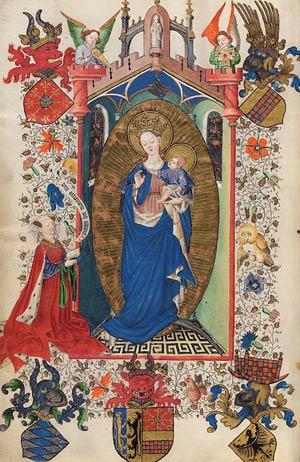
Listen to prayers:
Hours of the Virgin
Office of the Dead
Saturday Mass of the Virgin
Multimedia: Curator Roger Wieck discusses selections from the Hours of Catherine of Cleves.
Curator Roger Wieck discusses selections from the Hours of Catherine of Cleves.
This digital facsimile provides reproductions of all pages from the Hours of Catherine of Cleves. The original one-volume prayer book had been taken apart in the nineteenth century; the leaves were shuffled and then rebound into two confusing volumes. This presentation offers the manuscript in its original, fifteenth-century sequence.
The Hours of Catherine of Cleves is the greatest Dutch illuminated manuscript in the world. Its 157 miniatures are by the gifted Master of Catherine of Cleves (active ca. 1435–60), who is named after this book. The Master of Catherine of Cleves is considered the finest and most original illuminator of the medieval northern Netherlands, and this manuscript is his masterpiece.
The manuscript Catherine commissioned is a prayer book containing an unusually rich series of devotions illustrated with especially elaborate suites of miniatures. The artist's keen sense of observation combined with an interest in everyday objects was a style far ahead of its time (it would come to flower in seventeenth-century Dutch still-life painting). All the miniatures are filled with amazing detail. Narrative was also one of the great talents of the Master of Catherine of Cleves—he could tell a good story. Finally, Catherine's codex is famous for the artist's innovative borders, no two of which are alike.
Who Was Catherine of Cleves?
Catherine of Cleves (1417–1476) is known for two things: her Book of Hours and her protracted political battle against her husband. In 1430 she married Arnold of Egmond (1410 –1473), becoming duchess of Guelders. Although she bore her husband six children, the marriage was not happy. By 1440 Catherine refused to live with him.
War between husband and wife was sparked by Arnold's disinheriting his only living son, Adolf (1438–1477; rumor had it that Adolf accused his father of homosexuality). Catherine's siding with her son in the conflict led to anarchy. The cities of Nijmegen, Zutphen, and Arnhem supported Catherine and her son; Roermond sided with the duke. In 1465 mother and son imprisoned Arnold, forcing him to abdicate. Adolf, as duke, spent six years in ceaseless struggles with his father's supporters.
In 1471 Catherine watched in horror as Arnold secured his freedom and regained his title while Adolf was imprisoned. Arnold died in 1473, disinheriting both wife and son. Catherine's death in 1476 robbed her seeing the release of her son. Adolf's liberty was short-lived; he died the next year.
Catherine of Cleves Praying to the Virgin and Child
Hours of Catherine of Cleves, in Latin
Illuminated by the Master of Catherine of Cleves
The Netherlands, Utrecht, ca. 1440
Thumbnails
Calendar
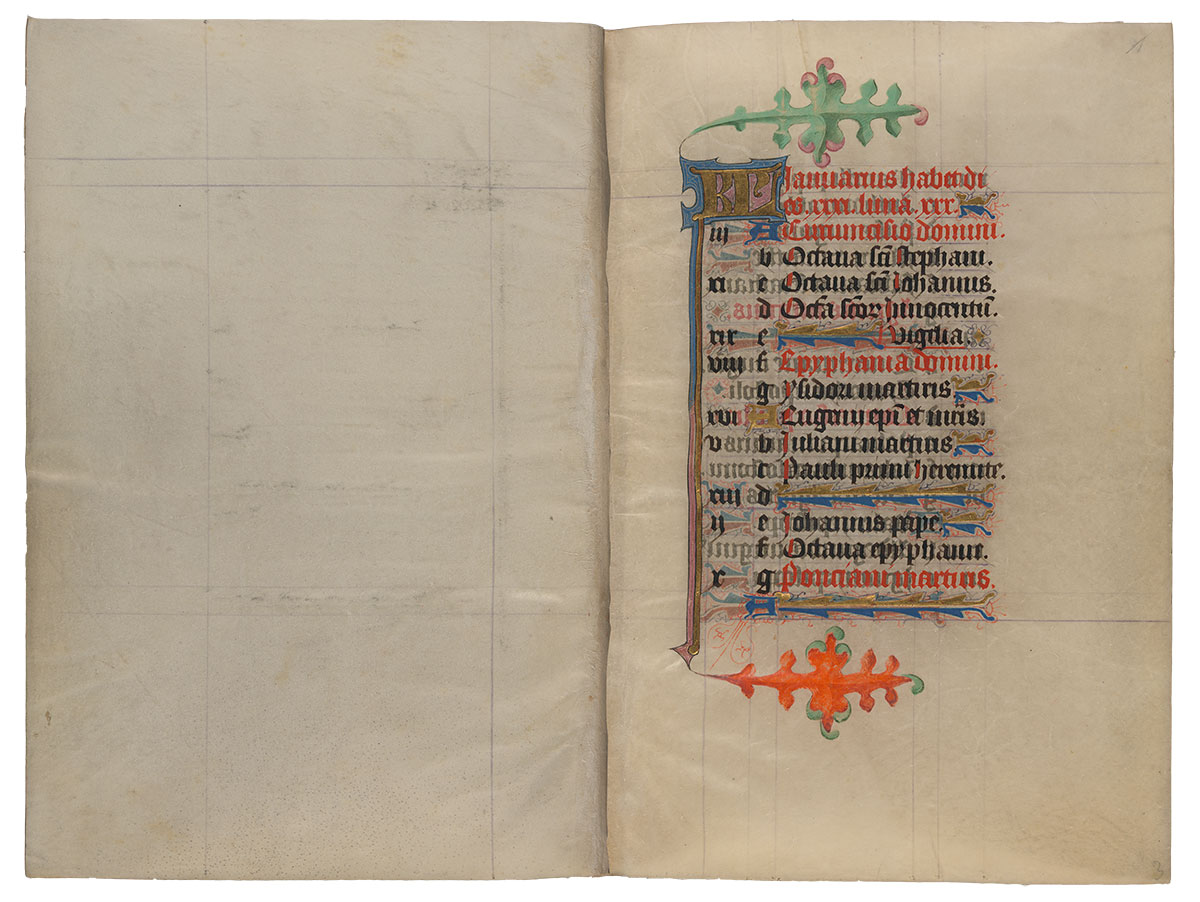
Purchased on the Belle da Costa Greene Fund with the assistance of the Fellows, 1963
Image courtesy of Faksimile Verlag Luzern
MS M.917/945, pp. 12–13
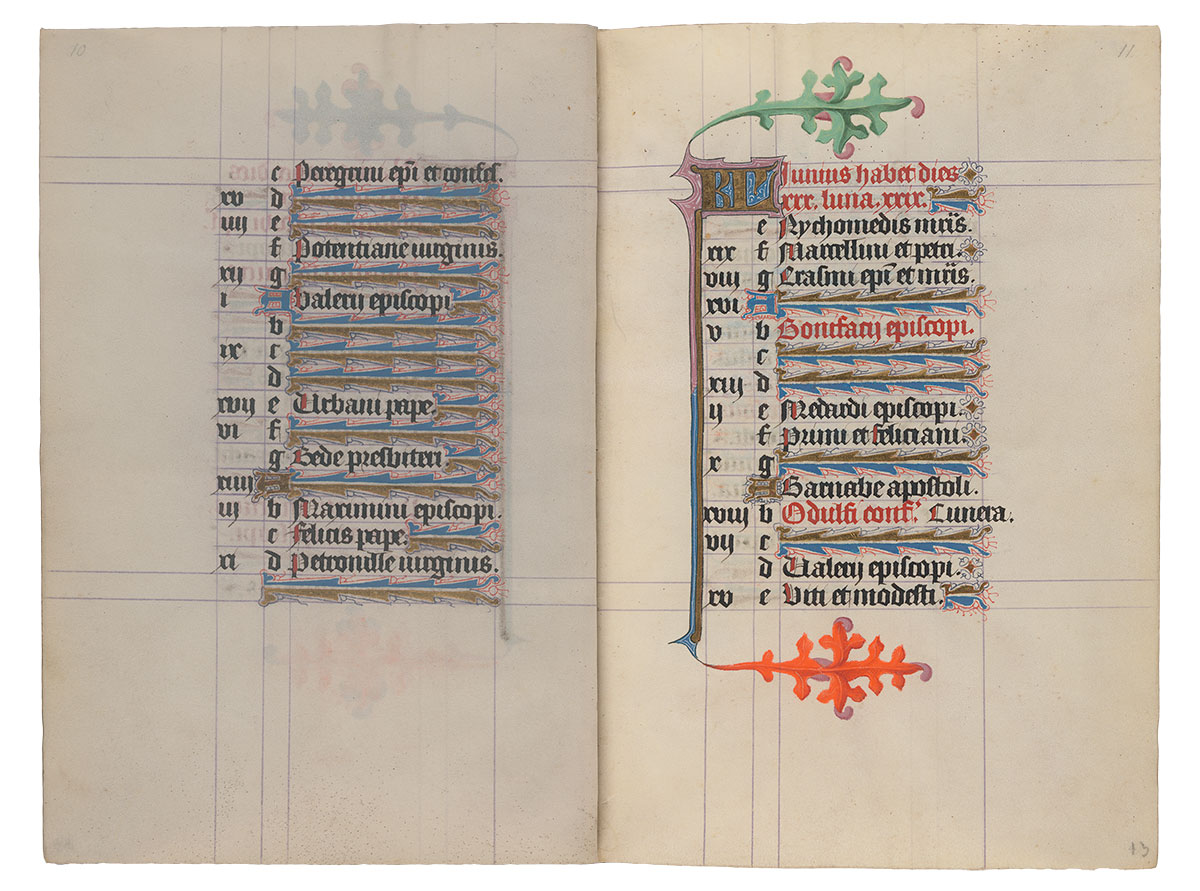
Purchased on the Belle da Costa Greene Fund with the assistance of the Fellows, 1963
Image courtesy of Faksimile Verlag Luzern
MS M.917/945, pp. 14–15
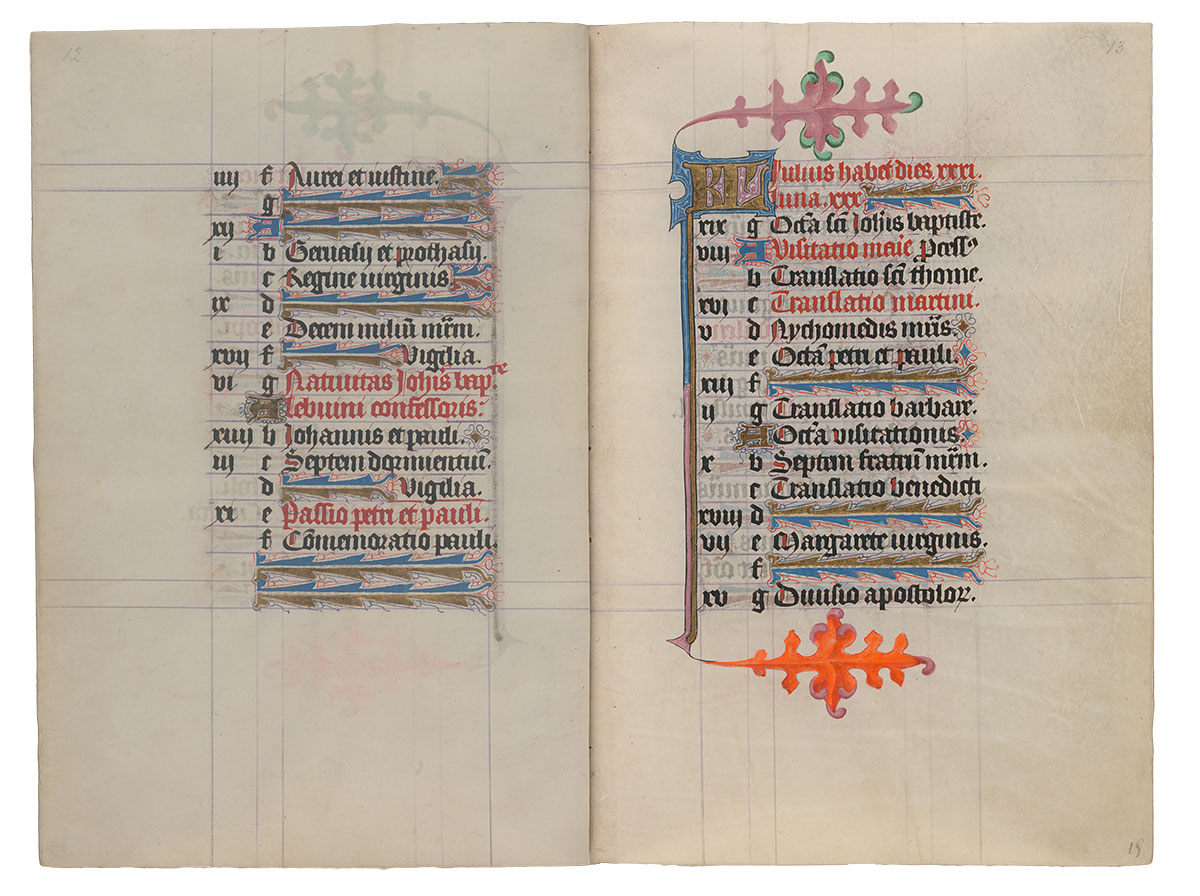
Purchased on the Belle da Costa Greene Fund with the assistance of the Fellows, 1963
Image courtesy of Faksimile Verlag Luzern
MS M.917/945, pp. 16–17
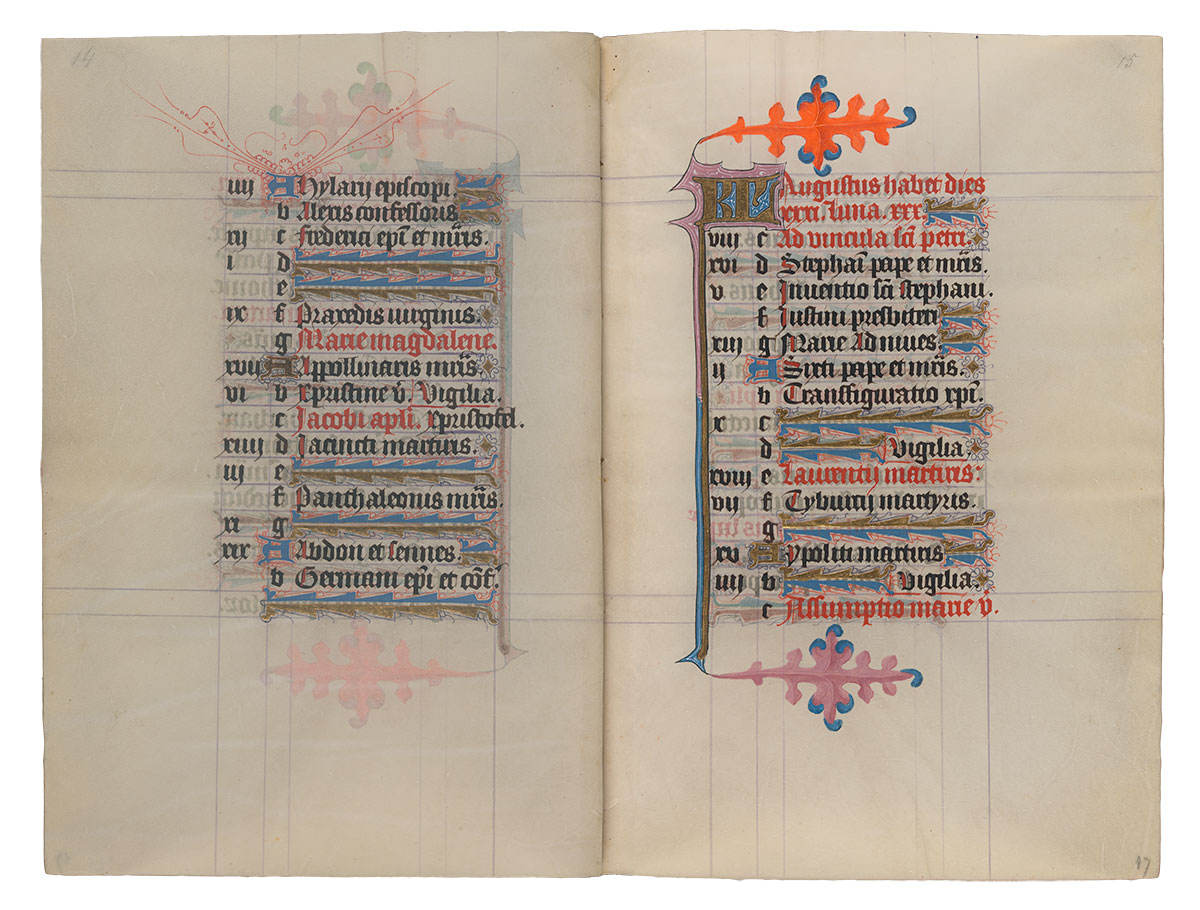
Purchased on the Belle da Costa Greene Fund with the assistance of the Fellows, 1963
Image courtesy of Faksimile Verlag Luzern
MS M.917/945, pp. 18–19
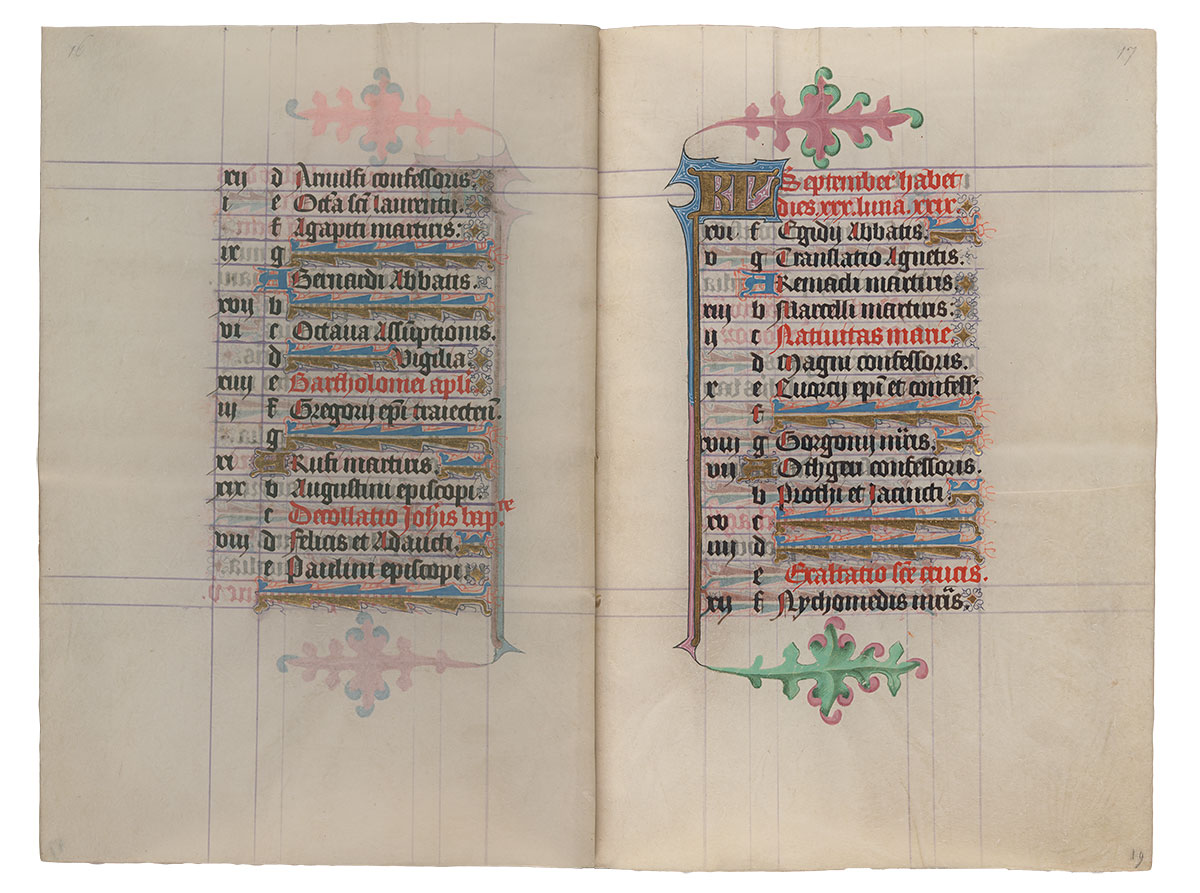
Purchased on the Belle da Costa Greene Fund with the assistance of the Fellows, 1963
Image courtesy of Faksimile Verlag Luzern
MS M.917/945, pp. 20–21
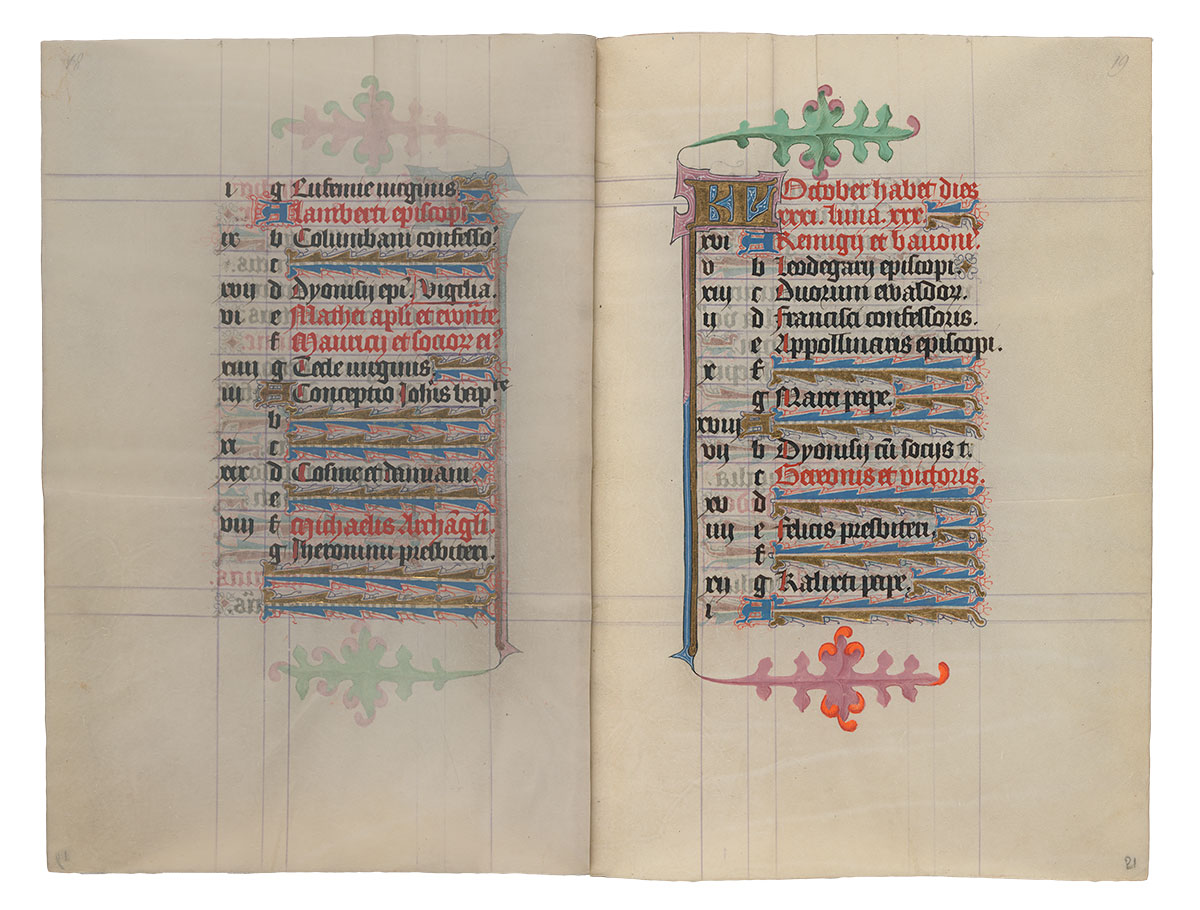
Purchased on the Belle da Costa Greene Fund with the assistance of the Fellows, 1963
Image courtesy of Faksimile Verlag Luzern
MS M.917/945, pp. 22–23
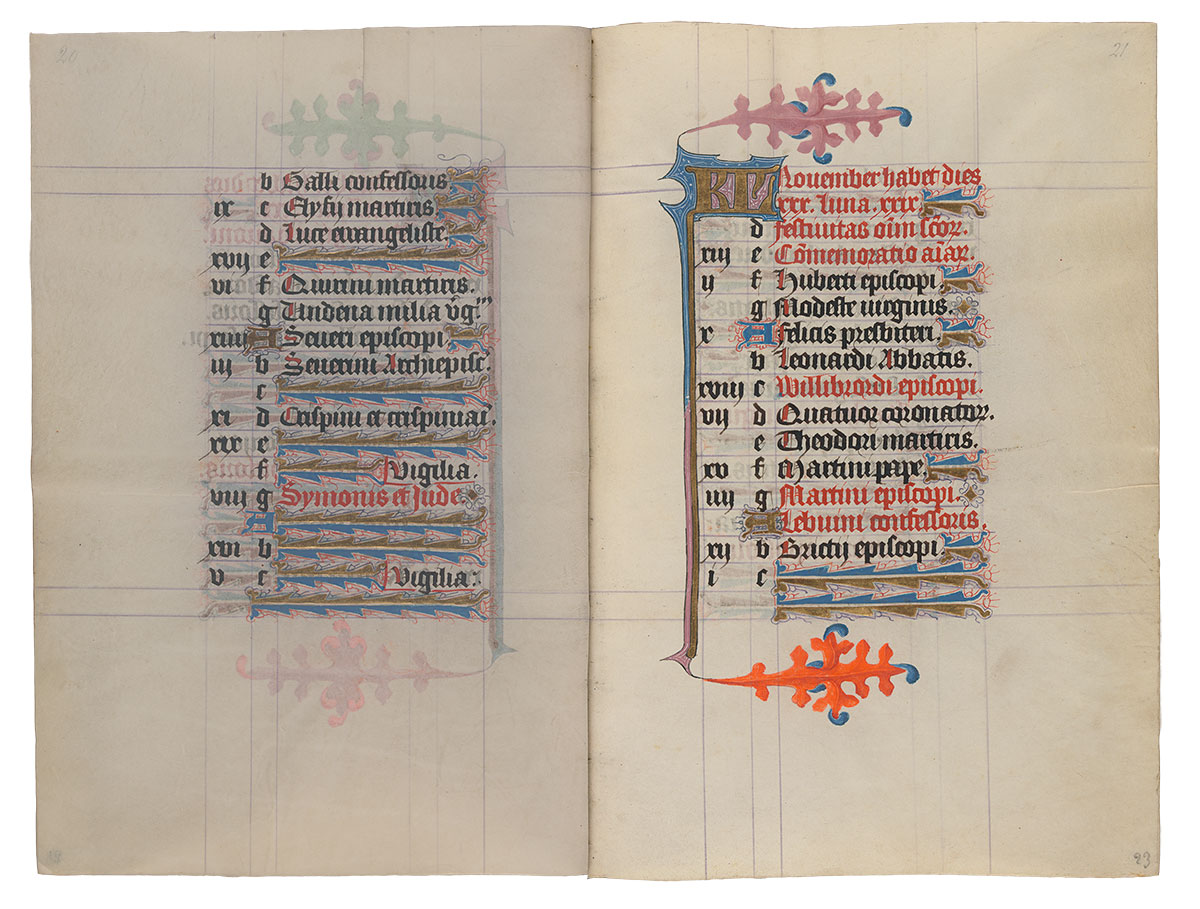
Purchased on the Belle da Costa Greene Fund with the assistance of the Fellows, 1963
Image courtesy of Faksimile Verlag Luzern
MS M.917/945, pp. 24–25
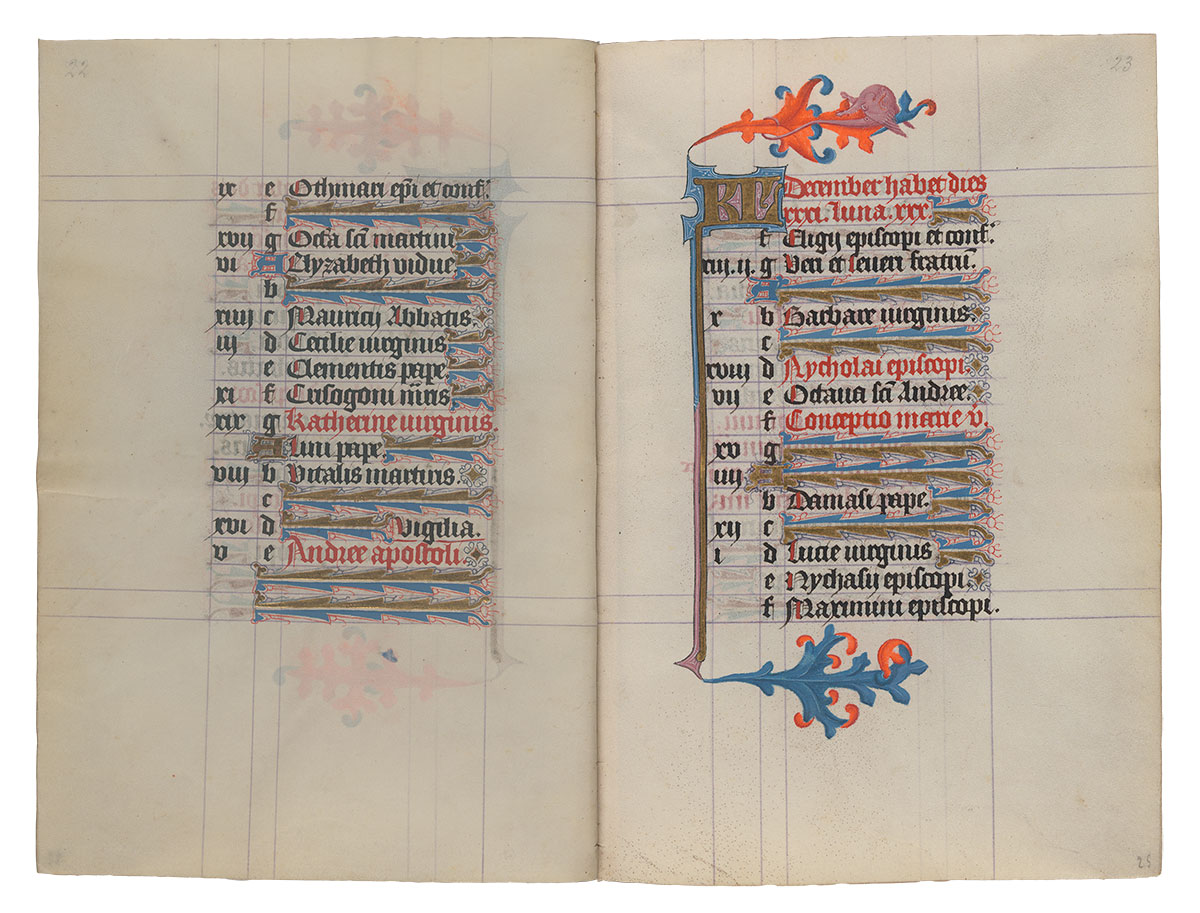
Purchased on the Belle da Costa Greene Fund with the assistance of the Fellows, 1963
Image courtesy of Faksimile Verlag Luzern
MS M.917/945, p. 26–f. 001r
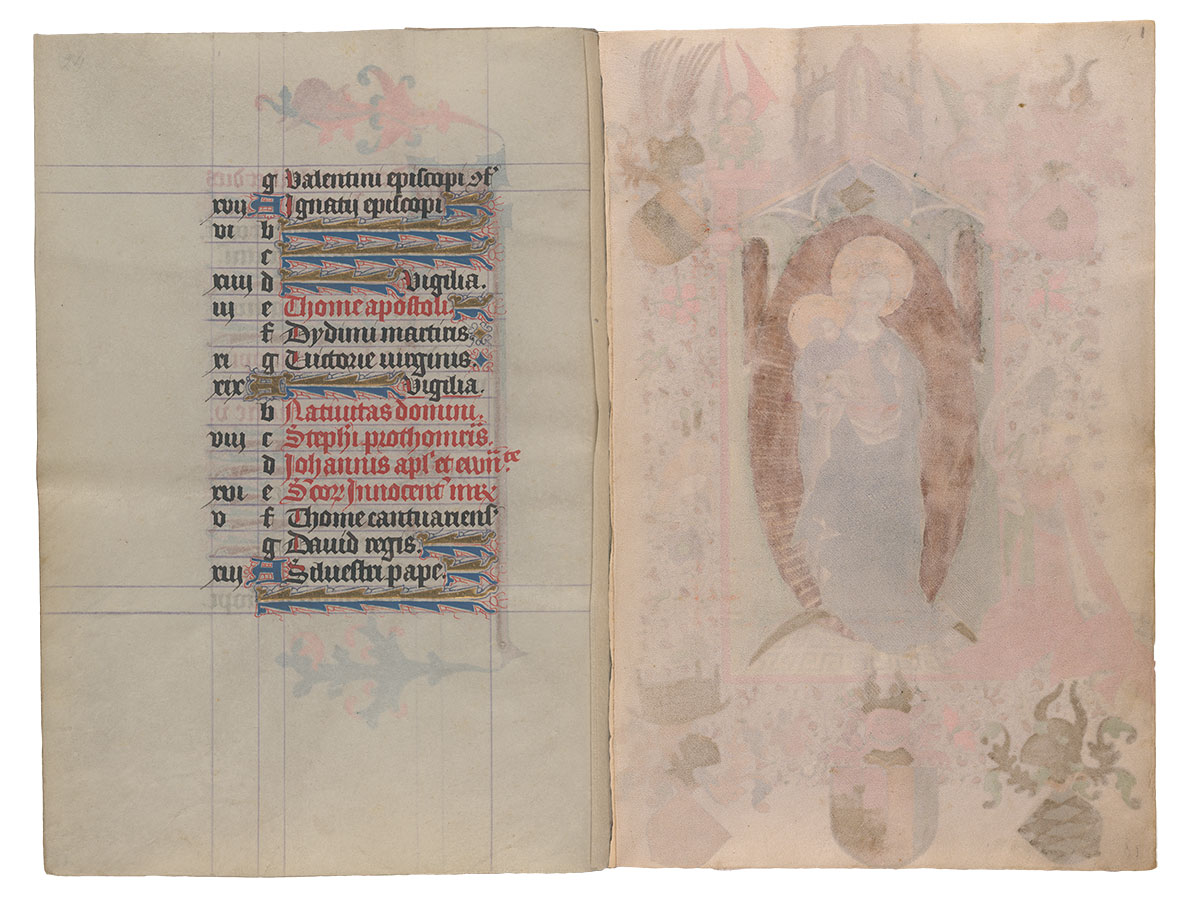
Purchased on the Belle da Costa Greene Fund with the assistance of the Fellows and with special assistance of Mrs. Frederick B. Adams, Sr., Mrs. Robert Charles, Mr. Laurens M. Hamilton, The Heineman Foundation, Mrs. Donald F. Hyde, Mrs. Jacob M. Kaplan, Mrs. John Kean, Mr. Paul Mellon, Mr. and Mrs. Charles F. Morgan, Mr. Lessing J. Rosenwald, Mr. and Mrs. August H. Schilling, Mrs. Herbert N. Straus, Mrs. Landon K. Thorne, Mrs. Alan Valentine, Mr. and Mrs. Arnold Whitridge, and Miss Julia P. Wightman, 1970
Image courtesy of Faksimile Verlag Luzern
MS M.917/945, pp. 4–5
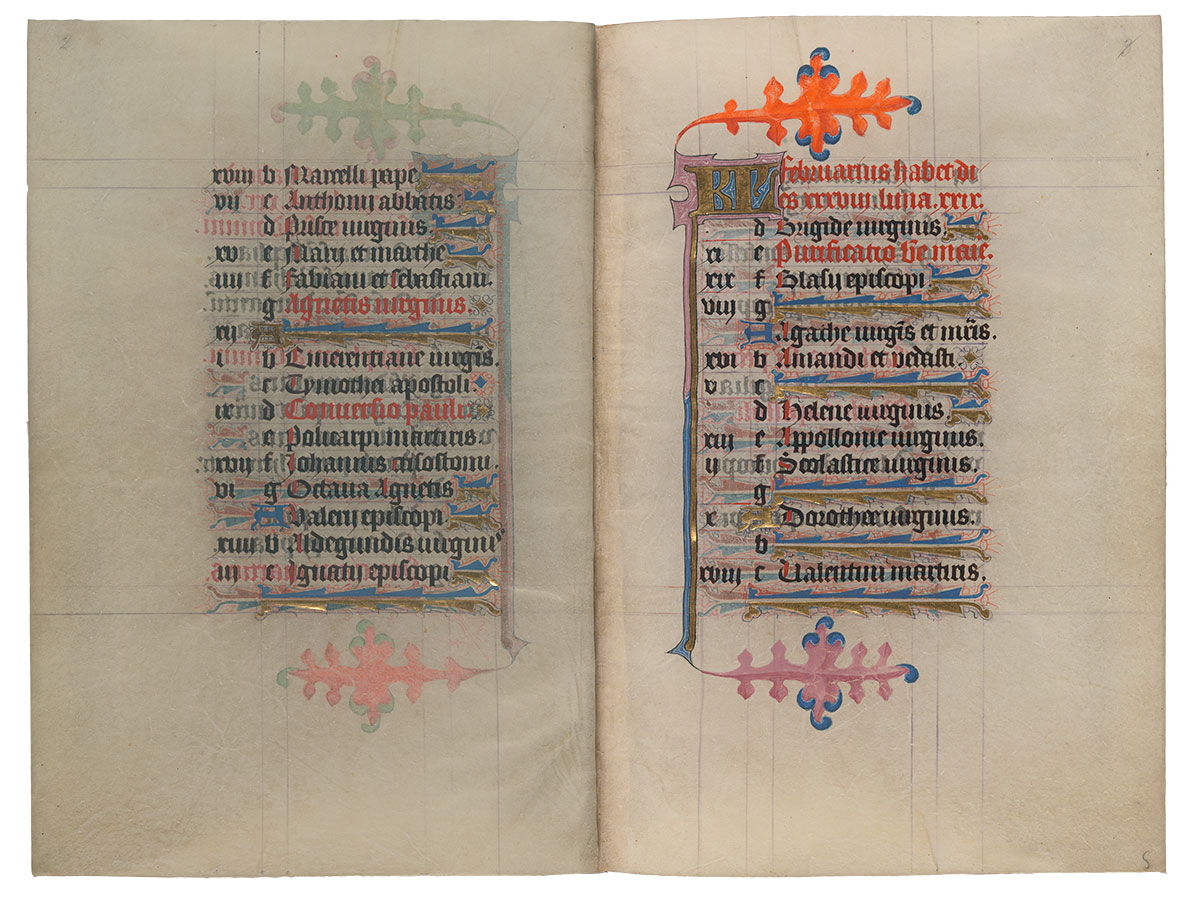
Purchased on the Belle da Costa Greene Fund with the assistance of the Fellows, 1963
Image courtesy of Faksimile Verlag Luzern
MS M.917/945, pp. 6–7
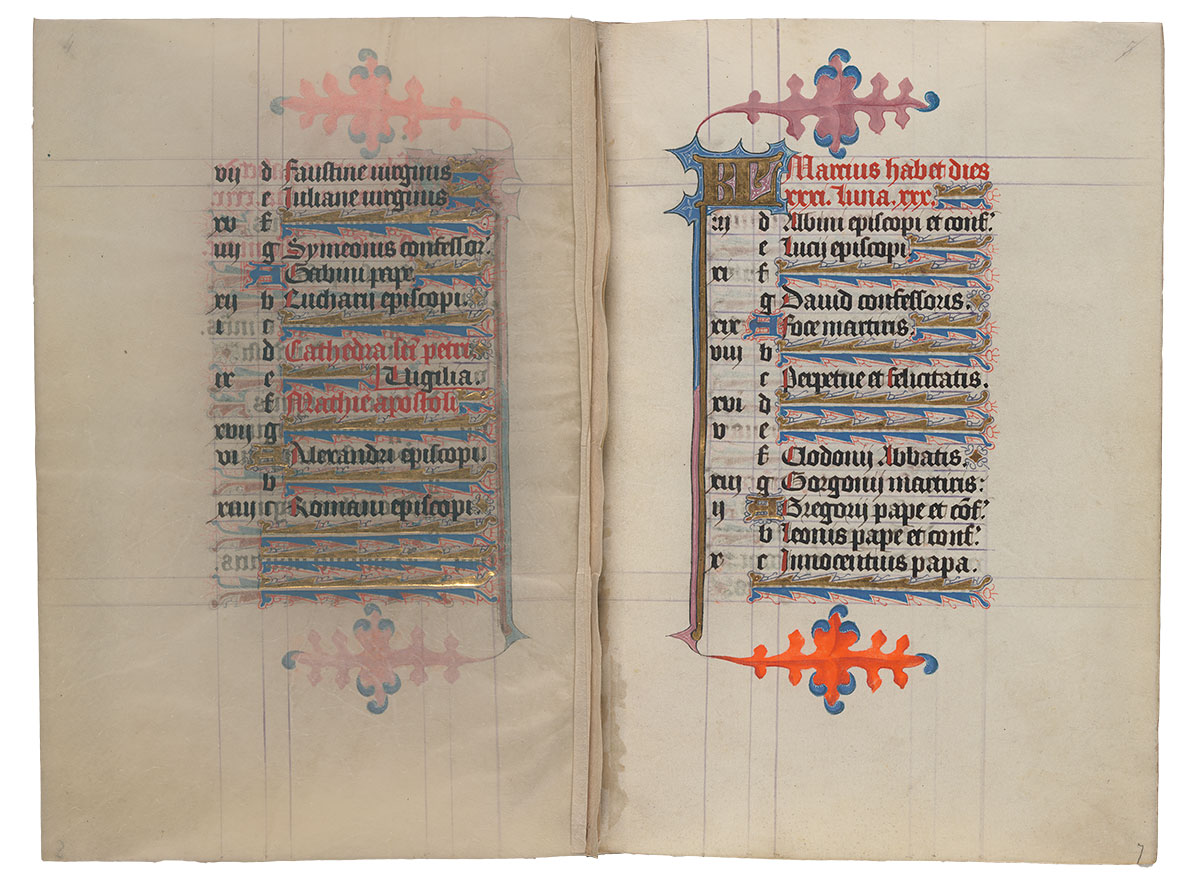
Purchased on the Belle da Costa Greene Fund with the assistance of the Fellows, 1963
Image courtesy of Faksimile Verlag Luzern
MS M.917/945, pp. 8–9
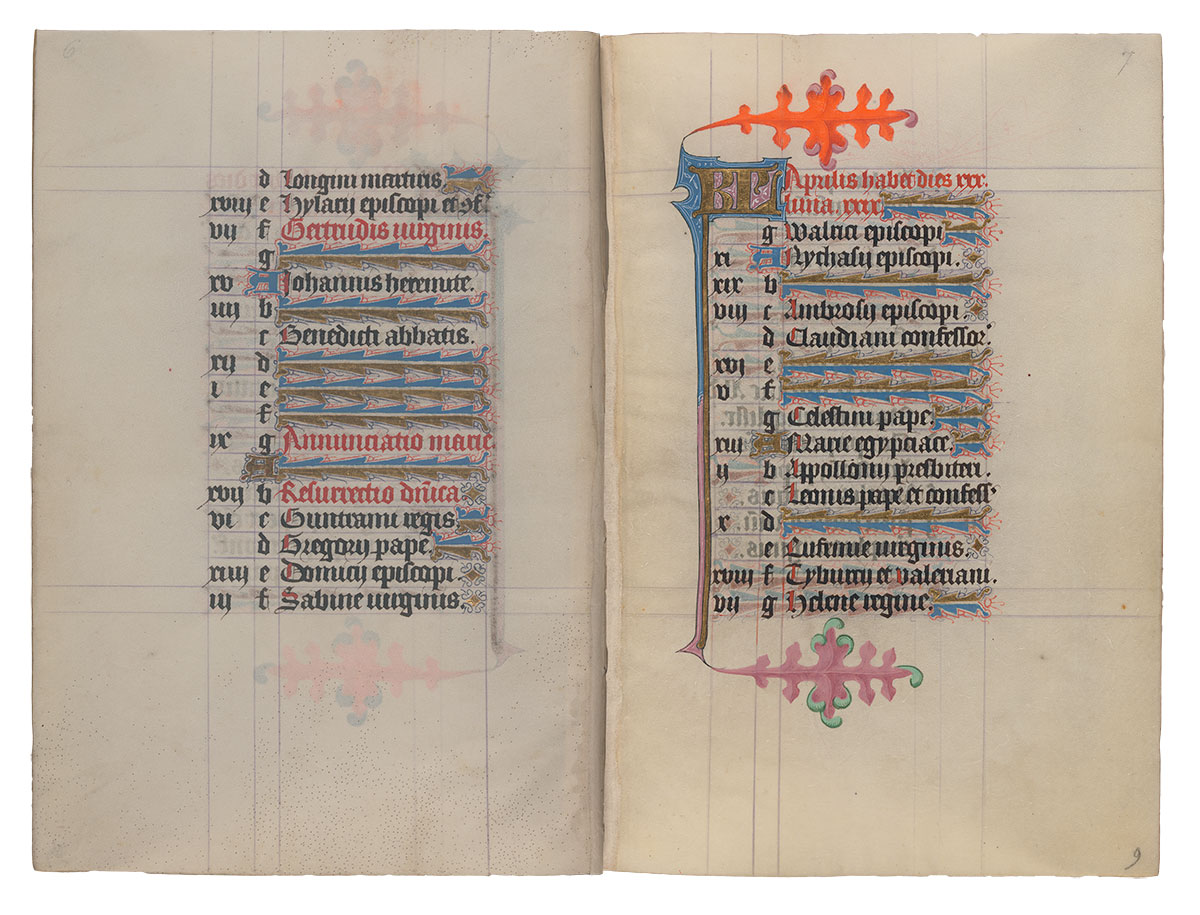
Purchased on the Belle da Costa Greene Fund with the assistance of the Fellows, 1963
Image courtesy of Faksimile Verlag Luzern
MS M.917/945, pp. 10–11
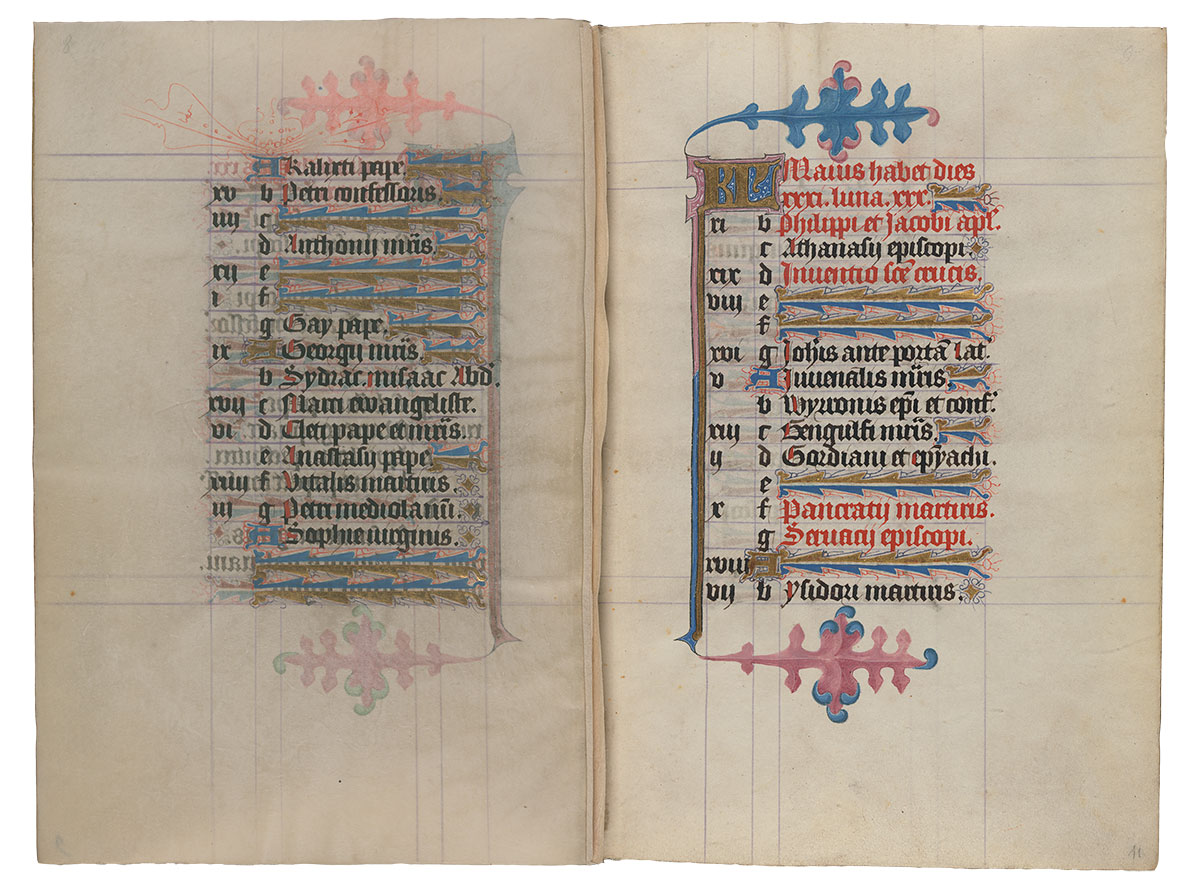
Purchased on the Belle da Costa Greene Fund with the assistance of the Fellows, 1963
Image courtesy of Faksimile Verlag Luzern
Hours of the Virgin
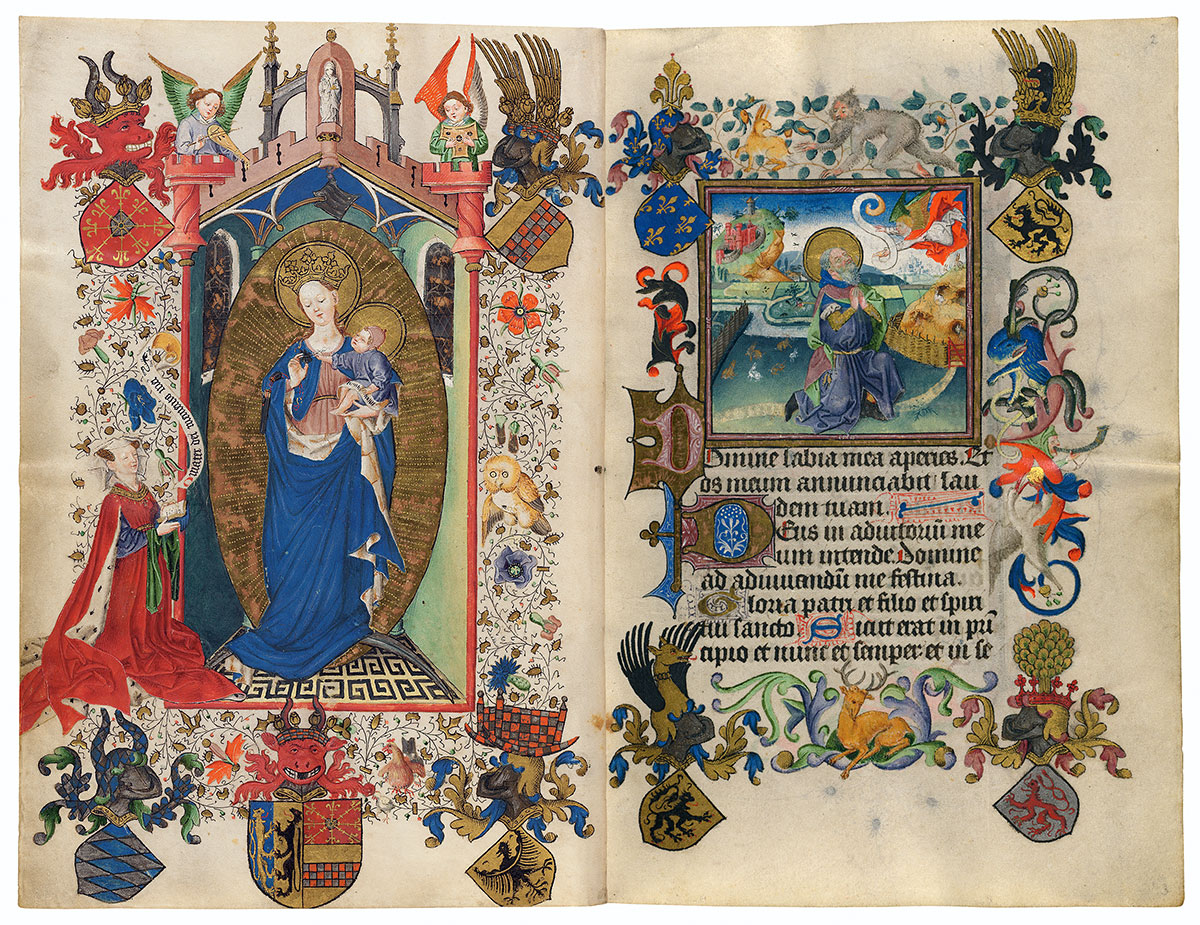
Catherine of Cleves Praying to the Virgin and Child
Annunciation to Joachim
Purchased on the Belle da Costa Greene Fund with the assistance of the Fellows and with special assistance of Mrs. Frederick B. Adams, Sr., Mrs. Robert Charles, Mr. Laurens M. Hamilton, The Heineman Foundation, Mrs. Donald F. Hyde, Mrs. Jacob M. Kaplan, Mrs. John Kean, Mr. Paul Mellon, Mr. and Mrs. Charles F. Morgan, Mr. Lessing J. Rosenwald, Mr. and Mrs. August H. Schilling, Mrs. Herbert N. Straus, Mrs. Landon K. Thorne, Mrs. Alan Valentine, Mr. and Mrs. Arnold Whitridge, and Miss Julia P. Wightman, 1970
Catherine's prayer book begins with a bang. The first thing one sees is Catherine herself, praying from her Book of Hours before the Virgin and Child. On the right, the narrative of the life of Mary commences with an angel's telling the Virgin's father, Joachim, that his wife is with child. The many rabbits symbolize the old man's newfound fecundity. In a parallel manner, the borders proudly proclaim Catherine's noble lineage: eight of her ancestors' arms fill the corners of the folios. Her own arms as duchess of Guelders are prominently positioned directly below the Virgin. In a heraldic act of defiance, she surmounts her arms not with her husband's crest but with the ox of her own house of Cleves.
Hours of the Virgin
The heart of every Book of Hours is the series of prayers called the Hours of the Virgin. Each Hour is composed of psalms plus hymns, biblical readings, and short phrases (antiphons, versicles, and responses). Ideally, these eight Hours were prayed throughout the course of the day:
| Matins and Lauds | at night or upon rising |
| Prime (first Hour) | at 6:00 a.m. |
| Terce (third Hour) | at 9:00 a.m. |
| Sext (sixth Hour) | at noon |
| Nones (ninth Hour) | at 3:00 p.m. |
| Vespers (evensong) | in the early evening |
| Compline | before retiring. |
The Hours of the Virgin date back to at least the ninth century. By the late twelfth century, the Hours appeared in Psalters, prayer books popular with laypeople. With a rising economy and the growth of the merchant class, the thirteenth century saw an increase in lay literacy. By the middle of the century, the Hours of the Virgin "spun off" from the Psalter and formed the core of the laypeople's prayer book, the Book of Hours.
The Virgin Mary is, of course, not mentioned in the numerous psalms of the Old Testament that comprise much of the Hours. Framing the psalms, however, are prayers that offer a mystical interpretation of the psalms and reveal the role played by the Virgin in mankind's salvation.
Image courtesy of Faksimile Verlag Luzern
MS M.917/945, ff. 2v–3r
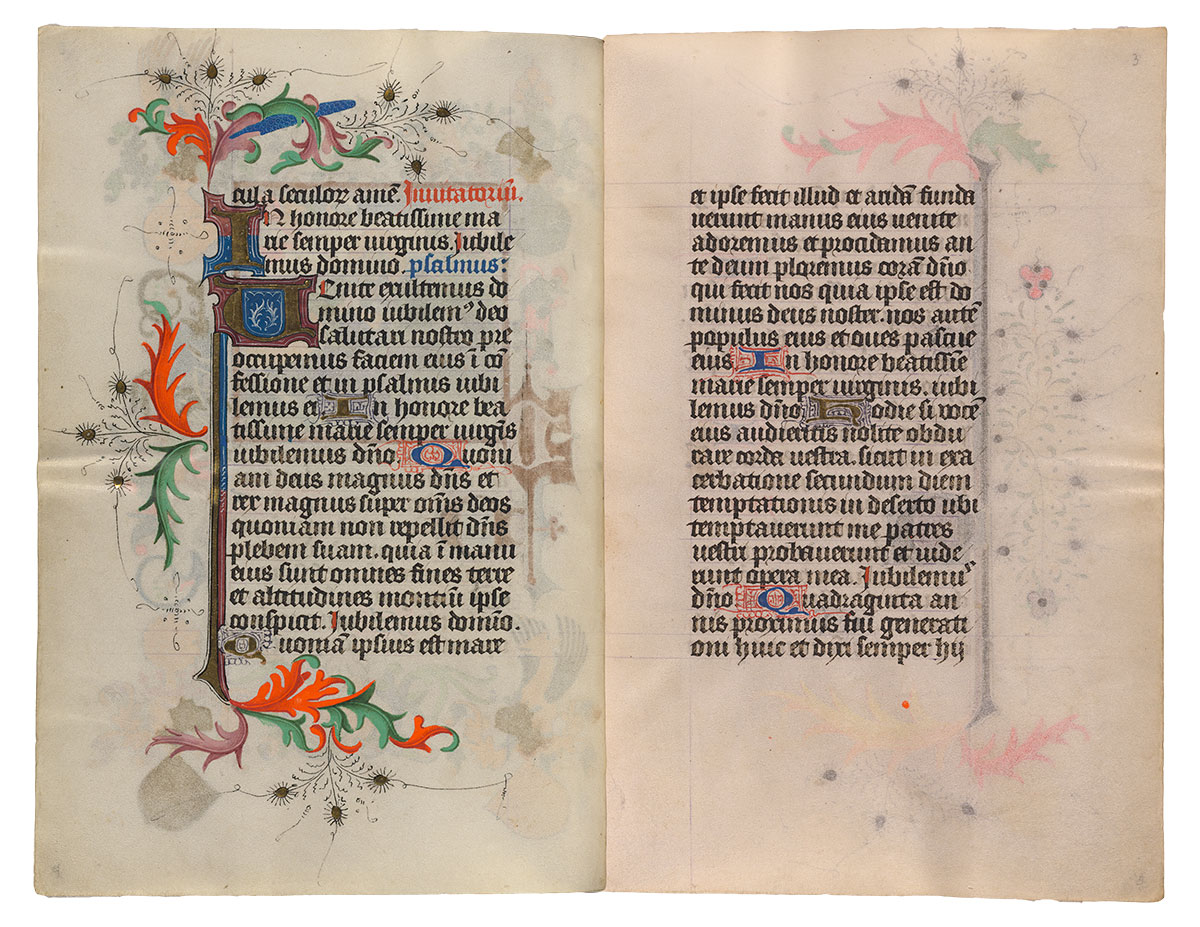
Purchased on the Belle da Costa Greene Fund with the assistance of the Fellows and with special assistance of Mrs. Frederick B. Adams, Sr., Mrs. Robert Charles, Mr. Laurens M. Hamilton, The Heineman Foundation, Mrs. Donald F. Hyde, Mrs. Jacob M. Kaplan, Mrs. John Kean, Mr. Paul Mellon, Mr. and Mrs. Charles F. Morgan, Mr. Lessing J. Rosenwald, Mr. and Mrs. August H. Schilling, Mrs. Herbert N. Straus, Mrs. Landon K. Thorne, Mrs. Alan Valentine, Mr. and Mrs. Arnold Whitridge, and Miss Julia P. Wightman, 1970
Image courtesy of Faksimile Verlag Luzern
MS M.917/945, ff. 3v–4r
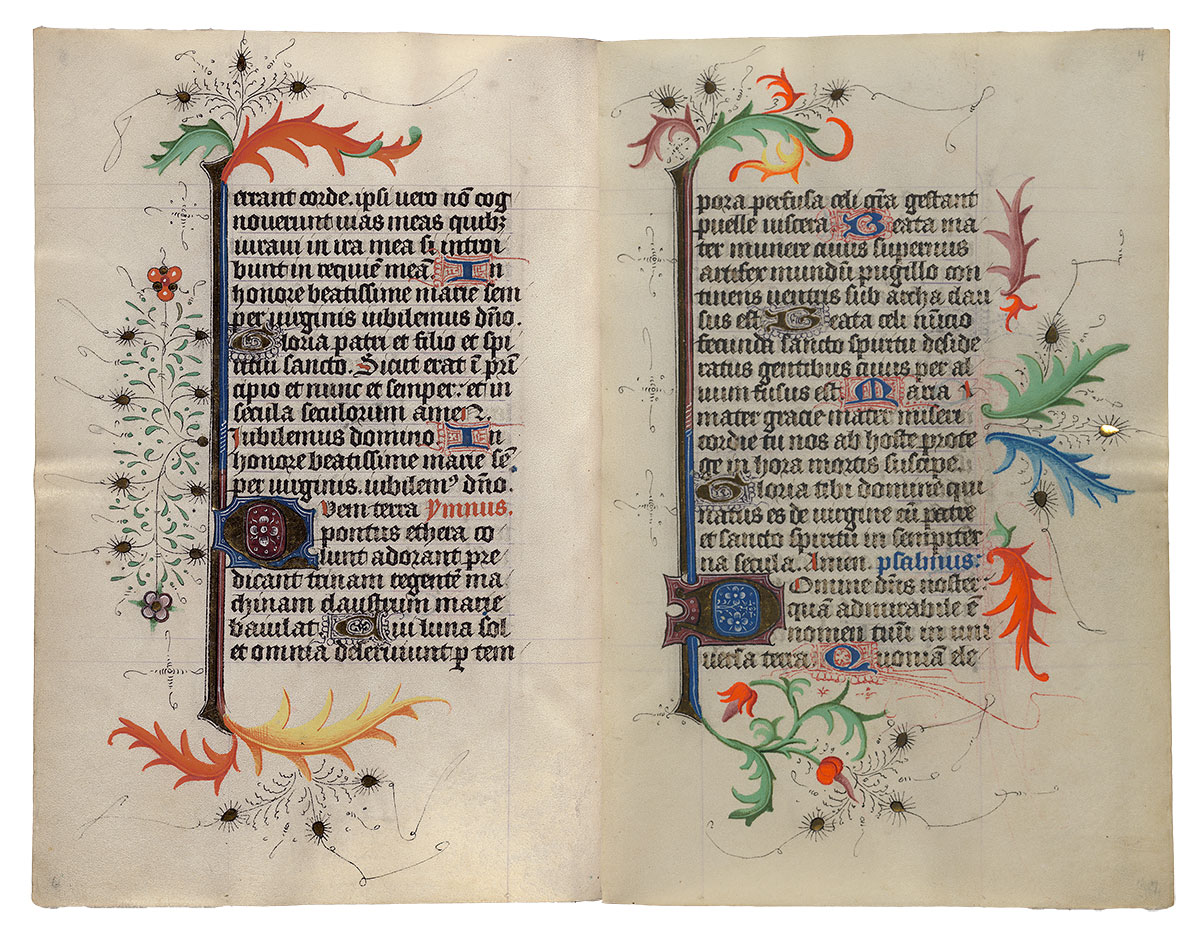
Purchased on the Belle da Costa Greene Fund with the assistance of the Fellows and with special assistance of Mrs. Frederick B. Adams, Sr., Mrs. Robert Charles, Mr. Laurens M. Hamilton, The Heineman Foundation, Mrs. Donald F. Hyde, Mrs. Jacob M. Kaplan, Mrs. John Kean, Mr. Paul Mellon, Mr. and Mrs. Charles F. Morgan, Mr. Lessing J. Rosenwald, Mr. and Mrs. August H. Schilling, Mrs. Herbert N. Straus, Mrs. Landon K. Thorne, Mrs. Alan Valentine, Mr. and Mrs. Arnold Whitridge, and Miss Julia P. Wightman, 1970
Image courtesy of Faksimile Verlag Luzern
MS M.917/945, ff. 4v–5r
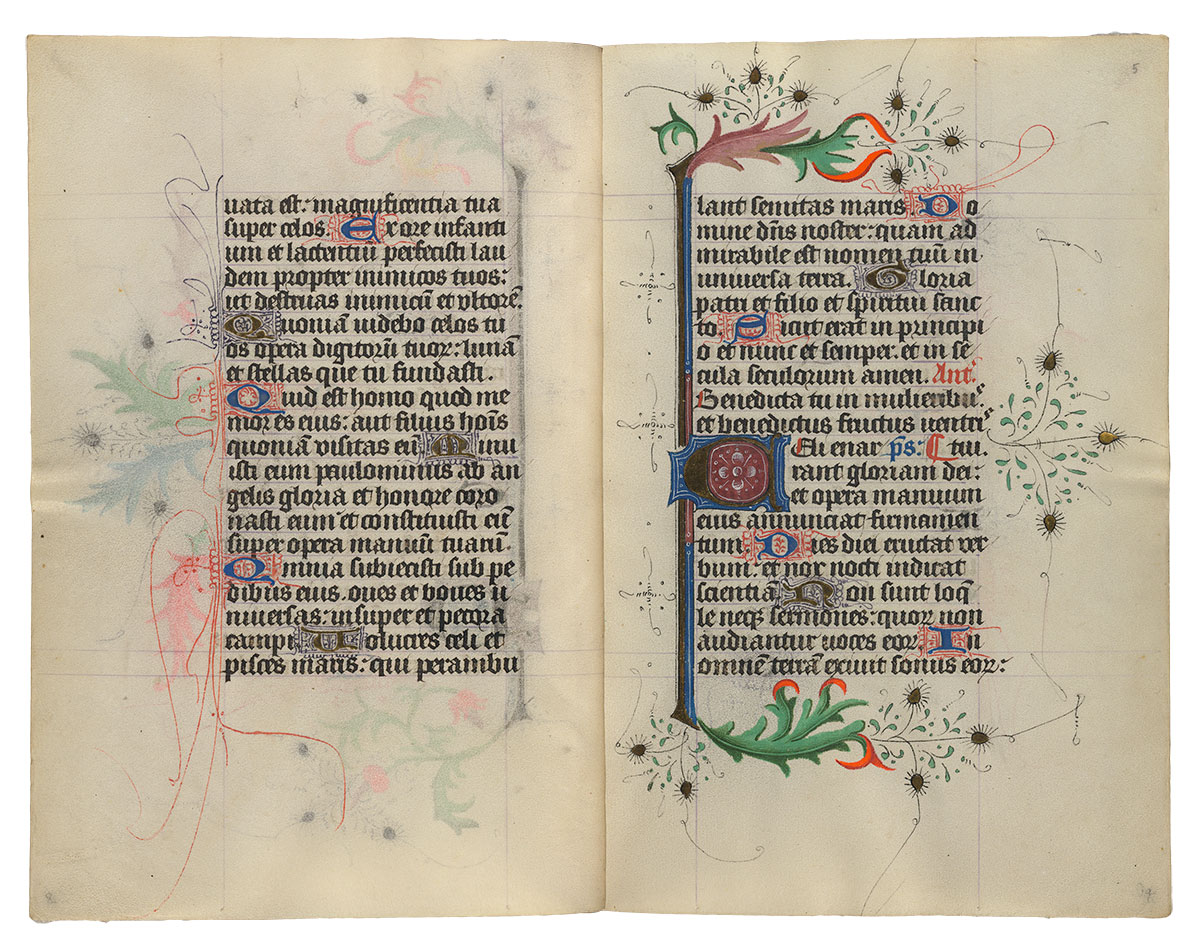
Purchased on the Belle da Costa Greene Fund with the assistance of the Fellows and with special assistance of Mrs. Frederick B. Adams, Sr., Mrs. Robert Charles, Mr. Laurens M. Hamilton, The Heineman Foundation, Mrs. Donald F. Hyde, Mrs. Jacob M. Kaplan, Mrs. John Kean, Mr. Paul Mellon, Mr. and Mrs. Charles F. Morgan, Mr. Lessing J. Rosenwald, Mr. and Mrs. August H. Schilling, Mrs. Herbert N. Straus, Mrs. Landon K. Thorne, Mrs. Alan Valentine, Mr. and Mrs. Arnold Whitridge, and Miss Julia P. Wightman, 1970
Image courtesy of Faksimile Verlag Luzern
MS M.917/945, ff. 5v–6r
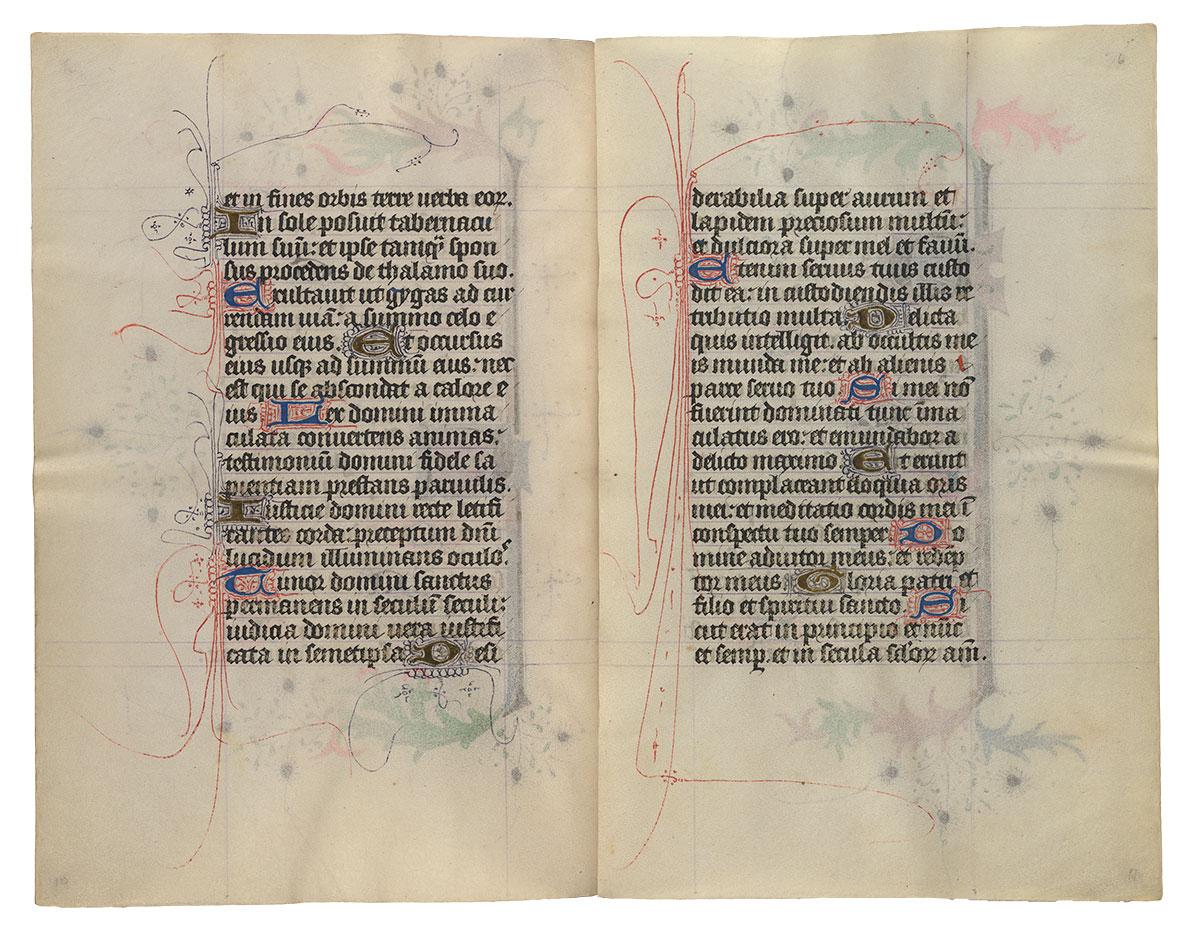
Purchased on the Belle da Costa Greene Fund with the assistance of the Fellows and with special assistance of Mrs. Frederick B. Adams, Sr., Mrs. Robert Charles, Mr. Laurens M. Hamilton, The Heineman Foundation, Mrs. Donald F. Hyde, Mrs. Jacob M. Kaplan, Mrs. John Kean, Mr. Paul Mellon, Mr. and Mrs. Charles F. Morgan, Mr. Lessing J. Rosenwald, Mr. and Mrs. August H. Schilling, Mrs. Herbert N. Straus, Mrs. Landon K. Thorne, Mrs. Alan Valentine, Mr. and Mrs. Arnold Whitridge, and Miss Julia P. Wightman, 1970
Image courtesy of Faksimile Verlag Luzern
MS M.917/945, ff. 6v–7r
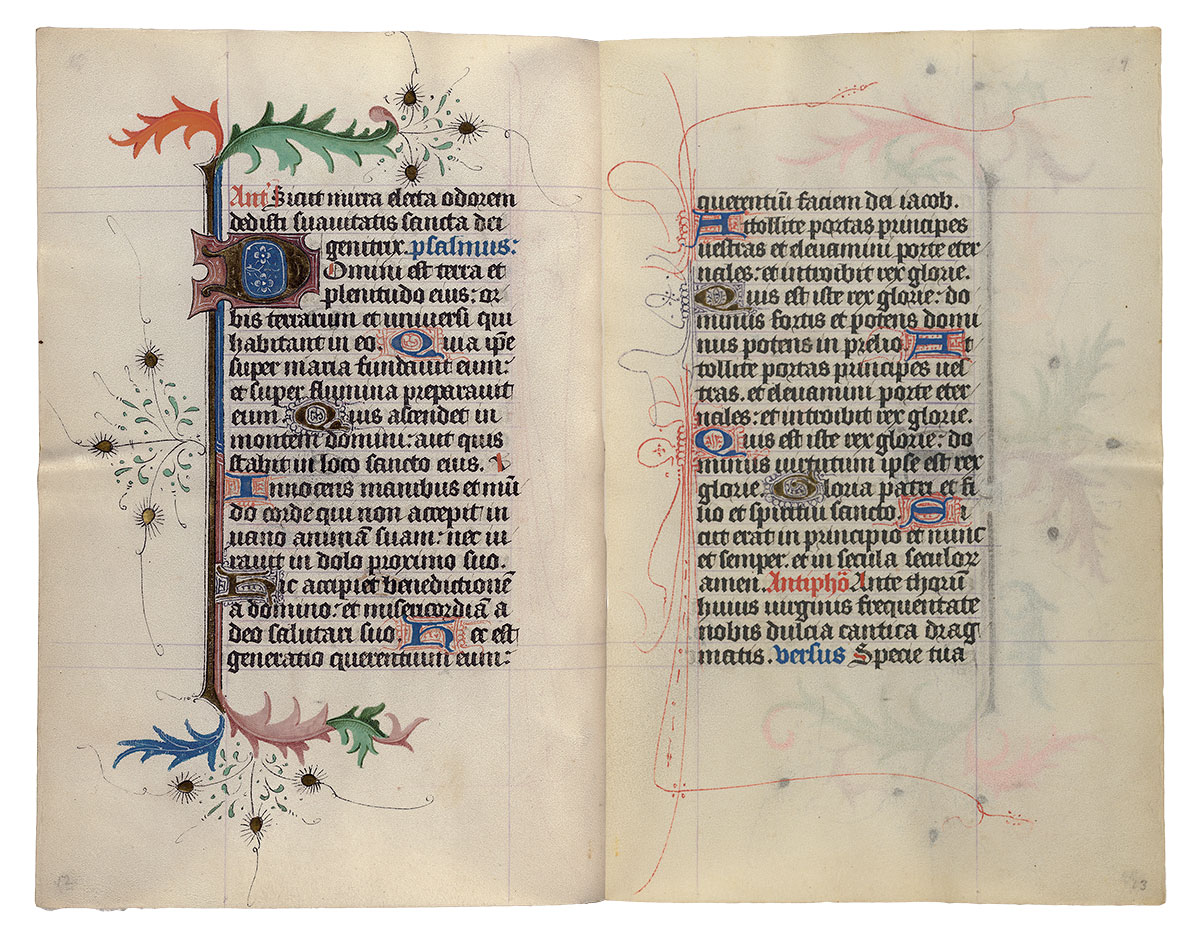
Purchased on the Belle da Costa Greene Fund with the assistance of the Fellows and with special assistance of Mrs. Frederick B. Adams, Sr., Mrs. Robert Charles, Mr. Laurens M. Hamilton, The Heineman Foundation, Mrs. Donald F. Hyde, Mrs. Jacob M. Kaplan, Mrs. John Kean, Mr. Paul Mellon, Mr. and Mrs. Charles F. Morgan, Mr. Lessing J. Rosenwald, Mr. and Mrs. August H. Schilling, Mrs. Herbert N. Straus, Mrs. Landon K. Thorne, Mrs. Alan Valentine, Mr. and Mrs. Arnold Whitridge, and Miss Julia P. Wightman, 1970
Image courtesy of Faksimile Verlag Luzern
MS M.917/945, ff. 7v–8r
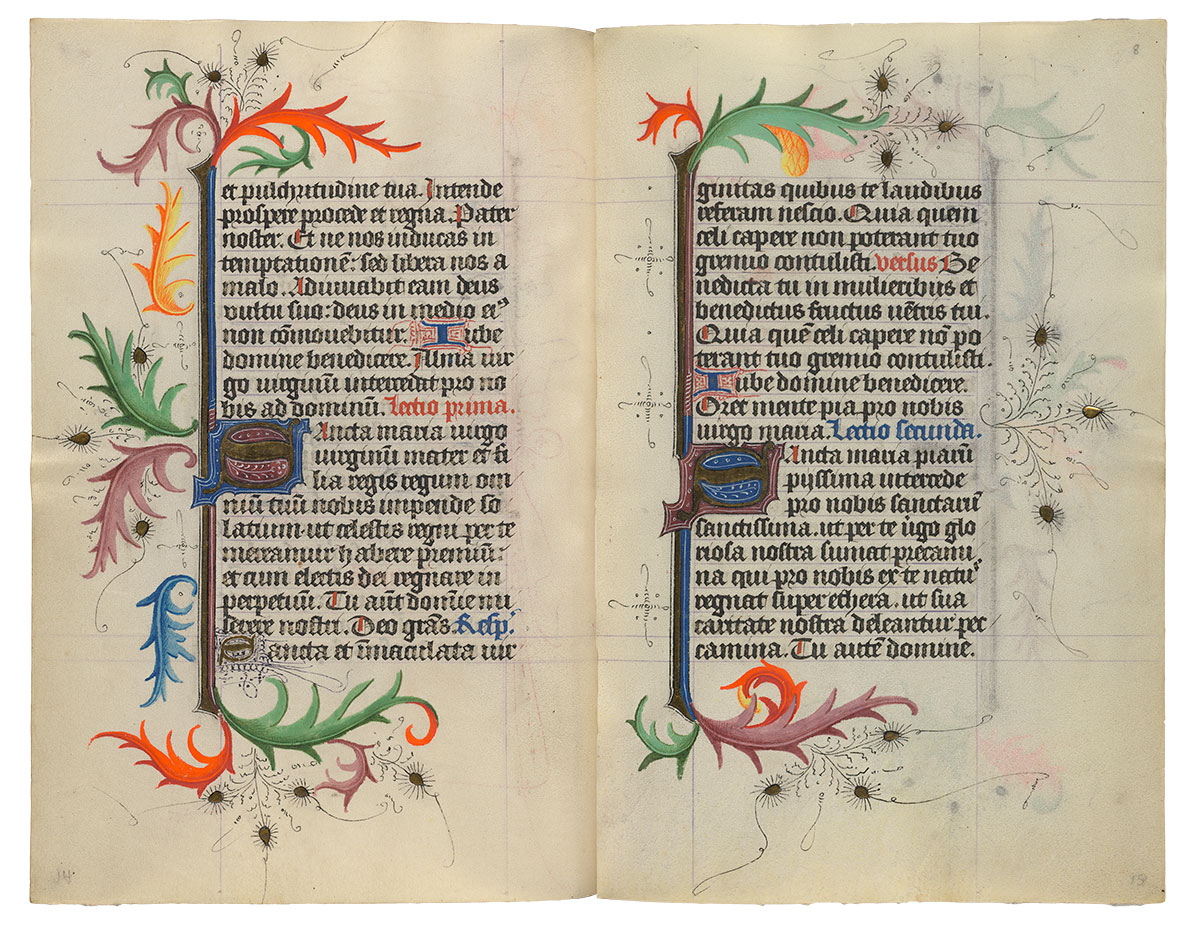
Purchased on the Belle da Costa Greene Fund with the assistance of the Fellows and with special assistance of Mrs. Frederick B. Adams, Sr., Mrs. Robert Charles, Mr. Laurens M. Hamilton, The Heineman Foundation, Mrs. Donald F. Hyde, Mrs. Jacob M. Kaplan, Mrs. John Kean, Mr. Paul Mellon, Mr. and Mrs. Charles F. Morgan, Mr. Lessing J. Rosenwald, Mr. and Mrs. August H. Schilling, Mrs. Herbert N. Straus, Mrs. Landon K. Thorne, Mrs. Alan Valentine, Mr. and Mrs. Arnold Whitridge, and Miss Julia P. Wightman, 1970
Image courtesy of Faksimile Verlag Luzern
MS M.917/945, ff. 8v–9r
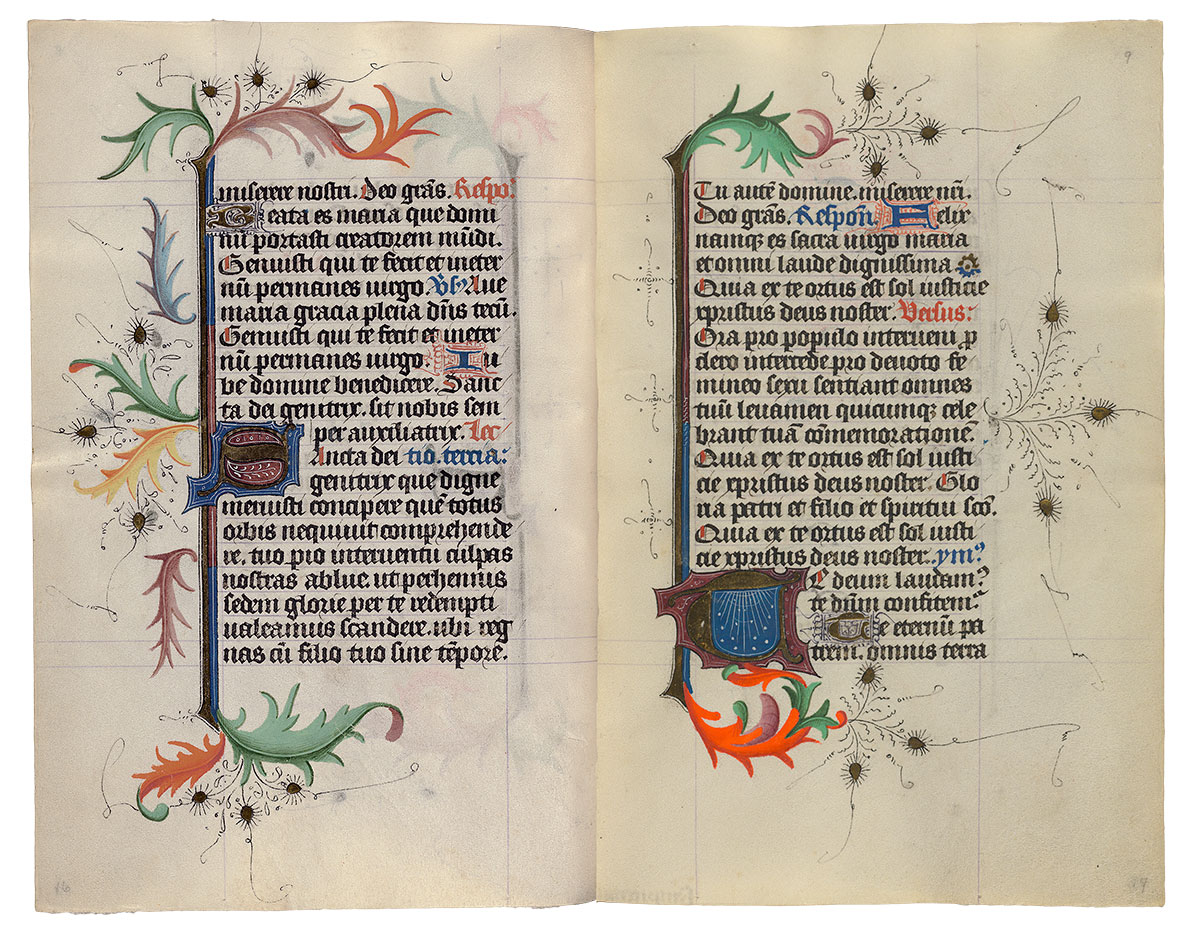
Purchased on the Belle da Costa Greene Fund with the assistance of the Fellows and with special assistance of Mrs. Frederick B. Adams, Sr., Mrs. Robert Charles, Mr. Laurens M. Hamilton, The Heineman Foundation, Mrs. Donald F. Hyde, Mrs. Jacob M. Kaplan, Mrs. John Kean, Mr. Paul Mellon, Mr. and Mrs. Charles F. Morgan, Mr. Lessing J. Rosenwald, Mr. and Mrs. August H. Schilling, Mrs. Herbert N. Straus, Mrs. Landon K. Thorne, Mrs. Alan Valentine, Mr. and Mrs. Arnold Whitridge, and Miss Julia P. Wightman, 1970
Image courtesy of Faksimile Verlag Luzern
MS M.917/945, ff. 9v–10r
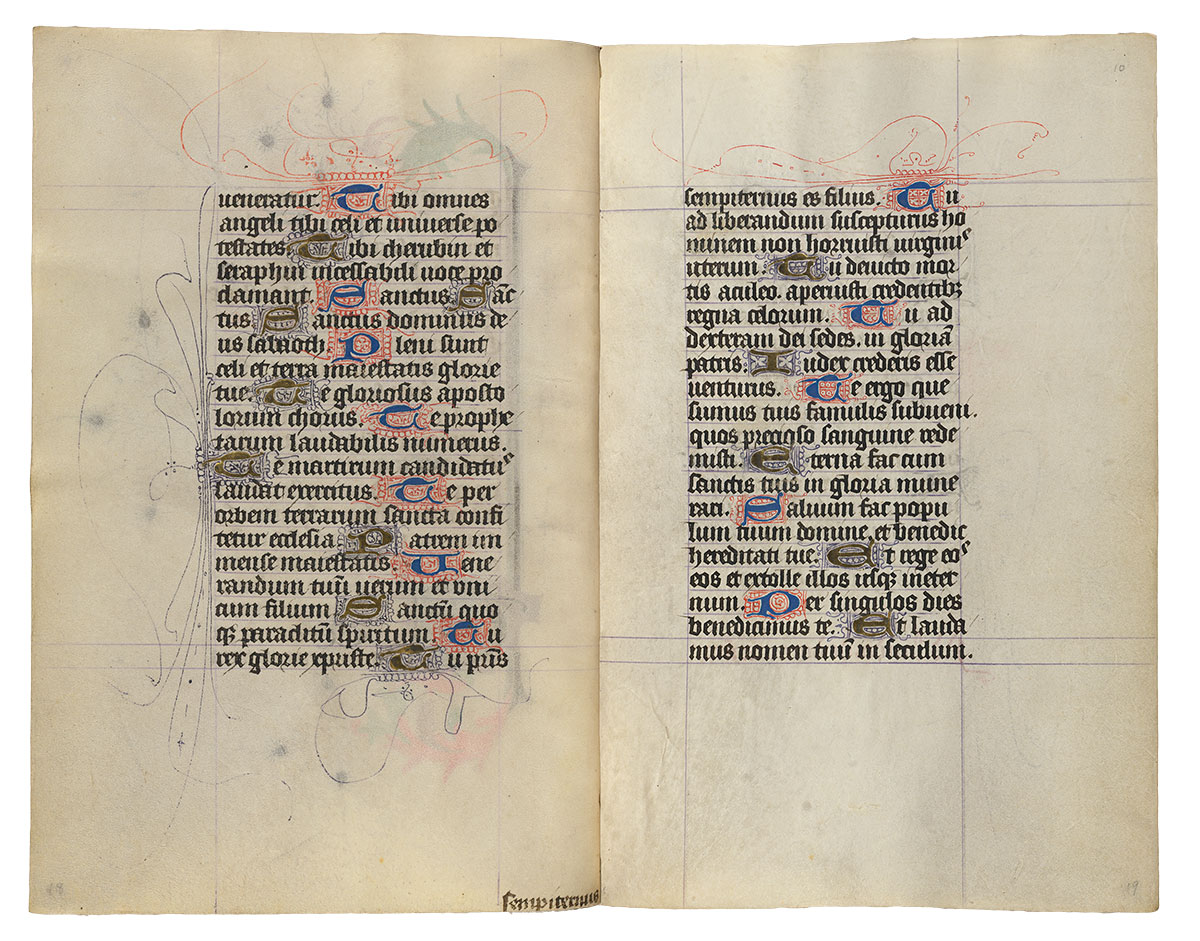
Purchased on the Belle da Costa Greene Fund with the assistance of the Fellows and with special assistance of Mrs. Frederick B. Adams, Sr., Mrs. Robert Charles, Mr. Laurens M. Hamilton, The Heineman Foundation, Mrs. Donald F. Hyde, Mrs. Jacob M. Kaplan, Mrs. John Kean, Mr. Paul Mellon, Mr. and Mrs. Charles F. Morgan, Mr. Lessing J. Rosenwald, Mr. and Mrs. August H. Schilling, Mrs. Herbert N. Straus, Mrs. Landon K. Thorne, Mrs. Alan Valentine, Mr. and Mrs. Arnold Whitridge, and Miss Julia P. Wightman, 1970
Image courtesy of Faksimile Verlag Luzern
MS M.917/945, ff. 10v–11r
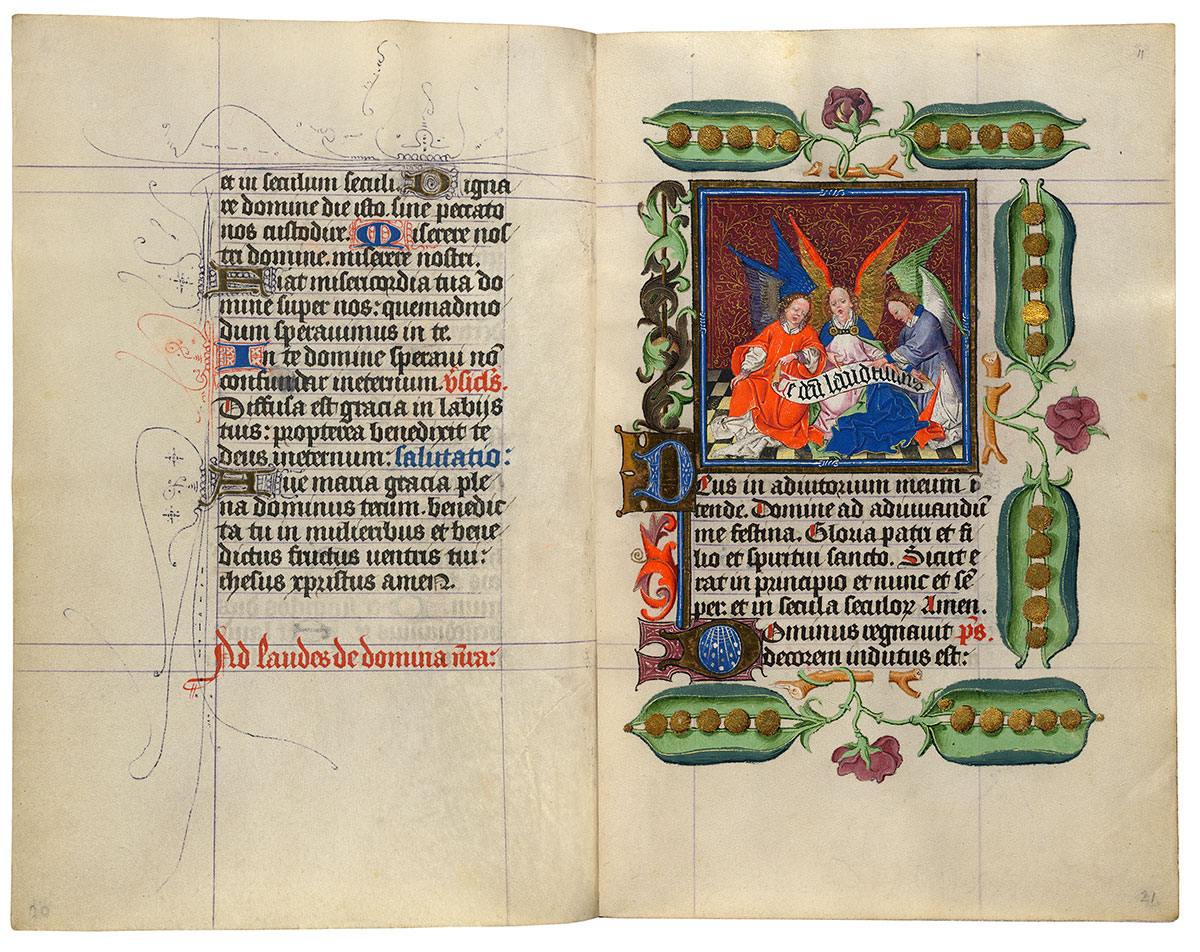
Singing Angels
Purchased on the Belle da Costa Greene Fund with the assistance of the Fellows and with special assistance of Mrs. Frederick B. Adams, Sr., Mrs. Robert Charles, Mr. Laurens M. Hamilton, The Heineman Foundation, Mrs. Donald F. Hyde, Mrs. Jacob M. Kaplan, Mrs. John Kean, Mr. Paul Mellon, Mr. and Mrs. Charles F. Morgan, Mr. Lessing J. Rosenwald, Mr. and Mrs. August H. Schilling, Mrs. Herbert N. Straus, Mrs. Landon K. Thorne, Mrs. Alan Valentine, Mr. and Mrs. Arnold Whitridge, and Miss Julia P. Wightman, 1970
Three angels sing the Te deum (We praise thee, O God), a hymn that appears at the end of Matins of the Virgin. Angels are mentioned first in the hymn's list of those who joyfully worship God. In the margins, golden peas in open pods symbolize fertility—the theme of the full-page miniature (one of eleven now missing from the manuscript) that originally faced these chanting angels. This was the Annunciation to Anne that she was pregnant with the Virgin Mary.
Hours of the Virgin
The heart of every Book of Hours is the series of prayers called the Hours of the Virgin. Each Hour is composed of psalms plus hymns, biblical readings, and short phrases (antiphons, versicles, and responses). Ideally, these eight Hours were prayed throughout the course of the day:
| Matins and Lauds | at night or upon rising |
| Prime (first Hour) | at 6:00 a.m. |
| Terce (third Hour) | at 9:00 a.m. |
| Sext (sixth Hour) | at noon |
| Nones (ninth Hour) | at 3:00 p.m. |
| Vespers (evensong) | in the early evening |
| Compline | before retiring. |
The Hours of the Virgin date back to at least the ninth century. By the late twelfth century, the Hours appeared in Psalters, prayer books popular with laypeople. With a rising economy and the growth of the merchant class, the thirteenth century saw an increase in lay literacy. By the middle of the century, the Hours of the Virgin "spun off" from the Psalter and formed the core of the laypeople's prayer book, the Book of Hours.
The Virgin Mary is, of course, not mentioned in the numerous psalms of the Old Testament that comprise much of the Hours. Framing the psalms, however, are prayers that offer a mystical interpretation of the psalms and reveal the role played by the Virgin in mankind's salvation.
Image courtesy of Faksimile Verlag Luzern
MS M.917/945, ff. 11v–12r
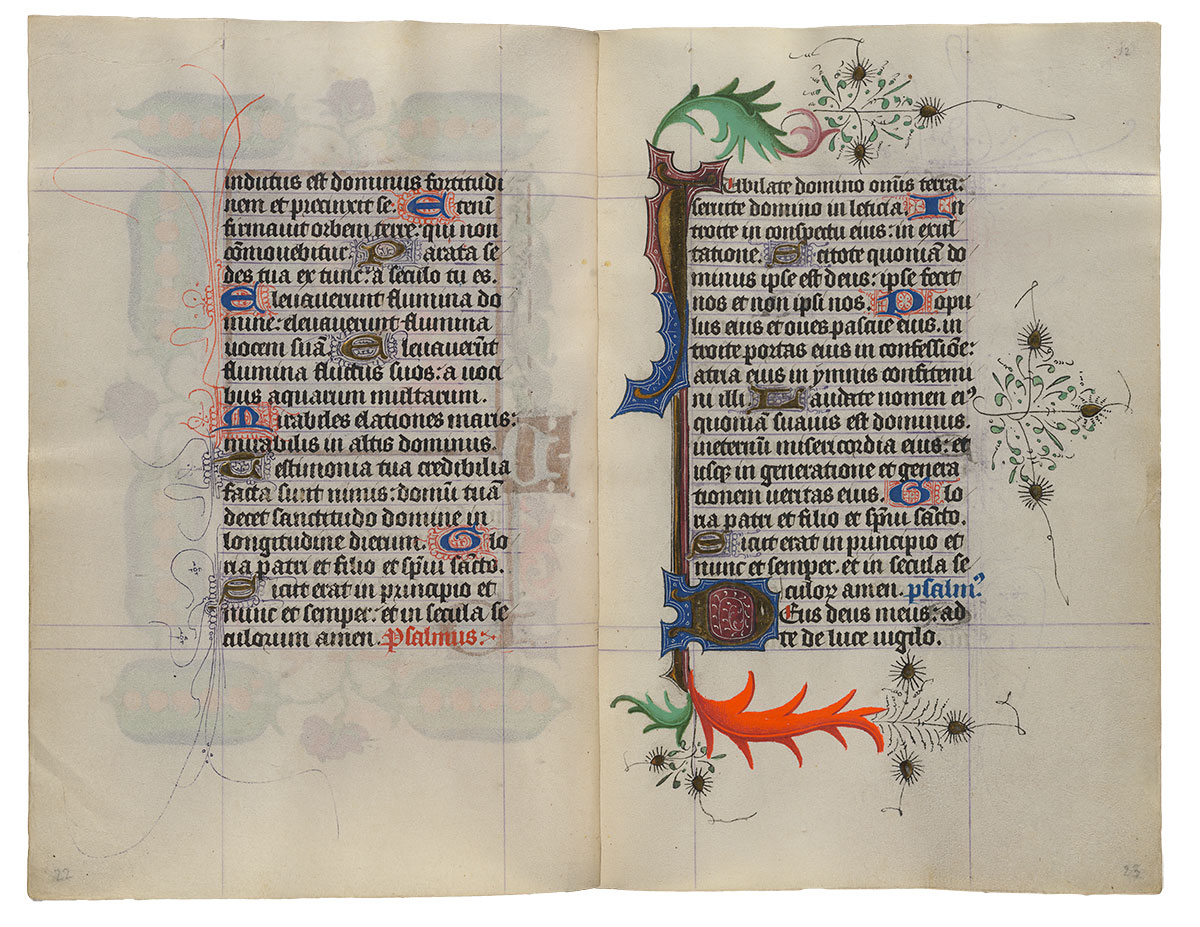
Purchased on the Belle da Costa Greene Fund with the assistance of the Fellows and with special assistance of Mrs. Frederick B. Adams, Sr., Mrs. Robert Charles, Mr. Laurens M. Hamilton, The Heineman Foundation, Mrs. Donald F. Hyde, Mrs. Jacob M. Kaplan, Mrs. John Kean, Mr. Paul Mellon, Mr. and Mrs. Charles F. Morgan, Mr. Lessing J. Rosenwald, Mr. and Mrs. August H. Schilling, Mrs. Herbert N. Straus, Mrs. Landon K. Thorne, Mrs. Alan Valentine, Mr. and Mrs. Arnold Whitridge, and Miss Julia P. Wightman, 1970
Image courtesy of Faksimile Verlag Luzern
MS M.917/945, ff. 12v–13r
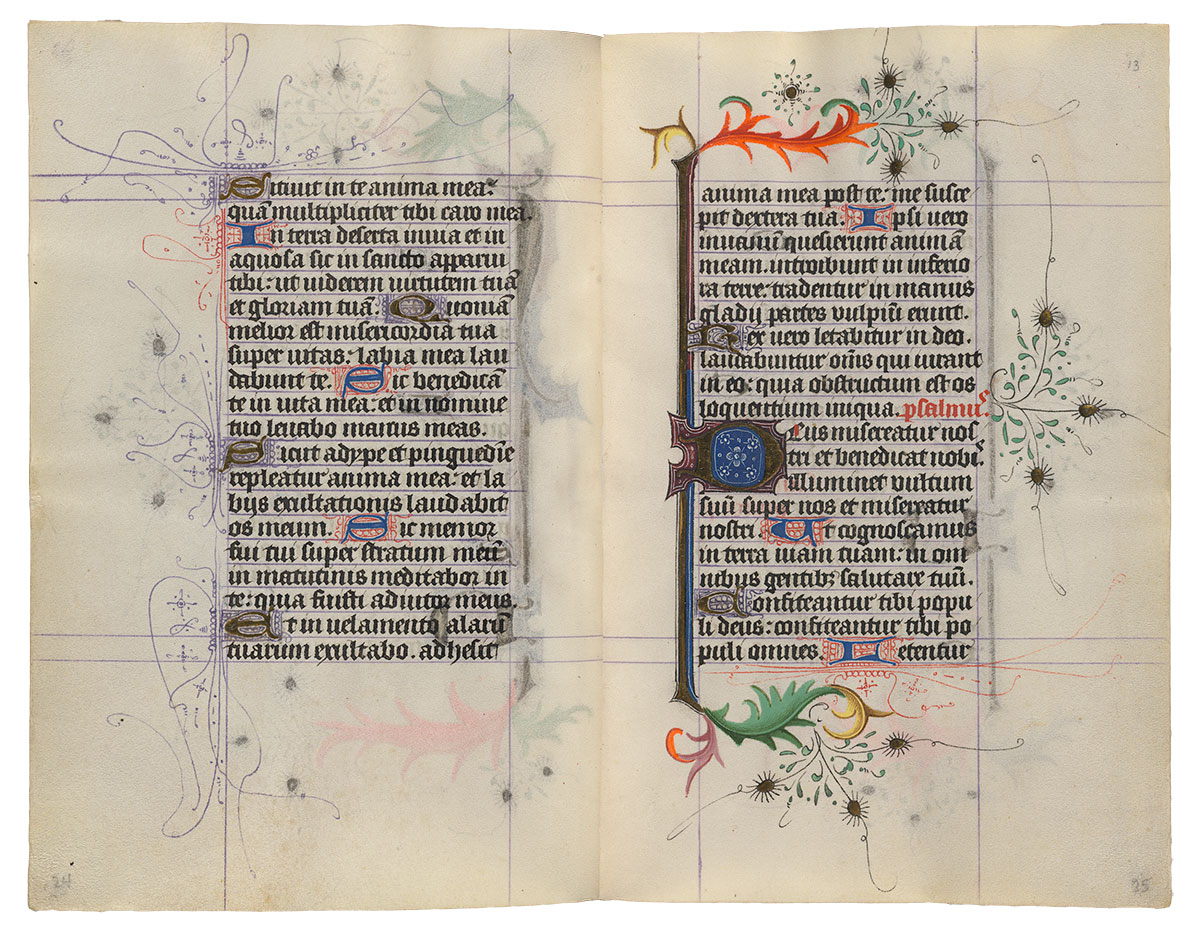
Purchased on the Belle da Costa Greene Fund with the assistance of the Fellows and with special assistance of Mrs. Frederick B. Adams, Sr., Mrs. Robert Charles, Mr. Laurens M. Hamilton, The Heineman Foundation, Mrs. Donald F. Hyde, Mrs. Jacob M. Kaplan, Mrs. John Kean, Mr. Paul Mellon, Mr. and Mrs. Charles F. Morgan, Mr. Lessing J. Rosenwald, Mr. and Mrs. August H. Schilling, Mrs. Herbert N. Straus, Mrs. Landon K. Thorne, Mrs. Alan Valentine, Mr. and Mrs. Arnold Whitridge, and Miss Julia P. Wightman, 1970
Image courtesy of Faksimile Verlag Luzern
MS M.917/945, ff. 13v–14r
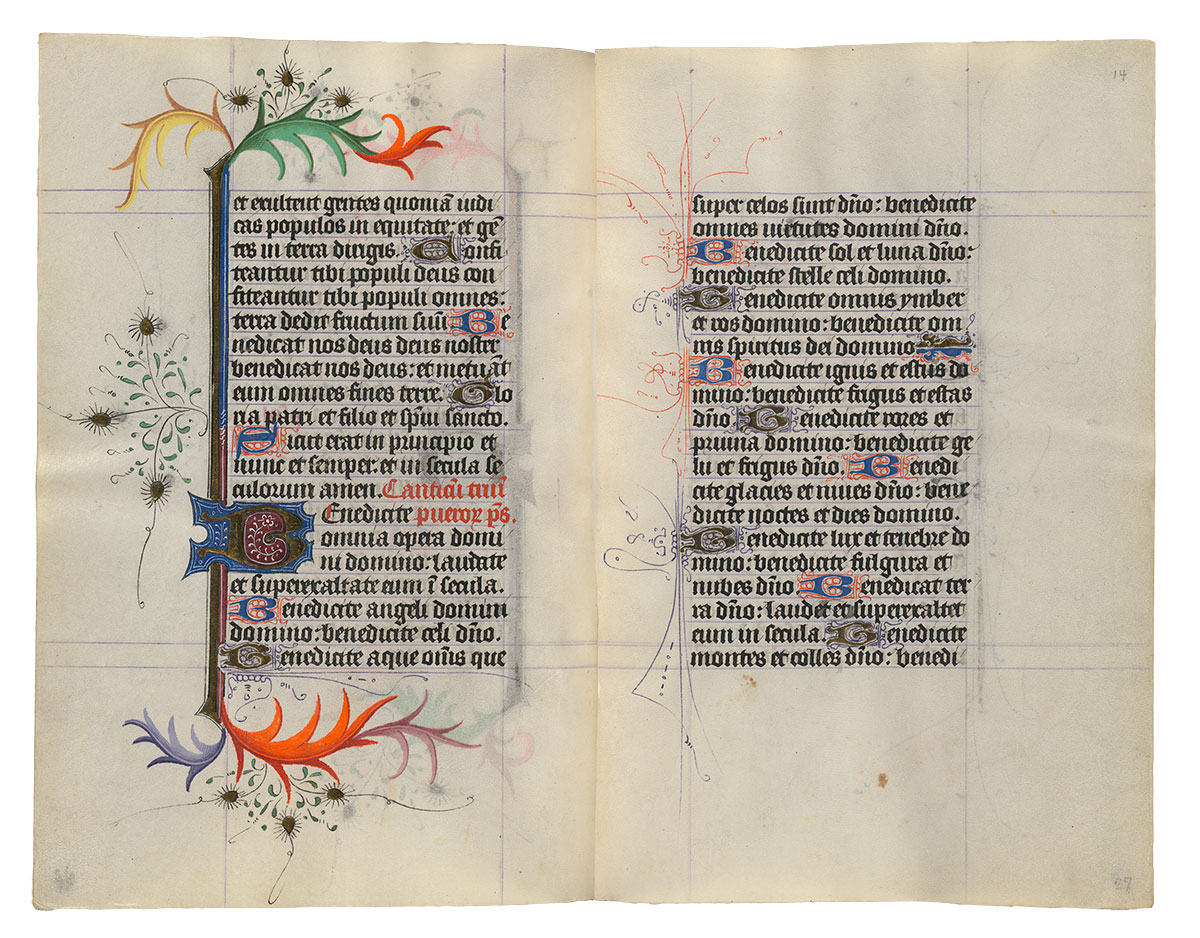
Purchased on the Belle da Costa Greene Fund with the assistance of the Fellows and with special assistance of Mrs. Frederick B. Adams, Sr., Mrs. Robert Charles, Mr. Laurens M. Hamilton, The Heineman Foundation, Mrs. Donald F. Hyde, Mrs. Jacob M. Kaplan, Mrs. John Kean, Mr. Paul Mellon, Mr. and Mrs. Charles F. Morgan, Mr. Lessing J. Rosenwald, Mr. and Mrs. August H. Schilling, Mrs. Herbert N. Straus, Mrs. Landon K. Thorne, Mrs. Alan Valentine, Mr. and Mrs. Arnold Whitridge, and Miss Julia P. Wightman, 1970
Image courtesy of Faksimile Verlag Luzern
MS M.917/945, ff. 14v–15r
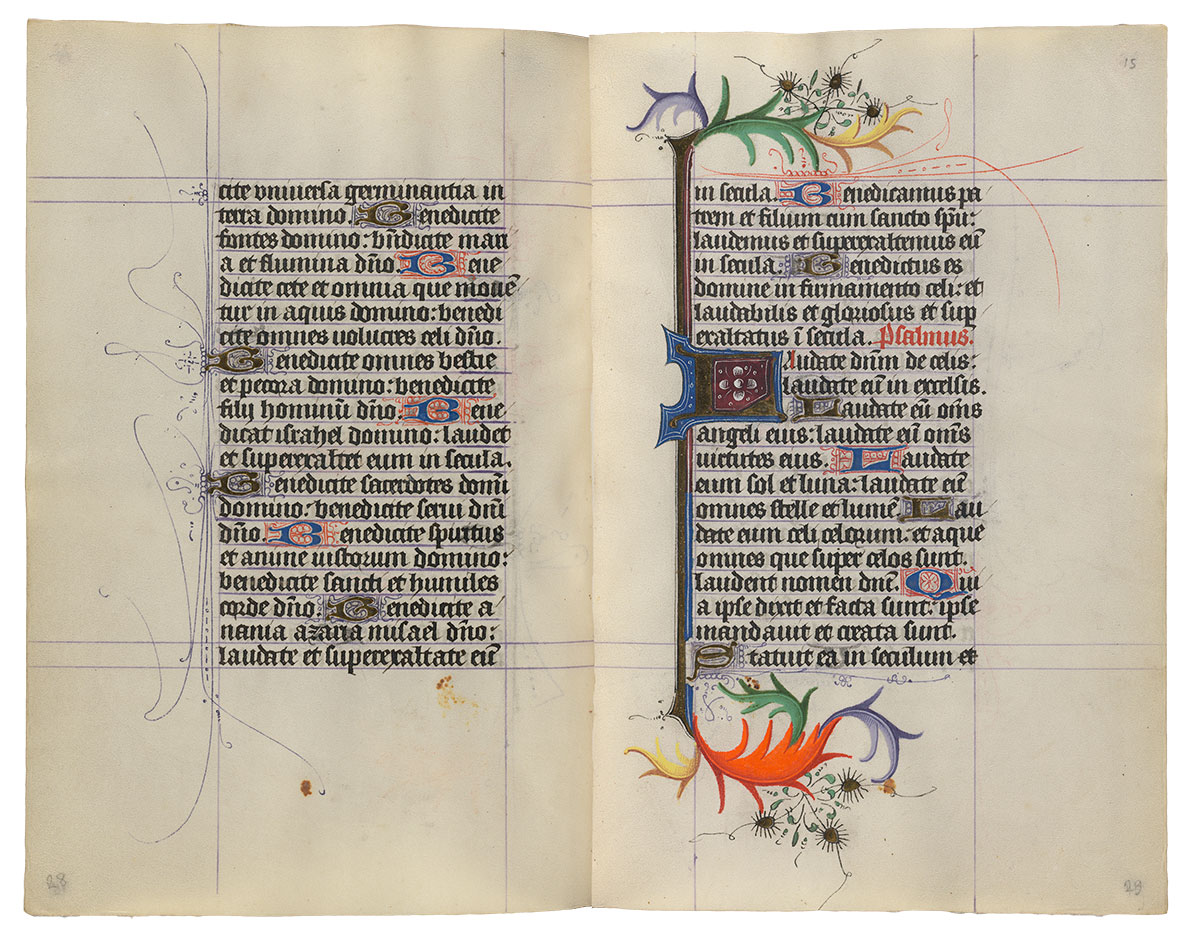
Purchased on the Belle da Costa Greene Fund with the assistance of the Fellows and with special assistance of Mrs. Frederick B. Adams, Sr., Mrs. Robert Charles, Mr. Laurens M. Hamilton, The Heineman Foundation, Mrs. Donald F. Hyde, Mrs. Jacob M. Kaplan, Mrs. John Kean, Mr. Paul Mellon, Mr. and Mrs. Charles F. Morgan, Mr. Lessing J. Rosenwald, Mr. and Mrs. August H. Schilling, Mrs. Herbert N. Straus, Mrs. Landon K. Thorne, Mrs. Alan Valentine, Mr. and Mrs. Arnold Whitridge, and Miss Julia P. Wightman, 1970
Image courtesy of Faksimile Verlag Luzern
MS M.917/945, ff. 15v–16r
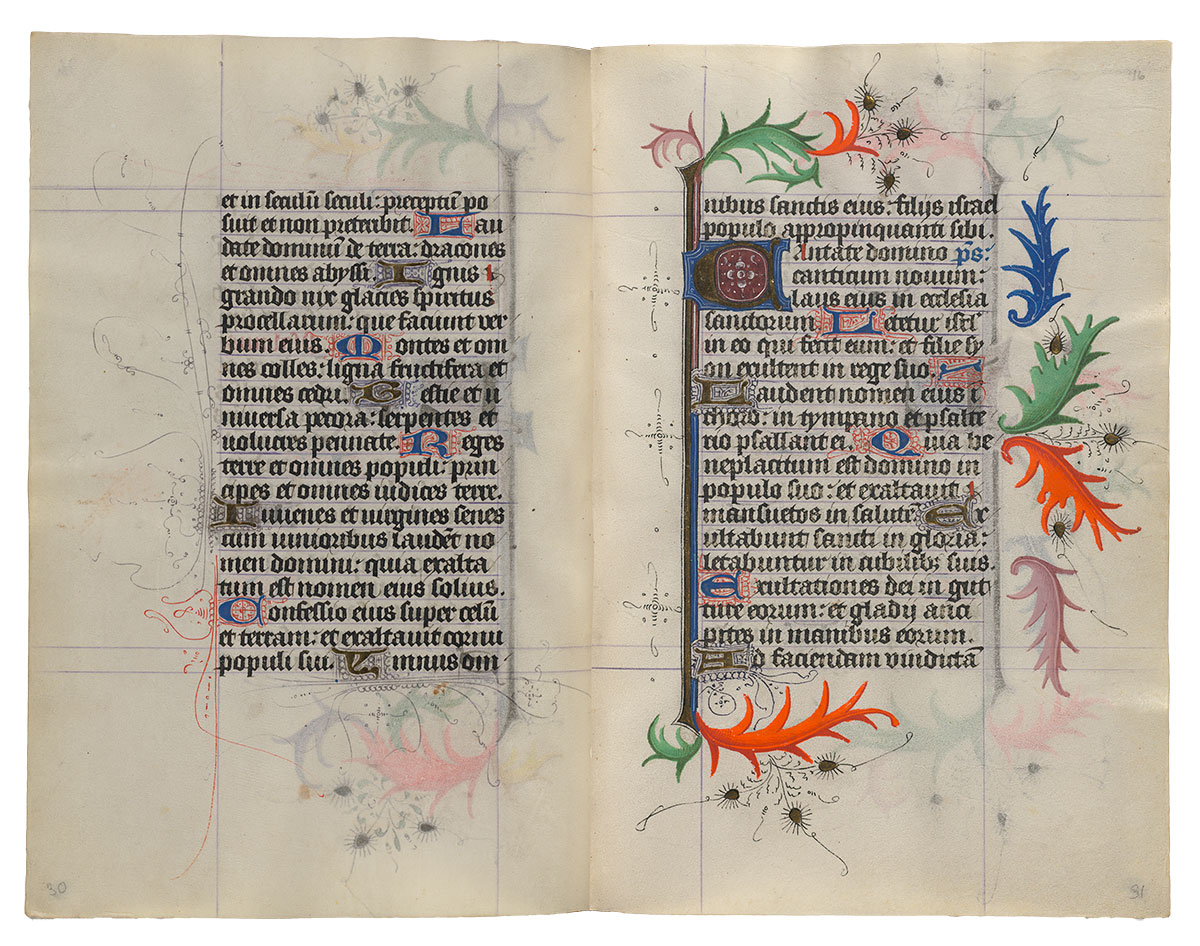
Purchased on the Belle da Costa Greene Fund with the assistance of the Fellows and with special assistance of Mrs. Frederick B. Adams, Sr., Mrs. Robert Charles, Mr. Laurens M. Hamilton, The Heineman Foundation, Mrs. Donald F. Hyde, Mrs. Jacob M. Kaplan, Mrs. John Kean, Mr. Paul Mellon, Mr. and Mrs. Charles F. Morgan, Mr. Lessing J. Rosenwald, Mr. and Mrs. August H. Schilling, Mrs. Herbert N. Straus, Mrs. Landon K. Thorne, Mrs. Alan Valentine, Mr. and Mrs. Arnold Whitridge, and Miss Julia P. Wightman, 1970
Image courtesy of Faksimile Verlag Luzern
MS M.917/945, ff. 16v–17r
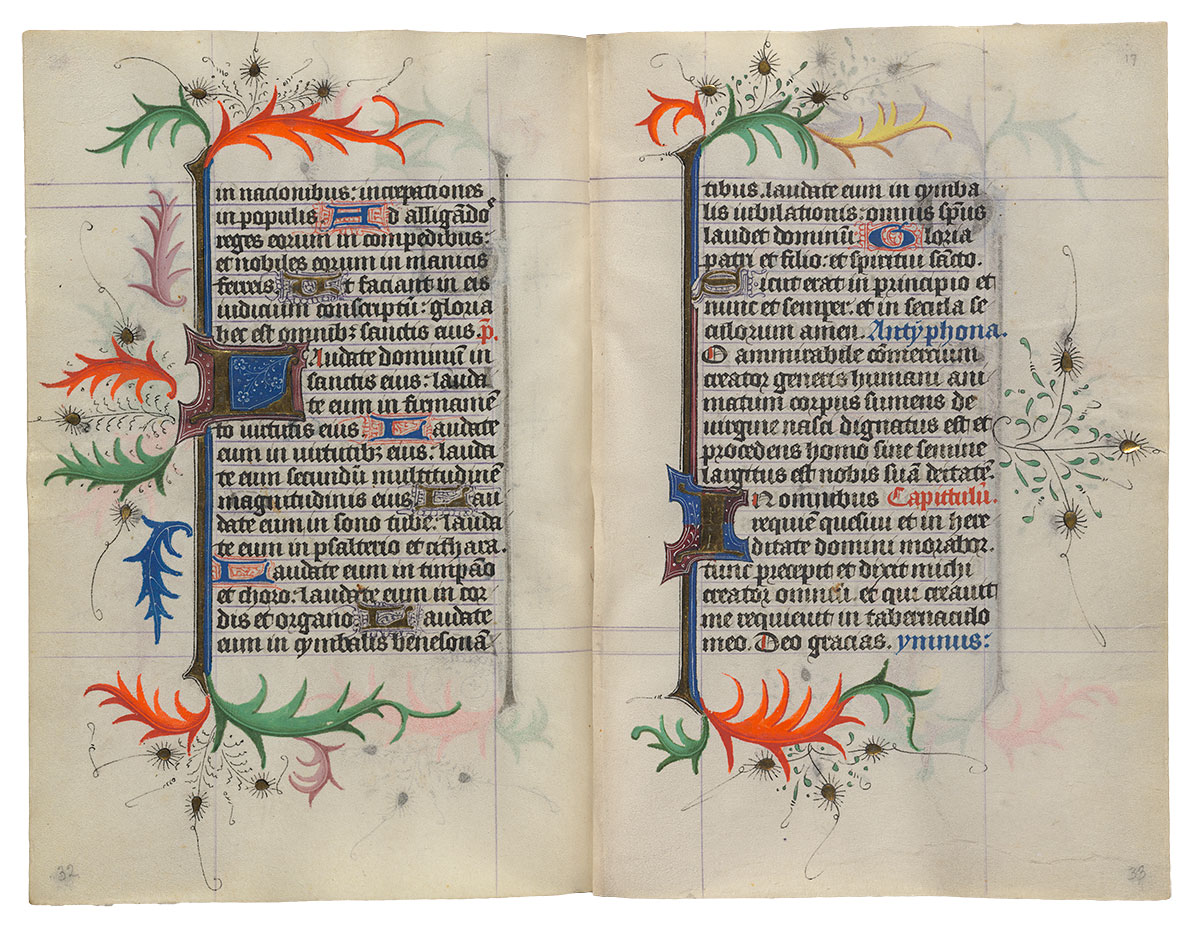
Purchased on the Belle da Costa Greene Fund with the assistance of the Fellows and with special assistance of Mrs. Frederick B. Adams, Sr., Mrs. Robert Charles, Mr. Laurens M. Hamilton, The Heineman Foundation, Mrs. Donald F. Hyde, Mrs. Jacob M. Kaplan, Mrs. John Kean, Mr. Paul Mellon, Mr. and Mrs. Charles F. Morgan, Mr. Lessing J. Rosenwald, Mr. and Mrs. August H. Schilling, Mrs. Herbert N. Straus, Mrs. Landon K. Thorne, Mrs. Alan Valentine, Mr. and Mrs. Arnold Whitridge, and Miss Julia P. Wightman, 1970
Image courtesy of Faksimile Verlag Luzern
MS M.917/945, ff. 17v–18r
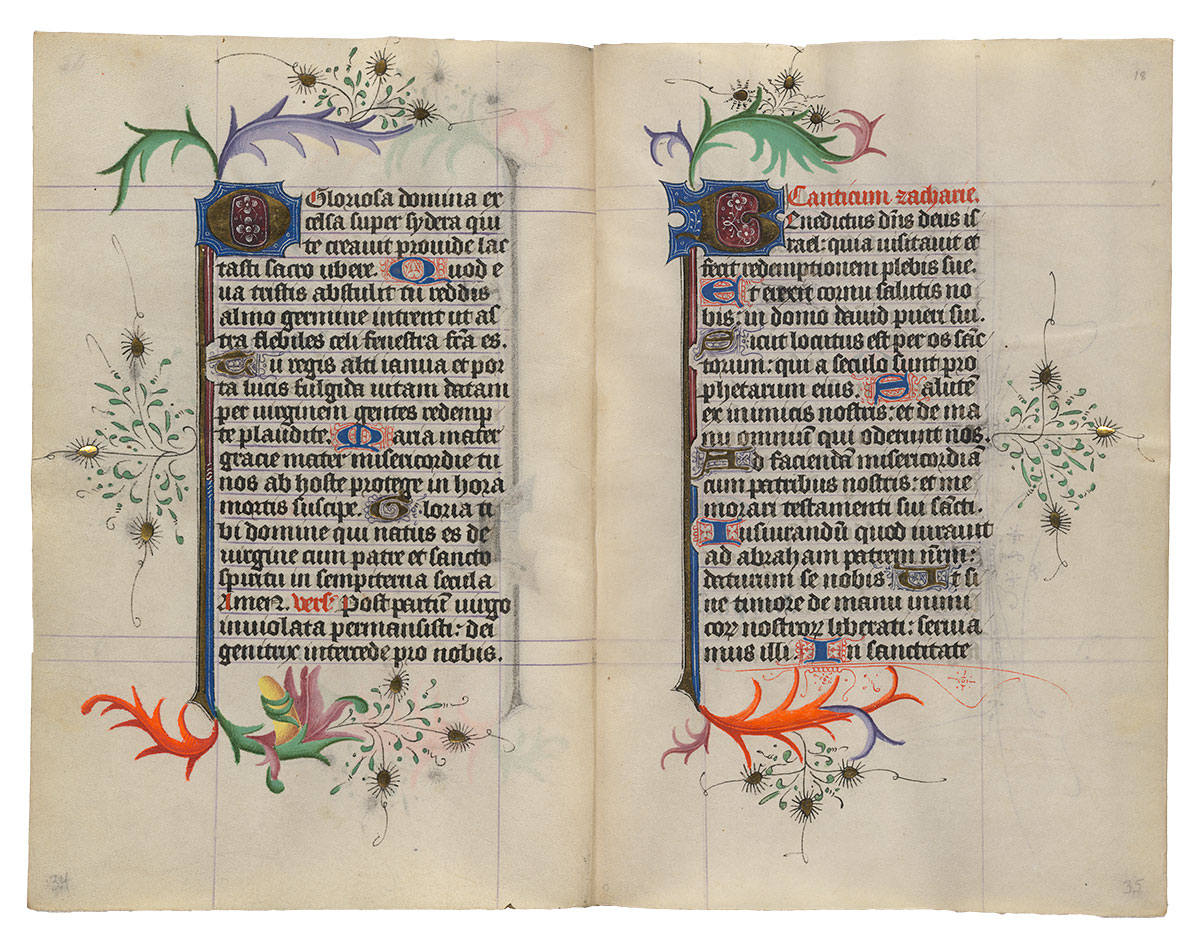
Purchased on the Belle da Costa Greene Fund with the assistance of the Fellows and with special assistance of Mrs. Frederick B. Adams, Sr., Mrs. Robert Charles, Mr. Laurens M. Hamilton, The Heineman Foundation, Mrs. Donald F. Hyde, Mrs. Jacob M. Kaplan, Mrs. John Kean, Mr. Paul Mellon, Mr. and Mrs. Charles F. Morgan, Mr. Lessing J. Rosenwald, Mr. and Mrs. August H. Schilling, Mrs. Herbert N. Straus, Mrs. Landon K. Thorne, Mrs. Alan Valentine, Mr. and Mrs. Arnold Whitridge, and Miss Julia P. Wightman, 1970
Image courtesy of Faksimile Verlag Luzern
MS M.917/945, ff. 18v–19r
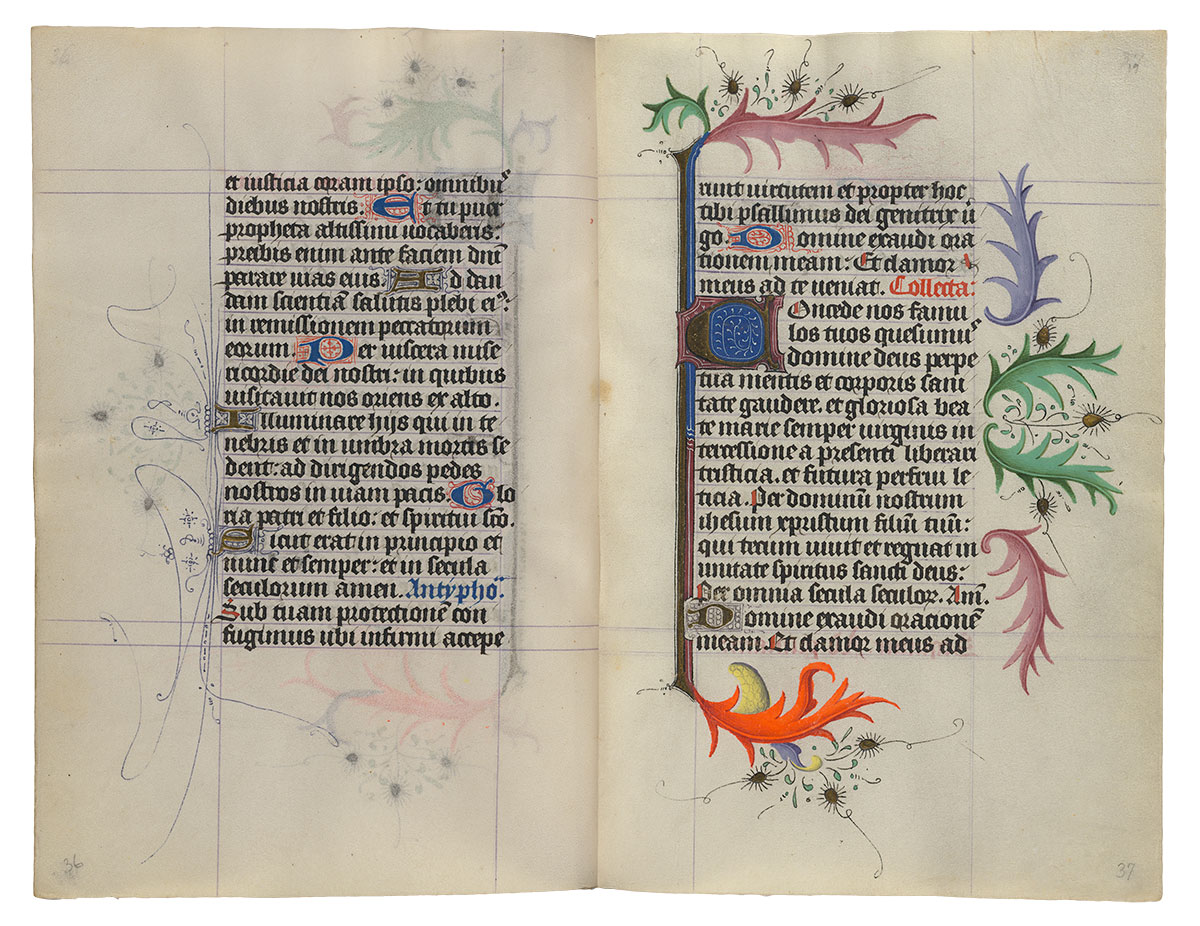
Purchased on the Belle da Costa Greene Fund with the assistance of the Fellows and with special assistance of Mrs. Frederick B. Adams, Sr., Mrs. Robert Charles, Mr. Laurens M. Hamilton, The Heineman Foundation, Mrs. Donald F. Hyde, Mrs. Jacob M. Kaplan, Mrs. John Kean, Mr. Paul Mellon, Mr. and Mrs. Charles F. Morgan, Mr. Lessing J. Rosenwald, Mr. and Mrs. August H. Schilling, Mrs. Herbert N. Straus, Mrs. Landon K. Thorne, Mrs. Alan Valentine, Mr. and Mrs. Arnold Whitridge, and Miss Julia P. Wightman, 1970
Image courtesy of Faksimile Verlag Luzern
MS M.917/945, f. 019v–p. 143
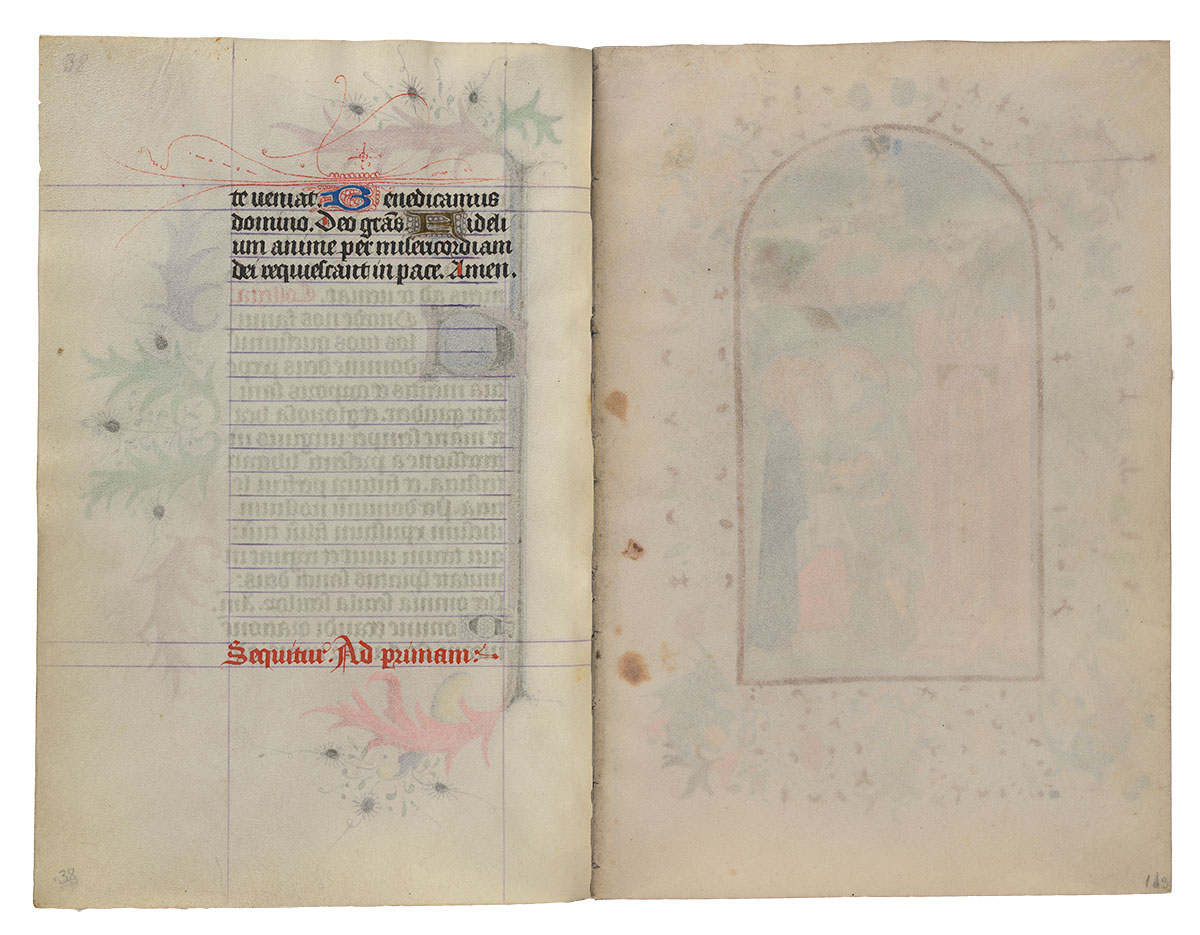
Purchased on the Belle da Costa Greene Fund with the assistance of the Fellows and with special assistance of Mrs. Frederick B. Adams, Sr., Mrs. Robert Charles, Mr. Laurens M. Hamilton, The Heineman Foundation, Mrs. Donald F. Hyde, Mrs. Jacob M. Kaplan, Mrs. John Kean, Mr. Paul Mellon, Mr. and Mrs. Charles F. Morgan, Mr. Lessing J. Rosenwald, Mr. and Mrs. August H. Schilling, Mrs. Herbert N. Straus, Mrs. Landon K. Thorne, Mrs. Alan Valentine, Mr. and Mrs. Arnold Whitridge, and Miss Julia P. Wightman, 1970
Image courtesy of Faksimile Verlag Luzern
MS M.917/945, p. 144–f. 20r
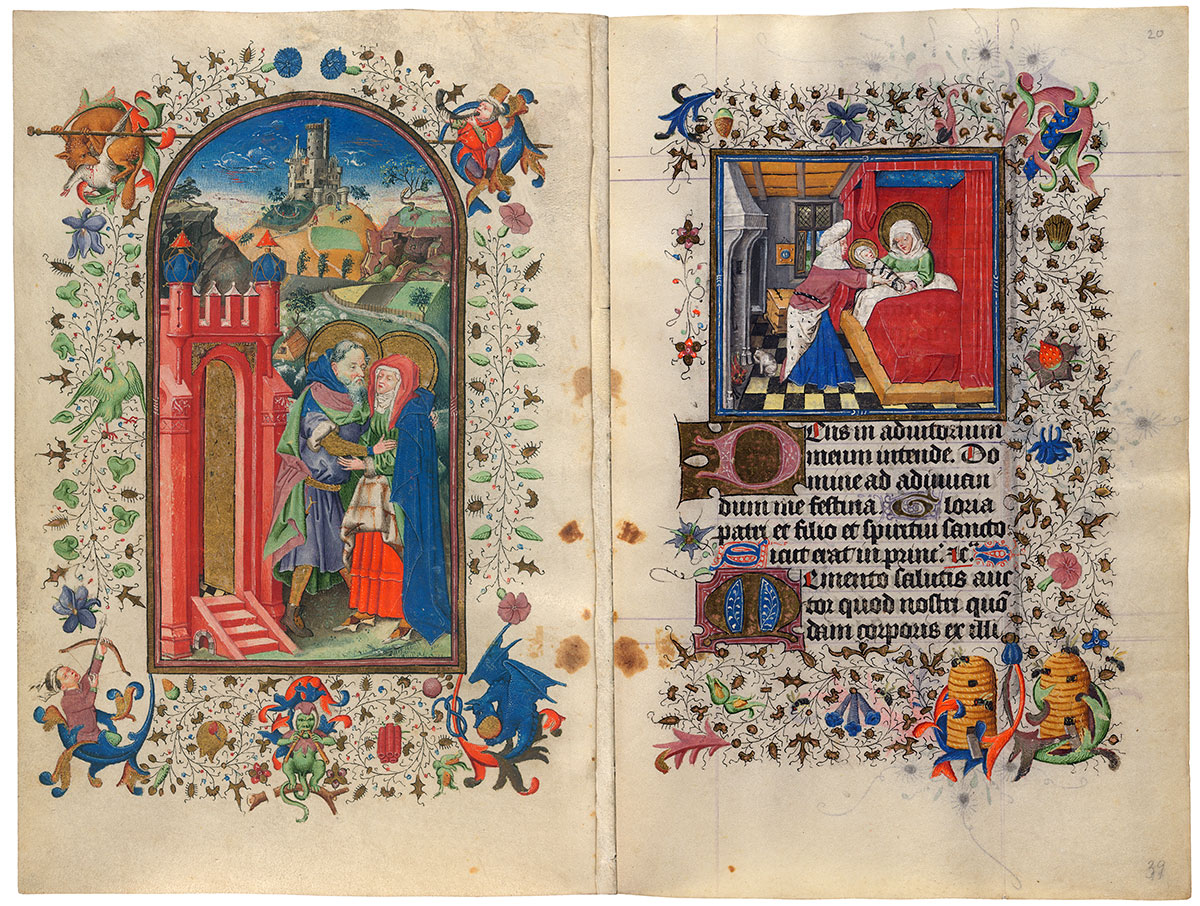
Joachim and Anne Meeting at the Golden Gate
Birth of the Virgin
Purchased on the Belle da Costa Greene Fund with the assistance of the Fellows, 1963; purchased on the Belle da Costa Greene Fund with the assistance of the Fellows and with special assistance of Mrs. Frederick B. Adams, Sr., Mrs. Robert Charles, Mr. Laurens M. Hamilton, The Heineman Foundation, Mrs. Donald F. Hyde, Mrs. Jacob M. Kaplan, Mrs. John Kean, Mr. Paul Mellon, Mr. and Mrs. Charles F. Morgan, Mr. Lessing J. Rosenwald, Mr. and Mrs. August H. Schilling, Mrs. Herbert N. Straus, Mrs. Landon K. Thorne, Mrs. Alan Valentine, Mr. and Mrs. Arnold Whitridge, and Miss Julia P. Wightman, 1970
The Marian narrative continues with the joyous meeting of Joachim and Anne at Jerusalem's Golden Gate, where they tenderly embrace, sharing their delight in the prospect of parenting a child in their advanced years. The Master of Catherine of Cleves included in this miniature a deep landscape that unfolds with sheep, cultivated fields, a cave, and a hilltop castle.
Hours of the Virgin
The heart of every Book of Hours is the series of prayers called the Hours of the Virgin. Each Hour is composed of psalms plus hymns, biblical readings, and short phrases (antiphons, versicles, and responses). Ideally, these eight Hours were prayed throughout the course of the day:
| Matins and Lauds | at night or upon rising |
| Prime (first Hour) | at 6:00 a.m. |
| Terce (third Hour) | at 9:00 a.m. |
| Sext (sixth Hour) | at noon |
| Nones (ninth Hour) | at 3:00 p.m. |
| Vespers (evensong) | in the early evening |
| Compline | before retiring. |
The Hours of the Virgin date back to at least the ninth century. By the late twelfth century, the Hours appeared in Psalters, prayer books popular with laypeople. With a rising economy and the growth of the merchant class, the thirteenth century saw an increase in lay literacy. By the middle of the century, the Hours of the Virgin "spun off" from the Psalter and formed the core of the laypeople's prayer book, the Book of Hours.
The Virgin Mary is, of course, not mentioned in the numerous psalms of the Old Testament that comprise much of the Hours. Framing the psalms, however, are prayers that offer a mystical interpretation of the psalms and reveal the role played by the Virgin in mankind's salvation.
Image courtesy of Faksimile Verlag Luzern
MS M.917/945, ff. 20v–21r
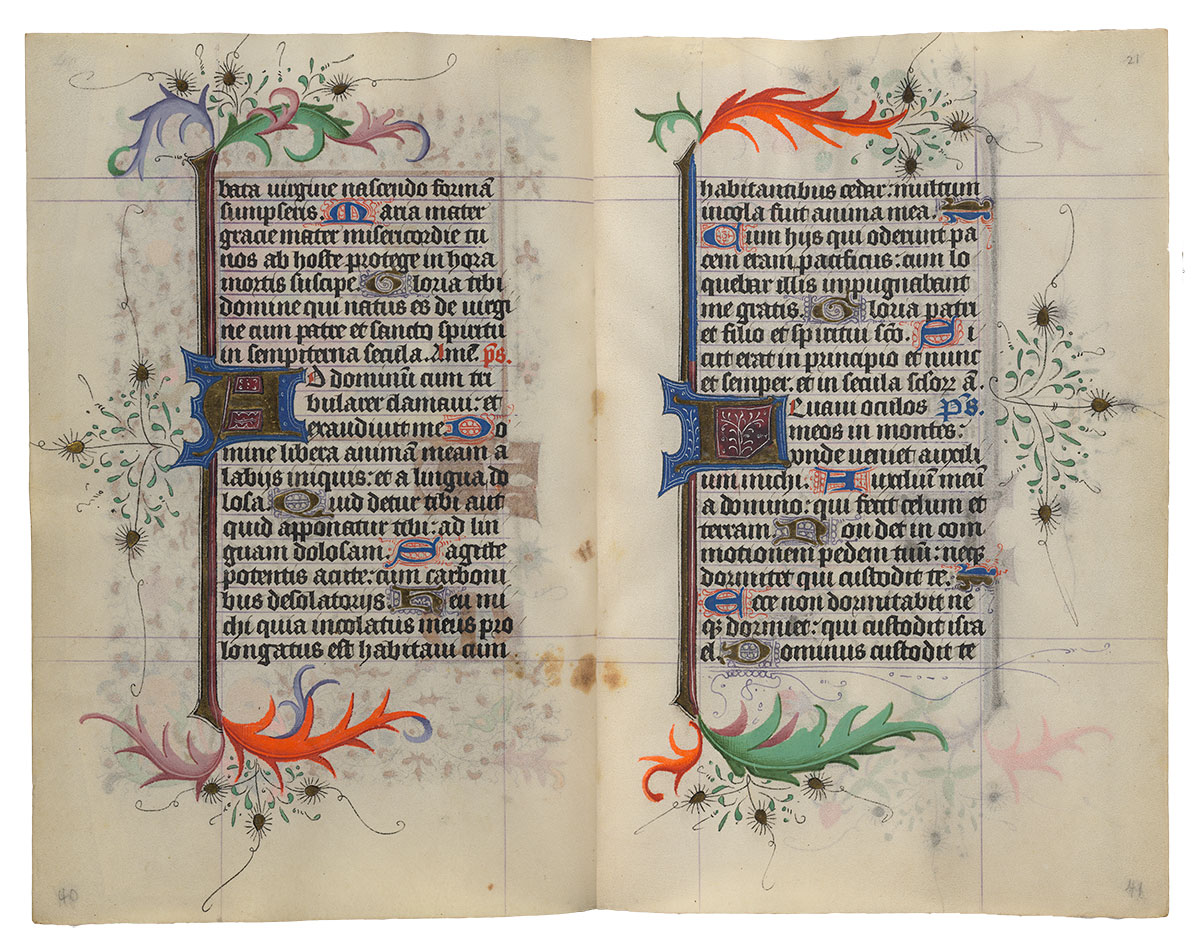
Purchased on the Belle da Costa Greene Fund with the assistance of the Fellows and with special assistance of Mrs. Frederick B. Adams, Sr., Mrs. Robert Charles, Mr. Laurens M. Hamilton, The Heineman Foundation, Mrs. Donald F. Hyde, Mrs. Jacob M. Kaplan, Mrs. John Kean, Mr. Paul Mellon, Mr. and Mrs. Charles F. Morgan, Mr. Lessing J. Rosenwald, Mr. and Mrs. August H. Schilling, Mrs. Herbert N. Straus, Mrs. Landon K. Thorne, Mrs. Alan Valentine, Mr. and Mrs. Arnold Whitridge, and Miss Julia P. Wightman, 1970
Image courtesy of Faksimile Verlag Luzern
MS M.917/945, ff. 21v–22r
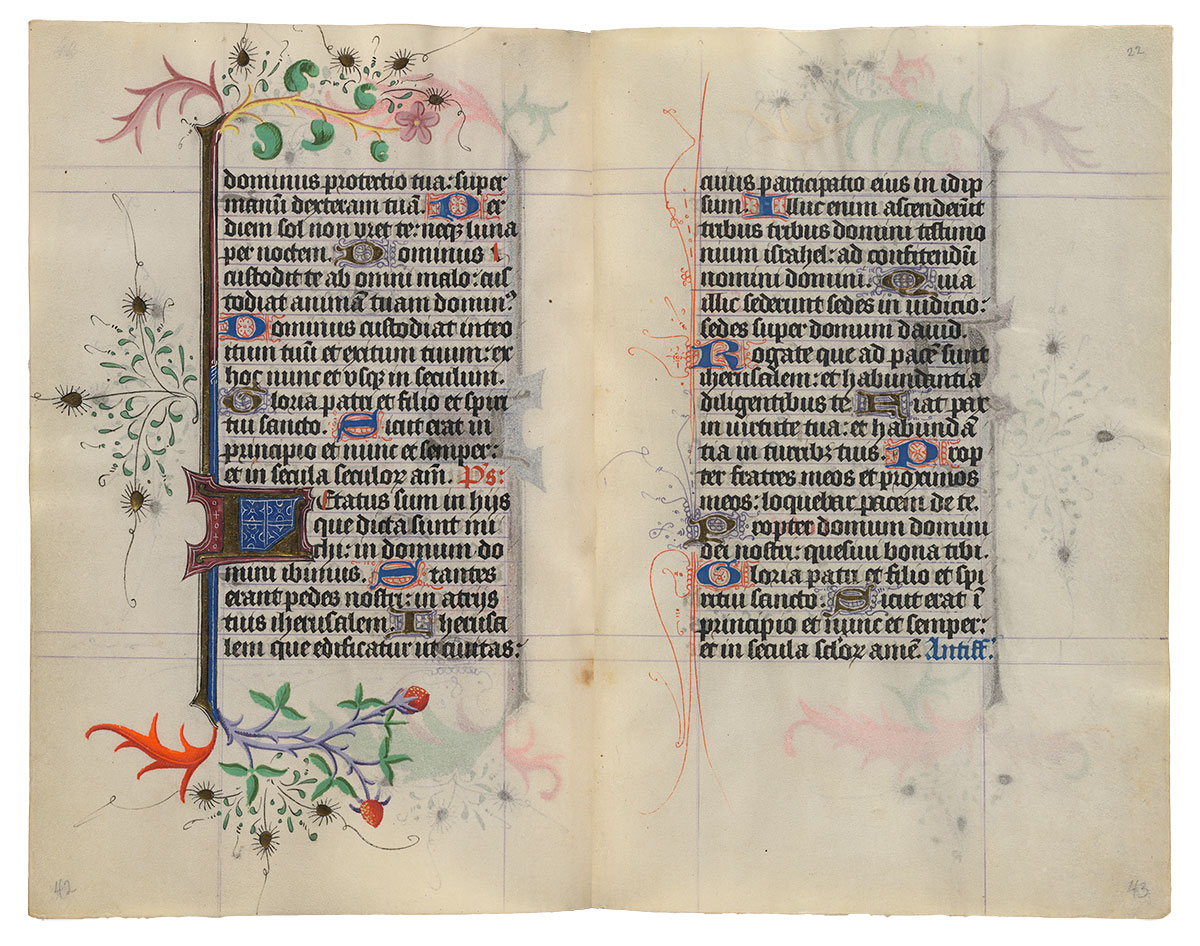
Purchased on the Belle da Costa Greene Fund with the assistance of the Fellows and with special assistance of Mrs. Frederick B. Adams, Sr., Mrs. Robert Charles, Mr. Laurens M. Hamilton, The Heineman Foundation, Mrs. Donald F. Hyde, Mrs. Jacob M. Kaplan, Mrs. John Kean, Mr. Paul Mellon, Mr. and Mrs. Charles F. Morgan, Mr. Lessing J. Rosenwald, Mr. and Mrs. August H. Schilling, Mrs. Herbert N. Straus, Mrs. Landon K. Thorne, Mrs. Alan Valentine, Mr. and Mrs. Arnold Whitridge, and Miss Julia P. Wightman, 1970
Image courtesy of Faksimile Verlag Luzern
MS M.917/945, ff. 22v–23r
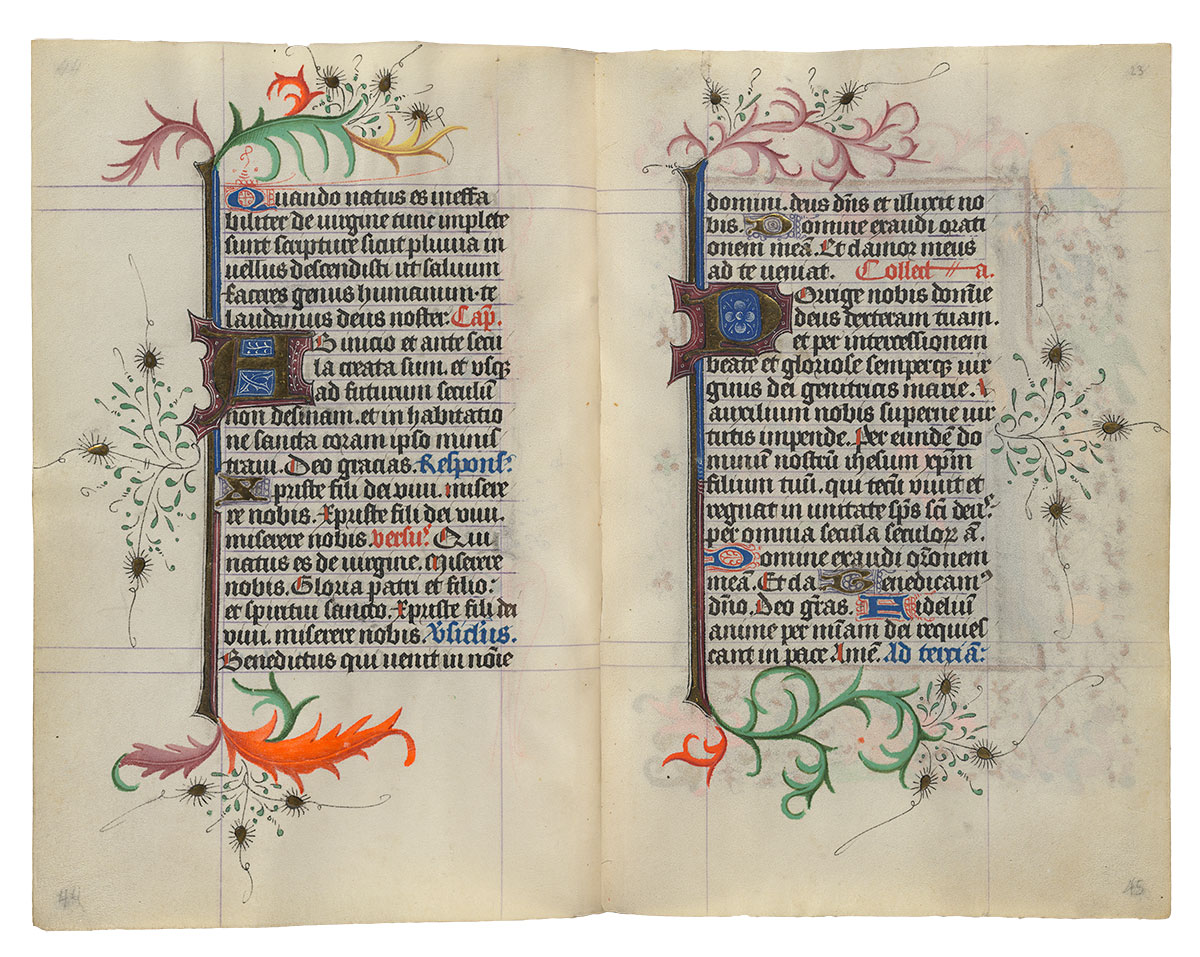
Purchased on the Belle da Costa Greene Fund with the assistance of the Fellows and with special assistance of Mrs. Frederick B. Adams, Sr., Mrs. Robert Charles, Mr. Laurens M. Hamilton, The Heineman Foundation, Mrs. Donald F. Hyde, Mrs. Jacob M. Kaplan, Mrs. John Kean, Mr. Paul Mellon, Mr. and Mrs. Charles F. Morgan, Mr. Lessing J. Rosenwald, Mr. and Mrs. August H. Schilling, Mrs. Herbert N. Straus, Mrs. Landon K. Thorne, Mrs. Alan Valentine, Mr. and Mrs. Arnold Whitridge, and Miss Julia P. Wightman, 1970
Image courtesy of Faksimile Verlag Luzern
MS M.917/945, ff. 23v–24r
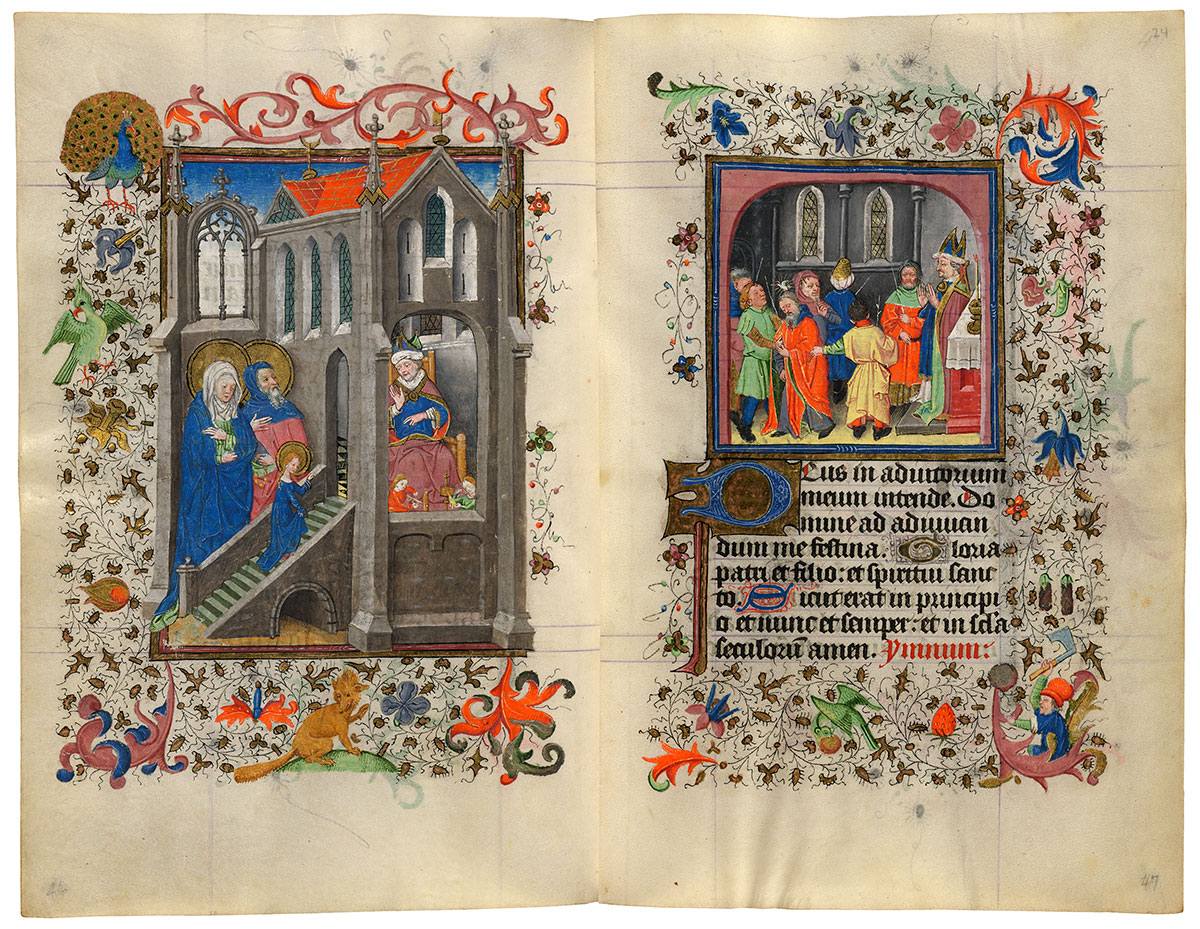
Presentation of the Virgin in the Temple
Joseph Designated as the Husband of the Virgin
Purchased on the Belle da Costa Greene Fund with the assistance of the Fellows and with special assistance of Mrs. Frederick B. Adams, Sr., Mrs. Robert Charles, Mr. Laurens M. Hamilton, The Heineman Foundation, Mrs. Donald F. Hyde, Mrs. Jacob M. Kaplan, Mrs. John Kean, Mr. Paul Mellon, Mr. and Mrs. Charles F. Morgan, Mr. Lessing J. Rosenwald, Mr. and Mrs. August H. Schilling, Mrs. Herbert N. Straus, Mrs. Landon K. Thorne, Mrs. Alan Valentine, Mr. and Mrs. Arnold Whitridge, and Miss Julia P. Wightman, 1970
The beginning of each of the eight Hours of the Virgin was originally marked, as here, with a juxtaposition of a full- and a half-page miniature. Such elaborate pictorial treatment of the individual Hours is one of the hallmarks of Catherine of Cleves's prayer book. On the left, the Virgin Mary ascends the steps of the temple, where she will join two maidens engaged in weaving and spinning. On the right, the elderly Joseph is designated as Mary's husband. The Virgin's suitors—with the exception of Joseph, above whose head floats the Dove of the Holy Spirit—are depicted with withered rods. A reluctant contestant, Joseph had tried to withdraw but was prevented by his fellow suitors.
Hours of the Virgin
The heart of every Book of Hours is the series of prayers called the Hours of the Virgin. Each Hour is composed of psalms plus hymns, biblical readings, and short phrases (antiphons, versicles, and responses). Ideally, these eight Hours were prayed throughout the course of the day:
| Matins and Lauds | at night or upon rising |
| Prime (first Hour) | at 6:00 a.m. |
| Terce (third Hour) | at 9:00 a.m. |
| Sext (sixth Hour) | at noon |
| Nones (ninth Hour) | at 3:00 p.m. |
| Vespers (evensong) | in the early evening |
| Compline | before retiring. |
The Hours of the Virgin date back to at least the ninth century. By the late twelfth century, the Hours appeared in Psalters, prayer books popular with laypeople. With a rising economy and the growth of the merchant class, the thirteenth century saw an increase in lay literacy. By the middle of the century, the Hours of the Virgin "spun off" from the Psalter and formed the core of the laypeople's prayer book, the Book of Hours.
The Virgin Mary is, of course, not mentioned in the numerous psalms of the Old Testament that comprise much of the Hours. Framing the psalms, however, are prayers that offer a mystical interpretation of the psalms and reveal the role played by the Virgin in mankind's salvation.
Image courtesy of Faksimile Verlag Luzern
MS M.917/945, ff. 24v–25r
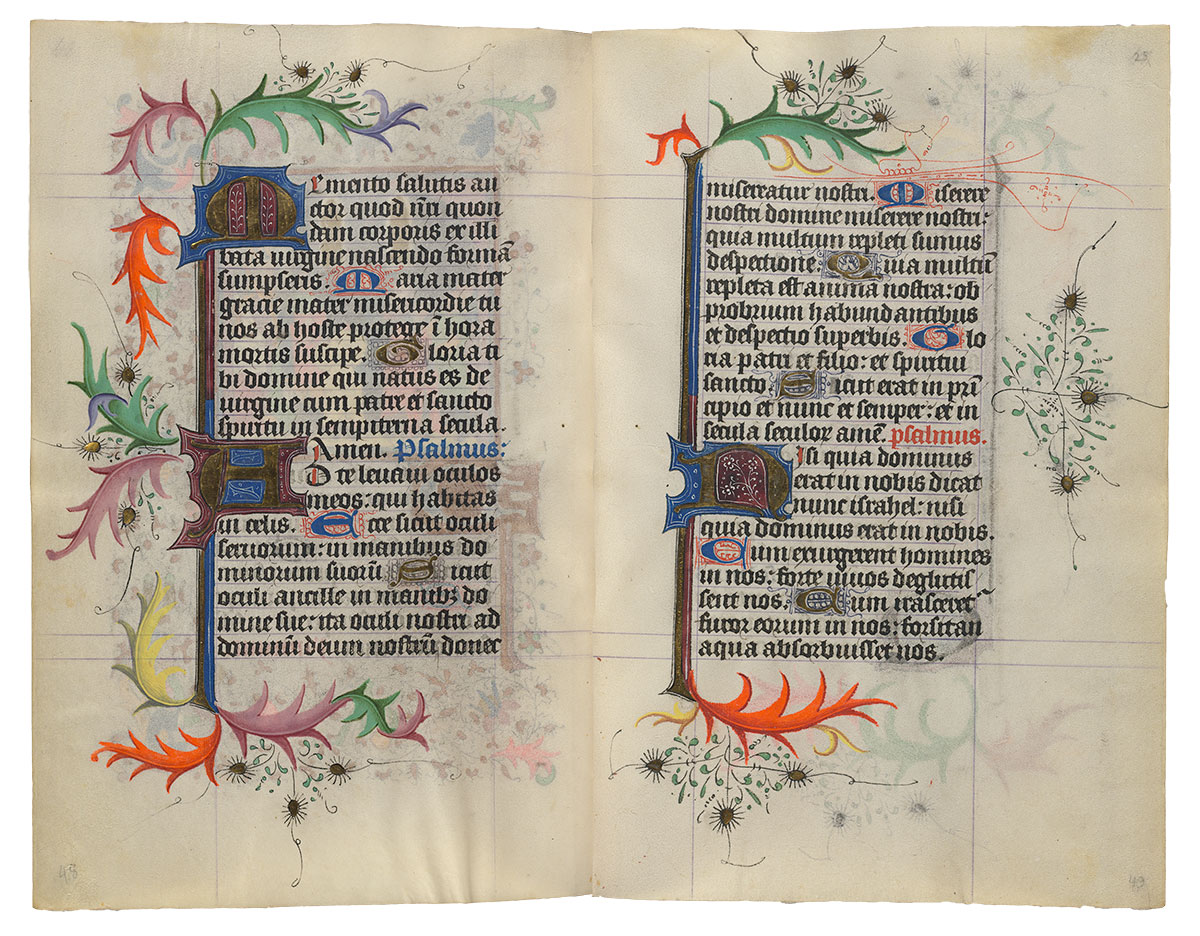
Purchased on the Belle da Costa Greene Fund with the assistance of the Fellows and with special assistance of Mrs. Frederick B. Adams, Sr., Mrs. Robert Charles, Mr. Laurens M. Hamilton, The Heineman Foundation, Mrs. Donald F. Hyde, Mrs. Jacob M. Kaplan, Mrs. John Kean, Mr. Paul Mellon, Mr. and Mrs. Charles F. Morgan, Mr. Lessing J. Rosenwald, Mr. and Mrs. August H. Schilling, Mrs. Herbert N. Straus, Mrs. Landon K. Thorne, Mrs. Alan Valentine, Mr. and Mrs. Arnold Whitridge, and Miss Julia P. Wightman, 1970
Image courtesy of Faksimile Verlag Luzern
MS M.917/945, ff. 25v–26r
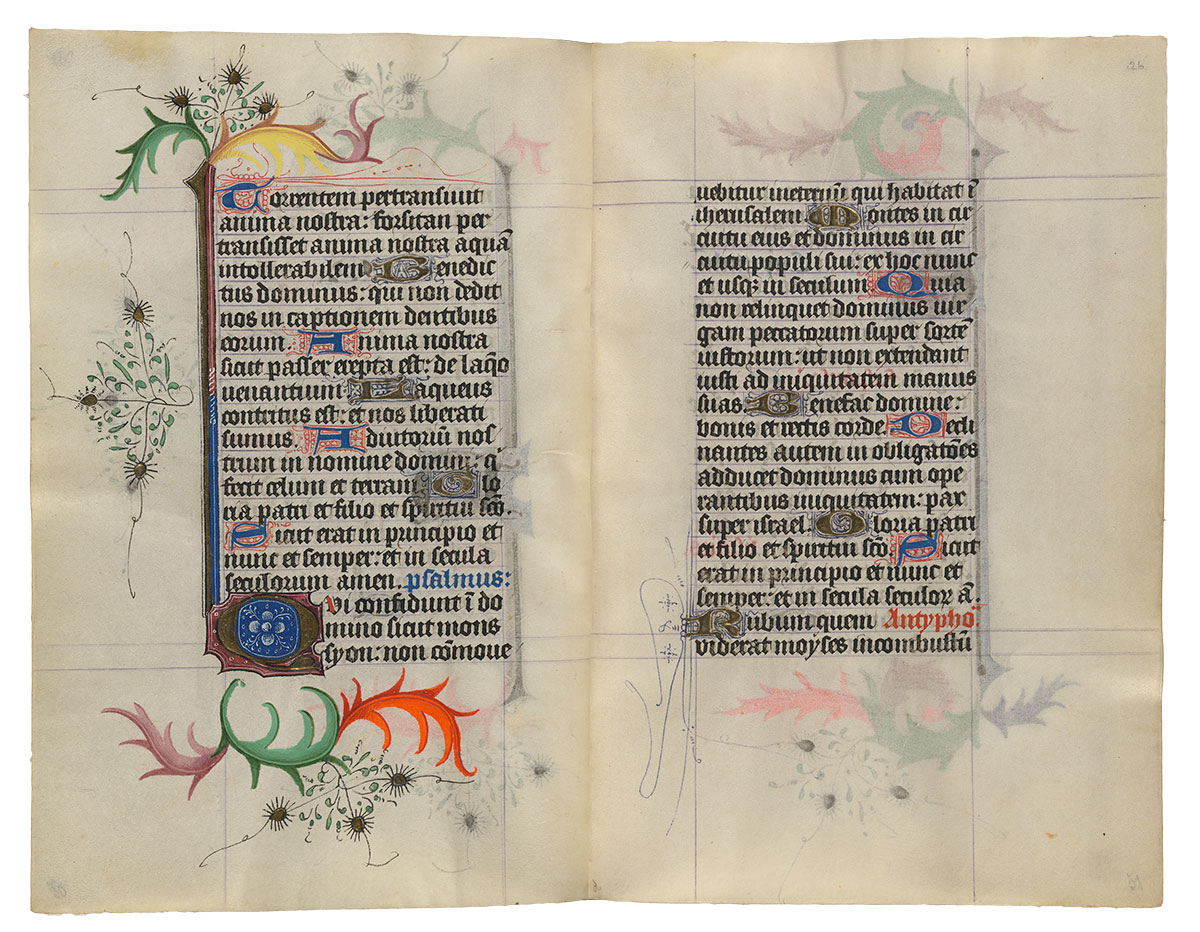
Purchased on the Belle da Costa Greene Fund with the assistance of the Fellows and with special assistance of Mrs. Frederick B. Adams, Sr., Mrs. Robert Charles, Mr. Laurens M. Hamilton, The Heineman Foundation, Mrs. Donald F. Hyde, Mrs. Jacob M. Kaplan, Mrs. John Kean, Mr. Paul Mellon, Mr. and Mrs. Charles F. Morgan, Mr. Lessing J. Rosenwald, Mr. and Mrs. August H. Schilling, Mrs. Herbert N. Straus, Mrs. Landon K. Thorne, Mrs. Alan Valentine, Mr. and Mrs. Arnold Whitridge, and Miss Julia P. Wightman, 1970
Image courtesy of Faksimile Verlag Luzern
MS M.917/945, ff. 26v–27r
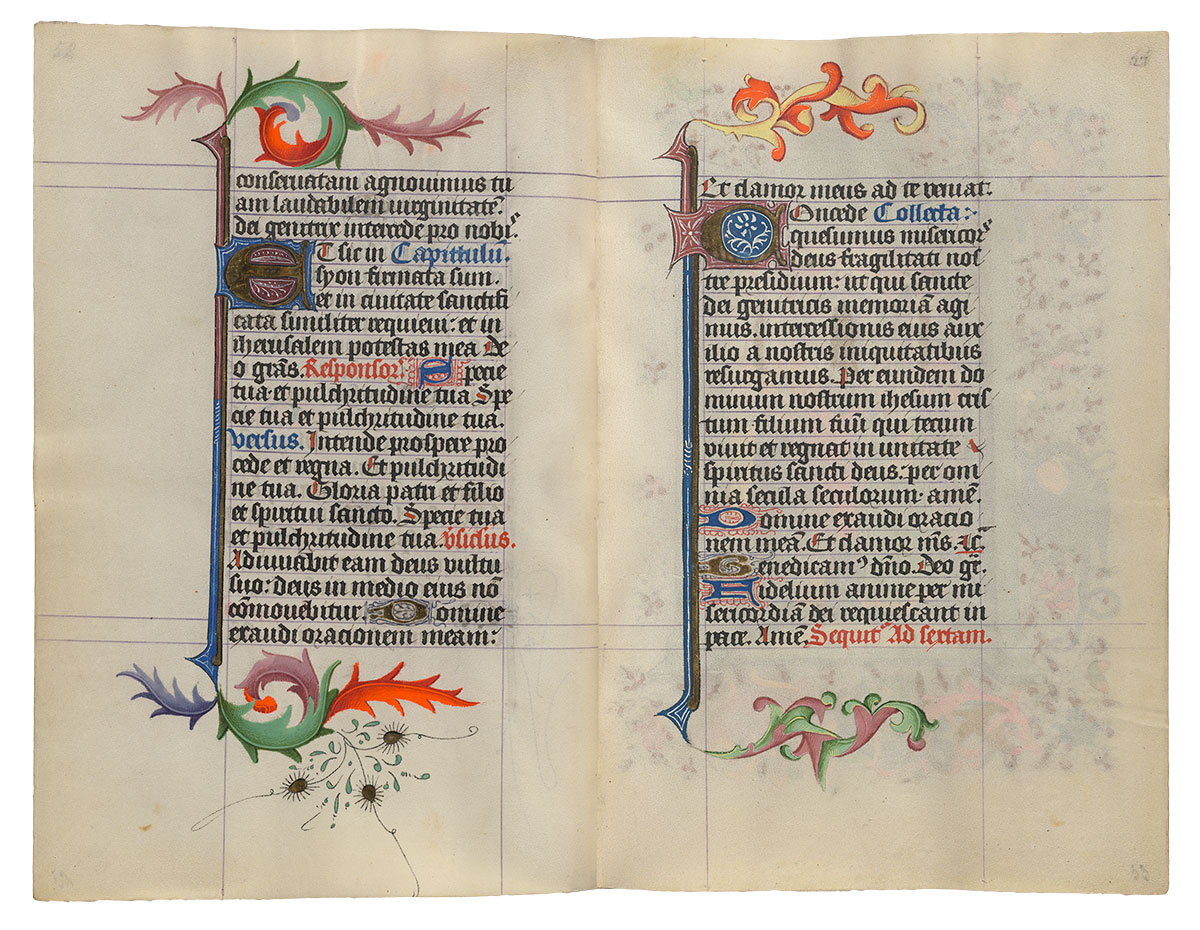
Purchased on the Belle da Costa Greene Fund with the assistance of the Fellows and with special assistance of Mrs. Frederick B. Adams, Sr., Mrs. Robert Charles, Mr. Laurens M. Hamilton, The Heineman Foundation, Mrs. Donald F. Hyde, Mrs. Jacob M. Kaplan, Mrs. John Kean, Mr. Paul Mellon, Mr. and Mrs. Charles F. Morgan, Mr. Lessing J. Rosenwald, Mr. and Mrs. August H. Schilling, Mrs. Herbert N. Straus, Mrs. Landon K. Thorne, Mrs. Alan Valentine, Mr. and Mrs. Arnold Whitridge, and Miss Julia P. Wightman, 1970
Image courtesy of Faksimile Verlag Luzern
MS M.917/945, ff. 27v–28r
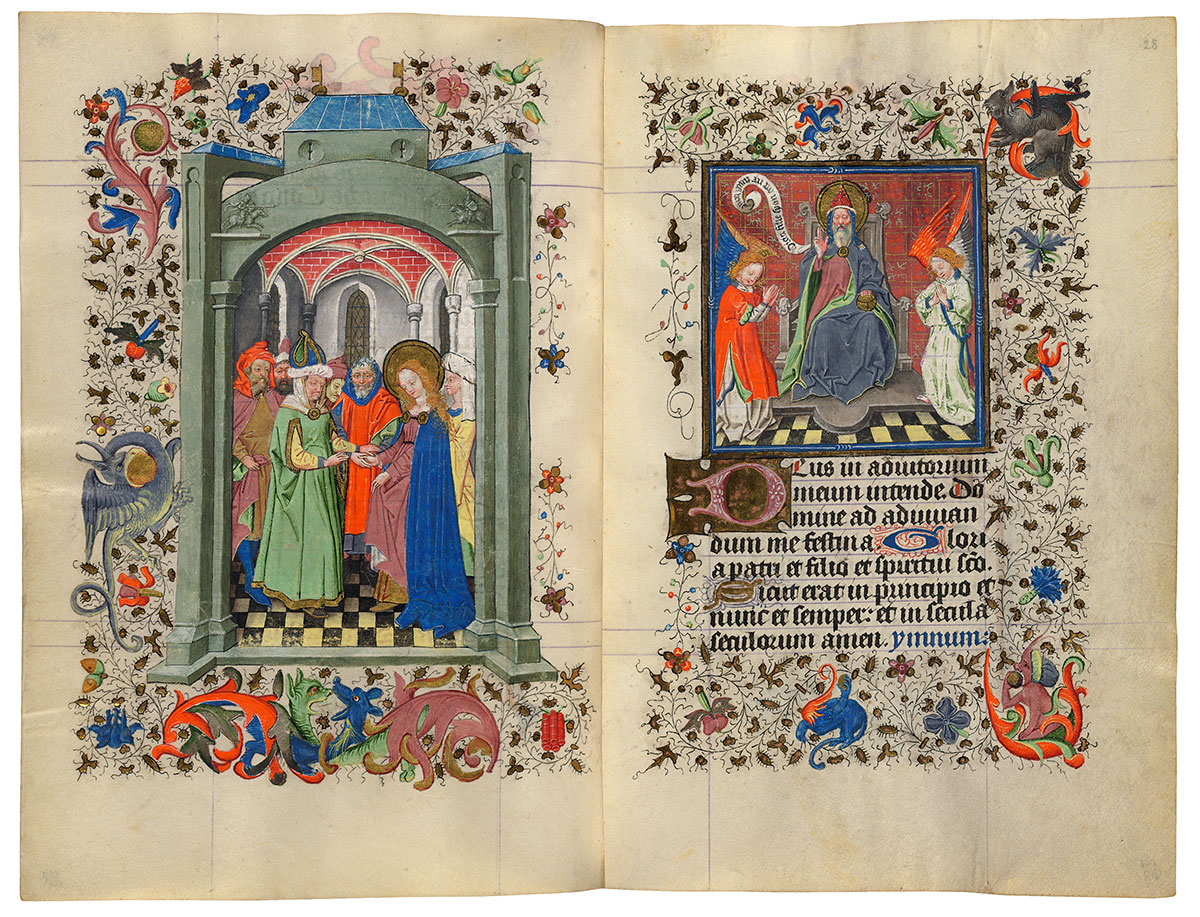
Marriage of the Virgin
God Dispatching the Archangel Gabriel
Purchased on the Belle da Costa Greene Fund with the assistance of the Fellows and with special assistance of Mrs. Frederick B. Adams, Sr., Mrs. Robert Charles, Mr. Laurens M. Hamilton, The Heineman Foundation, Mrs. Donald F. Hyde, Mrs. Jacob M. Kaplan, Mrs. John Kean, Mr. Paul Mellon, Mr. and Mrs. Charles F. Morgan, Mr. Lessing J. Rosenwald, Mr. and Mrs. August H. Schilling, Mrs. Herbert N. Straus, Mrs. Landon K. Thorne, Mrs. Alan Valentine, Mr. and Mrs. Arnold Whitridge, and Miss Julia P. Wightman, 1970
Hours of the Virgin
The heart of every Book of Hours is the series of prayers called the Hours of the Virgin. Each Hour is composed of psalms plus hymns, biblical readings, and short phrases (antiphons, versicles, and responses). Ideally, these eight Hours were prayed throughout the course of the day:
| Matins and Lauds | at night or upon rising |
| Prime (first Hour) | at 6:00 a.m. |
| Terce (third Hour) | at 9:00 a.m. |
| Sext (sixth Hour) | at noon |
| Nones (ninth Hour) | at 3:00 p.m. |
| Vespers (evensong) | in the early evening |
| Compline | before retiring. |
The Hours of the Virgin date back to at least the ninth century. By the late twelfth century, the Hours appeared in Psalters, prayer books popular with laypeople. With a rising economy and the growth of the merchant class, the thirteenth century saw an increase in lay literacy. By the middle of the century, the Hours of the Virgin "spun off" from the Psalter and formed the core of the laypeople's prayer book, the Book of Hours.
The Virgin Mary is, of course, not mentioned in the numerous psalms of the Old Testament that comprise much of the Hours. Framing the psalms, however, are prayers that offer a mystical interpretation of the psalms and reveal the role played by the Virgin in mankind's salvation.
Image courtesy of Faksimile Verlag Luzern
MS M.917/945, ff. 28v–29r
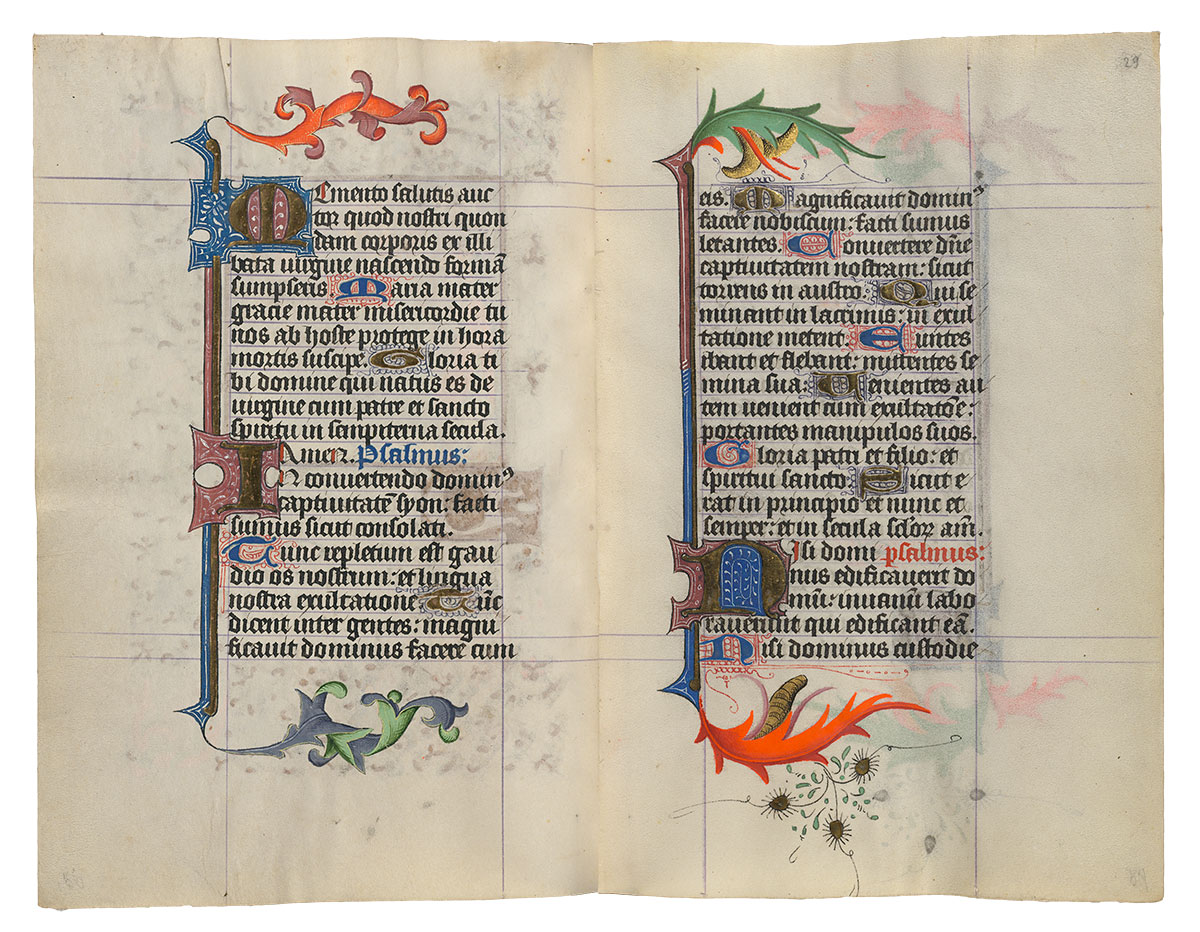
Purchased on the Belle da Costa Greene Fund with the assistance of the Fellows and with special assistance of Mrs. Frederick B. Adams, Sr., Mrs. Robert Charles, Mr. Laurens M. Hamilton, The Heineman Foundation, Mrs. Donald F. Hyde, Mrs. Jacob M. Kaplan, Mrs. John Kean, Mr. Paul Mellon, Mr. and Mrs. Charles F. Morgan, Mr. Lessing J. Rosenwald, Mr. and Mrs. August H. Schilling, Mrs. Herbert N. Straus, Mrs. Landon K. Thorne, Mrs. Alan Valentine, Mr. and Mrs. Arnold Whitridge, and Miss Julia P. Wightman, 1970
Image courtesy of Faksimile Verlag Luzern
MS M.917/945, ff. 29v–30r
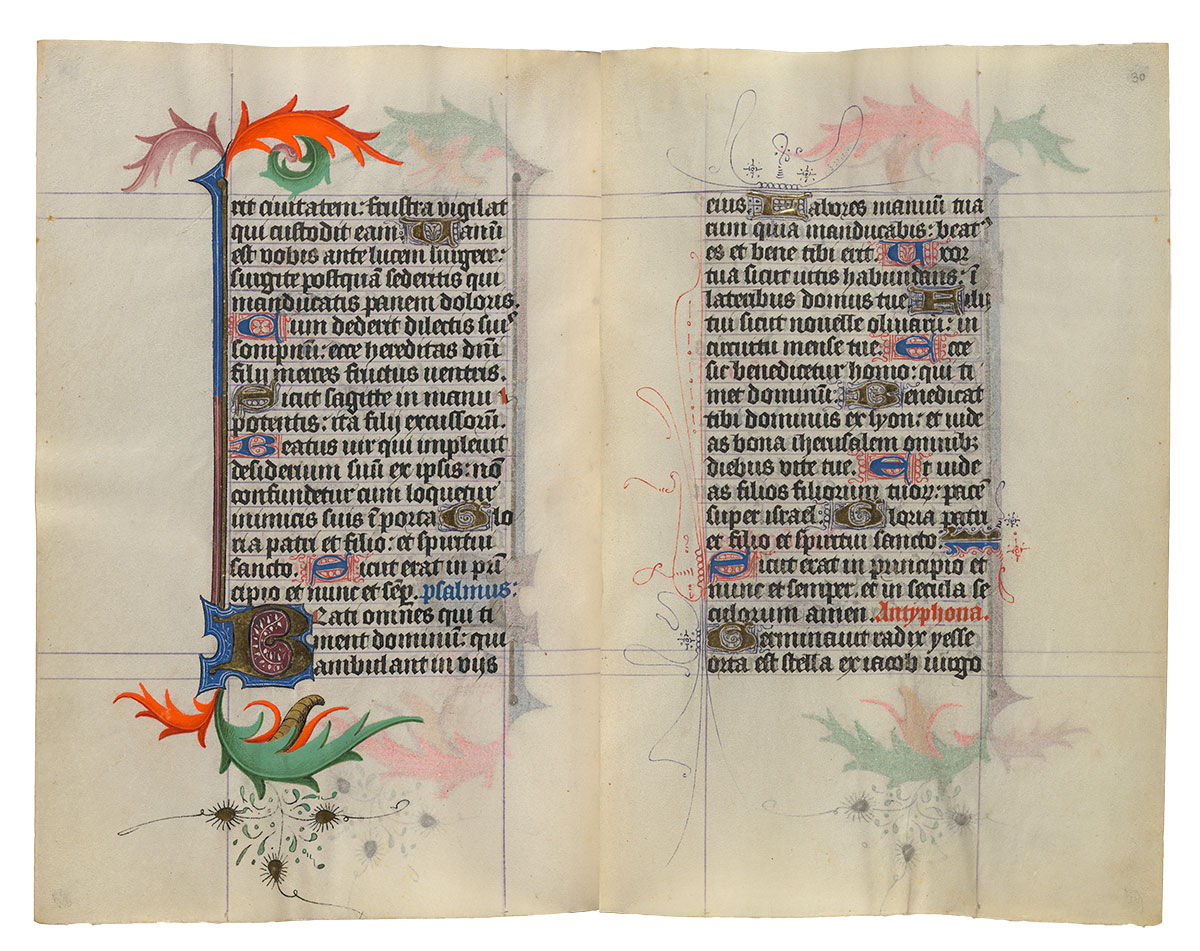
Purchased on the Belle da Costa Greene Fund with the assistance of the Fellows and with special assistance of Mrs. Frederick B. Adams, Sr., Mrs. Robert Charles, Mr. Laurens M. Hamilton, The Heineman Foundation, Mrs. Donald F. Hyde, Mrs. Jacob M. Kaplan, Mrs. John Kean, Mr. Paul Mellon, Mr. and Mrs. Charles F. Morgan, Mr. Lessing J. Rosenwald, Mr. and Mrs. August H. Schilling, Mrs. Herbert N. Straus, Mrs. Landon K. Thorne, Mrs. Alan Valentine, Mr. and Mrs. Arnold Whitridge, and Miss Julia P. Wightman, 1970
Image courtesy of Faksimile Verlag Luzern
MS M.917/945, ff. 30v–31r
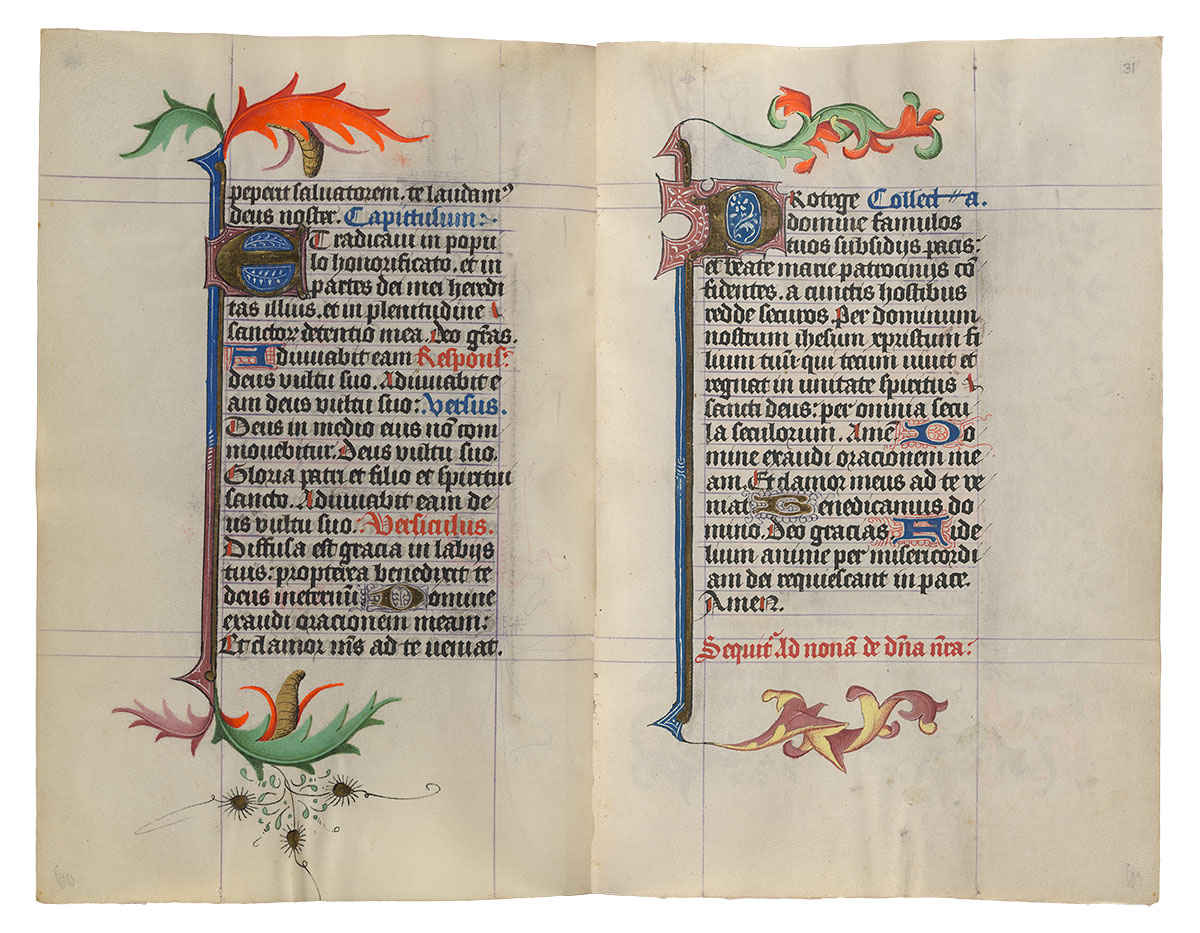
Purchased on the Belle da Costa Greene Fund with the assistance of the Fellows and with special assistance of Mrs. Frederick B. Adams, Sr., Mrs. Robert Charles, Mr. Laurens M. Hamilton, The Heineman Foundation, Mrs. Donald F. Hyde, Mrs. Jacob M. Kaplan, Mrs. John Kean, Mr. Paul Mellon, Mr. and Mrs. Charles F. Morgan, Mr. Lessing J. Rosenwald, Mr. and Mrs. August H. Schilling, Mrs. Herbert N. Straus, Mrs. Landon K. Thorne, Mrs. Alan Valentine, Mr. and Mrs. Arnold Whitridge, and Miss Julia P. Wightman, 1970
Image courtesy of Faksimile Verlag Luzern
MS M.917/945, ff. 31v–32r
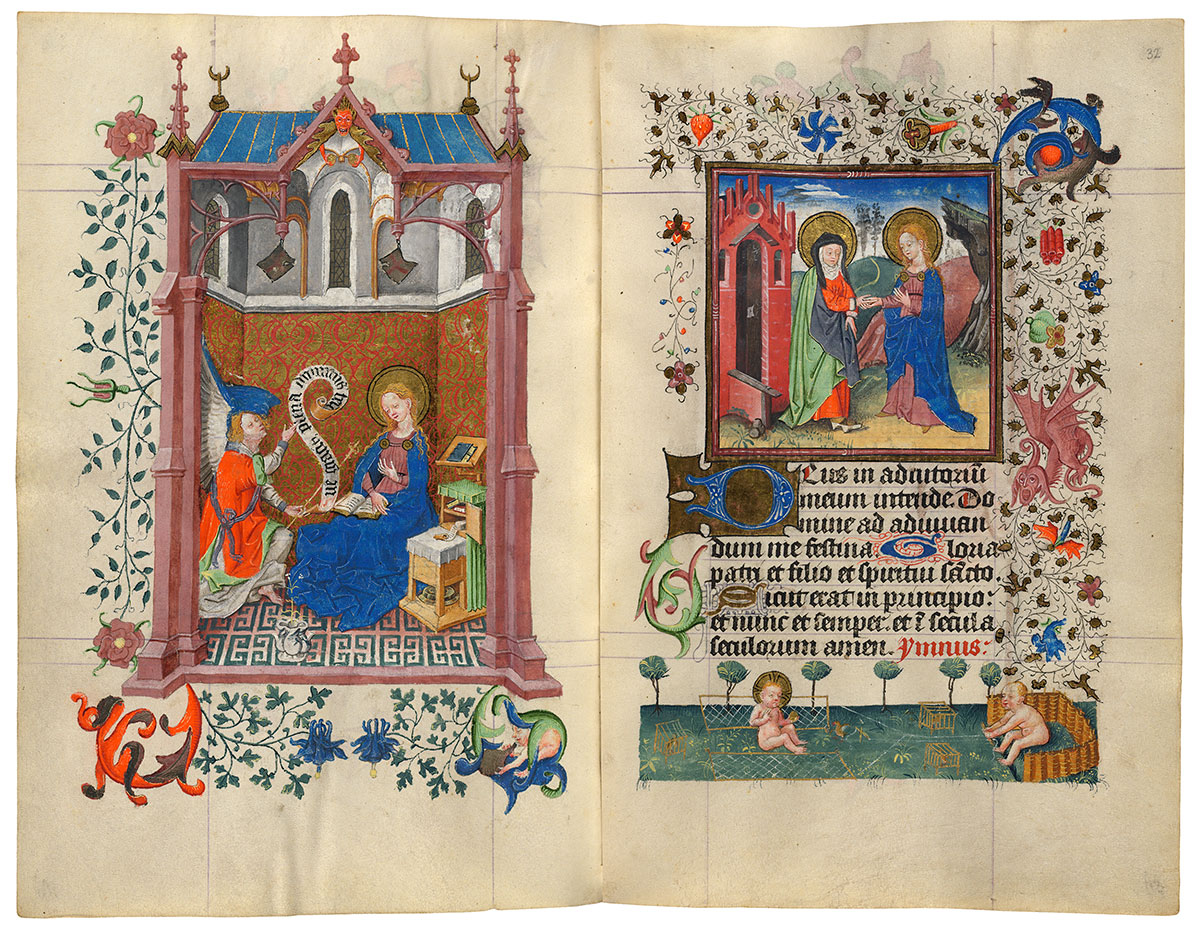
Annunciation
Visitation
Purchased on the Belle da Costa Greene Fund with the assistance of the Fellows and with special assistance of Mrs. Frederick B. Adams, Sr., Mrs. Robert Charles, Mr. Laurens M. Hamilton, The Heineman Foundation, Mrs. Donald F. Hyde, Mrs. Jacob M. Kaplan, Mrs. John Kean, Mr. Paul Mellon, Mr. and Mrs. Charles F. Morgan, Mr. Lessing J. Rosenwald, Mr. and Mrs. August H. Schilling, Mrs. Herbert N. Straus, Mrs. Landon K. Thorne, Mrs. Alan Valentine, Mr. and Mrs. Arnold Whitridge, and Miss Julia P. Wightman, 1970
The moment of the Incarnation—when the Archangel Gabriel announces to Mary that she has been chosen by God to be the mother of the Savior—takes place
in an elaborate space. The structure is handsomely tiled, hung with cloth of gold, and vaulted with soaring stones (note the orange demon at the top of the arch). Gabriel's salutation is written on his scroll: Ave gracia plena, Dominus te(cum) (Hail, full of grace, the Lord is with thee). Interrupted at her prayers, the Virgin gestures in astonishment.
Hours of the Virgin
The heart of every Book of Hours is the series of prayers called the Hours of the Virgin. Each Hour is composed of psalms plus hymns, biblical readings, and short phrases (antiphons, versicles, and responses). Ideally, these eight Hours were prayed throughout the course of the day:
| Matins and Lauds | at night or upon rising |
| Prime (first Hour) | at 6:00 a.m. |
| Terce (third Hour) | at 9:00 a.m. |
| Sext (sixth Hour) | at noon |
| Nones (ninth Hour) | at 3:00 p.m. |
| Vespers (evensong) | in the early evening |
| Compline | before retiring. |
The Hours of the Virgin date back to at least the ninth century. By the late twelfth century, the Hours appeared in Psalters, prayer books popular with laypeople. With a rising economy and the growth of the merchant class, the thirteenth century saw an increase in lay literacy. By the middle of the century, the Hours of the Virgin "spun off" from the Psalter and formed the core of the laypeople's prayer book, the Book of Hours.
The Virgin Mary is, of course, not mentioned in the numerous psalms of the Old Testament that comprise much of the Hours. Framing the psalms, however, are prayers that offer a mystical interpretation of the psalms and reveal the role played by the Virgin in mankind's salvation.
Image courtesy of Faksimile Verlag Luzern
MS M.917/945, ff. 32v–33r
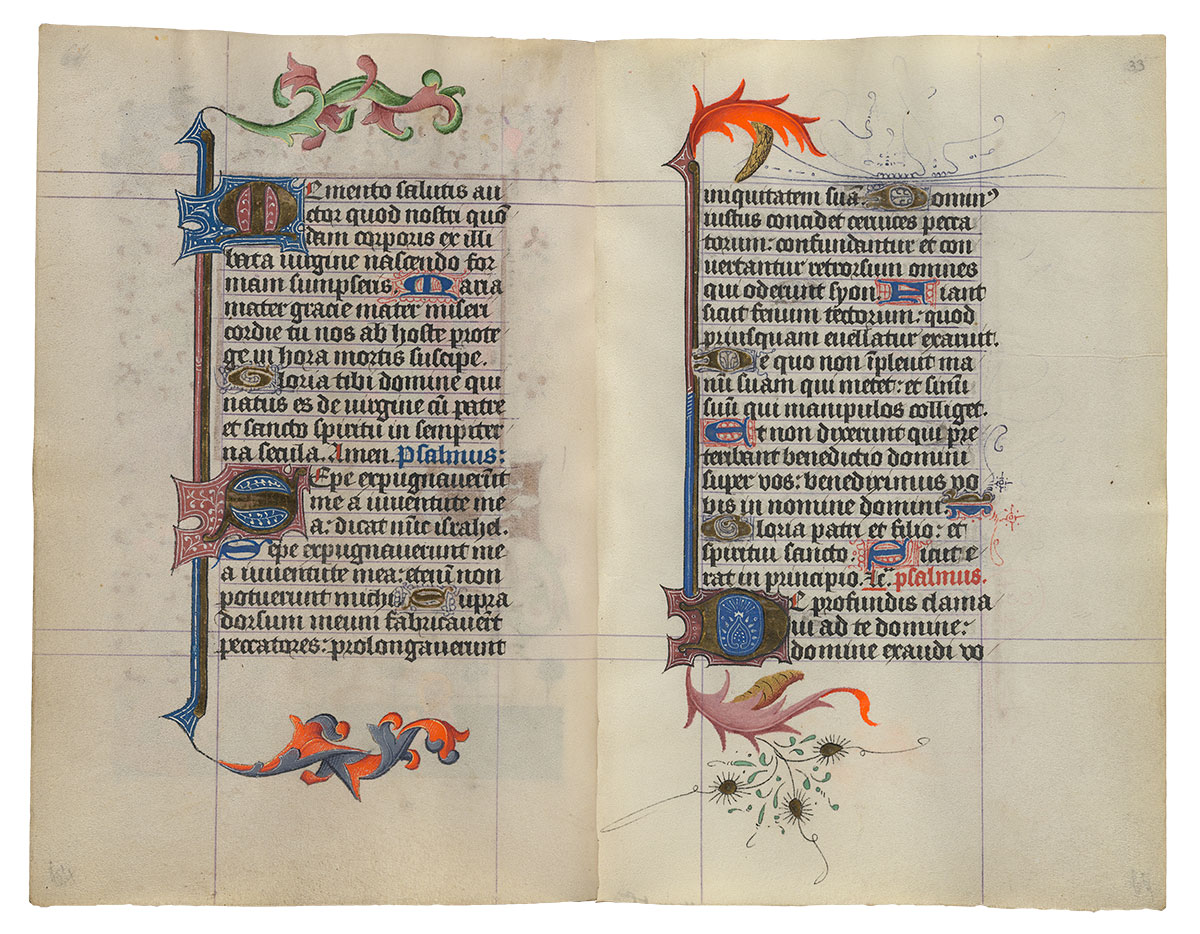
Purchased on the Belle da Costa Greene Fund with the assistance of the Fellows and with special assistance of Mrs. Frederick B. Adams, Sr., Mrs. Robert Charles, Mr. Laurens M. Hamilton, The Heineman Foundation, Mrs. Donald F. Hyde, Mrs. Jacob M. Kaplan, Mrs. John Kean, Mr. Paul Mellon, Mr. and Mrs. Charles F. Morgan, Mr. Lessing J. Rosenwald, Mr. and Mrs. August H. Schilling, Mrs. Herbert N. Straus, Mrs. Landon K. Thorne, Mrs. Alan Valentine, Mr. and Mrs. Arnold Whitridge, and Miss Julia P. Wightman, 1970
Image courtesy of Faksimile Verlag Luzern
MS M.917/945, ff. 33v–34r
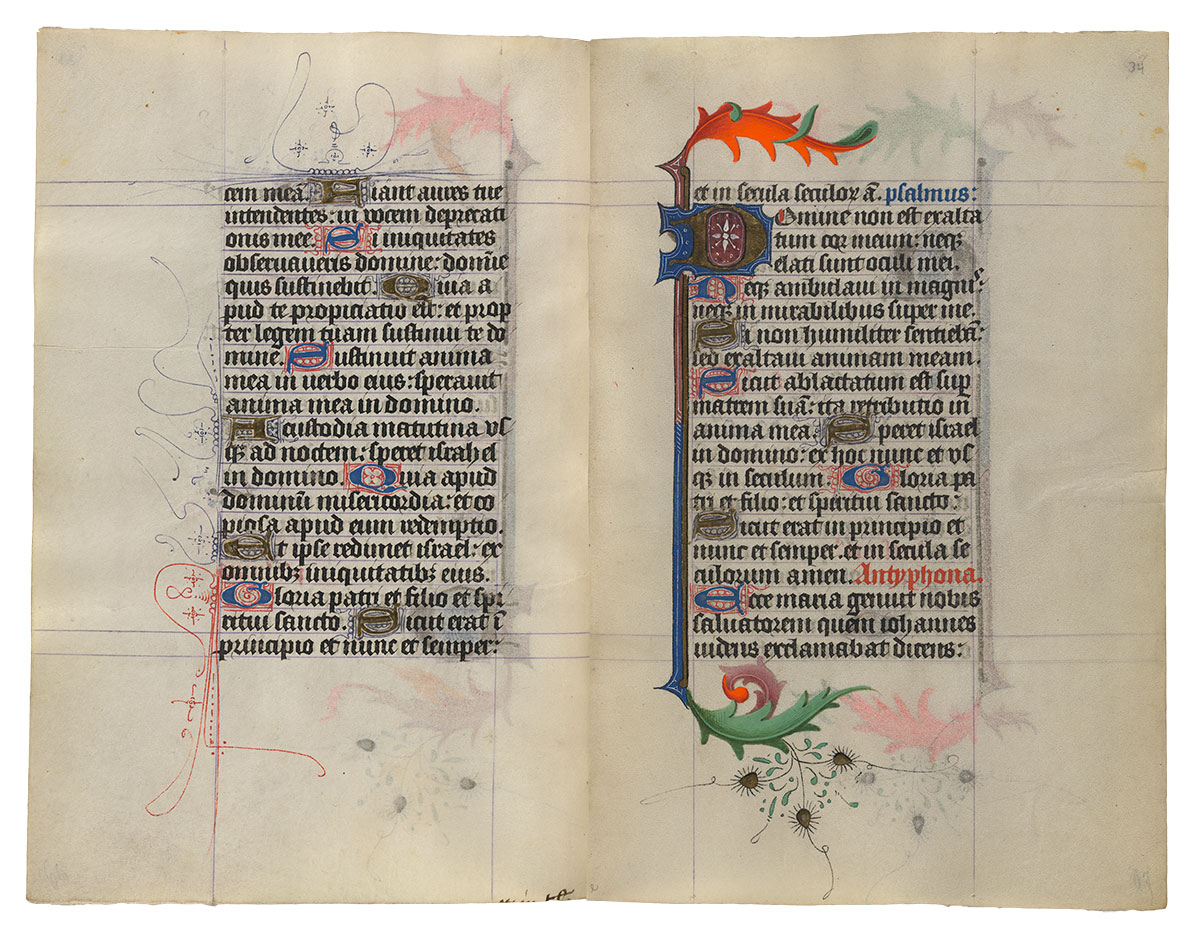
Purchased on the Belle da Costa Greene Fund with the assistance of the Fellows and with special assistance of Mrs. Frederick B. Adams, Sr., Mrs. Robert Charles, Mr. Laurens M. Hamilton, The Heineman Foundation, Mrs. Donald F. Hyde, Mrs. Jacob M. Kaplan, Mrs. John Kean, Mr. Paul Mellon, Mr. and Mrs. Charles F. Morgan, Mr. Lessing J. Rosenwald, Mr. and Mrs. August H. Schilling, Mrs. Herbert N. Straus, Mrs. Landon K. Thorne, Mrs. Alan Valentine, Mr. and Mrs. Arnold Whitridge, and Miss Julia P. Wightman, 1970
Image courtesy of Faksimile Verlag Luzern
MS M.917/945, ff. 34v–35r
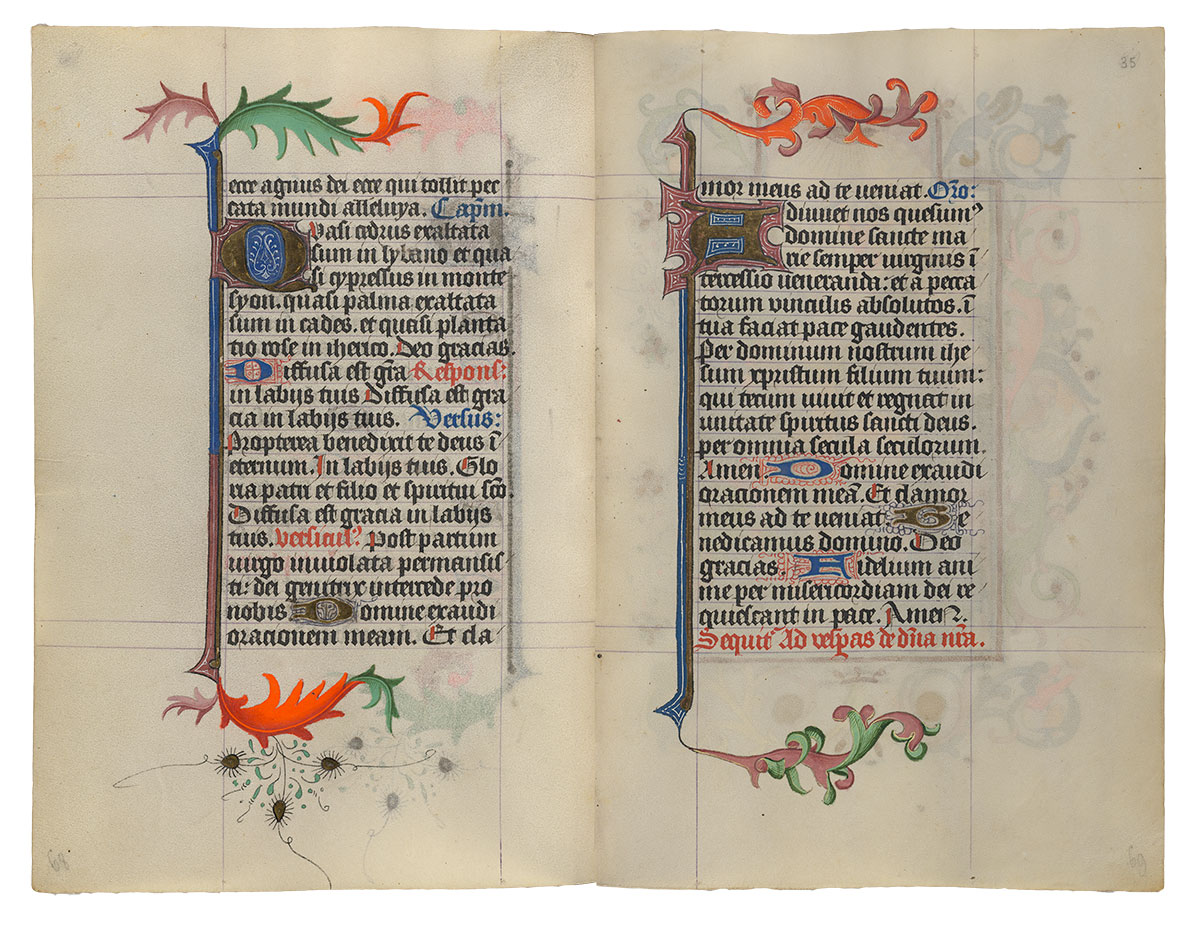
Purchased on the Belle da Costa Greene Fund with the assistance of the Fellows and with special assistance of Mrs. Frederick B. Adams, Sr., Mrs. Robert Charles, Mr. Laurens M. Hamilton, The Heineman Foundation, Mrs. Donald F. Hyde, Mrs. Jacob M. Kaplan, Mrs. John Kean, Mr. Paul Mellon, Mr. and Mrs. Charles F. Morgan, Mr. Lessing J. Rosenwald, Mr. and Mrs. August H. Schilling, Mrs. Herbert N. Straus, Mrs. Landon K. Thorne, Mrs. Alan Valentine, Mr. and Mrs. Arnold Whitridge, and Miss Julia P. Wightman, 1970
Image courtesy of Faksimile Verlag Luzern
MS M.917/945, ff. 35v–36r
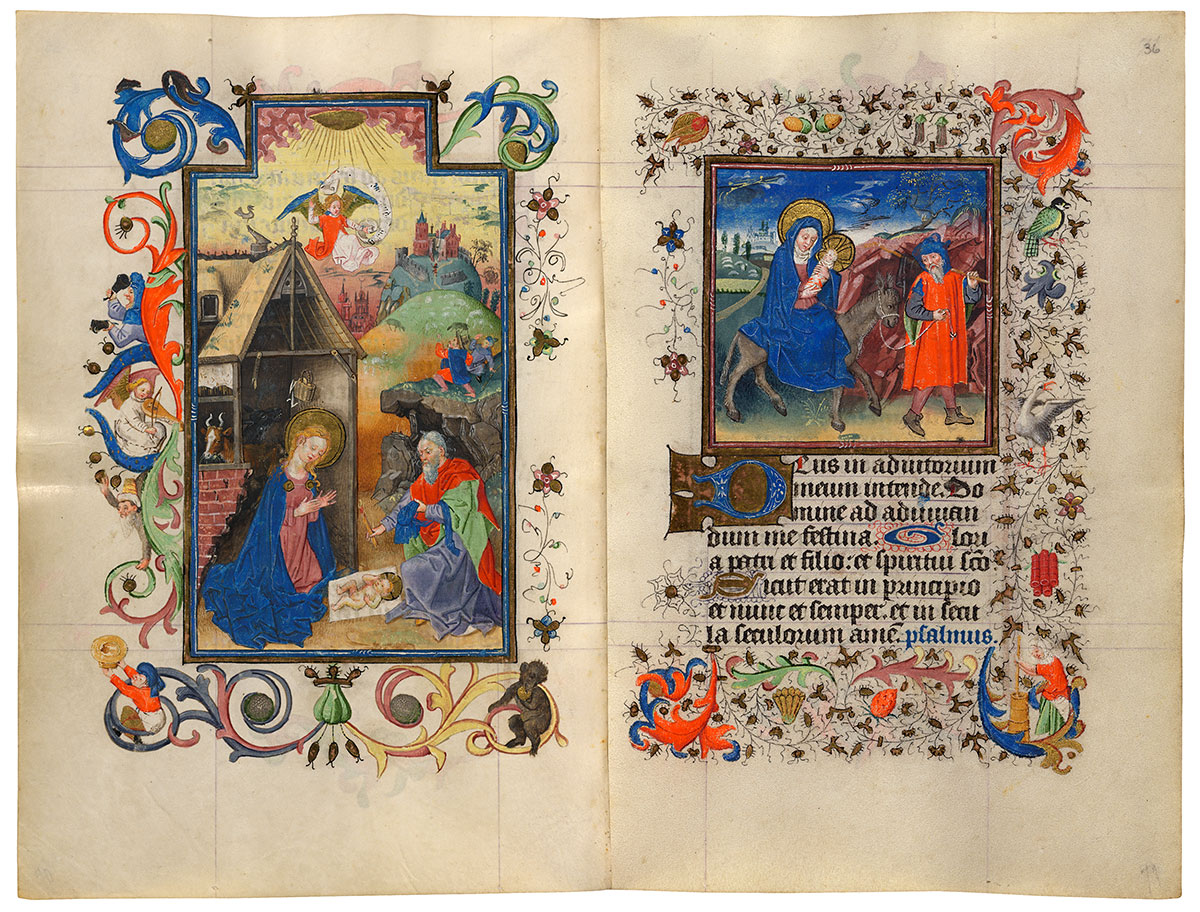
Nativity
Flight into Egypt
Purchased on the Belle da Costa Greene Fund with the assistance of the Fellows and with special assistance of Mrs. Frederick B. Adams, Sr., Mrs. Robert Charles, Mr. Laurens M. Hamilton, The Heineman Foundation, Mrs. Donald F. Hyde, Mrs. Jacob M. Kaplan, Mrs. John Kean, Mr. Paul Mellon, Mr. and Mrs. Charles F. Morgan, Mr. Lessing J. Rosenwald, Mr. and Mrs. August H. Schilling, Mrs. Herbert N. Straus, Mrs. Landon K. Thorne, Mrs. Alan Valentine, Mr. and Mrs. Arnold Whitridge, and Miss Julia P. Wightman, 1970
In this Nativity, Mary and Joseph kneel in adoration of their son, the Savior. Although Joseph holds a candle, its light is rendered moot by the radiantly lit sky from which the angel descends to tell the good news to the shepherds tending their flocks in the hills. Typical of the artist's interest in detail is the distant castle, surrounded by a ruined wall, to which a man makes his way along a winding path. The smaller miniature illustrates the Holy Family's journey to Egypt to escape Herod's slaughter of all newborn children (for he had heard that one would overthrow him).
Hours of the Virgin
The heart of every Book of Hours is the series of prayers called the Hours of the Virgin. Each Hour is composed of psalms plus hymns, biblical readings, and short phrases (antiphons, versicles, and responses). Ideally, these eight Hours were prayed throughout the course of the day:
| Matins and Lauds | at night or upon rising |
| Prime (first Hour) | at 6:00 a.m. |
| Terce (third Hour) | at 9:00 a.m. |
| Sext (sixth Hour) | at noon |
| Nones (ninth Hour) | at 3:00 p.m. |
| Vespers (evensong) | in the early evening |
| Compline | before retiring. |
The Hours of the Virgin date back to at least the ninth century. By the late twelfth century, the Hours appeared in Psalters, prayer books popular with laypeople. With a rising economy and the growth of the merchant class, the thirteenth century saw an increase in lay literacy. By the middle of the century, the Hours of the Virgin "spun off" from the Psalter and formed the core of the laypeople's prayer book, the Book of Hours.
The Virgin Mary is, of course, not mentioned in the numerous psalms of the Old Testament that comprise much of the Hours. Framing the psalms, however, are prayers that offer a mystical interpretation of the psalms and reveal the role played by the Virgin in mankind's salvation.
Image courtesy of Faksimile Verlag Luzern
MS M.917/945, ff. 36v–37r
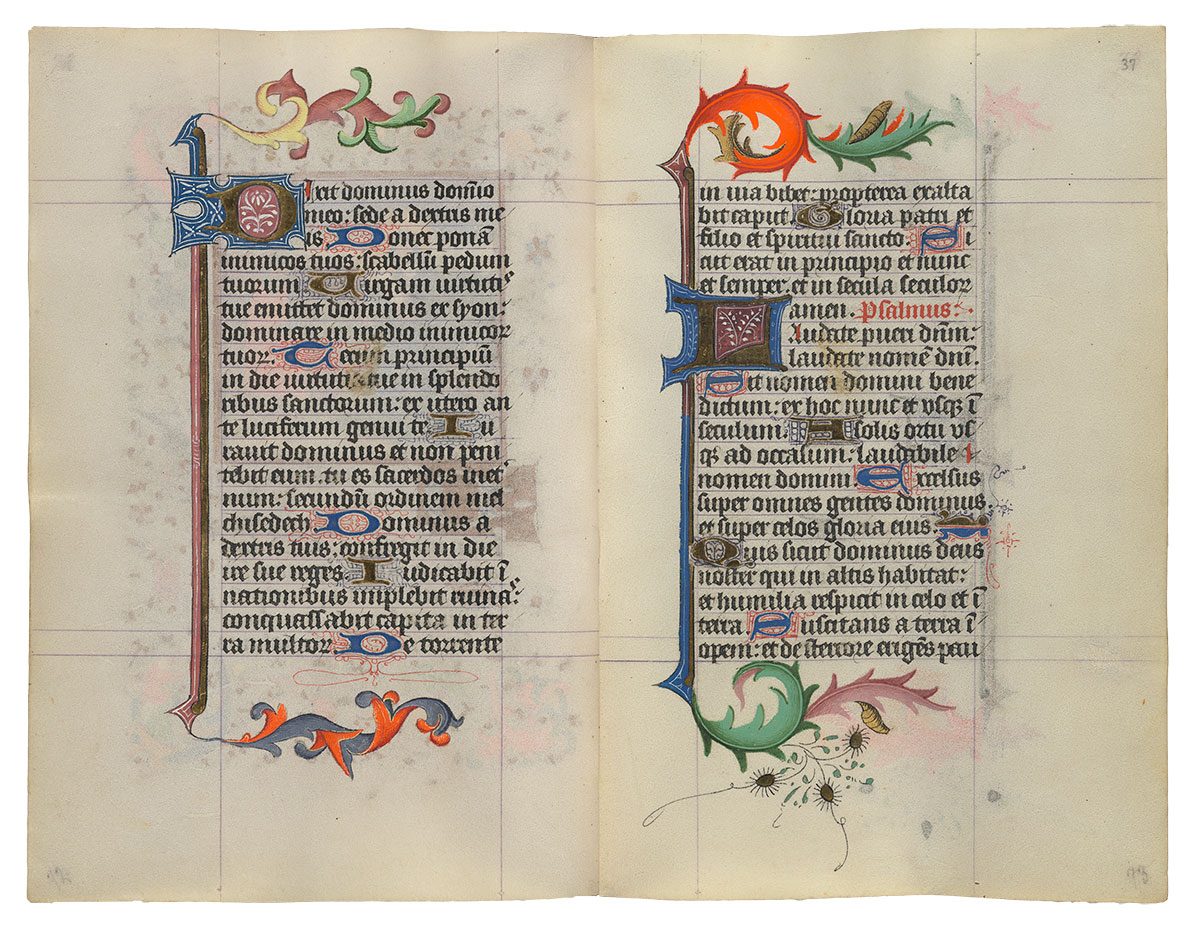
Purchased on the Belle da Costa Greene Fund with the assistance of the Fellows and with special assistance of Mrs. Frederick B. Adams, Sr., Mrs. Robert Charles, Mr. Laurens M. Hamilton, The Heineman Foundation, Mrs. Donald F. Hyde, Mrs. Jacob M. Kaplan, Mrs. John Kean, Mr. Paul Mellon, Mr. and Mrs. Charles F. Morgan, Mr. Lessing J. Rosenwald, Mr. and Mrs. August H. Schilling, Mrs. Herbert N. Straus, Mrs. Landon K. Thorne, Mrs. Alan Valentine, Mr. and Mrs. Arnold Whitridge, and Miss Julia P. Wightman, 1970
Image courtesy of Faksimile Verlag Luzern
MS M.917/945, ff. 37v–38r
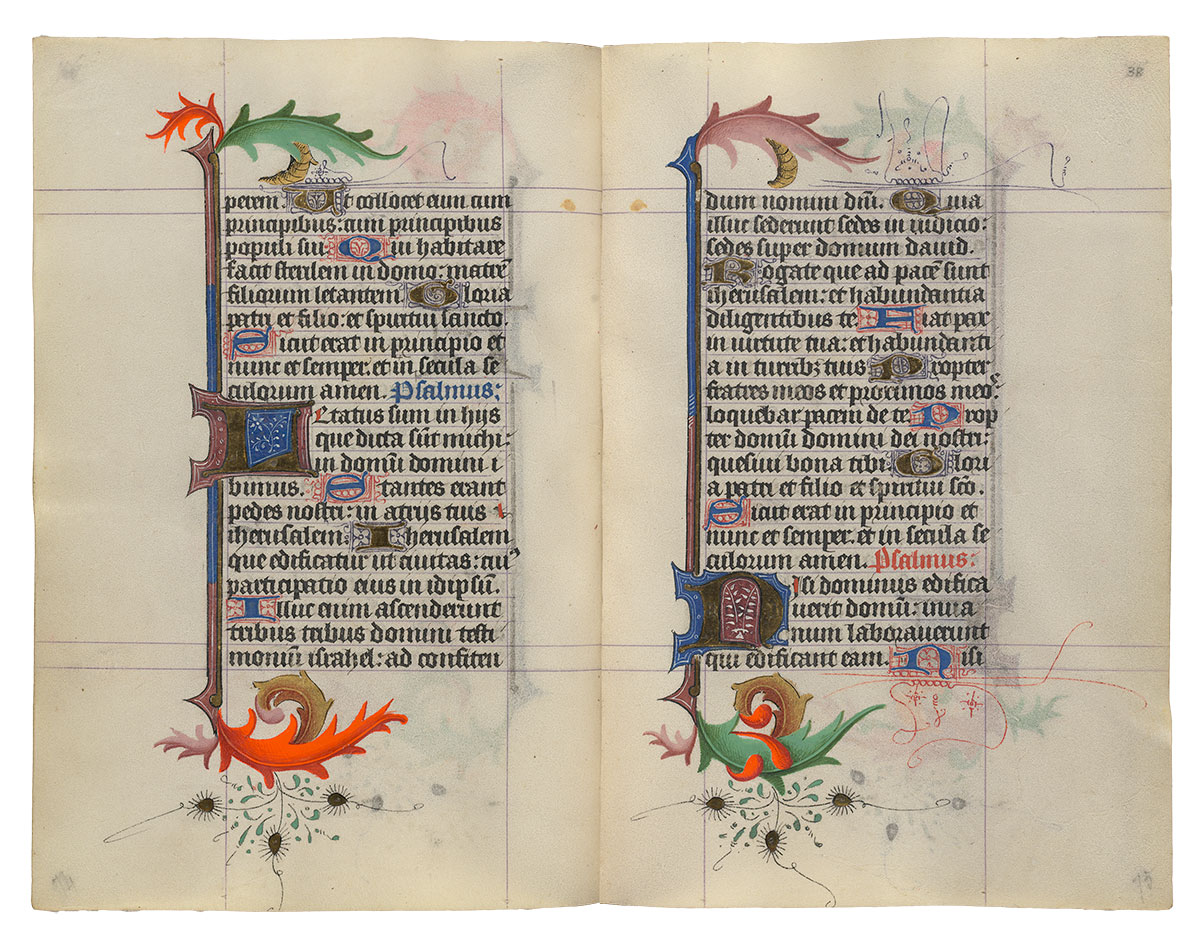
Purchased on the Belle da Costa Greene Fund with the assistance of the Fellows and with special assistance of Mrs. Frederick B. Adams, Sr., Mrs. Robert Charles, Mr. Laurens M. Hamilton, The Heineman Foundation, Mrs. Donald F. Hyde, Mrs. Jacob M. Kaplan, Mrs. John Kean, Mr. Paul Mellon, Mr. and Mrs. Charles F. Morgan, Mr. Lessing J. Rosenwald, Mr. and Mrs. August H. Schilling, Mrs. Herbert N. Straus, Mrs. Landon K. Thorne, Mrs. Alan Valentine, Mr. and Mrs. Arnold Whitridge, and Miss Julia P. Wightman, 1970
Image courtesy of Faksimile Verlag Luzern
MS M.917/945, ff. 38v–39r
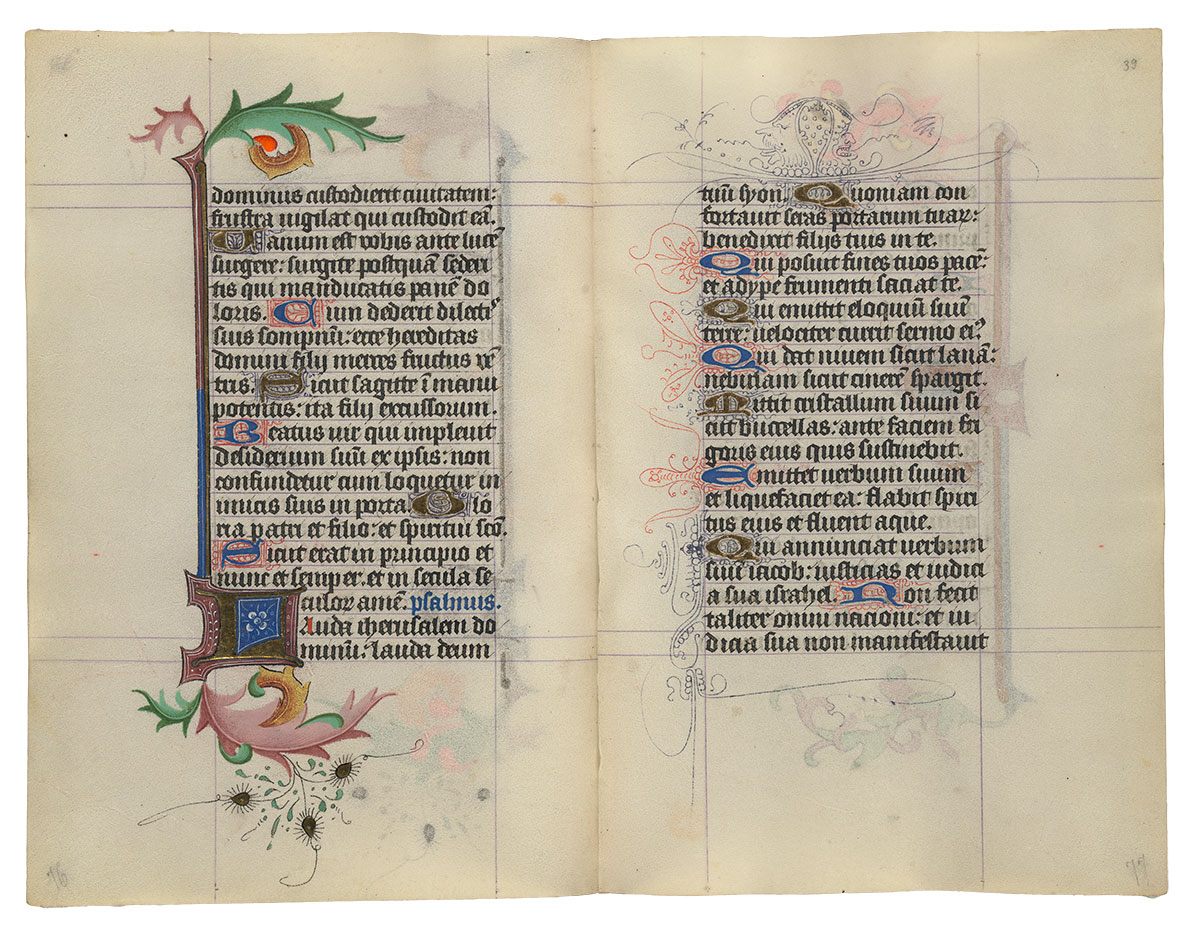
Purchased on the Belle da Costa Greene Fund with the assistance of the Fellows and with special assistance of Mrs. Frederick B. Adams, Sr., Mrs. Robert Charles, Mr. Laurens M. Hamilton, The Heineman Foundation, Mrs. Donald F. Hyde, Mrs. Jacob M. Kaplan, Mrs. John Kean, Mr. Paul Mellon, Mr. and Mrs. Charles F. Morgan, Mr. Lessing J. Rosenwald, Mr. and Mrs. August H. Schilling, Mrs. Herbert N. Straus, Mrs. Landon K. Thorne, Mrs. Alan Valentine, Mr. and Mrs. Arnold Whitridge, and Miss Julia P. Wightman, 1970
Image courtesy of Faksimile Verlag Luzern
MS M.917/945, ff. 39v–40r
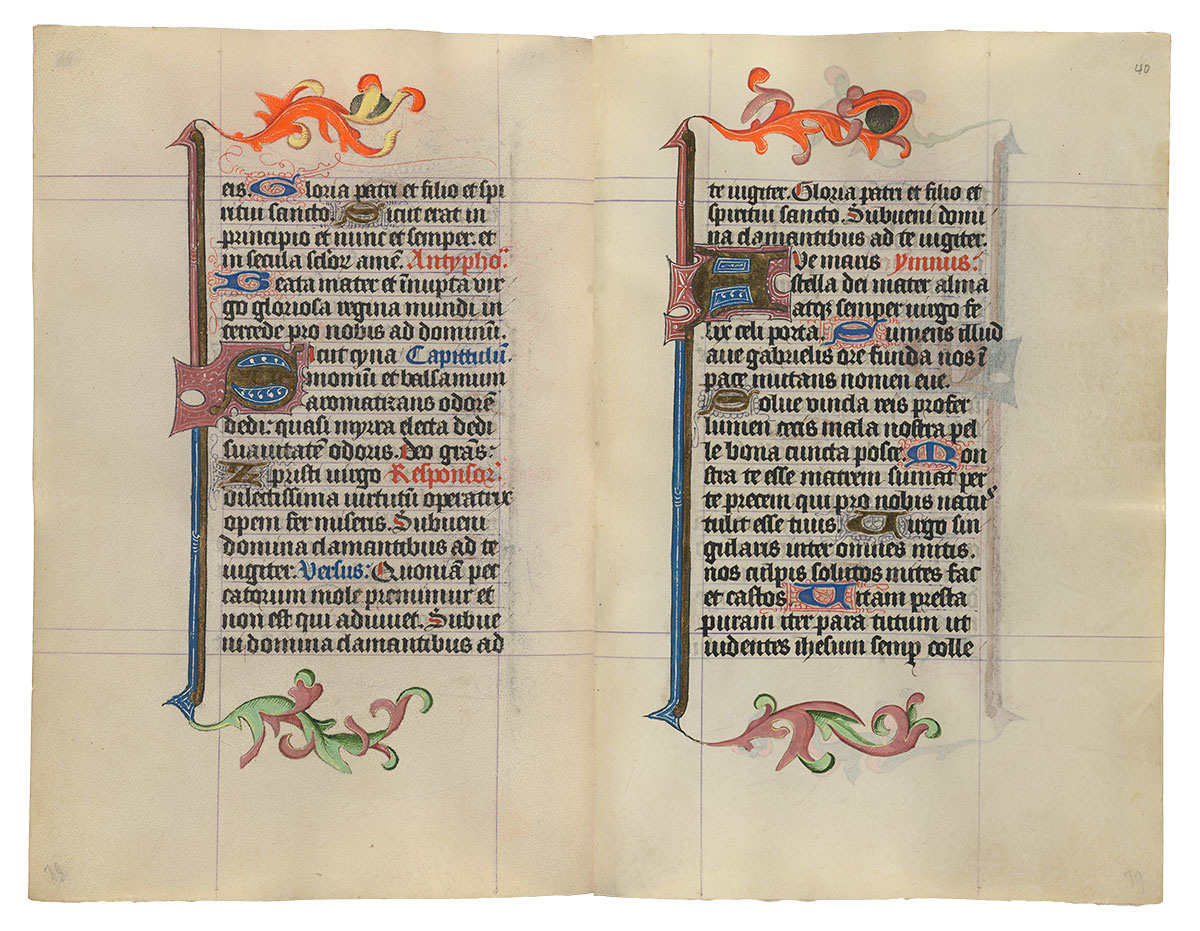
Purchased on the Belle da Costa Greene Fund with the assistance of the Fellows and with special assistance of Mrs. Frederick B. Adams, Sr., Mrs. Robert Charles, Mr. Laurens M. Hamilton, The Heineman Foundation, Mrs. Donald F. Hyde, Mrs. Jacob M. Kaplan, Mrs. John Kean, Mr. Paul Mellon, Mr. and Mrs. Charles F. Morgan, Mr. Lessing J. Rosenwald, Mr. and Mrs. August H. Schilling, Mrs. Herbert N. Straus, Mrs. Landon K. Thorne, Mrs. Alan Valentine, Mr. and Mrs. Arnold Whitridge, and Miss Julia P. Wightman, 1970
Image courtesy of Faksimile Verlag Luzern
MS M.917/945, ff. 40v–41r
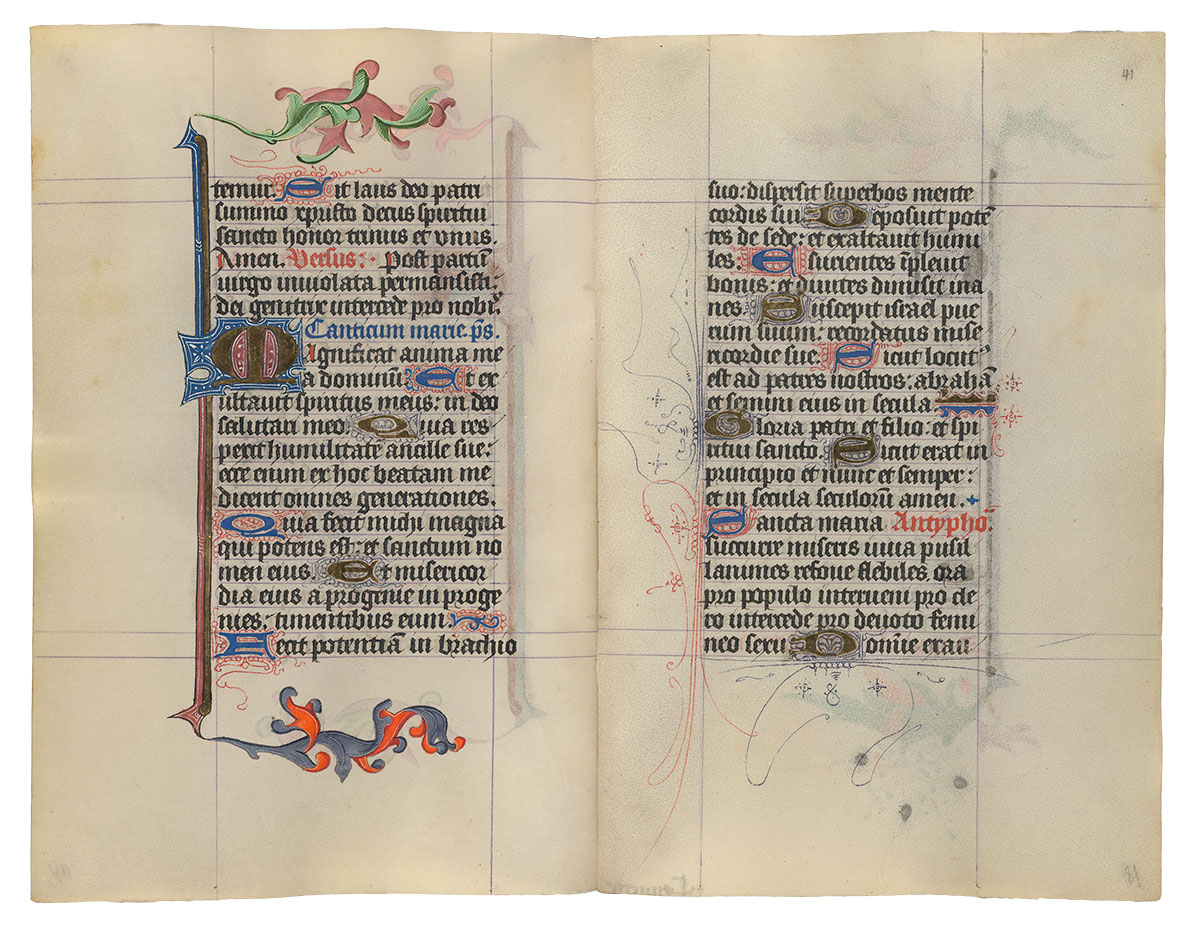
Purchased on the Belle da Costa Greene Fund with the assistance of the Fellows and with special assistance of Mrs. Frederick B. Adams, Sr., Mrs. Robert Charles, Mr. Laurens M. Hamilton, The Heineman Foundation, Mrs. Donald F. Hyde, Mrs. Jacob M. Kaplan, Mrs. John Kean, Mr. Paul Mellon, Mr. and Mrs. Charles F. Morgan, Mr. Lessing J. Rosenwald, Mr. and Mrs. August H. Schilling, Mrs. Herbert N. Straus, Mrs. Landon K. Thorne, Mrs. Alan Valentine, Mr. and Mrs. Arnold Whitridge, and Miss Julia P. Wightman, 1970
Image courtesy of Faksimile Verlag Luzern
MS M.917/945, f. 41v–p. 155
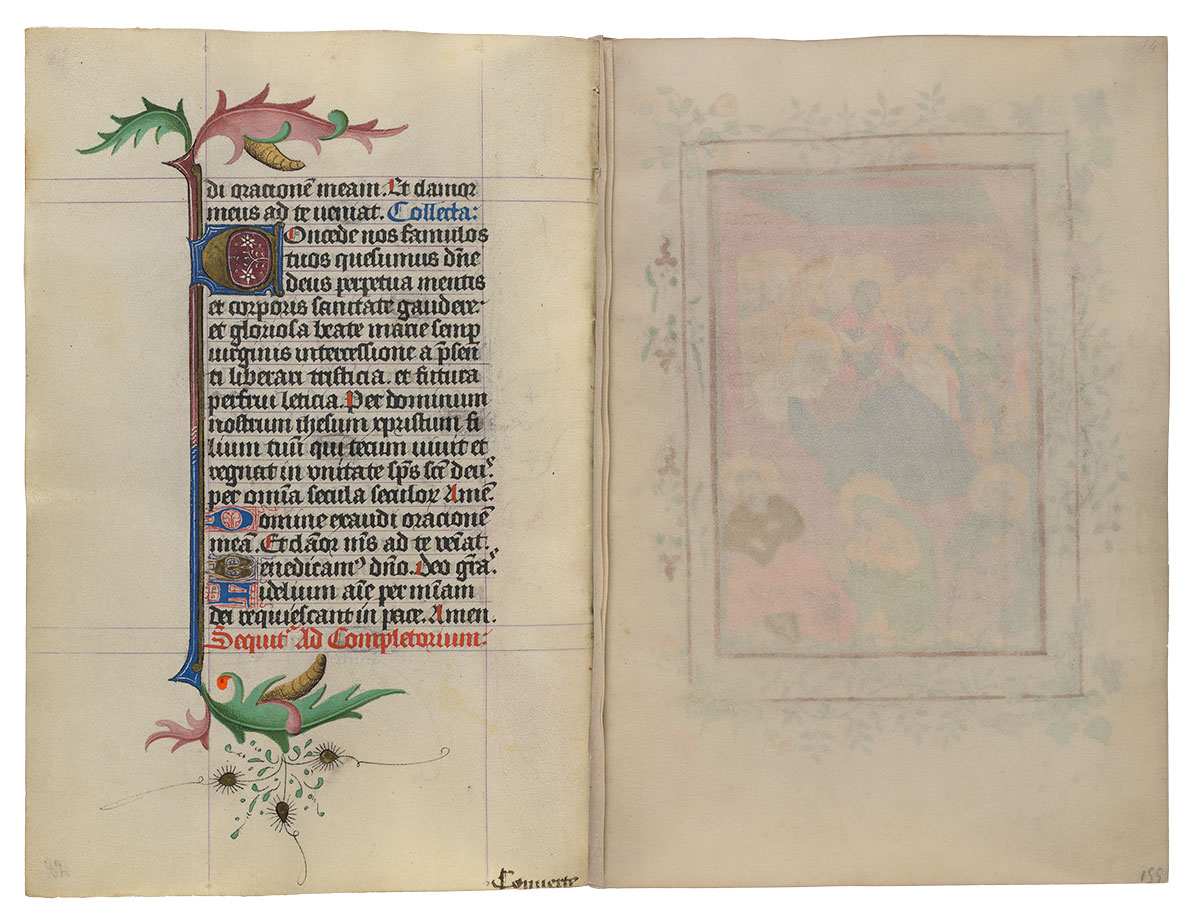
Purchased on the Belle da Costa Greene Fund with the assistance of the Fellows and with special assistance of Mrs. Frederick B. Adams, Sr., Mrs. Robert Charles, Mr. Laurens M. Hamilton, The Heineman Foundation, Mrs. Donald F. Hyde, Mrs. Jacob M. Kaplan, Mrs. John Kean, Mr. Paul Mellon, Mr. and Mrs. Charles F. Morgan, Mr. Lessing J. Rosenwald, Mr. and Mrs. August H. Schilling, Mrs. Herbert N. Straus, Mrs. Landon K. Thorne, Mrs. Alan Valentine, Mr. and Mrs. Arnold Whitridge, and Miss Julia P. Wightman, 1970
Image courtesy of Faksimile Verlag Luzern
MS M.917/945, p. 156–f. 42r
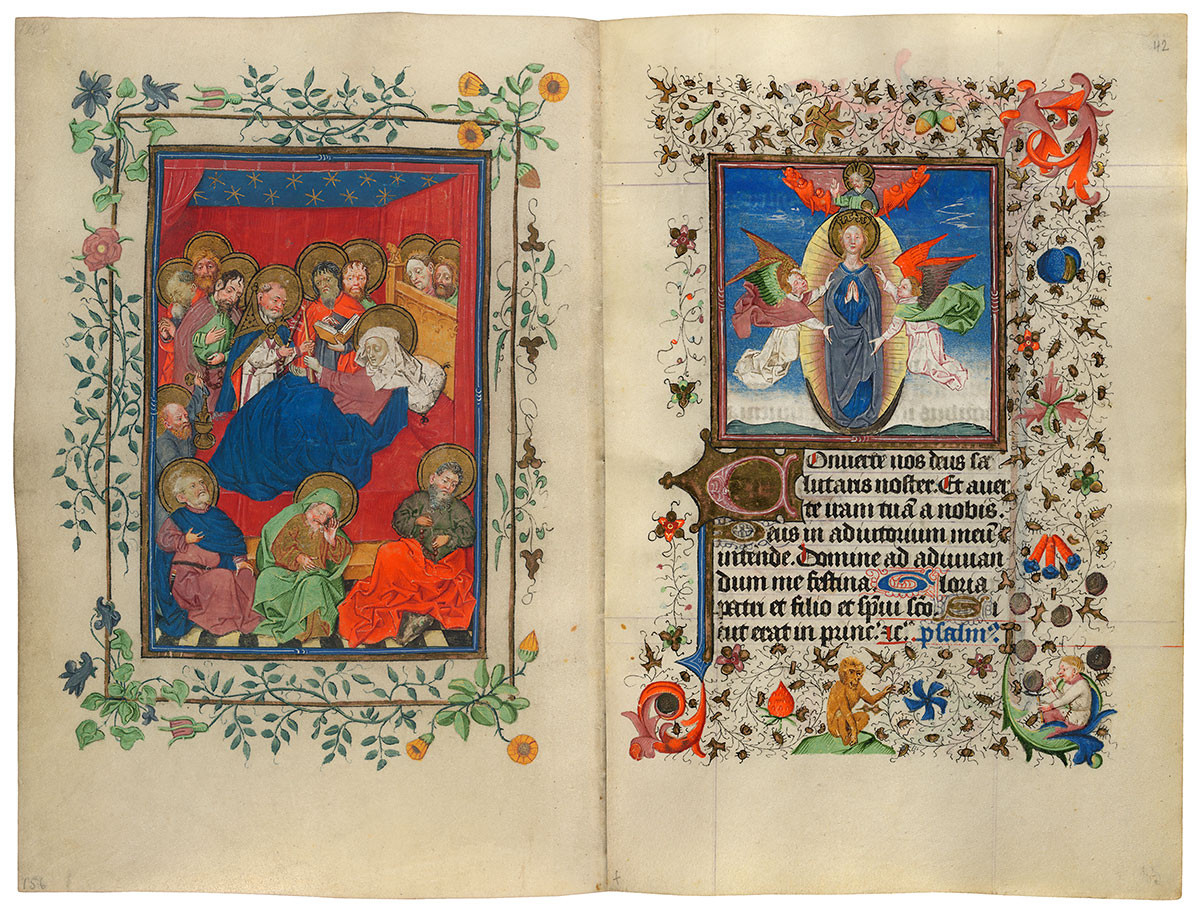
Death of the Virgin
Assumption of the Virgin
Purchased on the Belle da Costa Greene Fund with the assistance of the Fellows, 1963; purchased on the Belle da Costa Greene Fund with the assistance of the Fellows and with special assistance of Mrs. Frederick B. Adams, Sr., Mrs. Robert Charles, Mr. Laurens M. Hamilton, The Heineman Foundation, Mrs. Donald F. Hyde, Mrs. Jacob M. Kaplan, Mrs. John Kean, Mr. Paul Mellon, Mr. and Mrs. Charles F. Morgan, Mr. Lessing J. Rosenwald, Mr. and Mrs. August H. Schilling, Mrs. Herbert N. Straus, Mrs. Landon K. Thorne, Mrs. Alan Valentine, Mr. and Mrs. Arnold Whitridge, and Miss Julia P. Wightman, 1970
At Compline, the last Hour of the Virgin, the Marian narrative jumps to the end of Mary's life. The Virgin dies surrounded by the twelve apostles, who have miraculously arrived from all ends of the earth to comfort her. St. Peter supplies holy water and a lit taper (sinless her entire life, Mary needed none of the Last Rites' sacraments, such as Extreme Unction or Last Communion). The smaller miniature illustrates the Virgin's bodily assumption into heaven. Two angels bear her up to a waiting Christ.
Hours of the Virgin
The heart of every Book of Hours is the series of prayers called the Hours of the Virgin. Each Hour is composed of psalms plus hymns, biblical readings, and short phrases (antiphons, versicles, and responses). Ideally, these eight Hours were prayed throughout the course of the day:
| Matins and Lauds | at night or upon rising |
| Prime (first Hour) | at 6:00 a.m. |
| Terce (third Hour) | at 9:00 a.m. |
| Sext (sixth Hour) | at noon |
| Nones (ninth Hour) | at 3:00 p.m. |
| Vespers (evensong) | in the early evening |
| Compline | before retiring. |
The Hours of the Virgin date back to at least the ninth century. By the late twelfth century, the Hours appeared in Psalters, prayer books popular with laypeople. With a rising economy and the growth of the merchant class, the thirteenth century saw an increase in lay literacy. By the middle of the century, the Hours of the Virgin "spun off" from the Psalter and formed the core of the laypeople's prayer book, the Book of Hours.
The Virgin Mary is, of course, not mentioned in the numerous psalms of the Old Testament that comprise much of the Hours. Framing the psalms, however, are prayers that offer a mystical interpretation of the psalms and reveal the role played by the Virgin in mankind's salvation.
Image courtesy of Faksimile Verlag Luzern
MS M.917/945, ff. 42v–43r
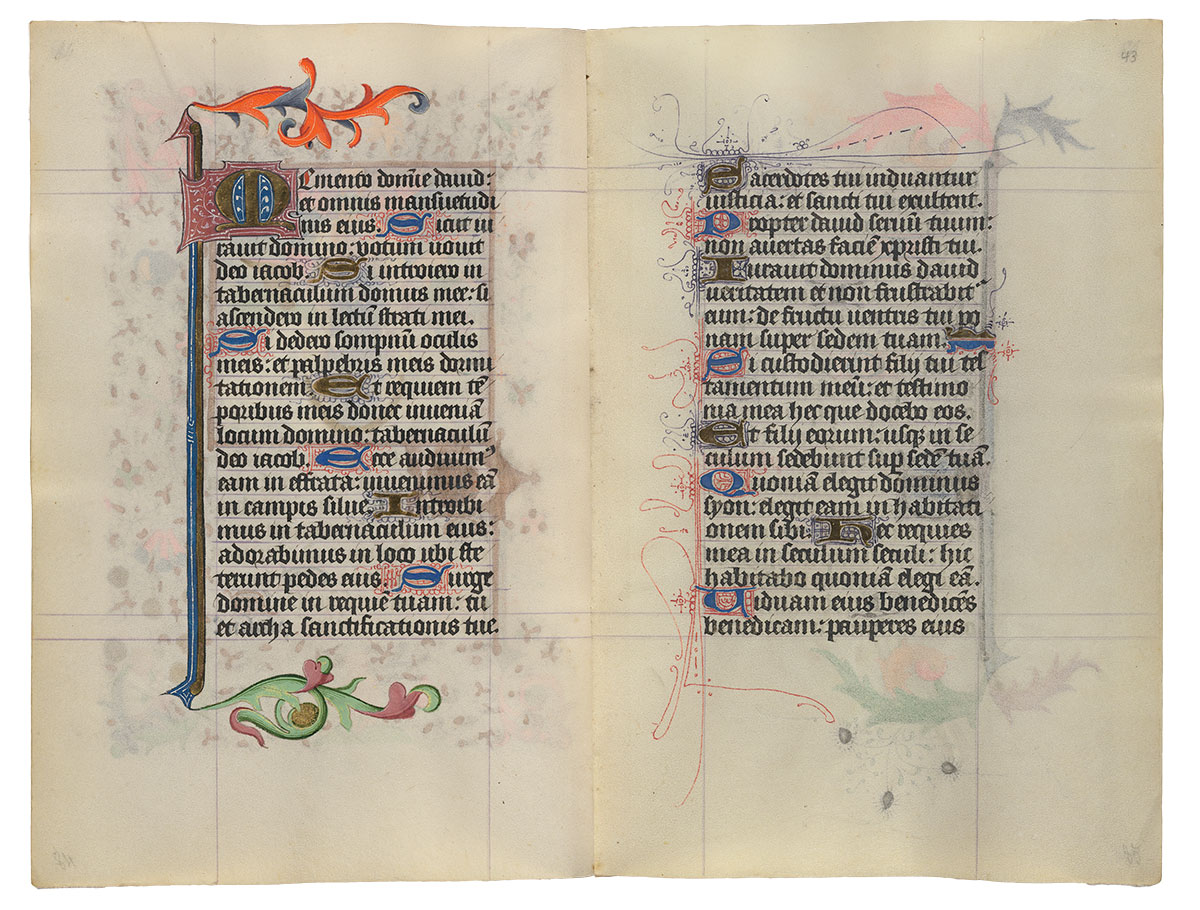
Purchased on the Belle da Costa Greene Fund with the assistance of the Fellows, 1963; purchased on the Belle da Costa Greene Fund with the assistance of the Fellows and with special assistance of Mrs. Frederick B. Adams, Sr., Mrs. Robert Charles, Mr. Laurens M. Hamilton, The Heineman Foundation, Mrs. Donald F. Hyde, Mrs. Jacob M. Kaplan, Mrs. John Kean, Mr. Paul Mellon, Mr. and Mrs. Charles F. Morgan, Mr. Lessing J. Rosenwald, Mr. and Mrs. August H. Schilling, Mrs. Herbert N. Straus, Mrs. Landon K. Thorne, Mrs. Alan Valentine, Mr. and Mrs. Arnold Whitridge, and Miss Julia P. Wightman, 1970
Image courtesy of Faksimile Verlag Luzern
MS M.917/945, ff. 43v–44r
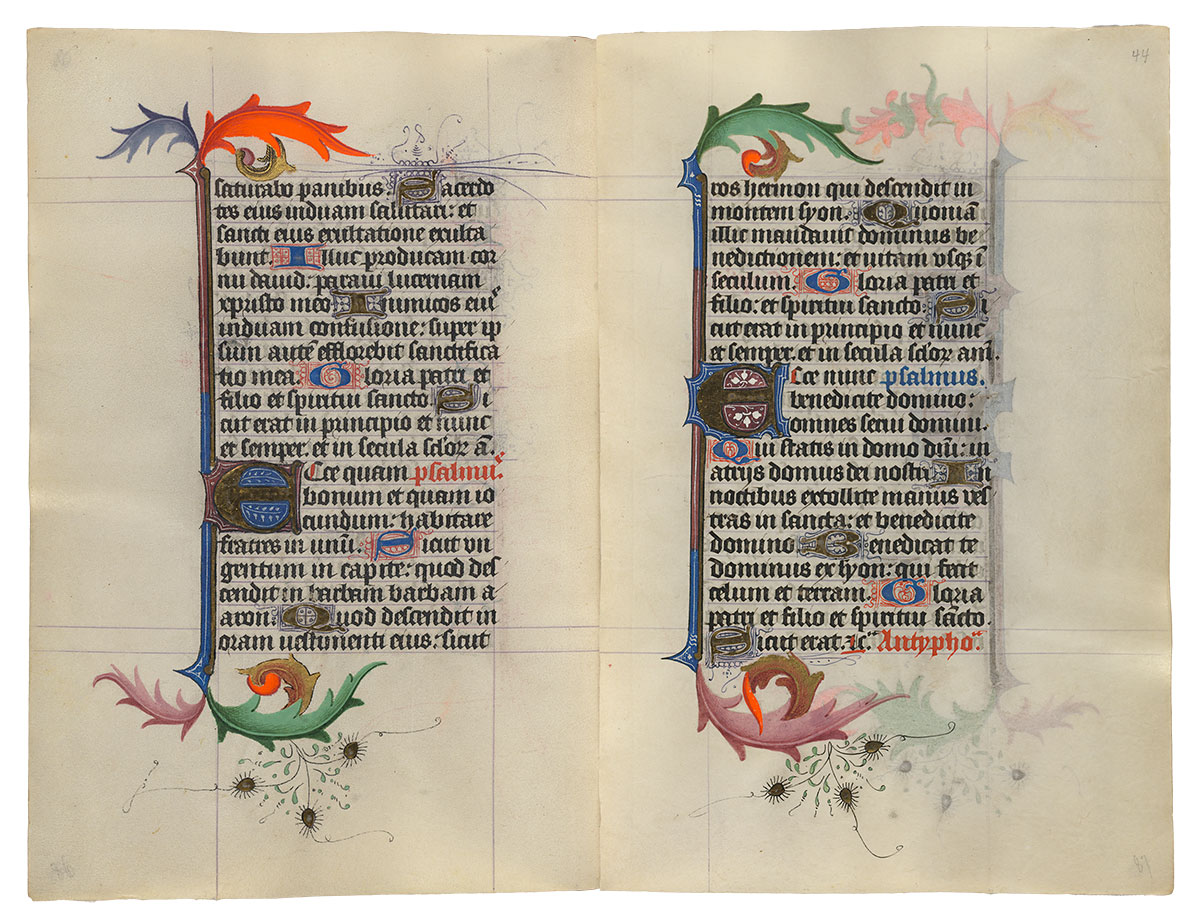
Purchased on the Belle da Costa Greene Fund with the assistance of the Fellows, 1963; purchased on the Belle da Costa Greene Fund with the assistance of the Fellows and with special assistance of Mrs. Frederick B. Adams, Sr., Mrs. Robert Charles, Mr. Laurens M. Hamilton, The Heineman Foundation, Mrs. Donald F. Hyde, Mrs. Jacob M. Kaplan, Mrs. John Kean, Mr. Paul Mellon, Mr. and Mrs. Charles F. Morgan, Mr. Lessing J. Rosenwald, Mr. and Mrs. August H. Schilling, Mrs. Herbert N. Straus, Mrs. Landon K. Thorne, Mrs. Alan Valentine, Mr. and Mrs. Arnold Whitridge, and Miss Julia P. Wightman, 1970
Image courtesy of Faksimile Verlag Luzern
MS M.917/945, ff. 44v–45r
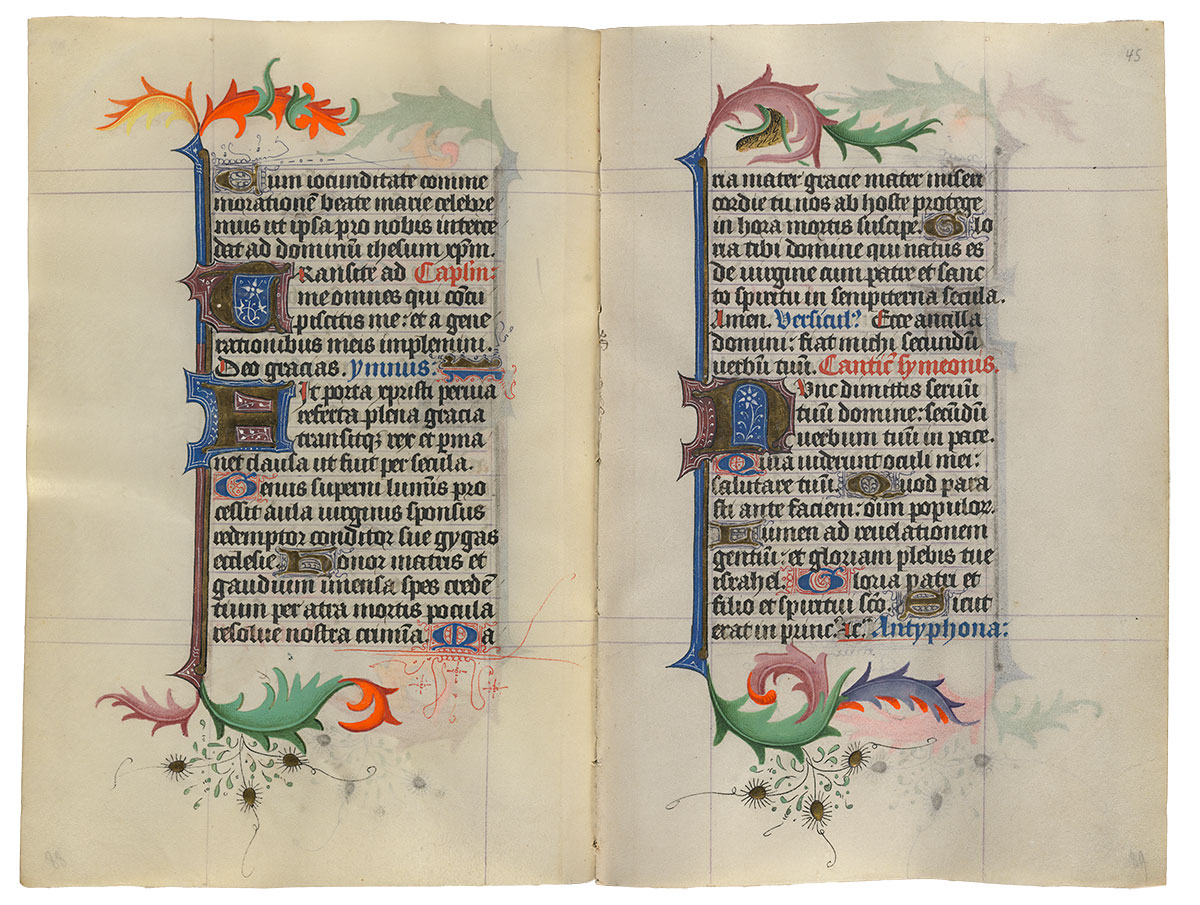
Purchased on the Belle da Costa Greene Fund with the assistance of the Fellows, 1963; purchased on the Belle da Costa Greene Fund with the assistance of the Fellows and with special assistance of Mrs. Frederick B. Adams, Sr., Mrs. Robert Charles, Mr. Laurens M. Hamilton, The Heineman Foundation, Mrs. Donald F. Hyde, Mrs. Jacob M. Kaplan, Mrs. John Kean, Mr. Paul Mellon, Mr. and Mrs. Charles F. Morgan, Mr. Lessing J. Rosenwald, Mr. and Mrs. August H. Schilling, Mrs. Herbert N. Straus, Mrs. Landon K. Thorne, Mrs. Alan Valentine, Mr. and Mrs. Arnold Whitridge, and Miss Julia P. Wightman, 1970
Image courtesy of Faksimile Verlag Luzern
MS M.917/945, ff. 45v–46r
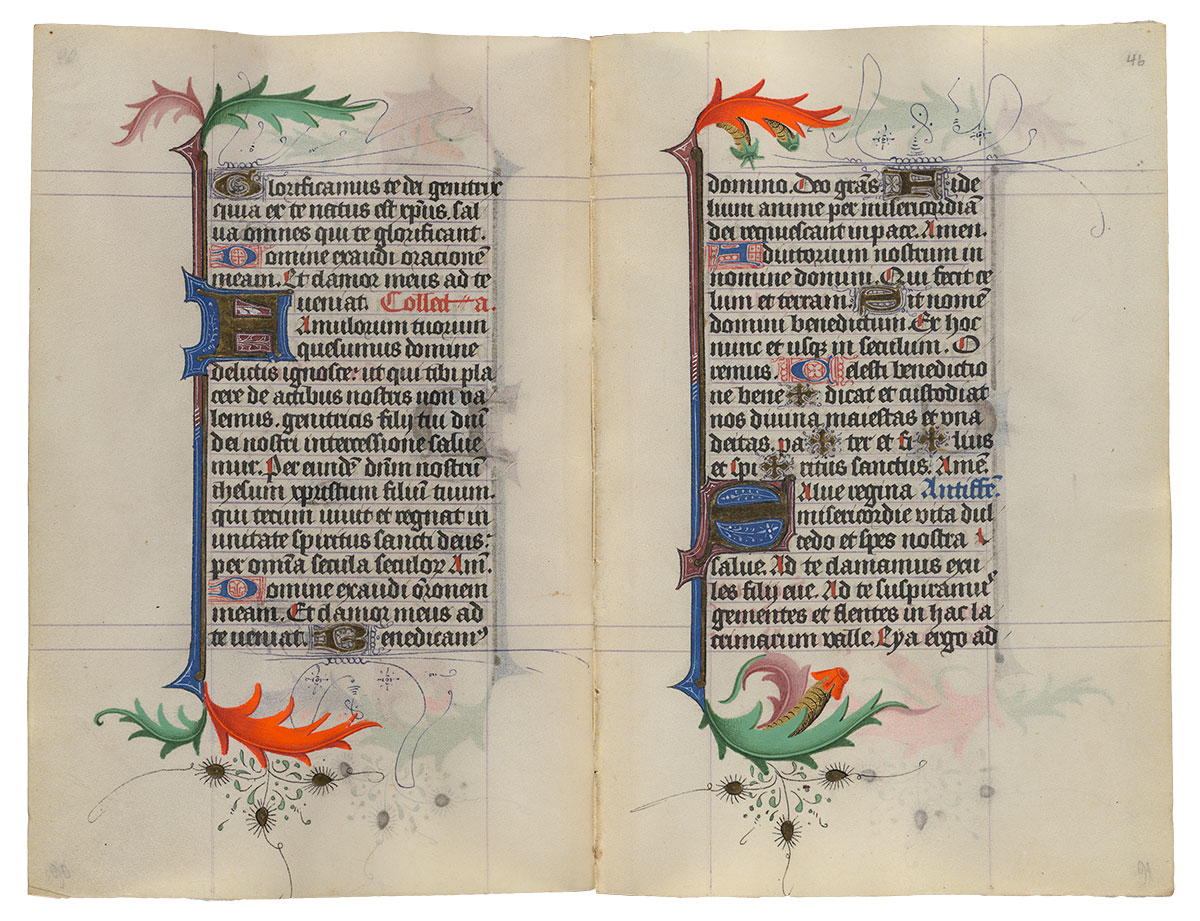
Purchased on the Belle da Costa Greene Fund with the assistance of the Fellows, 1963; purchased on the Belle da Costa Greene Fund with the assistance of the Fellows and with special assistance of Mrs. Frederick B. Adams, Sr., Mrs. Robert Charles, Mr. Laurens M. Hamilton, The Heineman Foundation, Mrs. Donald F. Hyde, Mrs. Jacob M. Kaplan, Mrs. John Kean, Mr. Paul Mellon, Mr. and Mrs. Charles F. Morgan, Mr. Lessing J. Rosenwald, Mr. and Mrs. August H. Schilling, Mrs. Herbert N. Straus, Mrs. Landon K. Thorne, Mrs. Alan Valentine, Mr. and Mrs. Arnold Whitridge, and Miss Julia P. Wightman, 1970
Image courtesy of Faksimile Verlag Luzern
MS M.917/945, f. 46v–p. 119
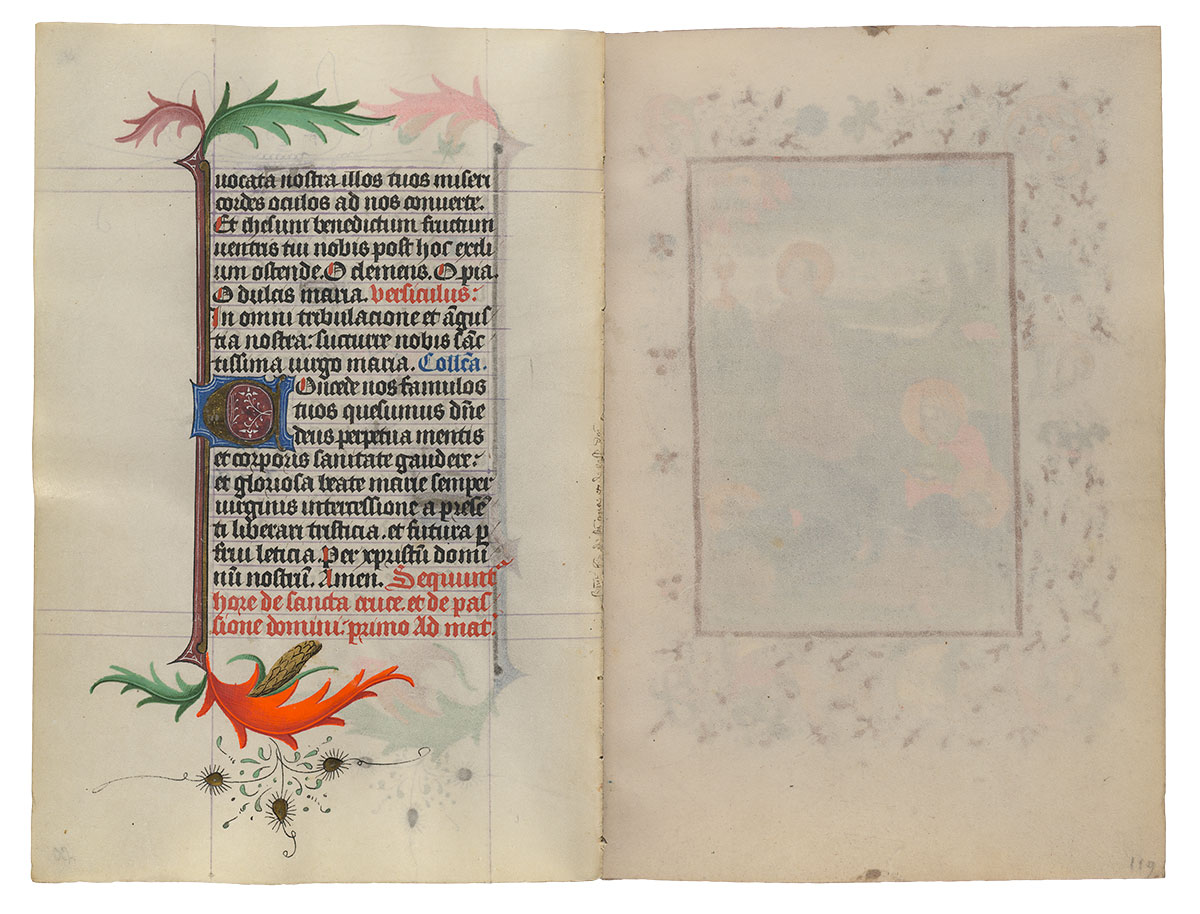
Purchased on the Belle da Costa Greene Fund with the assistance of the Fellows, 1963; purchased on the Belle da Costa Greene Fund with the assistance of the Fellows and with special assistance of Mrs. Frederick B. Adams, Sr., Mrs. Robert Charles, Mr. Laurens M. Hamilton, The Heineman Foundation, Mrs. Donald F. Hyde, Mrs. Jacob M. Kaplan, Mrs. John Kean, Mr. Paul Mellon, Mr. and Mrs. Charles F. Morgan, Mr. Lessing J. Rosenwald, Mr. and Mrs. August H. Schilling, Mrs. Herbert N. Straus, Mrs. Landon K. Thorne, Mrs. Alan Valentine, Mr. and Mrs. Arnold Whitridge, and Miss Julia P. Wightman, 1970
Image courtesy of Faksimile Verlag Luzern
Hours of the Passion
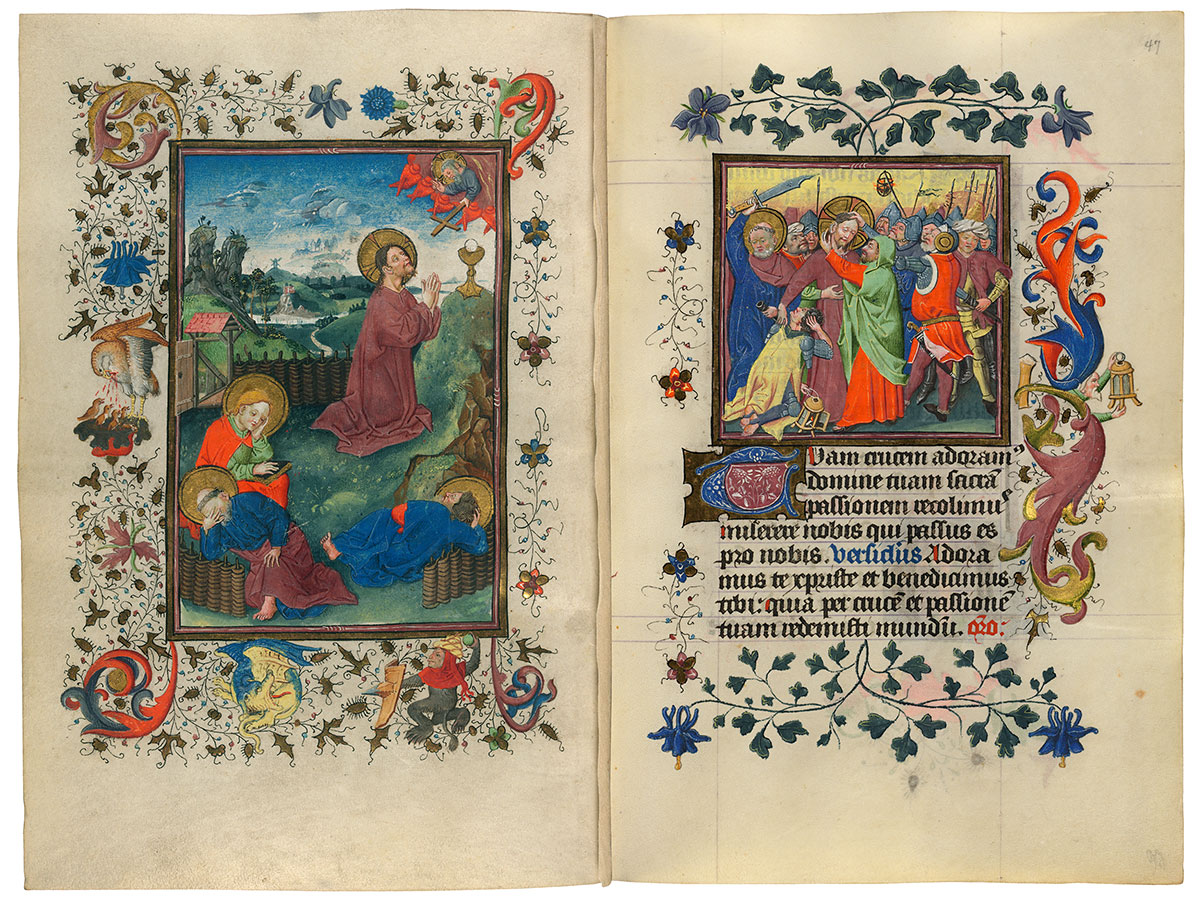
Agony in the Garden
Arrest of Christ
Purchased on the Belle da Costa Greene Fund with the assistance of the Fellows, 1963; purchased on the Belle da Costa Greene Fund with the assistance of the Fellows and with special assistance of Mrs. Frederick B. Adams, Sr., Mrs. Robert Charles, Mr. Laurens M. Hamilton, The Heineman Foundation, Mrs. Donald F. Hyde, Mrs. Jacob M. Kaplan, Mrs. John Kean, Mr. Paul Mellon, Mr. and Mrs. Charles F. Morgan, Mr. Lessing J. Rosenwald, Mr. and Mrs. August H. Schilling, Mrs. Herbert N. Straus, Mrs. Landon K. Thorne, Mrs. Alan Valentine, Mr. and Mrs. Arnold Whitridge, and Miss Julia P. Wightman, 1970
Like the Hours of the Virgin, the Hours of the Passion marked each of its textual divisions with juxtaposed full- and half-page miniatures. Thus Christ's Passion unfolds with a rich suite of sixteen illustrations. The cycle commences with Christ in the garden of Gethsemane. While apostles doze, the Savior beseeches his Father to remove the cup before him. The cup, a chalice containing a communion wafer, symbolizes both his forthcoming death and the Eucharist. The Eucharistic theme is reiterated by the border vignette of the pelican feeding her young with her own blood, a symbol of Christ's sacrificial Death on the Cross. In the next scene, following Judas's kiss, soldiers seize Christ, who calmly replaces the ear that Peter has sliced from Malchus.
Hours of the Passion
The Hours of the Passion are often found in Books of Hours following, as in Catherine's manuscript, the Hours of the Virgin. The lengthy psalms are supplemented with prayers that narrate the story of Christ's Passion. If Catherine had little time, she might pray Matins alone, where the three lessons encapsulate the entire Passion, from Christ's Arrest until his Death on the Cross. A slower meditation is provided by the remaining Hours. The drama begins at Vespers, whose prayer narrates events from Holy Thursday: the Last Super and Christ Washing the Feet of the Apostles. Compline's prayer relates Christ's Agony in the Garden. The prayer at Lauds relates to Christ Before Pilate and Peter's Denial. The Passion concludes with None's prayer telling of Christ's Death on the Cross.
Image courtesy of Faksimile Verlag Luzern
MS M.917/945, ff. 47v–48r
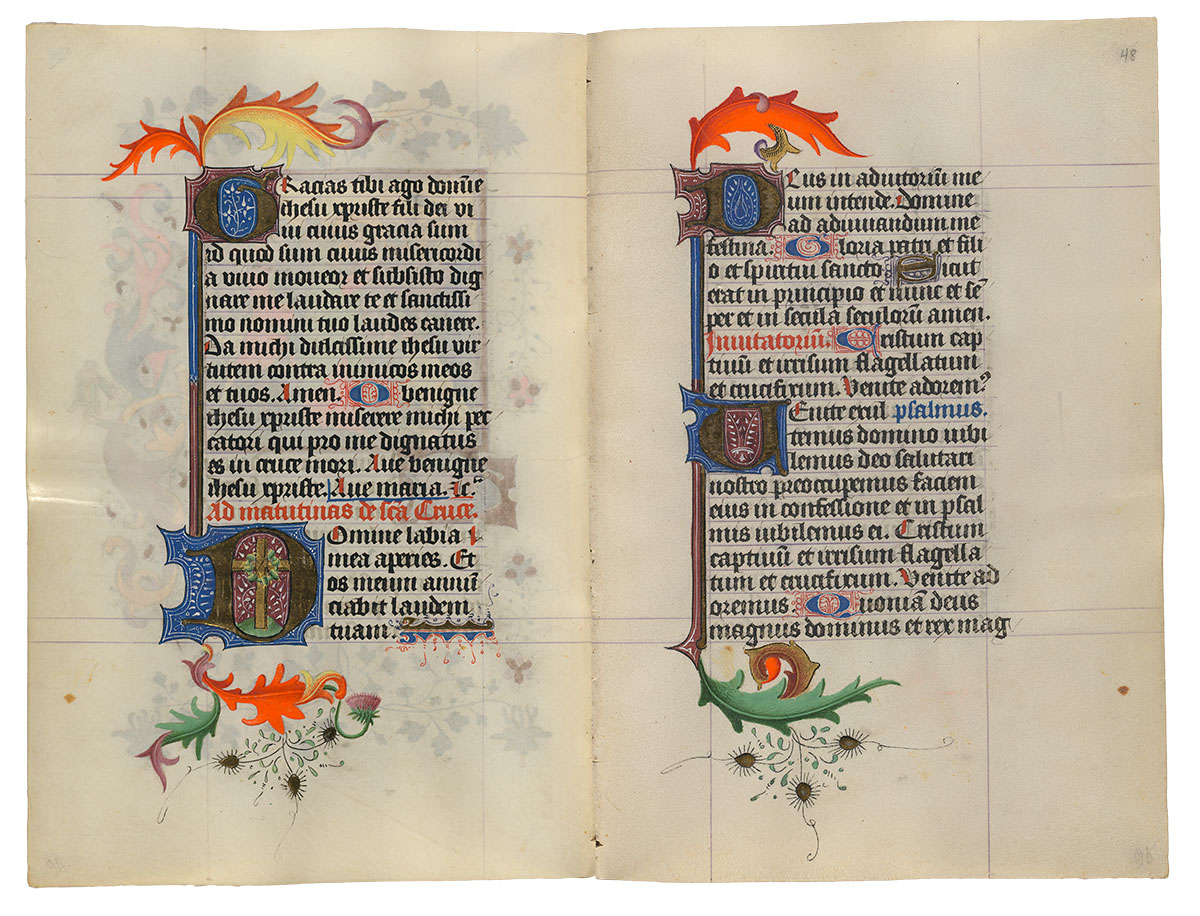
Purchased on the Belle da Costa Greene Fund with the assistance of the Fellows, 1963; purchased on the Belle da Costa Greene Fund with the assistance of the Fellows and with special assistance of Mrs. Frederick B. Adams, Sr., Mrs. Robert Charles, Mr. Laurens M. Hamilton, The Heineman Foundation, Mrs. Donald F. Hyde, Mrs. Jacob M. Kaplan, Mrs. John Kean, Mr. Paul Mellon, Mr. and Mrs. Charles F. Morgan, Mr. Lessing J. Rosenwald, Mr. and Mrs. August H. Schilling, Mrs. Herbert N. Straus, Mrs. Landon K. Thorne, Mrs. Alan Valentine, Mr. and Mrs. Arnold Whitridge, and Miss Julia P. Wightman, 1970
Image courtesy of Faksimile Verlag Luzern
MS M.917/945, ff. 48v–49r
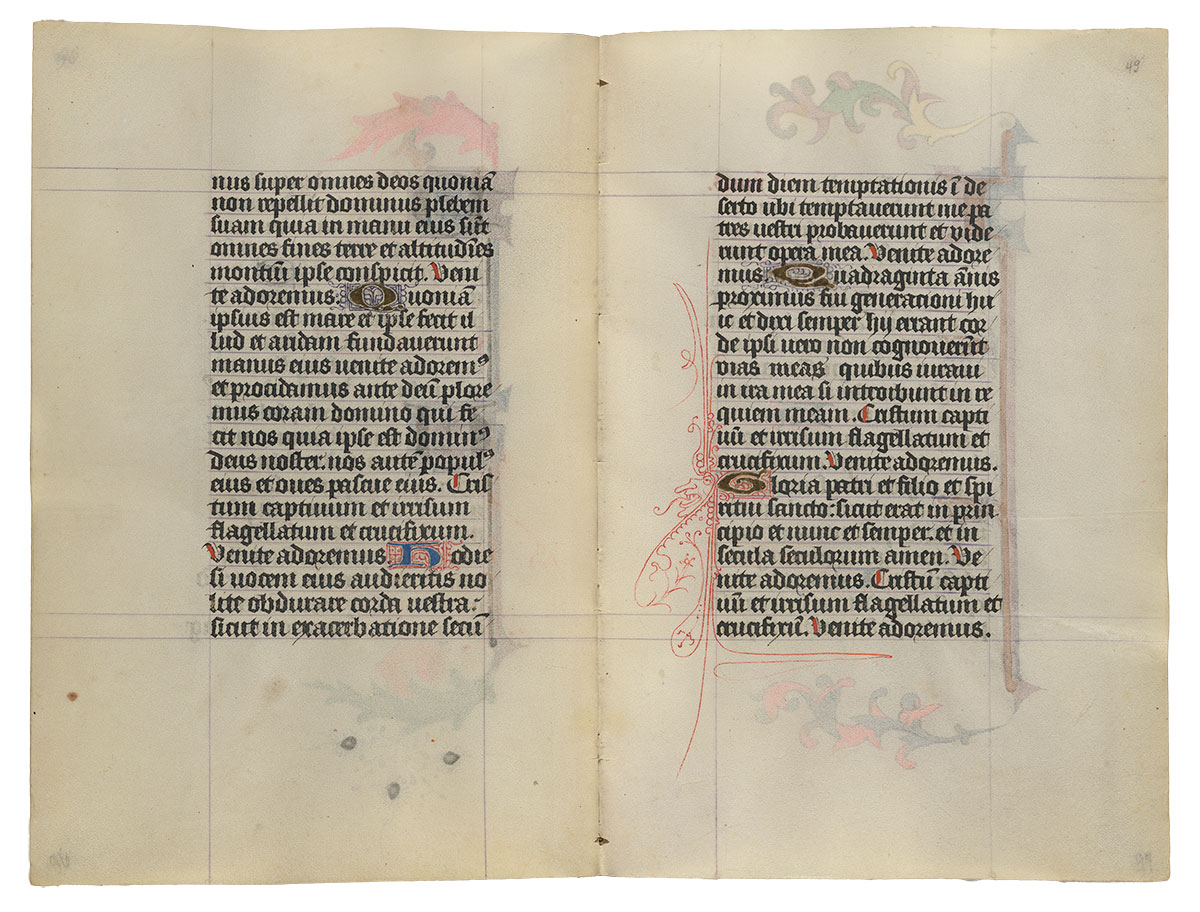
Purchased on the Belle da Costa Greene Fund with the assistance of the Fellows, 1963; purchased on the Belle da Costa Greene Fund with the assistance of the Fellows and with special assistance of Mrs. Frederick B. Adams, Sr., Mrs. Robert Charles, Mr. Laurens M. Hamilton, The Heineman Foundation, Mrs. Donald F. Hyde, Mrs. Jacob M. Kaplan, Mrs. John Kean, Mr. Paul Mellon, Mr. and Mrs. Charles F. Morgan, Mr. Lessing J. Rosenwald, Mr. and Mrs. August H. Schilling, Mrs. Herbert N. Straus, Mrs. Landon K. Thorne, Mrs. Alan Valentine, Mr. and Mrs. Arnold Whitridge, and Miss Julia P. Wightman, 1970
Image courtesy of Faksimile Verlag Luzern
MS M.917/945, ff. 49v–50r
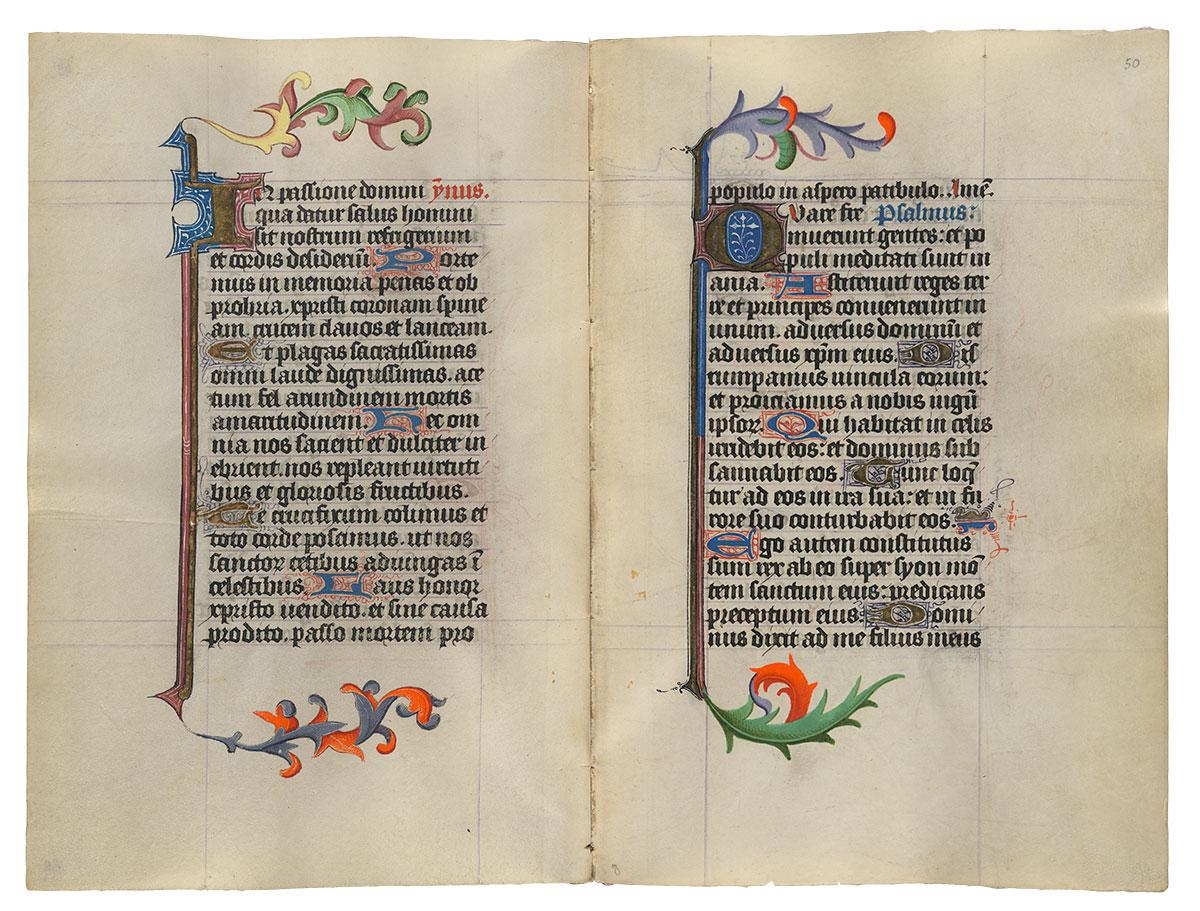
Purchased on the Belle da Costa Greene Fund with the assistance of the Fellows, 1963; purchased on the Belle da Costa Greene Fund with the assistance of the Fellows and with special assistance of Mrs. Frederick B. Adams, Sr., Mrs. Robert Charles, Mr. Laurens M. Hamilton, The Heineman Foundation, Mrs. Donald F. Hyde, Mrs. Jacob M. Kaplan, Mrs. John Kean, Mr. Paul Mellon, Mr. and Mrs. Charles F. Morgan, Mr. Lessing J. Rosenwald, Mr. and Mrs. August H. Schilling, Mrs. Herbert N. Straus, Mrs. Landon K. Thorne, Mrs. Alan Valentine, Mr. and Mrs. Arnold Whitridge, and Miss Julia P. Wightman, 1970
Image courtesy of Faksimile Verlag Luzern
MS M.917/945, ff. 50v–51r
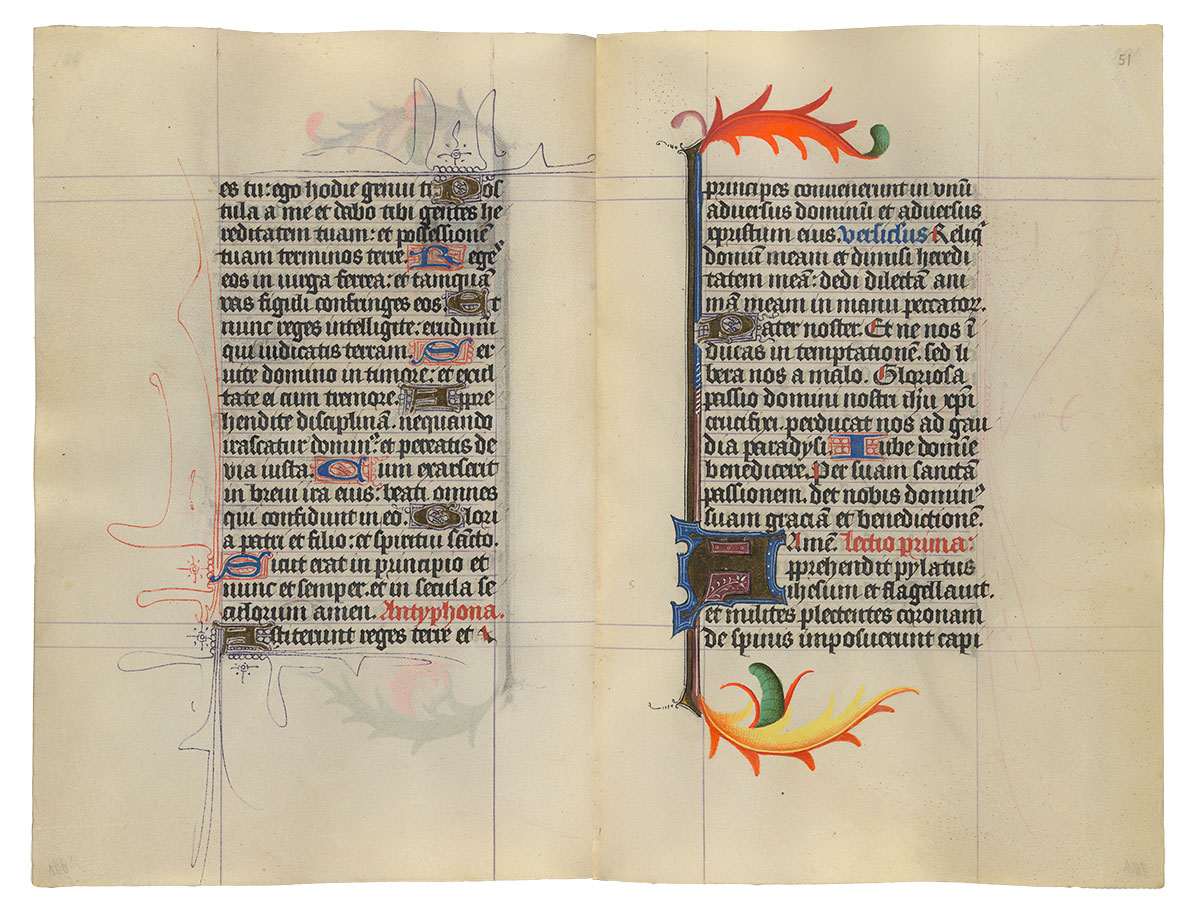
Purchased on the Belle da Costa Greene Fund with the assistance of the Fellows, 1963; purchased on the Belle da Costa Greene Fund with the assistance of the Fellows and with special assistance of Mrs. Frederick B. Adams, Sr., Mrs. Robert Charles, Mr. Laurens M. Hamilton, The Heineman Foundation, Mrs. Donald F. Hyde, Mrs. Jacob M. Kaplan, Mrs. John Kean, Mr. Paul Mellon, Mr. and Mrs. Charles F. Morgan, Mr. Lessing J. Rosenwald, Mr. and Mrs. August H. Schilling, Mrs. Herbert N. Straus, Mrs. Landon K. Thorne, Mrs. Alan Valentine, Mr. and Mrs. Arnold Whitridge, and Miss Julia P. Wightman, 1970
Image courtesy of Faksimile Verlag Luzern
MS M.917/945, ff. 51v–52r
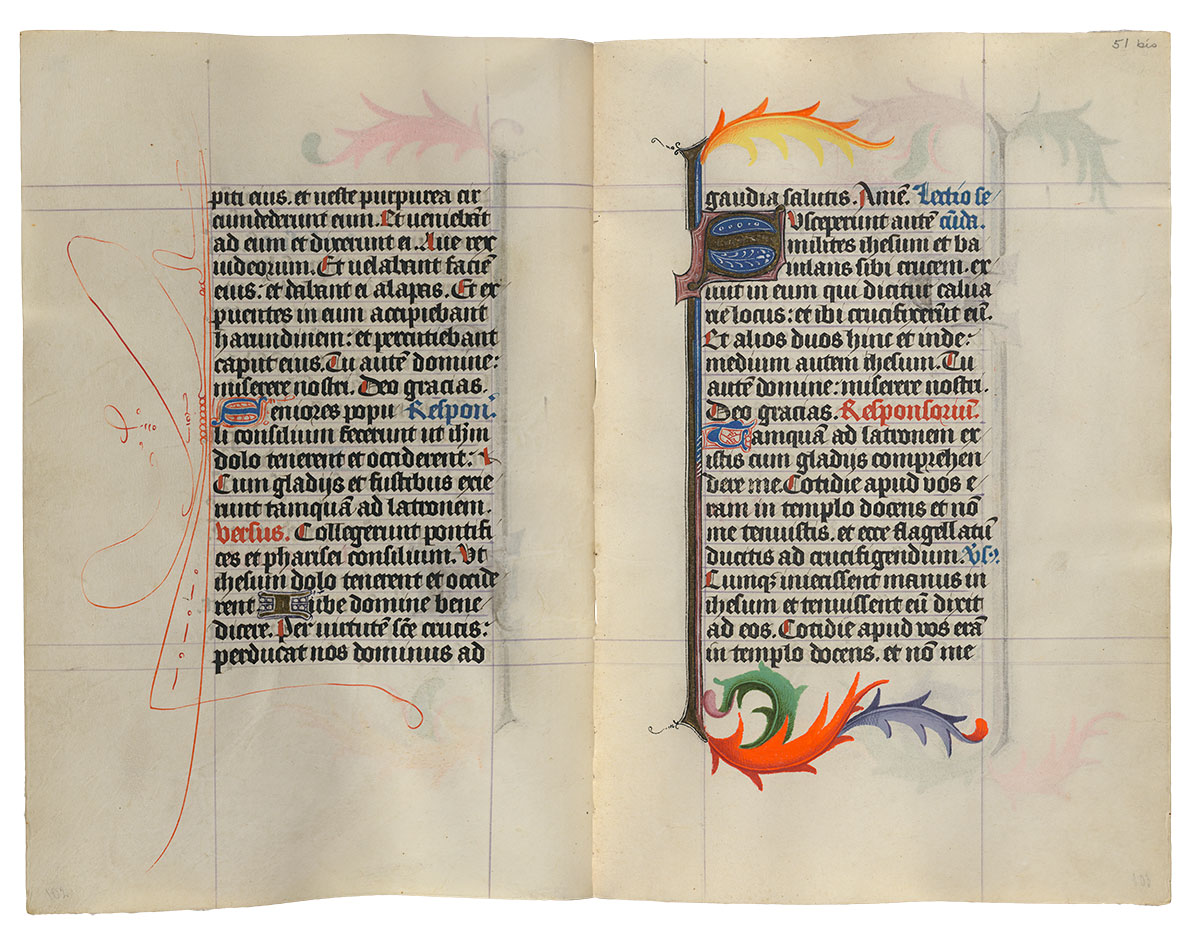
Purchased on the Belle da Costa Greene Fund with the assistance of the Fellows, 1963; purchased on the Belle da Costa Greene Fund with the assistance of the Fellows and with special assistance of Mrs. Frederick B. Adams, Sr., Mrs. Robert Charles, Mr. Laurens M. Hamilton, The Heineman Foundation, Mrs. Donald F. Hyde, Mrs. Jacob M. Kaplan, Mrs. John Kean, Mr. Paul Mellon, Mr. and Mrs. Charles F. Morgan, Mr. Lessing J. Rosenwald, Mr. and Mrs. August H. Schilling, Mrs. Herbert N. Straus, Mrs. Landon K. Thorne, Mrs. Alan Valentine, Mr. and Mrs. Arnold Whitridge, and Miss Julia P. Wightman, 1970
Image courtesy of Faksimile Verlag Luzern
MS M.917/945, ff. 52v–53r
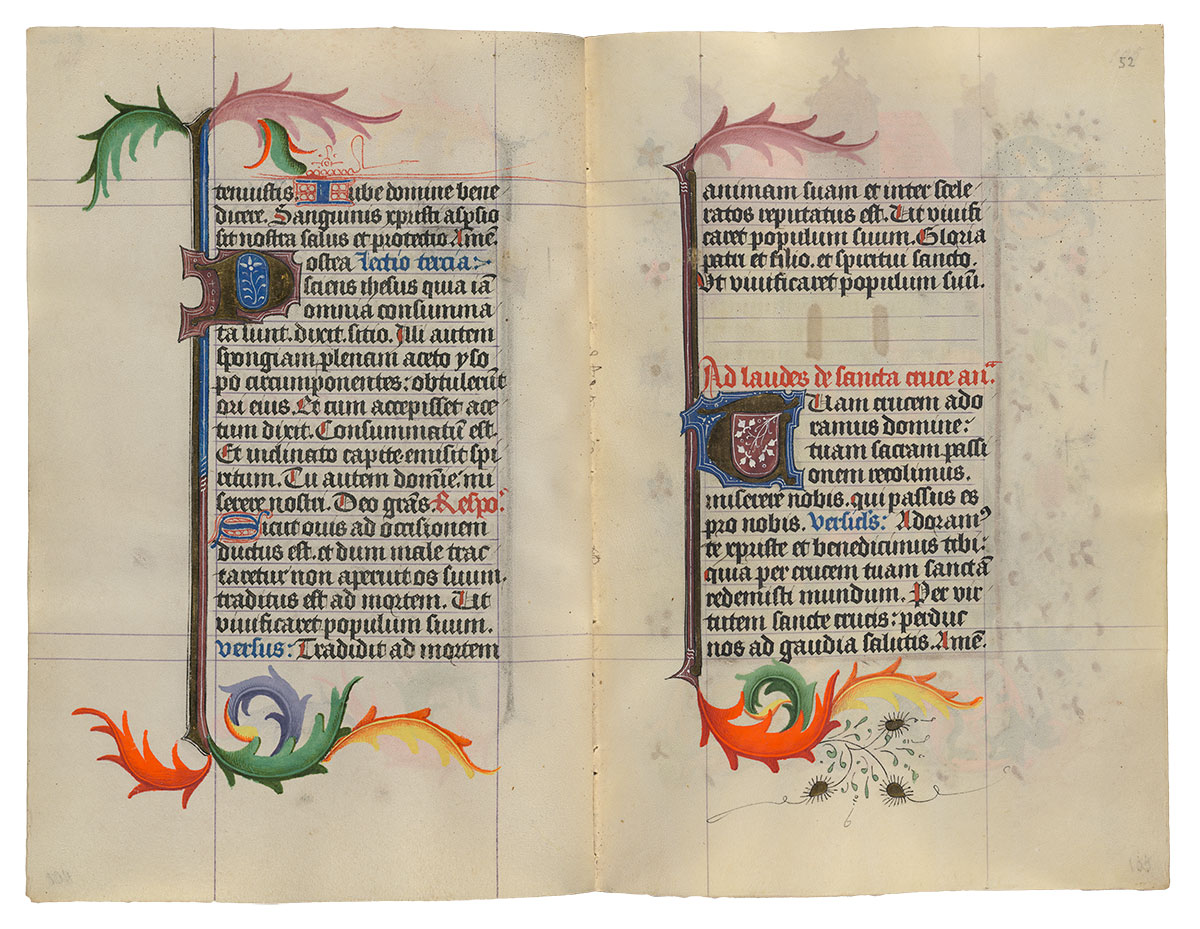
Purchased on the Belle da Costa Greene Fund with the assistance of the Fellows, 1963; purchased on the Belle da Costa Greene Fund with the assistance of the Fellows and with special assistance of Mrs. Frederick B. Adams, Sr., Mrs. Robert Charles, Mr. Laurens M. Hamilton, The Heineman Foundation, Mrs. Donald F. Hyde, Mrs. Jacob M. Kaplan, Mrs. John Kean, Mr. Paul Mellon, Mr. and Mrs. Charles F. Morgan, Mr. Lessing J. Rosenwald, Mr. and Mrs. August H. Schilling, Mrs. Herbert N. Straus, Mrs. Landon K. Thorne, Mrs. Alan Valentine, Mr. and Mrs. Arnold Whitridge, and Miss Julia P. Wightman, 1970
Image courtesy of Faksimile Verlag Luzern
MS M.917/945, ff. 52v–53r
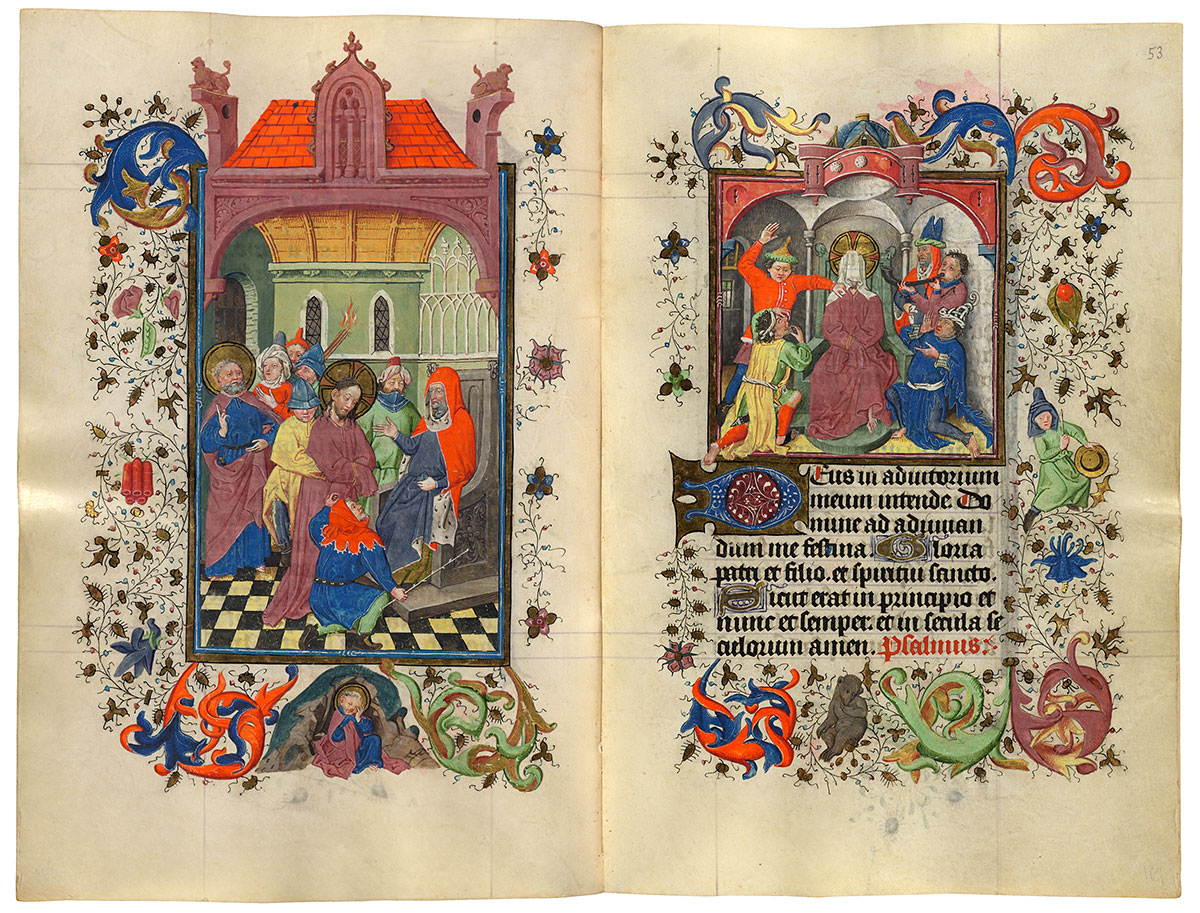
Christ before Caiaphas
Christ Mocked
Purchased on the Belle da Costa Greene Fund with the assistance of the Fellows and with special assistance of Mrs. Frederick B. Adams, Sr., Mrs. Robert Charles, Mr. Laurens M. Hamilton, The Heineman Foundation, Mrs. Donald F. Hyde, Mrs. Jacob M. Kaplan, Mrs. John Kean, Mr. Paul Mellon, Mr. and Mrs. Charles F. Morgan, Mr. Lessing J. Rosenwald, Mr. and Mrs. August H. Schilling, Mrs. Herbert N. Straus, Mrs. Landon K. Thorne, Mrs. Alan Valentine, Mr. and Mrs. Arnold Whitridge, and Miss Julia P. Wightman, 1970
A meek Christ is led to the throne of the Jewish high priest Caiaphas, whose corruption is indicated by his corpulence and foppish ermine-lined scarlet mantle. Before the pair kneels a man in a fancy dagged chaperon (connoting worldliness or evil), who mockingly accuses the Savior. Behind this group stands Peter, who denies any knowledge of the accused. Below the miniature, a repentant Peter weeps at the mouth of a cave. In the small miniature, Caiaphas, standing against the wall, directs the mocking of Christ. The seated Savior stoically endures indignities; his face has been covered with a cloth by his tormentors who taunt him, saying that surely his powers enable him to identify his abusers.
Hours of the Passion
The Hours of the Passion are often found in Books of Hours following, as in Catherine's manuscript, the Hours of the Virgin. The lengthy psalms are supplemented with prayers that narrate the story of Christ's Passion. If Catherine had little time, she might pray Matins alone, where the three lessons encapsulate the entire Passion, from Christ's Arrest until his Death on the Cross. A slower meditation is provided by the remaining Hours. The drama begins at Vespers, whose prayer narrates events from Holy Thursday: the Last Super and Christ Washing the Feet of the Apostles. Compline's prayer relates Christ's Agony in the Garden. The prayer at Lauds relates to Christ Before Pilate and Peter's Denial. The Passion concludes with None's prayer telling of Christ's Death on the Cross.
Image courtesy of Faksimile Verlag Luzern
MS M.917/945, ff. 53v–54r
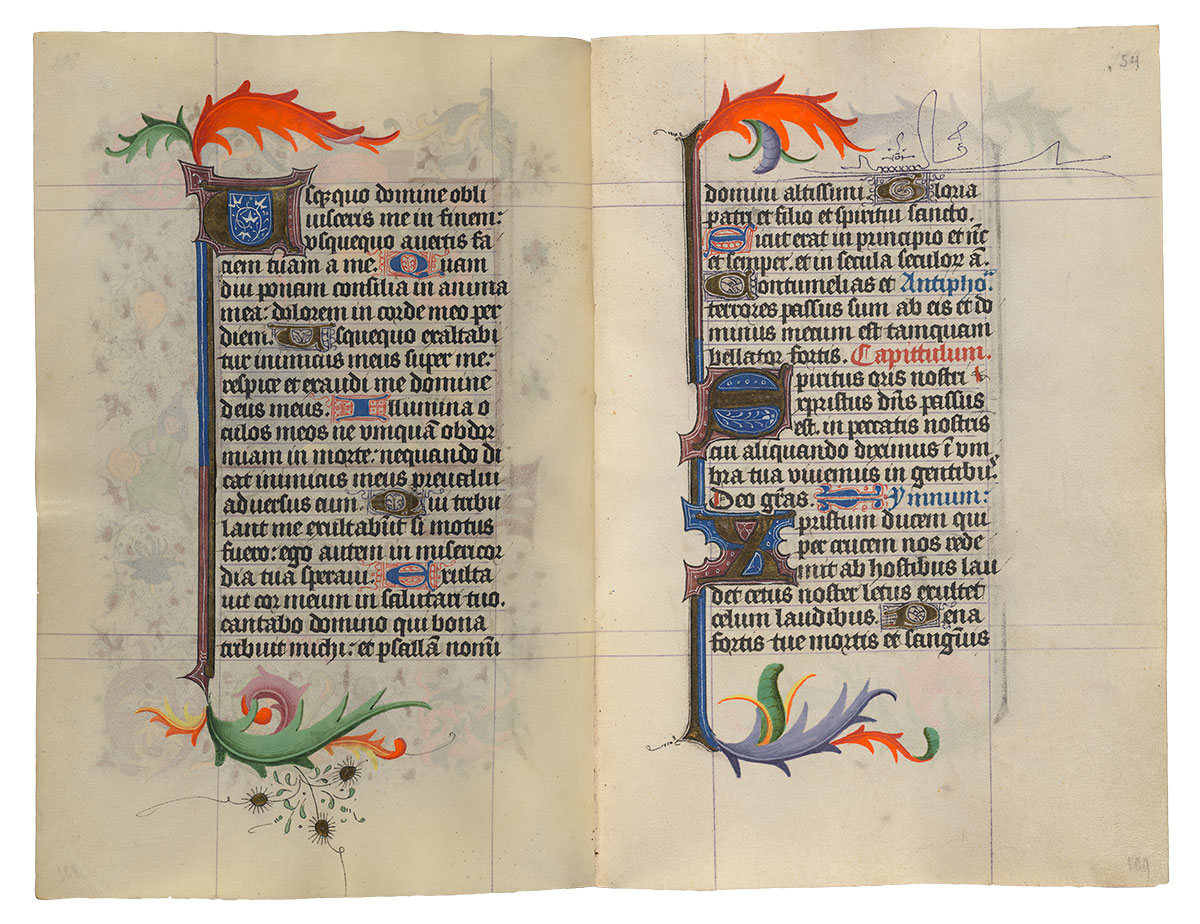
Purchased on the Belle da Costa Greene Fund with the assistance of the Fellows, 1963; purchased on the Belle da Costa Greene Fund with the assistance of the Fellows and with special assistance of Mrs. Frederick B. Adams, Sr., Mrs. Robert Charles, Mr. Laurens M. Hamilton, The Heineman Foundation, Mrs. Donald F. Hyde, Mrs. Jacob M. Kaplan, Mrs. John Kean, Mr. Paul Mellon, Mr. and Mrs. Charles F. Morgan, Mr. Lessing J. Rosenwald, Mr. and Mrs. August H. Schilling, Mrs. Herbert N. Straus, Mrs. Landon K. Thorne, Mrs. Alan Valentine, Mr. and Mrs. Arnold Whitridge, and Miss Julia P. Wightman, 1970
Image courtesy of Faksimile Verlag Luzern
MS M.917/945, ff. 54v–55r
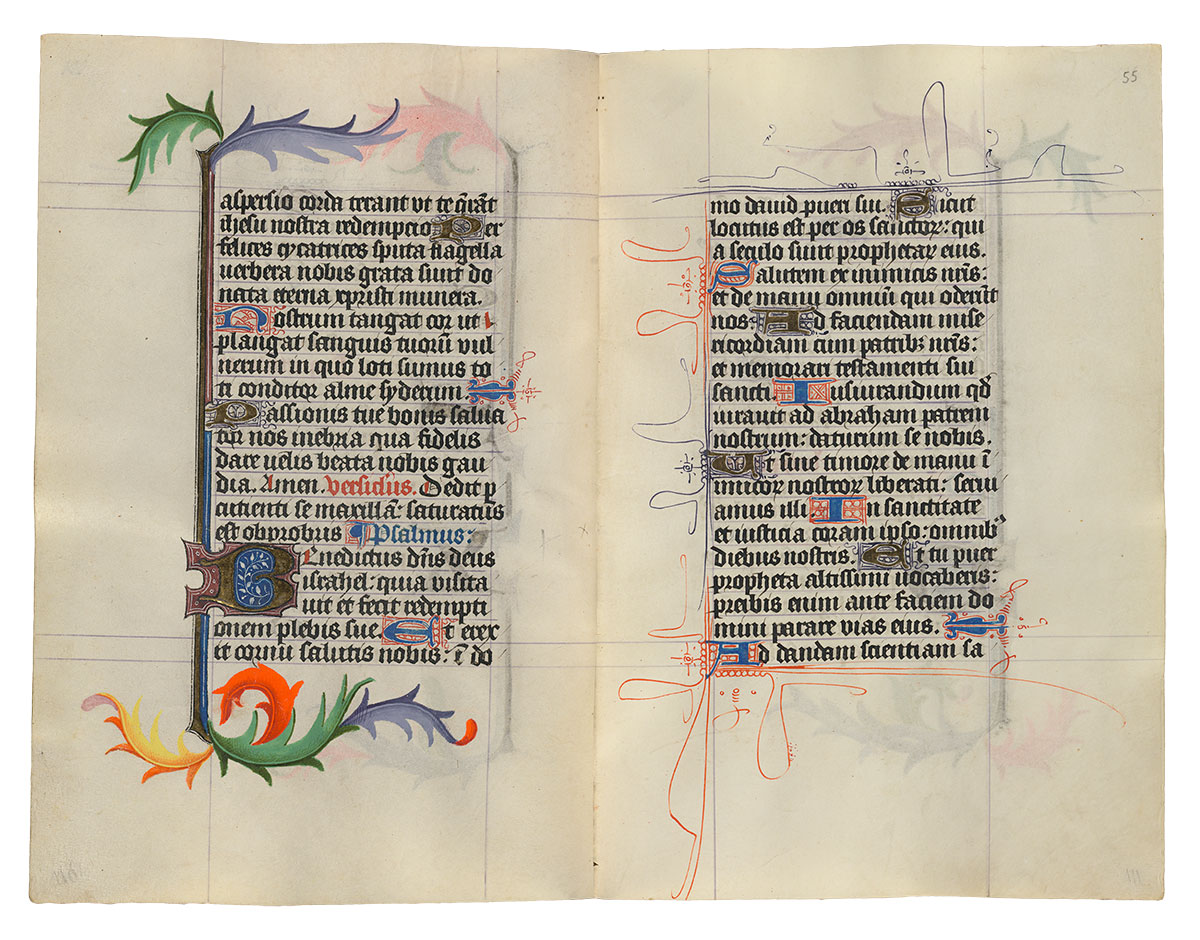
Purchased on the Belle da Costa Greene Fund with the assistance of the Fellows, 1963; purchased on the Belle da Costa Greene Fund with the assistance of the Fellows and with special assistance of Mrs. Frederick B. Adams, Sr., Mrs. Robert Charles, Mr. Laurens M. Hamilton, The Heineman Foundation, Mrs. Donald F. Hyde, Mrs. Jacob M. Kaplan, Mrs. John Kean, Mr. Paul Mellon, Mr. and Mrs. Charles F. Morgan, Mr. Lessing J. Rosenwald, Mr. and Mrs. August H. Schilling, Mrs. Herbert N. Straus, Mrs. Landon K. Thorne, Mrs. Alan Valentine, Mr. and Mrs. Arnold Whitridge, and Miss Julia P. Wightman, 1970
Image courtesy of Faksimile Verlag Luzern
MS M.917/945, ff. 55v–56r
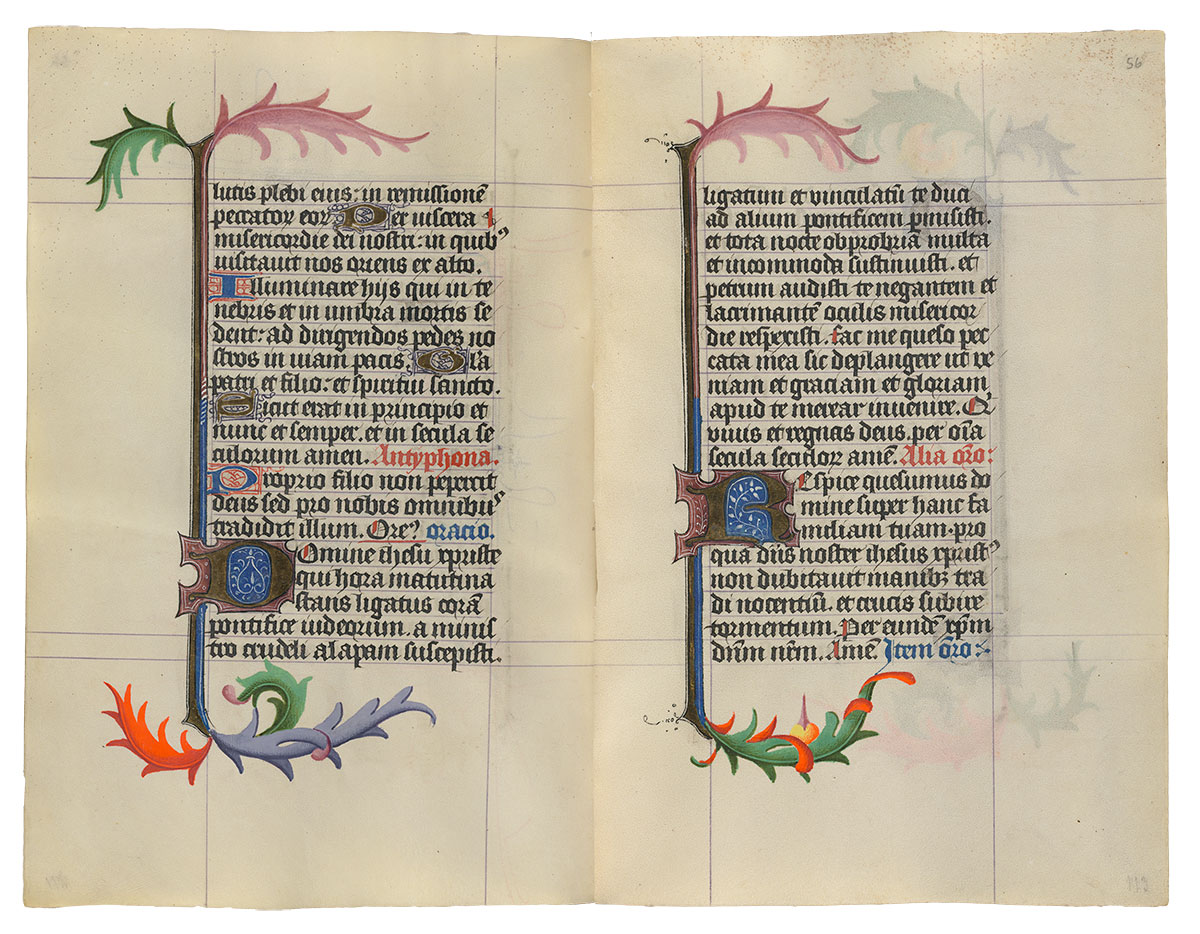
Purchased on the Belle da Costa Greene Fund with the assistance of the Fellows, 1963; purchased on the Belle da Costa Greene Fund with the assistance of the Fellows and with special assistance of Mrs. Frederick B. Adams, Sr., Mrs. Robert Charles, Mr. Laurens M. Hamilton, The Heineman Foundation, Mrs. Donald F. Hyde, Mrs. Jacob M. Kaplan, Mrs. John Kean, Mr. Paul Mellon, Mr. and Mrs. Charles F. Morgan, Mr. Lessing J. Rosenwald, Mr. and Mrs. August H. Schilling, Mrs. Herbert N. Straus, Mrs. Landon K. Thorne, Mrs. Alan Valentine, Mr. and Mrs. Arnold Whitridge, and Miss Julia P. Wightman, 1970
Image courtesy of Faksimile Verlag Luzern
MS M.917/945, ff. 56v–57r
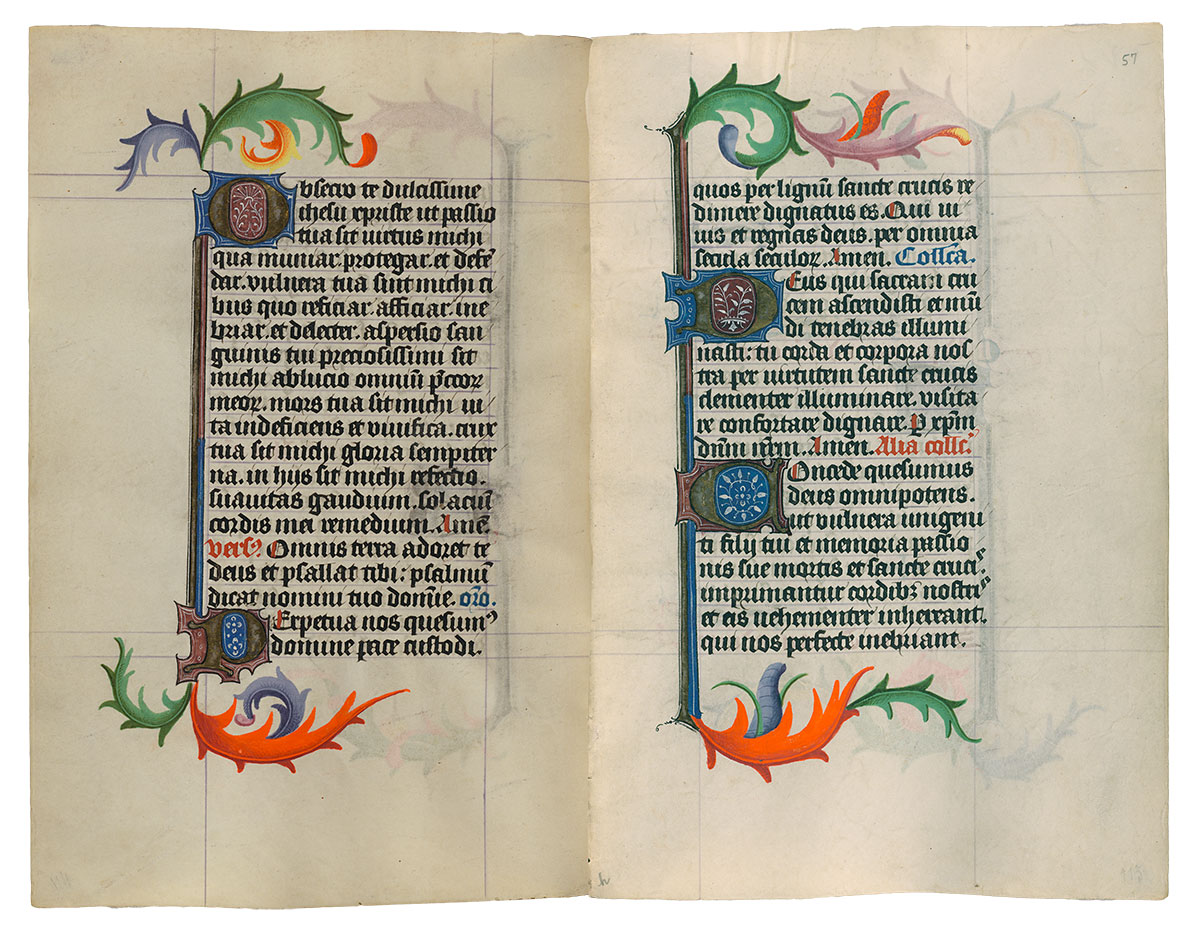
Purchased on the Belle da Costa Greene Fund with the assistance of the Fellows, 1963; purchased on the Belle da Costa Greene Fund with the assistance of the Fellows and with special assistance of Mrs. Frederick B. Adams, Sr., Mrs. Robert Charles, Mr. Laurens M. Hamilton, The Heineman Foundation, Mrs. Donald F. Hyde, Mrs. Jacob M. Kaplan, Mrs. John Kean, Mr. Paul Mellon, Mr. and Mrs. Charles F. Morgan, Mr. Lessing J. Rosenwald, Mr. and Mrs. August H. Schilling, Mrs. Herbert N. Straus, Mrs. Landon K. Thorne, Mrs. Alan Valentine, Mr. and Mrs. Arnold Whitridge, and Miss Julia P. Wightman, 1970
Image courtesy of Faksimile Verlag Luzern
MS M.917/945, ff. 57v–58r
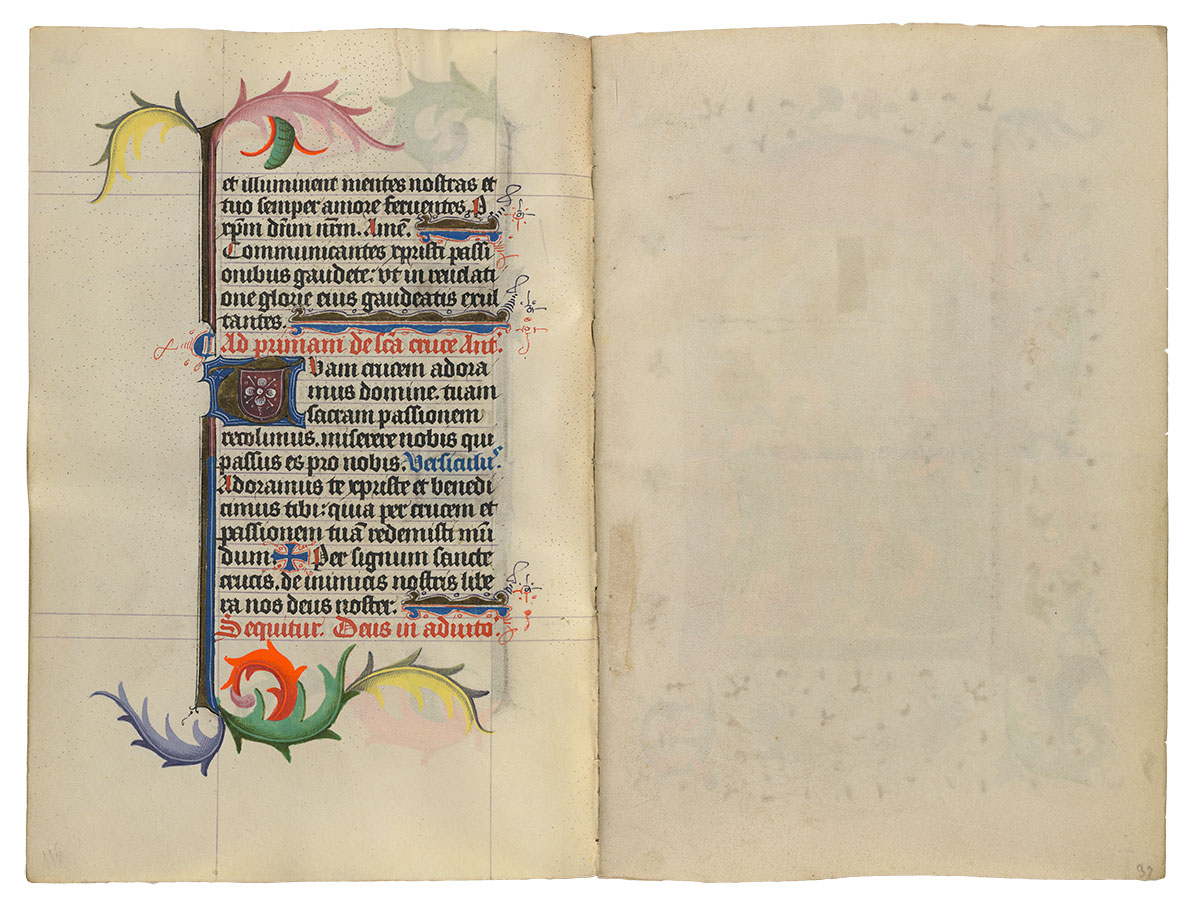
Purchased on the Belle da Costa Greene Fund with the assistance of the Fellows, 1963; purchased on the Belle da Costa Greene Fund with the assistance of the Fellows and with special assistance of Mrs. Frederick B. Adams, Sr., Mrs. Robert Charles, Mr. Laurens M. Hamilton, The Heineman Foundation, Mrs. Donald F. Hyde, Mrs. Jacob M. Kaplan, Mrs. John Kean, Mr. Paul Mellon, Mr. and Mrs. Charles F. Morgan, Mr. Lessing J. Rosenwald, Mr. and Mrs. August H. Schilling, Mrs. Herbert N. Straus, Mrs. Landon K. Thorne, Mrs. Alan Valentine, Mr. and Mrs. Arnold Whitridge, and Miss Julia P. Wightman, 1970
Image courtesy of Faksimile Verlag Luzern
MS M.917/945, p. 38–f. 58r
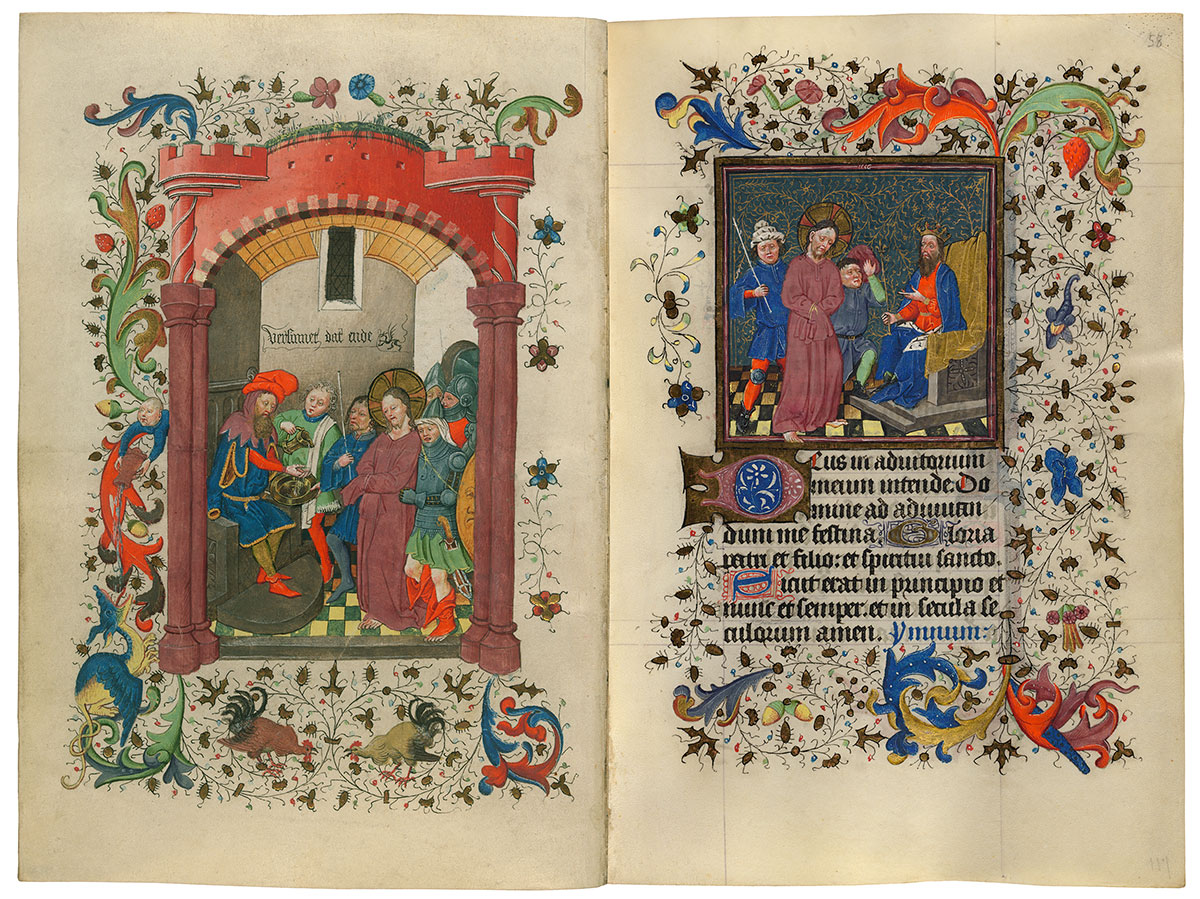
Christ before Pilate
Christ before Herod
Purchased on the Belle da Costa Greene Fund with the assistance of the Fellows, 1963; purchased on the Belle da Costa Greene Fund with the assistance of the Fellows and with special assistance of Mrs. Frederick B. Adams, Sr., Mrs. Robert Charles, Mr. Laurens M. Hamilton, The Heineman Foundation, Mrs. Donald F. Hyde, Mrs. Jacob M. Kaplan, Mrs. John Kean, Mr. Paul Mellon, Mr. and Mrs. Charles F. Morgan, Mr. Lessing J. Rosenwald, Mr. and Mrs. August H. Schilling, Mrs. Herbert N. Straus, Mrs. Landon K. Thorne, Mrs. Alan Valentine, Mr. and Mrs. Arnold Whitridge, and Miss Julia P. Wightman, 1970
Hours of the Passion
The Hours of the Passion are often found in Books of Hours following, as in Catherine's manuscript, the Hours of the Virgin. The lengthy psalms are supplemented with prayers that narrate the story of Christ's Passion. If Catherine had little time, she might pray Matins alone, where the three lessons encapsulate the entire Passion, from Christ's Arrest until his Death on the Cross. A slower meditation is provided by the remaining Hours. The drama begins at Vespers, whose prayer narrates events from Holy Thursday: the Last Super and Christ Washing the Feet of the Apostles. Compline's prayer relates Christ's Agony in the Garden. The prayer at Lauds relates to Christ Before Pilate and Peter's Denial. The Passion concludes with None's prayer telling of Christ's Death on the Cross.
Image courtesy of Faksimile Verlag Luzern
MS M.917/945, ff. 58v–59r
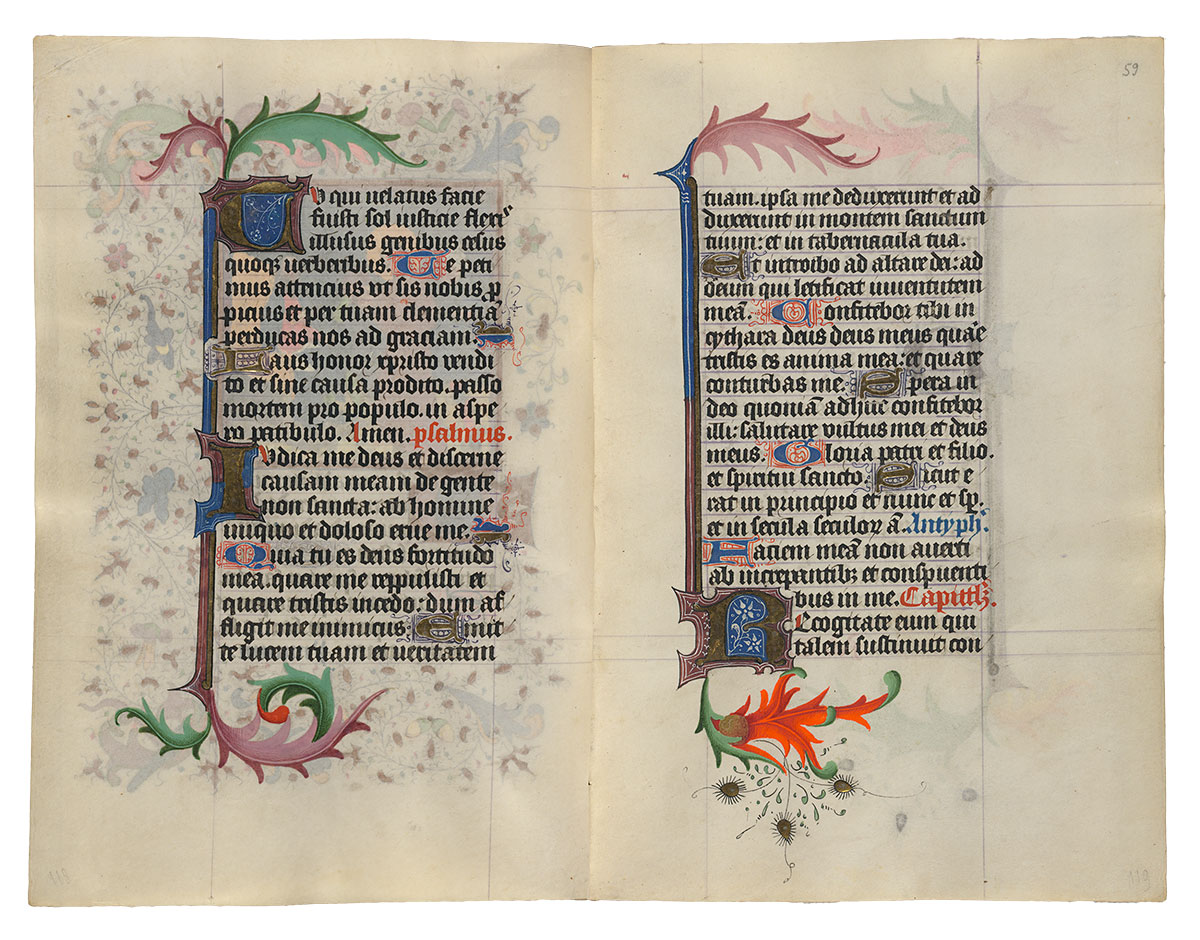
Purchased on the Belle da Costa Greene Fund with the assistance of the Fellows and with special assistance of Mrs. Frederick B. Adams, Sr., Mrs. Robert Charles, Mr. Laurens M. Hamilton, The Heineman Foundation, Mrs. Donald F. Hyde, Mrs. Jacob M. Kaplan, Mrs. John Kean, Mr. Paul Mellon, Mr. and Mrs. Charles F. Morgan, Mr. Lessing J. Rosenwald, Mr. and Mrs. August H. Schilling, Mrs. Herbert N. Straus, Mrs. Landon K. Thorne, Mrs. Alan Valentine, Mr. and Mrs. Arnold Whitridge, and Miss Julia P. Wightman, 1970
Image courtesy of Faksimile Verlag Luzern
MS M.917/945, ff. 59v–60r
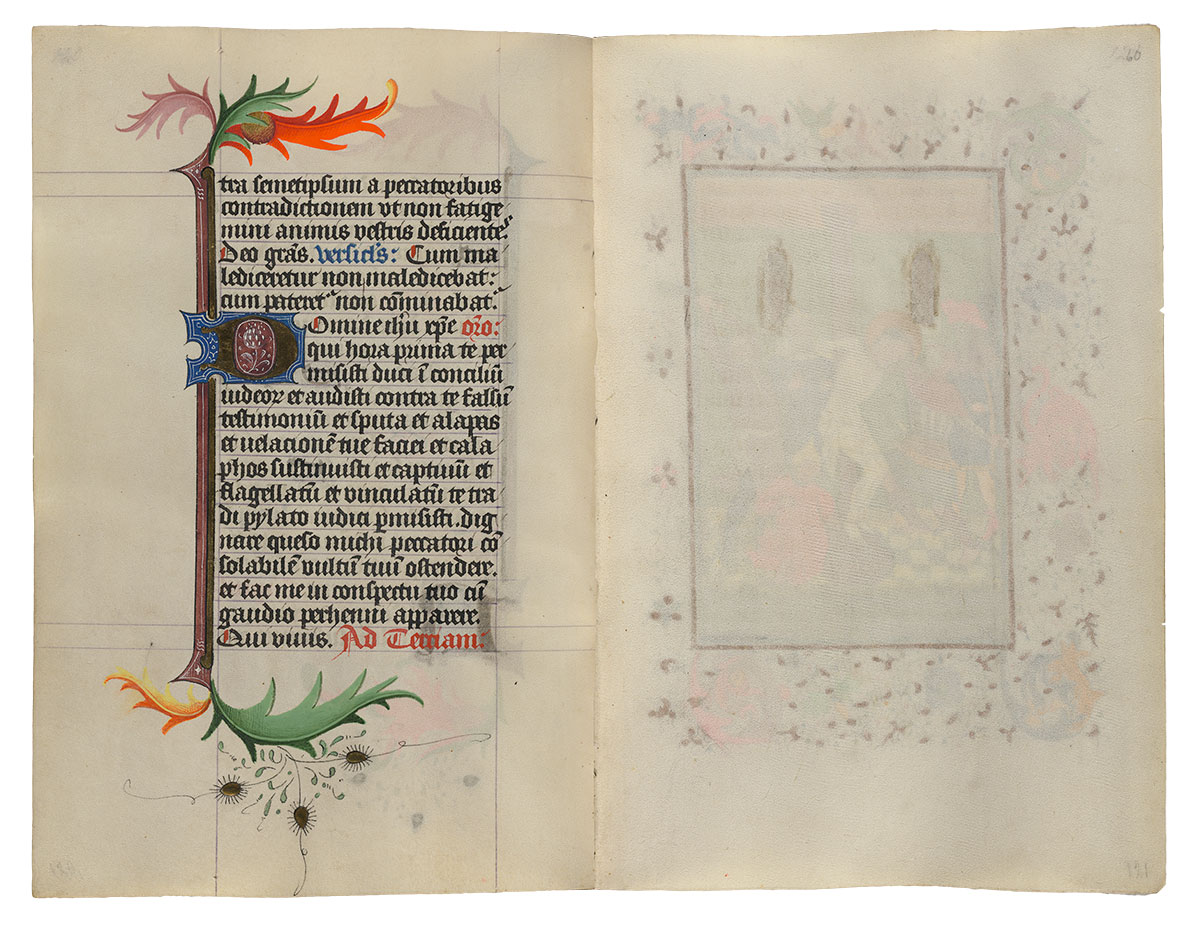
Purchased on the Belle da Costa Greene Fund with the assistance of the Fellows and with special assistance of Mrs. Frederick B. Adams, Sr., Mrs. Robert Charles, Mr. Laurens M. Hamilton, The Heineman Foundation, Mrs. Donald F. Hyde, Mrs. Jacob M. Kaplan, Mrs. John Kean, Mr. Paul Mellon, Mr. and Mrs. Charles F. Morgan, Mr. Lessing J. Rosenwald, Mr. and Mrs. August H. Schilling, Mrs. Herbert N. Straus, Mrs. Landon K. Thorne, Mrs. Alan Valentine, Mr. and Mrs. Arnold Whitridge, and Miss Julia P. Wightman, 1970
Image courtesy of Faksimile Verlag Luzern
MS M.917/945, ff. 60v–61r
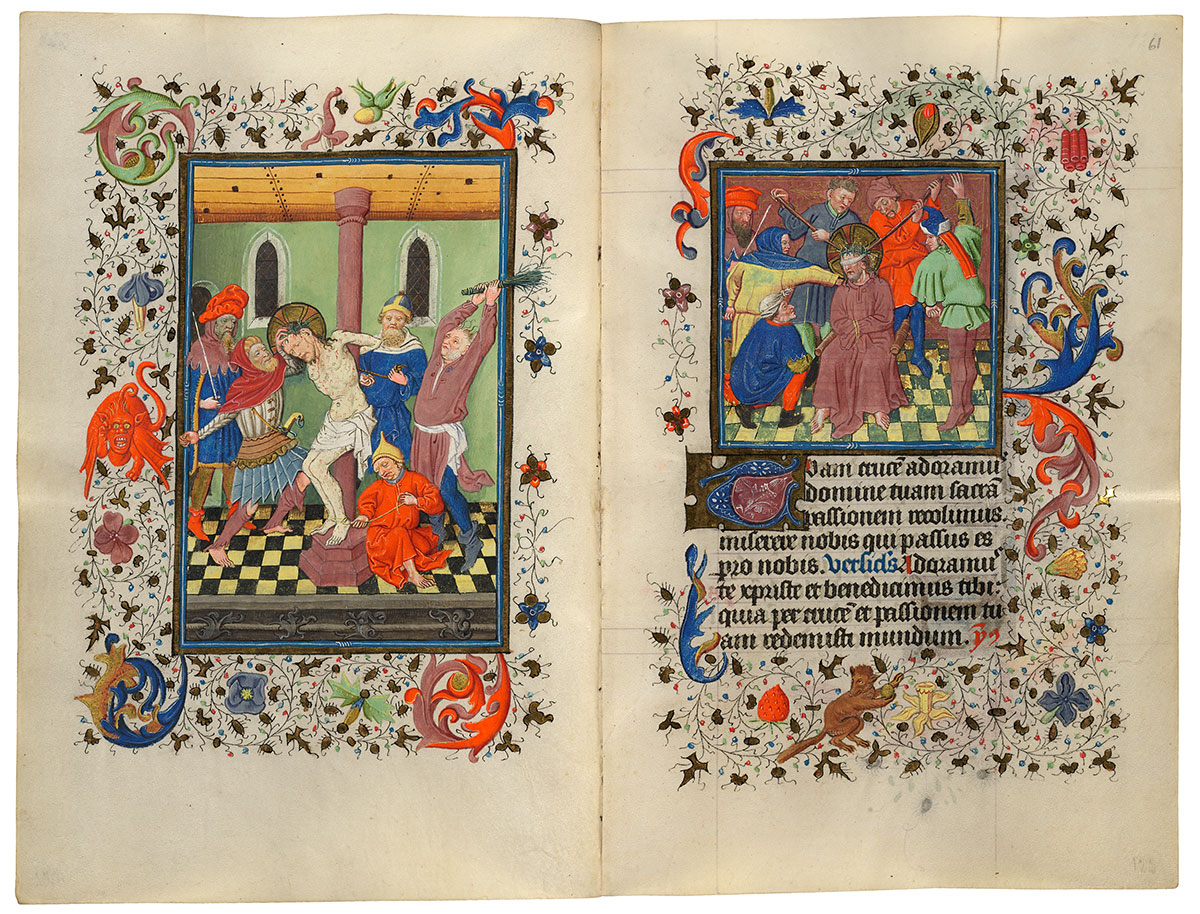
Flagellation of Christ
Christ Crowned with Thorns
Purchased on the Belle da Costa Greene Fund with the assistance of the Fellows and with special assistance of Mrs. Frederick B. Adams, Sr., Mrs. Robert Charles, Mr. Laurens M. Hamilton, The Heineman Foundation, Mrs. Donald F. Hyde, Mrs. Jacob M. Kaplan, Mrs. John Kean, Mr. Paul Mellon, Mr. and Mrs. Charles F. Morgan, Mr. Lessing J. Rosenwald, Mr. and Mrs. August H. Schilling, Mrs. Herbert N. Straus, Mrs. Landon K. Thorne, Mrs. Alan Valentine, Mr. and Mrs. Arnold Whitridge, and Miss Julia P. Wightman, 1970
At the left, Pilate, decadently dressed in a tall bag hat worn over a dagged chaperon, directs Christ's torment, the scepter of authority in his right hand. The frail Christ is tied to a column by two men in exotically pointed hats, while two others energetically punch or flagellate the Savior's bleeding body. The unusual reddish color of the column and its base might refer to Christ's blood. In the smaller miniature, Pilate, again at the left, directs the crowning of Christ with thorns. While others continue to strike the blindfolded Savior, two men apply the tortuous crown with long staves.
Hours of the Passion
The Hours of the Passion are often found in Books of Hours following, as in Catherine's manuscript, the Hours of the Virgin. The lengthy psalms are supplemented with prayers that narrate the story of Christ's Passion. If Catherine had little time, she might pray Matins alone, where the three lessons encapsulate the entire Passion, from Christ's Arrest until his Death on the Cross. A slower meditation is provided by the remaining Hours. The drama begins at Vespers, whose prayer narrates events from Holy Thursday: the Last Super and Christ Washing the Feet of the Apostles. Compline's prayer relates Christ's Agony in the Garden. The prayer at Lauds relates to Christ Before Pilate and Peter's Denial. The Passion concludes with None's prayer telling of Christ's Death on the Cross.
Image courtesy of Faksimile Verlag Luzern
MS M.917/945, ff. 61v–62r
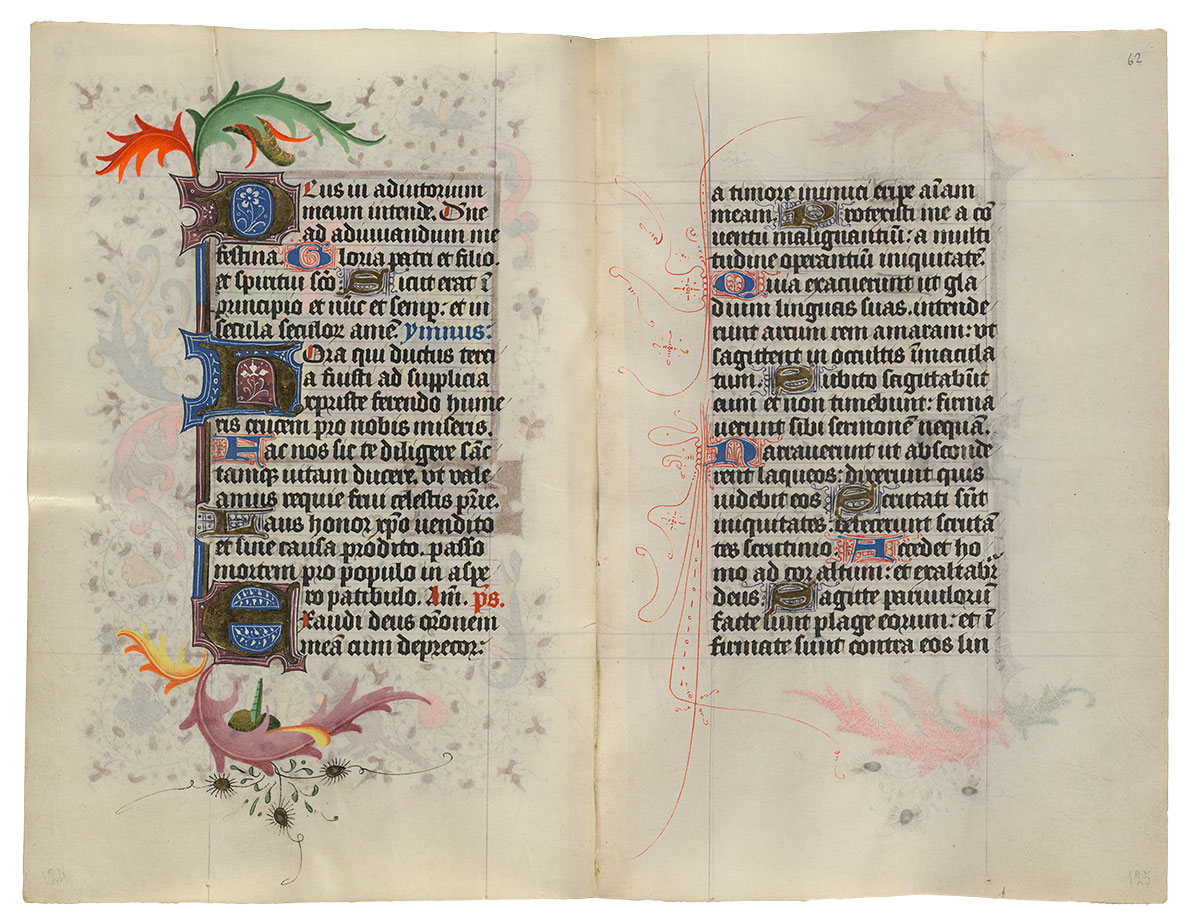
Purchased on the Belle da Costa Greene Fund with the assistance of the Fellows and with special assistance of Mrs. Frederick B. Adams, Sr., Mrs. Robert Charles, Mr. Laurens M. Hamilton, The Heineman Foundation, Mrs. Donald F. Hyde, Mrs. Jacob M. Kaplan, Mrs. John Kean, Mr. Paul Mellon, Mr. and Mrs. Charles F. Morgan, Mr. Lessing J. Rosenwald, Mr. and Mrs. August H. Schilling, Mrs. Herbert N. Straus, Mrs. Landon K. Thorne, Mrs. Alan Valentine, Mr. and Mrs. Arnold Whitridge, and Miss Julia P. Wightman, 1970
Image courtesy of Faksimile Verlag Luzern
MS M.917/945, ff. 62v–63r
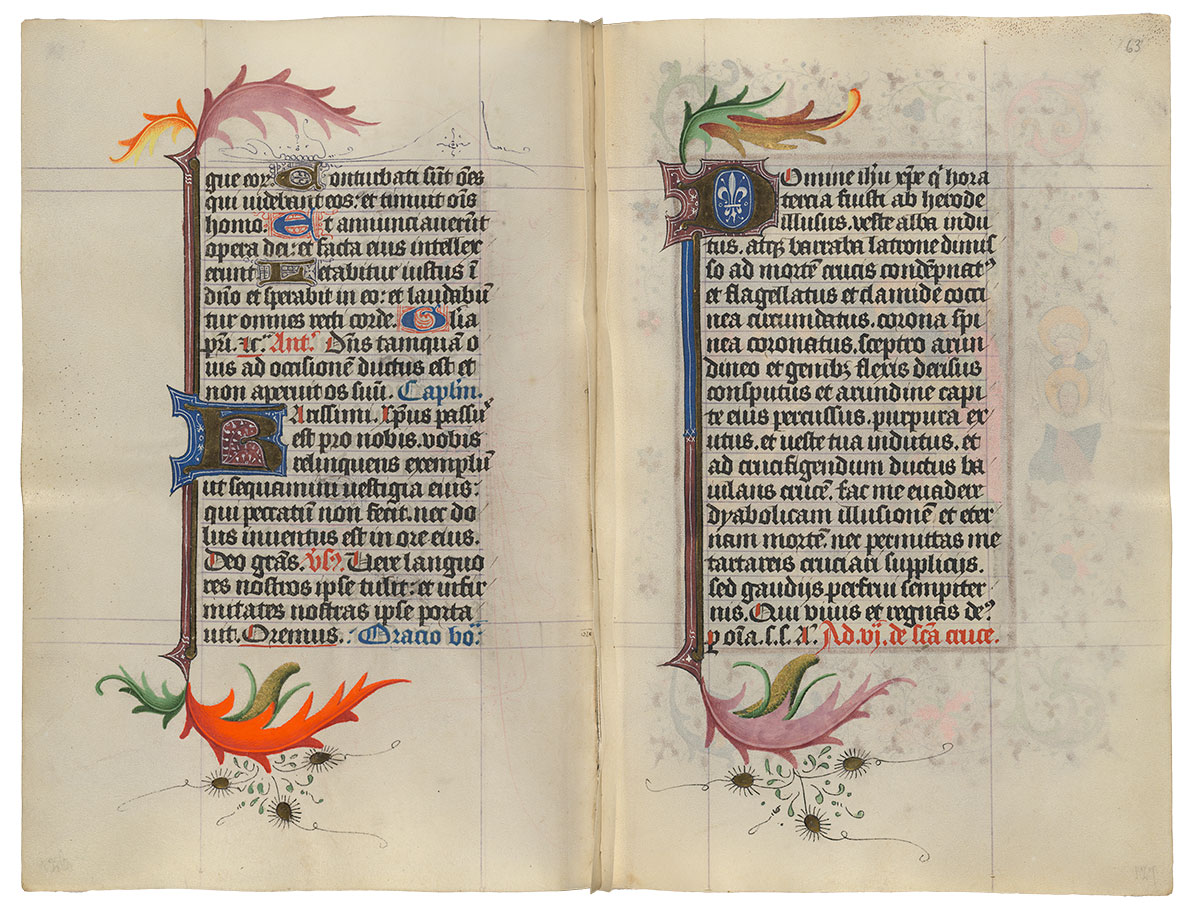
Purchased on the Belle da Costa Greene Fund with the assistance of the Fellows and with special assistance of Mrs. Frederick B. Adams, Sr., Mrs. Robert Charles, Mr. Laurens M. Hamilton, The Heineman Foundation, Mrs. Donald F. Hyde, Mrs. Jacob M. Kaplan, Mrs. John Kean, Mr. Paul Mellon, Mr. and Mrs. Charles F. Morgan, Mr. Lessing J. Rosenwald, Mr. and Mrs. August H. Schilling, Mrs. Herbert N. Straus, Mrs. Landon K. Thorne, Mrs. Alan Valentine, Mr. and Mrs. Arnold Whitridge, and Miss Julia P. Wightman, 1970
Image courtesy of Faksimile Verlag Luzern
MS M.917/945, ff. 63v–64r
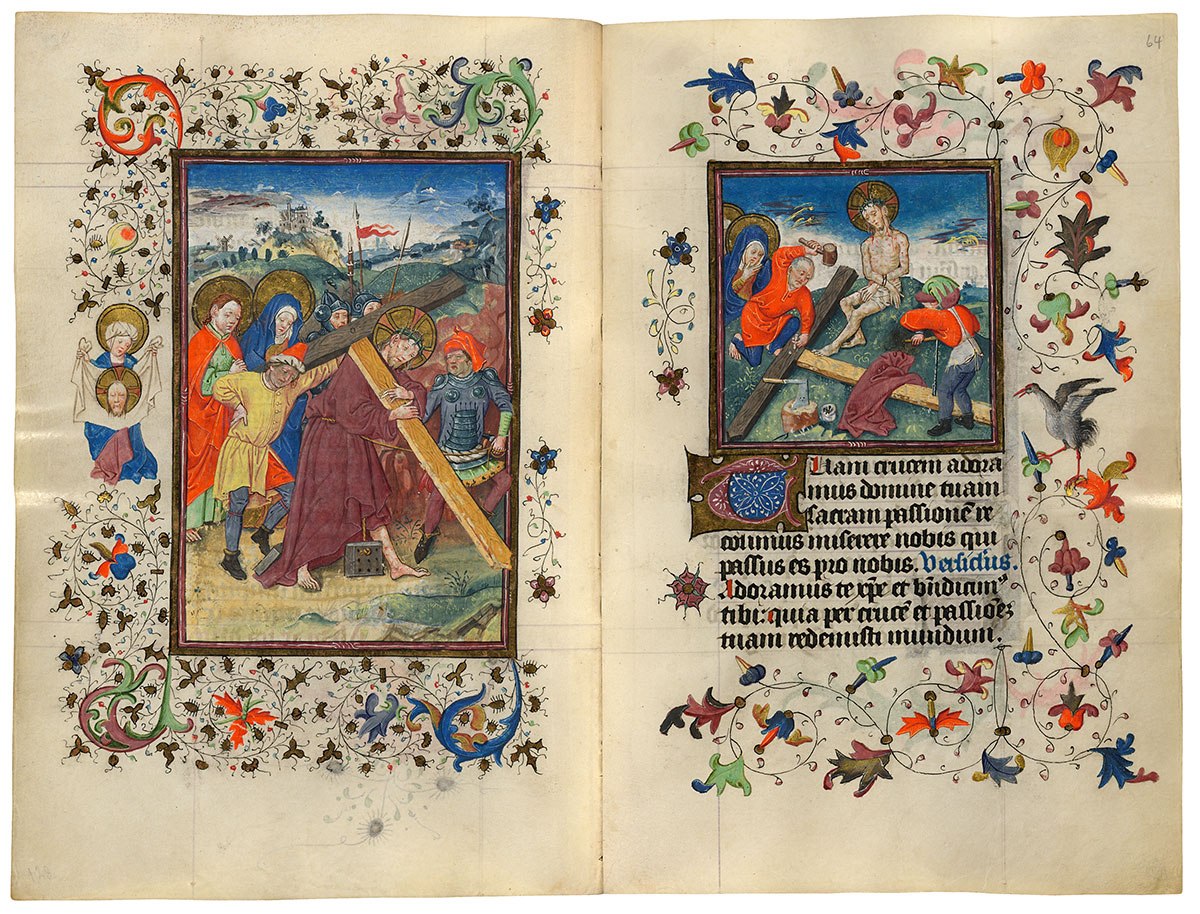
Christ Carrying the Cross
Preparation of the Cross
Purchased on the Belle da Costa Greene Fund with the assistance of the Fellows and with special assistance of Mrs. Frederick B. Adams, Sr., Mrs. Robert Charles, Mr. Laurens M. Hamilton, The Heineman Foundation, Mrs. Donald F. Hyde, Mrs. Jacob M. Kaplan, Mrs. John Kean, Mr. Paul Mellon, Mr. and Mrs. Charles F. Morgan, Mr. Lessing J. Rosenwald, Mr. and Mrs. August H. Schilling, Mrs. Herbert N. Straus, Mrs. Landon K. Thorne, Mrs. Alan Valentine, Mr. and Mrs. Arnold Whitridge, and Miss Julia P. Wightman, 1970
With his pinched face and right hand supporting his back, Simon of Cyrene seems to offer only grudging assistance to Christ as he carries his Cross toward Calvary. Suspended from the Savior's waist on ropes are two spike blocks, nail-studded chunks of wood that applied special torture to his bare feet and ankles. Trailing the pair are Mary and St. John, stalwart witnesses to Christ's Passion. In the border, Veronica holds the sudarium, the cloth with which she wiped Christ's face and to which he miraculously imparted his image. In the unusual second miniature, Christ quietly observes the preparation of the Cross: its crossbeam is strengthened and a hole is drilled where his feet will be nailed. A grief-stricken Mary watches from behind the hillock.
Hours of the Passion
The Hours of the Passion are often found in Books of Hours following, as in Catherine's manuscript, the Hours of the Virgin. The lengthy psalms are supplemented with prayers that narrate the story of Christ's Passion. If Catherine had little time, she might pray Matins alone, where the three lessons encapsulate the entire Passion, from Christ's Arrest until his Death on the Cross. A slower meditation is provided by the remaining Hours. The drama begins at Vespers, whose prayer narrates events from Holy Thursday: the Last Super and Christ Washing the Feet of the Apostles. Compline's prayer relates Christ's Agony in the Garden. The prayer at Lauds relates to Christ Before Pilate and Peter's Denial. The Passion concludes with None's prayer telling of Christ's Death on the Cross.
Image courtesy of Faksimile Verlag Luzern
MS M.917/945, ff. 64v–65r
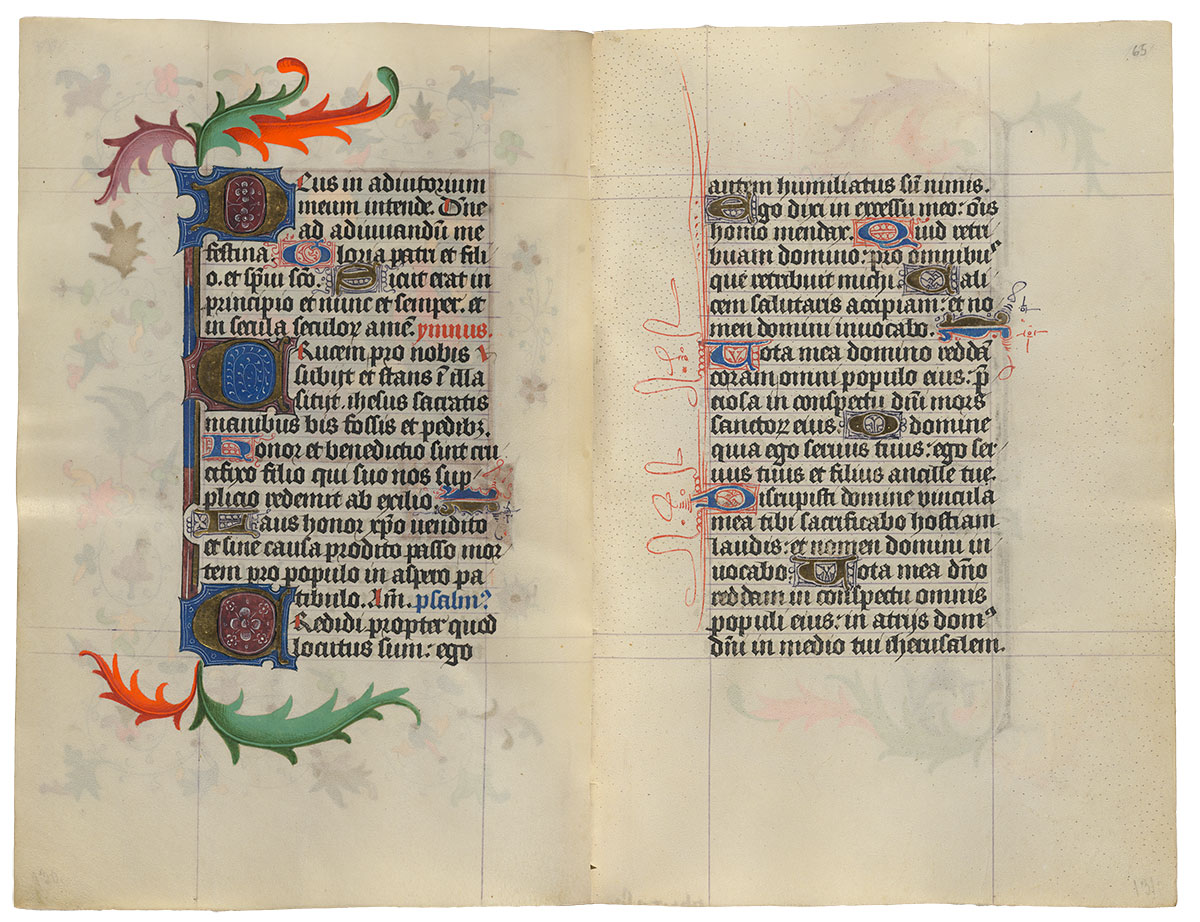
Purchased on the Belle da Costa Greene Fund with the assistance of the Fellows and with special assistance of Mrs. Frederick B. Adams, Sr., Mrs. Robert Charles, Mr. Laurens M. Hamilton, The Heineman Foundation, Mrs. Donald F. Hyde, Mrs. Jacob M. Kaplan, Mrs. John Kean, Mr. Paul Mellon, Mr. and Mrs. Charles F. Morgan, Mr. Lessing J. Rosenwald, Mr. and Mrs. August H. Schilling, Mrs. Herbert N. Straus, Mrs. Landon K. Thorne, Mrs. Alan Valentine, Mr. and Mrs. Arnold Whitridge, and Miss Julia P. Wightman, 1970
Image courtesy of Faksimile Verlag Luzern
MS M.917/945, ff. 65v–66r
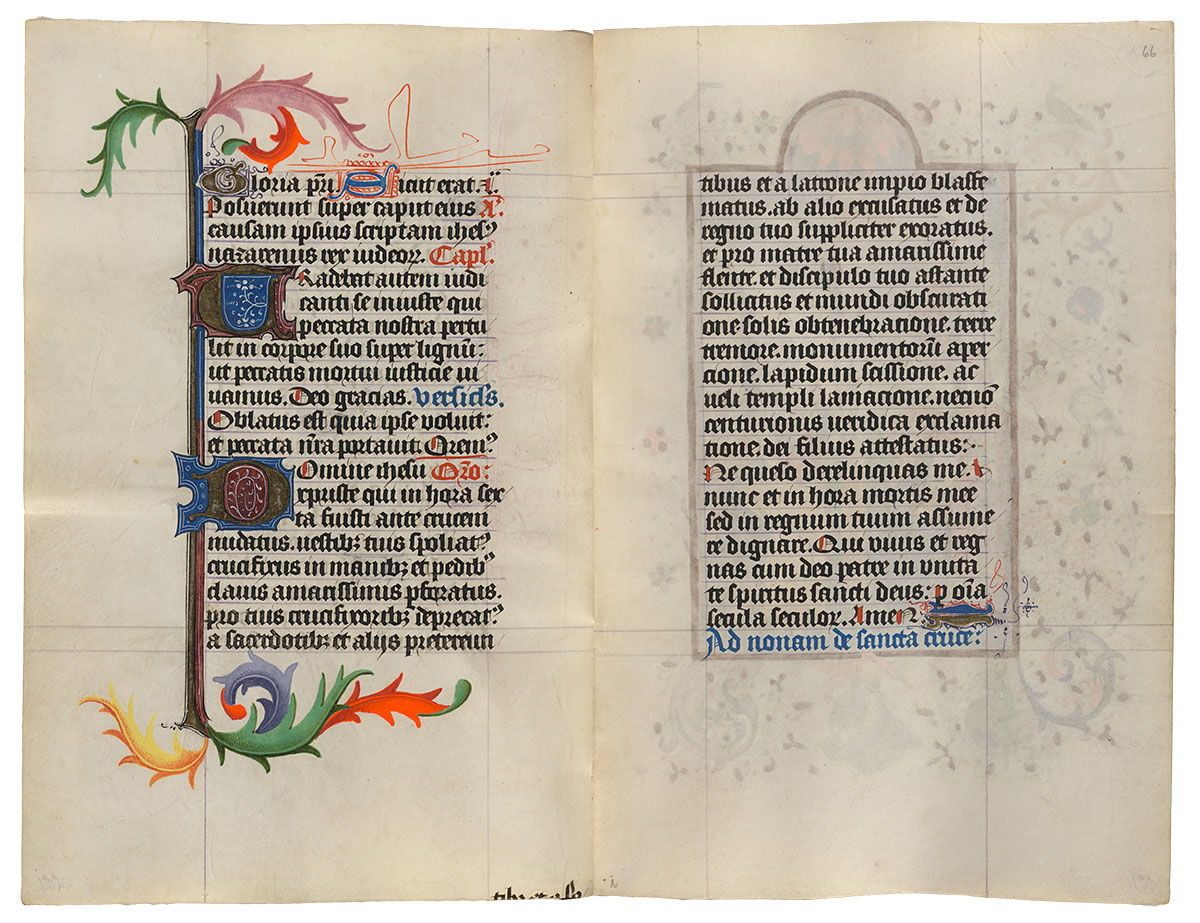
Purchased on the Belle da Costa Greene Fund with the assistance of the Fellows and with special assistance of Mrs. Frederick B. Adams, Sr., Mrs. Robert Charles, Mr. Laurens M. Hamilton, The Heineman Foundation, Mrs. Donald F. Hyde, Mrs. Jacob M. Kaplan, Mrs. John Kean, Mr. Paul Mellon, Mr. and Mrs. Charles F. Morgan, Mr. Lessing J. Rosenwald, Mr. and Mrs. August H. Schilling, Mrs. Herbert N. Straus, Mrs. Landon K. Thorne, Mrs. Alan Valentine, Mr. and Mrs. Arnold Whitridge, and Miss Julia P. Wightman, 1970
Image courtesy of Faksimile Verlag Luzern
MS M.917/945, ff. 66v–67r
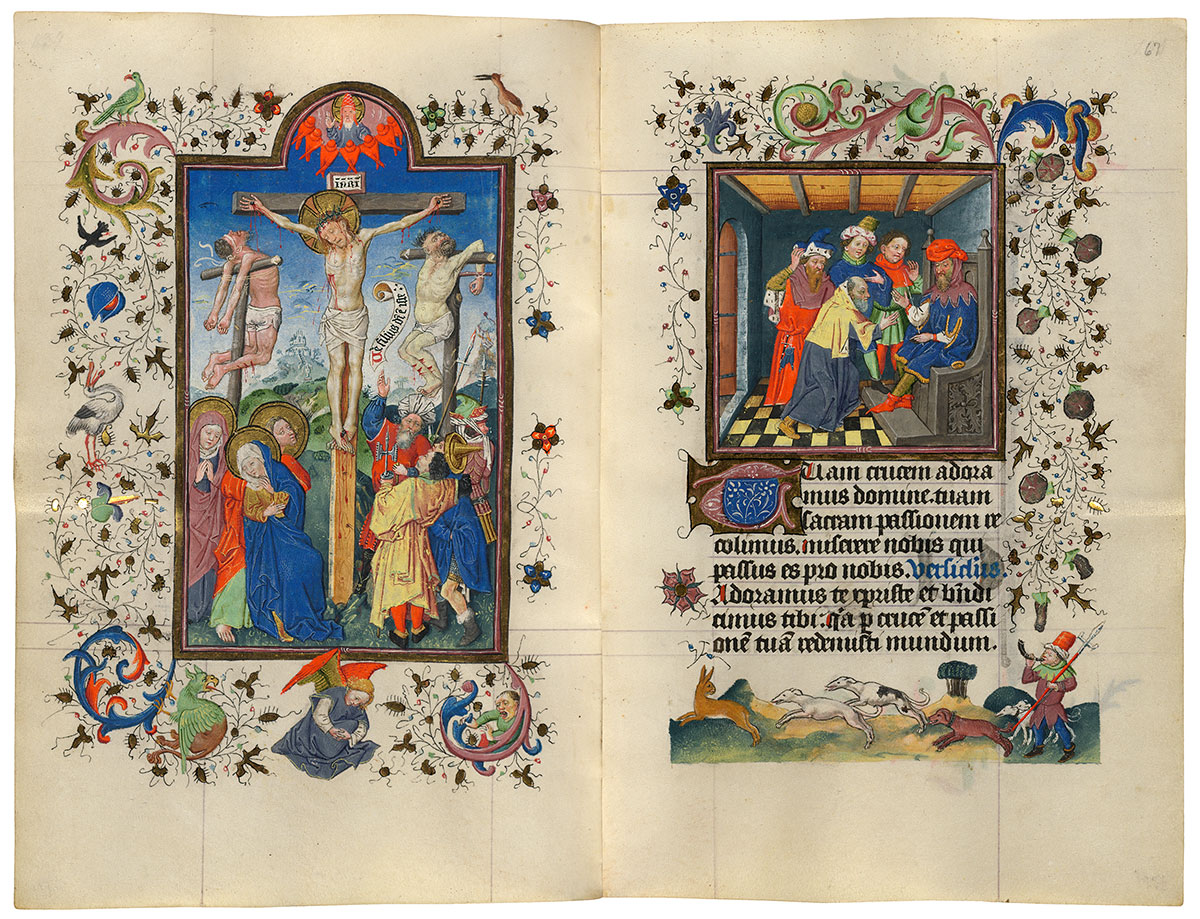
Crucifixion
Joseph of Arimathaea before Pilate
Purchased on the Belle da Costa Greene Fund with the assistance of the Fellows and with special assistance of Mrs. Frederick B. Adams, Sr., Mrs. Robert Charles, Mr. Laurens M. Hamilton, The Heineman Foundation, Mrs. Donald F. Hyde, Mrs. Jacob M. Kaplan, Mrs. John Kean, Mr. Paul Mellon, Mr. and Mrs. Charles F. Morgan, Mr. Lessing J. Rosenwald, Mr. and Mrs. August H. Schilling, Mrs. Herbert N. Straus, Mrs. Landon K. Thorne, Mrs. Alan Valentine, Mr. and Mrs. Arnold Whitridge, and Miss Julia P. Wightman, 1970
The old turbaned centurion points to the crucified Christ and declares that indeed he was the Son of God: V(er)e filius d(e)i e(st) iste is inscribed on his scroll. On Christ's right, salvific blood drips from the wound in his hand onto the body of the good thief; on Christ's left, the bad thief, who turns away, receives no purification. At the foot of the Cross, Mary faints into the arms of John while the Magdalene commiserates. In the small miniature, Joseph of Arimathaea and, behind him, Nicodemus humbly ask Pilate for the body of the dead Savior. In the bottom border, a patently secular chase of rabbits by hounds is, nevertheless, an analogy for the Passion.
Hours of the Passion
The Hours of the Passion are often found in Books of Hours following, as in Catherine's manuscript, the Hours of the Virgin. The lengthy psalms are supplemented with prayers that narrate the story of Christ's Passion. If Catherine had little time, she might pray Matins alone, where the three lessons encapsulate the entire Passion, from Christ's Arrest until his Death on the Cross. A slower meditation is provided by the remaining Hours. The drama begins at Vespers, whose prayer narrates events from Holy Thursday: the Last Super and Christ Washing the Feet of the Apostles. Compline's prayer relates Christ's Agony in the Garden. The prayer at Lauds relates to Christ Before Pilate and Peter's Denial. The Passion concludes with None's prayer telling of Christ's Death on the Cross.
Image courtesy of Faksimile Verlag Luzern
MS M.917/945, ff. 67v–68r
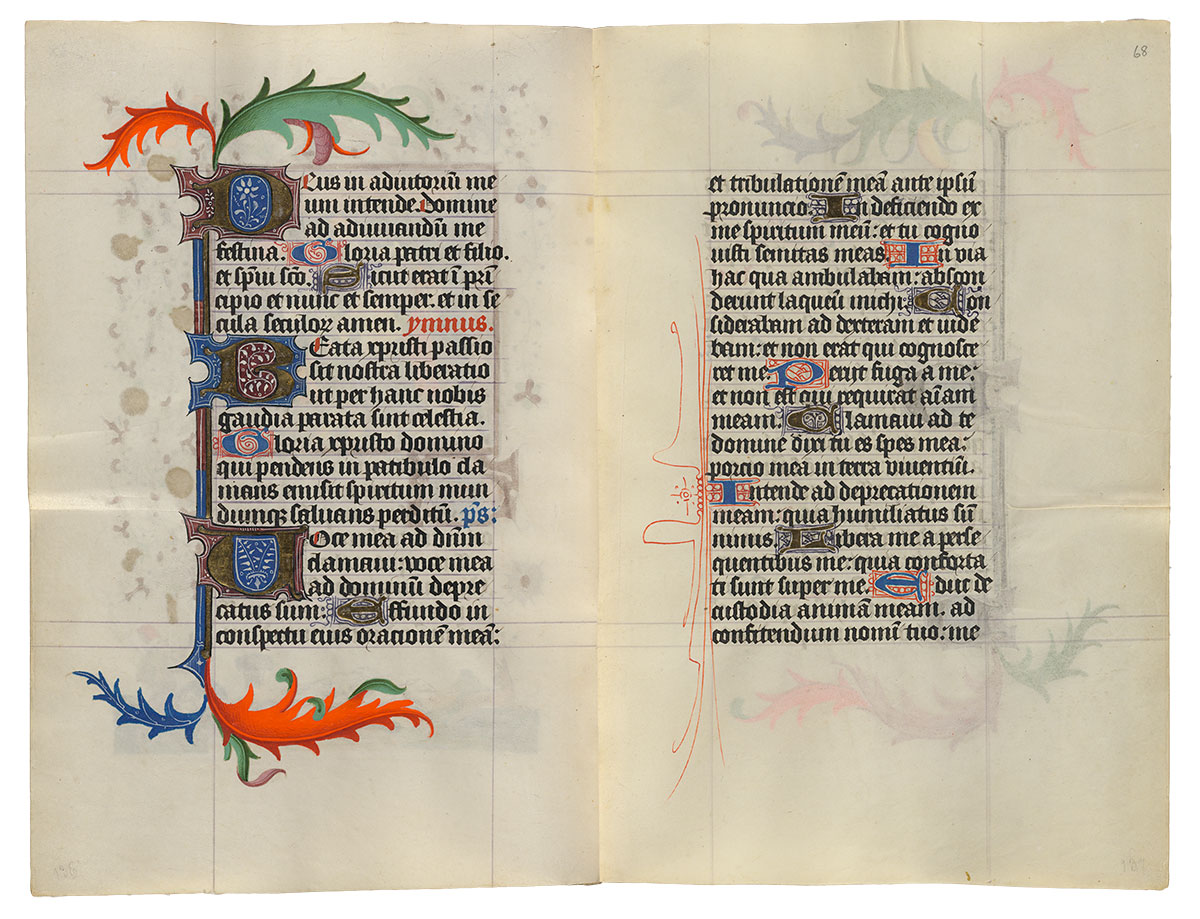
Purchased on the Belle da Costa Greene Fund with the assistance of the Fellows and with special assistance of Mrs. Frederick B. Adams, Sr., Mrs. Robert Charles, Mr. Laurens M. Hamilton, The Heineman Foundation, Mrs. Donald F. Hyde, Mrs. Jacob M. Kaplan, Mrs. John Kean, Mr. Paul Mellon, Mr. and Mrs. Charles F. Morgan, Mr. Lessing J. Rosenwald, Mr. and Mrs. August H. Schilling, Mrs. Herbert N. Straus, Mrs. Landon K. Thorne, Mrs. Alan Valentine, Mr. and Mrs. Arnold Whitridge, and Miss Julia P. Wightman, 1970
Image courtesy of Faksimile Verlag Luzern
MS M.917/945, ff. 68v–69r
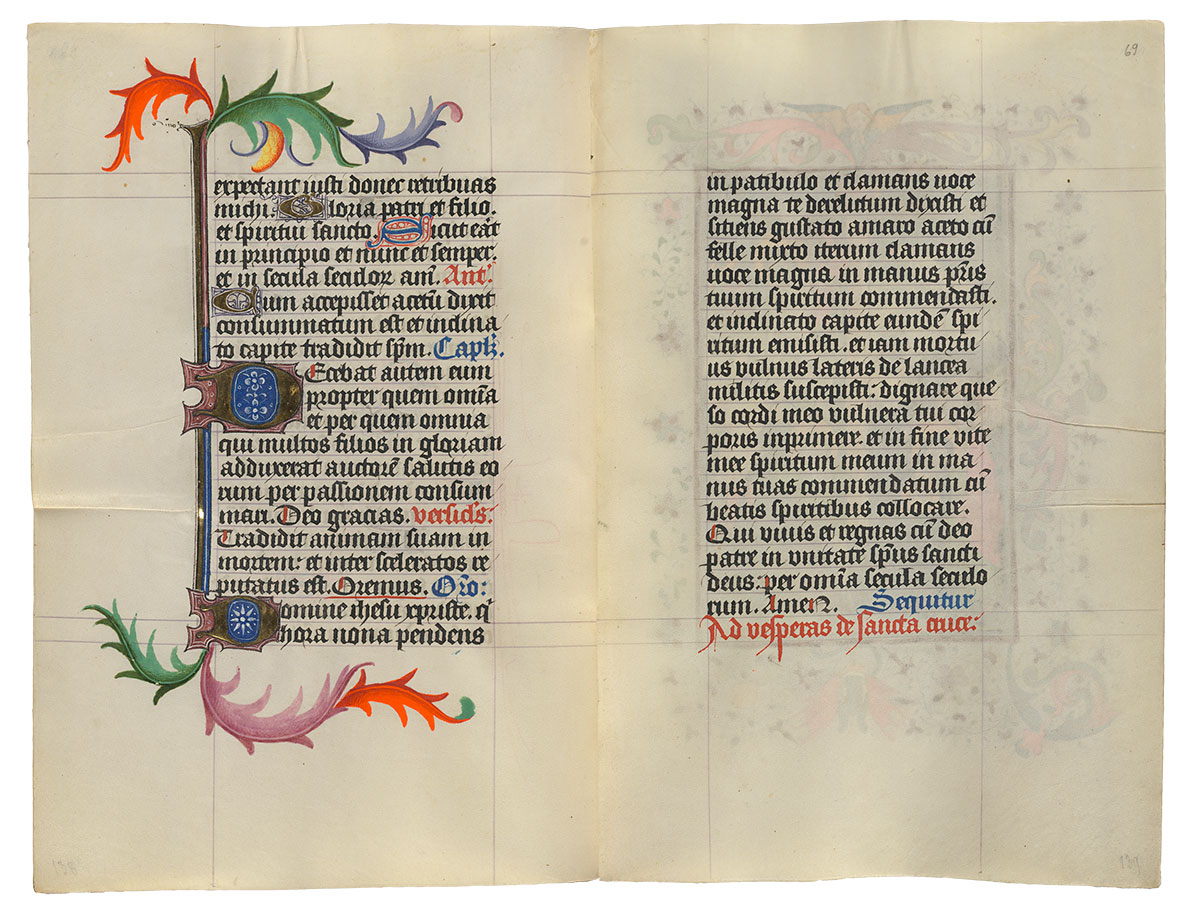
Purchased on the Belle da Costa Greene Fund with the assistance of the Fellows and with special assistance of Mrs. Frederick B. Adams, Sr., Mrs. Robert Charles, Mr. Laurens M. Hamilton, The Heineman Foundation, Mrs. Donald F. Hyde, Mrs. Jacob M. Kaplan, Mrs. John Kean, Mr. Paul Mellon, Mr. and Mrs. Charles F. Morgan, Mr. Lessing J. Rosenwald, Mr. and Mrs. August H. Schilling, Mrs. Herbert N. Straus, Mrs. Landon K. Thorne, Mrs. Alan Valentine, Mr. and Mrs. Arnold Whitridge, and Miss Julia P. Wightman, 1970
Image courtesy of Faksimile Verlag Luzern
MS M.917/945, ff. 69v–70r
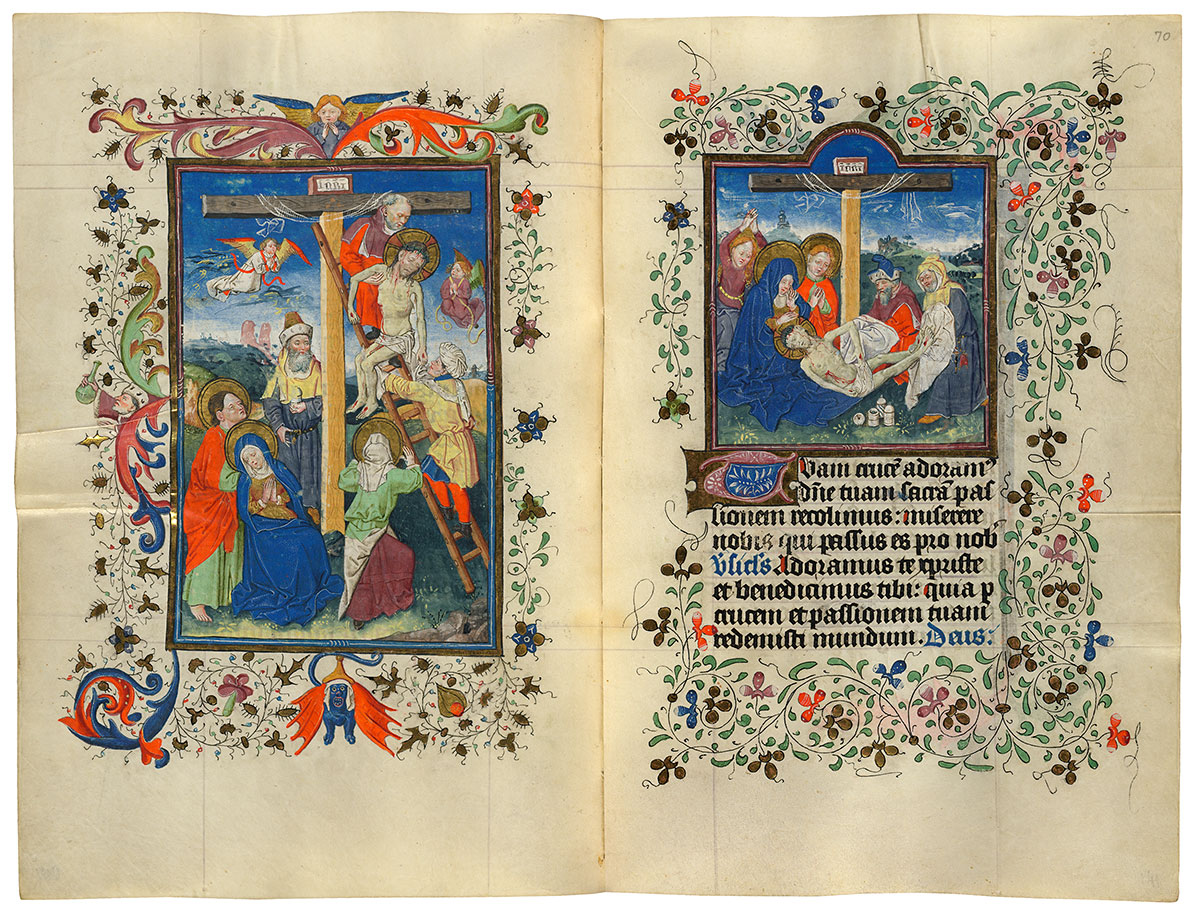
Deposition
Lamentation
Purchased on the Belle da Costa Greene Fund with the assistance of the Fellows and with special assistance of Mrs. Frederick B. Adams, Sr., Mrs. Robert Charles, Mr. Laurens M. Hamilton, The Heineman Foundation, Mrs. Donald F. Hyde, Mrs. Jacob M. Kaplan, Mrs. John Kean, Mr. Paul Mellon, Mr. and Mrs. Charles F. Morgan, Mr. Lessing J. Rosenwald, Mr. and Mrs. August H. Schilling, Mrs. Herbert N. Straus, Mrs. Landon K. Thorne, Mrs. Alan Valentine, Mr. and Mrs. Arnold Whitridge, and Miss Julia P. Wightman, 1970
While Joseph of Arimathaea, holding a jar of ointment, looks on, Nicodemus, at the top of the ladder, hands the body of the dead Savior to a younger man. Mary Magdalene, her back to us, raises her hands in distress; the Virgin swoons into John's arms. In the Lamentation, Joseph of Arimathaea and Nicodemus reverently anoint Christ's feet and arms with cloth-covered hands; the Virgin supports the upper half of the Savior's body in her lap. Mary Magdalene raises her hands in anguish while John prays.
Hours of the Passion
The Hours of the Passion are often found in Books of Hours following, as in Catherine's manuscript, the Hours of the Virgin. The lengthy psalms are supplemented with prayers that narrate the story of Christ's Passion. If Catherine had little time, she might pray Matins alone, where the three lessons encapsulate the entire Passion, from Christ's Arrest until his Death on the Cross. A slower meditation is provided by the remaining Hours. The drama begins at Vespers, whose prayer narrates events from Holy Thursday: the Last Super and Christ Washing the Feet of the Apostles. Compline's prayer relates Christ's Agony in the Garden. The prayer at Lauds relates to Christ Before Pilate and Peter's Denial. The Passion concludes with None's prayer telling of Christ's Death on the Cross.
Image courtesy of Faksimile Verlag Luzern
MS M.917/945, ff. 70v–71r
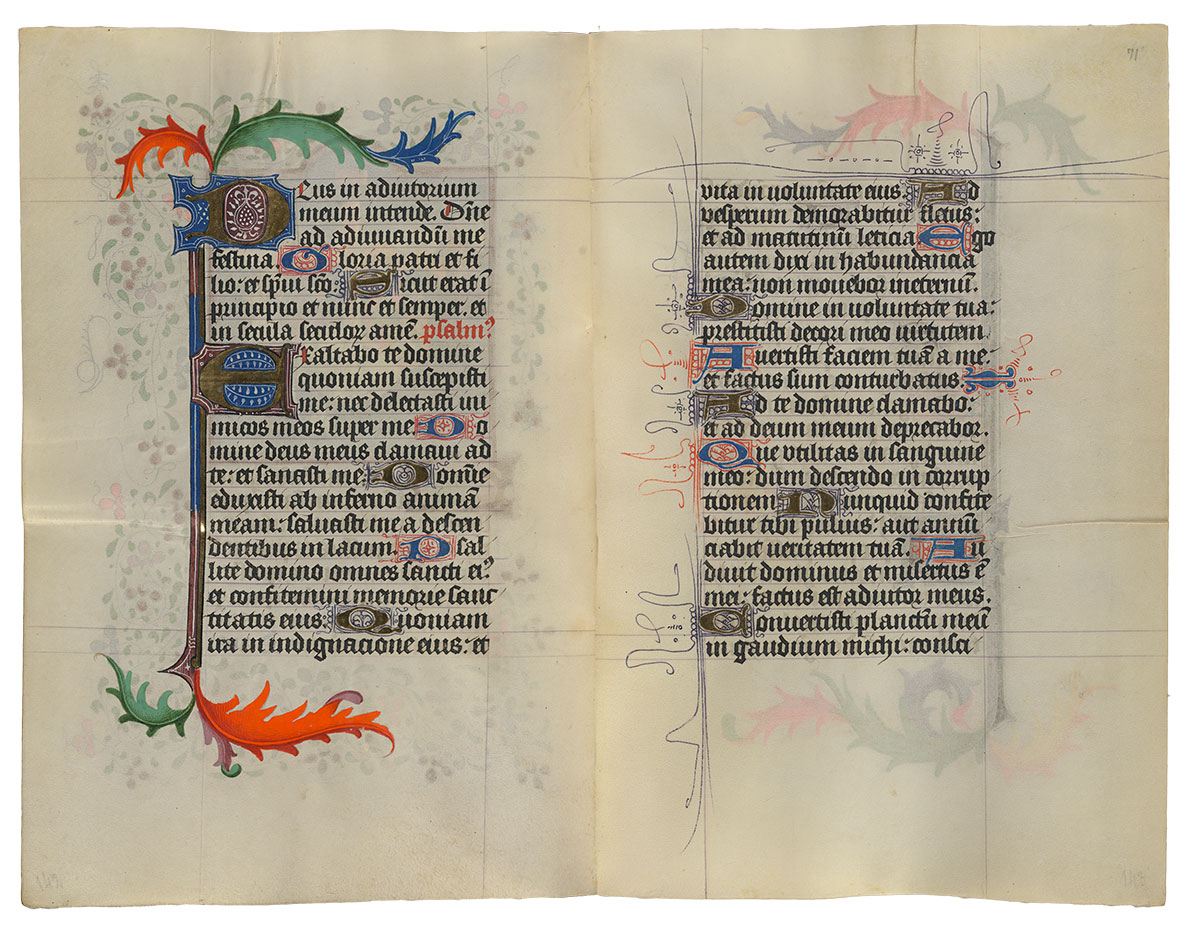
Purchased on the Belle da Costa Greene Fund with the assistance of the Fellows and with special assistance of Mrs. Frederick B. Adams, Sr., Mrs. Robert Charles, Mr. Laurens M. Hamilton, The Heineman Foundation, Mrs. Donald F. Hyde, Mrs. Jacob M. Kaplan, Mrs. John Kean, Mr. Paul Mellon, Mr. and Mrs. Charles F. Morgan, Mr. Lessing J. Rosenwald, Mr. and Mrs. August H. Schilling, Mrs. Herbert N. Straus, Mrs. Landon K. Thorne, Mrs. Alan Valentine, Mr. and Mrs. Arnold Whitridge, and Miss Julia P. Wightman, 1970
Image courtesy of Faksimile Verlag Luzern
MS M.917/945, ff. 71v–72r
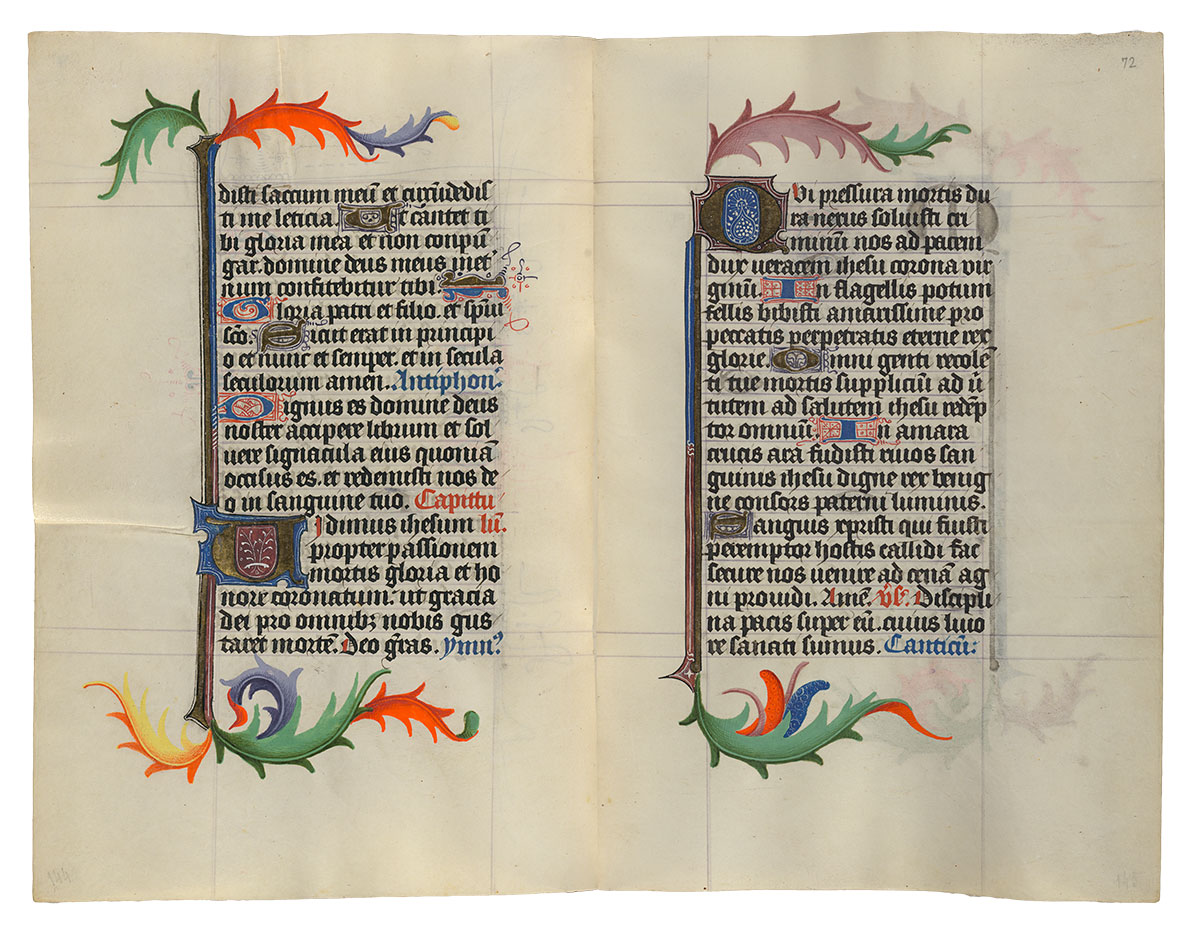
Purchased on the Belle da Costa Greene Fund with the assistance of the Fellows and with special assistance of Mrs. Frederick B. Adams, Sr., Mrs. Robert Charles, Mr. Laurens M. Hamilton, The Heineman Foundation, Mrs. Donald F. Hyde, Mrs. Jacob M. Kaplan, Mrs. John Kean, Mr. Paul Mellon, Mr. and Mrs. Charles F. Morgan, Mr. Lessing J. Rosenwald, Mr. and Mrs. August H. Schilling, Mrs. Herbert N. Straus, Mrs. Landon K. Thorne, Mrs. Alan Valentine, Mr. and Mrs. Arnold Whitridge, and Miss Julia P. Wightman, 1970
Image courtesy of Faksimile Verlag Luzern
MS M.917/945, ff. 72v–73r
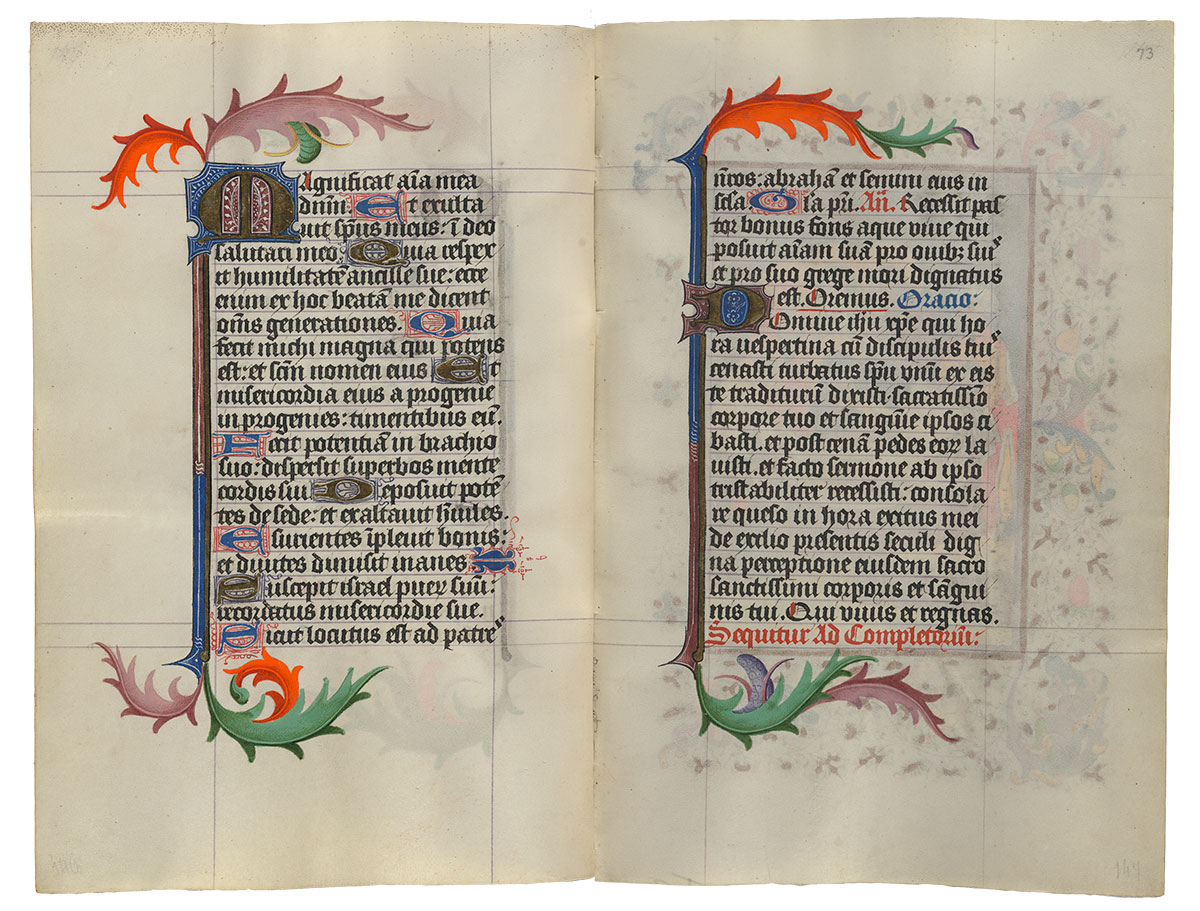
Purchased on the Belle da Costa Greene Fund with the assistance of the Fellows and with special assistance of Mrs. Frederick B. Adams, Sr., Mrs. Robert Charles, Mr. Laurens M. Hamilton, The Heineman Foundation, Mrs. Donald F. Hyde, Mrs. Jacob M. Kaplan, Mrs. John Kean, Mr. Paul Mellon, Mr. and Mrs. Charles F. Morgan, Mr. Lessing J. Rosenwald, Mr. and Mrs. August H. Schilling, Mrs. Herbert N. Straus, Mrs. Landon K. Thorne, Mrs. Alan Valentine, Mr. and Mrs. Arnold Whitridge, and Miss Julia P. Wightman, 1970
Image courtesy of Faksimile Verlag Luzern
MS M.917/945, ff. 73v–74r
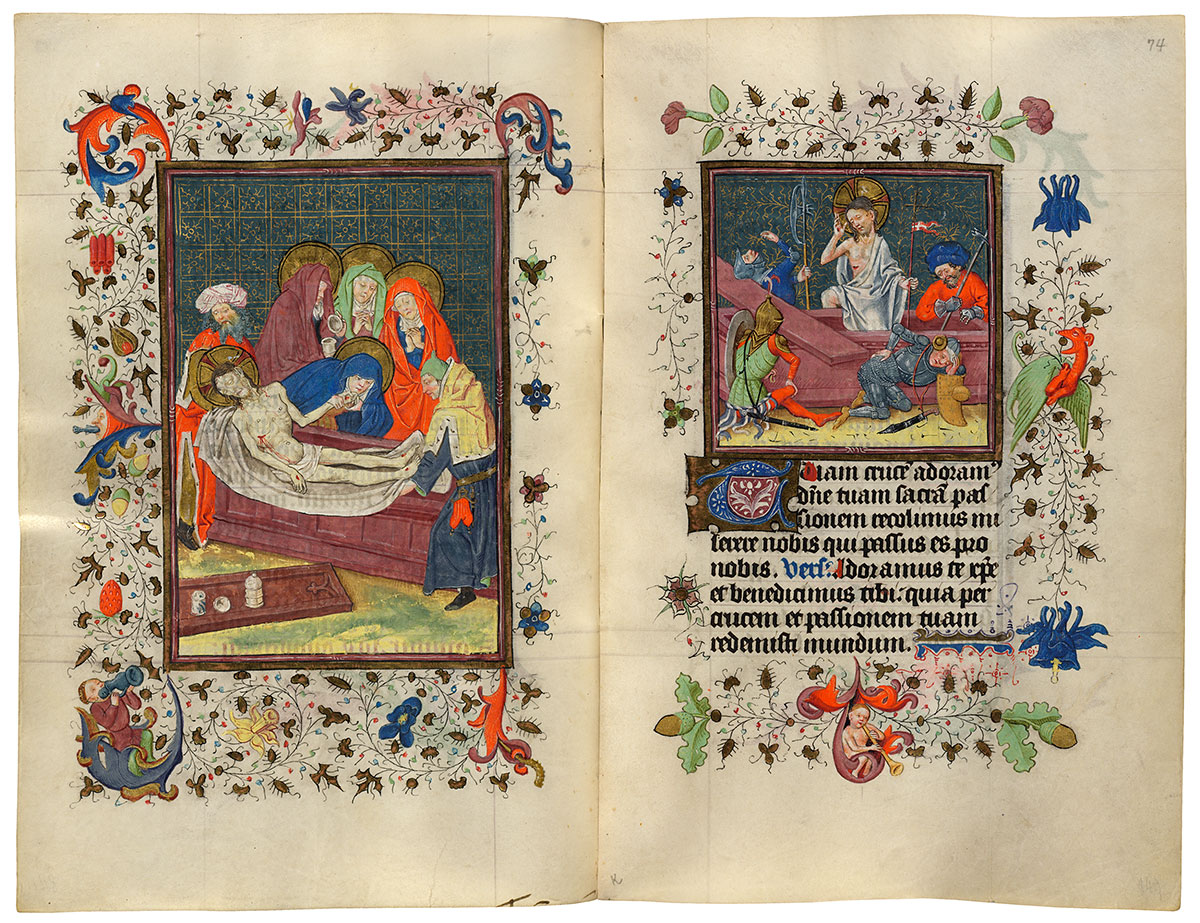
Entombment
Resurrection
Purchased on the Belle da Costa Greene Fund with the assistance of the Fellows and with special assistance of Mrs. Frederick B. Adams, Sr., Mrs. Robert Charles, Mr. Laurens M. Hamilton, The Heineman Foundation, Mrs. Donald F. Hyde, Mrs. Jacob M. Kaplan, Mrs. John Kean, Mr. Paul Mellon, Mr. and Mrs. Charles F. Morgan, Mr. Lessing J. Rosenwald, Mr. and Mrs. August H. Schilling, Mrs. Herbert N. Straus, Mrs. Landon K. Thorne, Mrs. Alan Valentine, Mr. and Mrs. Arnold Whitridge, and Miss Julia P. Wightman, 1970
The Hours of the Passion conclude with the Resurrection, a subject rarely included in such cycles since the event is not part of Christ's Passion. Typical of
his love of intricacy, the Master of Catherine of Cleves has Christ step out of his tomb backwards and arranges the four soldiers in complicated positions, none of which look conducive to sleep. In the bottom border, a boy blows a horn, an allusion to the sound of the trumpets that will herald Christ's Second Coming at the Last Judgment.
Hours of the Passion
The Hours of the Passion are often found in Books of Hours following, as in Catherine's manuscript, the Hours of the Virgin. The lengthy psalms are supplemented with prayers that narrate the story of Christ's Passion. If Catherine had little time, she might pray Matins alone, where the three lessons encapsulate the entire Passion, from Christ's Arrest until his Death on the Cross. A slower meditation is provided by the remaining Hours. The drama begins at Vespers, whose prayer narrates events from Holy Thursday: the Last Super and Christ Washing the Feet of the Apostles. Compline's prayer relates Christ's Agony in the Garden. The prayer at Lauds relates to Christ Before Pilate and Peter's Denial. The Passion concludes with None's prayer telling of Christ's Death on the Cross.
Image courtesy of Faksimile Verlag Luzern
MS M.917/945, ff. 74v–75r
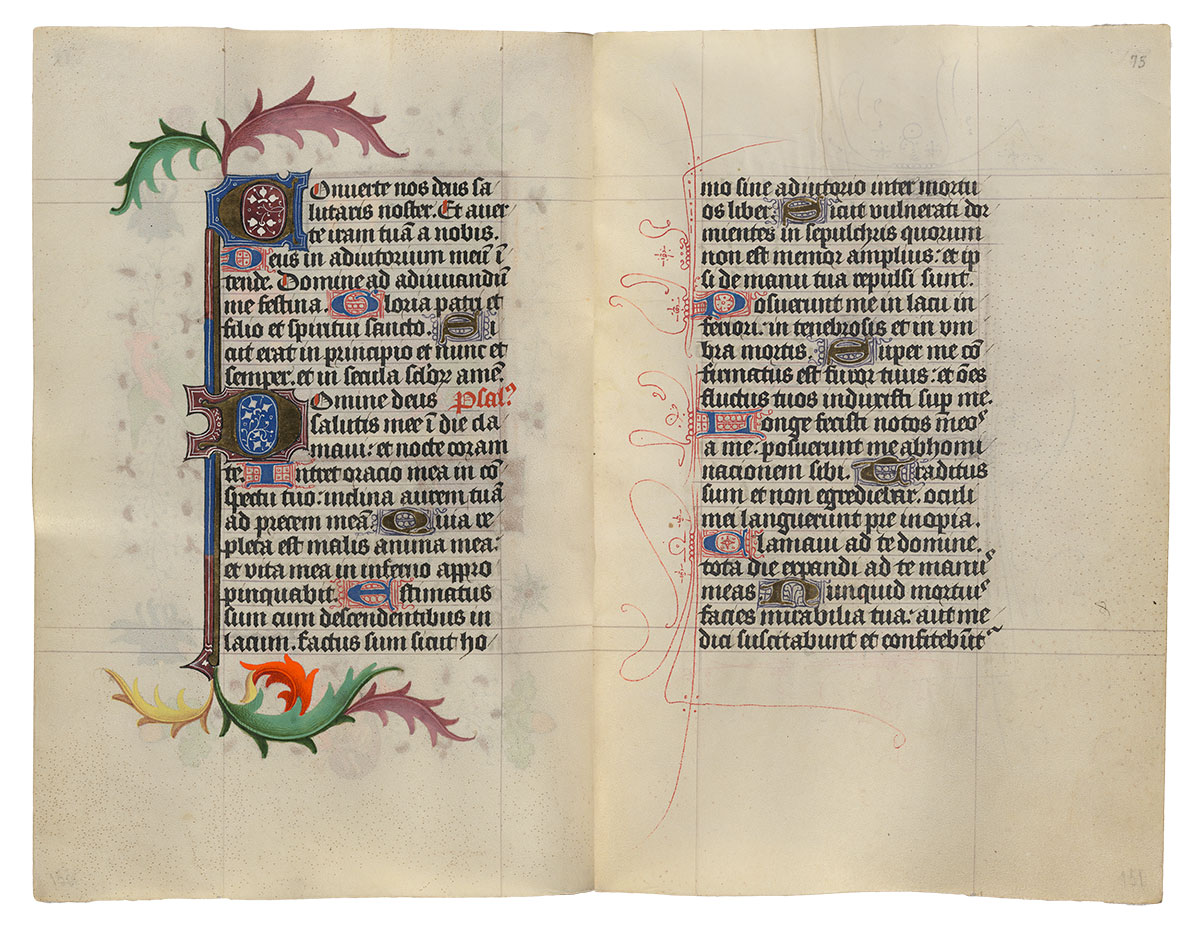
Purchased on the Belle da Costa Greene Fund with the assistance of the Fellows and with special assistance of Mrs. Frederick B. Adams, Sr., Mrs. Robert Charles, Mr. Laurens M. Hamilton, The Heineman Foundation, Mrs. Donald F. Hyde, Mrs. Jacob M. Kaplan, Mrs. John Kean, Mr. Paul Mellon, Mr. and Mrs. Charles F. Morgan, Mr. Lessing J. Rosenwald, Mr. and Mrs. August H. Schilling, Mrs. Herbert N. Straus, Mrs. Landon K. Thorne, Mrs. Alan Valentine, Mr. and Mrs. Arnold Whitridge, and Miss Julia P. Wightman, 1970
Image courtesy of Faksimile Verlag Luzern
MS M.917/945, ff. 75v–76r
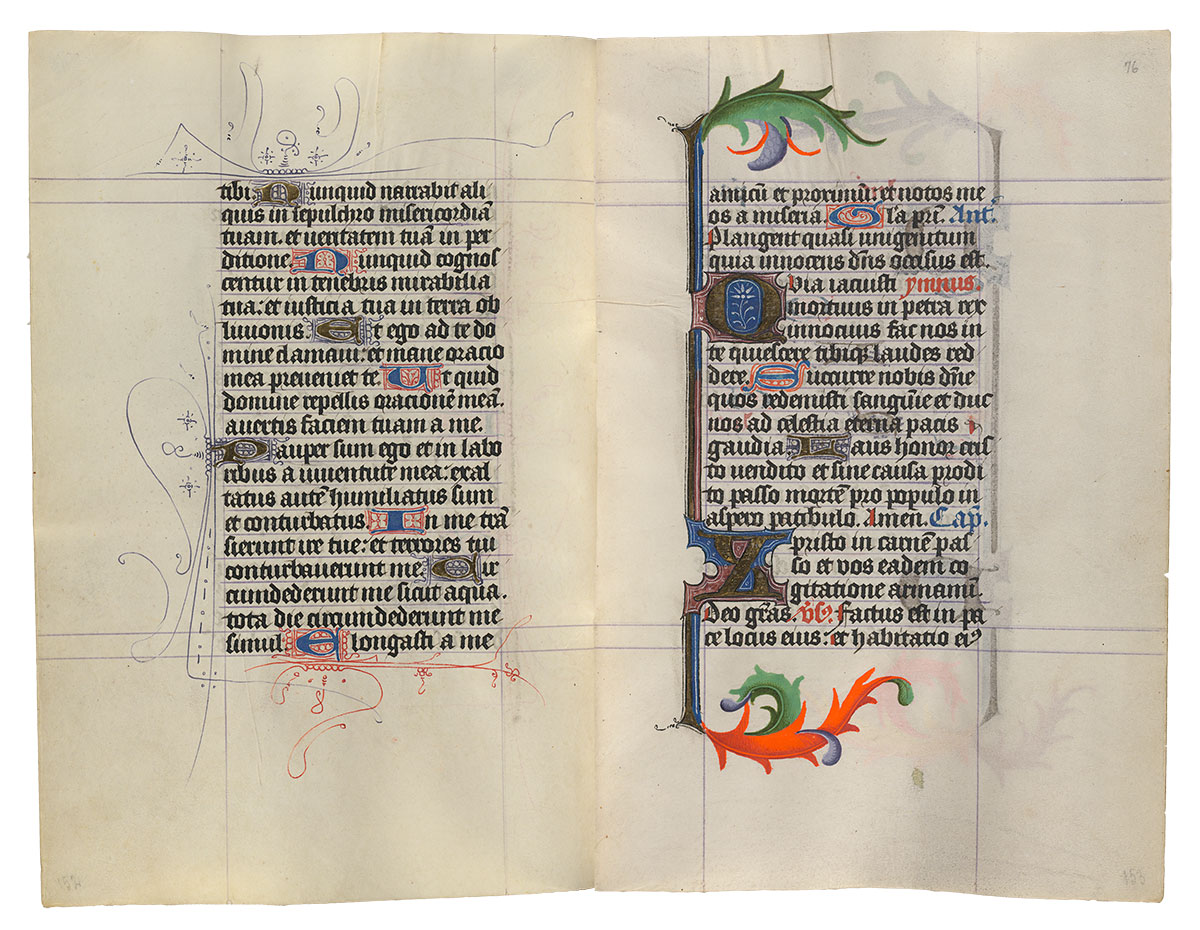
Purchased on the Belle da Costa Greene Fund with the assistance of the Fellows and with special assistance of Mrs. Frederick B. Adams, Sr., Mrs. Robert Charles, Mr. Laurens M. Hamilton, The Heineman Foundation, Mrs. Donald F. Hyde, Mrs. Jacob M. Kaplan, Mrs. John Kean, Mr. Paul Mellon, Mr. and Mrs. Charles F. Morgan, Mr. Lessing J. Rosenwald, Mr. and Mrs. August H. Schilling, Mrs. Herbert N. Straus, Mrs. Landon K. Thorne, Mrs. Alan Valentine, Mr. and Mrs. Arnold Whitridge, and Miss Julia P. Wightman, 1970
Image courtesy of Faksimile Verlag Luzern
MS M.917/945, ff. 76v–77r
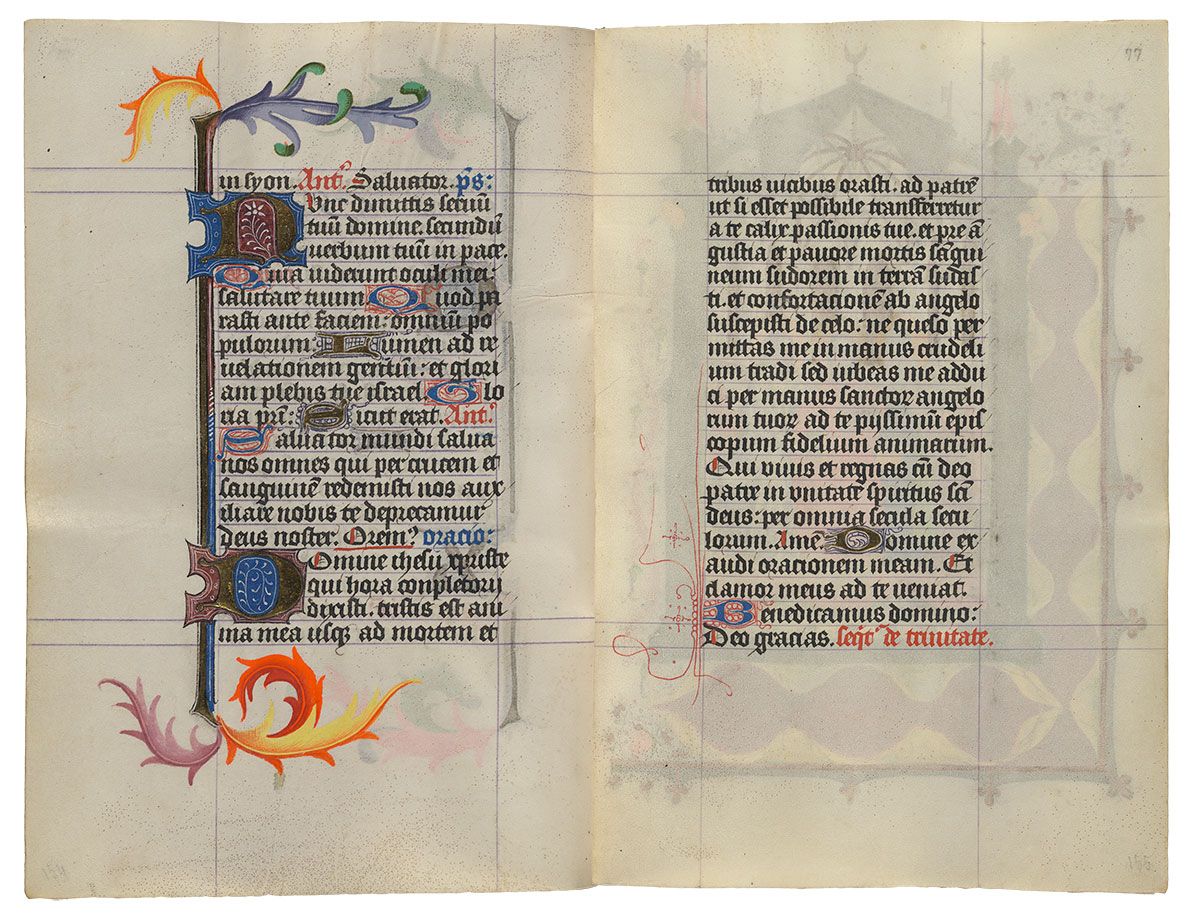
Purchased on the Belle da Costa Greene Fund with the assistance of the Fellows and with special assistance of Mrs. Frederick B. Adams, Sr., Mrs. Robert Charles, Mr. Laurens M. Hamilton, The Heineman Foundation, Mrs. Donald F. Hyde, Mrs. Jacob M. Kaplan, Mrs. John Kean, Mr. Paul Mellon, Mr. and Mrs. Charles F. Morgan, Mr. Lessing J. Rosenwald, Mr. and Mrs. August H. Schilling, Mrs. Herbert N. Straus, Mrs. Landon K. Thorne, Mrs. Alan Valentine, Mr. and Mrs. Arnold Whitridge, and Miss Julia P. Wightman, 1970
Image courtesy of Faksimile Verlag Luzern
MS M.917/945, ff. 77v–78r
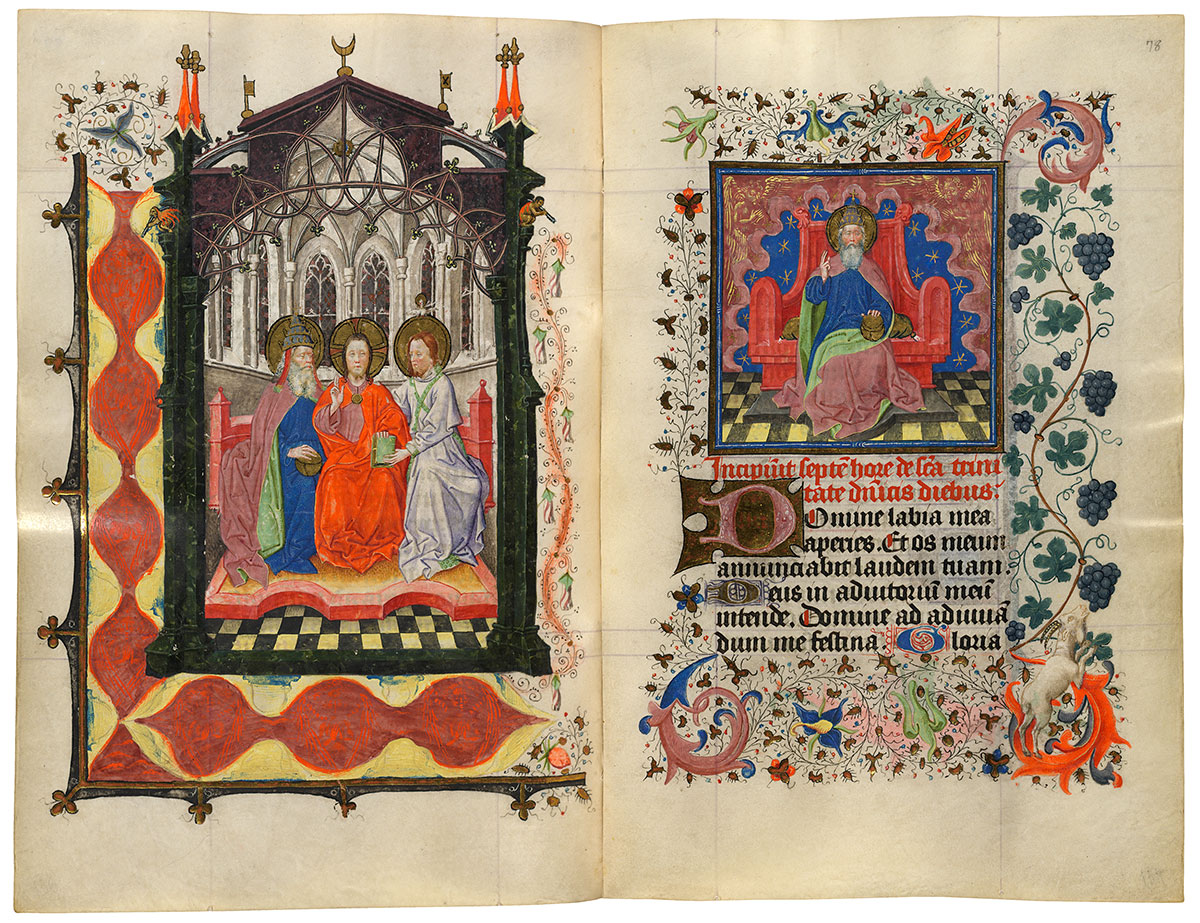
Trinity in an Apse
God the Father
Purchased on the Belle da Costa Greene Fund with the assistance of the Fellows and with special assistance of Mrs. Frederick B. Adams, Sr., Mrs. Robert Charles, Mr. Laurens M. Hamilton, The Heineman Foundation, Mrs. Donald F. Hyde, Mrs. Jacob M. Kaplan, Mrs. John Kean, Mr. Paul Mellon, Mr. and Mrs. Charles F. Morgan, Mr. Lessing J. Rosenwald, Mr. and Mrs. August H. Schilling, Mrs. Herbert N. Straus, Mrs. Landon K. Thorne, Mrs. Alan Valentine, Mr. and Mrs. Arnold Whitridge, and Miss Julia P. Wightman, 1970
The Sunday Hours of the Trinity open, appropriately, with a large miniature depicting the Three Persons of the Trinity. God the Father, bearded and wearing a tiara, holds the world. He turns to Christ, who, dressed in a red robe, raises his right hand in a vow. The Holy Spirit, a dove perched upon his halo, holds the book upon which Christ places his left hand. Christ is pledging acceptance of his Father's decision to sacrifice him in order to ensure mankind's salvation. The three sit on a monumental throne set within an elaborately vaulted and glazed apse. In the smaller miniature, God the Father is enthroned. Grapes in the border allude to the Eucharistic wine and Christ's sacrifice.
Hours and Masses for the Seven Days of the Week
The most unusual texts in Catherine's manuscript are the series of Hours and Masses for every day of the week. Medieval Christian tradition associated certain figures or themes with different days. Thus Sunday, the day of the Resurrection, was the Lord's Day; Thursday was connected with the Eucharist since that sacrament was instituted on Holy Thursday; and Monday was the day of the dead, since their torments were suspended on Sunday but recommenced the following day. In Catherine's prayer book, the themes for the Hours and Masses of the seven days of the week are:
| Sunday | the Trinity |
| Monday | the Dead |
| Tuesday | the Holy Spirit |
| Wednesday | All Saints |
| Thursday | the Blessed Sacrament |
| Friday | the Compassion of God |
| Saturday | the Virgin. |
Image courtesy of Faksimile Verlag Luzern
MS M.917/945, ff. 78v–79r
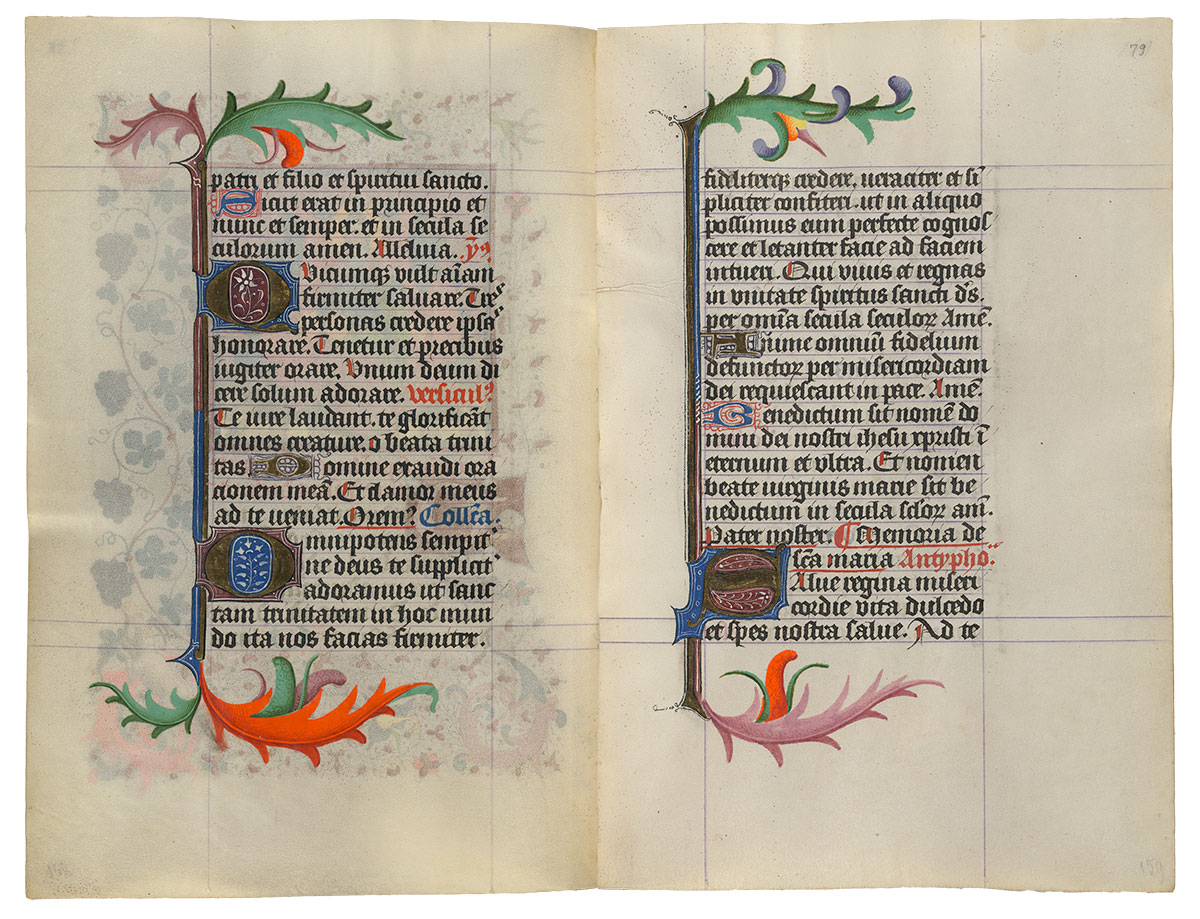
Purchased on the Belle da Costa Greene Fund with the assistance of the Fellows and with special assistance of Mrs. Frederick B. Adams, Sr., Mrs. Robert Charles, Mr. Laurens M. Hamilton, The Heineman Foundation, Mrs. Donald F. Hyde, Mrs. Jacob M. Kaplan, Mrs. John Kean, Mr. Paul Mellon, Mr. and Mrs. Charles F. Morgan, Mr. Lessing J. Rosenwald, Mr. and Mrs. August H. Schilling, Mrs. Herbert N. Straus, Mrs. Landon K. Thorne, Mrs. Alan Valentine, Mr. and Mrs. Arnold Whitridge, and Miss Julia P. Wightman, 1970
Image courtesy of Faksimile Verlag Luzern
MS M.917/945, ff. 79v–80r
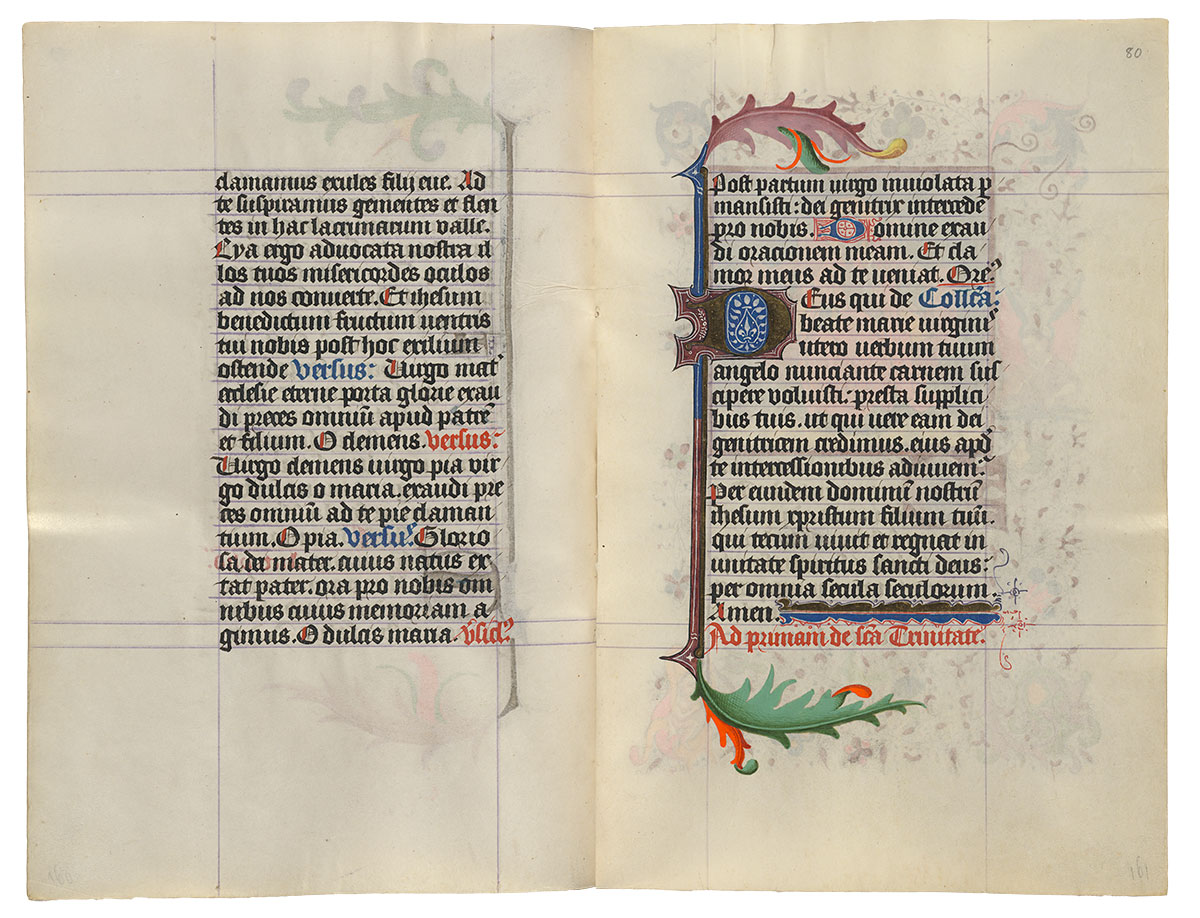
Purchased on the Belle da Costa Greene Fund with the assistance of the Fellows and with special assistance of Mrs. Frederick B. Adams, Sr., Mrs. Robert Charles, Mr. Laurens M. Hamilton, The Heineman Foundation, Mrs. Donald F. Hyde, Mrs. Jacob M. Kaplan, Mrs. John Kean, Mr. Paul Mellon, Mr. and Mrs. Charles F. Morgan, Mr. Lessing J. Rosenwald, Mr. and Mrs. August H. Schilling, Mrs. Herbert N. Straus, Mrs. Landon K. Thorne, Mrs. Alan Valentine, Mr. and Mrs. Arnold Whitridge, and Miss Julia P. Wightman, 1970
Image courtesy of Faksimile Verlag Luzern
Hours and Masses for the Seven Days of the Week
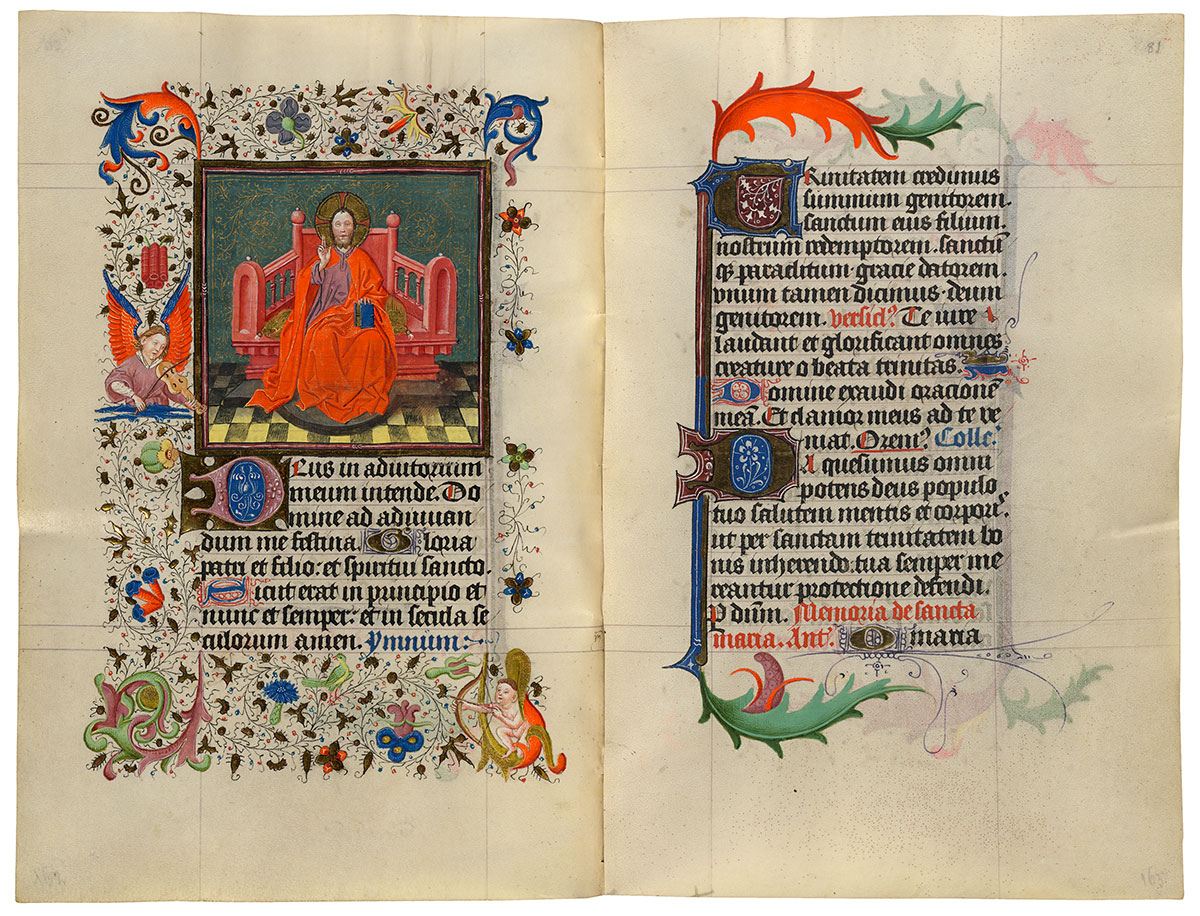
God the Son
Purchased on the Belle da Costa Greene Fund with the assistance of the Fellows and with special assistance of Mrs. Frederick B. Adams, Sr., Mrs. Robert Charles, Mr. Laurens M. Hamilton, The Heineman Foundation, Mrs. Donald F. Hyde, Mrs. Jacob M. Kaplan, Mrs. John Kean, Mr. Paul Mellon, Mr. and Mrs. Charles F. Morgan, Mr. Lessing J. Rosenwald, Mr. and Mrs. August H. Schilling, Mrs. Herbert N. Straus, Mrs. Landon K. Thorne, Mrs. Alan Valentine, Mr. and Mrs. Arnold Whitridge, and Miss Julia P. Wightman, 1970
Hours and Masses for the Seven Days of the Week
The most unusual texts in Catherine's manuscript are the series of Hours and Masses for every day of the week. Medieval Christian tradition associated certain figures or themes with different days. Thus Sunday, the day of the Resurrection, was the Lord's Day; Thursday was connected with the Eucharist since that sacrament was instituted on Holy Thursday; and Monday was the day of the dead, since their torments were suspended on Sunday but recommenced the following day. In Catherine's prayer book, the themes for the Hours and Masses of the seven days of the week are:
| Sunday | the Trinity |
| Monday | the Dead |
| Tuesday | the Holy Spirit |
| Wednesday | All Saints |
| Thursday | the Blessed Sacrament |
| Friday | the Compassion of God |
| Saturday | the Virgin. |
Image courtesy of Faksimile Verlag Luzern
MS M.917/945, ff. 81v–82r
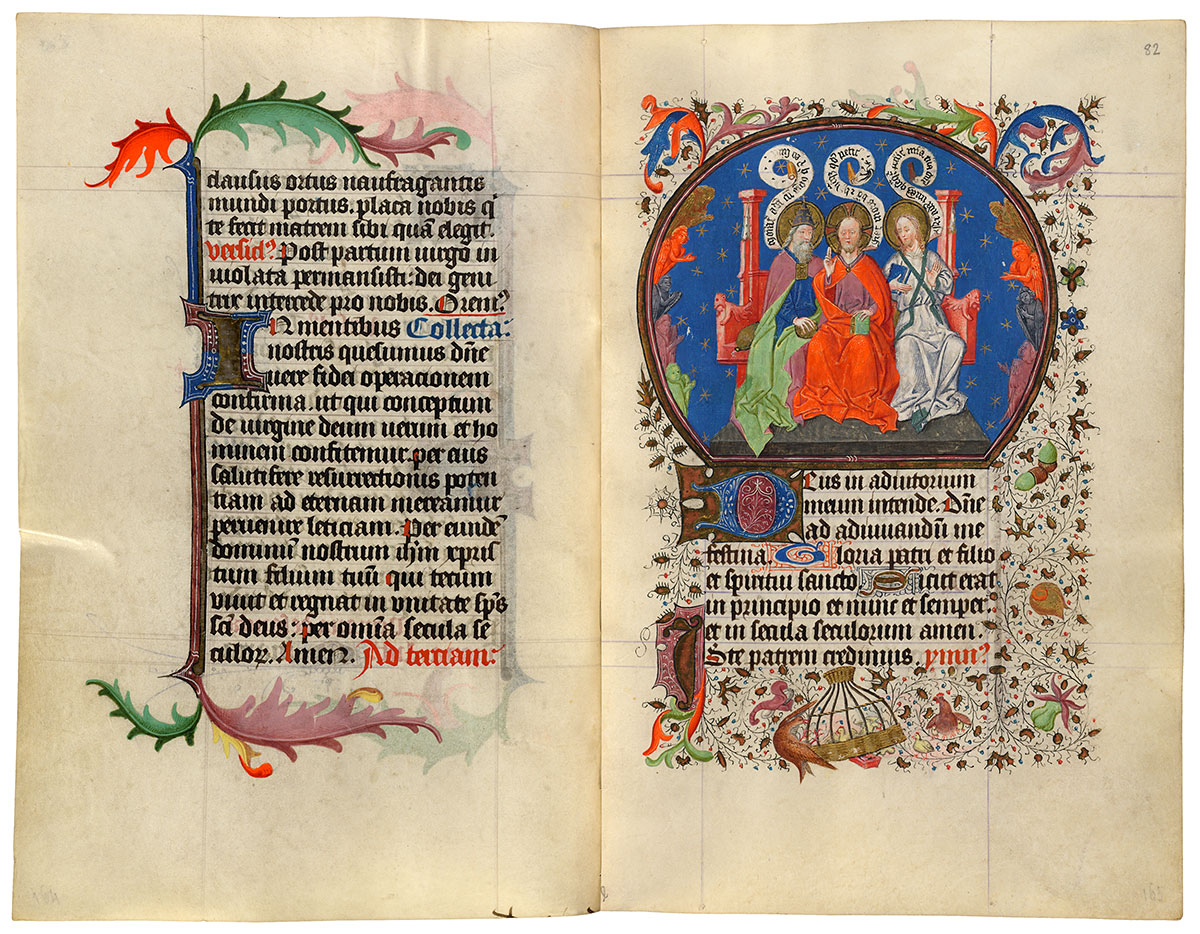
Three Persons of the Trinity
Purchased on the Belle da Costa Greene Fund with the assistance of the Fellows and with special assistance of Mrs. Frederick B. Adams, Sr., Mrs. Robert Charles, Mr. Laurens M. Hamilton, The Heineman Foundation, Mrs. Donald F. Hyde, Mrs. Jacob M. Kaplan, Mrs. John Kean, Mr. Paul Mellon, Mr. and Mrs. Charles F. Morgan, Mr. Lessing J. Rosenwald, Mr. and Mrs. August H. Schilling, Mrs. Herbert N. Straus, Mrs. Landon K. Thorne, Mrs. Alan Valentine, Mr. and Mrs. Arnold Whitridge, and Miss Julia P. Wightman, 1970
The Three Persons of the Trinity sit on a throne floating in a starry sky surrounded by representatives of the nine choirs of angels. Scrolls give words to their debate. God the Father argues that "Adam will die with all those who are from my tribe." The Holy Spirit advocates compassion: "If Adam does not achieve mercy, then your mercy, Lord, will perish." Accepting his sacrificial role, Christ has the last words: "May it be a good death, and may he obtain what he requests."
Hours and Masses for the Seven Days of the Week
The most unusual texts in Catherine's manuscript are the series of Hours and Masses for every day of the week. Medieval Christian tradition associated certain figures or themes with different days. Thus Sunday, the day of the Resurrection, was the Lord's Day; Thursday was connected with the Eucharist since that sacrament was instituted on Holy Thursday; and Monday was the day of the dead, since their torments were suspended on Sunday but recommenced the following day. In Catherine's prayer book, the themes for the Hours and Masses of the seven days of the week are:
| Sunday | the Trinity |
| Monday | the Dead |
| Tuesday | the Holy Spirit |
| Wednesday | All Saints |
| Thursday | the Blessed Sacrament |
| Friday | the Compassion of God |
| Saturday | the Virgin. |
Image courtesy of Faksimile Verlag Luzern
MS M.917/945, ff. 82v–83r
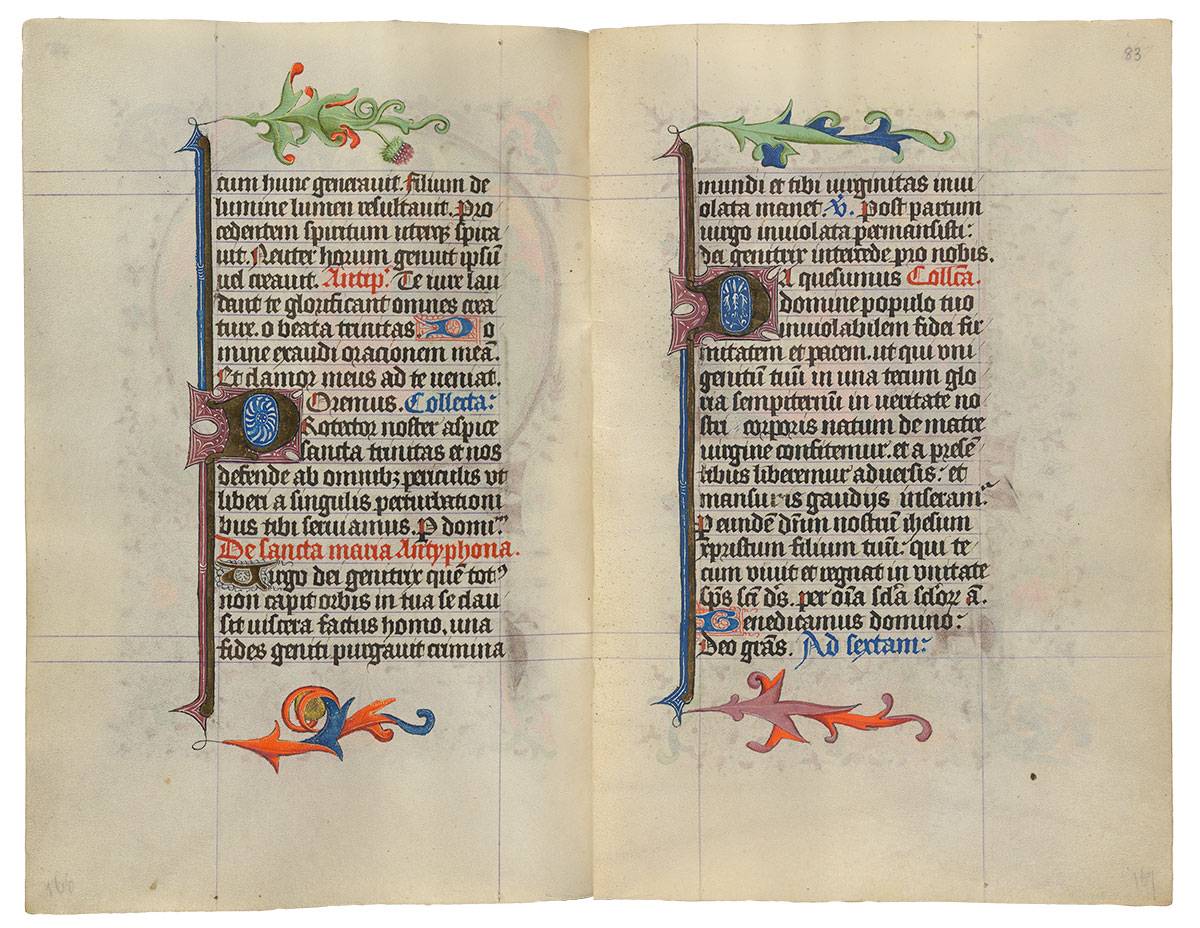
Purchased on the Belle da Costa Greene Fund with the assistance of the Fellows and with special assistance of Mrs. Frederick B. Adams, Sr., Mrs. Robert Charles, Mr. Laurens M. Hamilton, The Heineman Foundation, Mrs. Donald F. Hyde, Mrs. Jacob M. Kaplan, Mrs. John Kean, Mr. Paul Mellon, Mr. and Mrs. Charles F. Morgan, Mr. Lessing J. Rosenwald, Mr. and Mrs. August H. Schilling, Mrs. Herbert N. Straus, Mrs. Landon K. Thorne, Mrs. Alan Valentine, Mr. and Mrs. Arnold Whitridge, and Miss Julia P. Wightman, 1970
Image courtesy of Faksimile Verlag Luzern
MS M.917/945, ff. 83v–84r
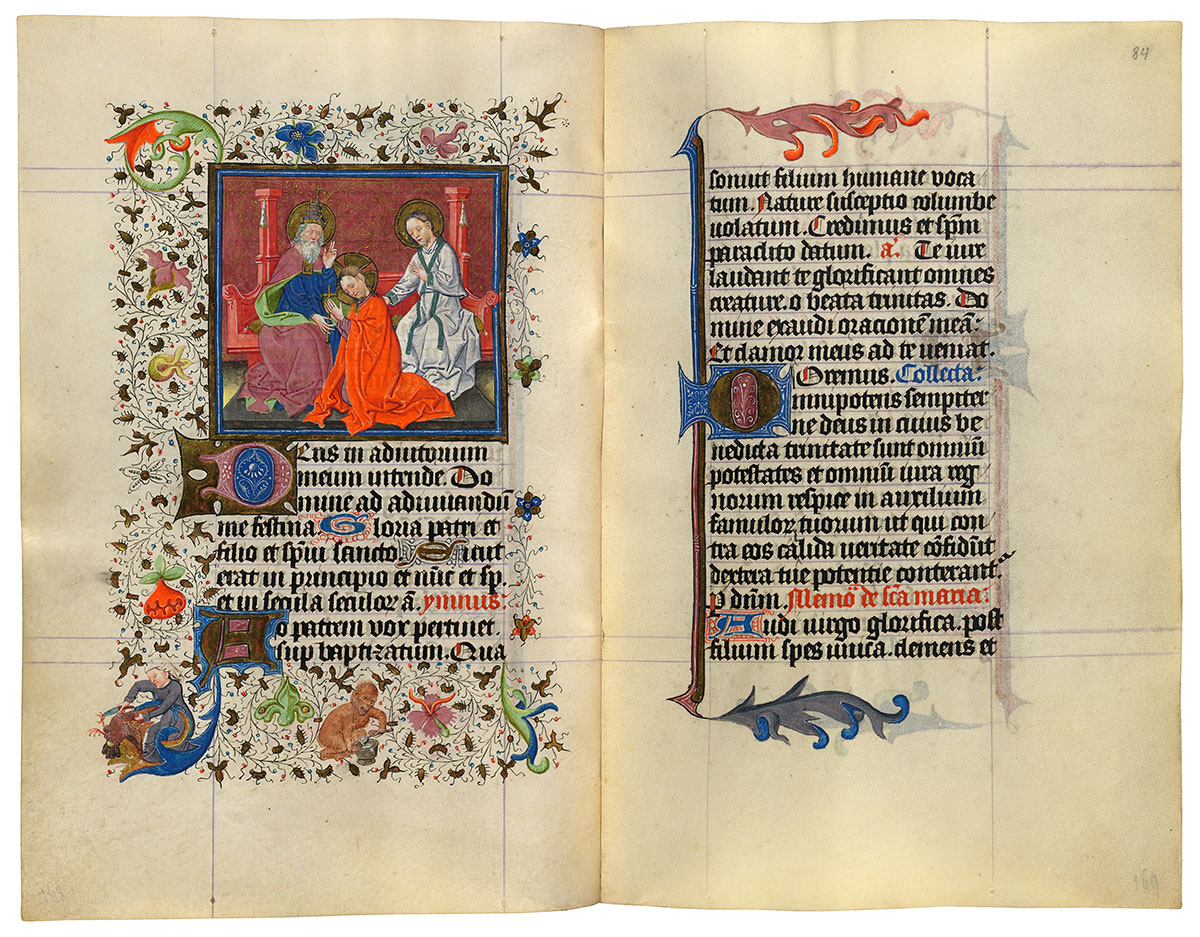
Christ Accepts his Father’s Decree to Save Mankind
Purchased on the Belle da Costa Greene Fund with the assistance of the Fellows and with special assistance of Mrs. Frederick B. Adams, Sr., Mrs. Robert Charles, Mr. Laurens M. Hamilton, The Heineman Foundation, Mrs. Donald F. Hyde, Mrs. Jacob M. Kaplan, Mrs. John Kean, Mr. Paul Mellon, Mr. and Mrs. Charles F. Morgan, Mr. Lessing J. Rosenwald, Mr. and Mrs. August H. Schilling, Mrs. Herbert N. Straus, Mrs. Landon K. Thorne, Mrs. Alan Valentine, Mr. and Mrs. Arnold Whitridge, and Miss Julia P. Wightman, 1970
Hours and Masses for the Seven Days of the Week
The most unusual texts in Catherine's manuscript are the series of Hours and Masses for every day of the week. Medieval Christian tradition associated certain figures or themes with different days. Thus Sunday, the day of the Resurrection, was the Lord's Day; Thursday was connected with the Eucharist since that sacrament was instituted on Holy Thursday; and Monday was the day of the dead, since their torments were suspended on Sunday but recommenced the following day. In Catherine's prayer book, the themes for the Hours and Masses of the seven days of the week are:
| Sunday | the Trinity |
| Monday | the Dead |
| Tuesday | the Holy Spirit |
| Wednesday | All Saints |
| Thursday | the Blessed Sacrament |
| Friday | the Compassion of God |
| Saturday | the Virgin. |
Image courtesy of Faksimile Verlag Luzern
MS M.917/945, ff. 84v–85r
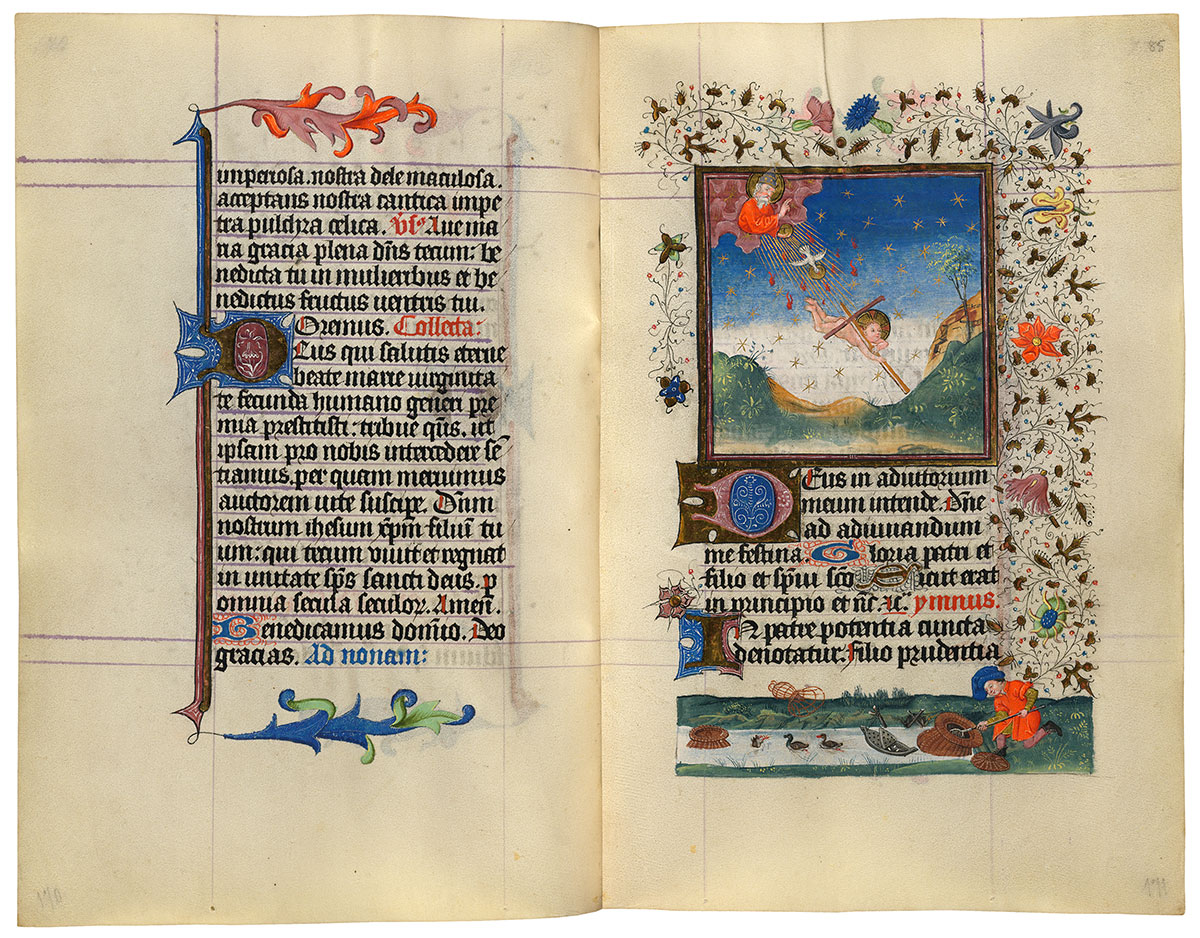
Infant Christ Sent to Earth
Purchased on the Belle da Costa Greene Fund with the assistance of the Fellows and with special assistance of Mrs. Frederick B. Adams, Sr., Mrs. Robert Charles, Mr. Laurens M. Hamilton, The Heineman Foundation, Mrs. Donald F. Hyde, Mrs. Jacob M. Kaplan, Mrs. John Kean, Mr. Paul Mellon, Mr. and Mrs. Charles F. Morgan, Mr. Lessing J. Rosenwald, Mr. and Mrs. August H. Schilling, Mrs. Herbert N. Straus, Mrs. Landon K. Thorne, Mrs. Alan Valentine, Mr. and Mrs. Arnold Whitridge, and Miss Julia P. Wightman, 1970
Salvation has begun. God the Father dispatches his Son to earth, trailed by the Dove of the Holy Spirit. Christ is depicted as a human baby, albeit one shouldering the Cross upon which he will die. The earth is devoid of people; no one welcomes the future Savior. Below, in the border, a man catches fish in traps that symbolize the corporeal imprisonment of the soul.
Hours and Masses for the Seven Days of the Week
The most unusual texts in Catherine's manuscript are the series of Hours and Masses for every day of the week. Medieval Christian tradition associated certain figures or themes with different days. Thus Sunday, the day of the Resurrection, was the Lord's Day; Thursday was connected with the Eucharist since that sacrament was instituted on Holy Thursday; and Monday was the day of the dead, since their torments were suspended on Sunday but recommenced the following day. In Catherine's prayer book, the themes for the Hours and Masses of the seven days of the week are:
| Sunday | the Trinity |
| Monday | the Dead |
| Tuesday | the Holy Spirit |
| Wednesday | All Saints |
| Thursday | the Blessed Sacrament |
| Friday | the Compassion of God |
| Saturday | the Virgin. |
Image courtesy of Faksimile Verlag Luzern
MS M.917/945, ff. 85v–86r
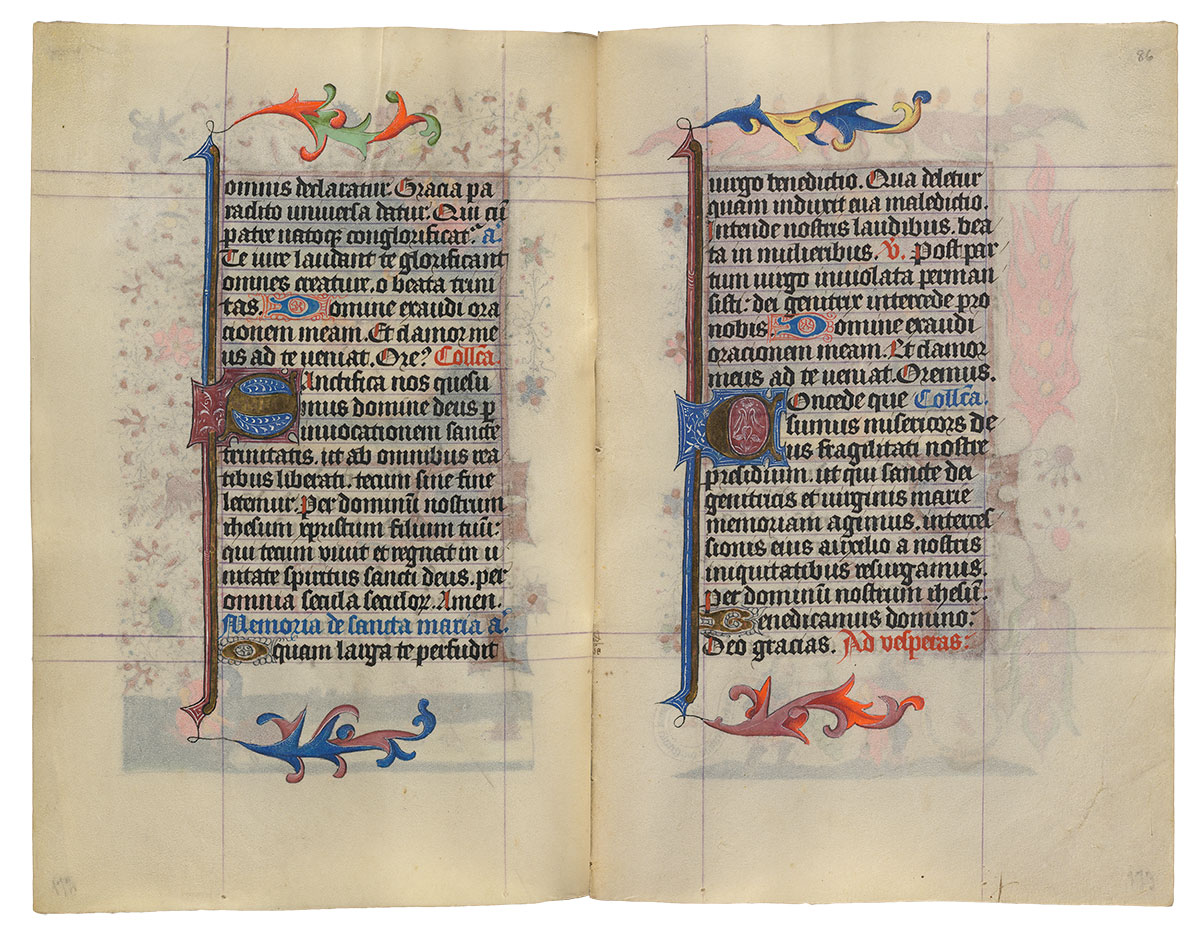
Purchased on the Belle da Costa Greene Fund with the assistance of the Fellows and with special assistance of Mrs. Frederick B. Adams, Sr., Mrs. Robert Charles, Mr. Laurens M. Hamilton, The Heineman Foundation, Mrs. Donald F. Hyde, Mrs. Jacob M. Kaplan, Mrs. John Kean, Mr. Paul Mellon, Mr. and Mrs. Charles F. Morgan, Mr. Lessing J. Rosenwald, Mr. and Mrs. August H. Schilling, Mrs. Herbert N. Straus, Mrs. Landon K. Thorne, Mrs. Alan Valentine, Mr. and Mrs. Arnold Whitridge, and Miss Julia P. Wightman, 1970
Image courtesy of Faksimile Verlag Luzern
MS M.917/945, ff. 86v–87r
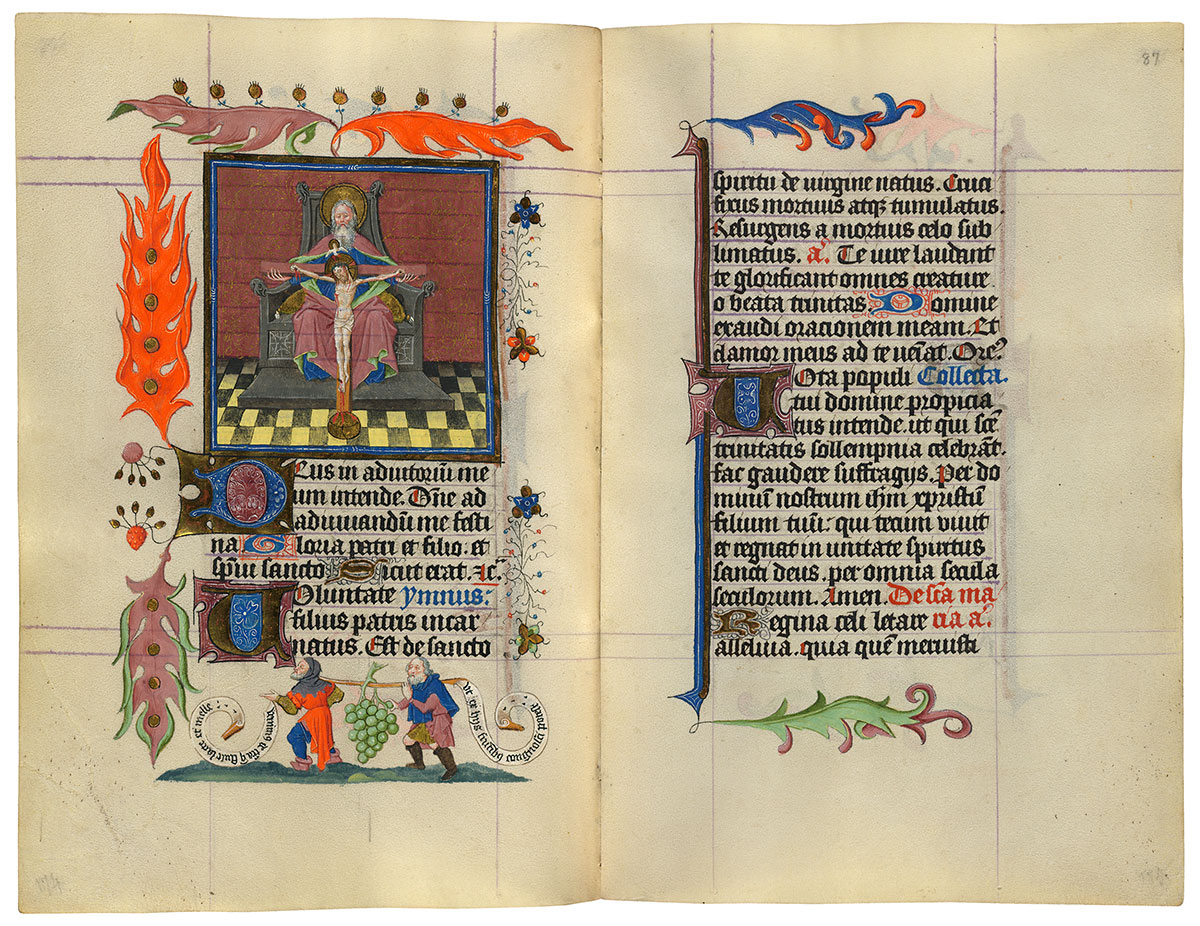
“Throne of Grace” Trinity
Purchased on the Belle da Costa Greene Fund with the assistance of the Fellows and with special assistance of Mrs. Frederick B. Adams, Sr., Mrs. Robert Charles, Mr. Laurens M. Hamilton, The Heineman Foundation, Mrs. Donald F. Hyde, Mrs. Jacob M. Kaplan, Mrs. John Kean, Mr. Paul Mellon, Mr. and Mrs. Charles F. Morgan, Mr. Lessing J. Rosenwald, Mr. and Mrs. August H. Schilling, Mrs. Herbert N. Straus, Mrs. Landon K. Thorne, Mrs. Alan Valentine, Mr. and Mrs. Arnold Whitridge, and Miss Julia P. Wightman, 1970
Hours and Masses for the Seven Days of the Week
The most unusual texts in Catherine's manuscript are the series of Hours and Masses for every day of the week. Medieval Christian tradition associated certain figures or themes with different days. Thus Sunday, the day of the Resurrection, was the Lord's Day; Thursday was connected with the Eucharist since that sacrament was instituted on Holy Thursday; and Monday was the day of the dead, since their torments were suspended on Sunday but recommenced the following day. In Catherine's prayer book, the themes for the Hours and Masses of the seven days of the week are:
| Sunday | the Trinity |
| Monday | the Dead |
| Tuesday | the Holy Spirit |
| Wednesday | All Saints |
| Thursday | the Blessed Sacrament |
| Friday | the Compassion of God |
| Saturday | the Virgin. |
Image courtesy of Faksimile Verlag Luzern
MS M.917/945, ff. 87v–88r
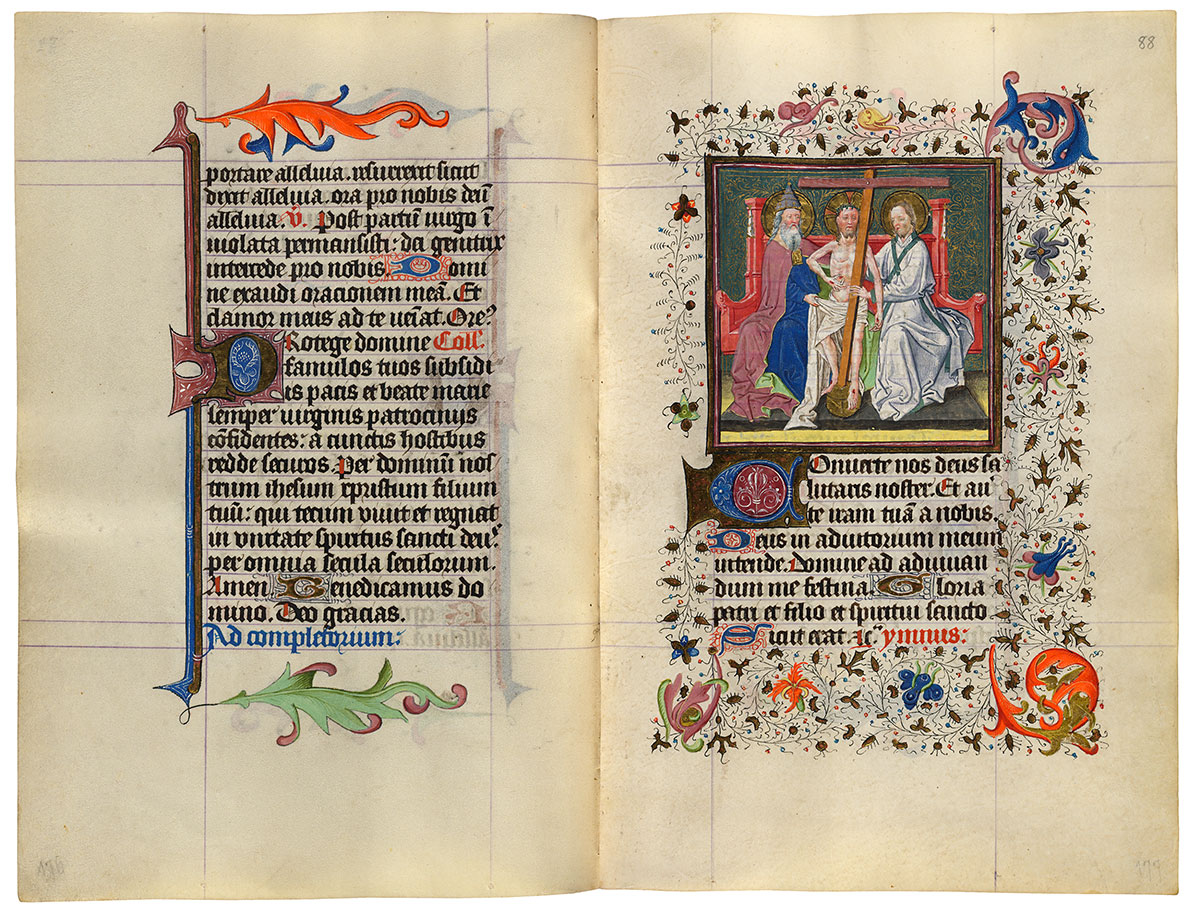
Man of Sorrows Returned to the Trinitarian Throne
Purchased on the Belle da Costa Greene Fund with the assistance of the Fellows and with special assistance of Mrs. Frederick B. Adams, Sr., Mrs. Robert Charles, Mr. Laurens M. Hamilton, The Heineman Foundation, Mrs. Donald F. Hyde, Mrs. Jacob M. Kaplan, Mrs. John Kean, Mr. Paul Mellon, Mr. and Mrs. Charles F. Morgan, Mr. Lessing J. Rosenwald, Mr. and Mrs. August H. Schilling, Mrs. Herbert N. Straus, Mrs. Landon K. Thorne, Mrs. Alan Valentine, Mr. and Mrs. Arnold Whitridge, and Miss Julia P. Wightman, 1970
Hours and Masses for the Seven Days of the Week
The most unusual texts in Catherine's manuscript are the series of Hours and Masses for every day of the week. Medieval Christian tradition associated certain figures or themes with different days. Thus Sunday, the day of the Resurrection, was the Lord's Day; Thursday was connected with the Eucharist since that sacrament was instituted on Holy Thursday; and Monday was the day of the dead, since their torments were suspended on Sunday but recommenced the following day. In Catherine's prayer book, the themes for the Hours and Masses of the seven days of the week are:
| Sunday | the Trinity |
| Monday | the Dead |
| Tuesday | the Holy Spirit |
| Wednesday | All Saints |
| Thursday | the Blessed Sacrament |
| Friday | the Compassion of God |
| Saturday | the Virgin. |
Image courtesy of Faksimile Verlag Luzern
MS M.917/945, ff. 88v–89r
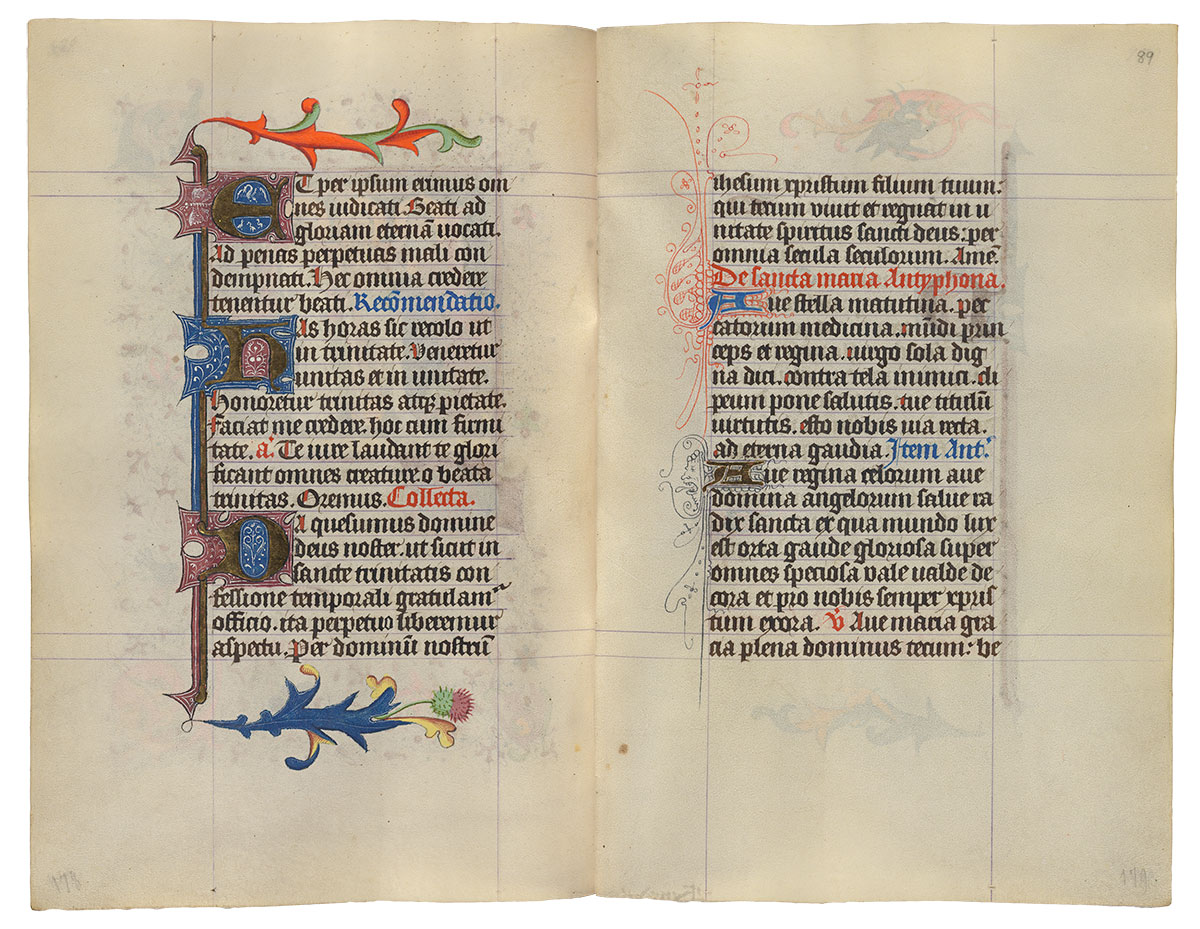
Purchased on the Belle da Costa Greene Fund with the assistance of the Fellows and with special assistance of Mrs. Frederick B. Adams, Sr., Mrs. Robert Charles, Mr. Laurens M. Hamilton, The Heineman Foundation, Mrs. Donald F. Hyde, Mrs. Jacob M. Kaplan, Mrs. John Kean, Mr. Paul Mellon, Mr. and Mrs. Charles F. Morgan, Mr. Lessing J. Rosenwald, Mr. and Mrs. August H. Schilling, Mrs. Herbert N. Straus, Mrs. Landon K. Thorne, Mrs. Alan Valentine, Mr. and Mrs. Arnold Whitridge, and Miss Julia P. Wightman, 1970
Image courtesy of Faksimile Verlag Luzern
MS M.917/945, ff. 89v–90r
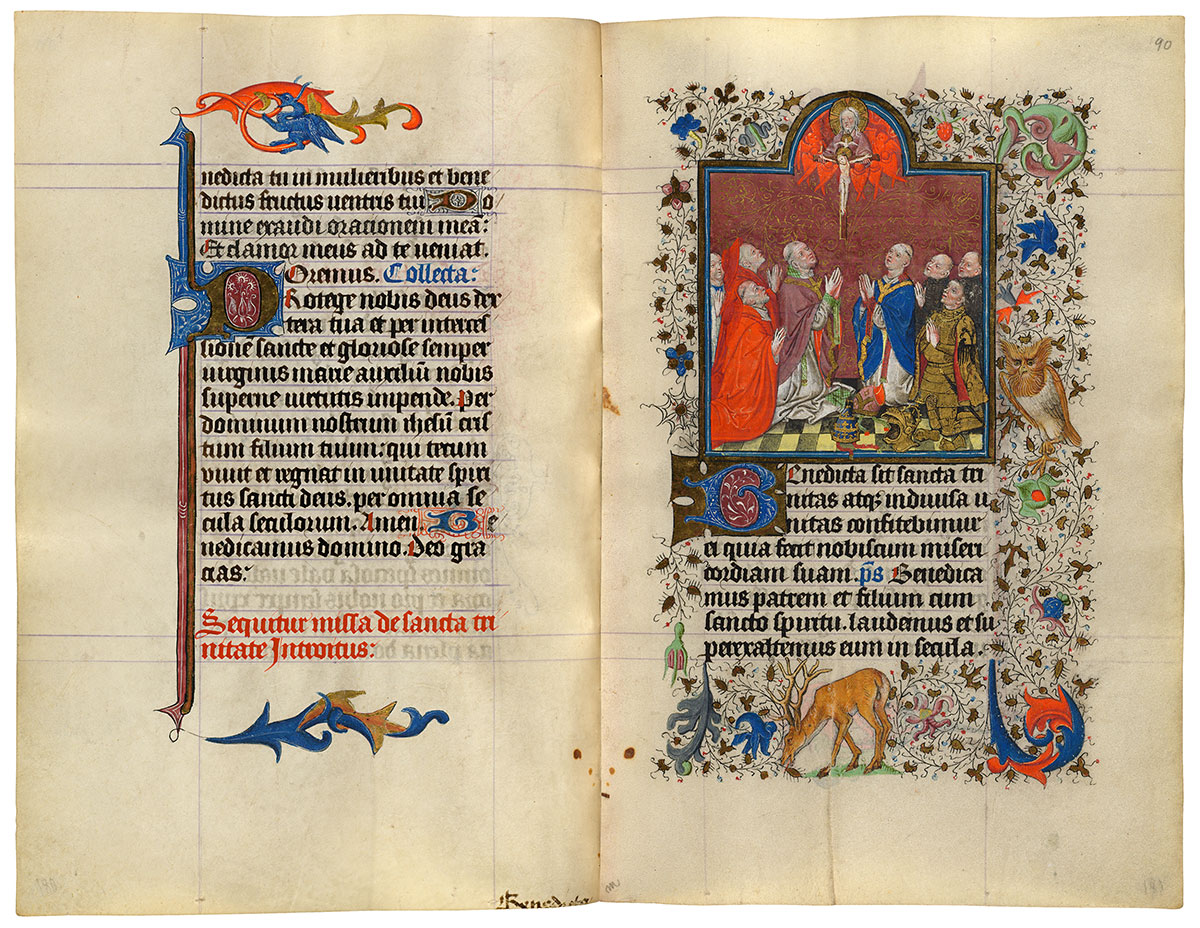
Rulers of the Earth Adore the Trinity
Purchased on the Belle da Costa Greene Fund with the assistance of the Fellows and with special assistance of Mrs. Frederick B. Adams, Sr., Mrs. Robert Charles, Mr. Laurens M. Hamilton, The Heineman Foundation, Mrs. Donald F. Hyde, Mrs. Jacob M. Kaplan, Mrs. John Kean, Mr. Paul Mellon, Mr. and Mrs. Charles F. Morgan, Mr. Lessing J. Rosenwald, Mr. and Mrs. August H. Schilling, Mrs. Herbert N. Straus, Mrs. Landon K. Thorne, Mrs. Alan Valentine, Mr. and Mrs. Arnold Whitridge, and Miss Julia P. Wightman, 1970
Hours and Masses for the Seven Days of the Week
The most unusual texts in Catherine's manuscript are the series of Hours and Masses for every day of the week. Medieval Christian tradition associated certain figures or themes with different days. Thus Sunday, the day of the Resurrection, was the Lord's Day; Thursday was connected with the Eucharist since that sacrament was instituted on Holy Thursday; and Monday was the day of the dead, since their torments were suspended on Sunday but recommenced the following day. In Catherine's prayer book, the themes for the Hours and Masses of the seven days of the week are:
| Sunday | the Trinity |
| Monday | the Dead |
| Tuesday | the Holy Spirit |
| Wednesday | All Saints |
| Thursday | the Blessed Sacrament |
| Friday | the Compassion of God |
| Saturday | the Virgin. |
Image courtesy of Faksimile Verlag Luzern
MS M.917/945, ff. 90v–91r
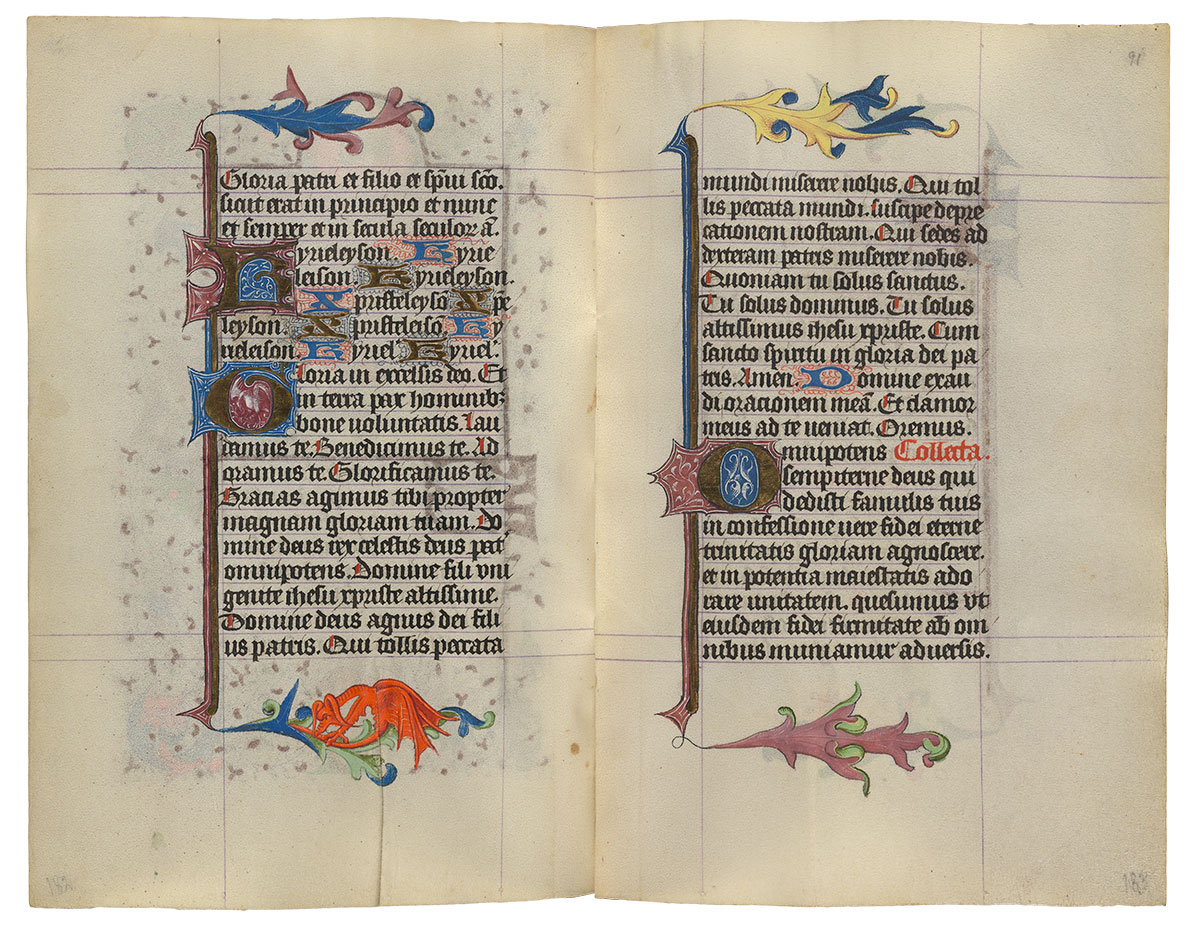
Purchased on the Belle da Costa Greene Fund with the assistance of the Fellows and with special assistance of Mrs. Frederick B. Adams, Sr., Mrs. Robert Charles, Mr. Laurens M. Hamilton, The Heineman Foundation, Mrs. Donald F. Hyde, Mrs. Jacob M. Kaplan, Mrs. John Kean, Mr. Paul Mellon, Mr. and Mrs. Charles F. Morgan, Mr. Lessing J. Rosenwald, Mr. and Mrs. August H. Schilling, Mrs. Herbert N. Straus, Mrs. Landon K. Thorne, Mrs. Alan Valentine, Mr. and Mrs. Arnold Whitridge, and Miss Julia P. Wightman, 1970
Image courtesy of Faksimile Verlag Luzern
MS M.917/945, ff. 91v–92r
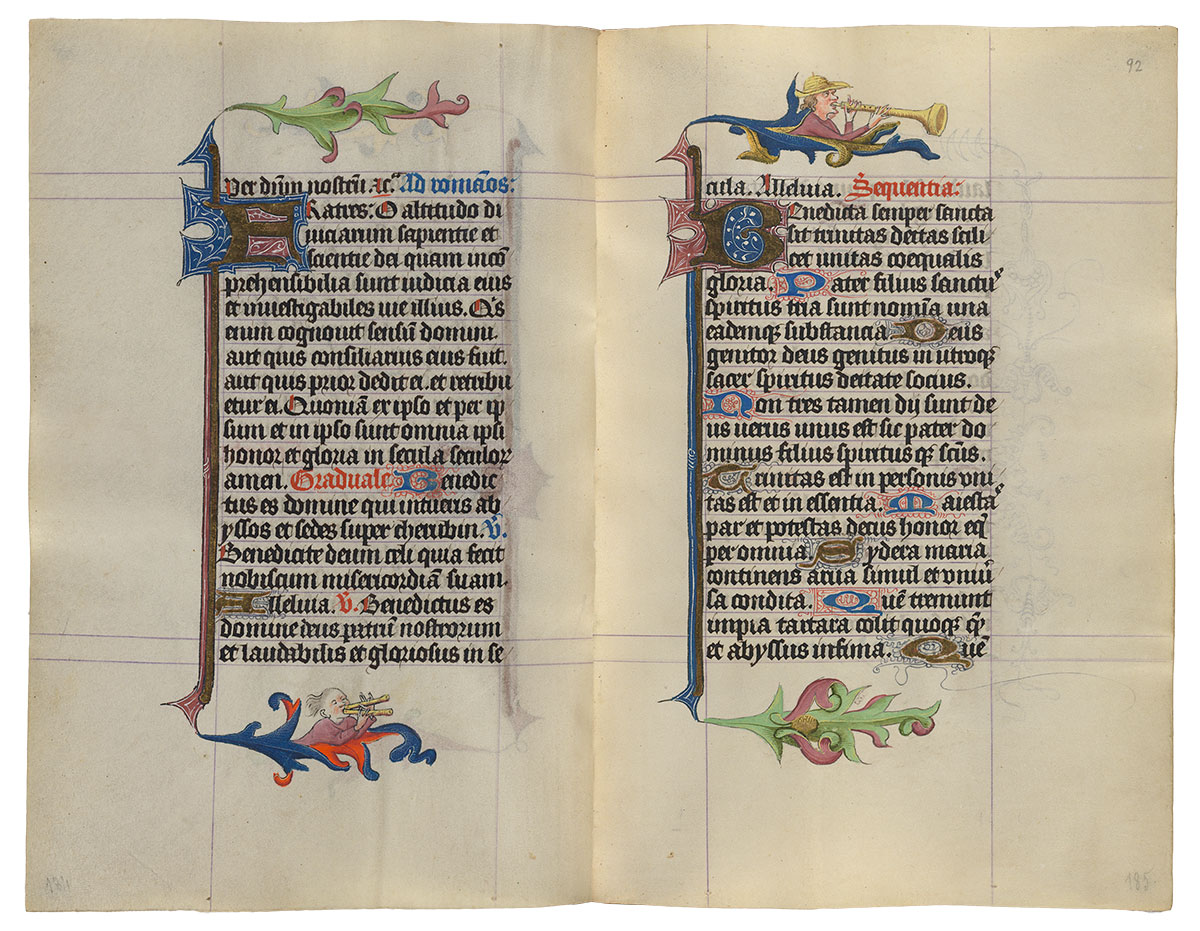
Purchased on the Belle da Costa Greene Fund with the assistance of the Fellows and with special assistance of Mrs. Frederick B. Adams, Sr., Mrs. Robert Charles, Mr. Laurens M. Hamilton, The Heineman Foundation, Mrs. Donald F. Hyde, Mrs. Jacob M. Kaplan, Mrs. John Kean, Mr. Paul Mellon, Mr. and Mrs. Charles F. Morgan, Mr. Lessing J. Rosenwald, Mr. and Mrs. August H. Schilling, Mrs. Herbert N. Straus, Mrs. Landon K. Thorne, Mrs. Alan Valentine, Mr. and Mrs. Arnold Whitridge, and Miss Julia P. Wightman, 1970
Image courtesy of Faksimile Verlag Luzern
MS M.917/945, ff. 92v–93r
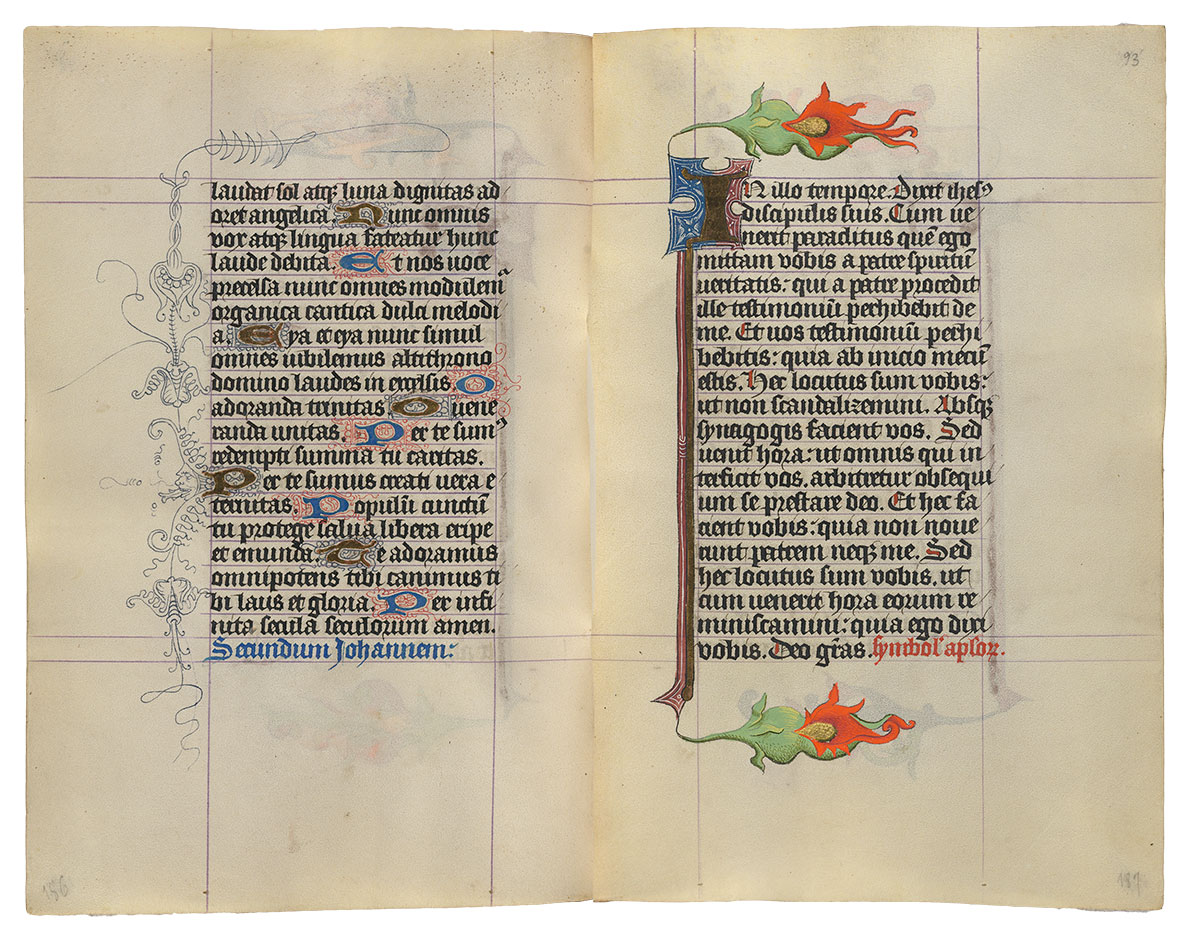
Purchased on the Belle da Costa Greene Fund with the assistance of the Fellows and with special assistance of Mrs. Frederick B. Adams, Sr., Mrs. Robert Charles, Mr. Laurens M. Hamilton, The Heineman Foundation, Mrs. Donald F. Hyde, Mrs. Jacob M. Kaplan, Mrs. John Kean, Mr. Paul Mellon, Mr. and Mrs. Charles F. Morgan, Mr. Lessing J. Rosenwald, Mr. and Mrs. August H. Schilling, Mrs. Herbert N. Straus, Mrs. Landon K. Thorne, Mrs. Alan Valentine, Mr. and Mrs. Arnold Whitridge, and Miss Julia P. Wightman, 1970
Image courtesy of Faksimile Verlag Luzern
MS M.917/945, ff. 93v–94r
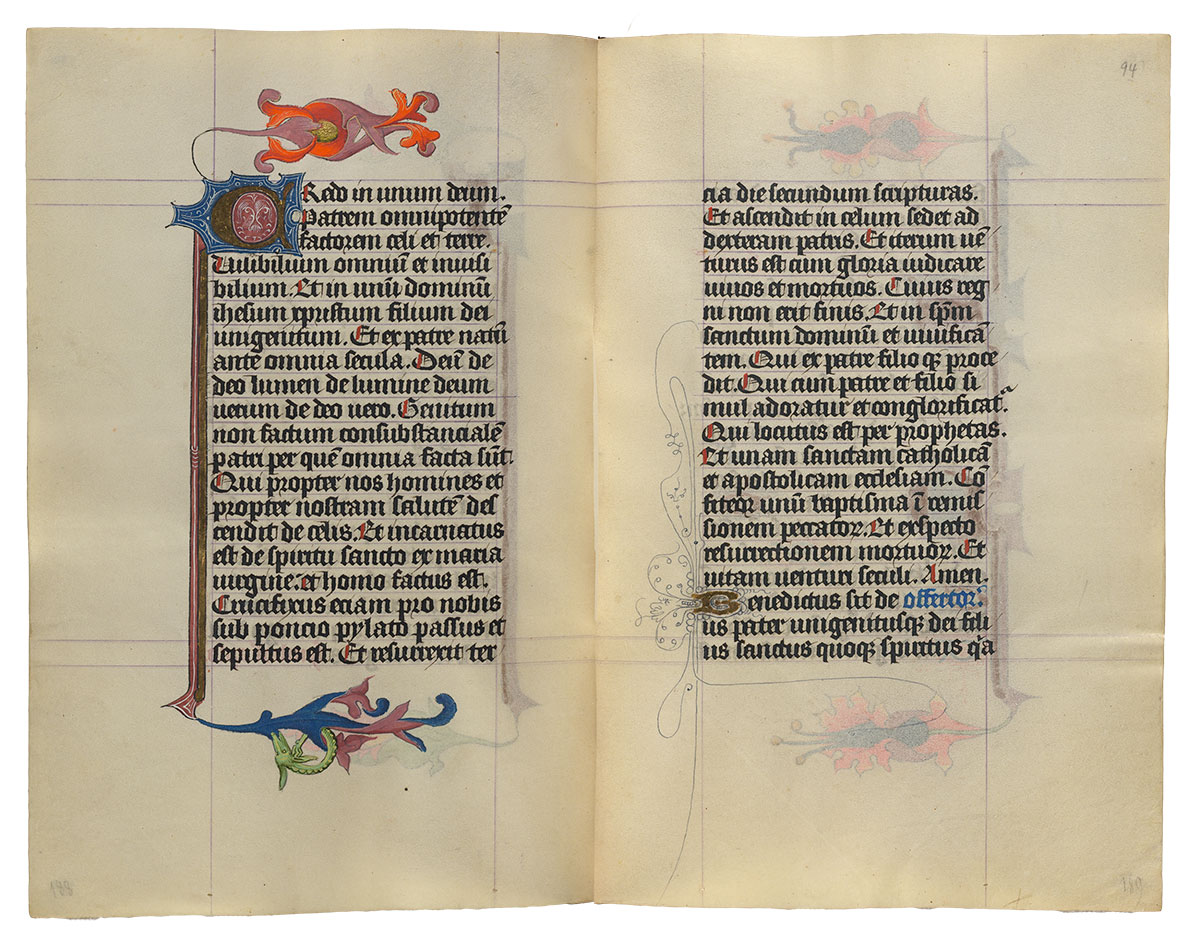
Purchased on the Belle da Costa Greene Fund with the assistance of the Fellows and with special assistance of Mrs. Frederick B. Adams, Sr., Mrs. Robert Charles, Mr. Laurens M. Hamilton, The Heineman Foundation, Mrs. Donald F. Hyde, Mrs. Jacob M. Kaplan, Mrs. John Kean, Mr. Paul Mellon, Mr. and Mrs. Charles F. Morgan, Mr. Lessing J. Rosenwald, Mr. and Mrs. August H. Schilling, Mrs. Herbert N. Straus, Mrs. Landon K. Thorne, Mrs. Alan Valentine, Mr. and Mrs. Arnold Whitridge, and Miss Julia P. Wightman, 1970
Image courtesy of Faksimile Verlag Luzern
MS M.917/945, ff. 94v–95r
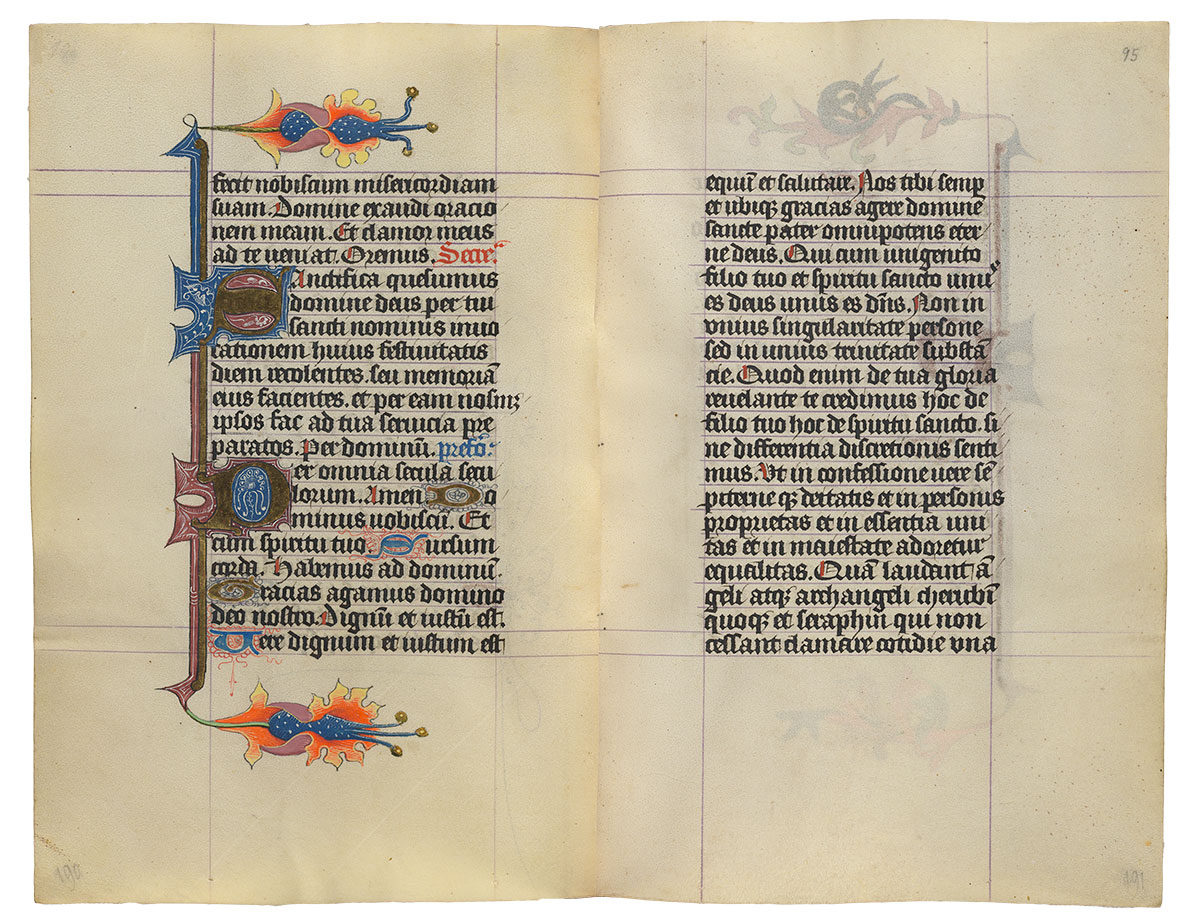
Purchased on the Belle da Costa Greene Fund with the assistance of the Fellows and with special assistance of Mrs. Frederick B. Adams, Sr., Mrs. Robert Charles, Mr. Laurens M. Hamilton, The Heineman Foundation, Mrs. Donald F. Hyde, Mrs. Jacob M. Kaplan, Mrs. John Kean, Mr. Paul Mellon, Mr. and Mrs. Charles F. Morgan, Mr. Lessing J. Rosenwald, Mr. and Mrs. August H. Schilling, Mrs. Herbert N. Straus, Mrs. Landon K. Thorne, Mrs. Alan Valentine, Mr. and Mrs. Arnold Whitridge, and Miss Julia P. Wightman, 1970
Image courtesy of Faksimile Verlag Luzern
MS M.917/945, ff. 95v–96r
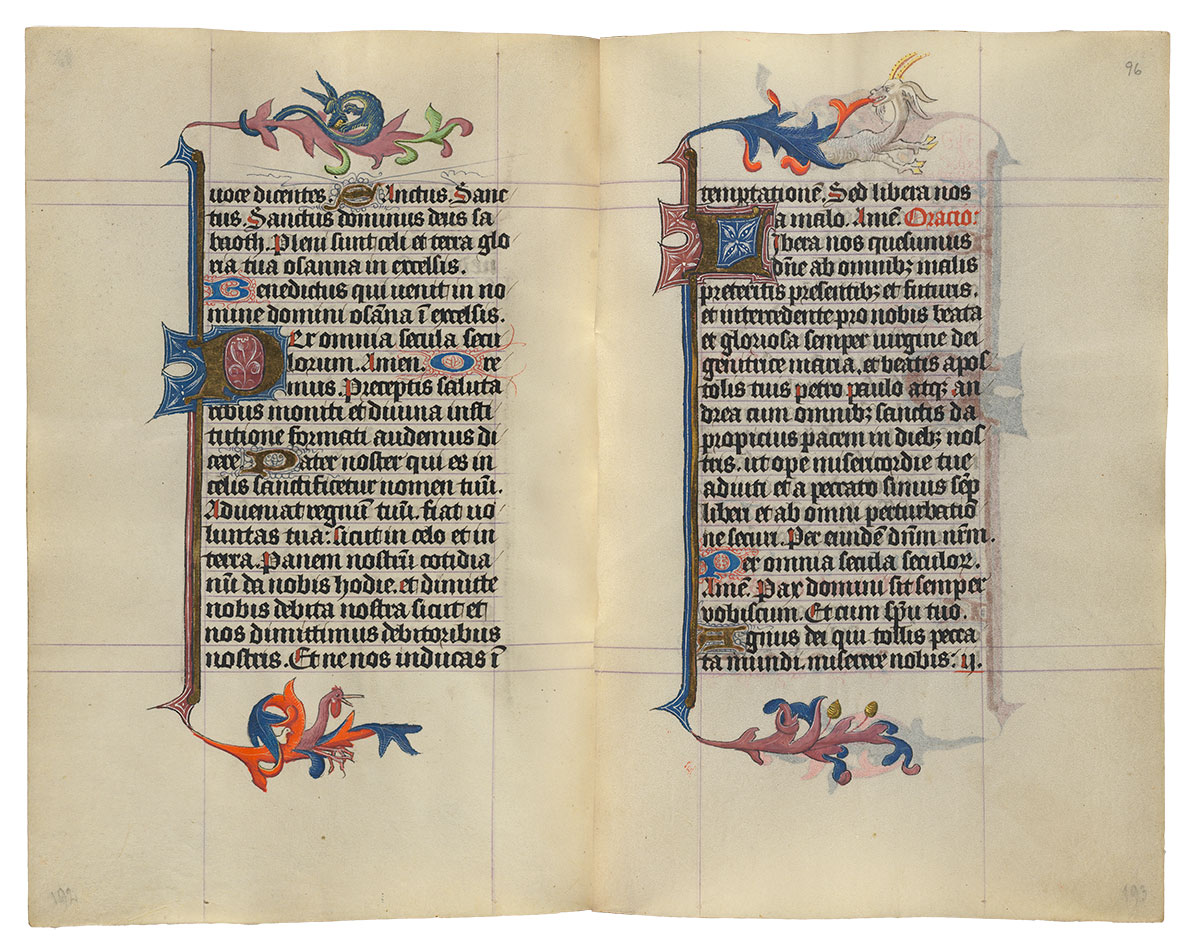
Purchased on the Belle da Costa Greene Fund with the assistance of the Fellows and with special assistance of Mrs. Frederick B. Adams, Sr., Mrs. Robert Charles, Mr. Laurens M. Hamilton, The Heineman Foundation, Mrs. Donald F. Hyde, Mrs. Jacob M. Kaplan, Mrs. John Kean, Mr. Paul Mellon, Mr. and Mrs. Charles F. Morgan, Mr. Lessing J. Rosenwald, Mr. and Mrs. August H. Schilling, Mrs. Herbert N. Straus, Mrs. Landon K. Thorne, Mrs. Alan Valentine, Mr. and Mrs. Arnold Whitridge, and Miss Julia P. Wightman, 1970
Image courtesy of Faksimile Verlag Luzern
MS M.917/945, f. 96v–p. 179
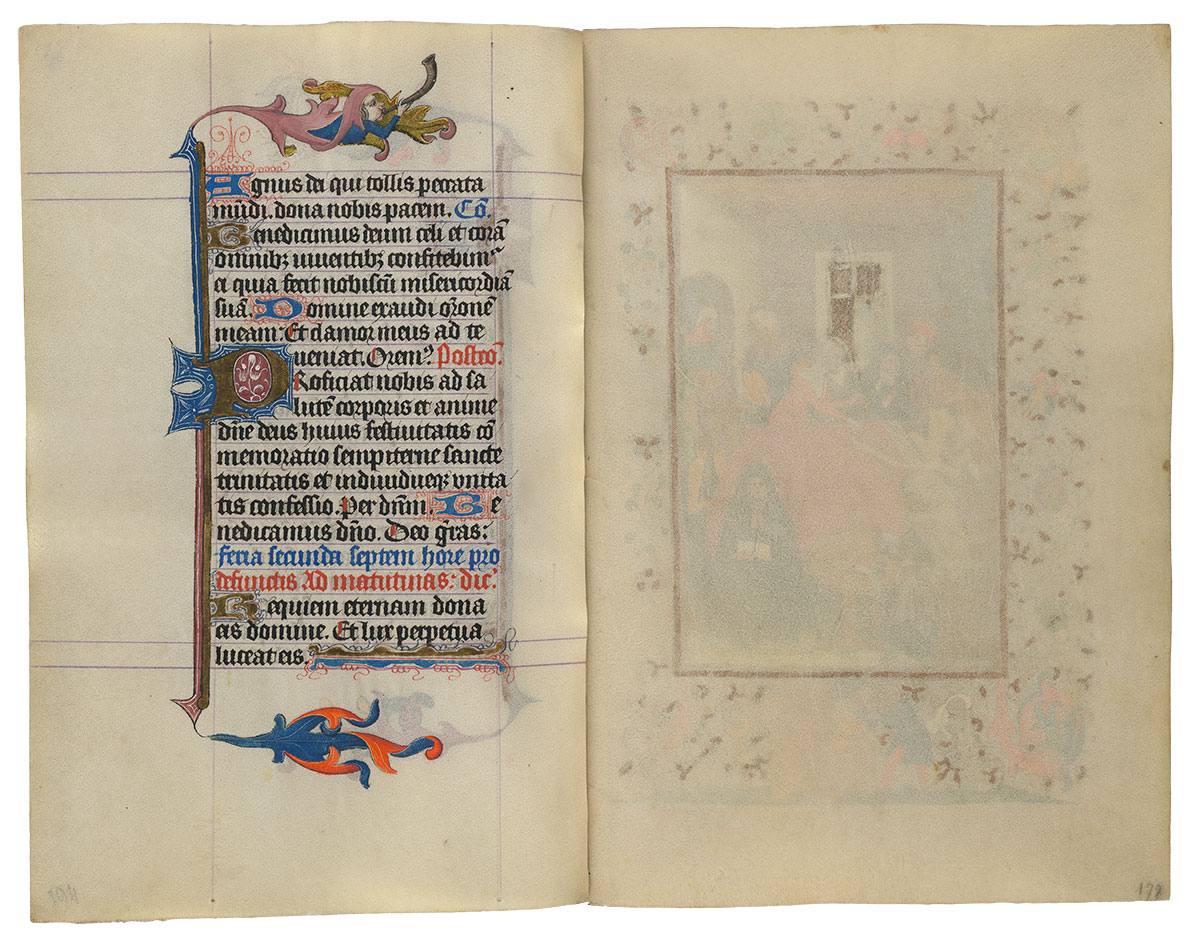
Purchased on the Belle da Costa Greene Fund with the assistance of the Fellows and with special assistance of Mrs. Frederick B. Adams, Sr., Mrs. Robert Charles, Mr. Laurens M. Hamilton, The Heineman Foundation, Mrs. Donald F. Hyde, Mrs. Jacob M. Kaplan, Mrs. John Kean, Mr. Paul Mellon, Mr. and Mrs. Charles F. Morgan, Mr. Lessing J. Rosenwald, Mr. and Mrs. August H. Schilling, Mrs. Herbert N. Straus, Mrs. Landon K. Thorne, Mrs. Alan Valentine, Mr. and Mrs. Arnold Whitridge, and Miss Julia P. Wightman, 1970
Image courtesy of Faksimile Verlag Luzern
MS M.917/945, p. 180–f. 97r
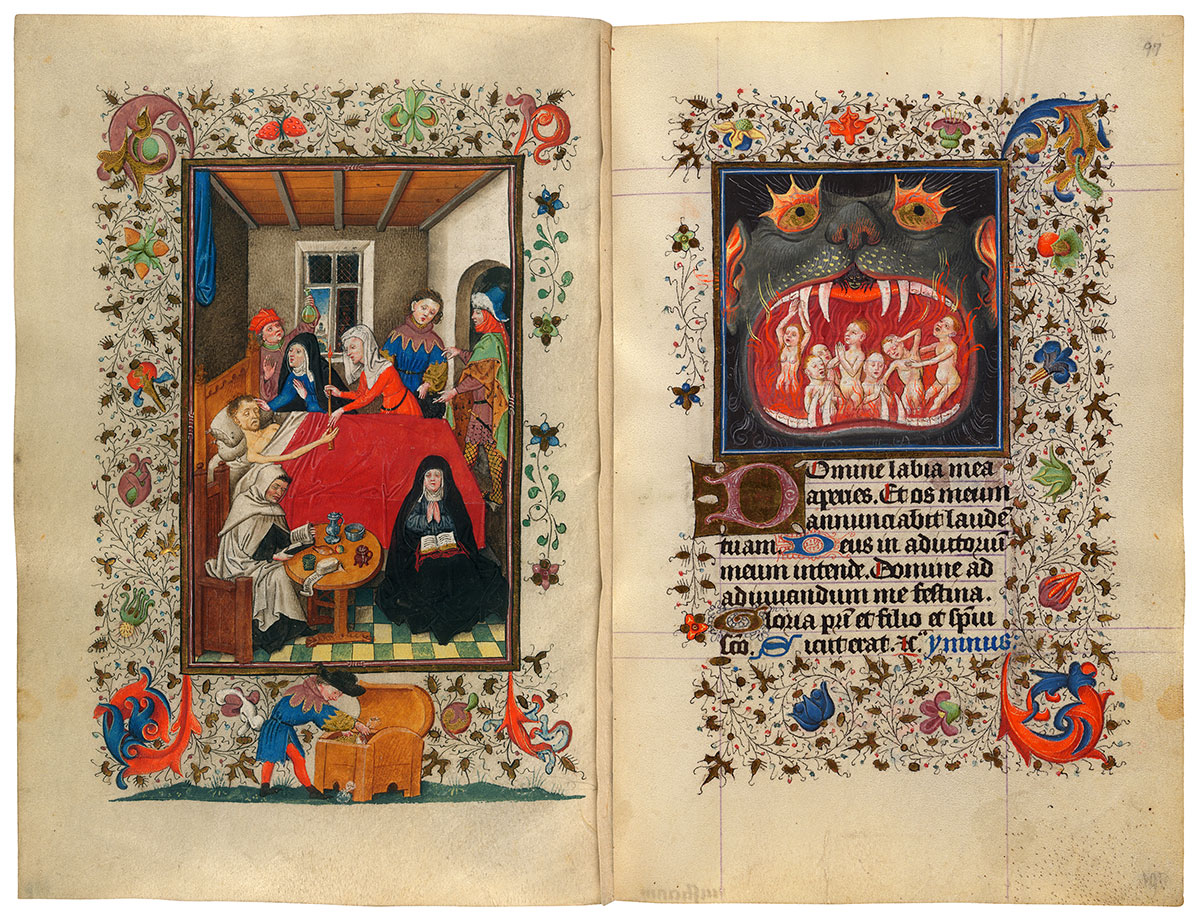
Deathbed
Souls Tormented in Purgatory
Purchased on the Belle da Costa Greene Fund with the assistance of the Fellows, 1963; purchased on the Belle da Costa Greene Fund with the assistance of the Fellows and with special assistance of Mrs. Frederick B. Adams, Sr., Mrs. Robert Charles, Mr. Laurens M. Hamilton, The Heineman Foundation, Mrs. Donald F. Hyde, Mrs. Jacob M. Kaplan, Mrs. John Kean, Mr. Paul Mellon, Mr. and Mrs. Charles F. Morgan, Mr. Lessing J. Rosenwald, Mr. and Mrs. August H. Schilling, Mrs. Herbert N. Straus, Mrs. Landon K. Thorne, Mrs. Alan Valentine, Mr. and Mrs. Arnold Whitridge, and Miss Julia P. Wightman, 1970
The Monday Hours of the Dead open with one of the most famous images from Catherine's manuscript. The deathbed scene is as packed with as much lively action as Puccini's opera Gianni Schicchi. As a man dies, his wife offers him a candle, a doctor examines his urine, and his son conspires against him. This mercenary heir is shown again, raiding his father's coffers in the bottom border. On the right is purgatory, the place to which the dying man hopes to go. There his soul, like those depicted, will be cleansed of sin in expiating, if painful, fire.
Hours and Masses for the Seven Days of the Week
The most unusual texts in Catherine's manuscript are the series of Hours and Masses for every day of the week. Medieval Christian tradition associated certain figures or themes with different days. Thus Sunday, the day of the Resurrection, was the Lord's Day; Thursday was connected with the Eucharist since that sacrament was instituted on Holy Thursday; and Monday was the day of the dead, since their torments were suspended on Sunday but recommenced the following day. In Catherine's prayer book, the themes for the Hours and Masses of the seven days of the week are:
| Sunday | the Trinity |
| Monday | the Dead |
| Tuesday | the Holy Spirit |
| Wednesday | All Saints |
| Thursday | the Blessed Sacrament |
| Friday | the Compassion of God |
| Saturday | the Virgin. |
Image courtesy of Faksimile Verlag Luzern
MS M.917/945, ff. 97v–98r
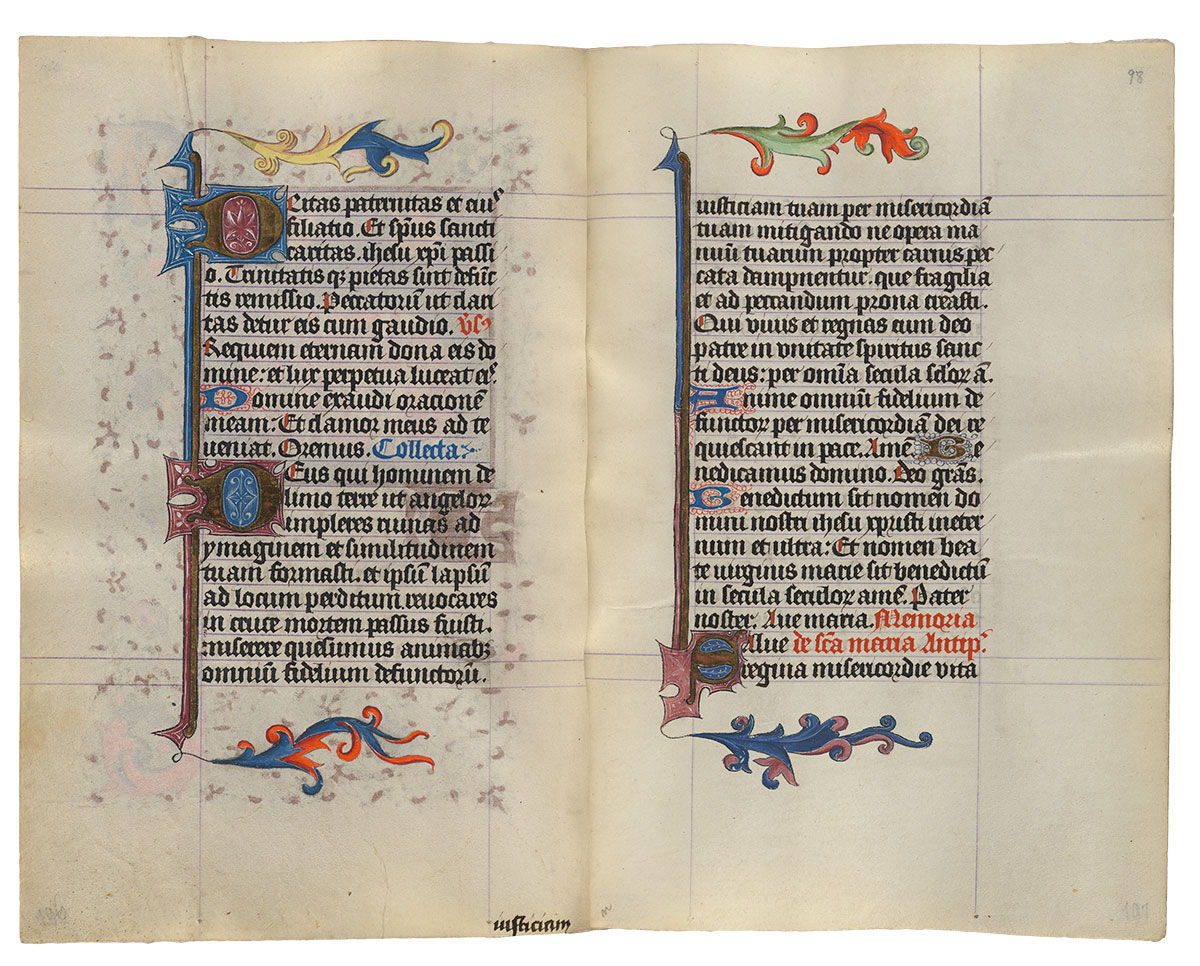
Purchased on the Belle da Costa Greene Fund with the assistance of the Fellows and with special assistance of Mrs. Frederick B. Adams, Sr., Mrs. Robert Charles, Mr. Laurens M. Hamilton, The Heineman Foundation, Mrs. Donald F. Hyde, Mrs. Jacob M. Kaplan, Mrs. John Kean, Mr. Paul Mellon, Mr. and Mrs. Charles F. Morgan, Mr. Lessing J. Rosenwald, Mr. and Mrs. August H. Schilling, Mrs. Herbert N. Straus, Mrs. Landon K. Thorne, Mrs. Alan Valentine, Mr. and Mrs. Arnold Whitridge, and Miss Julia P. Wightman, 1970
Image courtesy of Faksimile Verlag Luzern
MS M.917/945, ff. 102v–103r
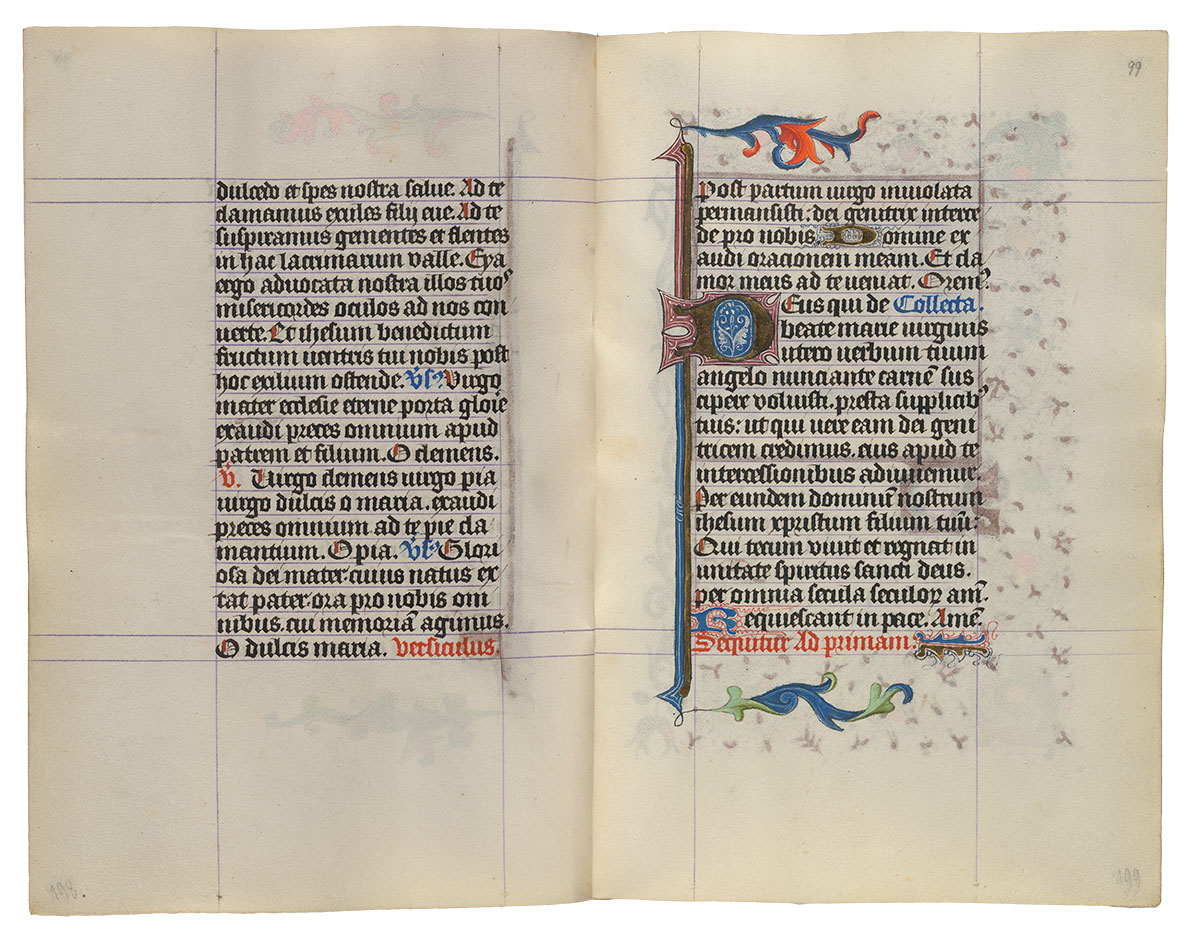
Purchased on the Belle da Costa Greene Fund with the assistance of the Fellows and with special assistance of Mrs. Frederick B. Adams, Sr., Mrs. Robert Charles, Mr. Laurens M. Hamilton, The Heineman Foundation, Mrs. Donald F. Hyde, Mrs. Jacob M. Kaplan, Mrs. John Kean, Mr. Paul Mellon, Mr. and Mrs. Charles F. Morgan, Mr. Lessing J. Rosenwald, Mr. and Mrs. August H. Schilling, Mrs. Herbert N. Straus, Mrs. Landon K. Thorne, Mrs. Alan Valentine, Mr. and Mrs. Arnold Whitridge, and Miss Julia P. Wightman, 1970
Image courtesy of Faksimile Verlag Luzern
MS M.917/945, ff. 99v–100r
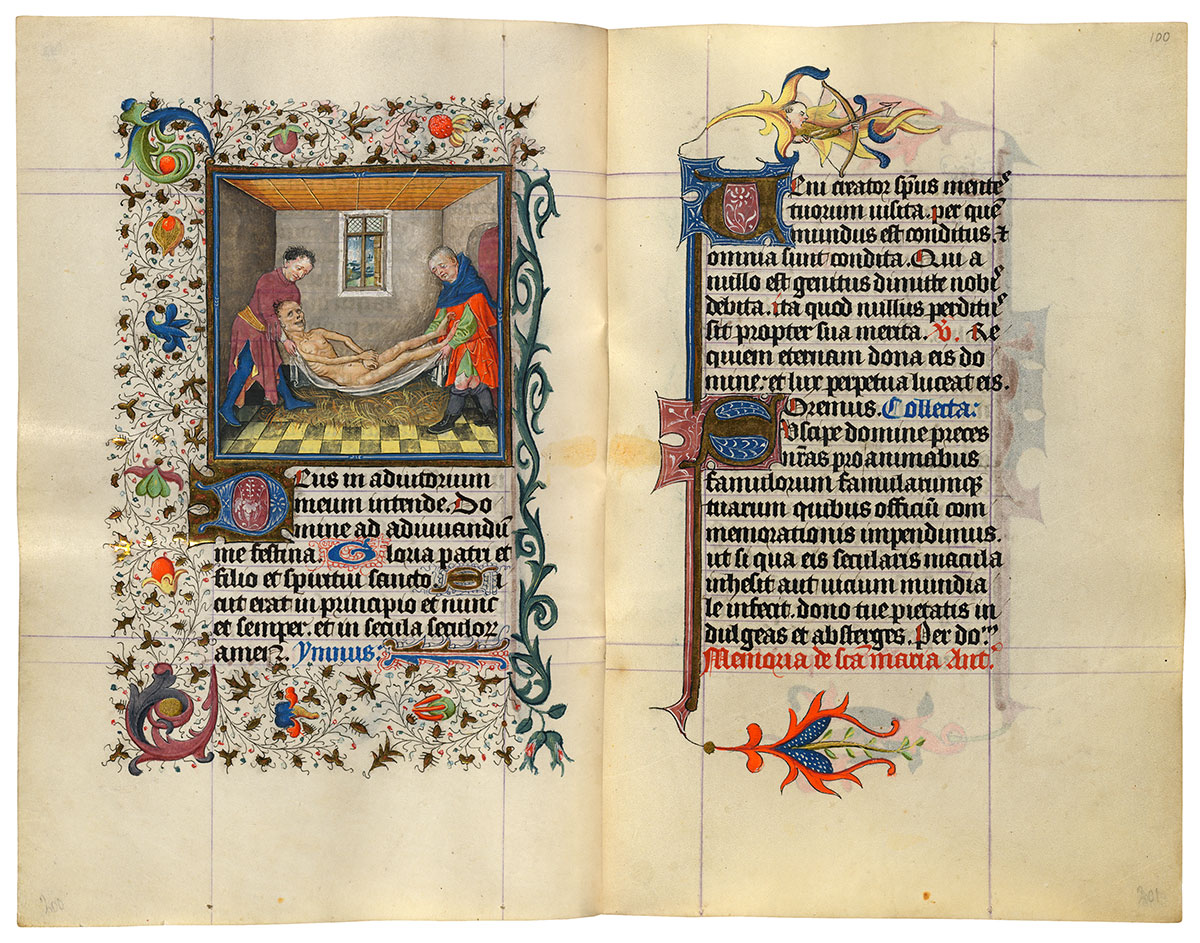
Preparation of the Corpse
Purchased on the Belle da Costa Greene Fund with the assistance of the Fellows and with special assistance of Mrs. Frederick B. Adams, Sr., Mrs. Robert Charles, Mr. Laurens M. Hamilton, The Heineman Foundation, Mrs. Donald F. Hyde, Mrs. Jacob M. Kaplan, Mrs. John Kean, Mr. Paul Mellon, Mr. and Mrs. Charles F. Morgan, Mr. Lessing J. Rosenwald, Mr. and Mrs. August H. Schilling, Mrs. Herbert N. Straus, Mrs. Landon K. Thorne, Mrs. Alan Valentine, Mr. and Mrs. Arnold Whitridge, and Miss Julia P. Wightman, 1970
The man in the previous miniature has died. His corpse is lowered to the floor upon which straw has been spread to absorb any bodily fluids. The dead body will be washed and sewn into a shroud.
Hours and Masses for the Seven Days of the Week
The most unusual texts in Catherine's manuscript are the series of Hours and Masses for every day of the week. Medieval Christian tradition associated certain figures or themes with different days. Thus Sunday, the day of the Resurrection, was the Lord's Day; Thursday was connected with the Eucharist since that sacrament was instituted on Holy Thursday; and Monday was the day of the dead, since their torments were suspended on Sunday but recommenced the following day. In Catherine's prayer book, the themes for the Hours and Masses of the seven days of the week are:
| Sunday | the Trinity |
| Monday | the Dead |
| Tuesday | the Holy Spirit |
| Wednesday | All Saints |
| Thursday | the Blessed Sacrament |
| Friday | the Compassion of God |
| Saturday | the Virgin. |
Image courtesy of Faksimile Verlag Luzern
MS M.917/945, ff. 100v–101r
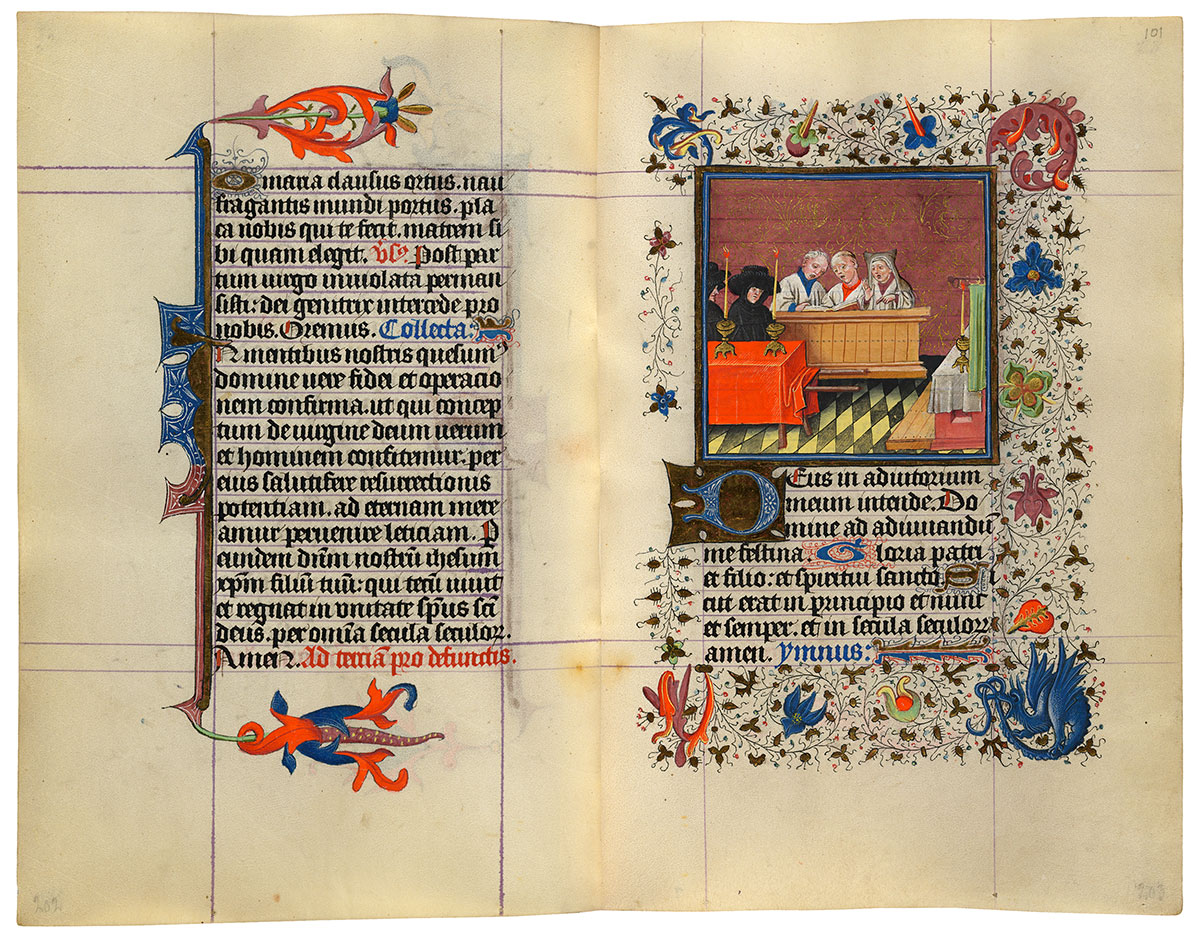
Chanting the Office of the Dead
Purchased on the Belle da Costa Greene Fund with the assistance of the Fellows and with special assistance of Mrs. Frederick B. Adams, Sr., Mrs. Robert Charles, Mr. Laurens M. Hamilton, The Heineman Foundation, Mrs. Donald F. Hyde, Mrs. Jacob M. Kaplan, Mrs. John Kean, Mr. Paul Mellon, Mr. and Mrs. Charles F. Morgan, Mr. Lessing J. Rosenwald, Mr. and Mrs. August H. Schilling, Mrs. Herbert N. Straus, Mrs. Landon K. Thorne, Mrs. Alan Valentine, Mr. and Mrs. Arnold Whitridge, and Miss Julia P. Wightman, 1970
Hours and Masses for the Seven Days of the Week
The most unusual texts in Catherine's manuscript are the series of Hours and Masses for every day of the week. Medieval Christian tradition associated certain figures or themes with different days. Thus Sunday, the day of the Resurrection, was the Lord's Day; Thursday was connected with the Eucharist since that sacrament was instituted on Holy Thursday; and Monday was the day of the dead, since their torments were suspended on Sunday but recommenced the following day. In Catherine's prayer book, the themes for the Hours and Masses of the seven days of the week are:
| Sunday | the Trinity |
| Monday | the Dead |
| Tuesday | the Holy Spirit |
| Wednesday | All Saints |
| Thursday | the Blessed Sacrament |
| Friday | the Compassion of God |
| Saturday | the Virgin. |
Image courtesy of Faksimile Verlag Luzern
MS M.917/945, ff. 101v–102r
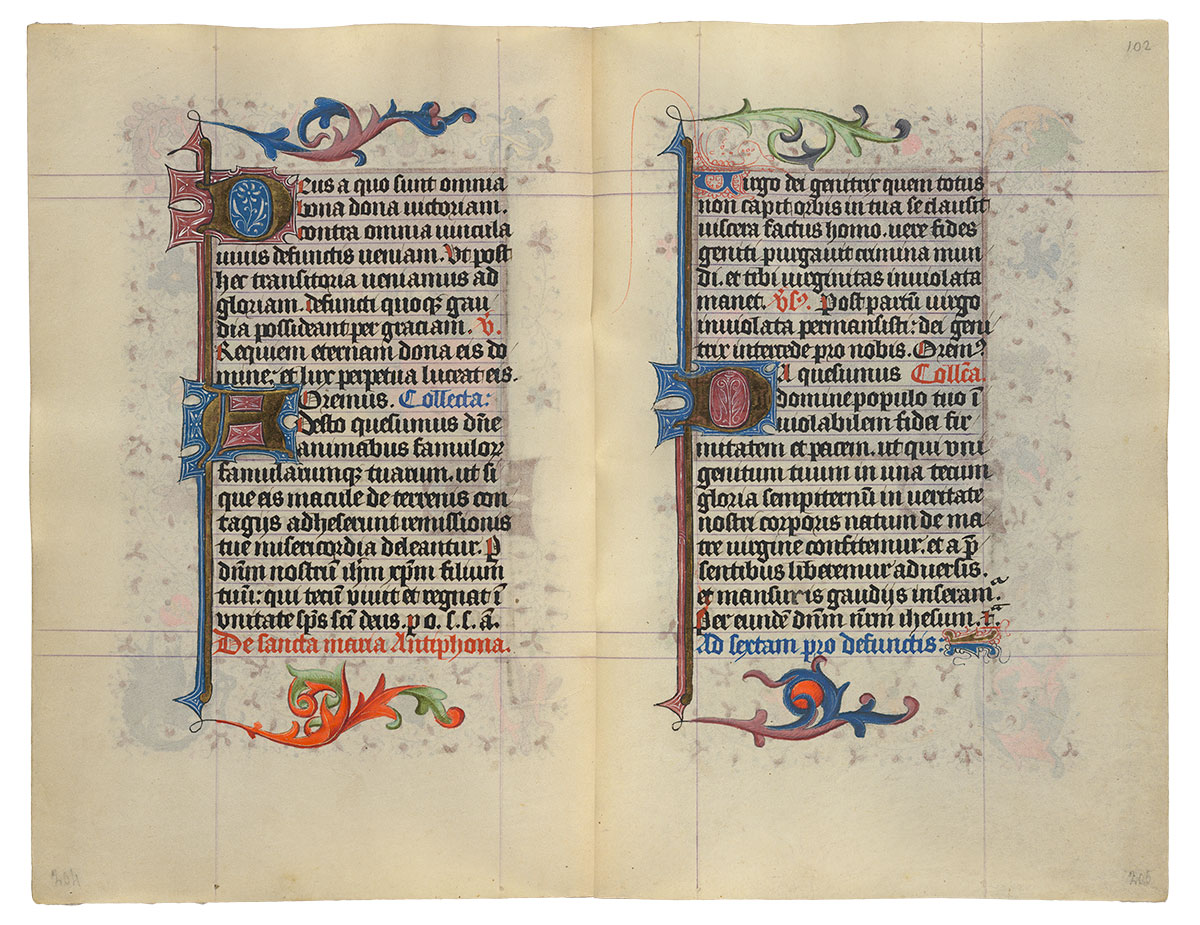
Purchased on the Belle da Costa Greene Fund with the assistance of the Fellows and with special assistance of Mrs. Frederick B. Adams, Sr., Mrs. Robert Charles, Mr. Laurens M. Hamilton, The Heineman Foundation, Mrs. Donald F. Hyde, Mrs. Jacob M. Kaplan, Mrs. John Kean, Mr. Paul Mellon, Mr. and Mrs. Charles F. Morgan, Mr. Lessing J. Rosenwald, Mr. and Mrs. August H. Schilling, Mrs. Herbert N. Straus, Mrs. Landon K. Thorne, Mrs. Alan Valentine, Mr. and Mrs. Arnold Whitridge, and Miss Julia P. Wightman, 1970
Image courtesy of Faksimile Verlag Luzern
MS M.917/945, ff. 102v–103r
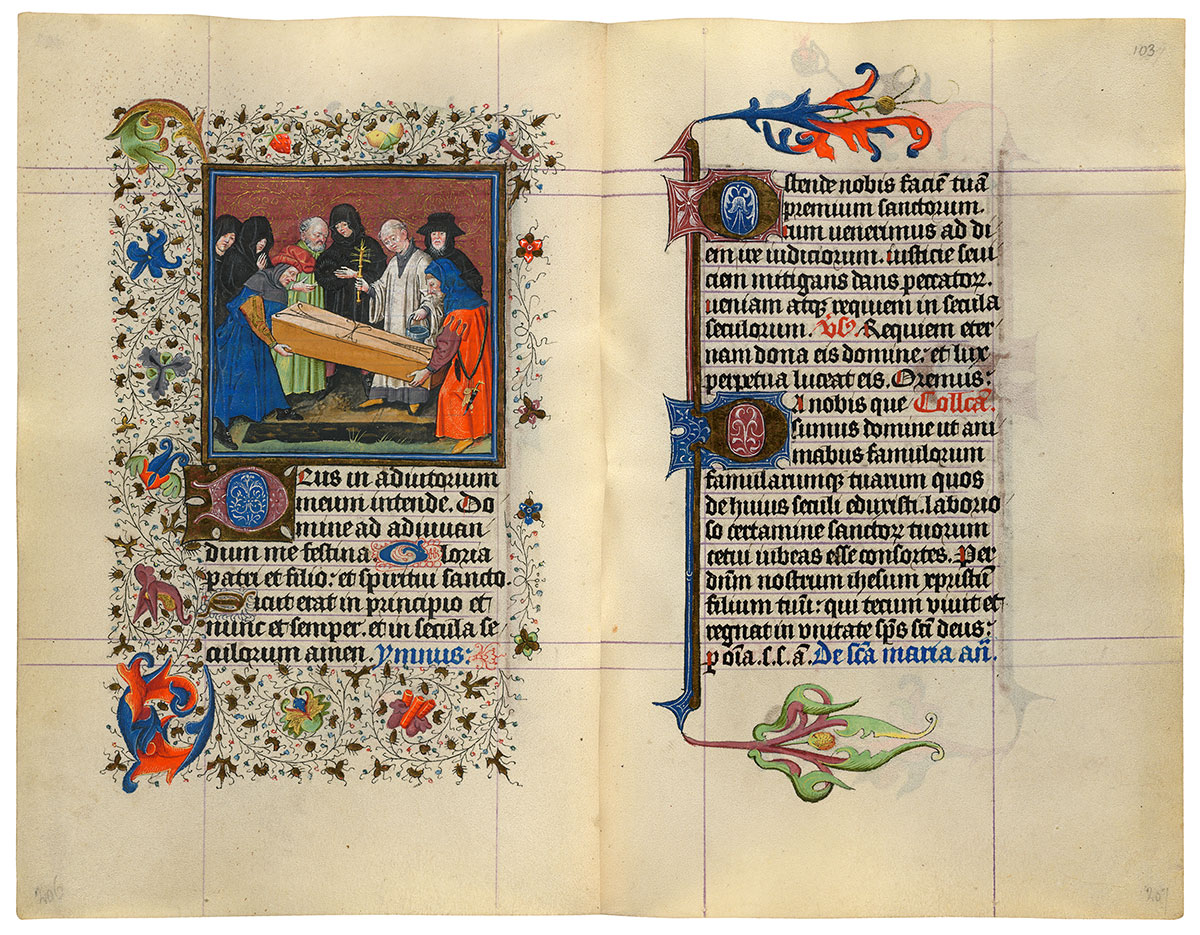
Burial
Purchased on the Belle da Costa Greene Fund with the assistance of the Fellows and with special assistance of Mrs. Frederick B. Adams, Sr., Mrs. Robert Charles, Mr. Laurens M. Hamilton, The Heineman Foundation, Mrs. Donald F. Hyde, Mrs. Jacob M. Kaplan, Mrs. John Kean, Mr. Paul Mellon, Mr. and Mrs. Charles F. Morgan, Mr. Lessing J. Rosenwald, Mr. and Mrs. August H. Schilling, Mrs. Herbert N. Straus, Mrs. Landon K. Thorne, Mrs. Alan Valentine, Mr. and Mrs. Arnold Whitridge, and Miss Julia P. Wightman, 1970
While the priest offers a final blessing of holy water, the man's body, in a wood coffin decorated with a black cross, is lowered into the grave. During the Middle Ages, however, most people were not buried in coffins; they were put in the ground protected only by a shroud. (Most graves were not permanent but a temporary place of rest until one's bones were cleansed of their rotten flesh.) The depiction of a coffin burial in this miniature might have been in keeping with Catherine's own funerary expectations.
Hours and Masses for the Seven Days of the Week
The most unusual texts in Catherine's manuscript are the series of Hours and Masses for every day of the week. Medieval Christian tradition associated certain figures or themes with different days. Thus Sunday, the day of the Resurrection, was the Lord's Day; Thursday was connected with the Eucharist since that sacrament was instituted on Holy Thursday; and Monday was the day of the dead, since their torments were suspended on Sunday but recommenced the following day. In Catherine's prayer book, the themes for the Hours and Masses of the seven days of the week are:
| Sunday | the Trinity |
| Monday | the Dead |
| Tuesday | the Holy Spirit |
| Wednesday | All Saints |
| Thursday | the Blessed Sacrament |
| Friday | the Compassion of God |
| Saturday | the Virgin. |
Image courtesy of Faksimile Verlag Luzern
MS M.917/945, ff. 103v–104r
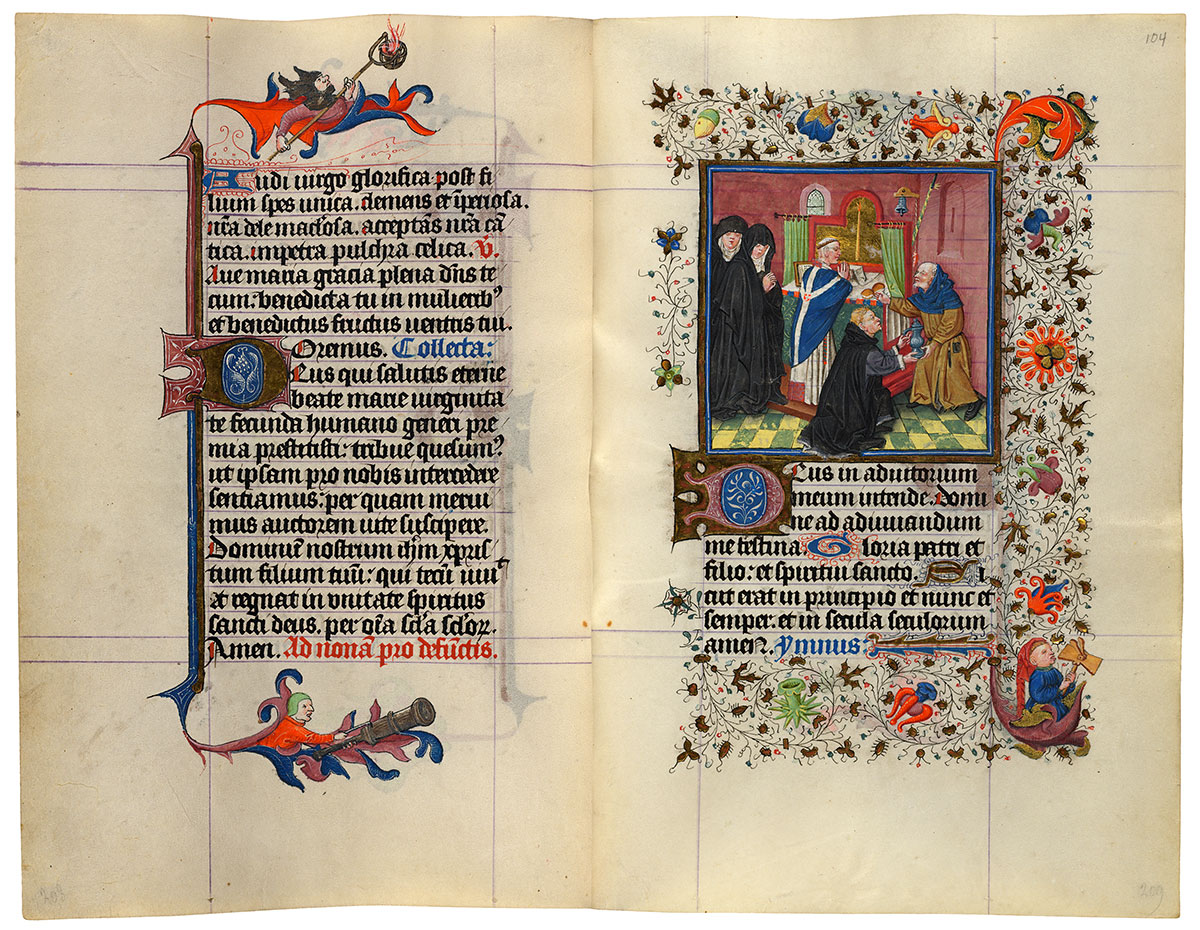
Offering at a Requiem Mass
Purchased on the Belle da Costa Greene Fund with the assistance of the Fellows and with special assistance of Mrs. Frederick B. Adams, Sr., Mrs. Robert Charles, Mr. Laurens M. Hamilton, The Heineman Foundation, Mrs. Donald F. Hyde, Mrs. Jacob M. Kaplan, Mrs. John Kean, Mr. Paul Mellon, Mr. and Mrs. Charles F. Morgan, Mr. Lessing J. Rosenwald, Mr. and Mrs. August H. Schilling, Mrs. Herbert N. Straus, Mrs. Landon K. Thorne, Mrs. Alan Valentine, Mr. and Mrs. Arnold Whitridge, and Miss Julia P. Wightman, 1970
Hours and Masses for the Seven Days of the Week
The most unusual texts in Catherine's manuscript are the series of Hours and Masses for every day of the week. Medieval Christian tradition associated certain figures or themes with different days. Thus Sunday, the day of the Resurrection, was the Lord's Day; Thursday was connected with the Eucharist since that sacrament was instituted on Holy Thursday; and Monday was the day of the dead, since their torments were suspended on Sunday but recommenced the following day. In Catherine's prayer book, the themes for the Hours and Masses of the seven days of the week are:
| Sunday | the Trinity |
| Monday | the Dead |
| Tuesday | the Holy Spirit |
| Wednesday | All Saints |
| Thursday | the Blessed Sacrament |
| Friday | the Compassion of God |
| Saturday | the Virgin. |
Image courtesy of Faksimile Verlag Luzern
MS M.917/945, ff. 104v–105r
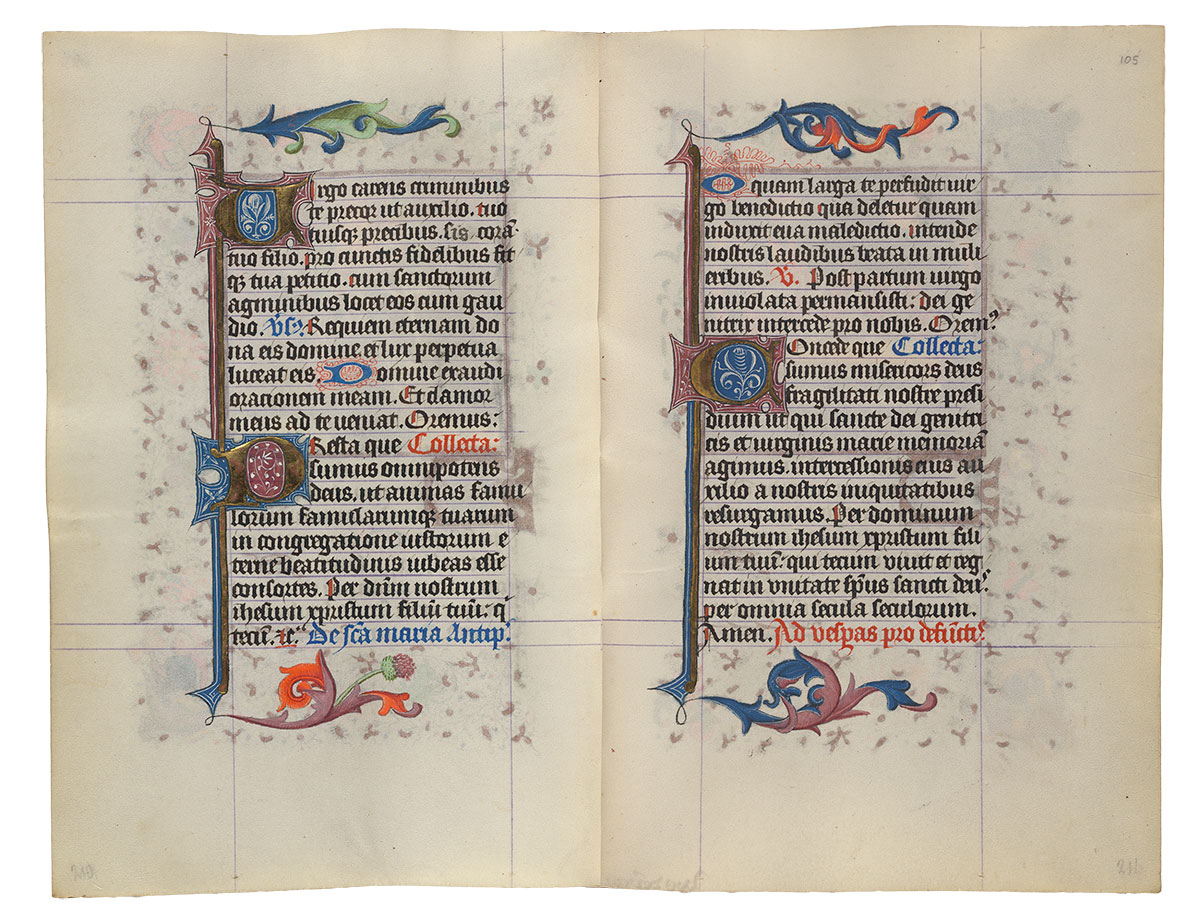
Purchased on the Belle da Costa Greene Fund with the assistance of the Fellows and with special assistance of Mrs. Frederick B. Adams, Sr., Mrs. Robert Charles, Mr. Laurens M. Hamilton, The Heineman Foundation, Mrs. Donald F. Hyde, Mrs. Jacob M. Kaplan, Mrs. John Kean, Mr. Paul Mellon, Mr. and Mrs. Charles F. Morgan, Mr. Lessing J. Rosenwald, Mr. and Mrs. August H. Schilling, Mrs. Herbert N. Straus, Mrs. Landon K. Thorne, Mrs. Alan Valentine, Mr. and Mrs. Arnold Whitridge, and Miss Julia P. Wightman, 1970
Image courtesy of Faksimile Verlag Luzern
MS M.917/945, ff. 105v–106r
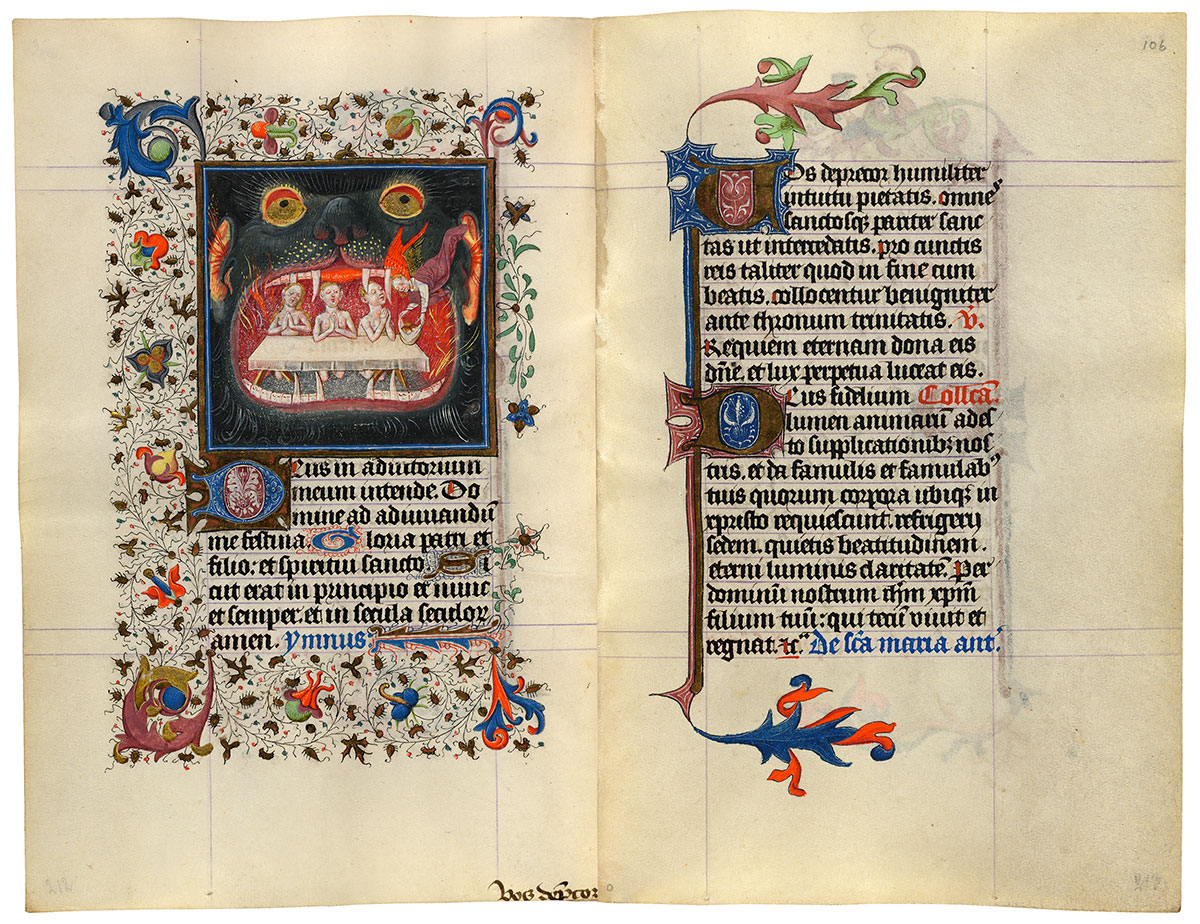
Souls in Purgatory Consoled with the Offering
Purchased on the Belle da Costa Greene Fund with the assistance of the Fellows and with special assistance of Mrs. Frederick B. Adams, Sr., Mrs. Robert Charles, Mr. Laurens M. Hamilton, The Heineman Foundation, Mrs. Donald F. Hyde, Mrs. Jacob M. Kaplan, Mrs. John Kean, Mr. Paul Mellon, Mr. and Mrs. Charles F. Morgan, Mr. Lessing J. Rosenwald, Mr. and Mrs. August H. Schilling, Mrs. Herbert N. Straus, Mrs. Landon K. Thorne, Mrs. Alan Valentine, Mr. and Mrs. Arnold Whitridge, and Miss Julia P. Wightman, 1970
Hours and Masses for the Seven Days of the Week
The most unusual texts in Catherine's manuscript are the series of Hours and Masses for every day of the week. Medieval Christian tradition associated certain figures or themes with different days. Thus Sunday, the day of the Resurrection, was the Lord's Day; Thursday was connected with the Eucharist since that sacrament was instituted on Holy Thursday; and Monday was the day of the dead, since their torments were suspended on Sunday but recommenced the following day. In Catherine's prayer book, the themes for the Hours and Masses of the seven days of the week are:
| Sunday | the Trinity |
| Monday | the Dead |
| Tuesday | the Holy Spirit |
| Wednesday | All Saints |
| Thursday | the Blessed Sacrament |
| Friday | the Compassion of God |
| Saturday | the Virgin. |
Image courtesy of Faksimile Verlag Luzern
MS M.917/945, ff. 106v–107r
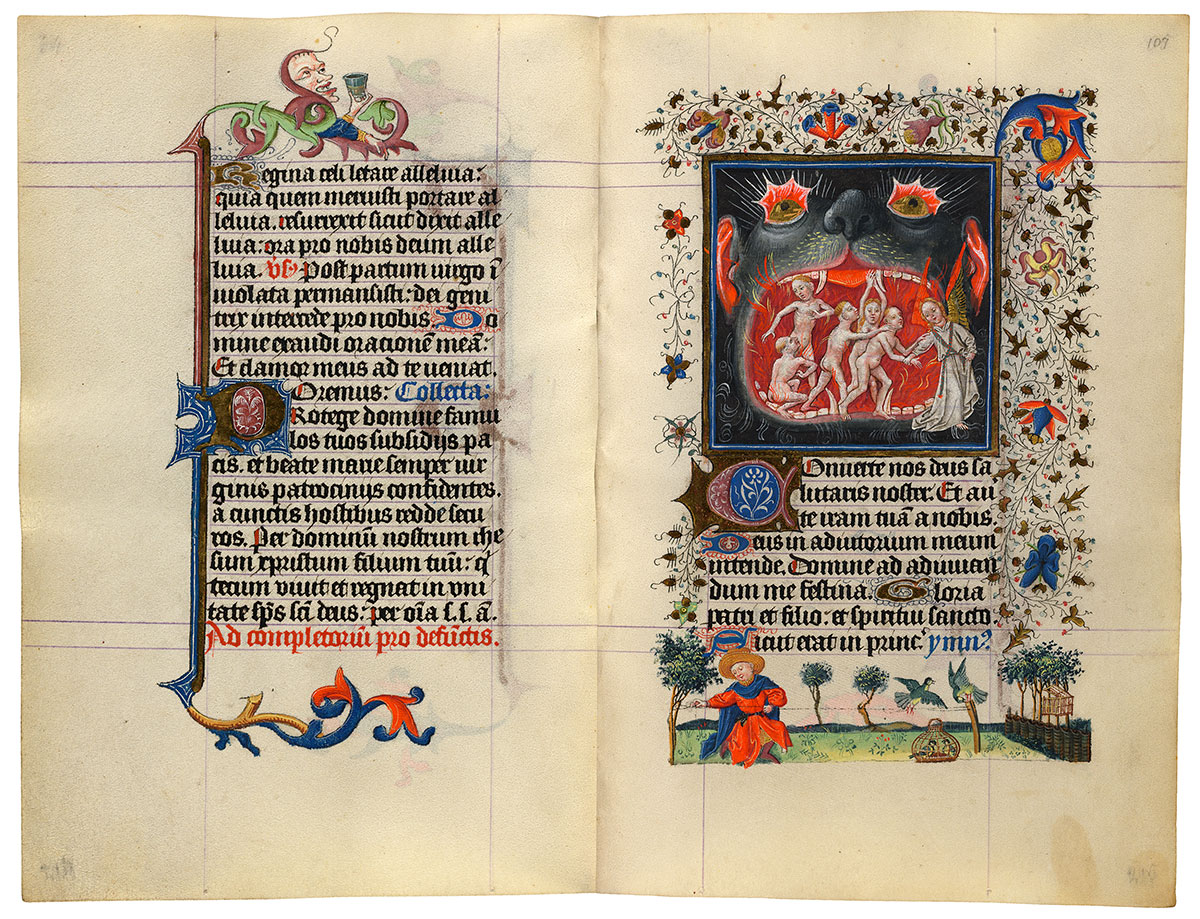
Souls Released from Purgatory
Purchased on the Belle da Costa Greene Fund with the assistance of the Fellows and with special assistance of Mrs. Frederick B. Adams, Sr., Mrs. Robert Charles, Mr. Laurens M. Hamilton, The Heineman Foundation, Mrs. Donald F. Hyde, Mrs. Jacob M. Kaplan, Mrs. John Kean, Mr. Paul Mellon, Mr. and Mrs. Charles F. Morgan, Mr. Lessing J. Rosenwald, Mr. and Mrs. August H. Schilling, Mrs. Herbert N. Straus, Mrs. Landon K. Thorne, Mrs. Alan Valentine, Mr. and Mrs. Arnold Whitridge, and Miss Julia P. Wightman, 1970
The Monday Hours of the Dead end on this happy note. Indeed, this miniature for the final Hour of Compline depicts the whole point of praying the Hours of the Dead: shortening the time spent by one's friends and relatives in the fires of purgatory. An angel leads an overjoyed group of naked souls from their fiery torment. In the bottom border, the vignette of a man caging birds is a secular counterpoint to the miniature's religious theme.
Hours and Masses for the Seven Days of the Week
The most unusual texts in Catherine's manuscript are the series of Hours and Masses for every day of the week. Medieval Christian tradition associated certain figures or themes with different days. Thus Sunday, the day of the Resurrection, was the Lord's Day; Thursday was connected with the Eucharist since that sacrament was instituted on Holy Thursday; and Monday was the day of the dead, since their torments were suspended on Sunday but recommenced the following day. In Catherine's prayer book, the themes for the Hours and Masses of the seven days of the week are:
| Sunday | the Trinity |
| Monday | the Dead |
| Tuesday | the Holy Spirit |
| Wednesday | All Saints |
| Thursday | the Blessed Sacrament |
| Friday | the Compassion of God |
| Saturday | the Virgin. |
Image courtesy of Faksimile Verlag Luzern
MS M.917/945, ff. 107v–108r
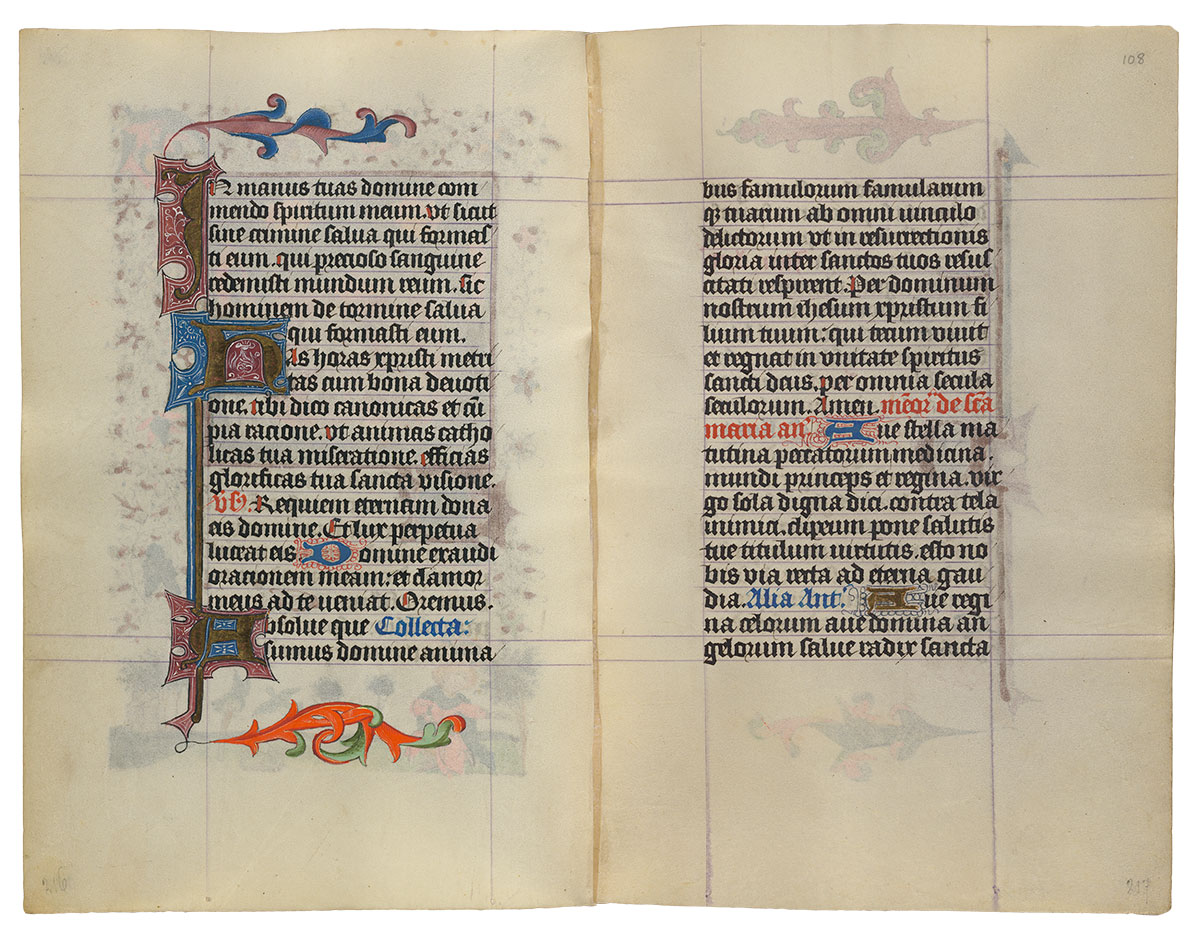
Purchased on the Belle da Costa Greene Fund with the assistance of the Fellows and with special assistance of Mrs. Frederick B. Adams, Sr., Mrs. Robert Charles, Mr. Laurens M. Hamilton, The Heineman Foundation, Mrs. Donald F. Hyde, Mrs. Jacob M. Kaplan, Mrs. John Kean, Mr. Paul Mellon, Mr. and Mrs. Charles F. Morgan, Mr. Lessing J. Rosenwald, Mr. and Mrs. August H. Schilling, Mrs. Herbert N. Straus, Mrs. Landon K. Thorne, Mrs. Alan Valentine, Mr. and Mrs. Arnold Whitridge, and Miss Julia P. Wightman, 1970
Image courtesy of Faksimile Verlag Luzern
MSS M.917/945, f. 108v–p. 29
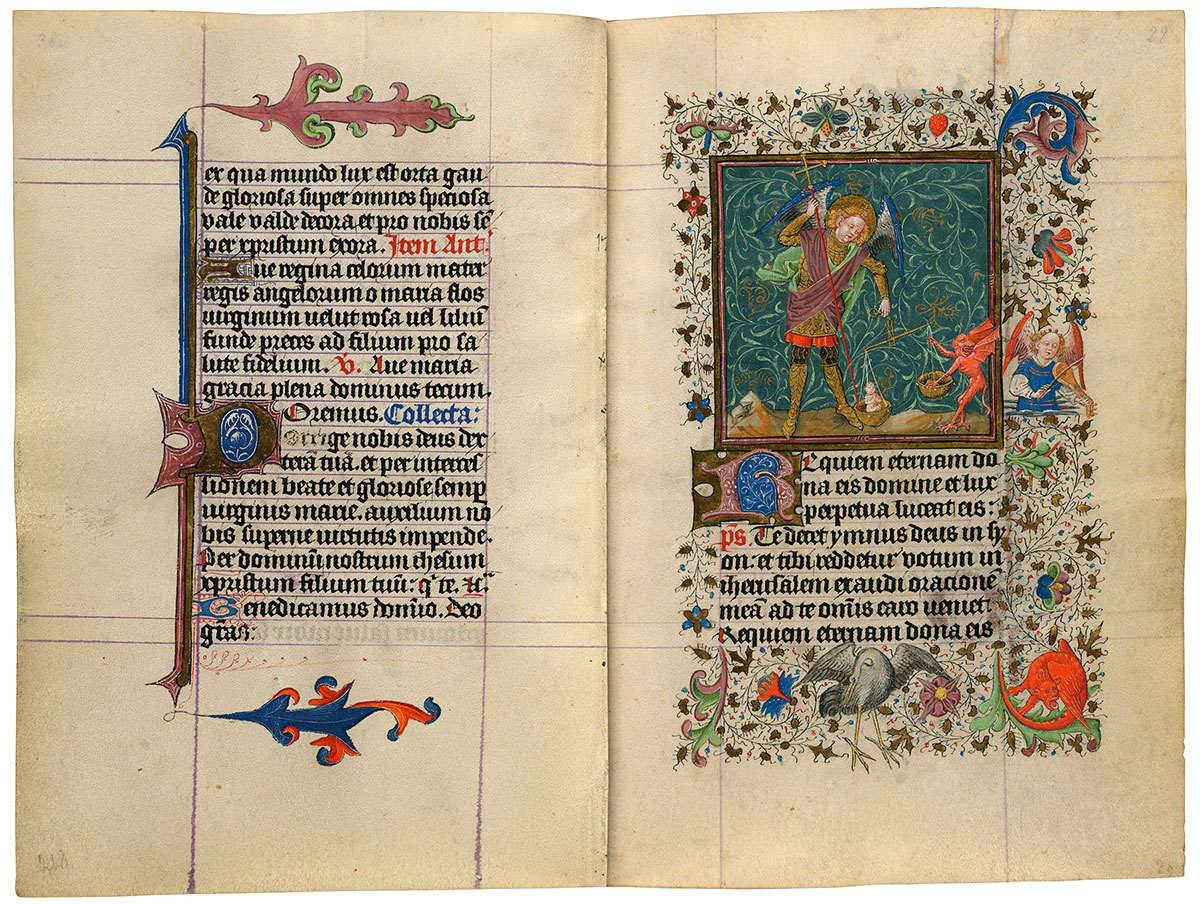
St. Michael Weighing Souls
Purchased on the Belle da Costa Greene Fund with the assistance of the Fellows and with special assistance of Mrs. Frederick B. Adams, Sr., Mrs. Robert Charles, Mr. Laurens M. Hamilton, The Heineman Foundation, Mrs. Donald F. Hyde, Mrs. Jacob M. Kaplan, Mrs. John Kean, Mr. Paul Mellon, Mr. and Mrs. Charles F. Morgan, Mr. Lessing J. Rosenwald, Mr. and Mrs. August H. Schilling, Mrs. Herbert N. Straus, Mrs. Landon K. Thorne, Mrs. Alan Valentine, Mr. and Mrs. Arnold Whitridge, and Miss Julia P. Wightman, 1970; purchased on the Belle da Costa Greene Fund with the assistance of the Fellows, 1963
The large miniature that introduced the Mass of the Dead is lost. Its smaller miniature survives and is shown here. The Archangel Michael is the weigher of souls at the Last Judgment. A naked soul sits in the sinking left cup of the scales, heavy with his goodness. An orange demon attempts to alter the outcome by pulling down on the other cup. Michael's judicious observations ensure the pious man's heavenly reward, which is alluded to by the music-making angel in the right border (to the dismay of the hissing monster at the lower right).
Hours and Masses for the Seven Days of the Week
The most unusual texts in Catherine's manuscript are the series of Hours and Masses for every day of the week. Medieval Christian tradition associated certain figures or themes with different days. Thus Sunday, the day of the Resurrection, was the Lord's Day; Thursday was connected with the Eucharist since that sacrament was instituted on Holy Thursday; and Monday was the day of the dead, since their torments were suspended on Sunday but recommenced the following day. In Catherine's prayer book, the themes for the Hours and Masses of the seven days of the week are:
| Sunday | the Trinity |
| Monday | the Dead |
| Tuesday | the Holy Spirit |
| Wednesday | All Saints |
| Thursday | the Blessed Sacrament |
| Friday | the Compassion of God |
| Saturday | the Virgin. |
Image courtesy of Faksimile Verlag Luzern
MS M.917/945, pp. 30–31
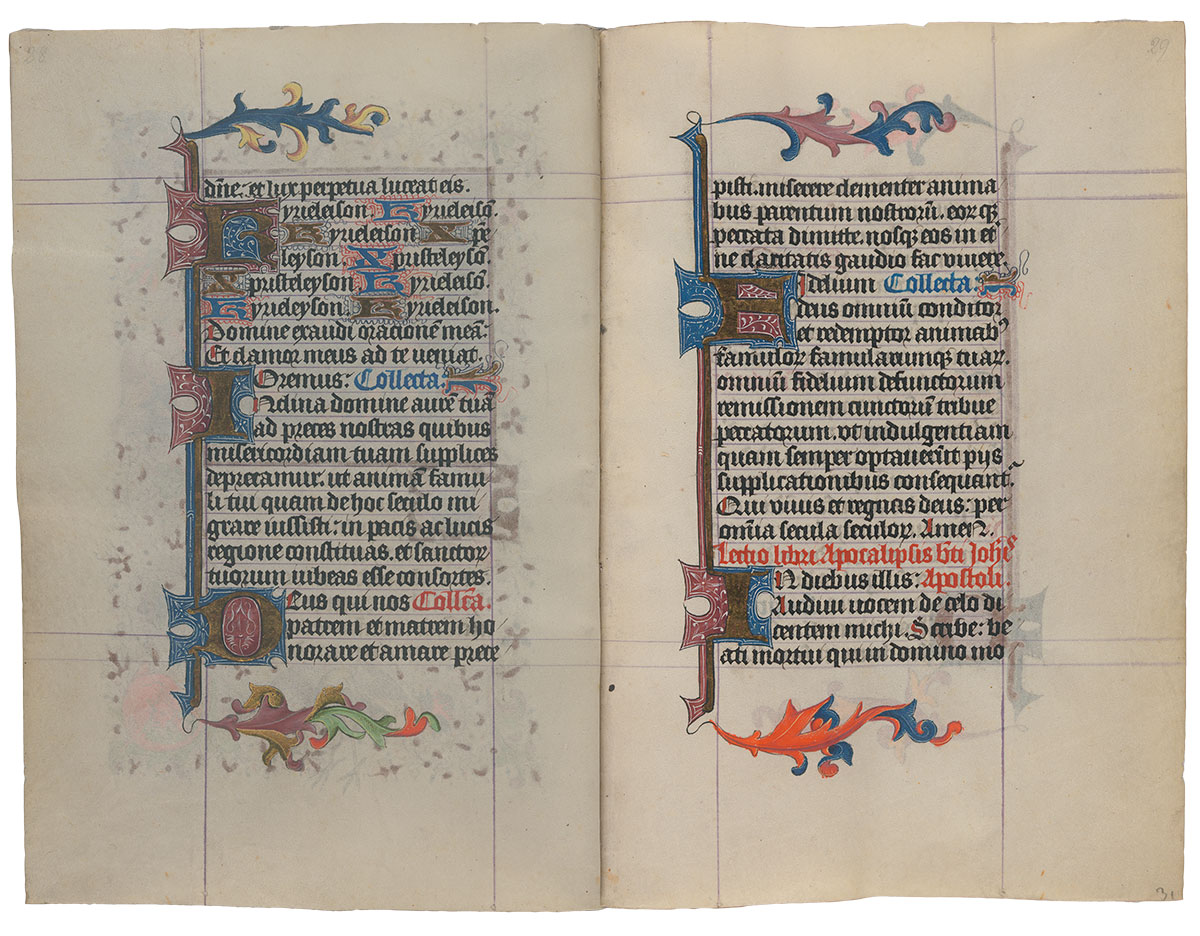
Purchased on the Belle da Costa Greene Fund with the assistance of the Fellows, 1963
Image courtesy of Faksimile Verlag Luzern
MS M.917/945, pp. 32–33
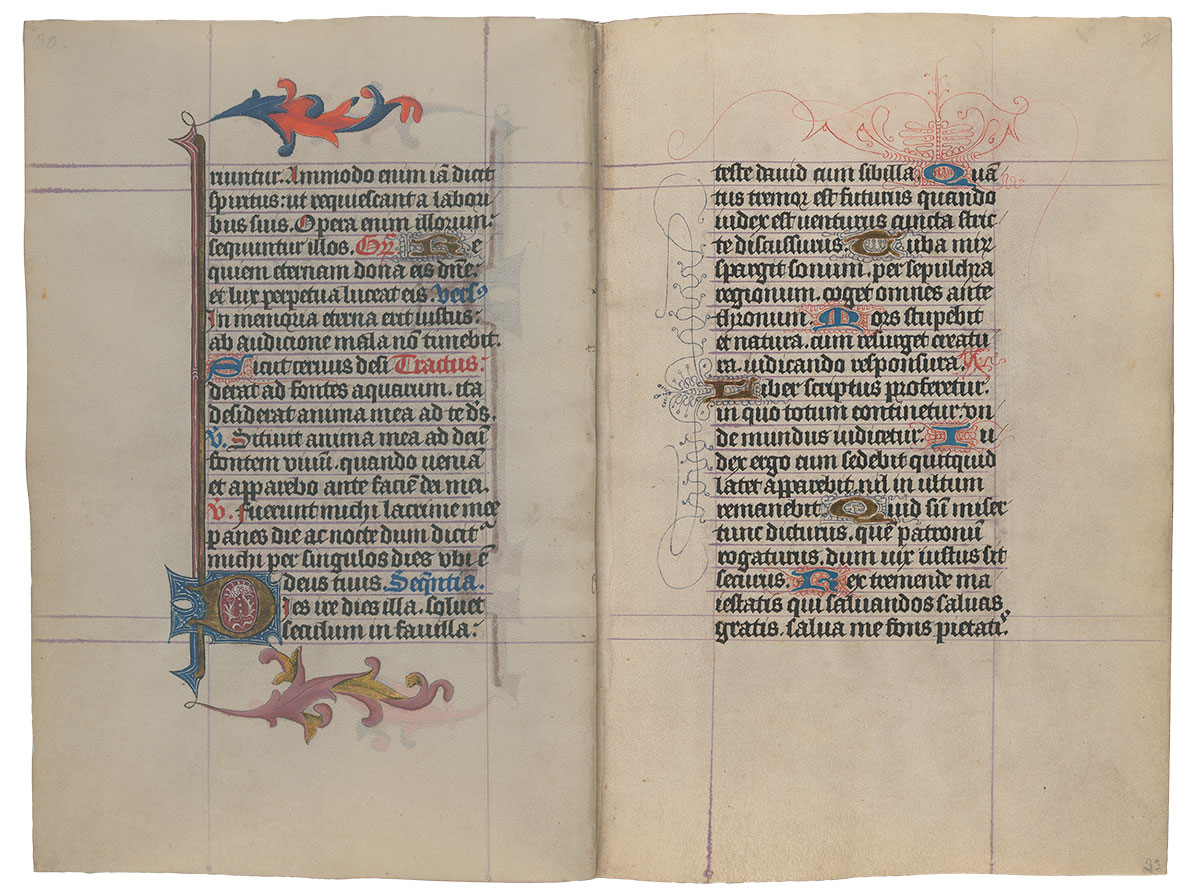
Purchased on the Belle da Costa Greene Fund with the assistance of the Fellows, 1963
Image courtesy of Faksimile Verlag Luzern
MS M.917/945, pp. 34–45
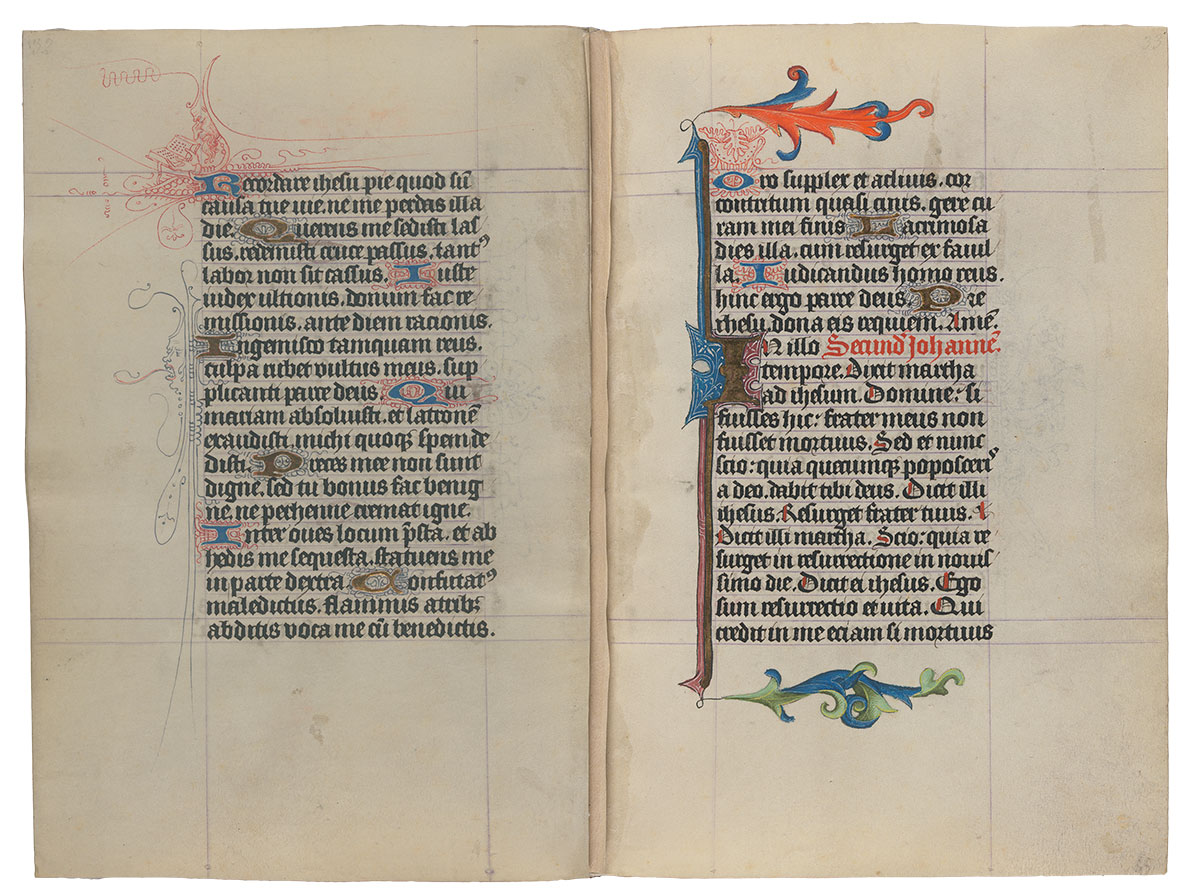
Purchased on the Belle da Costa Greene Fund with the assistance of the Fellows, 1963
Image courtesy of Faksimile Verlag Luzern
MS M.917/945, pp. 46–47
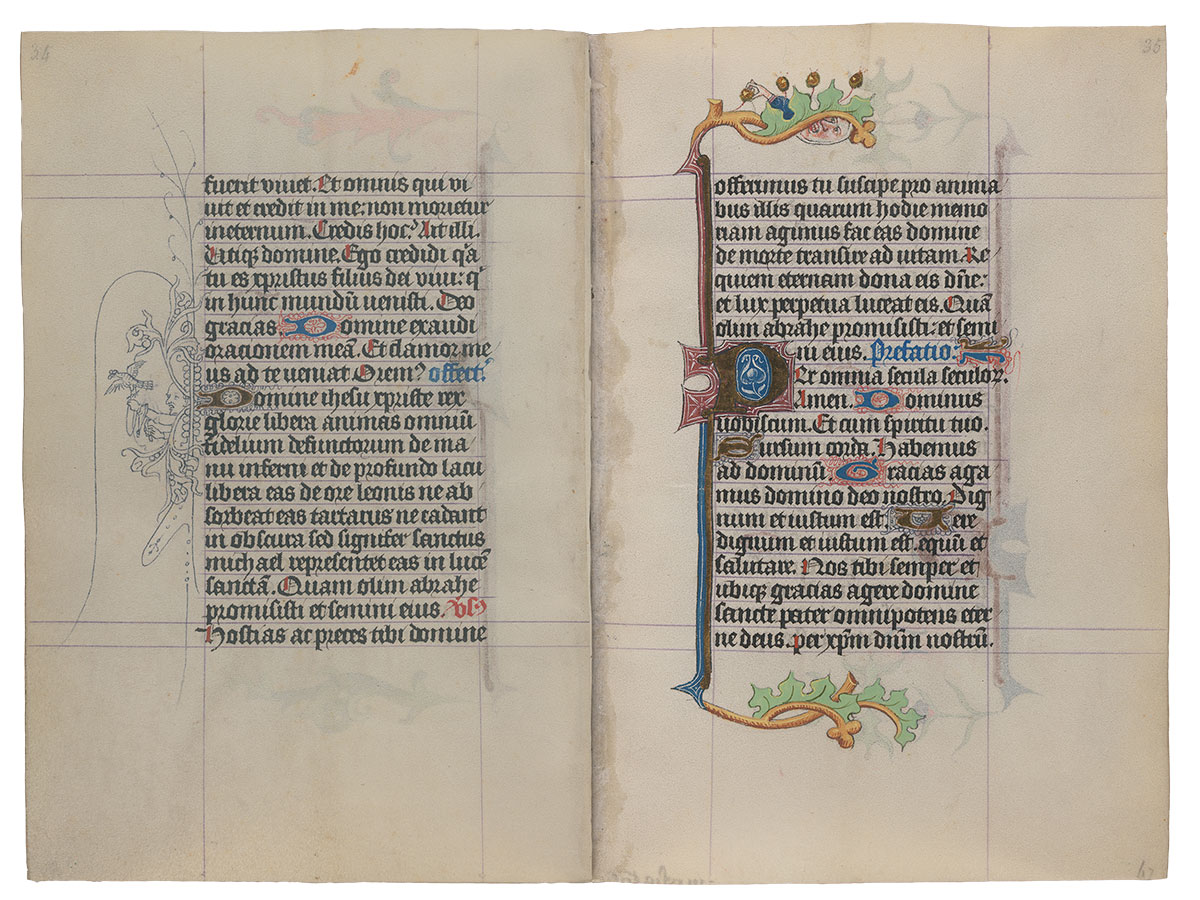
Purchased on the Belle da Costa Greene Fund with the assistance of the Fellows, 1963
Image courtesy of Faksimile Verlag Luzern
MS M.917/945, pp. 48–49
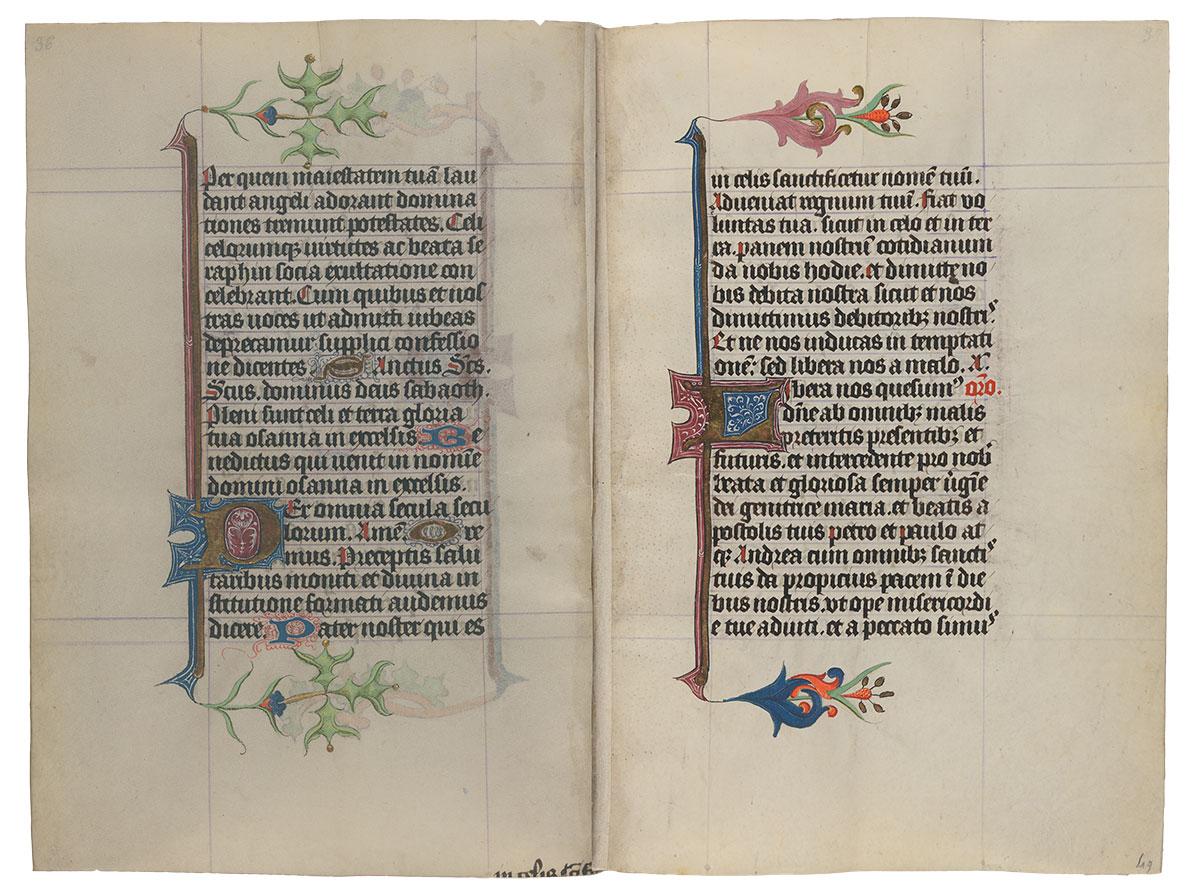
Purchased on the Belle da Costa Greene Fund with the assistance of the Fellows, 1963
Image courtesy of Faksimile Verlag Luzern
MS M.917/945, pp. 50–51
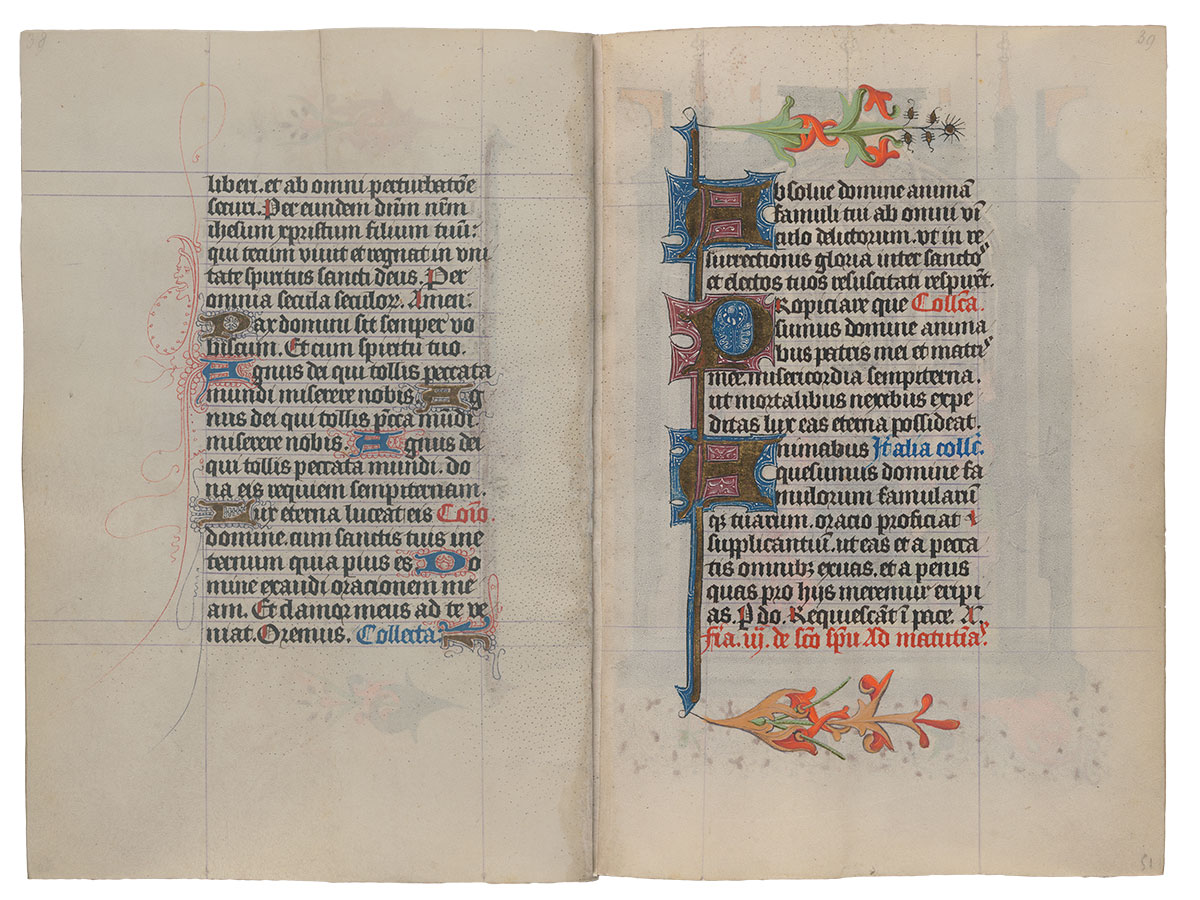
Purchased on the Belle da Costa Greene Fund with the assistance of the Fellows, 1963
Image courtesy of Faksimile Verlag Luzern
MS M.917/945, pp. 52–53
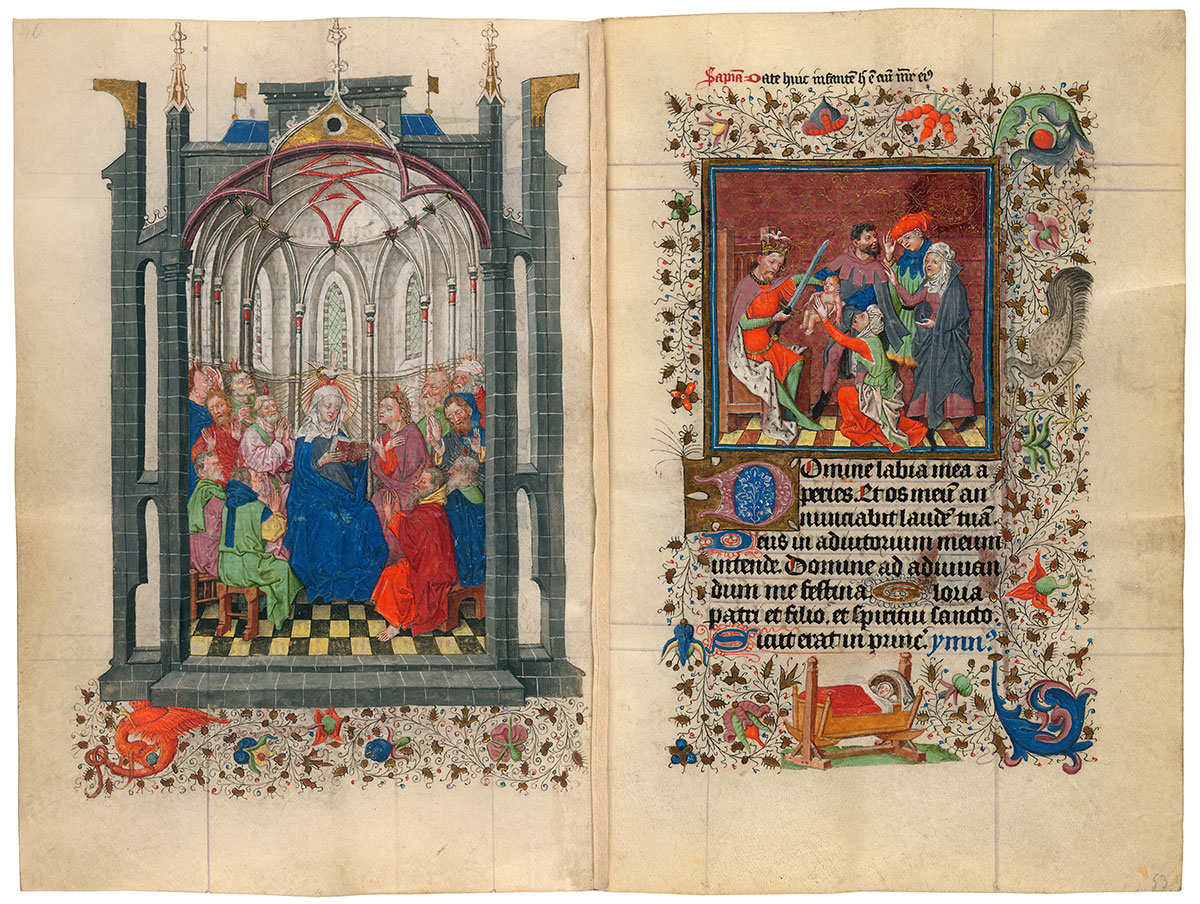
Pentecost
Judgment of Solomon
Purchased on the Belle da Costa Greene Fund with the assistance of the Fellows, 1963
The Tuesday Hours of the Holy Spirit begin with these juxtaposed images. On the left is Pentecost, the descent of the Holy Spirit upon the apostles, who were then inspired to convert the world. The smaller miniature illustrates the first of the Seven Gifts of the Holy Spirit. Wisdom, the first gift, is illustrated by Solomon's sagacity in determining the true mother of a disputed child by threatening to cut the baby in two. (The baby's real mother renounces her claim, raising her hand to prevent the strike of the sword.) The happy resolution of the dispute is illustrated
in the bottom border.
Hours and Masses for the Seven Days of the Week
The most unusual texts in Catherine's manuscript are the series of Hours and Masses for every day of the week. Medieval Christian tradition associated certain figures or themes with different days. Thus Sunday, the day of the Resurrection, was the Lord's Day; Thursday was connected with the Eucharist since that sacrament was instituted on Holy Thursday; and Monday was the day of the dead, since their torments were suspended on Sunday but recommenced the following day. In Catherine's prayer book, the themes for the Hours and Masses of the seven days of the week are:
| Sunday | the Trinity |
| Monday | the Dead |
| Tuesday | the Holy Spirit |
| Wednesday | All Saints |
| Thursday | the Blessed Sacrament |
| Friday | the Compassion of God |
| Saturday | the Virgin. |
Image courtesy of Faksimile Verlag Luzern
MS M.917/945, pp. 54–55
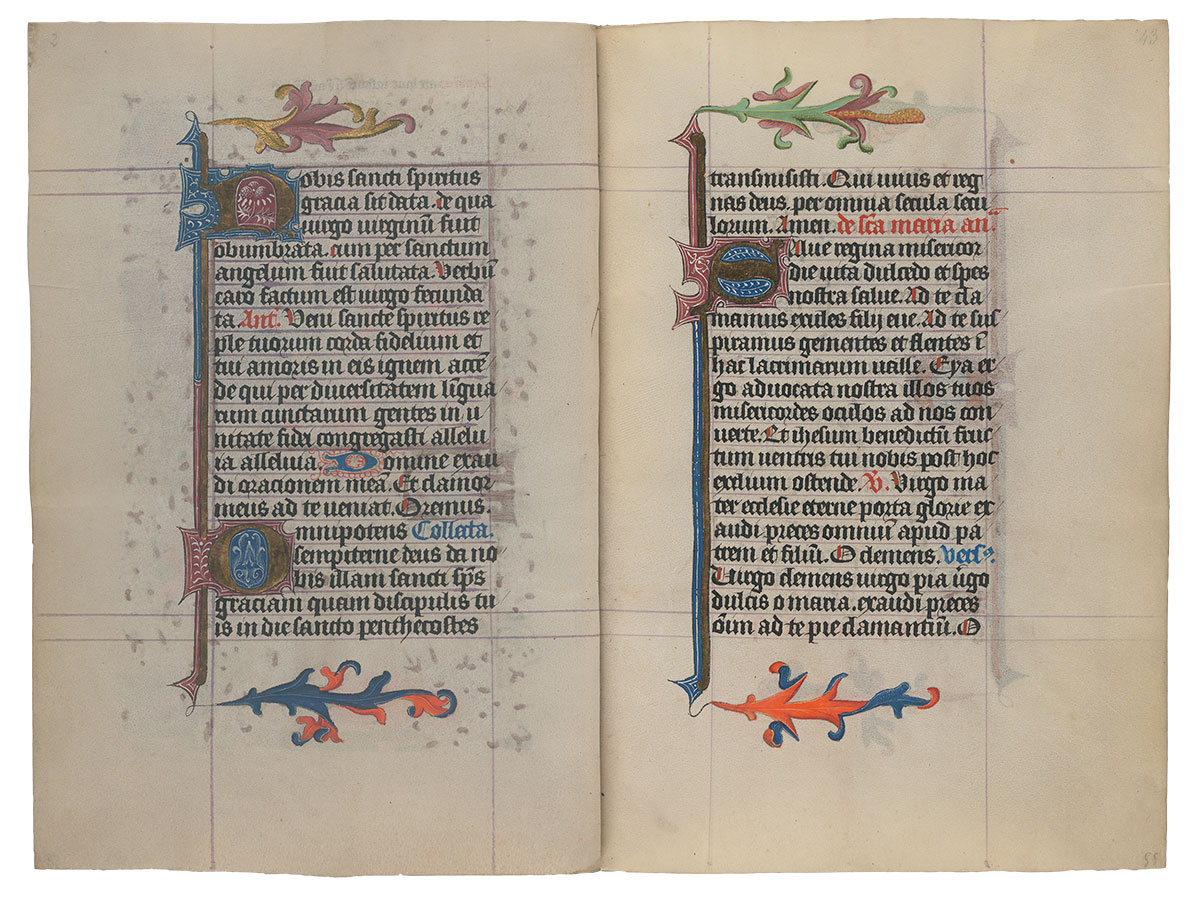
Purchased on the Belle da Costa Greene Fund with the assistance of the Fellows, 1963
Image courtesy of Faksimile Verlag Luzern
MS M.917/945, pp. 56–57
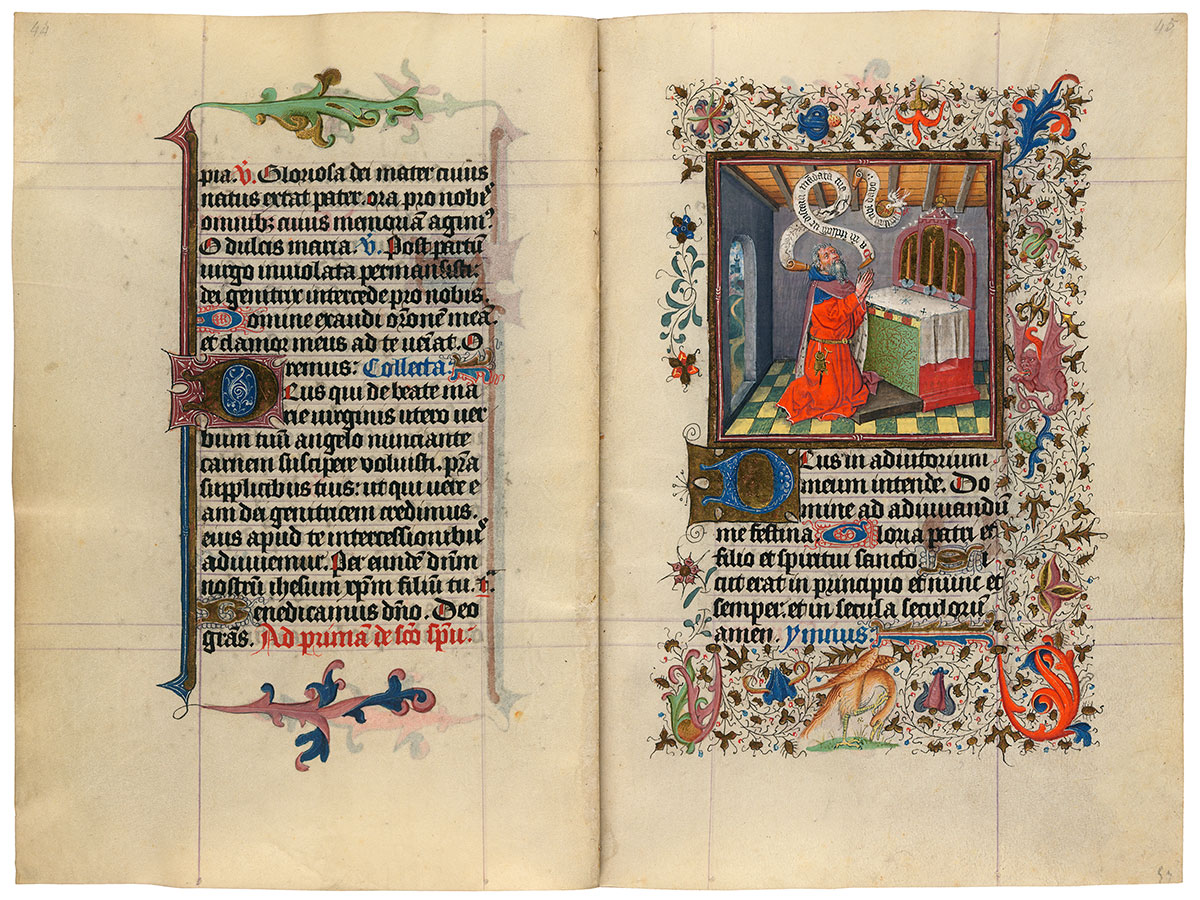
David (?) Praying Before an Altar
Purchased on the Belle da Costa Greene Fund with the assistance of the Fellows, 1963
Understanding, the second gift of the Holy Spirit, is illustrated by a man, most probably meant to be King David, who kneels before a significantly empty altar. His scroll paraphrases Psalm 118, verse 34: "Give me understanding that I may learn your commandments." The Dove of the Holy Spirit answers his petition positively, "I shall give you understanding."
Hours and Masses for the Seven Days of the Week
The most unusual texts in Catherine's manuscript are the series of Hours and Masses for every day of the week. Medieval Christian tradition associated certain figures or themes with different days. Thus Sunday, the day of the Resurrection, was the Lord's Day; Thursday was connected with the Eucharist since that sacrament was instituted on Holy Thursday; and Monday was the day of the dead, since their torments were suspended on Sunday but recommenced the following day. In Catherine's prayer book, the themes for the Hours and Masses of the seven days of the week are:
| Sunday | the Trinity |
| Monday | the Dead |
| Tuesday | the Holy Spirit |
| Wednesday | All Saints |
| Thursday | the Blessed Sacrament |
| Friday | the Compassion of God |
| Saturday | the Virgin. |
Image courtesy of Faksimile Verlag Luzern
MS M.917/945, pp. 58–59
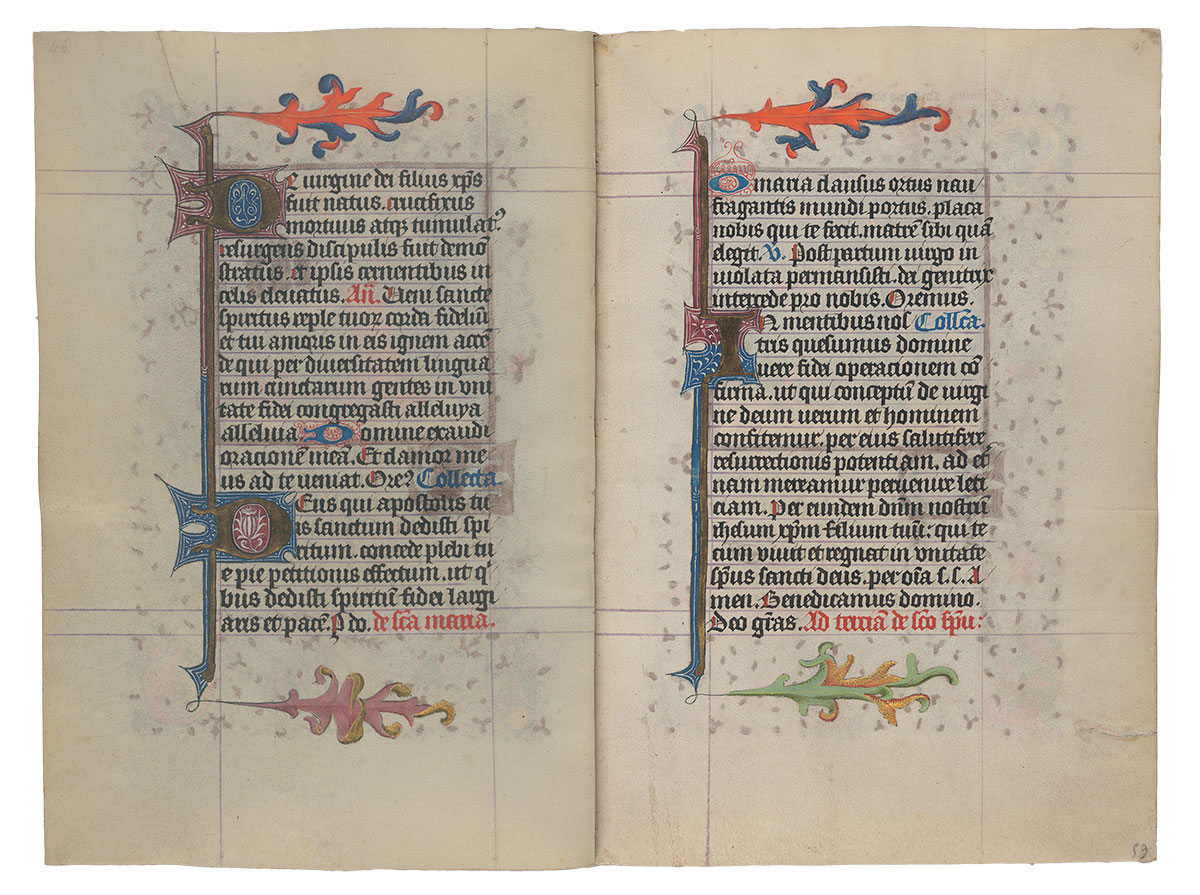
Purchased on the Belle da Costa Greene Fund with the assistance of the Fellows, 1963
Image courtesy of Faksimile Verlag Luzern
MS M.917/945, pp. 60–35
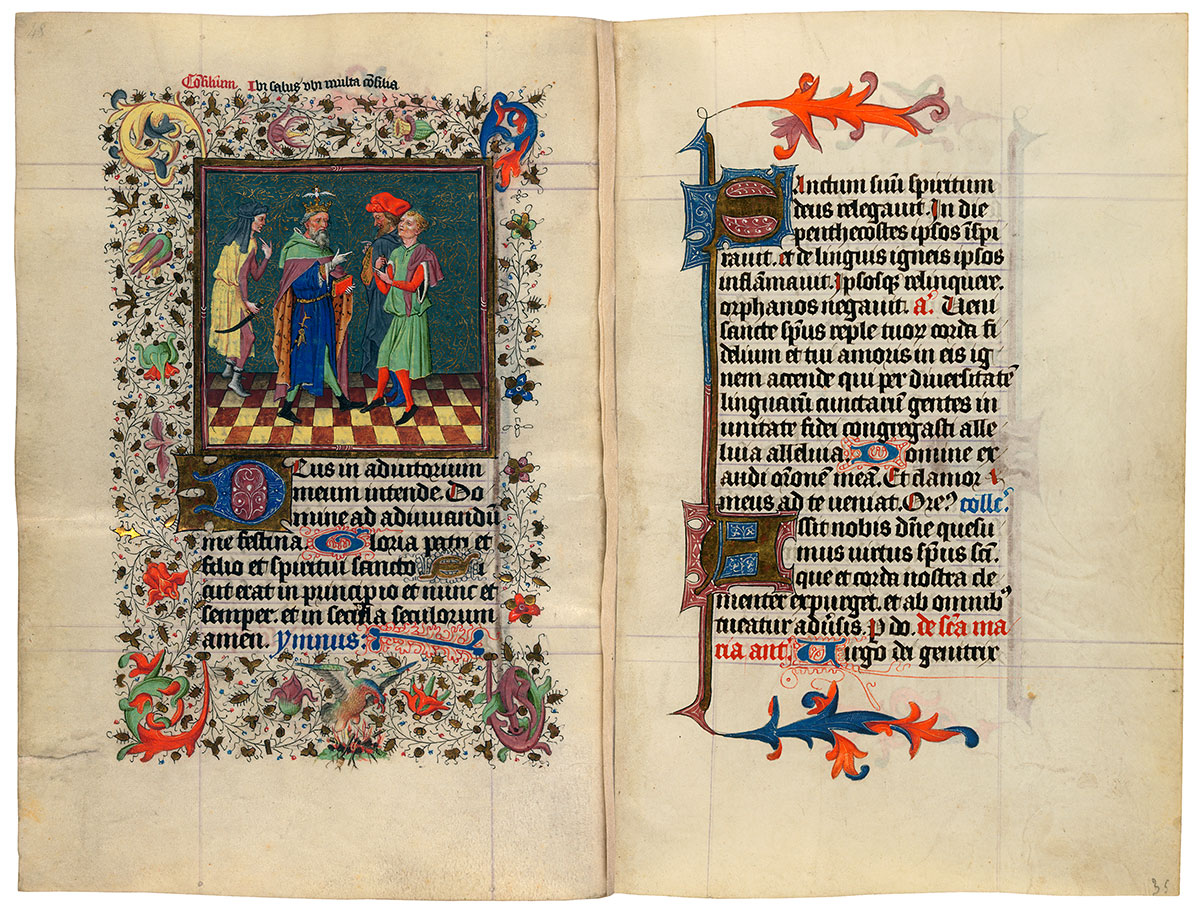
King and Advisers Taking Counsel
Purchased on the Belle da Costa Greene Fund with the assistance of the Fellows, 1963
Hours and Masses for the Seven Days of the Week
The most unusual texts in Catherine's manuscript are the series of Hours and Masses for every day of the week. Medieval Christian tradition associated certain figures or themes with different days. Thus Sunday, the day of the Resurrection, was the Lord's Day; Thursday was connected with the Eucharist since that sacrament was instituted on Holy Thursday; and Monday was the day of the dead, since their torments were suspended on Sunday but recommenced the following day. In Catherine's prayer book, the themes for the Hours and Masses of the seven days of the week are:
| Sunday | the Trinity |
| Monday | the Dead |
| Tuesday | the Holy Spirit |
| Wednesday | All Saints |
| Thursday | the Blessed Sacrament |
| Friday | the Compassion of God |
| Saturday | the Virgin. |
Image courtesy of Faksimile Verlag Luzern
MS M.917/945, pp. 36–73
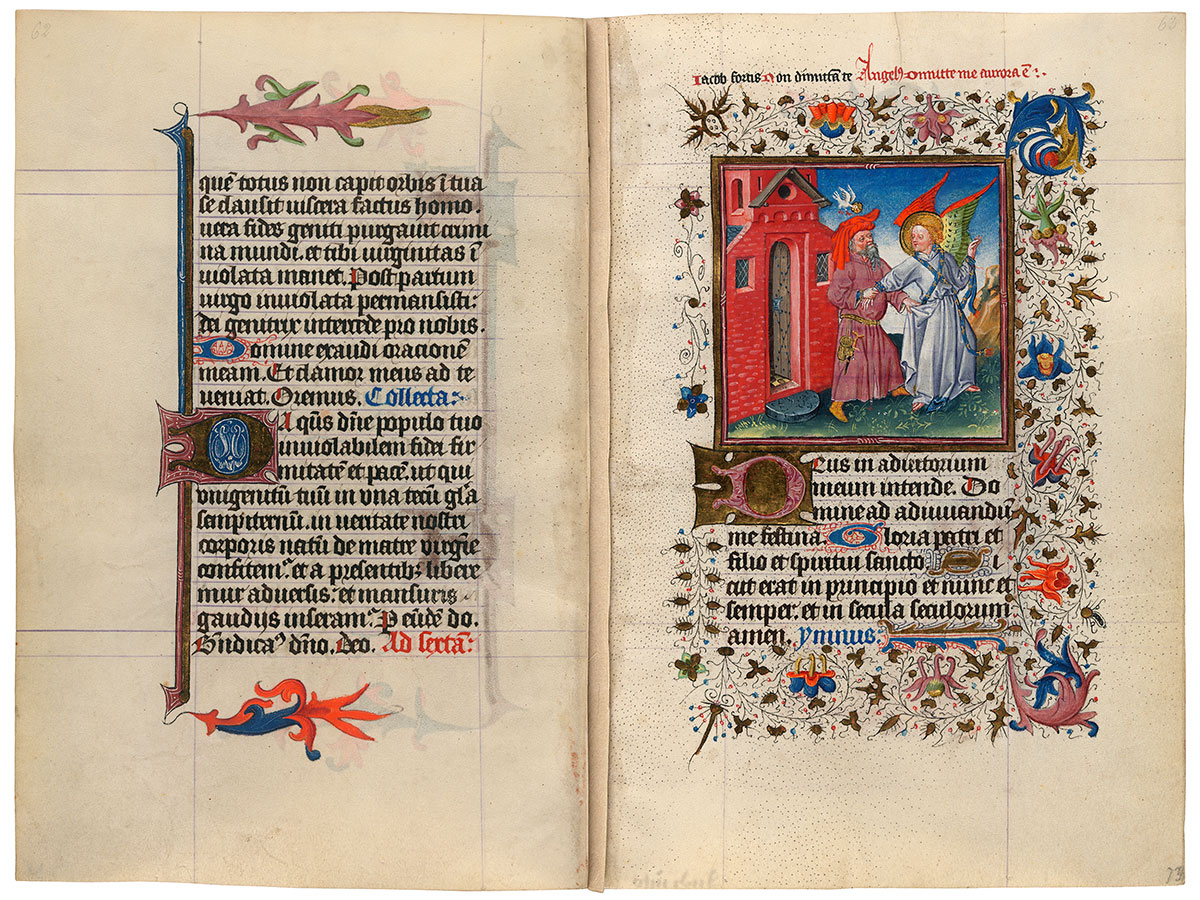
Jacob Struggling with the Angel
Purchased on the Belle da Costa Greene Fund with the assistance of the Fellows, 1963
Fortitude, the fourth gift of the Holy Spirit, is represented by Jacob's conquest of the angel. Catherine of Cleves would have been assisted in this obscure reference by the textual key provided in the top margin: "The strong Jacob says 'I will not let you go.' The angel begs, 'Let me go; dawn has arrived.'" The inspiring Dove of the Holy Spirit flies above the patriarch's head. The angel's sacerdotal garb, similar to that worn in previous miniatures, makes him analogous with the Holy Spirit.
Hours and Masses for the Seven Days of the Week
The most unusual texts in Catherine's manuscript are the series of Hours and Masses for every day of the week. Medieval Christian tradition associated certain figures or themes with different days. Thus Sunday, the day of the Resurrection, was the Lord's Day; Thursday was connected with the Eucharist since that sacrament was instituted on Holy Thursday; and Monday was the day of the dead, since their torments were suspended on Sunday but recommenced the following day. In Catherine's prayer book, the themes for the Hours and Masses of the seven days of the week are:
| Sunday | the Trinity |
| Monday | the Dead |
| Tuesday | the Holy Spirit |
| Wednesday | All Saints |
| Thursday | the Blessed Sacrament |
| Friday | the Compassion of God |
| Saturday | the Virgin. |
Image courtesy of Faksimile Verlag Luzern
MS M.917/945, pp. 74–61
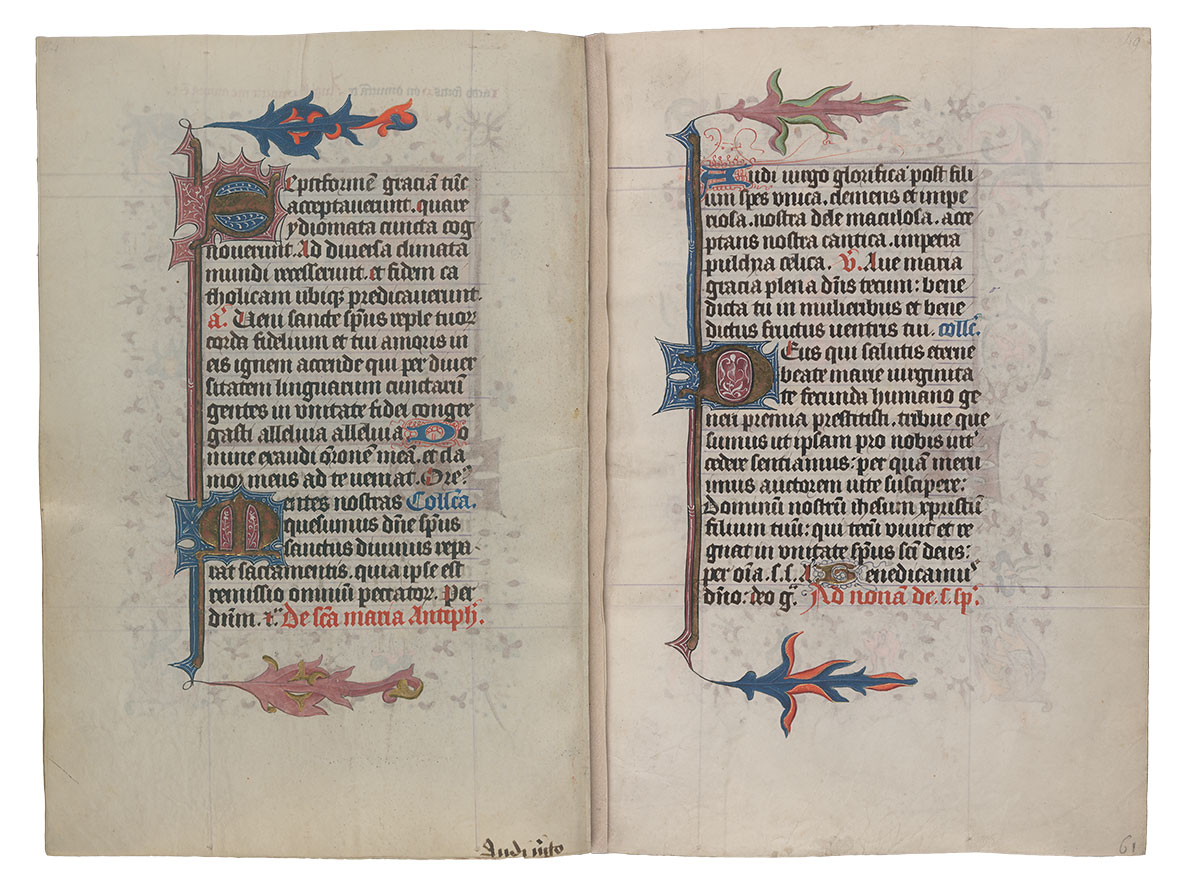
Purchased on the Belle da Costa Greene Fund with the assistance of the Fellows, 1963
Image courtesy of Faksimile Verlag Luzern
MS M.917/945, pp. 62–63

Teacher Instructing Pupils
Purchased on the Belle da Costa Greene Fund with the assistance of the Fellows, 1963
Knowledge, the fifth gift of the Holy Spirit, is represented by this delightful schoolroom scene. Inspired by the Dove, the older kneeling student reads from a book proffered by his teacher. The young man's scroll reveals his inspiration, quoting from Psalm 2, verse 12, that the key to knowledge is the learning of discipline. The seated teacher holds a bundle of switches, the instrument of reprimand and attribute for instructors in the Middle Ages.
Hours and Masses for the Seven Days of the Week
The most unusual texts in Catherine's manuscript are the series of Hours and Masses for every day of the week. Medieval Christian tradition associated certain figures or themes with different days. Thus Sunday, the day of the Resurrection, was the Lord's Day; Thursday was connected with the Eucharist since that sacrament was instituted on Holy Thursday; and Monday was the day of the dead, since their torments were suspended on Sunday but recommenced the following day. In Catherine's prayer book, the themes for the Hours and Masses of the seven days of the week are:
| Sunday | the Trinity |
| Monday | the Dead |
| Tuesday | the Holy Spirit |
| Wednesday | All Saints |
| Thursday | the Blessed Sacrament |
| Friday | the Compassion of God |
| Saturday | the Virgin. |
Image courtesy of Faksimile Verlag Luzern
MS M.917/945, pp. 64–65
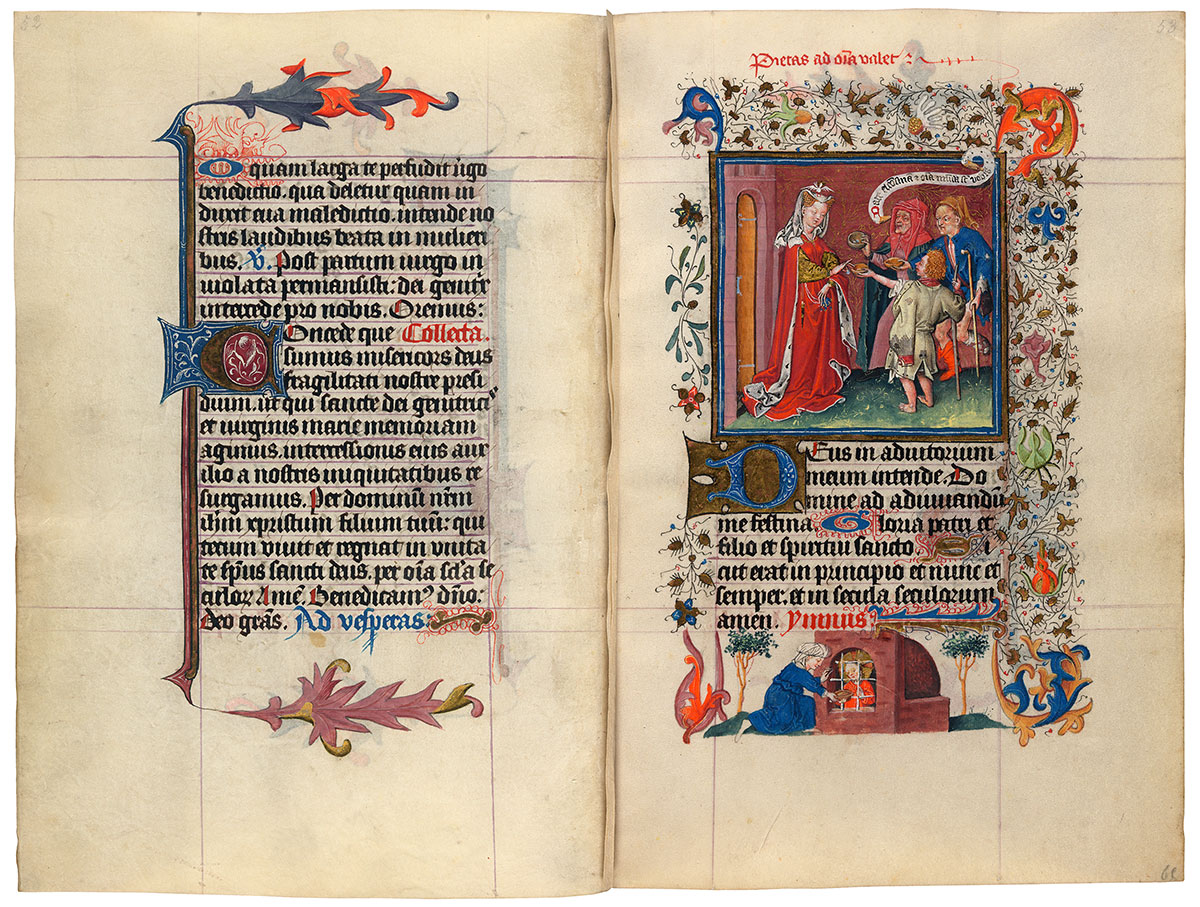
Catherine of Cleves Distributing Alms
Purchased on the Belle da Costa Greene Fund with the assistance of the Fellows, 1963
Piety is the sixth gift of the Holy Spirit. Illustrating pious charity afforded the opportunity to include a flattering portrait of Catherine as the generous giver of alms. In the miniature, the inspiring Dove of the Holy Spirit hovers directly above her head. The scroll above the beggars quotes Luke (11:41), "Give alms, and all things are clean unto you." In the bottom border, a woman tends to a prisoner. During the Middle Ages, this Corporal Act of Mercy was interpreted as charity toward Christ himself; thus the prisoner is given the Savior's cruciform halo.
Hours and Masses for the Seven Days of the Week
The most unusual texts in Catherine's manuscript are the series of Hours and Masses for every day of the week. Medieval Christian tradition associated certain figures or themes with different days. Thus Sunday, the day of the Resurrection, was the Lord's Day; Thursday was connected with the Eucharist since that sacrament was instituted on Holy Thursday; and Monday was the day of the dead, since their torments were suspended on Sunday but recommenced the following day. In Catherine's prayer book, the themes for the Hours and Masses of the seven days of the week are:
| Sunday | the Trinity |
| Monday | the Dead |
| Tuesday | the Holy Spirit |
| Wednesday | All Saints |
| Thursday | the Blessed Sacrament |
| Friday | the Compassion of God |
| Saturday | the Virgin. |
Image courtesy of Faksimile Verlag Luzern
MS M.917/945, pp. 66–67
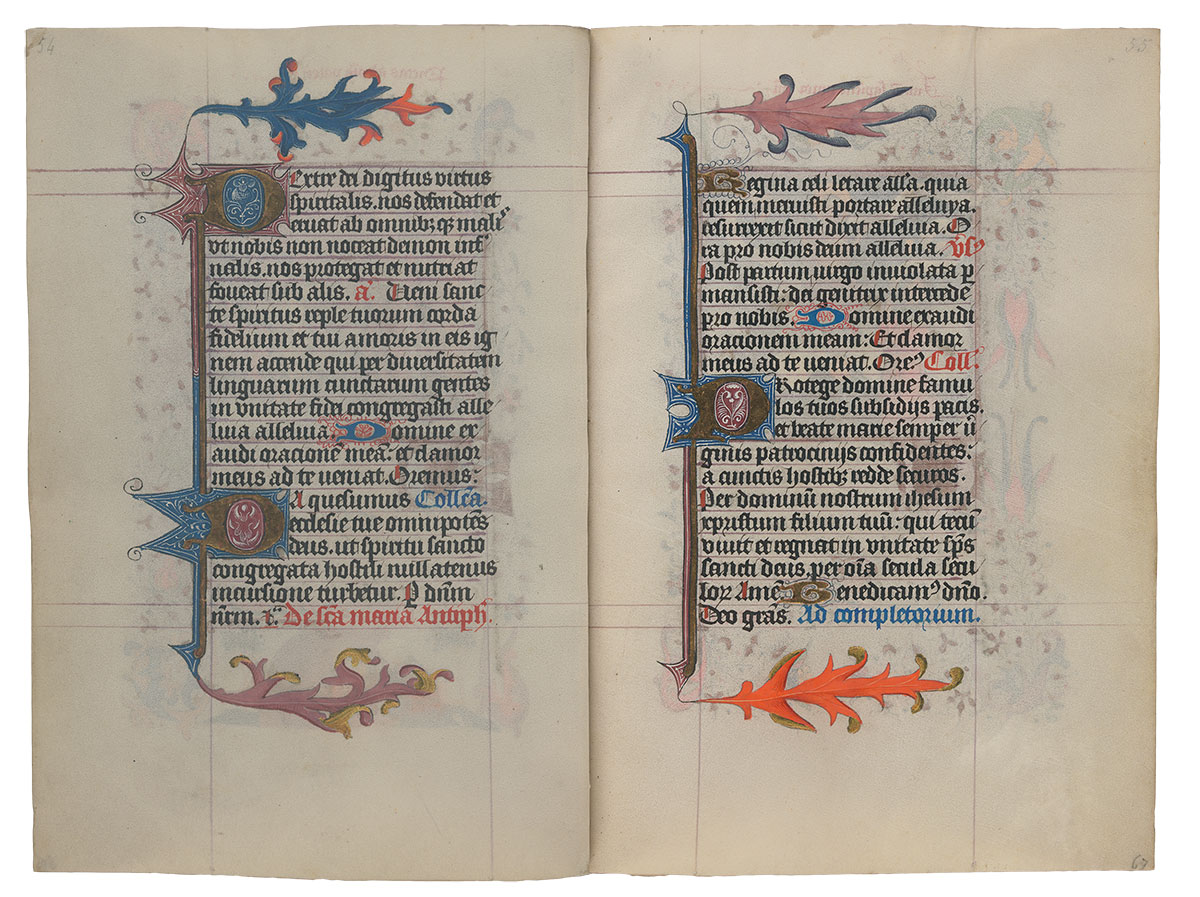
Purchased on the Belle da Costa Greene Fund with the assistance of the Fellows, 1963
Image courtesy of Faksimile Verlag Luzern
MS M.917/945, pp. 68–69
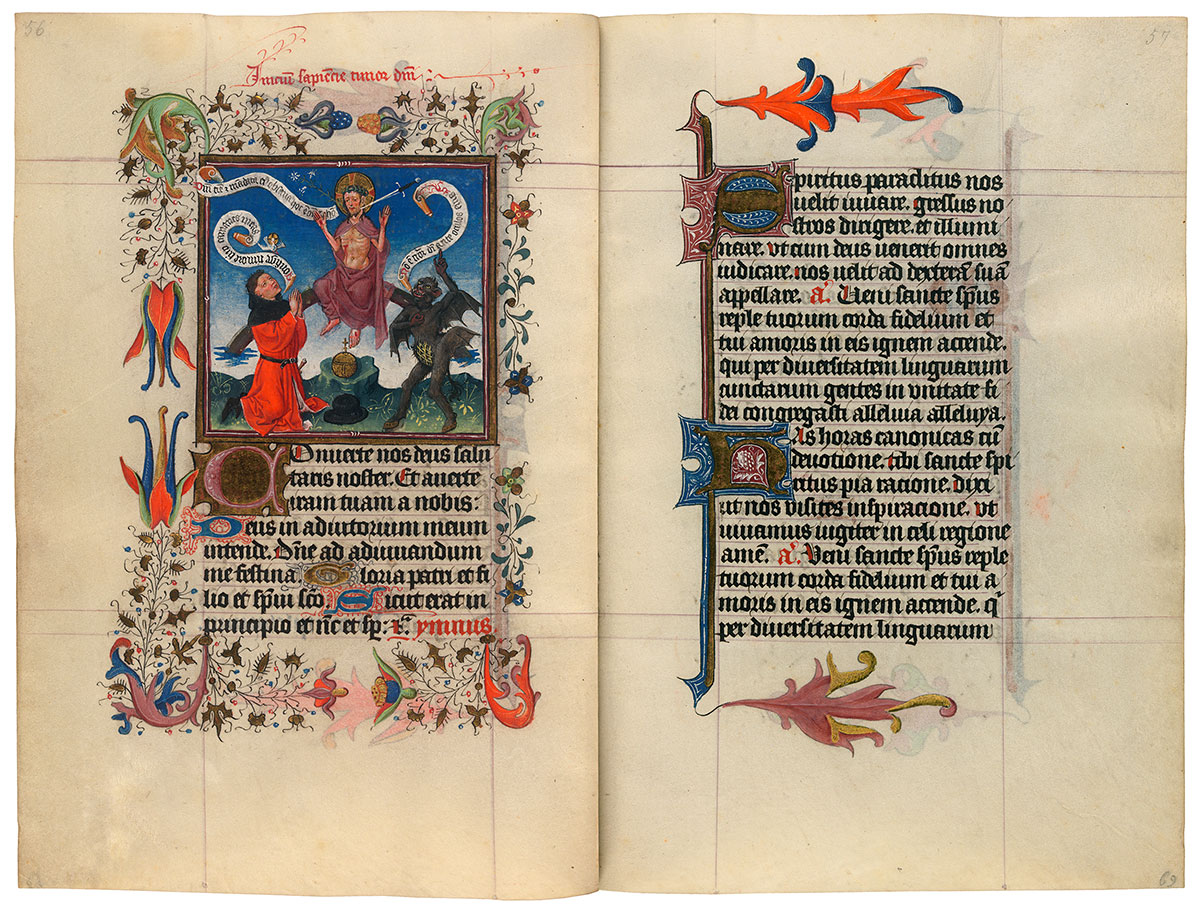
Arnold of Egmond, Catherine of Cleves’ Husband, Praying to Christ
Purchased on the Belle da Costa Greene Fund with the assistance of the Fellows, 1963
The seventh and last gift of the Holy Spirit is fear of the Lord. It is illustrated with a portrait of Catherine's husband, Arnold, praying to Christ of the Last Judgment (the sword of justice and lily of mercy spring from the Savior's mouth). Arnold invokes Psalm 118, verse 120: "Make my flesh tremble from fear of the Lord." The devil, however, countermands from Psalm 35, verse 2, arguing that "There is no fear of the Lord before God's eyes." Christ's rather neutral reply is from Ecclesiastes (12:13): "Fear God and follow his commandments; this is true for all men." These sequential portraits of Catherine and Arnold place the duchess, who commissioned the manuscript, and her husband, the duke, in starkly contrasting contexts.
Hours and Masses for the Seven Days of the Week
The most unusual texts in Catherine's manuscript are the series of Hours and Masses for every day of the week. Medieval Christian tradition associated certain figures or themes with different days. Thus Sunday, the day of the Resurrection, was the Lord's Day; Thursday was connected with the Eucharist since that sacrament was instituted on Holy Thursday; and Monday was the day of the dead, since their torments were suspended on Sunday but recommenced the following day. In Catherine's prayer book, the themes for the Hours and Masses of the seven days of the week are:
| Sunday | the Trinity |
| Monday | the Dead |
| Tuesday | the Holy Spirit |
| Wednesday | All Saints |
| Thursday | the Blessed Sacrament |
| Friday | the Compassion of God |
| Saturday | the Virgin. |
Image courtesy of Faksimile Verlag Luzern
MS M.917/945, pp. 70–71
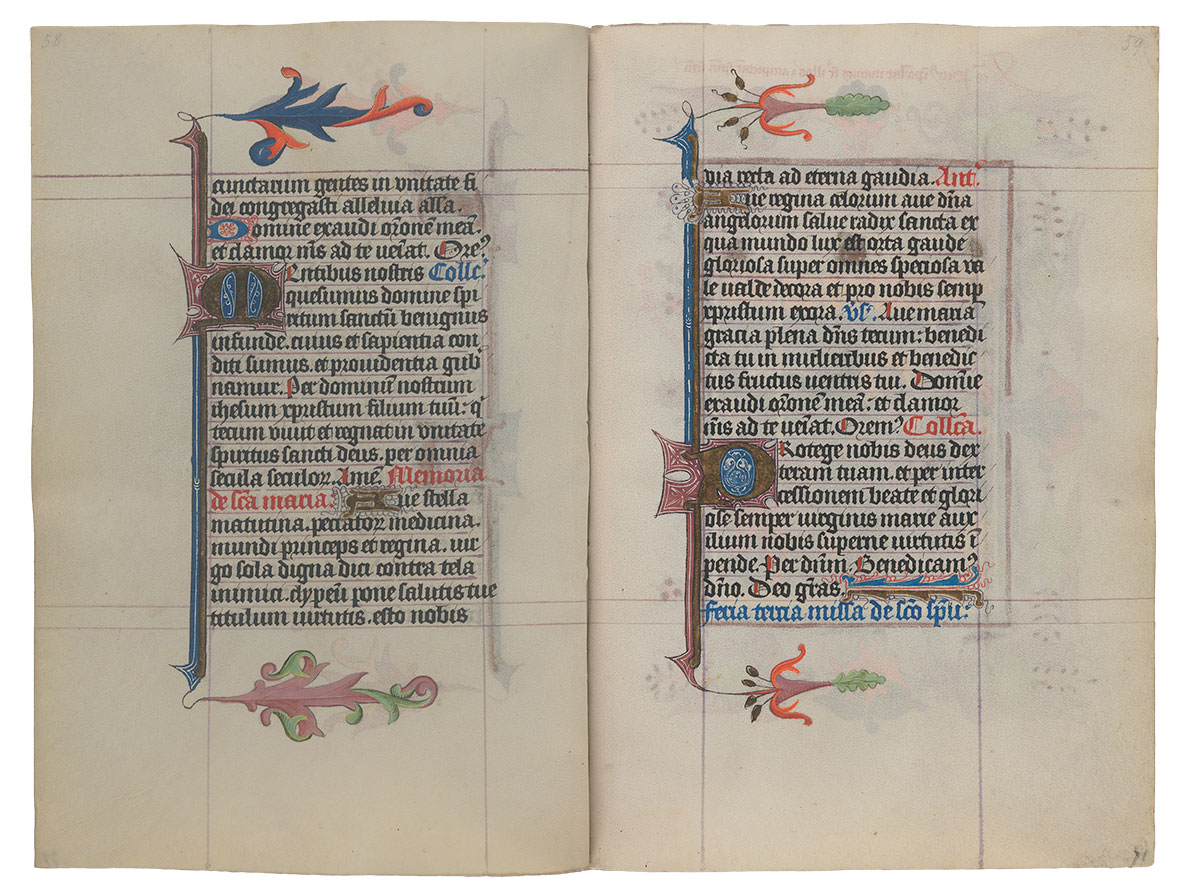
Purchased on the Belle da Costa Greene Fund with the assistance of the Fellows, 1963
Image courtesy of Faksimile Verlag Luzern
MS M.917/945, p. 72–f. 109r
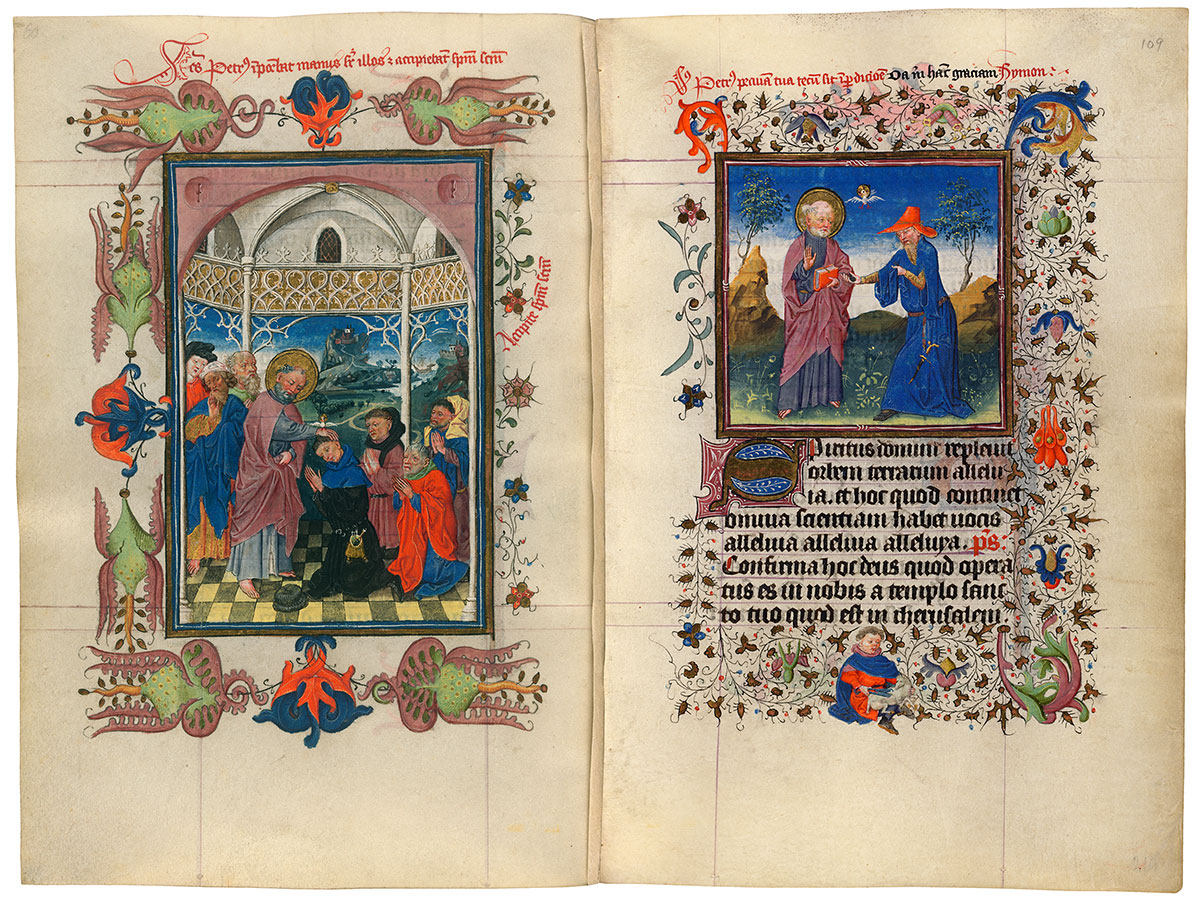
St. Peter Bestowing the Holy Spirit
Simon Magus Seeks to Buy Peter's Power
Purchased on the Belle da Costa Greene Fund with the assistance of the Fellows, 1963; purchased on the Belle da Costa Greene Fund with the assistance of the Fellows and with special assistance of Mrs. Frederick B. Adams, Sr., Mrs. Robert Charles, Mr. Laurens M. Hamilton, The Heineman Foundation, Mrs. Donald F. Hyde, Mrs. Jacob M. Kaplan, Mrs. John Kean, Mr. Paul Mellon, Mr. and Mrs. Charles F. Morgan, Mr. Lessing J. Rosenwald, Mr. and Mrs. August H. Schilling, Mrs. Herbert N. Straus, Mrs. Landon K. Thorne, Mrs. Alan Valentine, Mr. and Mrs. Arnold Whitridge, and Miss Julia P. Wightman, 1970
This small miniature illustrating the Mass of the Holy Spirit depicts the magician Simon's attempt to buy from St. Peter his power (he had seen the apostle bestowing the Holy Spirit upon people). The rare scene is explicated by texts (derived from Acts 8:19–20) in the top margin. Simon, shoving a moneybag toward the saint, demands, "Give me this grace," to which Peter calmly responds, "You and your money will perish." How the boy shearing a sheep in the bottom border might relate to this scene is a mystery.
Hours and Masses for the Seven Days of the Week
The most unusual texts in Catherine's manuscript are the series of Hours and Masses for every day of the week. Medieval Christian tradition associated certain figures or themes with different days. Thus Sunday, the day of the Resurrection, was the Lord's Day; Thursday was connected with the Eucharist since that sacrament was instituted on Holy Thursday; and Monday was the day of the dead, since their torments were suspended on Sunday but recommenced the following day. In Catherine's prayer book, the themes for the Hours and Masses of the seven days of the week are:
| Sunday | the Trinity |
| Monday | the Dead |
| Tuesday | the Holy Spirit |
| Wednesday | All Saints |
| Thursday | the Blessed Sacrament |
| Friday | the Compassion of God |
| Saturday | the Virgin. |
Image courtesy of Faksimile Verlag Luzern
MS M.917/945, ff. 109v–110r
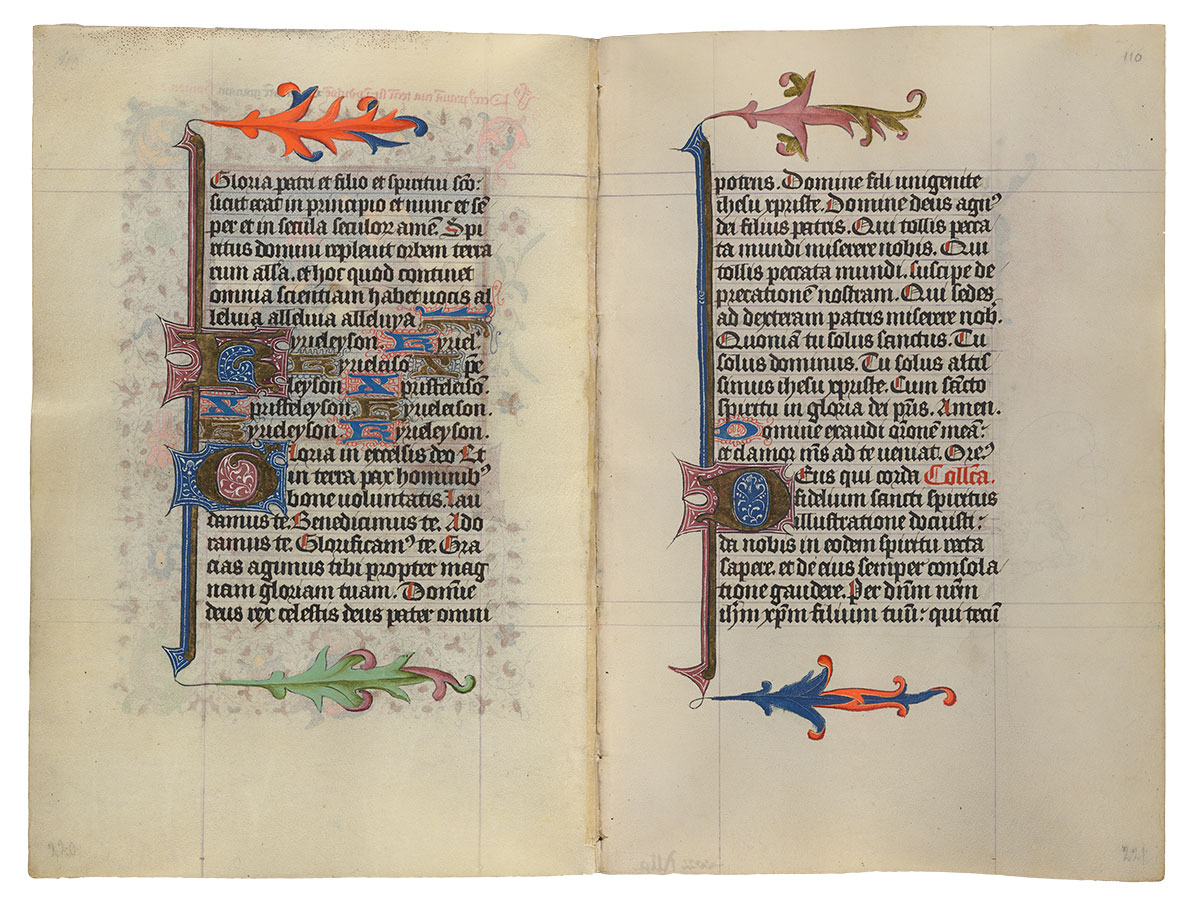
Purchased on the Belle da Costa Greene Fund with the assistance of the Fellows, 1963; purchased on the Belle da Costa Greene Fund with the assistance of the Fellows and with special assistance of Mrs. Frederick B. Adams, Sr., Mrs. Robert Charles, Mr. Laurens M. Hamilton, The Heineman Foundation, Mrs. Donald F. Hyde, Mrs. Jacob M. Kaplan, Mrs. John Kean, Mr. Paul Mellon, Mr. and Mrs. Charles F. Morgan, Mr. Lessing J. Rosenwald, Mr. and Mrs. August H. Schilling, Mrs. Herbert N. Straus, Mrs. Landon K. Thorne, Mrs. Alan Valentine, Mr. and Mrs. Arnold Whitridge, and Miss Julia P. Wightman, 1970
Image courtesy of Faksimile Verlag Luzern
MS M.917/945, ff. 110v–111r
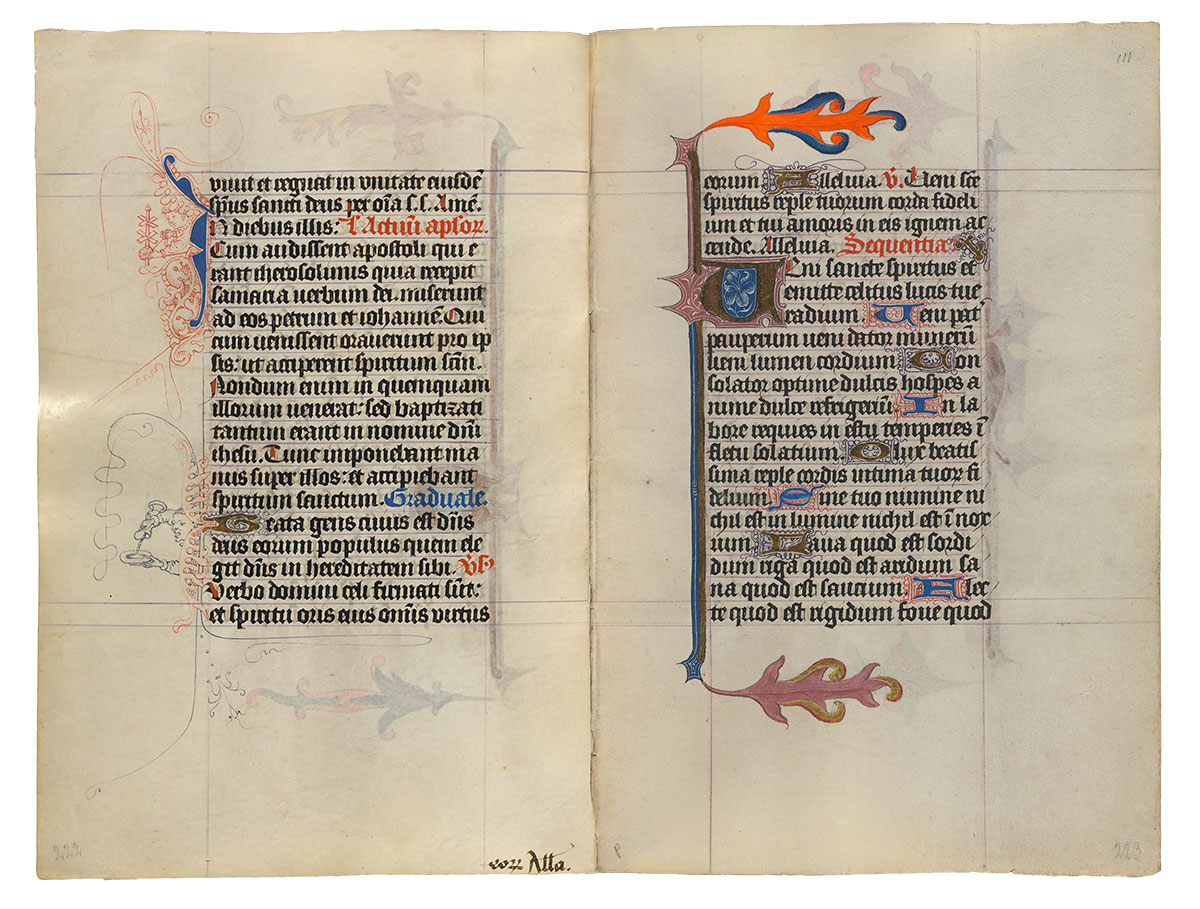
Purchased on the Belle da Costa Greene Fund with the assistance of the Fellows, 1963; purchased on the Belle da Costa Greene Fund with the assistance of the Fellows and with special assistance of Mrs. Frederick B. Adams, Sr., Mrs. Robert Charles, Mr. Laurens M. Hamilton, The Heineman Foundation, Mrs. Donald F. Hyde, Mrs. Jacob M. Kaplan, Mrs. John Kean, Mr. Paul Mellon, Mr. and Mrs. Charles F. Morgan, Mr. Lessing J. Rosenwald, Mr. and Mrs. August H. Schilling, Mrs. Herbert N. Straus, Mrs. Landon K. Thorne, Mrs. Alan Valentine, Mr. and Mrs. Arnold Whitridge, and Miss Julia P. Wightman, 1970
Image courtesy of Faksimile Verlag Luzern
MS M.917/945, ff. 111v–112r
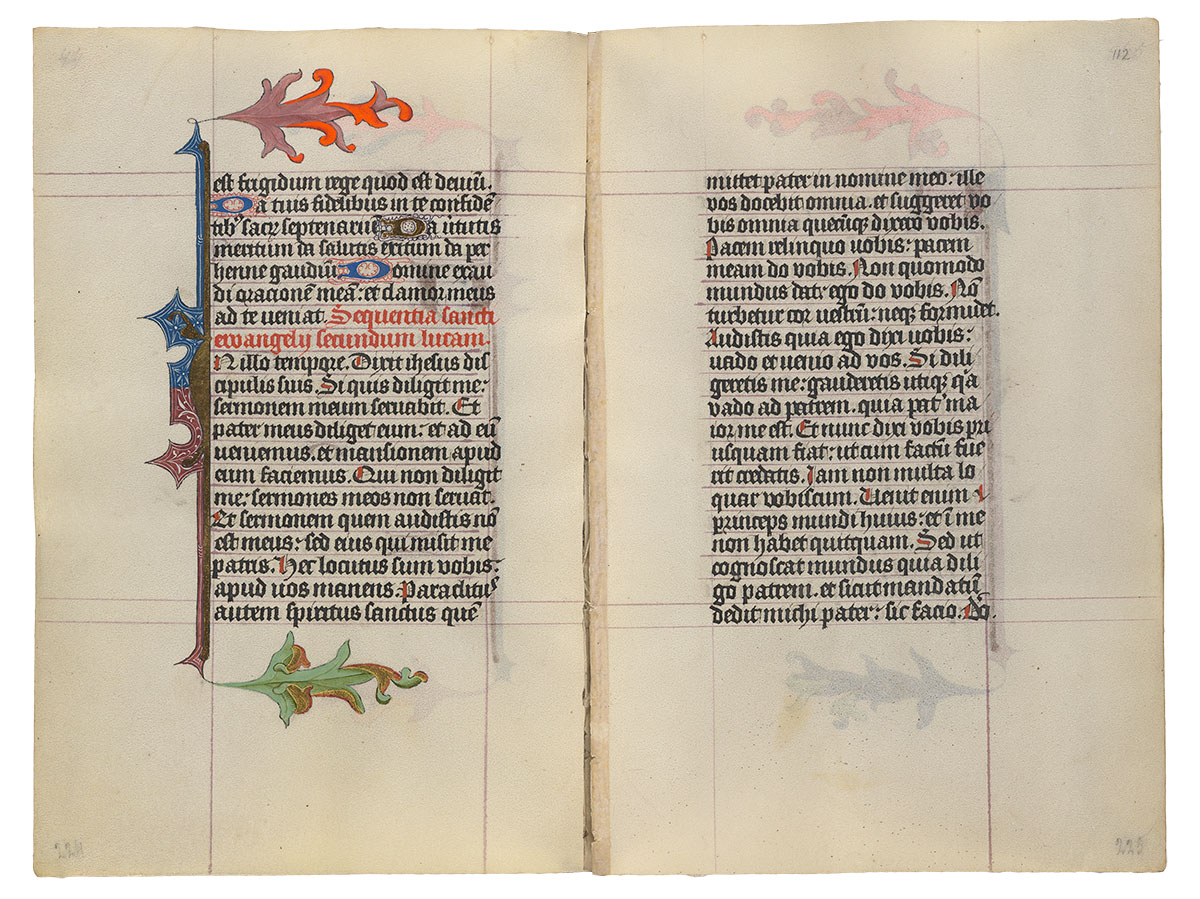
Purchased on the Belle da Costa Greene Fund with the assistance of the Fellows, 1963; purchased on the Belle da Costa Greene Fund with the assistance of the Fellows and with special assistance of Mrs. Frederick B. Adams, Sr., Mrs. Robert Charles, Mr. Laurens M. Hamilton, The Heineman Foundation, Mrs. Donald F. Hyde, Mrs. Jacob M. Kaplan, Mrs. John Kean, Mr. Paul Mellon, Mr. and Mrs. Charles F. Morgan, Mr. Lessing J. Rosenwald, Mr. and Mrs. August H. Schilling, Mrs. Herbert N. Straus, Mrs. Landon K. Thorne, Mrs. Alan Valentine, Mr. and Mrs. Arnold Whitridge, and Miss Julia P. Wightman, 1970
Image courtesy of Faksimile Verlag Luzern
MS M.917/945, ff. 112v–113r
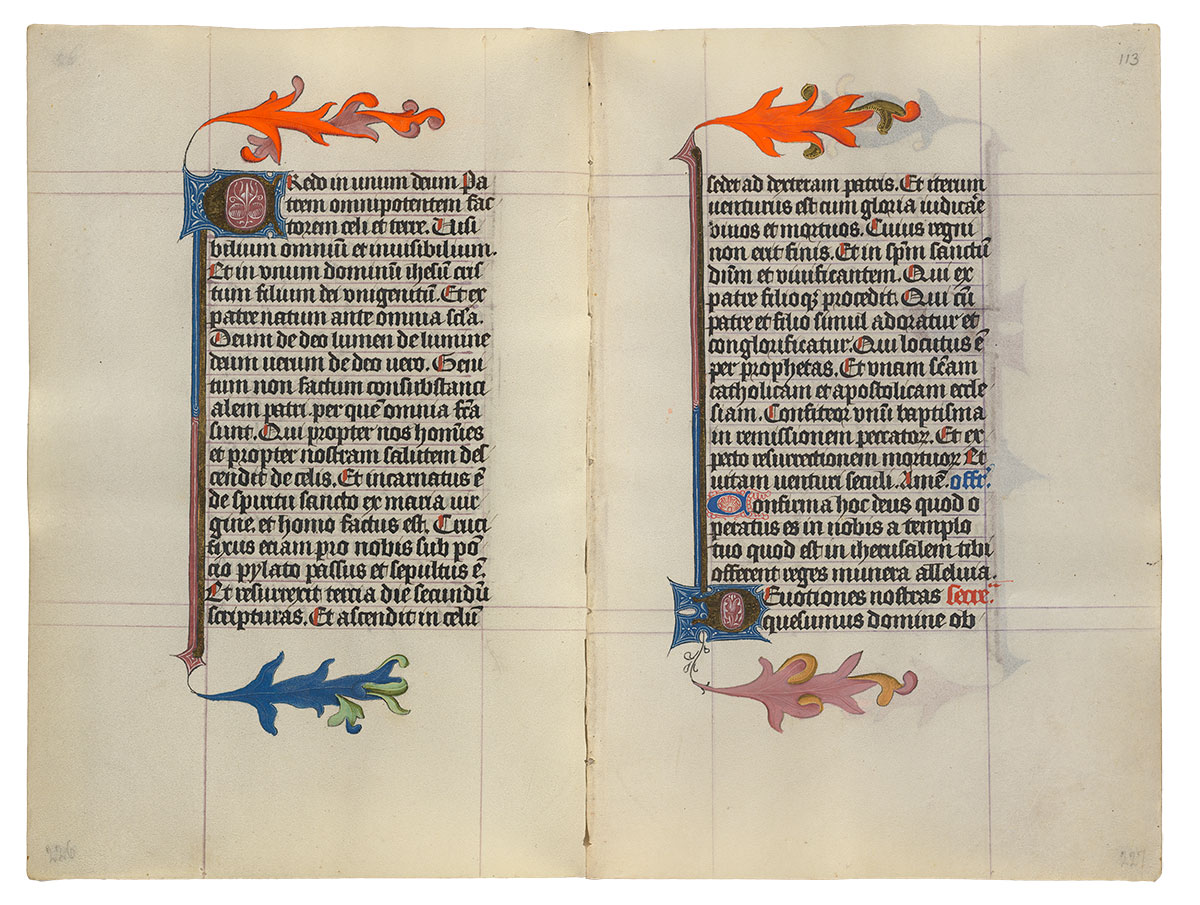
Purchased on the Belle da Costa Greene Fund with the assistance of the Fellows, 1963; purchased on the Belle da Costa Greene Fund with the assistance of the Fellows and with special assistance of Mrs. Frederick B. Adams, Sr., Mrs. Robert Charles, Mr. Laurens M. Hamilton, The Heineman Foundation, Mrs. Donald F. Hyde, Mrs. Jacob M. Kaplan, Mrs. John Kean, Mr. Paul Mellon, Mr. and Mrs. Charles F. Morgan, Mr. Lessing J. Rosenwald, Mr. and Mrs. August H. Schilling, Mrs. Herbert N. Straus, Mrs. Landon K. Thorne, Mrs. Alan Valentine, Mr. and Mrs. Arnold Whitridge, and Miss Julia P. Wightman, 1970
Image courtesy of Faksimile Verlag Luzern
MS M.917/945, ff. 113v–114r
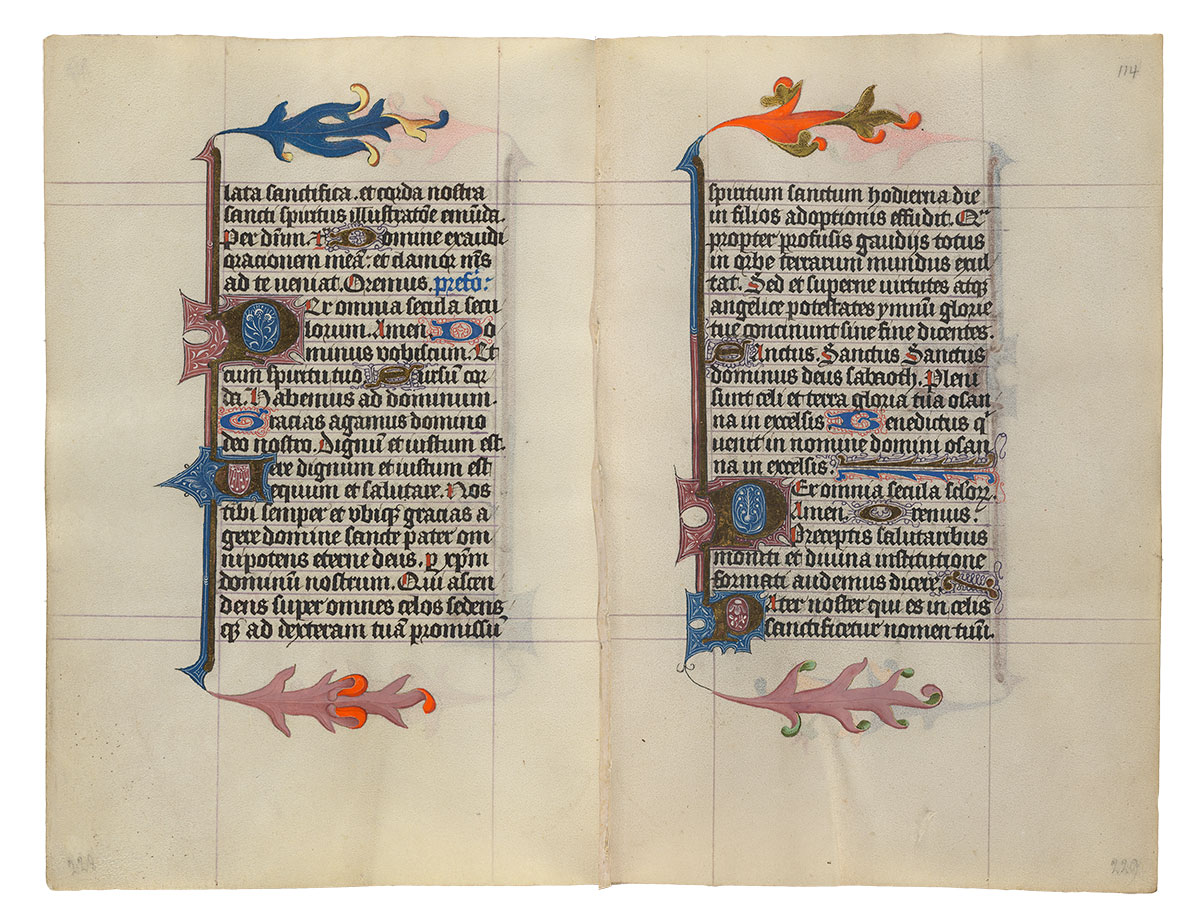
Purchased on the Belle da Costa Greene Fund with the assistance of the Fellows, 1963; purchased on the Belle da Costa Greene Fund with the assistance of the Fellows and with special assistance of Mrs. Frederick B. Adams, Sr., Mrs. Robert Charles, Mr. Laurens M. Hamilton, The Heineman Foundation, Mrs. Donald F. Hyde, Mrs. Jacob M. Kaplan, Mrs. John Kean, Mr. Paul Mellon, Mr. and Mrs. Charles F. Morgan, Mr. Lessing J. Rosenwald, Mr. and Mrs. August H. Schilling, Mrs. Herbert N. Straus, Mrs. Landon K. Thorne, Mrs. Alan Valentine, Mr. and Mrs. Arnold Whitridge, and Miss Julia P. Wightman, 1970
Image courtesy of Faksimile Verlag Luzern
MS M.917/945, ff. 114v–115r
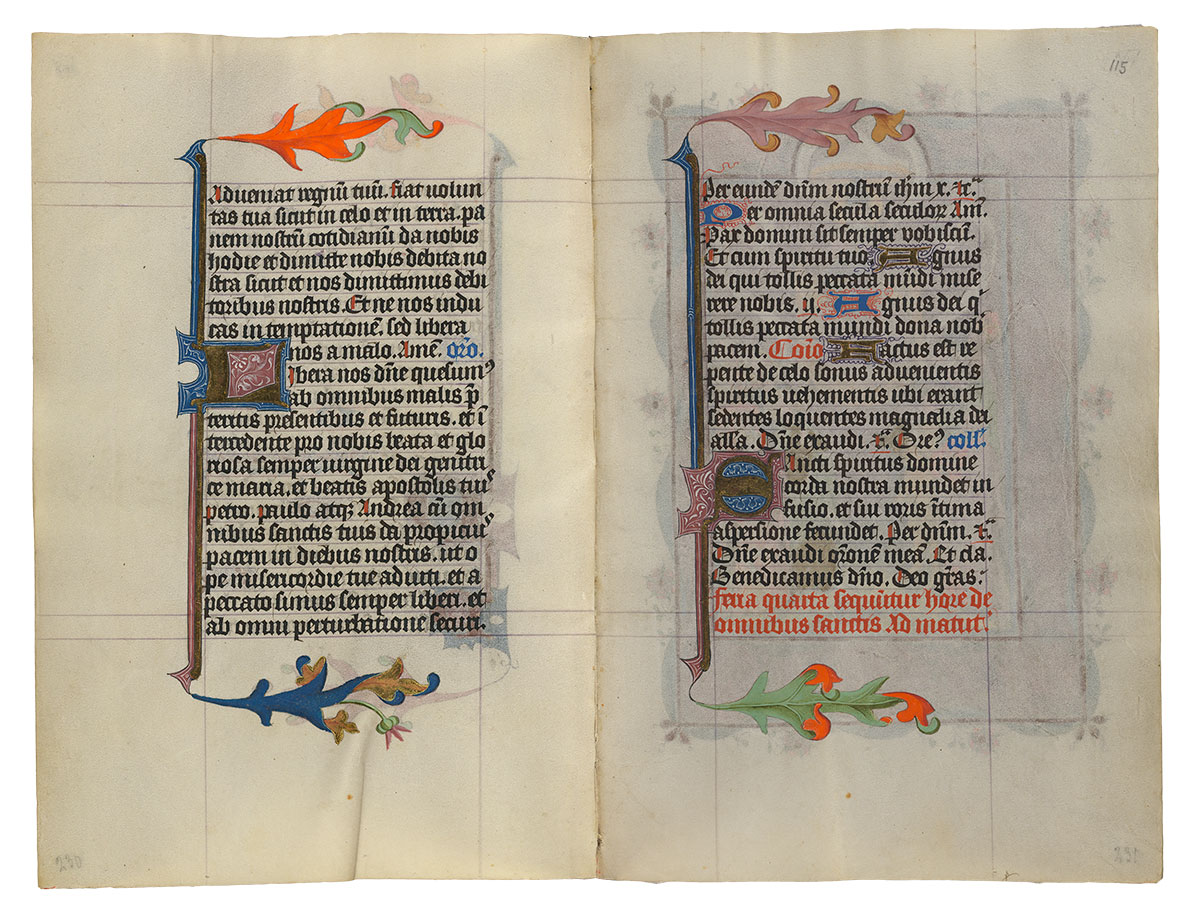
Purchased on the Belle da Costa Greene Fund with the assistance of the Fellows, 1963; purchased on the Belle da Costa Greene Fund with the assistance of the Fellows and with special assistance of Mrs. Frederick B. Adams, Sr., Mrs. Robert Charles, Mr. Laurens M. Hamilton, The Heineman Foundation, Mrs. Donald F. Hyde, Mrs. Jacob M. Kaplan, Mrs. John Kean, Mr. Paul Mellon, Mr. and Mrs. Charles F. Morgan, Mr. Lessing J. Rosenwald, Mr. and Mrs. August H. Schilling, Mrs. Herbert N. Straus, Mrs. Landon K. Thorne, Mrs. Alan Valentine, Mr. and Mrs. Arnold Whitridge, and Miss Julia P. Wightman, 1970
Image courtesy of Faksimile Verlag Luzern
MS M.917/945, f. 115v–p.39
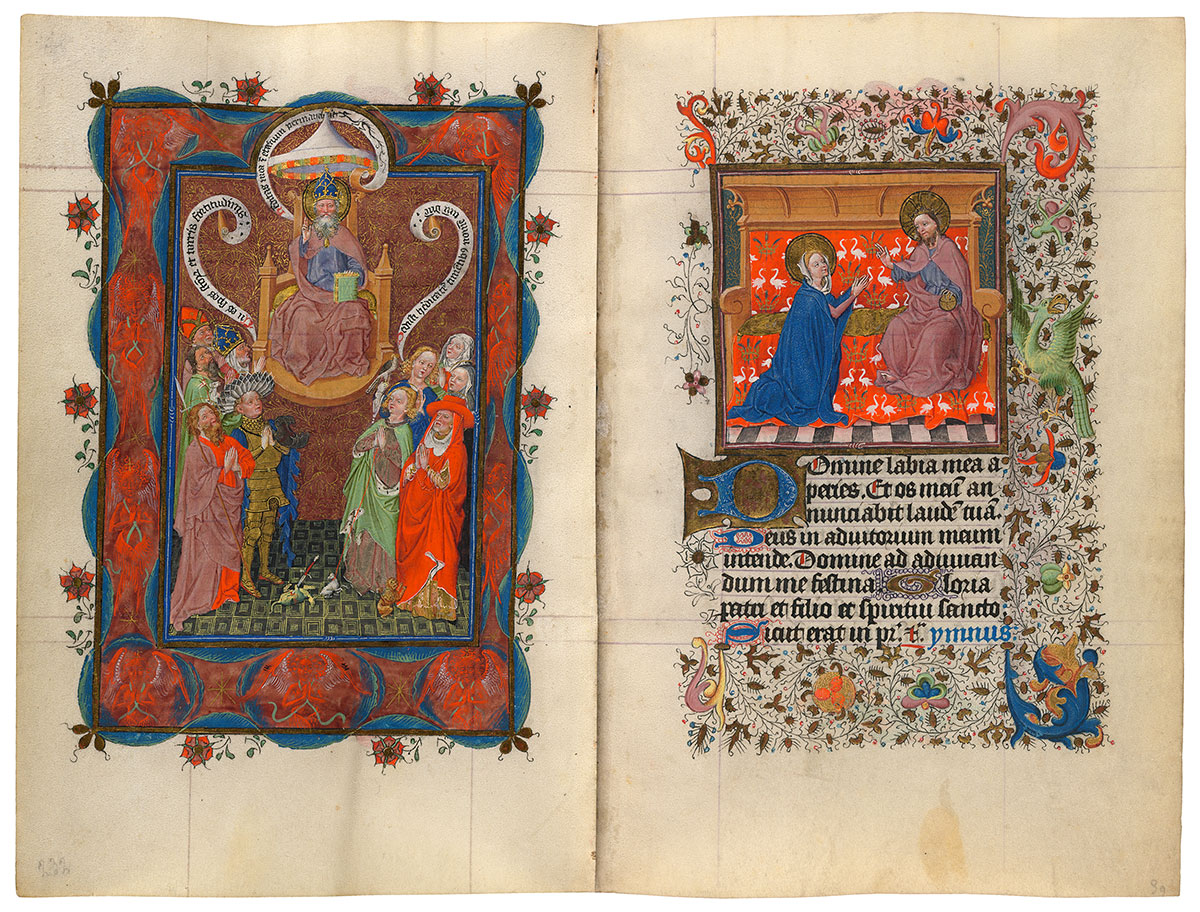
All Saints before the Throne of God
Christ Receiving the Virgin into Heaven
Purchased on the Belle da Costa Greene Fund with the assistance of the Fellows and with special assistance of Mrs. Frederick B. Adams, Sr., Mrs. Robert Charles, Mr. Laurens M. Hamilton, The Heineman Foundation, Mrs. Donald F. Hyde, Mrs. Jacob M. Kaplan, Mrs. John Kean, Mr. Paul Mellon, Mr. and Mrs. Charles F. Morgan, Mr. Lessing J. Rosenwald, Mr. and Mrs. August H. Schilling, Mrs. Herbert N. Straus, Mrs. Landon K. Thorne, Mrs. Alan Valentine, Mr. and Mrs. Arnold Whitridge, and Miss Julia P. Wightman, 1970; purchased on the Belle da Costa Greene Fund with the assistance of the Fellows, 1963
The Wednesday Hours of All Saints commences with this impressive miniature. An enthroned God floats above two groups of saints. On the left, they are headed by George, with a tiny dead dragon at his feet, and the apostle Thomas, holding a spear. On the right are Agnes, with a small lamb at her feet, and Jerome, dressed as a cardinal and with his attribute, a lion. The scene is framed by nine fiery angels. The scrolls speak of God's legacy to and support of his saints.
Hours and Masses for the Seven Days of the Week
The most unusual texts in Catherine's manuscript are the series of Hours and Masses for every day of the week. Medieval Christian tradition associated certain figures or themes with different days. Thus Sunday, the day of the Resurrection, was the Lord's Day; Thursday was connected with the Eucharist since that sacrament was instituted on Holy Thursday; and Monday was the day of the dead, since their torments were suspended on Sunday but recommenced the following day. In Catherine's prayer book, the themes for the Hours and Masses of the seven days of the week are:
| Sunday | the Trinity |
| Monday | the Dead |
| Tuesday | the Holy Spirit |
| Wednesday | All Saints |
| Thursday | the Blessed Sacrament |
| Friday | the Compassion of God |
| Saturday | the Virgin. |
Image courtesy of Faksimile Verlag Luzern
MS M.917/945, pp. 40–41
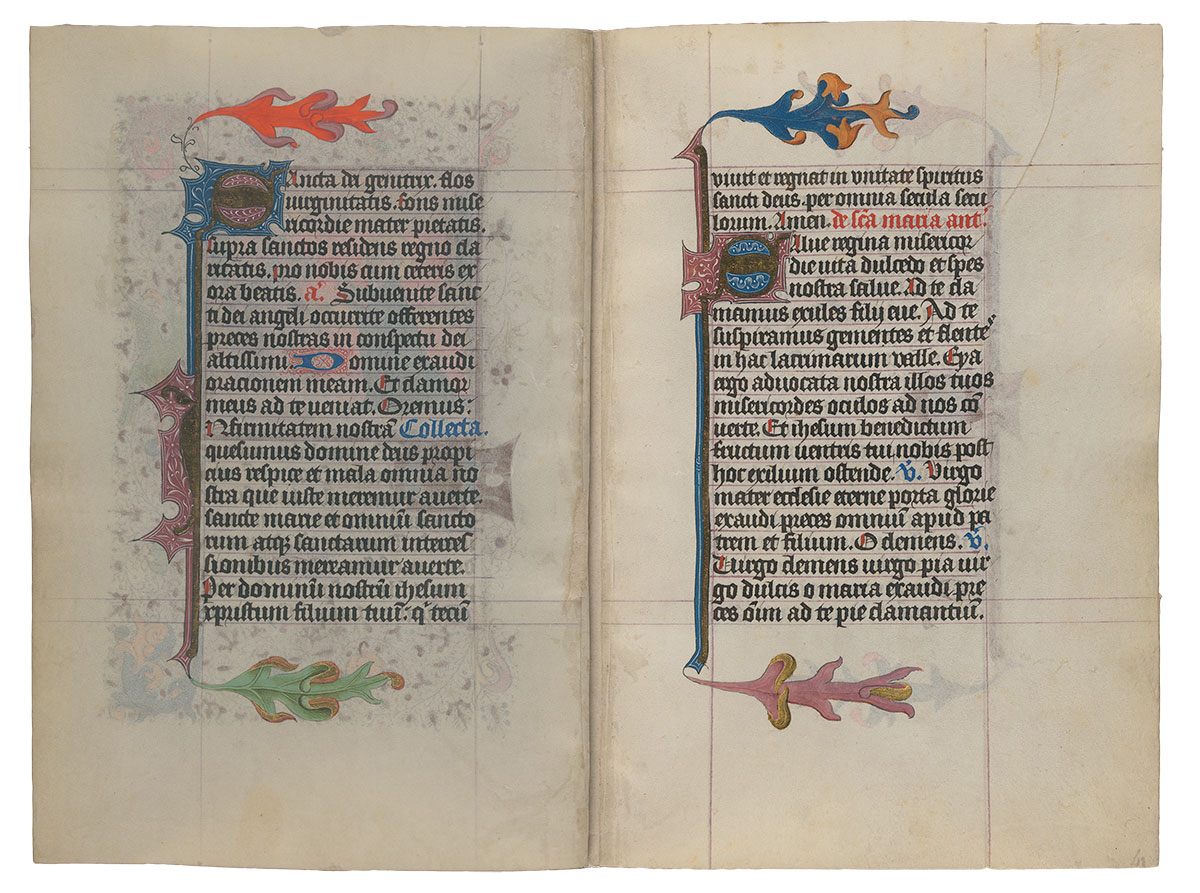
Purchased on the Belle da Costa Greene Fund with the assistance of the Fellows, 1963
Image courtesy of Faksimile Verlag Luzern
MS M.917/945, p. 42–f. 116r
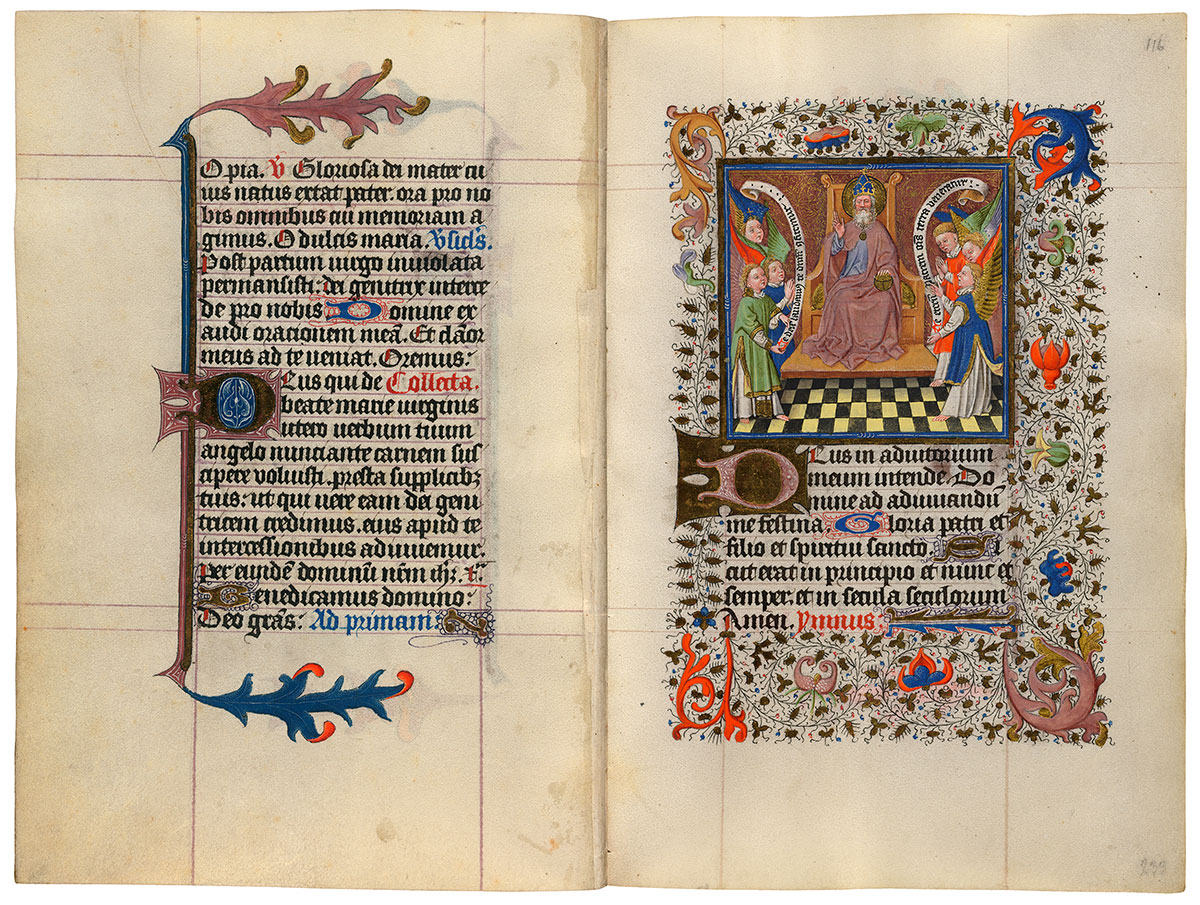
Angels before the Throne of God
Purchased on the Belle da Costa Greene Fund with the assistance of the Fellows, 1963; purchased on the Belle da Costa Greene Fund with the assistance of the Fellows and with special assistance of Mrs. Frederick B. Adams, Sr., Mrs. Robert Charles, Mr. Laurens M. Hamilton, The Heineman Foundation, Mrs. Donald F. Hyde, Mrs. Jacob M. Kaplan, Mrs. John Kean, Mr. Paul Mellon, Mr. and Mrs. Charles F. Morgan, Mr. Lessing J. Rosenwald, Mr. and Mrs. August H. Schilling, Mrs. Herbert N. Straus, Mrs. Landon K. Thorne, Mrs. Alan Valentine, Mr. and Mrs. Arnold Whitridge, and Miss Julia P. Wightman, 1970
Hours and Masses for the Seven Days of the Week
The most unusual texts in Catherine's manuscript are the series of Hours and Masses for every day of the week. Medieval Christian tradition associated certain figures or themes with different days. Thus Sunday, the day of the Resurrection, was the Lord's Day; Thursday was connected with the Eucharist since that sacrament was instituted on Holy Thursday; and Monday was the day of the dead, since their torments were suspended on Sunday but recommenced the following day. In Catherine's prayer book, the themes for the Hours and Masses of the seven days of the week are:
| Sunday | the Trinity |
| Monday | the Dead |
| Tuesday | the Holy Spirit |
| Wednesday | All Saints |
| Thursday | the Blessed Sacrament |
| Friday | the Compassion of God |
| Saturday | the Virgin. |
Image courtesy of Faksimile Verlag Luzern
MS M.917/945, ff. 116v–117r
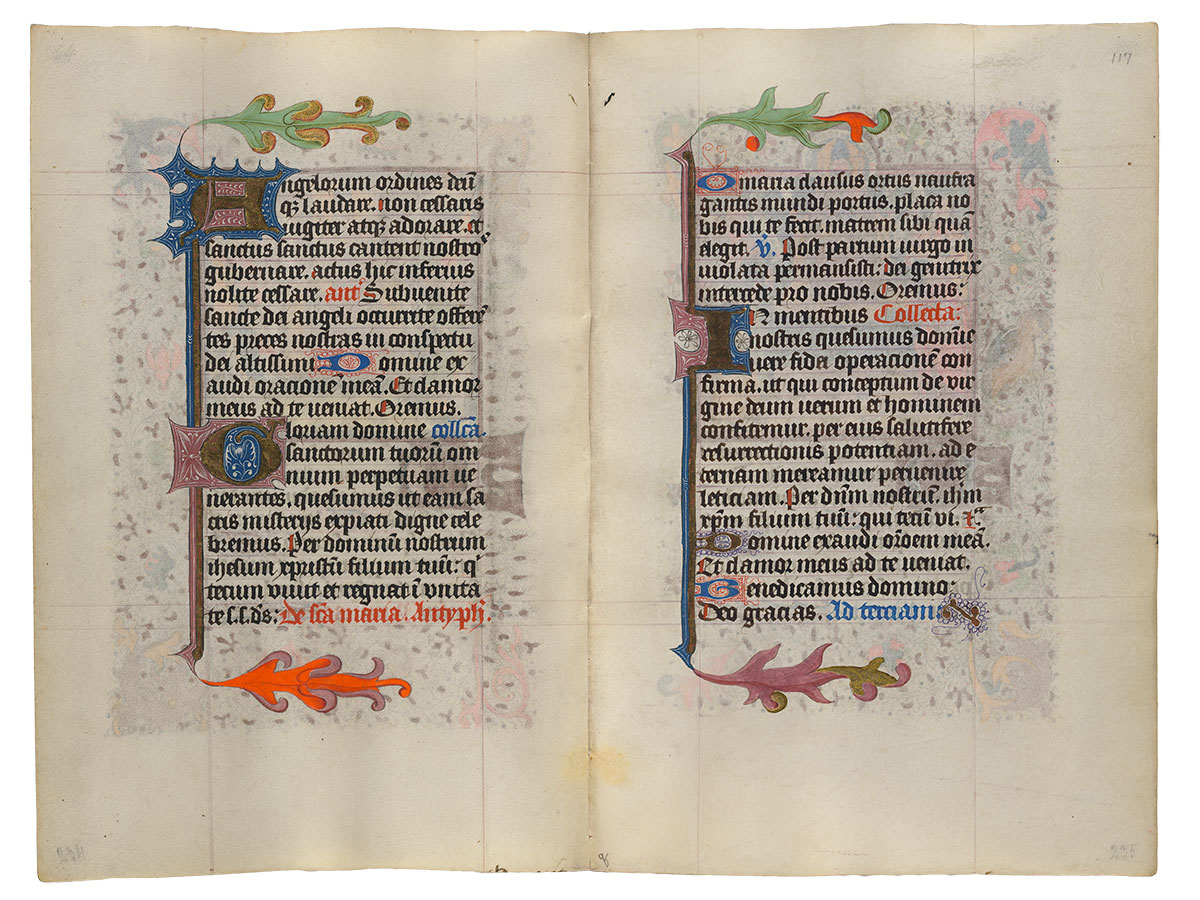
Purchased on the Belle da Costa Greene Fund with the assistance of the Fellows, 1963; purchased on the Belle da Costa Greene Fund with the assistance of the Fellows and with special assistance of Mrs. Frederick B. Adams, Sr., Mrs. Robert Charles, Mr. Laurens M. Hamilton, The Heineman Foundation, Mrs. Donald F. Hyde, Mrs. Jacob M. Kaplan, Mrs. John Kean, Mr. Paul Mellon, Mr. and Mrs. Charles F. Morgan, Mr. Lessing J. Rosenwald, Mr. and Mrs. August H. Schilling, Mrs. Herbert N. Straus, Mrs. Landon K. Thorne, Mrs. Alan Valentine, Mr. and Mrs. Arnold Whitridge, and Miss Julia P. Wightman, 1970
Image courtesy of Faksimile Verlag Luzern
MS M.917/945, ff. 117v–118r
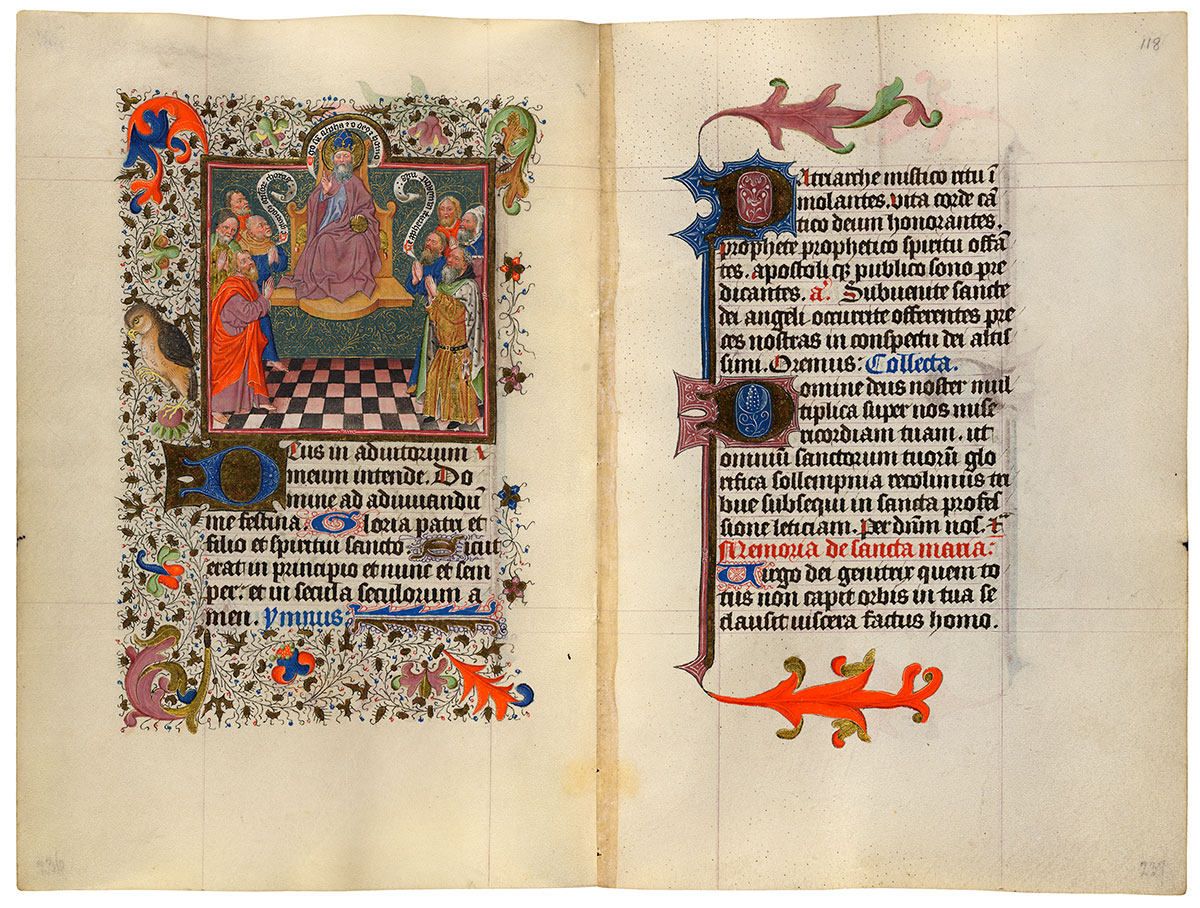
Apostles and Prophets before the Throne of God
Purchased on the Belle da Costa Greene Fund with the assistance of the Fellows and with special assistance of Mrs. Frederick B. Adams, Sr., Mrs. Robert Charles, Mr. Laurens M. Hamilton, The Heineman Foundation, Mrs. Donald F. Hyde, Mrs. Jacob M. Kaplan, Mrs. John Kean, Mr. Paul Mellon, Mr. and Mrs. Charles F. Morgan, Mr. Lessing J. Rosenwald, Mr. and Mrs. August H. Schilling, Mrs. Herbert N. Straus, Mrs. Landon K. Thorne, Mrs. Alan Valentine, Mr. and Mrs. Arnold Whitridge, and Miss Julia P. Wightman, 1970
The small miniatures for the Hours of All Saints group the elect according to Church hierarchy. This image for Terce includes the apostles on the left—barefooted, bareheaded, and simply dressed. On the right are the prophets—shod and somewhat exotically garbed. Identifying each group are scrolls with texts from the Te Deum, the hymn of praise that the angels sing in the Lauds miniature from the Hours of the Virgin. God's scroll proclaims, "I am the alpha and omega, God and man."
Hours and Masses for the Seven Days of the Week
The most unusual texts in Catherine's manuscript are the series of Hours and Masses for every day of the week. Medieval Christian tradition associated certain figures or themes with different days. Thus Sunday, the day of the Resurrection, was the Lord's Day; Thursday was connected with the Eucharist since that sacrament was instituted on Holy Thursday; and Monday was the day of the dead, since their torments were suspended on Sunday but recommenced the following day. In Catherine's prayer book, the themes for the Hours and Masses of the seven days of the week are:
| Sunday | the Trinity |
| Monday | the Dead |
| Tuesday | the Holy Spirit |
| Wednesday | All Saints |
| Thursday | the Blessed Sacrament |
| Friday | the Compassion of God |
| Saturday | the Virgin. |
Image courtesy of Faksimile Verlag Luzern
MS M.917/945, ff. 118v–119r
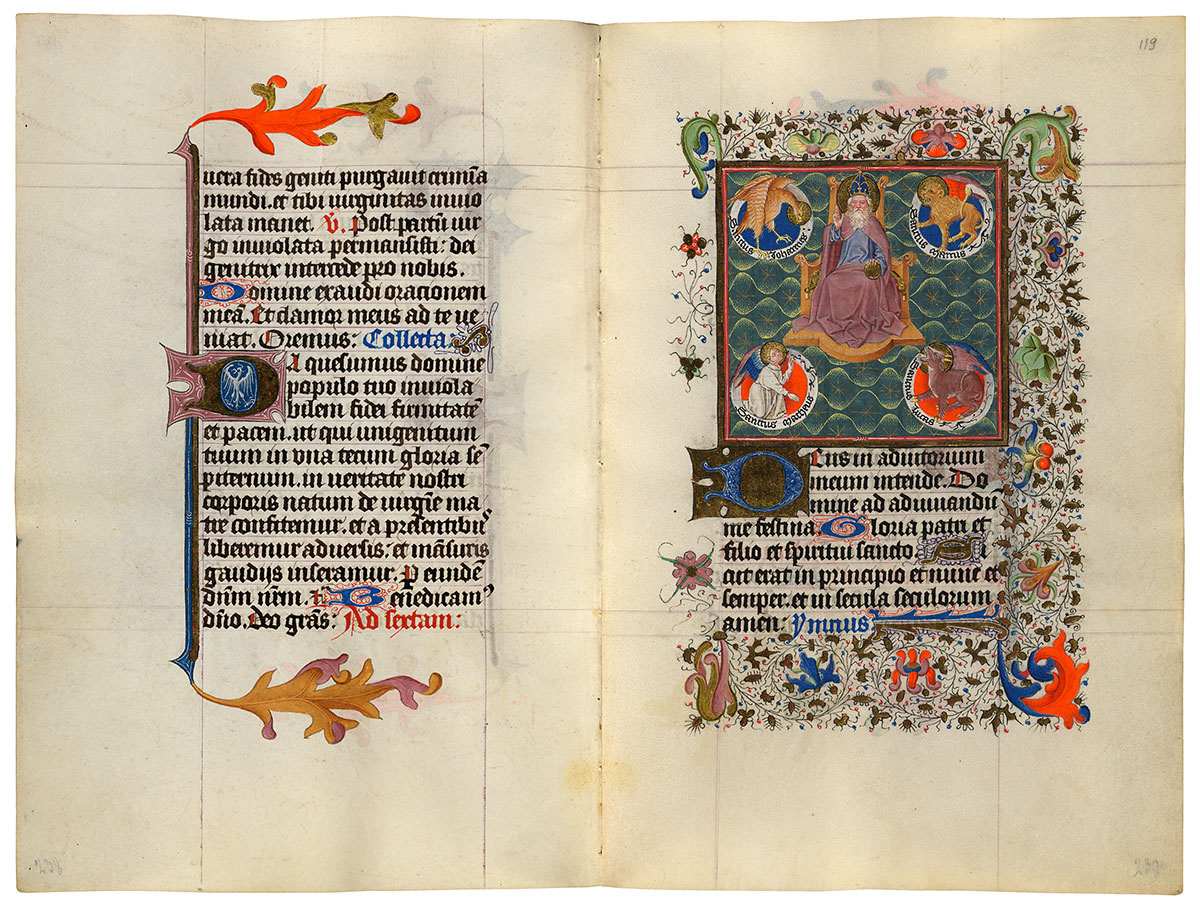
God Surrounded by the Symbols of the Evangelists
Purchased on the Belle da Costa Greene Fund with the assistance of the Fellows and with special assistance of Mrs. Frederick B. Adams, Sr., Mrs. Robert Charles, Mr. Laurens M. Hamilton, The Heineman Foundation, Mrs. Donald F. Hyde, Mrs. Jacob M. Kaplan, Mrs. John Kean, Mr. Paul Mellon, Mr. and Mrs. Charles F. Morgan, Mr. Lessing J. Rosenwald, Mr. and Mrs. August H. Schilling, Mrs. Herbert N. Straus, Mrs. Landon K. Thorne, Mrs. Alan Valentine, Mr. and Mrs. Arnold Whitridge, and Miss Julia P. Wightman, 1970
The hymn in Sext of the Hours of All Saints quotes the evangelists, who mystically recognized God. Hence the miniature shows an enthroned God surrounded by the symbols of the four evangelists—their mystical representation. Clockwise from the upper left are the eagle of John, the lion of Mark, the ox of Luke, and the angel of Matthew. The scrolls give the saints' names.
Hours and Masses for the Seven Days of the Week
The most unusual texts in Catherine's manuscript are the series of Hours and Masses for every day of the week. Medieval Christian tradition associated certain figures or themes with different days. Thus Sunday, the day of the Resurrection, was the Lord's Day; Thursday was connected with the Eucharist since that sacrament was instituted on Holy Thursday; and Monday was the day of the dead, since their torments were suspended on Sunday but recommenced the following day. In Catherine's prayer book, the themes for the Hours and Masses of the seven days of the week are:
| Sunday | the Trinity |
| Monday | the Dead |
| Tuesday | the Holy Spirit |
| Wednesday | All Saints |
| Thursday | the Blessed Sacrament |
| Friday | the Compassion of God |
| Saturday | the Virgin. |
Image courtesy of Faksimile Verlag Luzern
MS M.917/945, ff. 119v–120r
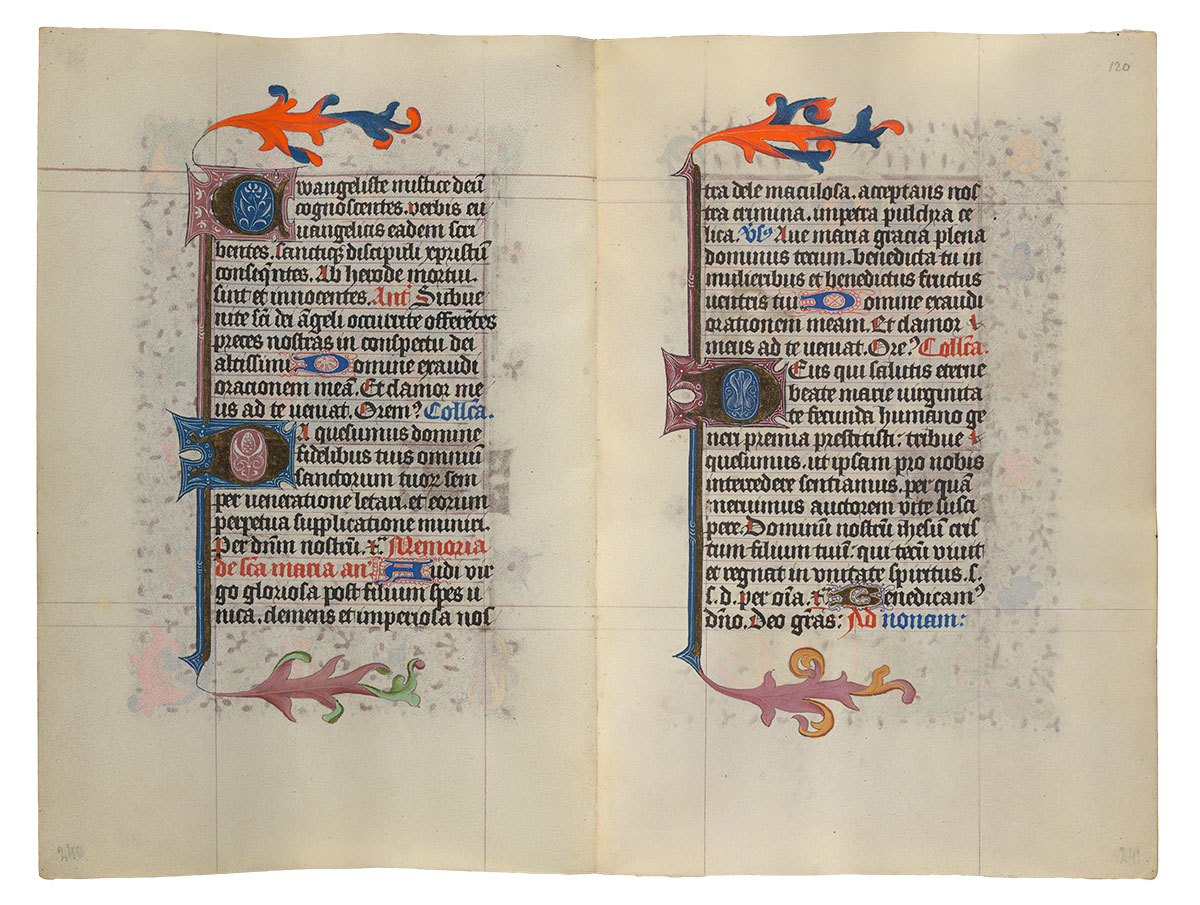
Purchased on the Belle da Costa Greene Fund with the assistance of the Fellows, 1963; purchased on the Belle da Costa Greene Fund with the assistance of the Fellows and with special assistance of Mrs. Frederick B. Adams, Sr., Mrs. Robert Charles, Mr. Laurens M. Hamilton, The Heineman Foundation, Mrs. Donald F. Hyde, Mrs. Jacob M. Kaplan, Mrs. John Kean, Mr. Paul Mellon, Mr. and Mrs. Charles F. Morgan, Mr. Lessing J. Rosenwald, Mr. and Mrs. August H. Schilling, Mrs. Herbert N. Straus, Mrs. Landon K. Thorne, Mrs. Alan Valentine, Mr. and Mrs. Arnold Whitridge, and Miss Julia P. Wightman, 1970
Image courtesy of Faksimile Verlag Luzern
MS M.917/945, ff. 120v–121r
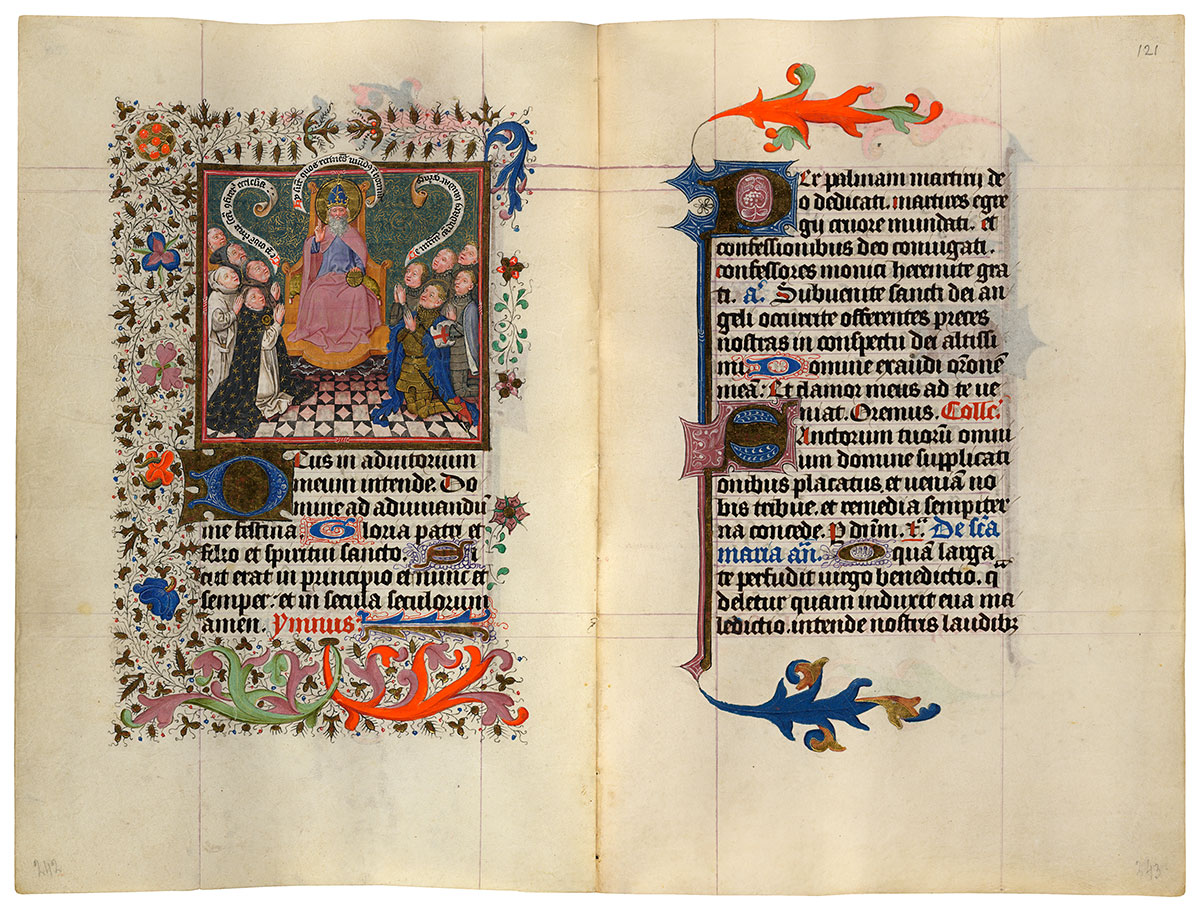
Ecclesiastic and Military Saints before the Throne of God
Purchased on the Belle da Costa Greene Fund with the assistance of the Fellows and with special assistance of Mrs. Frederick B. Adams, Sr., Mrs. Robert Charles, Mr. Laurens M. Hamilton, The Heineman Foundation, Mrs. Donald F. Hyde, Mrs. Jacob M. Kaplan, Mrs. John Kean, Mr. Paul Mellon, Mr. and Mrs. Charles F. Morgan, Mr. Lessing J. Rosenwald, Mr. and Mrs. August H. Schilling, Mrs. Herbert N. Straus, Mrs. Landon K. Thorne, Mrs. Alan Valentine, Mr. and Mrs. Arnold Whitridge, and Miss Julia P. Wightman, 1970
Hours and Masses for the Seven Days of the Week
The most unusual texts in Catherine's manuscript are the series of Hours and Masses for every day of the week. Medieval Christian tradition associated certain figures or themes with different days. Thus Sunday, the day of the Resurrection, was the Lord's Day; Thursday was connected with the Eucharist since that sacrament was instituted on Holy Thursday; and Monday was the day of the dead, since their torments were suspended on Sunday but recommenced the following day. In Catherine's prayer book, the themes for the Hours and Masses of the seven days of the week are:
| Sunday | the Trinity |
| Monday | the Dead |
| Tuesday | the Holy Spirit |
| Wednesday | All Saints |
| Thursday | the Blessed Sacrament |
| Friday | the Compassion of God |
| Saturday | the Virgin. |
Image courtesy of Faksimile Verlag Luzern
MS M.917/945, ff. 121v–122r
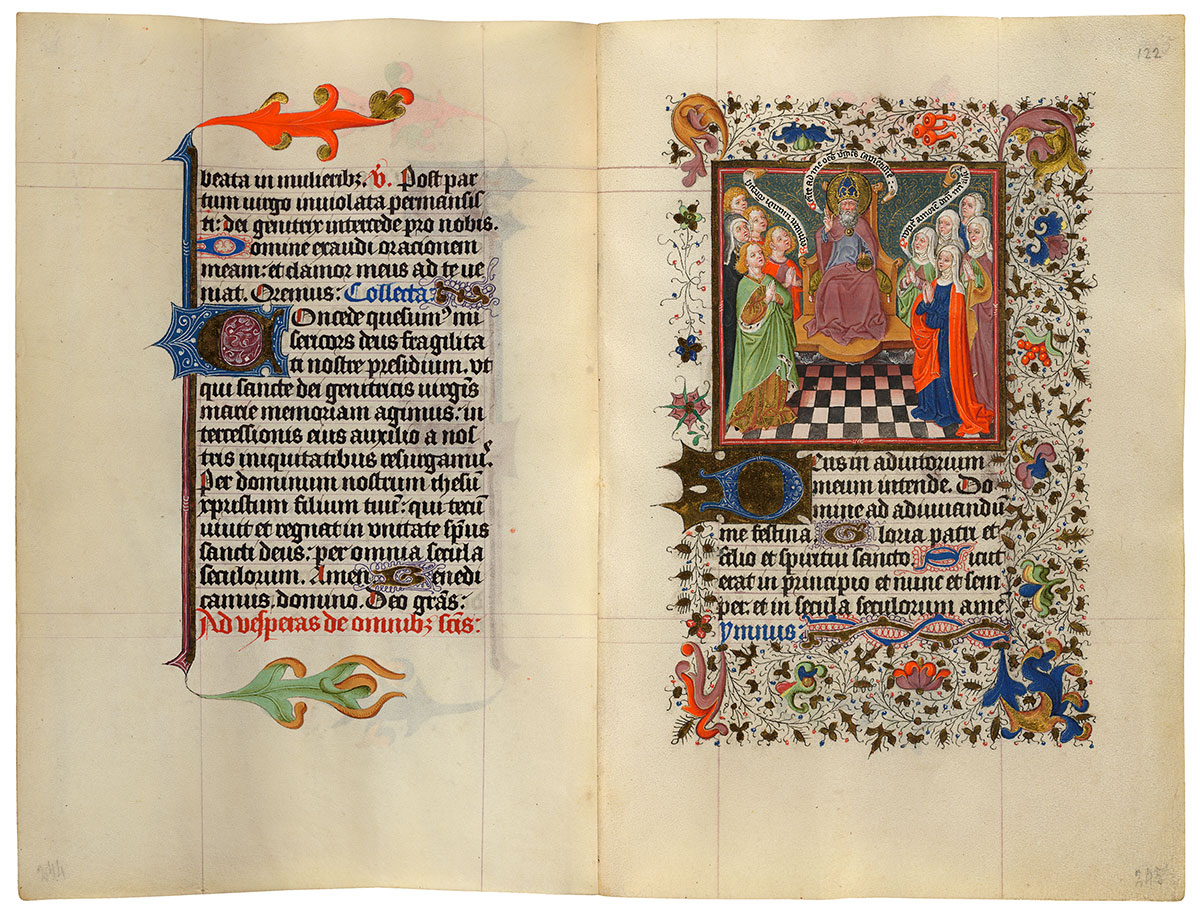
Virgins before the Throne of God
Purchased on the Belle da Costa Greene Fund with the assistance of the Fellows and with special assistance of Mrs. Frederick B. Adams, Sr., Mrs. Robert Charles, Mr. Laurens M. Hamilton, The Heineman Foundation, Mrs. Donald F. Hyde, Mrs. Jacob M. Kaplan, Mrs. John Kean, Mr. Paul Mellon, Mr. and Mrs. Charles F. Morgan, Mr. Lessing J. Rosenwald, Mr. and Mrs. August H. Schilling, Mrs. Herbert N. Straus, Mrs. Landon K. Thorne, Mrs. Alan Valentine, Mr. and Mrs. Arnold Whitridge, and Miss Julia P. Wightman, 1970
Hours and Masses for the Seven Days of the Week
The most unusual texts in Catherine's manuscript are the series of Hours and Masses for every day of the week. Medieval Christian tradition associated certain figures or themes with different days. Thus Sunday, the day of the Resurrection, was the Lord's Day; Thursday was connected with the Eucharist since that sacrament was instituted on Holy Thursday; and Monday was the day of the dead, since their torments were suspended on Sunday but recommenced the following day. In Catherine's prayer book, the themes for the Hours and Masses of the seven days of the week are:
| Sunday | the Trinity |
| Monday | the Dead |
| Tuesday | the Holy Spirit |
| Wednesday | All Saints |
| Thursday | the Blessed Sacrament |
| Friday | the Compassion of God |
| Saturday | the Virgin. |
Image courtesy of Faksimile Verlag Luzern
MS M.917/945, f. 122v–p.43
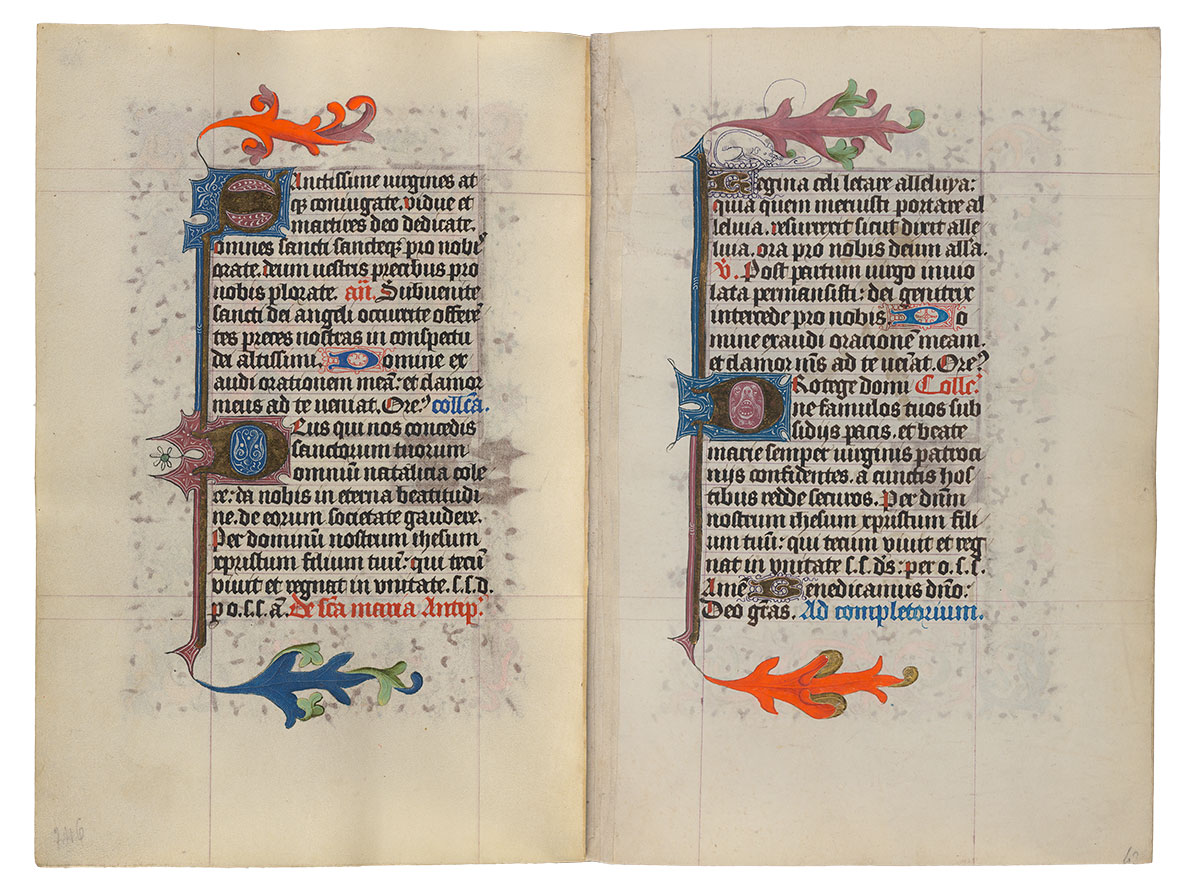
Purchased on the Belle da Costa Greene Fund with the assistance of the Fellows, 1963; purchased on the Belle da Costa Greene Fund with the assistance of the Fellows and with special assistance of Mrs. Frederick B. Adams, Sr., Mrs. Robert Charles, Mr. Laurens M. Hamilton, The Heineman Foundation, Mrs. Donald F. Hyde, Mrs. Jacob M. Kaplan, Mrs. John Kean, Mr. Paul Mellon, Mr. and Mrs. Charles F. Morgan, Mr. Lessing J. Rosenwald, Mr. and Mrs. August H. Schilling, Mrs. Herbert N. Straus, Mrs. Landon K. Thorne, Mrs. Alan Valentine, Mr. and Mrs. Arnold Whitridge, and Miss Julia P. Wightman, 1970
Image courtesy of Faksimile Verlag Luzern
MS M.917/945, p. 44–f. 123r
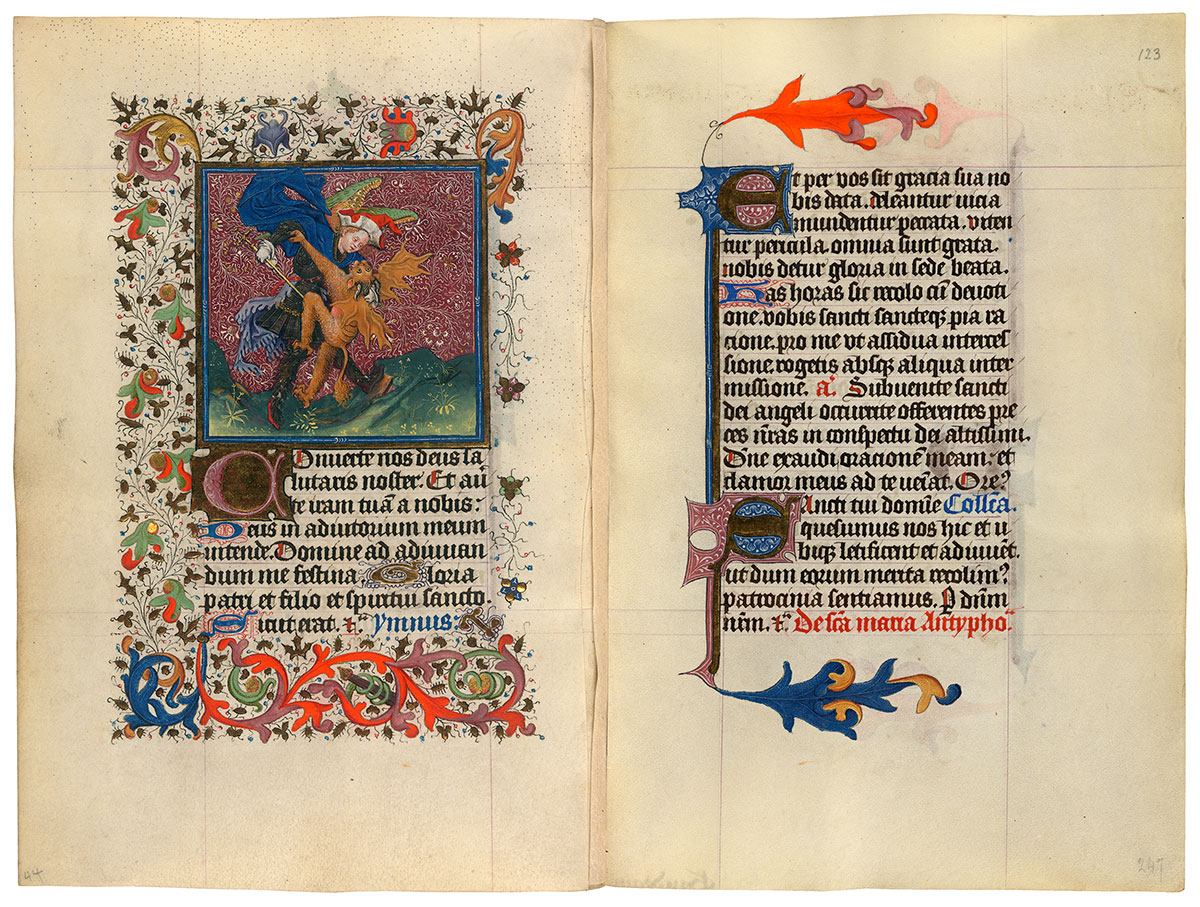
St. Michael Battling a Demon
Purchased on the Belle da Costa Greene Fund with the assistance of the Fellows, 1963; purchased on the Belle da Costa Greene Fund with the assistance of the Fellows and with special assistance of Mrs. Frederick B. Adams, Sr., Mrs. Robert Charles, Mr. Laurens M. Hamilton, The Heineman Foundation, Mrs. Donald F. Hyde, Mrs. Jacob M. Kaplan, Mrs. John Kean, Mr. Paul Mellon, Mr. and Mrs. Charles F. Morgan, Mr. Lessing J. Rosenwald, Mr. and Mrs. August H. Schilling, Mrs. Herbert N. Straus, Mrs. Landon K. Thorne, Mrs. Alan Valentine, Mr. and Mrs. Arnold Whitridge, and Miss Julia P. Wightman, 1970
The last of the miniatures for the Hours of All Saints is this unusual—but striking—image of Michael engaged in a fierce fight with a demon. (All the other miniatures in the series depict quiet adoration of the Godhead.) Michael's face might remain calm, but his windblown clothing reflects the heat of his battle against an especially nasty-looking demon. The white tendrils of the background, while decorative, contribute to the sense of agitation.
Hours and Masses for the Seven Days of the Week
The most unusual texts in Catherine's manuscript are the series of Hours and Masses for every day of the week. Medieval Christian tradition associated certain figures or themes with different days. Thus Sunday, the day of the Resurrection, was the Lord's Day; Thursday was connected with the Eucharist since that sacrament was instituted on Holy Thursday; and Monday was the day of the dead, since their torments were suspended on Sunday but recommenced the following day. In Catherine's prayer book, the themes for the Hours and Masses of the seven days of the week are:
| Sunday | the Trinity |
| Monday | the Dead |
| Tuesday | the Holy Spirit |
| Wednesday | All Saints |
| Thursday | the Blessed Sacrament |
| Friday | the Compassion of God |
| Saturday | the Virgin. |
Image courtesy of Faksimile Verlag Luzern
MS M.917/945, ff. 123v–124r

SS. Peter, John the Baptist, and Martin
Purchased on the Belle da Costa Greene Fund with the assistance of the Fellows and with special assistance of Mrs. Frederick B. Adams, Sr., Mrs. Robert Charles, Mr. Laurens M. Hamilton, The Heineman Foundation, Mrs. Donald F. Hyde, Mrs. Jacob M. Kaplan, Mrs. John Kean, Mr. Paul Mellon, Mr. and Mrs. Charles F. Morgan, Mr. Lessing J. Rosenwald, Mr. and Mrs. August H. Schilling, Mrs. Herbert N. Straus, Mrs. Landon K. Thorne, Mrs. Alan Valentine, Mr. and Mrs. Arnold Whitridge, and Miss Julia P. Wightman, 1970
This small miniature for the Mass of All Saints includes three popular saints, each identifiable by his attributes. Peter, wearing a papal tiara, holds the keys to heaven. Beneath his cloak, John the Baptist wears a camel skin and holds the Lamb of God on his book. Martin, dressed as a bishop, shares his cloak with a beggar. This small image was originally juxtaposed with a full-page miniature that is lost. Its disappearance makes any attempt to reconstruct the original context of the remaining depiction challenging.
Hours and Masses for the Seven Days of the Week
The most unusual texts in Catherine's manuscript are the series of Hours and Masses for every day of the week. Medieval Christian tradition associated certain figures or themes with different days. Thus Sunday, the day of the Resurrection, was the Lord's Day; Thursday was connected with the Eucharist since that sacrament was instituted on Holy Thursday; and Monday was the day of the dead, since their torments were suspended on Sunday but recommenced the following day. In Catherine's prayer book, the themes for the Hours and Masses of the seven days of the week are:
| Sunday | the Trinity |
| Monday | the Dead |
| Tuesday | the Holy Spirit |
| Wednesday | All Saints |
| Thursday | the Blessed Sacrament |
| Friday | the Compassion of God |
| Saturday | the Virgin. |
Image courtesy of Faksimile Verlag Luzern
MS M.917/945, ff. 124v–125r
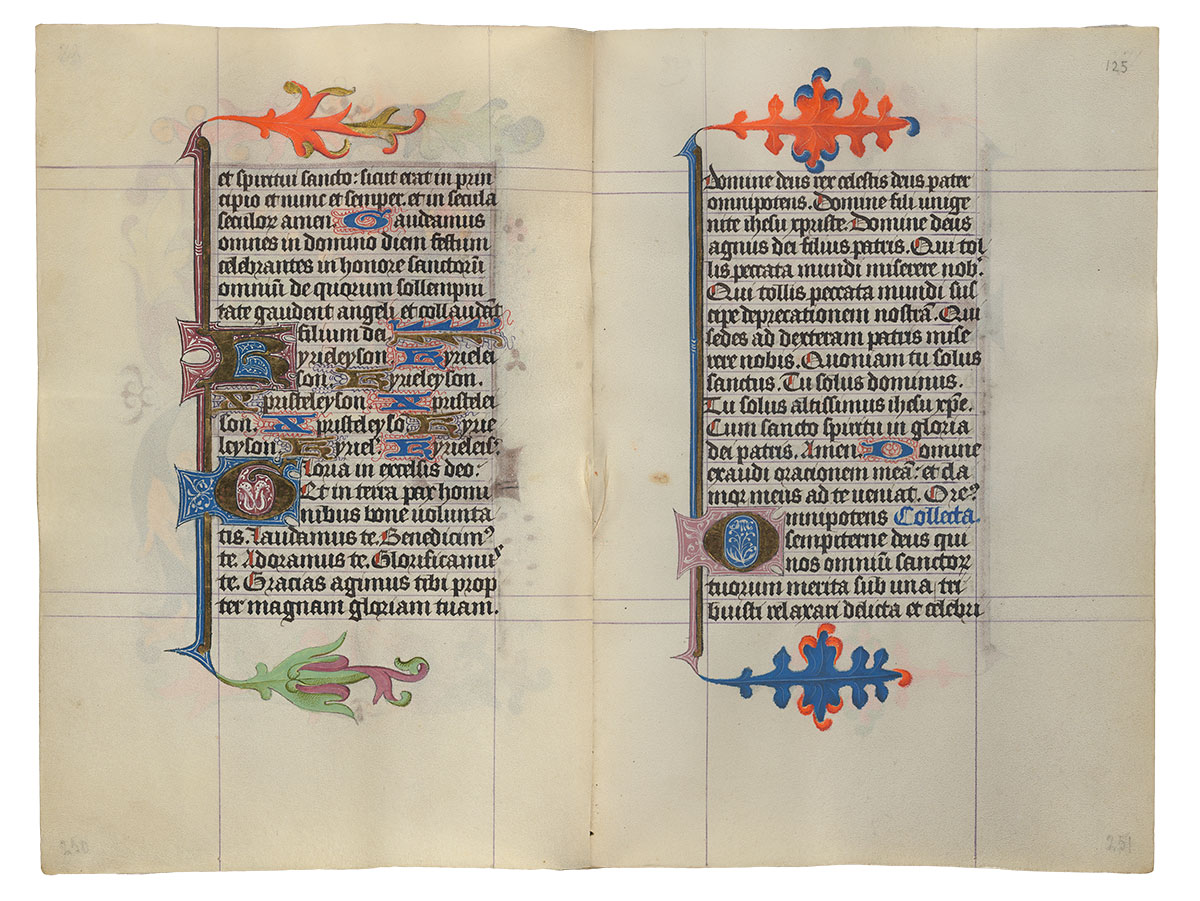
Purchased on the Belle da Costa Greene Fund with the assistance of the Fellows and with special assistance of Mrs. Frederick B. Adams, Sr., Mrs. Robert Charles, Mr. Laurens M. Hamilton, The Heineman Foundation, Mrs. Donald F. Hyde, Mrs. Jacob M. Kaplan, Mrs. John Kean, Mr. Paul Mellon, Mr. and Mrs. Charles F. Morgan, Mr. Lessing J. Rosenwald, Mr. and Mrs. August H. Schilling, Mrs. Herbert N. Straus, Mrs. Landon K. Thorne, Mrs. Alan Valentine, Mr. and Mrs. Arnold Whitridge, and Miss Julia P. Wightman, 1970
Image courtesy of Faksimile Verlag Luzern
MS M.917/945, ff. 125v–126r
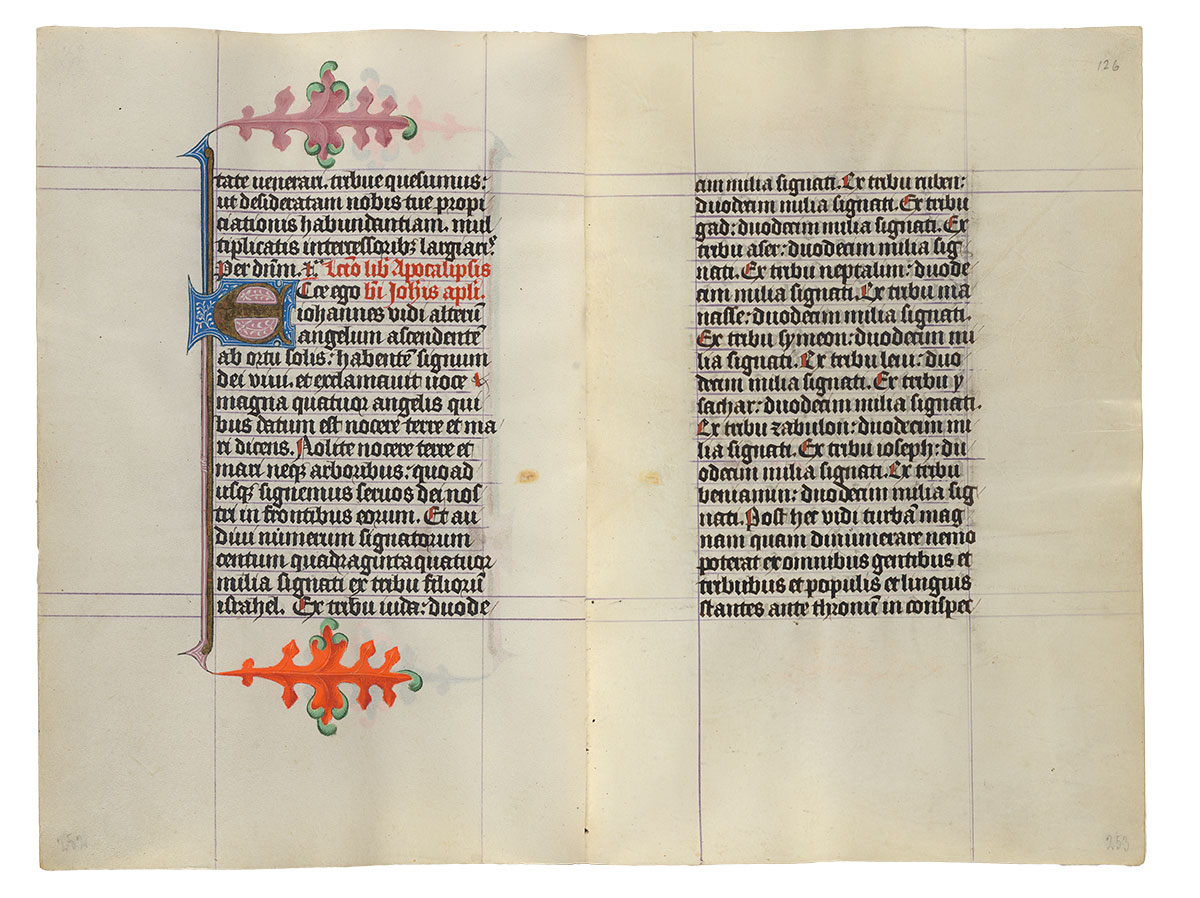
Purchased on the Belle da Costa Greene Fund with the assistance of the Fellows and with special assistance of Mrs. Frederick B. Adams, Sr., Mrs. Robert Charles, Mr. Laurens M. Hamilton, The Heineman Foundation, Mrs. Donald F. Hyde, Mrs. Jacob M. Kaplan, Mrs. John Kean, Mr. Paul Mellon, Mr. and Mrs. Charles F. Morgan, Mr. Lessing J. Rosenwald, Mr. and Mrs. August H. Schilling, Mrs. Herbert N. Straus, Mrs. Landon K. Thorne, Mrs. Alan Valentine, Mr. and Mrs. Arnold Whitridge, and Miss Julia P. Wightman, 1970
Image courtesy of Faksimile Verlag Luzern
MS M.917/945, ff. 126v–127r
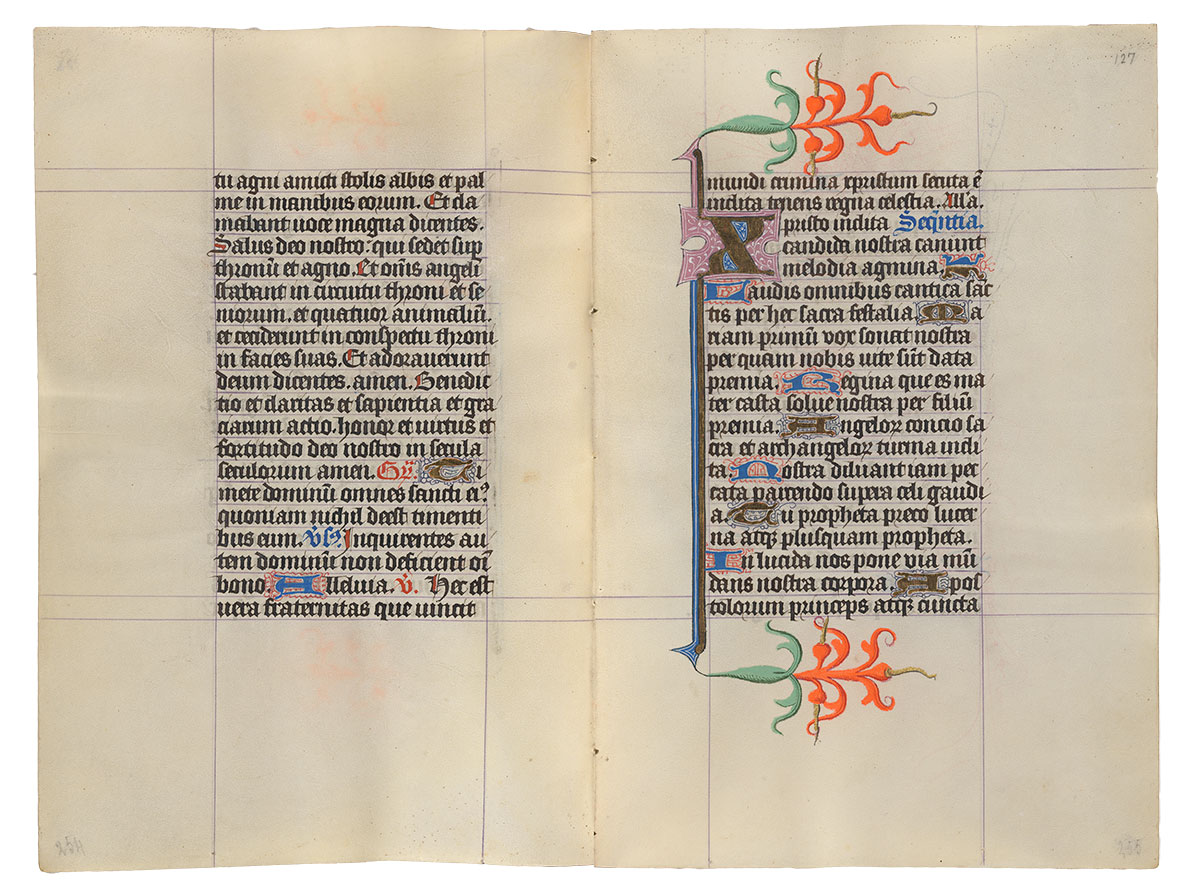
Purchased on the Belle da Costa Greene Fund with the assistance of the Fellows and with special assistance of Mrs. Frederick B. Adams, Sr., Mrs. Robert Charles, Mr. Laurens M. Hamilton, The Heineman Foundation, Mrs. Donald F. Hyde, Mrs. Jacob M. Kaplan, Mrs. John Kean, Mr. Paul Mellon, Mr. and Mrs. Charles F. Morgan, Mr. Lessing J. Rosenwald, Mr. and Mrs. August H. Schilling, Mrs. Herbert N. Straus, Mrs. Landon K. Thorne, Mrs. Alan Valentine, Mr. and Mrs. Arnold Whitridge, and Miss Julia P. Wightman, 1970
Image courtesy of Faksimile Verlag Luzern
MS M.917/945, ff. 127v–128r
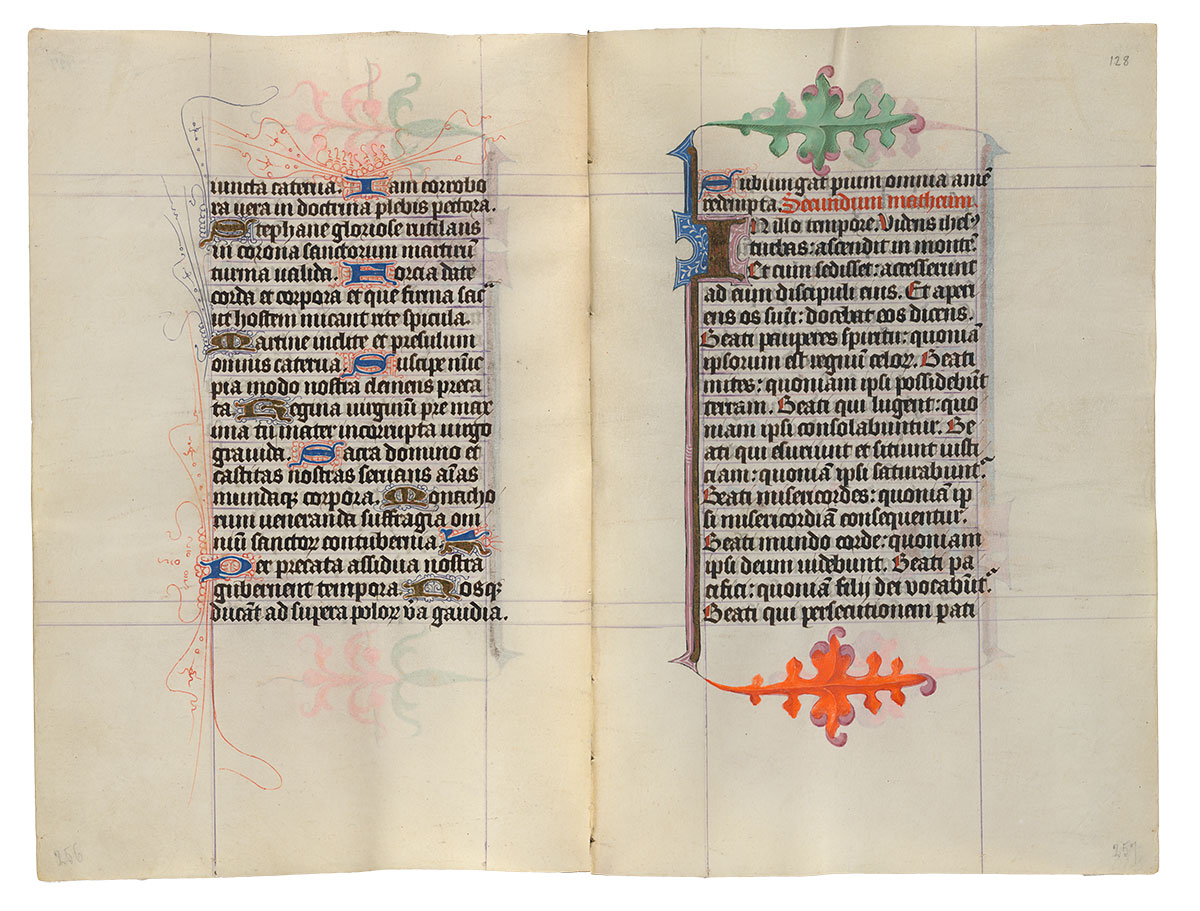
Purchased on the Belle da Costa Greene Fund with the assistance of the Fellows and with special assistance of Mrs. Frederick B. Adams, Sr., Mrs. Robert Charles, Mr. Laurens M. Hamilton, The Heineman Foundation, Mrs. Donald F. Hyde, Mrs. Jacob M. Kaplan, Mrs. John Kean, Mr. Paul Mellon, Mr. and Mrs. Charles F. Morgan, Mr. Lessing J. Rosenwald, Mr. and Mrs. August H. Schilling, Mrs. Herbert N. Straus, Mrs. Landon K. Thorne, Mrs. Alan Valentine, Mr. and Mrs. Arnold Whitridge, and Miss Julia P. Wightman, 1970
Image courtesy of Faksimile Verlag Luzern
MS M.917/945, ff. 128v–129r
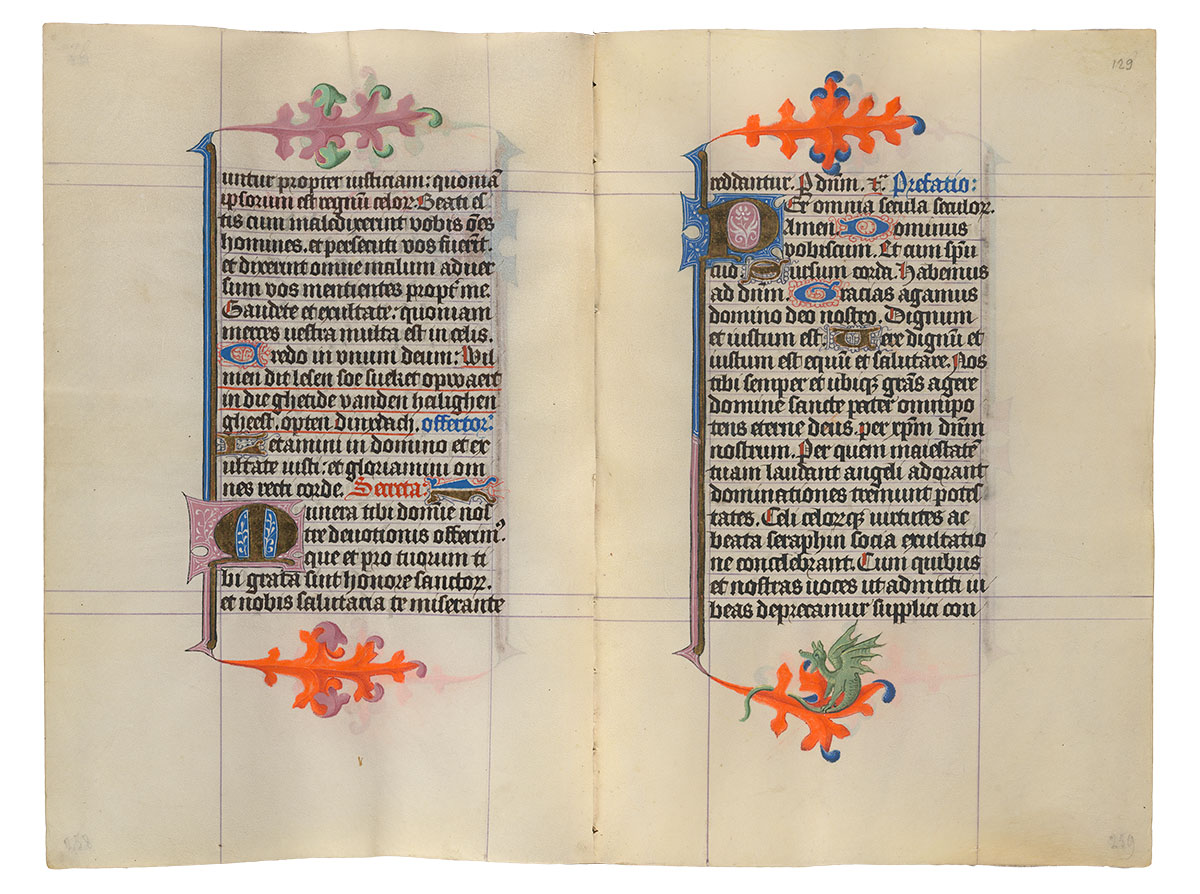
Purchased on the Belle da Costa Greene Fund with the assistance of the Fellows and with special assistance of Mrs. Frederick B. Adams, Sr., Mrs. Robert Charles, Mr. Laurens M. Hamilton, The Heineman Foundation, Mrs. Donald F. Hyde, Mrs. Jacob M. Kaplan, Mrs. John Kean, Mr. Paul Mellon, Mr. and Mrs. Charles F. Morgan, Mr. Lessing J. Rosenwald, Mr. and Mrs. August H. Schilling, Mrs. Herbert N. Straus, Mrs. Landon K. Thorne, Mrs. Alan Valentine, Mr. and Mrs. Arnold Whitridge, and Miss Julia P. Wightman, 1970
Image courtesy of Faksimile Verlag Luzern
MS M.917/945, ff. 129v–130r
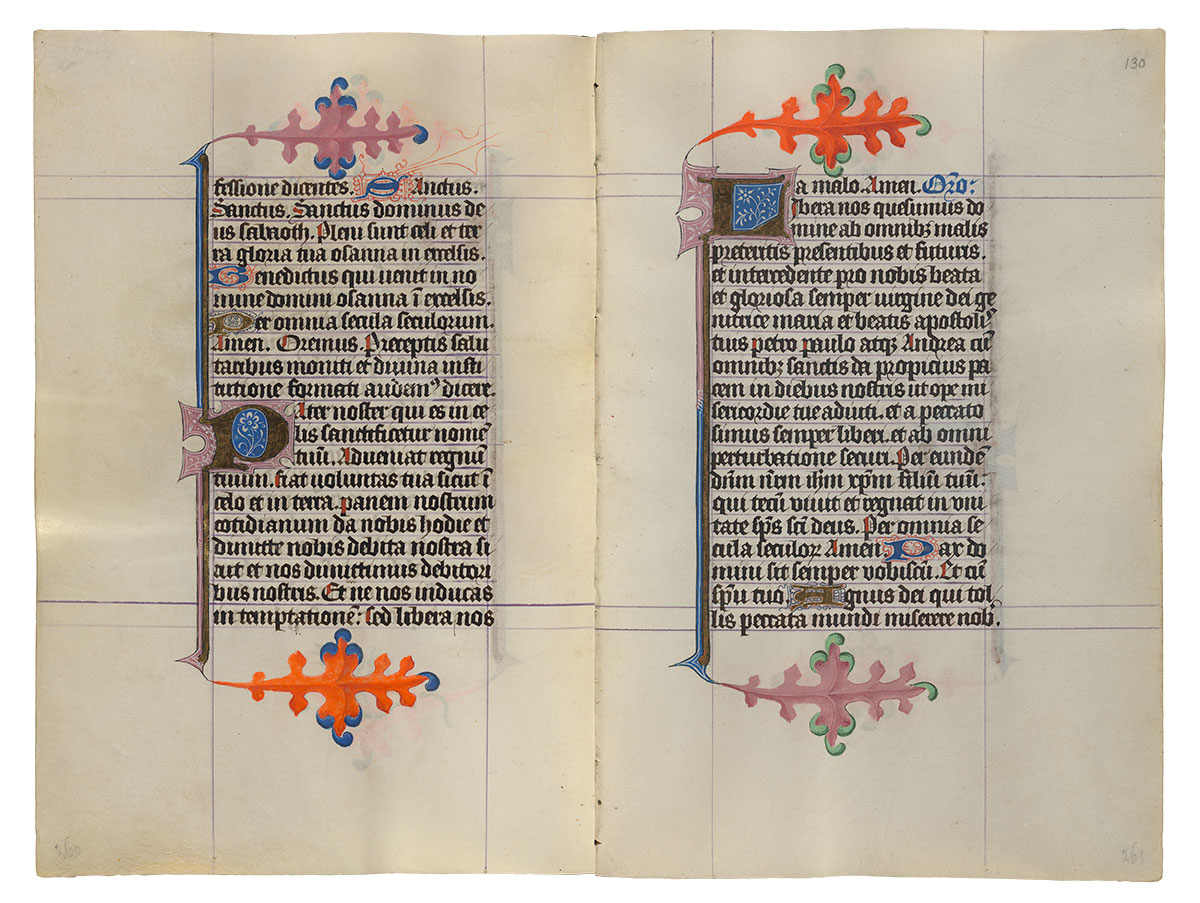
Purchased on the Belle da Costa Greene Fund with the assistance of the Fellows and with special assistance of Mrs. Frederick B. Adams, Sr., Mrs. Robert Charles, Mr. Laurens M. Hamilton, The Heineman Foundation, Mrs. Donald F. Hyde, Mrs. Jacob M. Kaplan, Mrs. John Kean, Mr. Paul Mellon, Mr. and Mrs. Charles F. Morgan, Mr. Lessing J. Rosenwald, Mr. and Mrs. August H. Schilling, Mrs. Herbert N. Straus, Mrs. Landon K. Thorne, Mrs. Alan Valentine, Mr. and Mrs. Arnold Whitridge, and Miss Julia P. Wightman, 1970
Image courtesy of Faksimile Verlag Luzern
MS M.917/945, ff. 130v–131r
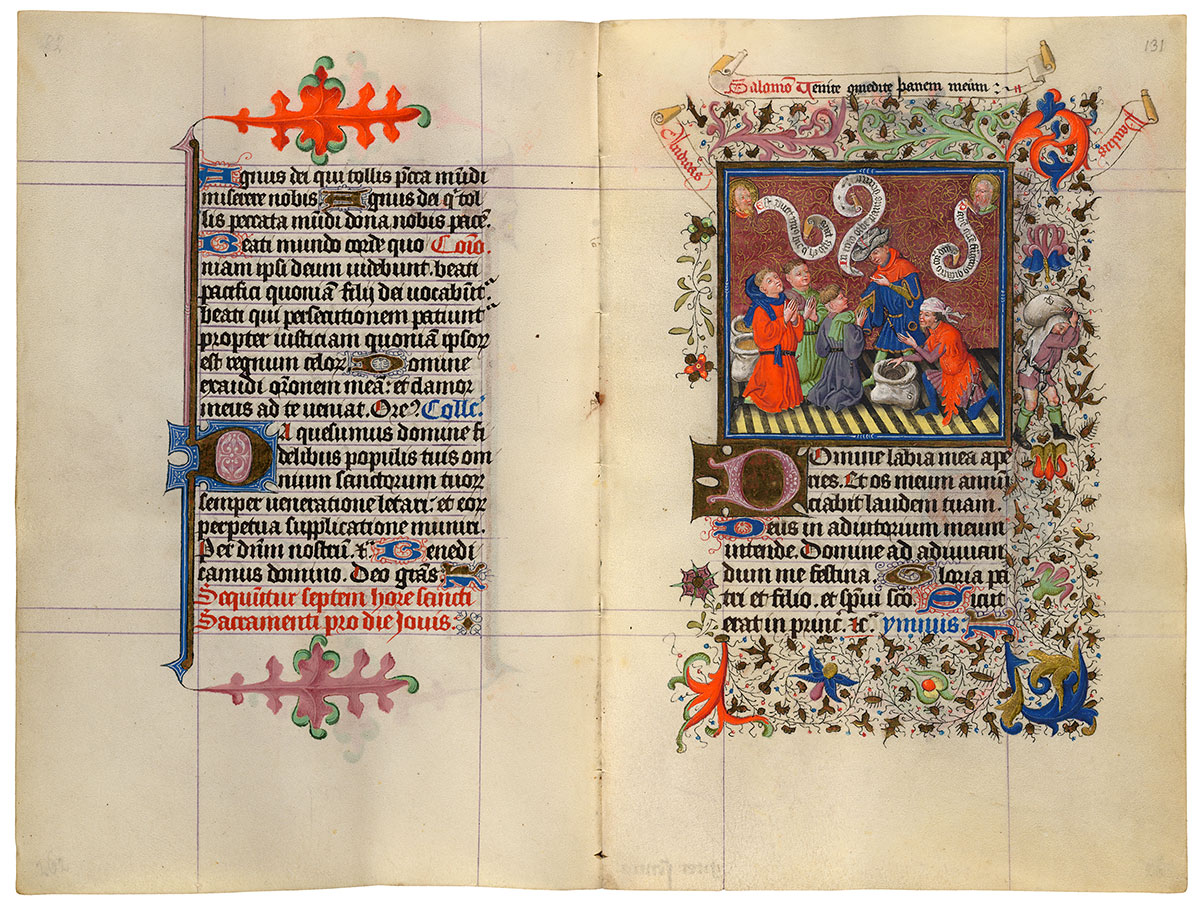
Joseph Reveals Himself to his Brothers
Purchased on the Belle da Costa Greene Fund with the assistance of the Fellows and with special assistance of Mrs. Frederick B. Adams, Sr., Mrs. Robert Charles, Mr. Laurens M. Hamilton, The Heineman Foundation, Mrs. Donald F. Hyde, Mrs. Jacob M. Kaplan, Mrs. John Kean, Mr. Paul Mellon, Mr. and Mrs. Charles F. Morgan, Mr. Lessing J. Rosenwald, Mr. and Mrs. August H. Schilling, Mrs. Herbert N. Straus, Mrs. Landon K. Thorne, Mrs. Alan Valentine, Mr. and Mrs. Arnold Whitridge, and Miss Julia P. Wightman, 1970
Hours and Masses for the Seven Days of the Week
The most unusual texts in Catherine's manuscript are the series of Hours and Masses for every day of the week. Medieval Christian tradition associated certain figures or themes with different days. Thus Sunday, the day of the Resurrection, was the Lord's Day; Thursday was connected with the Eucharist since that sacrament was instituted on Holy Thursday; and Monday was the day of the dead, since their torments were suspended on Sunday but recommenced the following day. In Catherine's prayer book, the themes for the Hours and Masses of the seven days of the week are:
| Sunday | the Trinity |
| Monday | the Dead |
| Tuesday | the Holy Spirit |
| Wednesday | All Saints |
| Thursday | the Blessed Sacrament |
| Friday | the Compassion of God |
| Saturday | the Virgin. |
Image courtesy of Faksimile Verlag Luzern
MS M.917/945, ff. 131v–132r
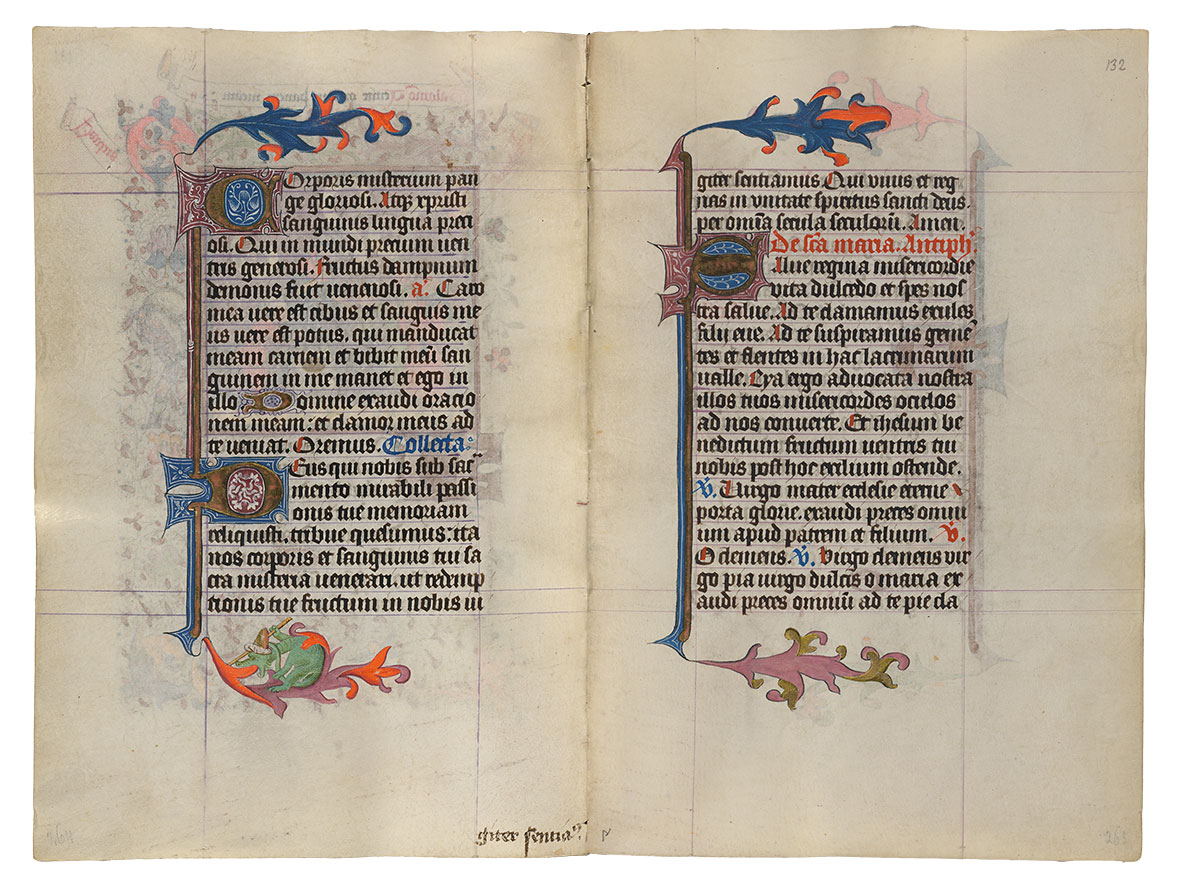
Purchased on the Belle da Costa Greene Fund with the assistance of the Fellows and with special assistance of Mrs. Frederick B. Adams, Sr., Mrs. Robert Charles, Mr. Laurens M. Hamilton, The Heineman Foundation, Mrs. Donald F. Hyde, Mrs. Jacob M. Kaplan, Mrs. John Kean, Mr. Paul Mellon, Mr. and Mrs. Charles F. Morgan, Mr. Lessing J. Rosenwald, Mr. and Mrs. August H. Schilling, Mrs. Herbert N. Straus, Mrs. Landon K. Thorne, Mrs. Alan Valentine, Mr. and Mrs. Arnold Whitridge, and Miss Julia P. Wightman, 1970
Image courtesy of Faksimile Verlag Luzern
MS M.917/945, ff. 132v–133r
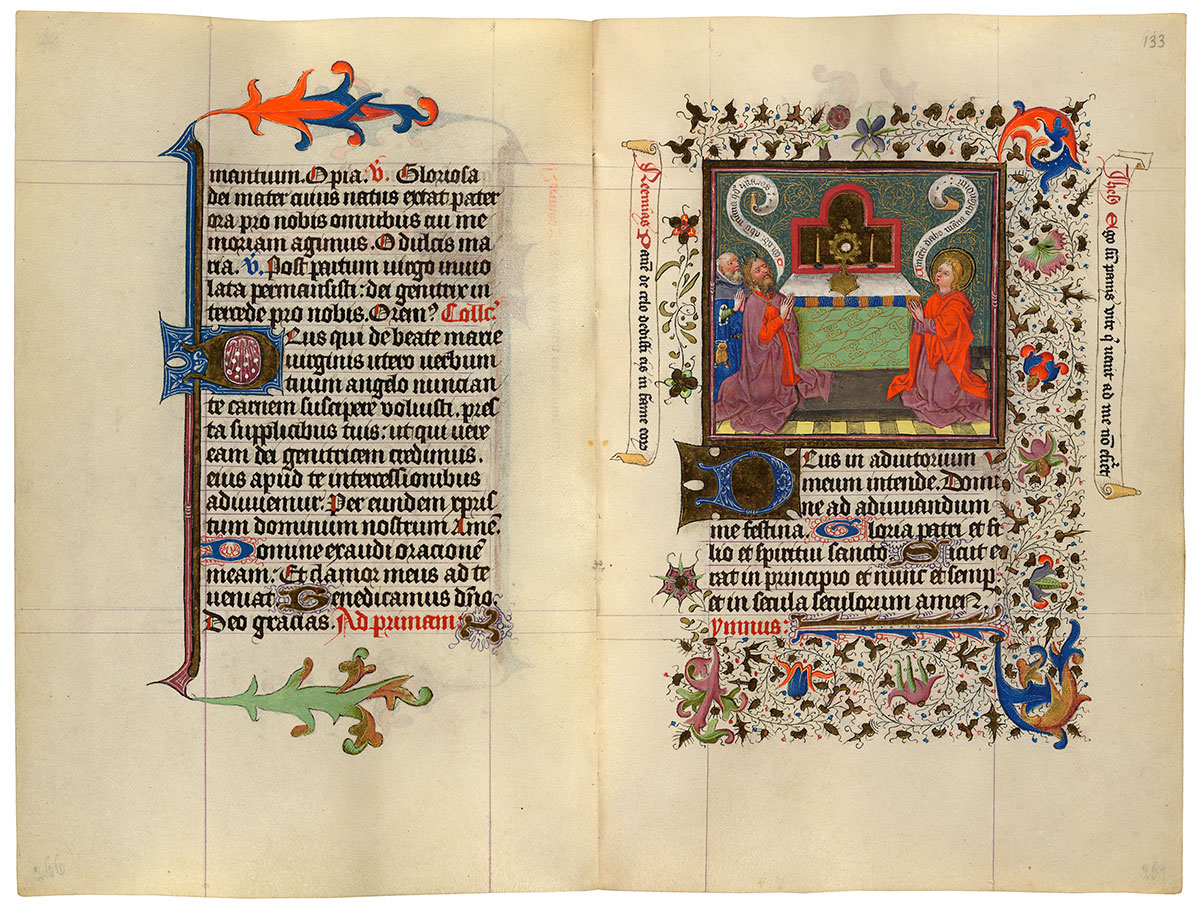
The Eucharist Adored by Moses and St. John the Evangelist
Purchased on the Belle da Costa Greene Fund with the assistance of the Fellows and with special assistance of Mrs. Frederick B. Adams, Sr., Mrs. Robert Charles, Mr. Laurens M. Hamilton, The Heineman Foundation, Mrs. Donald F. Hyde, Mrs. Jacob M. Kaplan, Mrs. John Kean, Mr. Paul Mellon, Mr. and Mrs. Charles F. Morgan, Mr. Lessing J. Rosenwald, Mr. and Mrs. August H. Schilling, Mrs. Herbert N. Straus, Mrs. Landon K. Thorne, Mrs. Alan Valentine, Mr. and Mrs. Arnold Whitridge, and Miss Julia P. Wightman, 1970
Hours and Masses for the Seven Days of the Week
The most unusual texts in Catherine's manuscript are the series of Hours and Masses for every day of the week. Medieval Christian tradition associated certain figures or themes with different days. Thus Sunday, the day of the Resurrection, was the Lord's Day; Thursday was connected with the Eucharist since that sacrament was instituted on Holy Thursday; and Monday was the day of the dead, since their torments were suspended on Sunday but recommenced the following day. In Catherine's prayer book, the themes for the Hours and Masses of the seven days of the week are:
| Sunday | the Trinity |
| Monday | the Dead |
| Tuesday | the Holy Spirit |
| Wednesday | All Saints |
| Thursday | the Blessed Sacrament |
| Friday | the Compassion of God |
| Saturday | the Virgin. |
Image courtesy of Faksimile Verlag Luzern
MS M.917/945, ff. 133v–134r
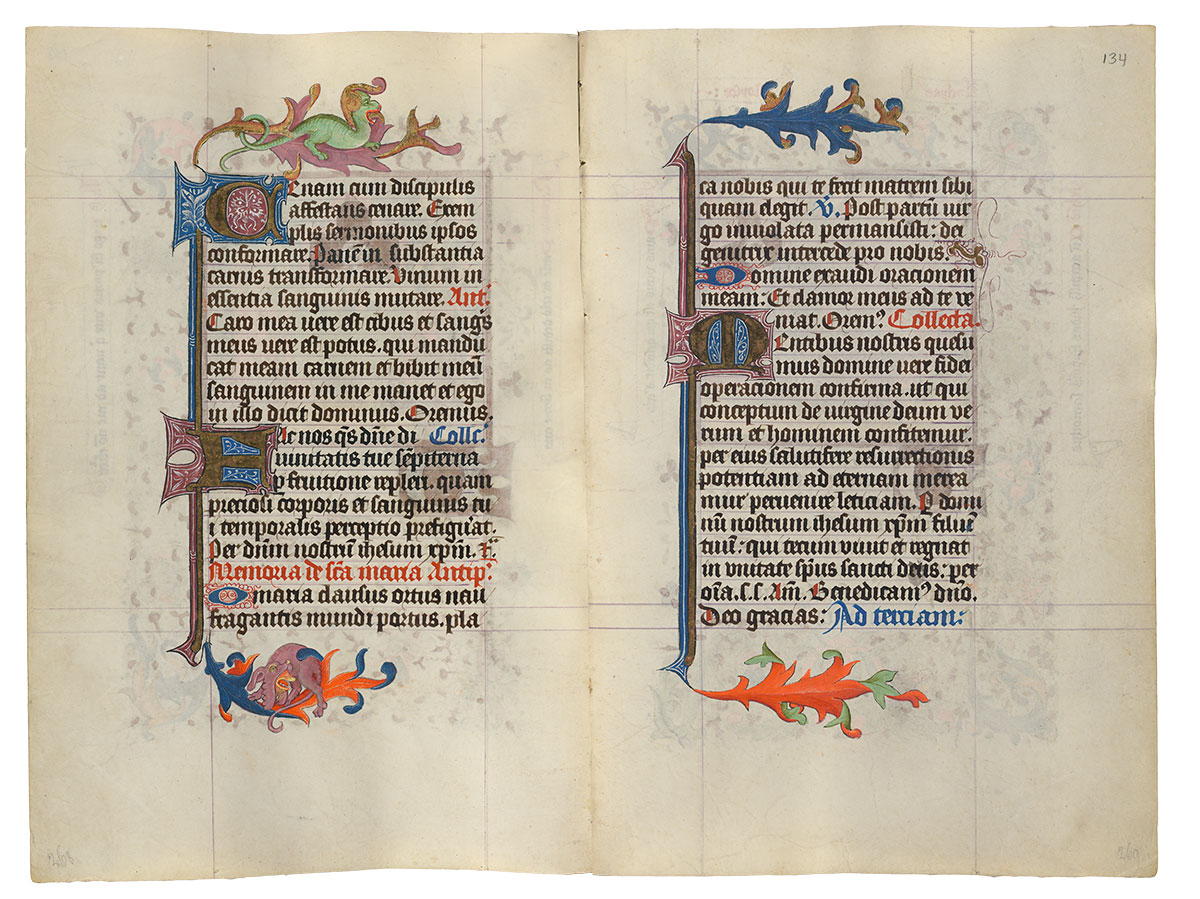
Purchased on the Belle da Costa Greene Fund with the assistance of the Fellows and with special assistance of Mrs. Frederick B. Adams, Sr., Mrs. Robert Charles, Mr. Laurens M. Hamilton, The Heineman Foundation, Mrs. Donald F. Hyde, Mrs. Jacob M. Kaplan, Mrs. John Kean, Mr. Paul Mellon, Mr. and Mrs. Charles F. Morgan, Mr. Lessing J. Rosenwald, Mr. and Mrs. August H. Schilling, Mrs. Herbert N. Straus, Mrs. Landon K. Thorne, Mrs. Alan Valentine, Mr. and Mrs. Arnold Whitridge, and Miss Julia P. Wightman, 1970
Image courtesy of Faksimile Verlag Luzern
MS M.917/945, ff. 134v–135r
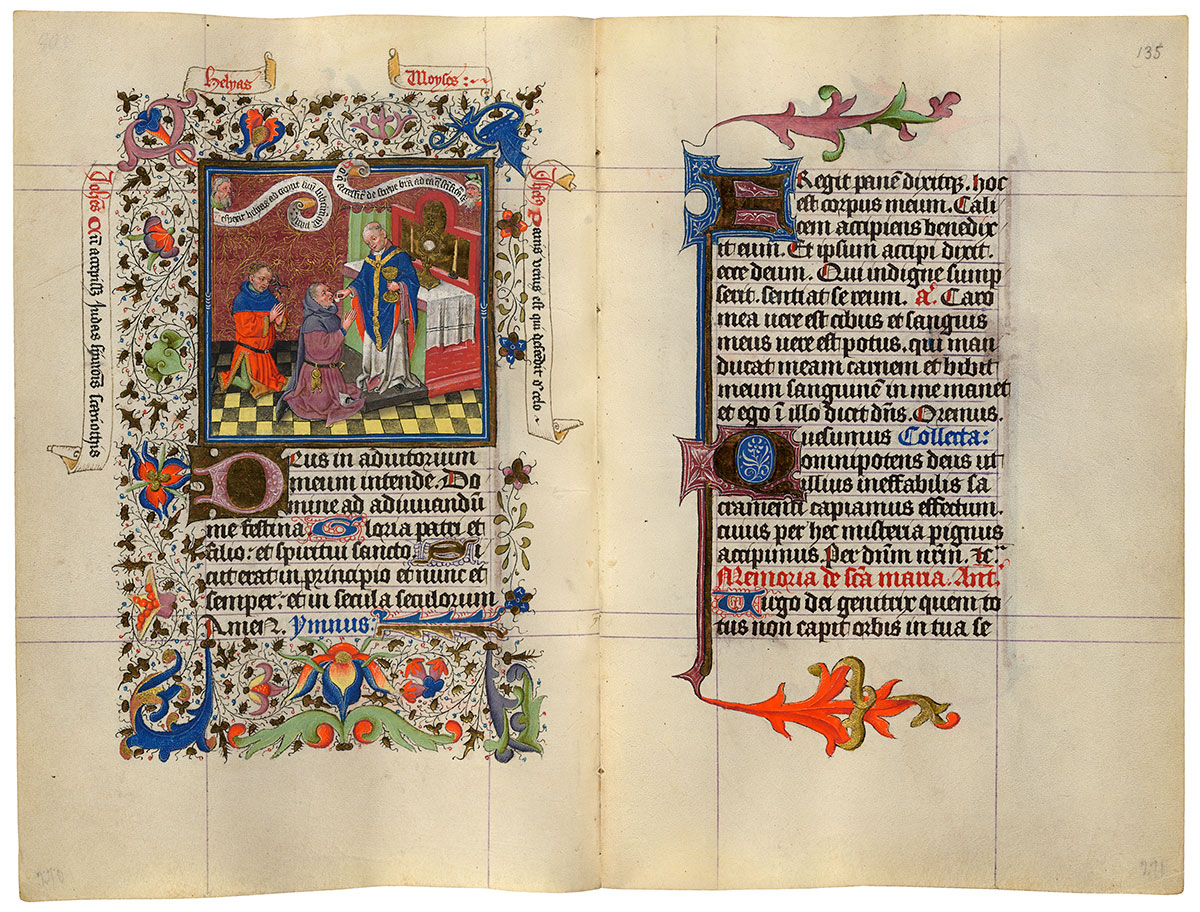
Worthy and Unworthy Communion
Purchased on the Belle da Costa Greene Fund with the assistance of the Fellows and with special assistance of Mrs. Frederick B. Adams, Sr., Mrs. Robert Charles, Mr. Laurens M. Hamilton, The Heineman Foundation, Mrs. Donald F. Hyde, Mrs. Jacob M. Kaplan, Mrs. John Kean, Mr. Paul Mellon, Mr. and Mrs. Charles F. Morgan, Mr. Lessing J. Rosenwald, Mr. and Mrs. August H. Schilling, Mrs. Herbert N. Straus, Mrs. Landon K. Thorne, Mrs. Alan Valentine, Mr. and Mrs. Arnold Whitridge, and Miss Julia P. Wightman, 1970
Hours and Masses for the Seven Days of the Week
The most unusual texts in Catherine's manuscript are the series of Hours and Masses for every day of the week. Medieval Christian tradition associated certain figures or themes with different days. Thus Sunday, the day of the Resurrection, was the Lord's Day; Thursday was connected with the Eucharist since that sacrament was instituted on Holy Thursday; and Monday was the day of the dead, since their torments were suspended on Sunday but recommenced the following day. In Catherine's prayer book, the themes for the Hours and Masses of the seven days of the week are:
| Sunday | the Trinity |
| Monday | the Dead |
| Tuesday | the Holy Spirit |
| Wednesday | All Saints |
| Thursday | the Blessed Sacrament |
| Friday | the Compassion of God |
| Saturday | the Virgin. |
Image courtesy of Faksimile Verlag Luzern
MS M.917/945, ff. 135v–136r
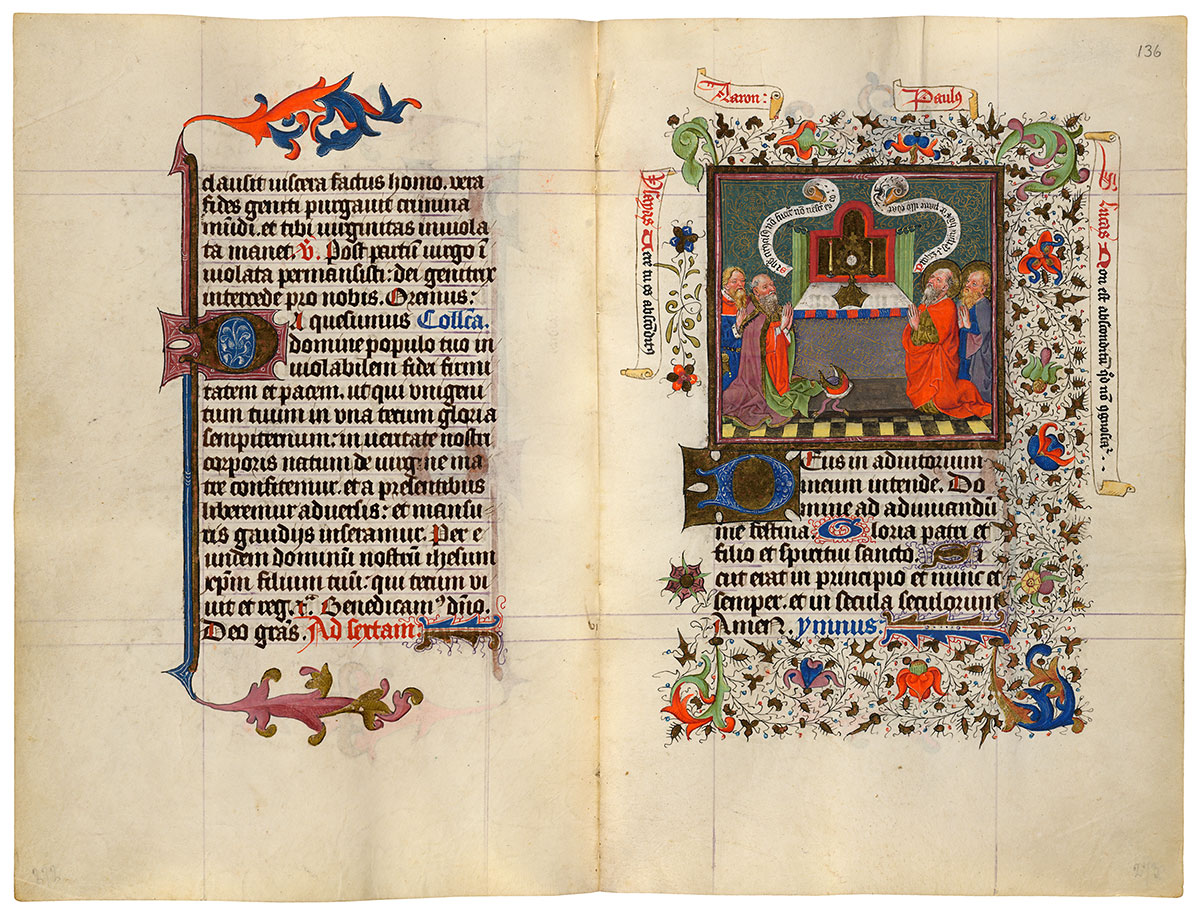
The Eucharist Adored by Prophets Aaron and Isaiah and SS. Paul and Luke
Purchased on the Belle da Costa Greene Fund with the assistance of the Fellows and with special assistance of Mrs. Frederick B. Adams, Sr., Mrs. Robert Charles, Mr. Laurens M. Hamilton, The Heineman Foundation, Mrs. Donald F. Hyde, Mrs. Jacob M. Kaplan, Mrs. John Kean, Mr. Paul Mellon, Mr. and Mrs. Charles F. Morgan, Mr. Lessing J. Rosenwald, Mr. and Mrs. August H. Schilling, Mrs. Herbert N. Straus, Mrs. Landon K. Thorne, Mrs. Alan Valentine, Mr. and Mrs. Arnold Whitridge, and Miss Julia P. Wightman, 1970
The miniatures marking the Thursday Hours of the Blessed Sacrament contain some unusually complex iconography. Text tags helped Catherine (as they help us today) identify the scenes. Here the Eucharistic wafer, mounted in a monstrance, is being worshipped by four men. The prophets Aaron and Isaiah are on the left; their scroll, quoting Exodus (12:48), tells us that no uncircumcised person shall eat of the Passover. On the right are saints Paul and Luke; their scroll, quoting the First Epistle to the Corinthians (11:28), demands that a man be worthy before partaking of the Eucharist.
Hours and Masses for the Seven Days of the Week
The most unusual texts in Catherine's manuscript are the series of Hours and Masses for every day of the week. Medieval Christian tradition associated certain figures or themes with different days. Thus Sunday, the day of the Resurrection, was the Lord's Day; Thursday was connected with the Eucharist since that sacrament was instituted on Holy Thursday; and Monday was the day of the dead, since their torments were suspended on Sunday but recommenced the following day. In Catherine's prayer book, the themes for the Hours and Masses of the seven days of the week are:
| Sunday | the Trinity |
| Monday | the Dead |
| Tuesday | the Holy Spirit |
| Wednesday | All Saints |
| Thursday | the Blessed Sacrament |
| Friday | the Compassion of God |
| Saturday | the Virgin. |
Image courtesy of Faksimile Verlag Luzern
MS M.917/945, ff. 136v–137r
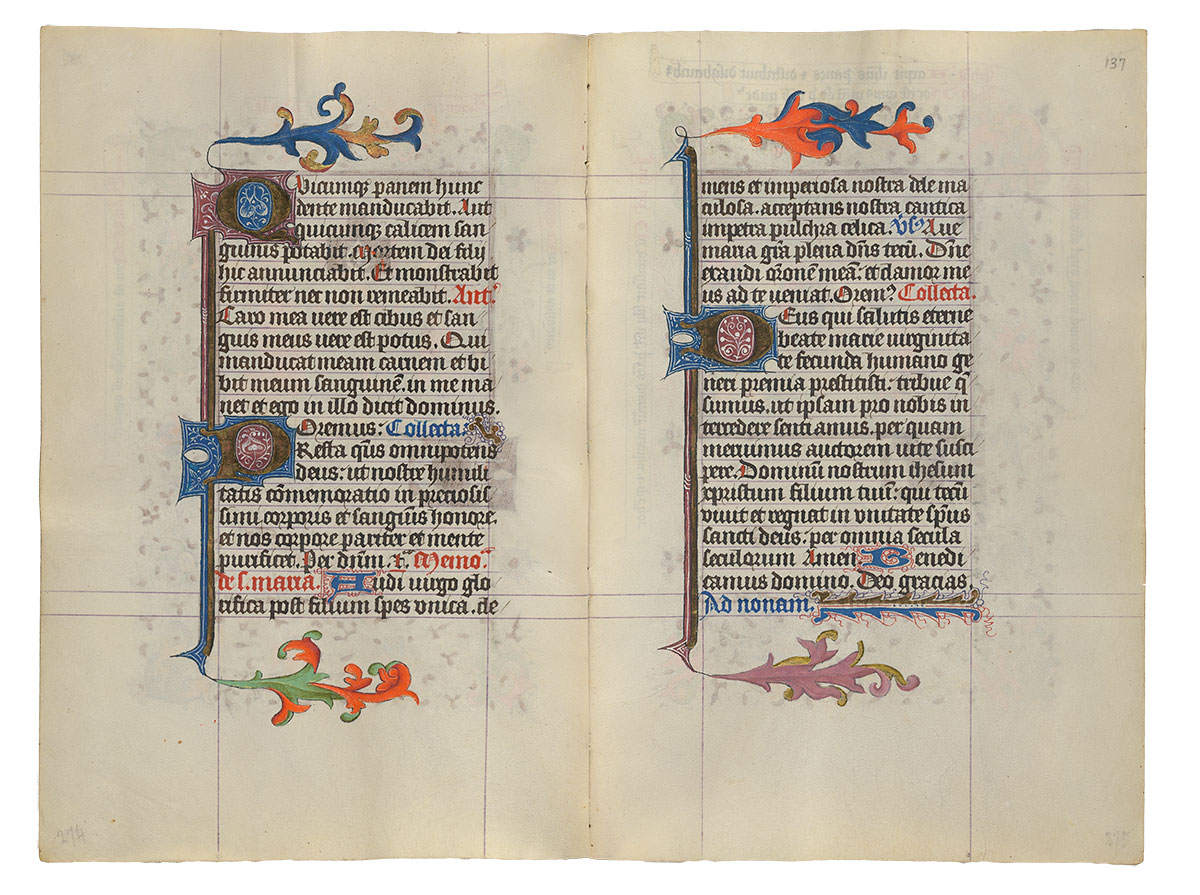
Purchased on the Belle da Costa Greene Fund with the assistance of the Fellows and with special assistance of Mrs. Frederick B. Adams, Sr., Mrs. Robert Charles, Mr. Laurens M. Hamilton, The Heineman Foundation, Mrs. Donald F. Hyde, Mrs. Jacob M. Kaplan, Mrs. John Kean, Mr. Paul Mellon, Mr. and Mrs. Charles F. Morgan, Mr. Lessing J. Rosenwald, Mr. and Mrs. August H. Schilling, Mrs. Herbert N. Straus, Mrs. Landon K. Thorne, Mrs. Alan Valentine, Mr. and Mrs. Arnold Whitridge, and Miss Julia P. Wightman, 1970
Image courtesy of Faksimile Verlag Luzern
MS M.917/945, ff. 137v–138r
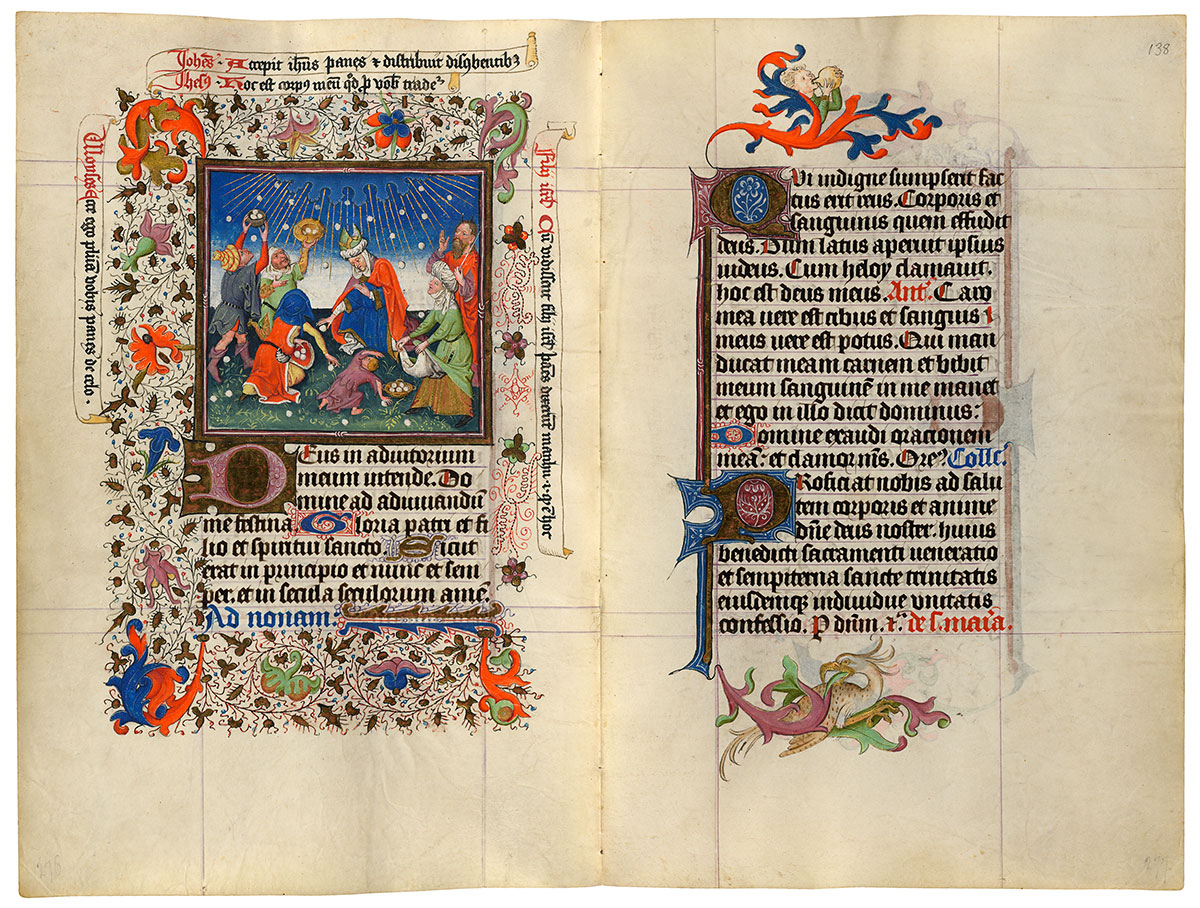
Gathering of Manna
Purchased on the Belle da Costa Greene Fund with the assistance of the Fellows and with special assistance of Mrs. Frederick B. Adams, Sr., Mrs. Robert Charles, Mr. Laurens M. Hamilton, The Heineman Foundation, Mrs. Donald F. Hyde, Mrs. Jacob M. Kaplan, Mrs. John Kean, Mr. Paul Mellon, Mr. and Mrs. Charles F. Morgan, Mr. Lessing J. Rosenwald, Mr. and Mrs. August H. Schilling, Mrs. Herbert N. Straus, Mrs. Landon K. Thorne, Mrs. Alan Valentine, Mr. and Mrs. Arnold Whitridge, and Miss Julia P. Wightman, 1970
Manna rains from heaven and is gathered by Aaron (at the center) and five Israelites—men, women, and a child. Moses, holding a staff, observes from the right. In the side margins, two quotations from Exodus (16:4 and 15) describe the event. The text at right quotes the "sons of Israel" asking themselves what the manna might mean. At the top, New Testament texts (from John 6:11 and 1 Corinthians 11:24) relate the manna to Christ's distribution of loaves to the five thousand and of the bread of his body—the Eucharist—to the apostles at the Last Supper. The latter quotation, "This is my body, which is broken for you," is similar to the words of transubstantiation recited at Mass.
Hours and Masses for the Seven Days of the Week
The most unusual texts in Catherine's manuscript are the series of Hours and Masses for every day of the week. Medieval Christian tradition associated certain figures or themes with different days. Thus Sunday, the day of the Resurrection, was the Lord's Day; Thursday was connected with the Eucharist since that sacrament was instituted on Holy Thursday; and Monday was the day of the dead, since their torments were suspended on Sunday but recommenced the following day. In Catherine's prayer book, the themes for the Hours and Masses of the seven days of the week are:
| Sunday | the Trinity |
| Monday | the Dead |
| Tuesday | the Holy Spirit |
| Wednesday | All Saints |
| Thursday | the Blessed Sacrament |
| Friday | the Compassion of God |
| Saturday | the Virgin. |
Image courtesy of Faksimile Verlag Luzern
MS M.917/945, ff. 138v–139r
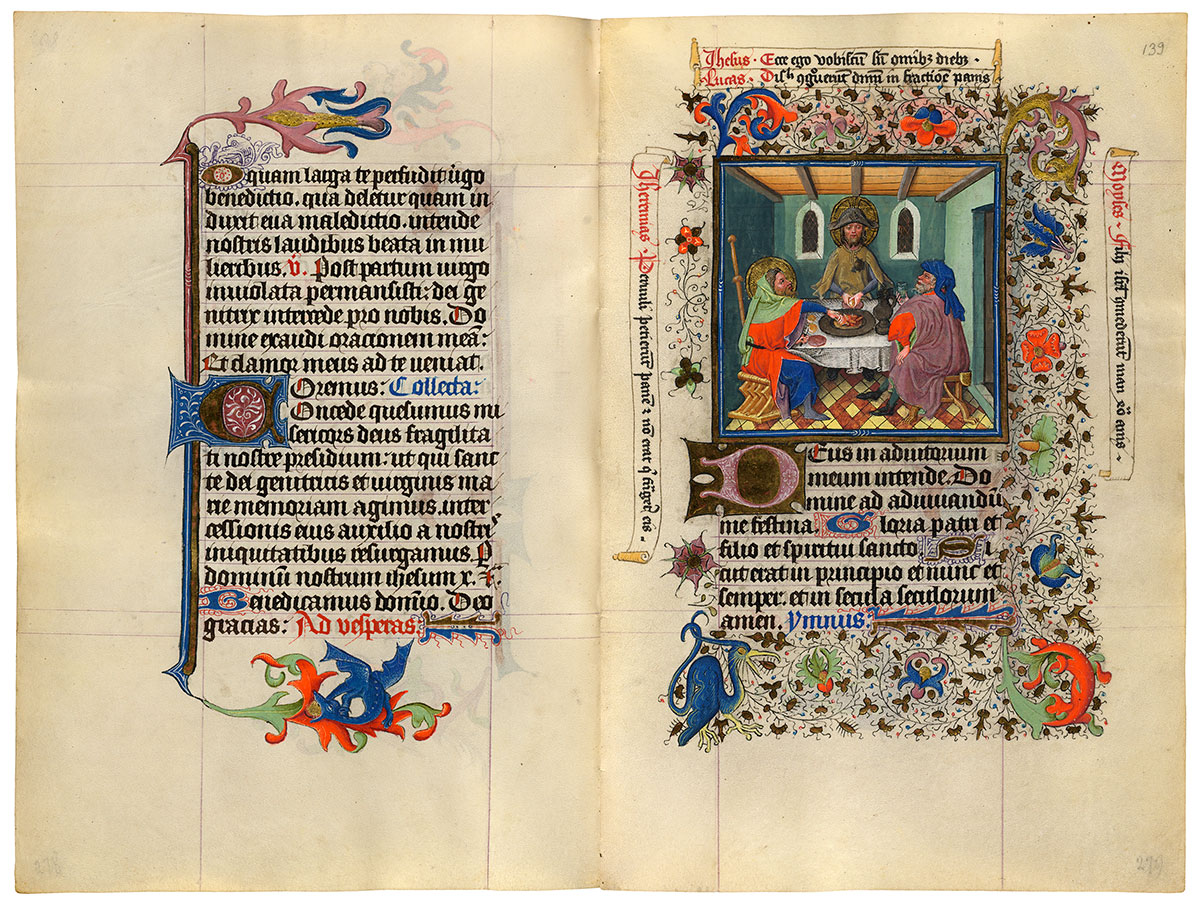
Supper at Emmaus
Purchased on the Belle da Costa Greene Fund with the assistance of the Fellows and with special assistance of Mrs. Frederick B. Adams, Sr., Mrs. Robert Charles, Mr. Laurens M. Hamilton, The Heineman Foundation, Mrs. Donald F. Hyde, Mrs. Jacob M. Kaplan, Mrs. John Kean, Mr. Paul Mellon, Mr. and Mrs. Charles F. Morgan, Mr. Lessing J. Rosenwald, Mr. and Mrs. August H. Schilling, Mrs. Herbert N. Straus, Mrs. Landon K. Thorne, Mrs. Alan Valentine, Mr. and Mrs. Arnold Whitridge, and Miss Julia P. Wightman, 1970
Hours and Masses for the Seven Days of the Week
The most unusual texts in Catherine's manuscript are the series of Hours and Masses for every day of the week. Medieval Christian tradition associated certain figures or themes with different days. Thus Sunday, the day of the Resurrection, was the Lord's Day; Thursday was connected with the Eucharist since that sacrament was instituted on Holy Thursday; and Monday was the day of the dead, since their torments were suspended on Sunday but recommenced the following day. In Catherine's prayer book, the themes for the Hours and Masses of the seven days of the week are:
| Sunday | the Trinity |
| Monday | the Dead |
| Tuesday | the Holy Spirit |
| Wednesday | All Saints |
| Thursday | the Blessed Sacrament |
| Friday | the Compassion of God |
| Saturday | the Virgin. |
Image courtesy of Faksimile Verlag Luzern
MS M.917/945, ff. 139v–140r
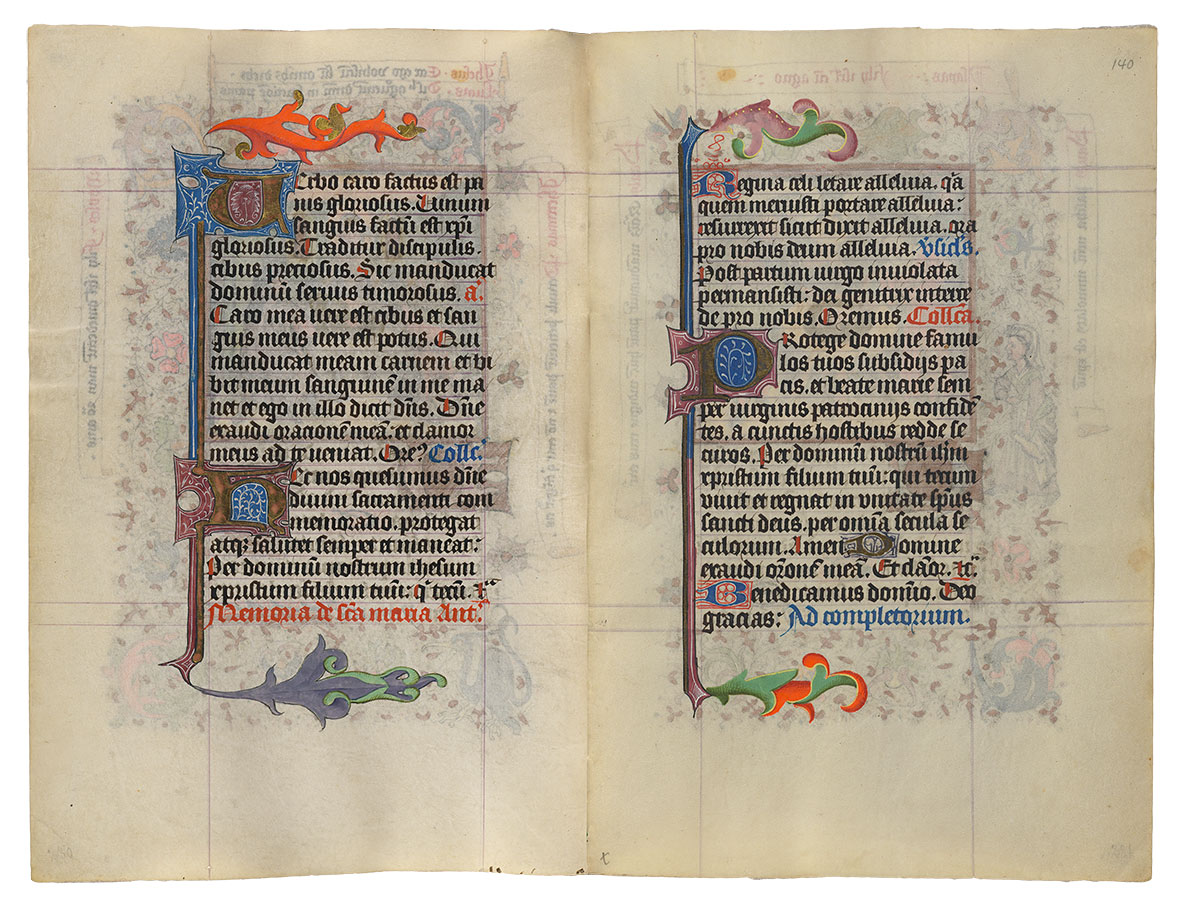
Purchased on the Belle da Costa Greene Fund with the assistance of the Fellows and with special assistance of Mrs. Frederick B. Adams, Sr., Mrs. Robert Charles, Mr. Laurens M. Hamilton, The Heineman Foundation, Mrs. Donald F. Hyde, Mrs. Jacob M. Kaplan, Mrs. John Kean, Mr. Paul Mellon, Mr. and Mrs. Charles F. Morgan, Mr. Lessing J. Rosenwald, Mr. and Mrs. August H. Schilling, Mrs. Herbert N. Straus, Mrs. Landon K. Thorne, Mrs. Alan Valentine, Mr. and Mrs. Arnold Whitridge, and Miss Julia P. Wightman, 1970
Image courtesy of Faksimile Verlag Luzern
MS M.917/945, ff. 140v–141r
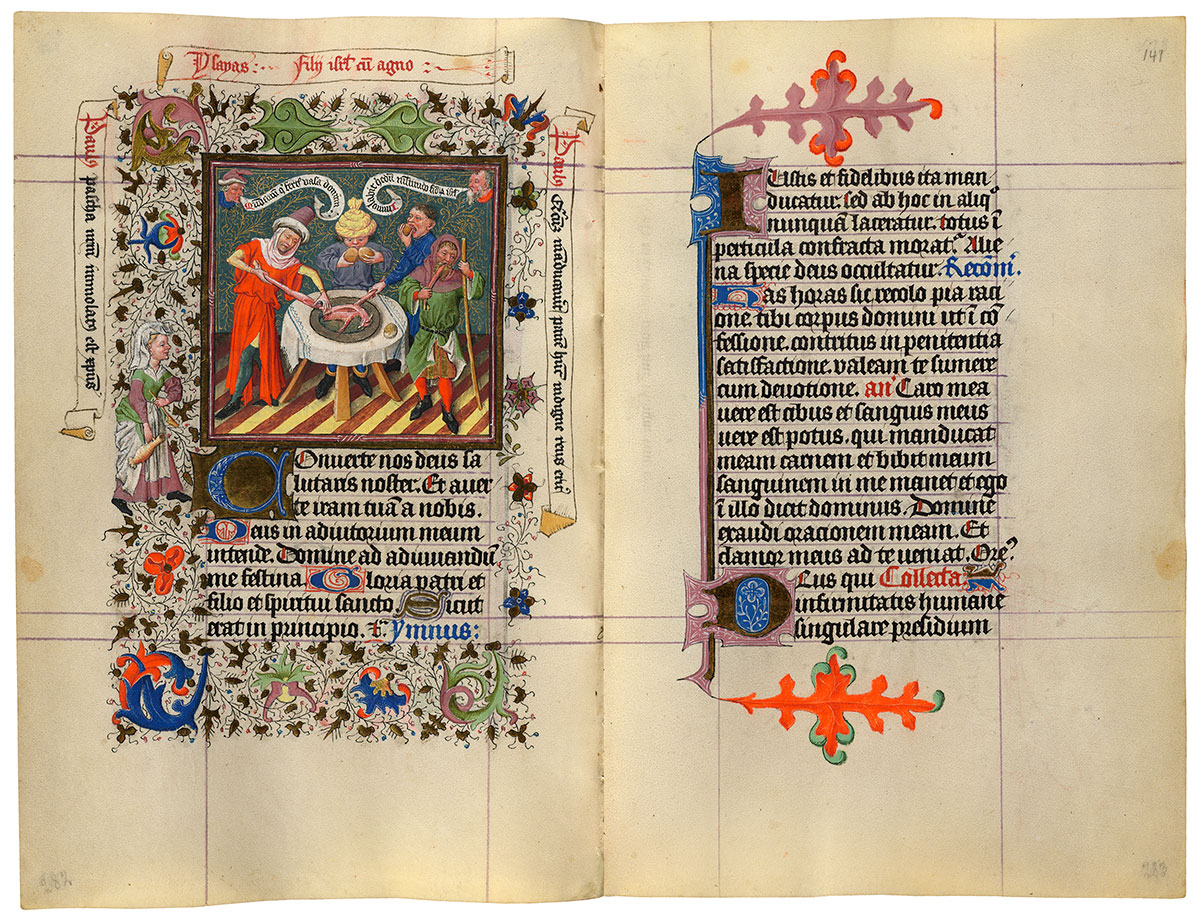
Israelites Eating the Passover Meal
Purchased on the Belle da Costa Greene Fund with the assistance of the Fellows and with special assistance of Mrs. Frederick B. Adams, Sr., Mrs. Robert Charles, Mr. Laurens M. Hamilton, The Heineman Foundation, Mrs. Donald F. Hyde, Mrs. Jacob M. Kaplan, Mrs. John Kean, Mr. Paul Mellon, Mr. and Mrs. Charles F. Morgan, Mr. Lessing J. Rosenwald, Mr. and Mrs. August H. Schilling, Mrs. Herbert N. Straus, Mrs. Landon K. Thorne, Mrs. Alan Valentine, Mr. and Mrs. Arnold Whitridge, and Miss Julia P. Wightman, 1970
The rubric in the top margin, attributed to Isaiah, gives the title to the scene: "The Children of Israel with the Passover Lamb." Four Israelites stand around a table eating lamb and unleavened bread. At the upper left is the head of Isaiah, exhorting (in a quotation from his book, 52:11) cleanliness on the part of those bearing the vessels of the Lord. (His words might explain the woman with the pitcher in the left border.) The head on the right paraphrases Exodus (12:6) that "a young goat should be sacrificed to an assembly of the children of Israel." Two quotations in the side margins from 1 Corinthians (5:7 and 11:27) interpret the Passover lamb as Christ and warn against unworthy Communion.
Hours and Masses for the Seven Days of the Week
The most unusual texts in Catherine's manuscript are the series of Hours and Masses for every day of the week. Medieval Christian tradition associated certain figures or themes with different days. Thus Sunday, the day of the Resurrection, was the Lord's Day; Thursday was connected with the Eucharist since that sacrament was instituted on Holy Thursday; and Monday was the day of the dead, since their torments were suspended on Sunday but recommenced the following day. In Catherine's prayer book, the themes for the Hours and Masses of the seven days of the week are:
| Sunday | the Trinity |
| Monday | the Dead |
| Tuesday | the Holy Spirit |
| Wednesday | All Saints |
| Thursday | the Blessed Sacrament |
| Friday | the Compassion of God |
| Saturday | the Virgin. |
Image courtesy of Faksimile Verlag Luzern
MS M.917/945, ff. 141v–144r
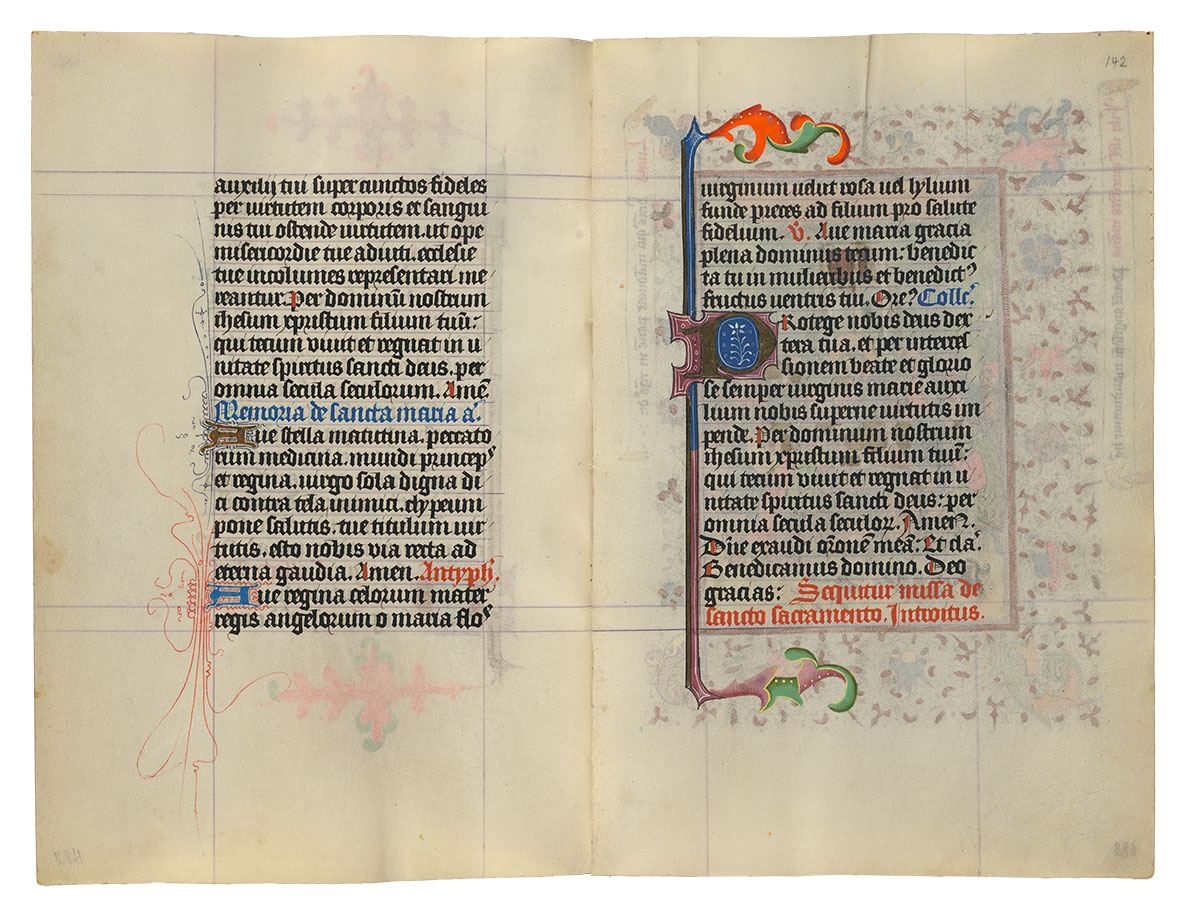
Purchased on the Belle da Costa Greene Fund with the assistance of the Fellows and with special assistance of Mrs. Frederick B. Adams, Sr., Mrs. Robert Charles, Mr. Laurens M. Hamilton, The Heineman Foundation, Mrs. Donald F. Hyde, Mrs. Jacob M. Kaplan, Mrs. John Kean, Mr. Paul Mellon, Mr. and Mrs. Charles F. Morgan, Mr. Lessing J. Rosenwald, Mr. and Mrs. August H. Schilling, Mrs. Herbert N. Straus, Mrs. Landon K. Thorne, Mrs. Alan Valentine, Mr. and Mrs. Arnold Whitridge, and Miss Julia P. Wightman, 1970
Image courtesy of Faksimile Verlag Luzern
MS M.917/945, ff. 142v–143r
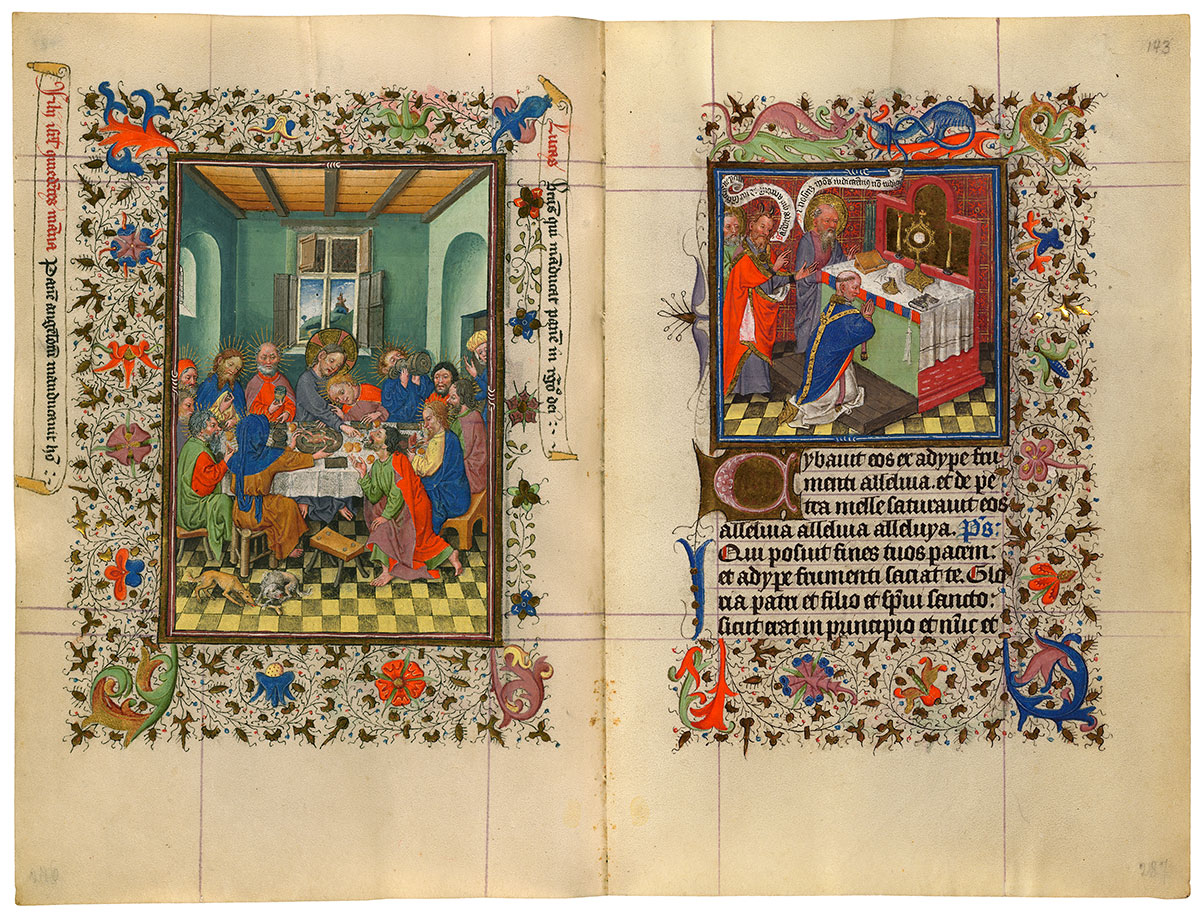
Last Supper
The Celebration of Mass Observed by Moses and St. Paul
Purchased on the Belle da Costa Greene Fund with the assistance of the Fellows and with special assistance of Mrs. Frederick B. Adams, Sr., Mrs. Robert Charles, Mr. Laurens M. Hamilton, The Heineman Foundation, Mrs. Donald F. Hyde, Mrs. Jacob M. Kaplan, Mrs. John Kean, Mr. Paul Mellon, Mr. and Mrs. Charles F. Morgan, Mr. Lessing J. Rosenwald, Mr. and Mrs. August H. Schilling, Mrs. Herbert N. Straus, Mrs. Landon K. Thorne, Mrs. Alan Valentine, Mr. and Mrs. Arnold Whitridge, and Miss Julia P. Wightman, 1970
This large miniature marking the Mass of the Blessed Sacrament illustrates the Last Supper. Christ gives Judas the sop by which he identifies his betrayer; as Judas accepts this, a tiny demon enters his mouth. (John, leaning on the Savior's chest, sleeps through the critical moment, while Peter, to the left of Christ, appears aghast.) Biblical quotations interpret the event. The left one, from Psalms (77:25), refers to the "bread of angels," a phrase applied to the Eucharist. The right quotation, from Luke (14:15), praises those who have eaten bread in the kingdom of God. In the smaller miniature, representing the mystical union of the Old and New Testaments, Moses and St. Paul observe the celebration of Mass.
Hours and Masses for the Seven Days of the Week
The most unusual texts in Catherine's manuscript are the series of Hours and Masses for every day of the week. Medieval Christian tradition associated certain figures or themes with different days. Thus Sunday, the day of the Resurrection, was the Lord's Day; Thursday was connected with the Eucharist since that sacrament was instituted on Holy Thursday; and Monday was the day of the dead, since their torments were suspended on Sunday but recommenced the following day. In Catherine's prayer book, the themes for the Hours and Masses of the seven days of the week are:
| Sunday | the Trinity |
| Monday | the Dead |
| Tuesday | the Holy Spirit |
| Wednesday | All Saints |
| Thursday | the Blessed Sacrament |
| Friday | the Compassion of God |
| Saturday | the Virgin. |
Image courtesy of Faksimile Verlag Luzern
MS M.917/945, ff. 143v–144r
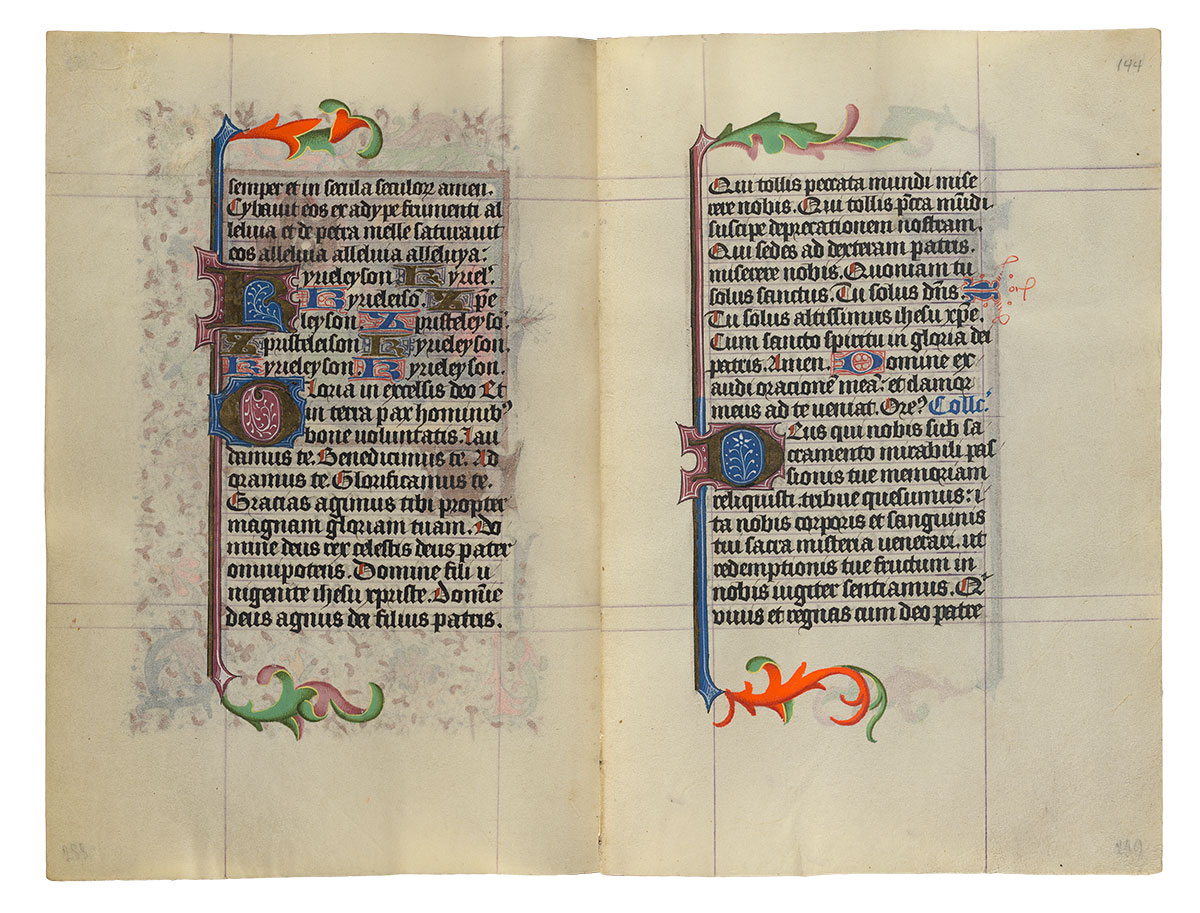
Purchased on the Belle da Costa Greene Fund with the assistance of the Fellows and with special assistance of Mrs. Frederick B. Adams, Sr., Mrs. Robert Charles, Mr. Laurens M. Hamilton, The Heineman Foundation, Mrs. Donald F. Hyde, Mrs. Jacob M. Kaplan, Mrs. John Kean, Mr. Paul Mellon, Mr. and Mrs. Charles F. Morgan, Mr. Lessing J. Rosenwald, Mr. and Mrs. August H. Schilling, Mrs. Herbert N. Straus, Mrs. Landon K. Thorne, Mrs. Alan Valentine, Mr. and Mrs. Arnold Whitridge, and Miss Julia P. Wightman, 1970
Image courtesy of Faksimile Verlag Luzern
MS M.917/945, ff. 144v–145r
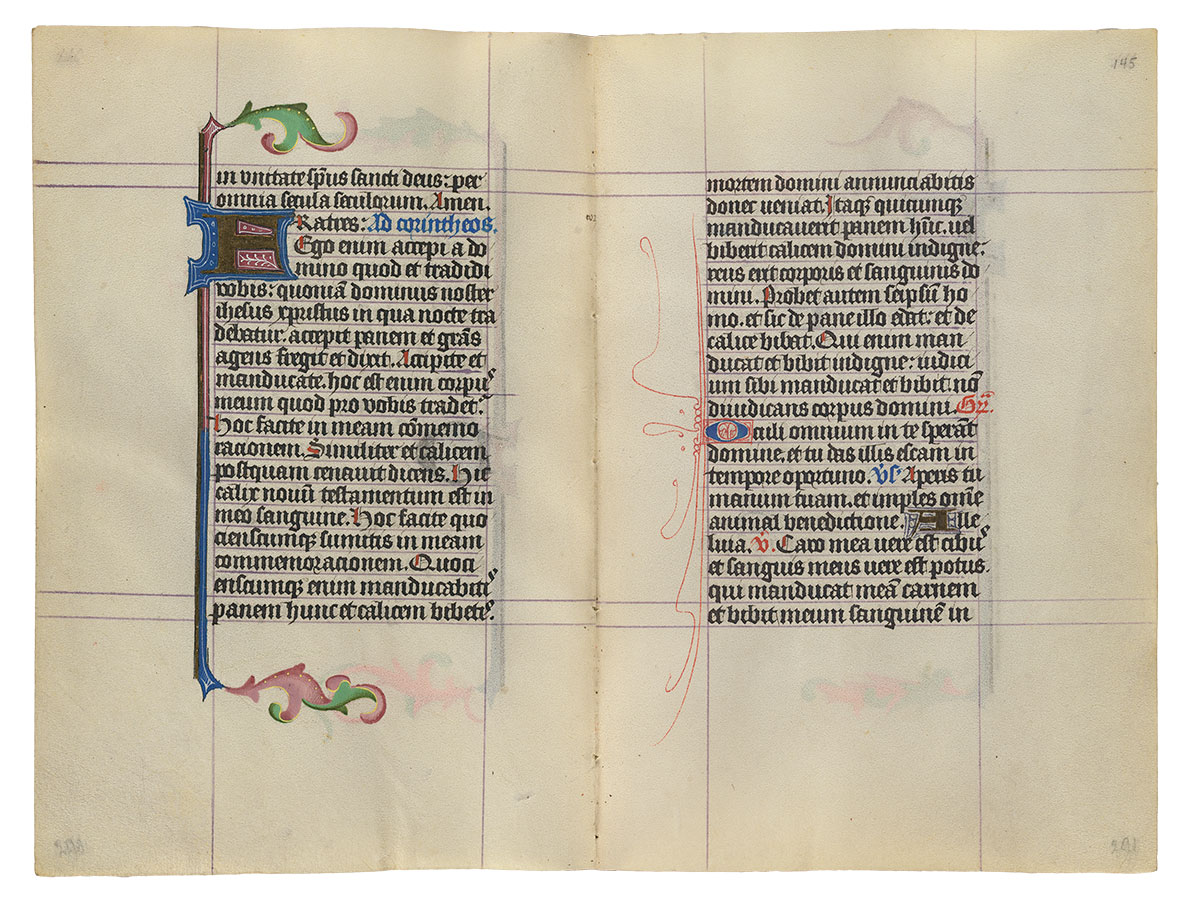
Purchased on the Belle da Costa Greene Fund with the assistance of the Fellows and with special assistance of Mrs. Frederick B. Adams, Sr., Mrs. Robert Charles, Mr. Laurens M. Hamilton, The Heineman Foundation, Mrs. Donald F. Hyde, Mrs. Jacob M. Kaplan, Mrs. John Kean, Mr. Paul Mellon, Mr. and Mrs. Charles F. Morgan, Mr. Lessing J. Rosenwald, Mr. and Mrs. August H. Schilling, Mrs. Herbert N. Straus, Mrs. Landon K. Thorne, Mrs. Alan Valentine, Mr. and Mrs. Arnold Whitridge, and Miss Julia P. Wightman, 1970
Image courtesy of Faksimile Verlag Luzern
MS M.917/945, ff. 145v–146r
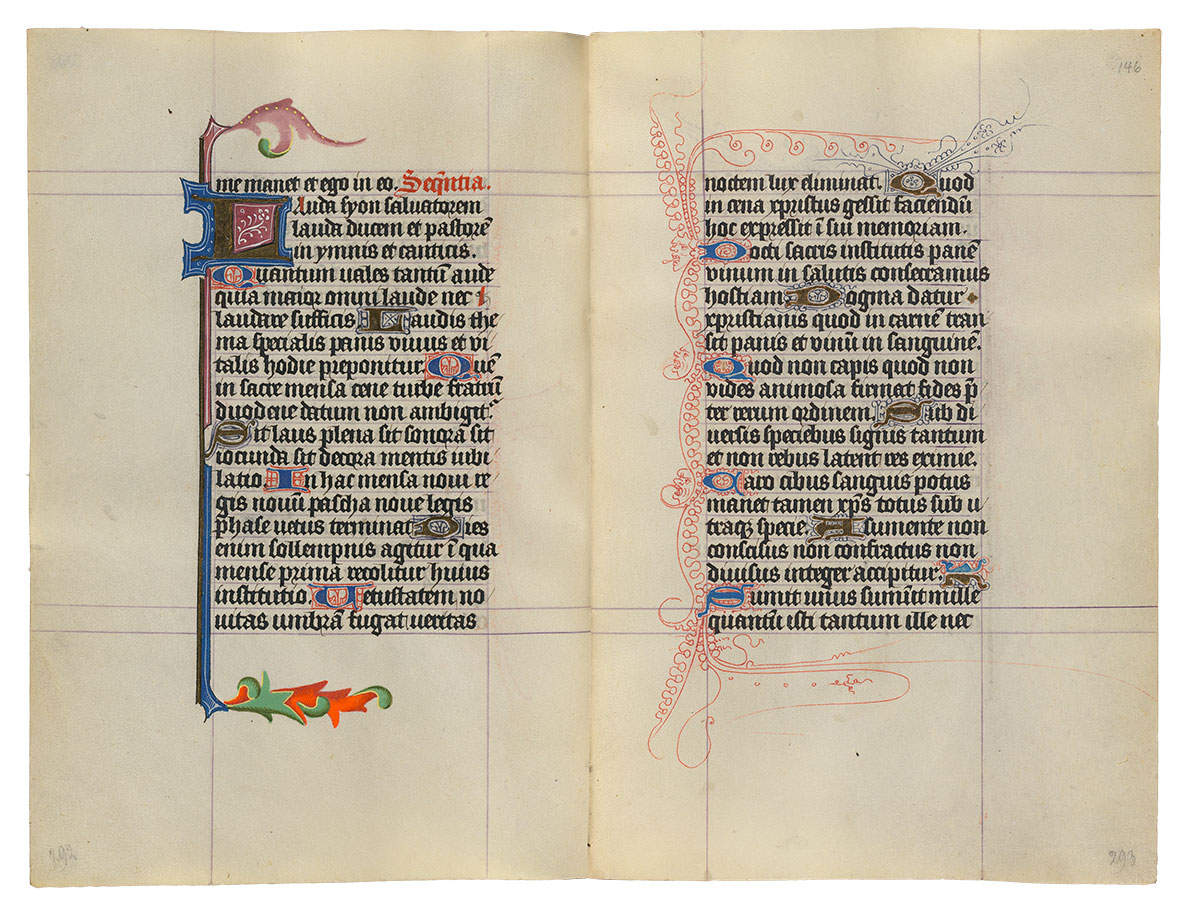
Purchased on the Belle da Costa Greene Fund with the assistance of the Fellows and with special assistance of Mrs. Frederick B. Adams, Sr., Mrs. Robert Charles, Mr. Laurens M. Hamilton, The Heineman Foundation, Mrs. Donald F. Hyde, Mrs. Jacob M. Kaplan, Mrs. John Kean, Mr. Paul Mellon, Mr. and Mrs. Charles F. Morgan, Mr. Lessing J. Rosenwald, Mr. and Mrs. August H. Schilling, Mrs. Herbert N. Straus, Mrs. Landon K. Thorne, Mrs. Alan Valentine, Mr. and Mrs. Arnold Whitridge, and Miss Julia P. Wightman, 1970
Image courtesy of Faksimile Verlag Luzern
MS M.917/945, ff. 146v–147r
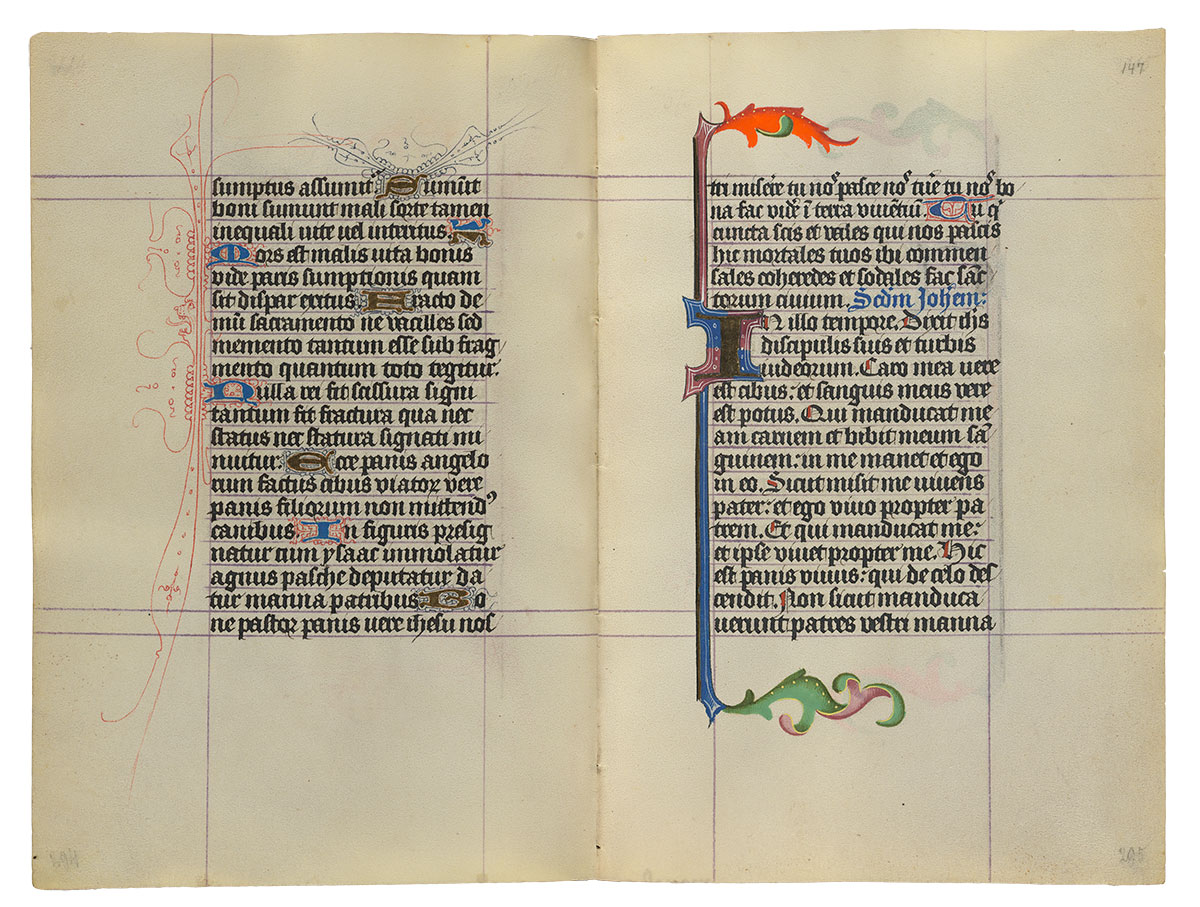
Purchased on the Belle da Costa Greene Fund with the assistance of the Fellows and with special assistance of Mrs. Frederick B. Adams, Sr., Mrs. Robert Charles, Mr. Laurens M. Hamilton, The Heineman Foundation, Mrs. Donald F. Hyde, Mrs. Jacob M. Kaplan, Mrs. John Kean, Mr. Paul Mellon, Mr. and Mrs. Charles F. Morgan, Mr. Lessing J. Rosenwald, Mr. and Mrs. August H. Schilling, Mrs. Herbert N. Straus, Mrs. Landon K. Thorne, Mrs. Alan Valentine, Mr. and Mrs. Arnold Whitridge, and Miss Julia P. Wightman, 1970
Image courtesy of Faksimile Verlag Luzern
MS M.917/945, ff. 147v–148r
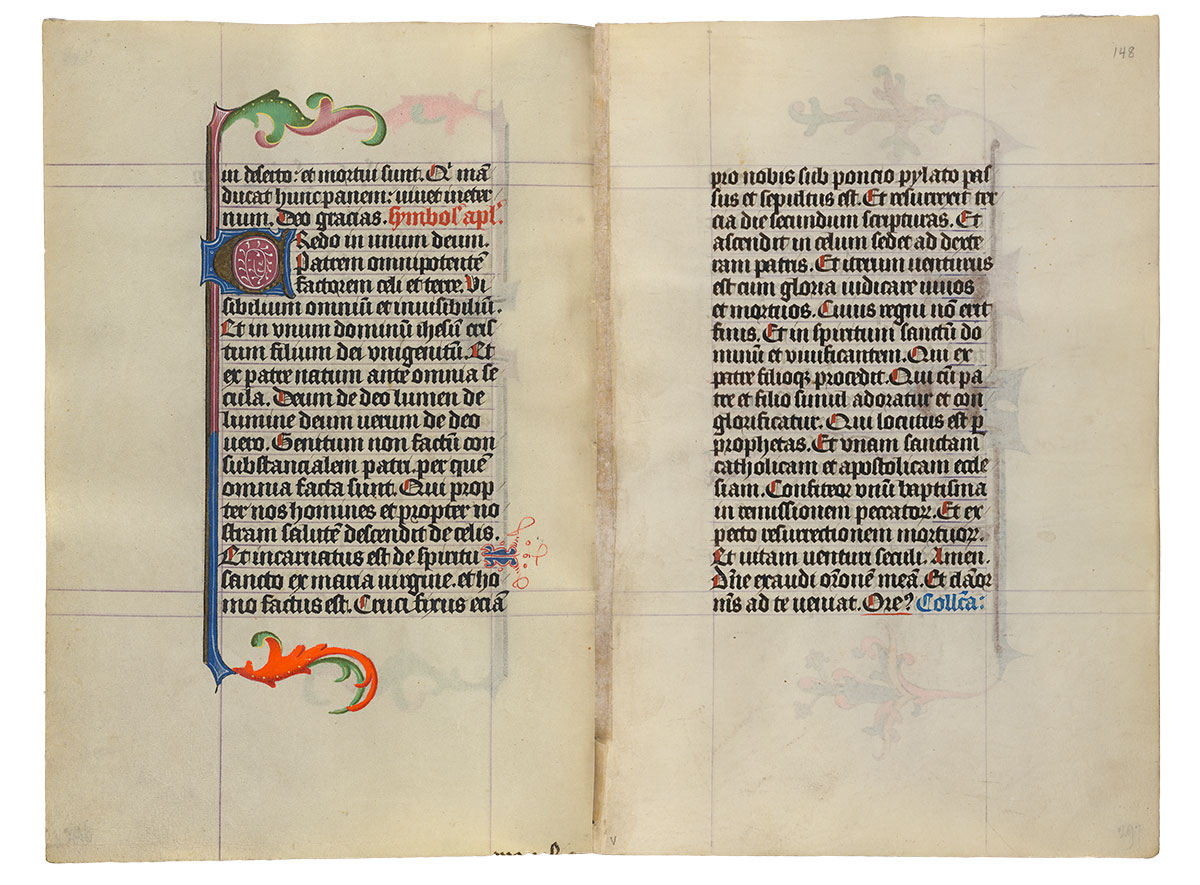
Purchased on the Belle da Costa Greene Fund with the assistance of the Fellows and with special assistance of Mrs. Frederick B. Adams, Sr., Mrs. Robert Charles, Mr. Laurens M. Hamilton, The Heineman Foundation, Mrs. Donald F. Hyde, Mrs. Jacob M. Kaplan, Mrs. John Kean, Mr. Paul Mellon, Mr. and Mrs. Charles F. Morgan, Mr. Lessing J. Rosenwald, Mr. and Mrs. August H. Schilling, Mrs. Herbert N. Straus, Mrs. Landon K. Thorne, Mrs. Alan Valentine, Mr. and Mrs. Arnold Whitridge, and Miss Julia P. Wightman, 1970
Image courtesy of Faksimile Verlag Luzern
MS M.917/945, ff. 148v–149r
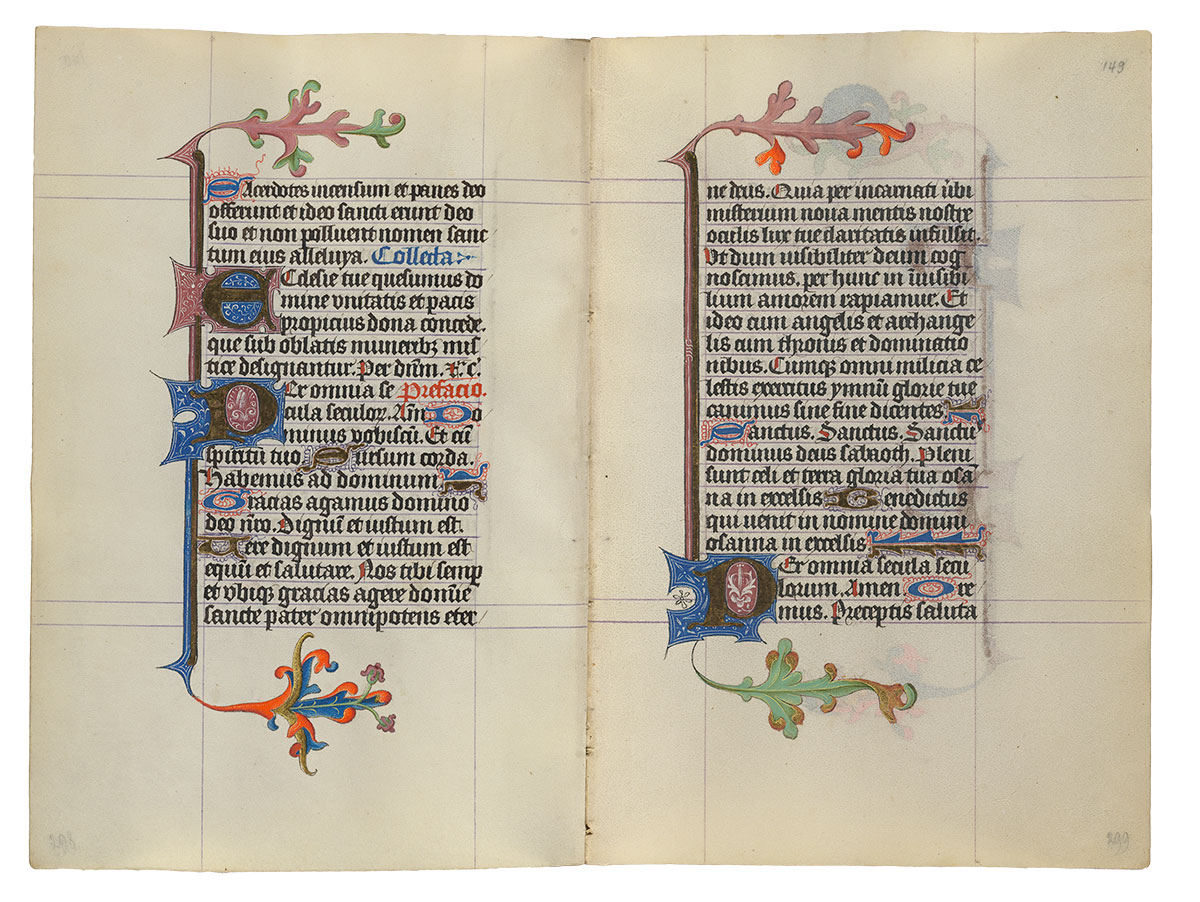
Purchased on the Belle da Costa Greene Fund with the assistance of the Fellows and with special assistance of Mrs. Frederick B. Adams, Sr., Mrs. Robert Charles, Mr. Laurens M. Hamilton, The Heineman Foundation, Mrs. Donald F. Hyde, Mrs. Jacob M. Kaplan, Mrs. John Kean, Mr. Paul Mellon, Mr. and Mrs. Charles F. Morgan, Mr. Lessing J. Rosenwald, Mr. and Mrs. August H. Schilling, Mrs. Herbert N. Straus, Mrs. Landon K. Thorne, Mrs. Alan Valentine, Mr. and Mrs. Arnold Whitridge, and Miss Julia P. Wightman, 1970
Image courtesy of Faksimile Verlag Luzern
MS M.917/945, ff. 149v–150r
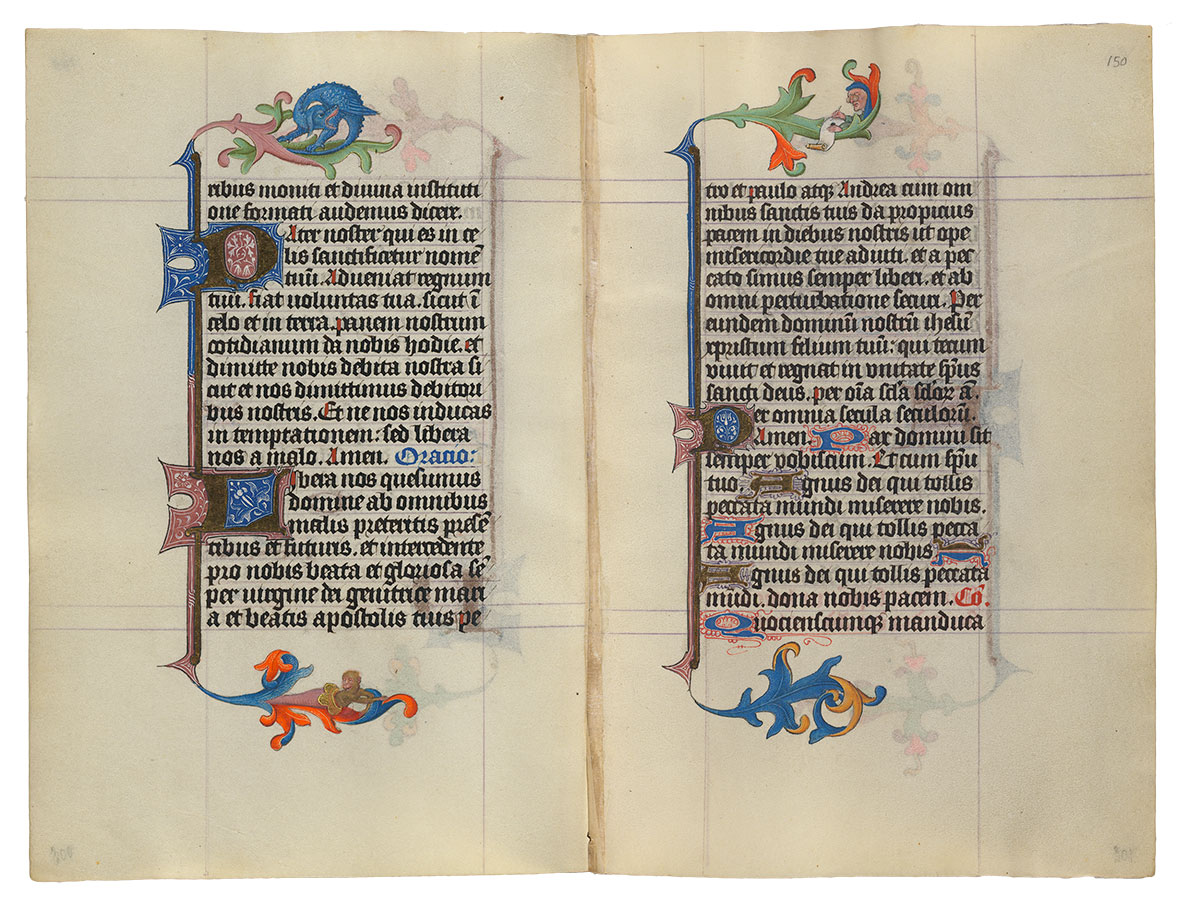
Purchased on the Belle da Costa Greene Fund with the assistance of the Fellows and with special assistance of Mrs. Frederick B. Adams, Sr., Mrs. Robert Charles, Mr. Laurens M. Hamilton, The Heineman Foundation, Mrs. Donald F. Hyde, Mrs. Jacob M. Kaplan, Mrs. John Kean, Mr. Paul Mellon, Mr. and Mrs. Charles F. Morgan, Mr. Lessing J. Rosenwald, Mr. and Mrs. August H. Schilling, Mrs. Herbert N. Straus, Mrs. Landon K. Thorne, Mrs. Alan Valentine, Mr. and Mrs. Arnold Whitridge, and Miss Julia P. Wightman, 1970
Image courtesy of Faksimile Verlag Luzern
MS M.917/945, f. 150v–p. 75
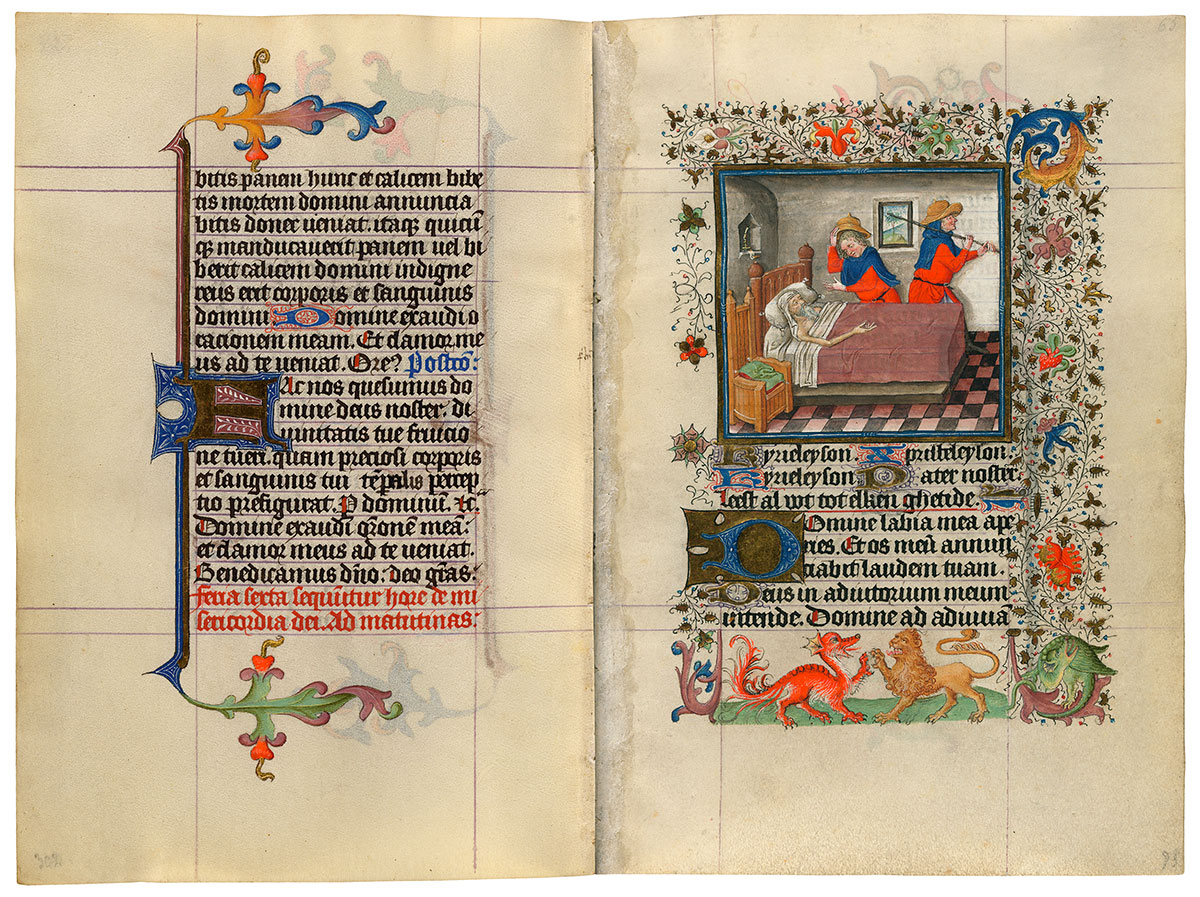
The Dying Adam Dispatching Seth to Paradise
Purchased on the Belle da Costa Greene Fund with the assistance of the Fellows and with special assistance of Mrs. Frederick B. Adams, Sr., Mrs. Robert Charles, Mr. Laurens M. Hamilton, The Heineman Foundation, Mrs. Donald F. Hyde, Mrs. Jacob M. Kaplan, Mrs. John Kean, Mr. Paul Mellon, Mr. and Mrs. Charles F. Morgan, Mr. Lessing J. Rosenwald, Mr. and Mrs. August H. Schilling, Mrs. Herbert N. Straus, Mrs. Landon K. Thorne, Mrs. Alan Valentine, Mr. and Mrs. Arnold Whitridge, and Miss Julia P. Wightman, 1970; purchased on the Belle da Costa Greene Fund with the assistance of the Fellows, 1963
The rare Friday Hours of the Compassion of God plus the Mass of the Holy Cross are illustrated with a series of nine images, all of which are exhibited here. (Two introductory large miniatures for the Hours and the Mass are missing.) The iconography of the medieval legend of the True Cross offers an imaginative link—physical and metaphysical—between Adam and Christ and between terrestrial and celestial Paradise. The cycle begins with a remorseful Adam, on his deathbed, sending his third son, Seth, to the Garden of Eden to fetch a branch of the Tree of Mercy.
Hours and Masses for the Seven Days of the Week
The most unusual texts in Catherine's manuscript are the series of Hours and Masses for every day of the week. Medieval Christian tradition associated certain figures or themes with different days. Thus Sunday, the day of the Resurrection, was the Lord's Day; Thursday was connected with the Eucharist since that sacrament was instituted on Holy Thursday; and Monday was the day of the dead, since their torments were suspended on Sunday but recommenced the following day. In Catherine's prayer book, the themes for the Hours and Masses of the seven days of the week are:
| Sunday | the Trinity |
| Monday | the Dead |
| Tuesday | the Holy Spirit |
| Wednesday | All Saints |
| Thursday | the Blessed Sacrament |
| Friday | the Compassion of God |
| Saturday | the Virgin. |
Image courtesy of Faksimile Verlag Luzern
MS M.917/945, pp. 76–77
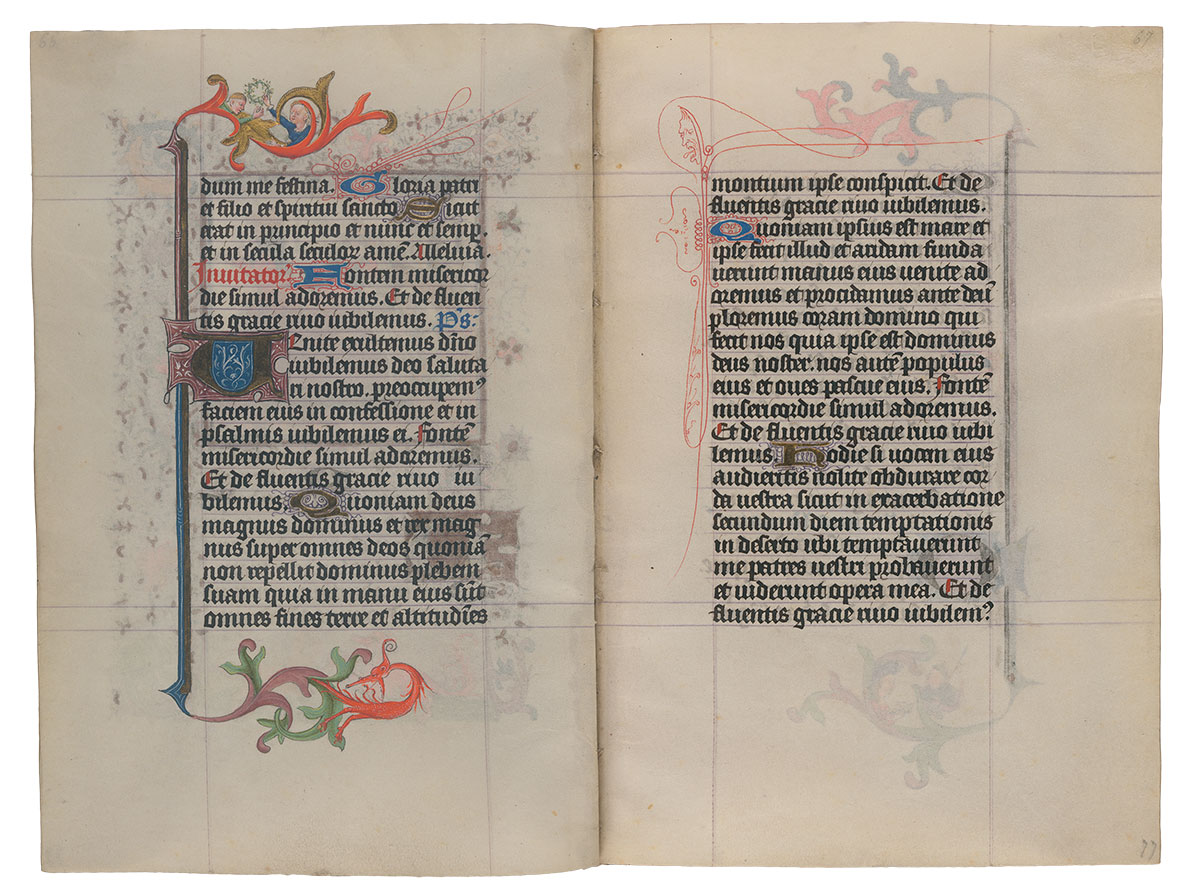
Purchased on the Belle da Costa Greene Fund with the assistance of the Fellows, 1963
Image courtesy of Faksimile Verlag Luzern
MS M.917/945, pp. 78–79
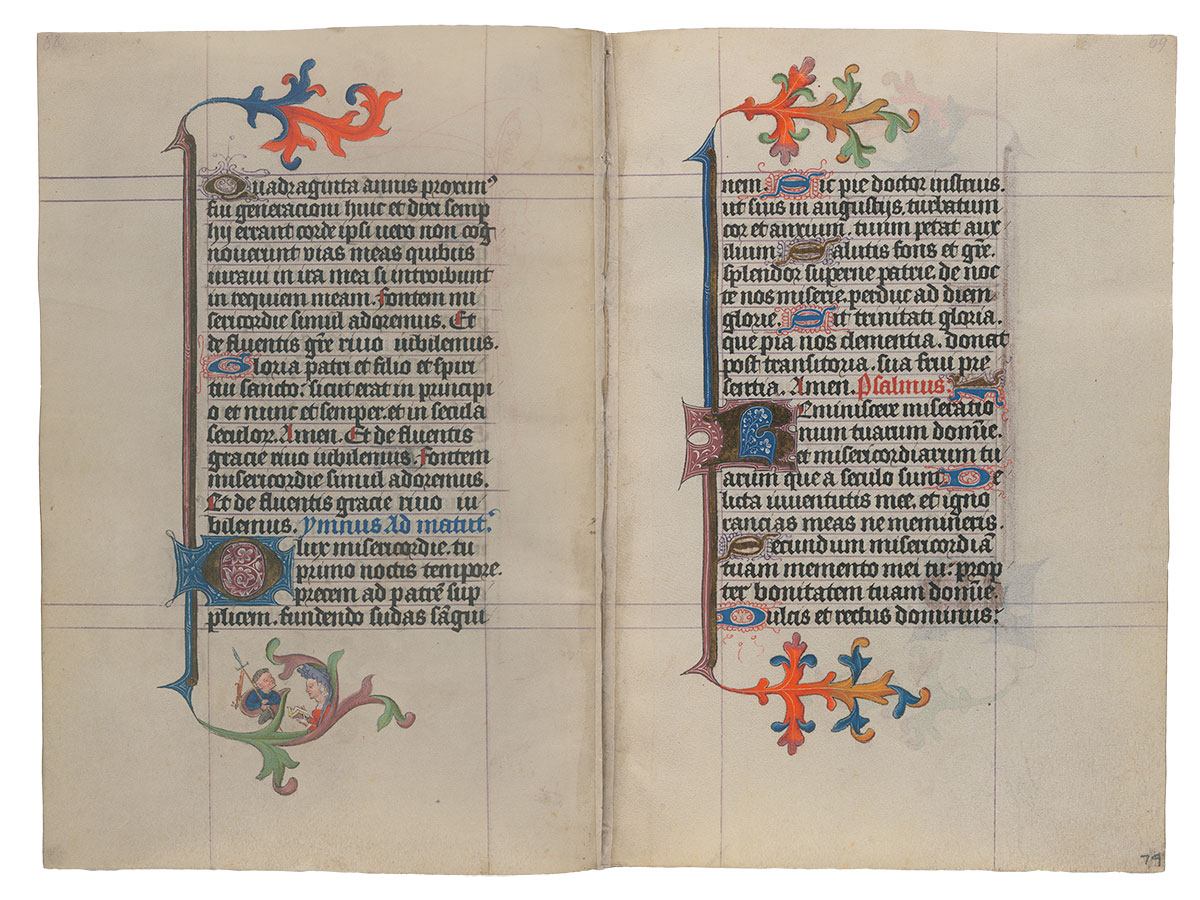
Purchased on the Belle da Costa Greene Fund with the assistance of the Fellows, 1963
Image courtesy of Faksimile Verlag Luzern
MS M.917/945, pp. 80–81
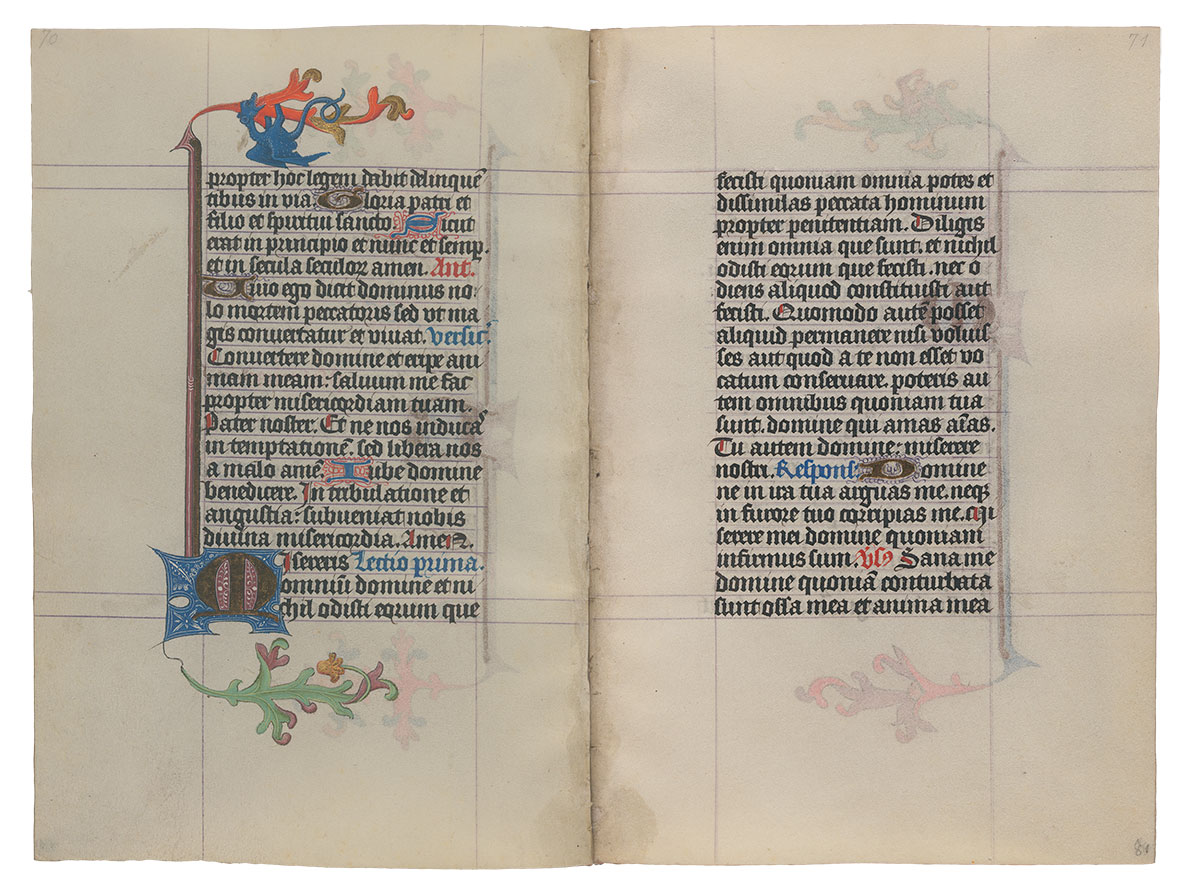
Purchased on the Belle da Costa Greene Fund with the assistance of the Fellows, 1963
Image courtesy of Faksimile Verlag Luzern
MS M.917/945, pp. 82–83
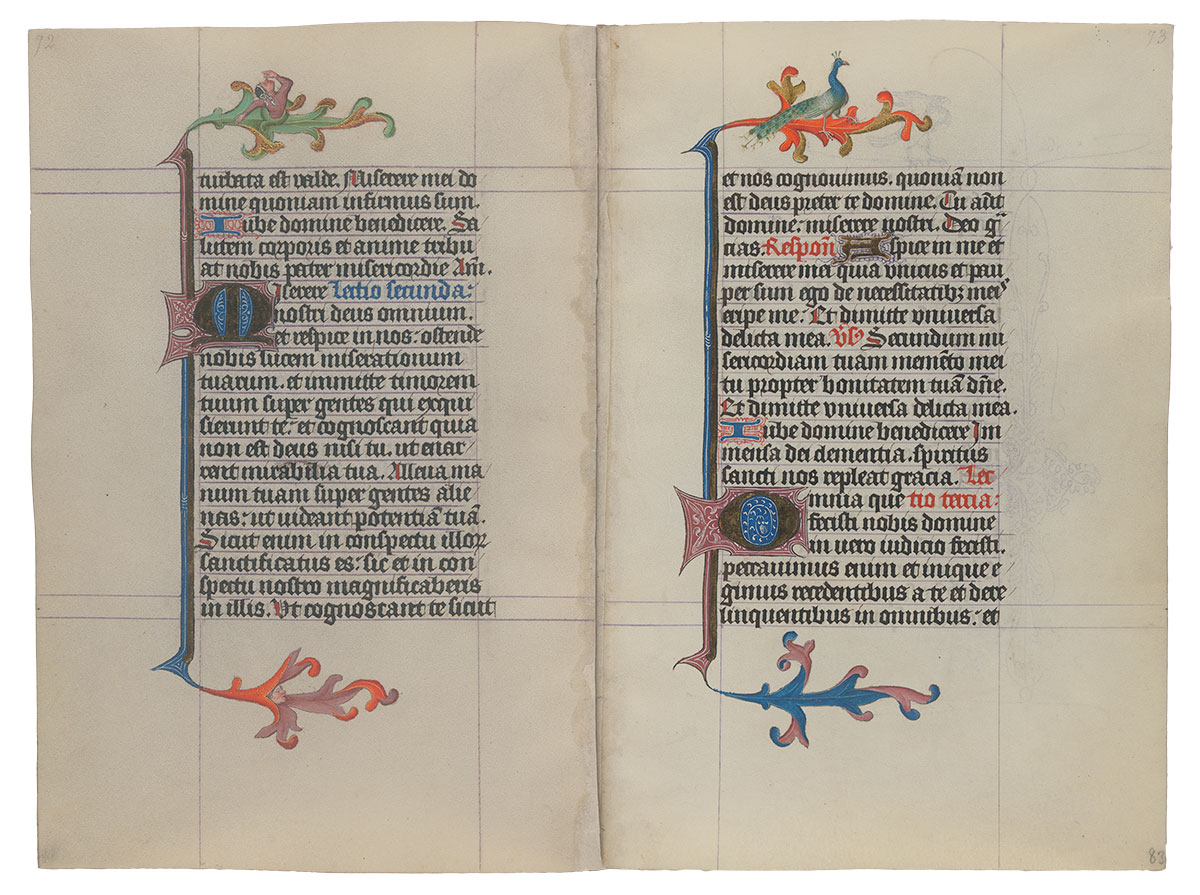
Purchased on the Belle da Costa Greene Fund with the assistance of the Fellows, 1963
Image courtesy of Faksimile Verlag Luzern
MS M.917/945, pp. 84–85
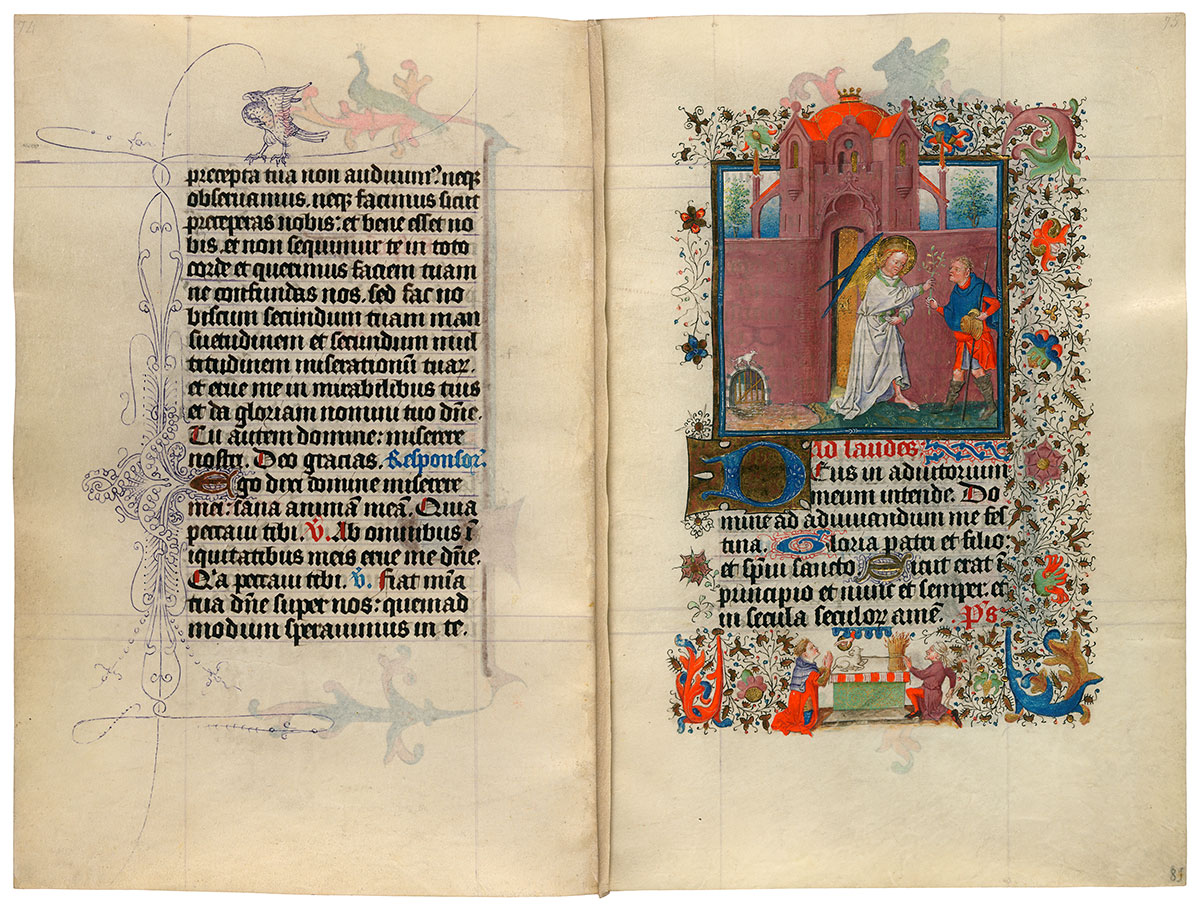
Archangel Michael Giving Seth a Branch from the Tree of Mercy
Purchased on the Belle da Costa Greene Fund with the assistance of the Fellows, 1963
Michael will not allow Seth even a glimpse beyond the golden door into the Garden of Eden, whose verdancy is suggested by towering trees. The archangel does, however, offer Seth the sought-after branch from the Tree of Mercy. The tiny white animal atop the sluice at left could be a tiger, namesake for the River Tigris, from which the four rivers of paradise spring. In the bottom border, Seth's older brothers, Abel and Cain, offer sacrifices to God, whose hand blesses only Abel's lamb.
Hours and Masses for the Seven Days of the Week
The most unusual texts in Catherine's manuscript are the series of Hours and Masses for every day of the week. Medieval Christian tradition associated certain figures or themes with different days. Thus Sunday, the day of the Resurrection, was the Lord's Day; Thursday was connected with the Eucharist since that sacrament was instituted on Holy Thursday; and Monday was the day of the dead, since their torments were suspended on Sunday but recommenced the following day. In Catherine's prayer book, the themes for the Hours and Masses of the seven days of the week are:
| Sunday | the Trinity |
| Monday | the Dead |
| Tuesday | the Holy Spirit |
| Wednesday | All Saints |
| Thursday | the Blessed Sacrament |
| Friday | the Compassion of God |
| Saturday | the Virgin. |
Image courtesy of Faksimile Verlag Luzern
MS M.917/945, pp. 86–87
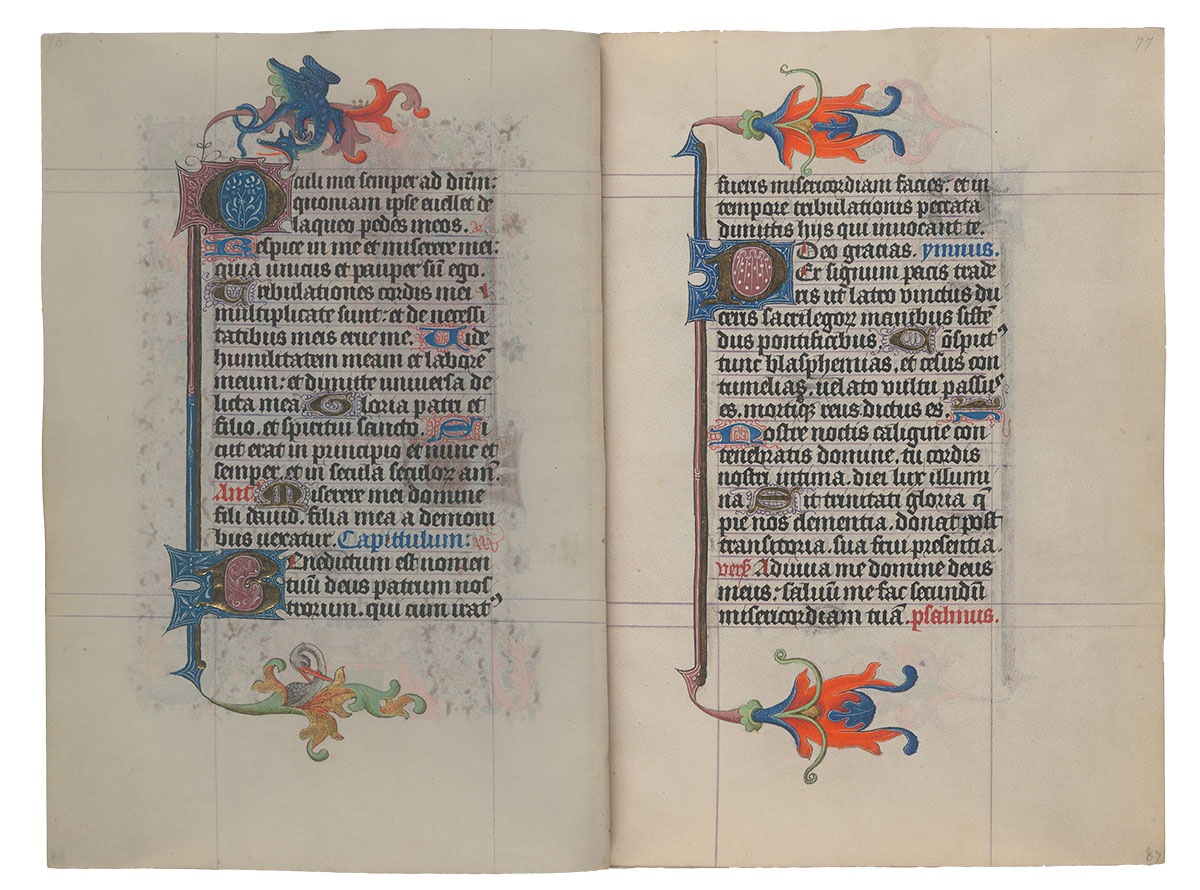
Purchased on the Belle da Costa Greene Fund with the assistance of the Fellows, 1963
Image courtesy of Faksimile Verlag Luzern
MS M.917/945, pp. 88–89
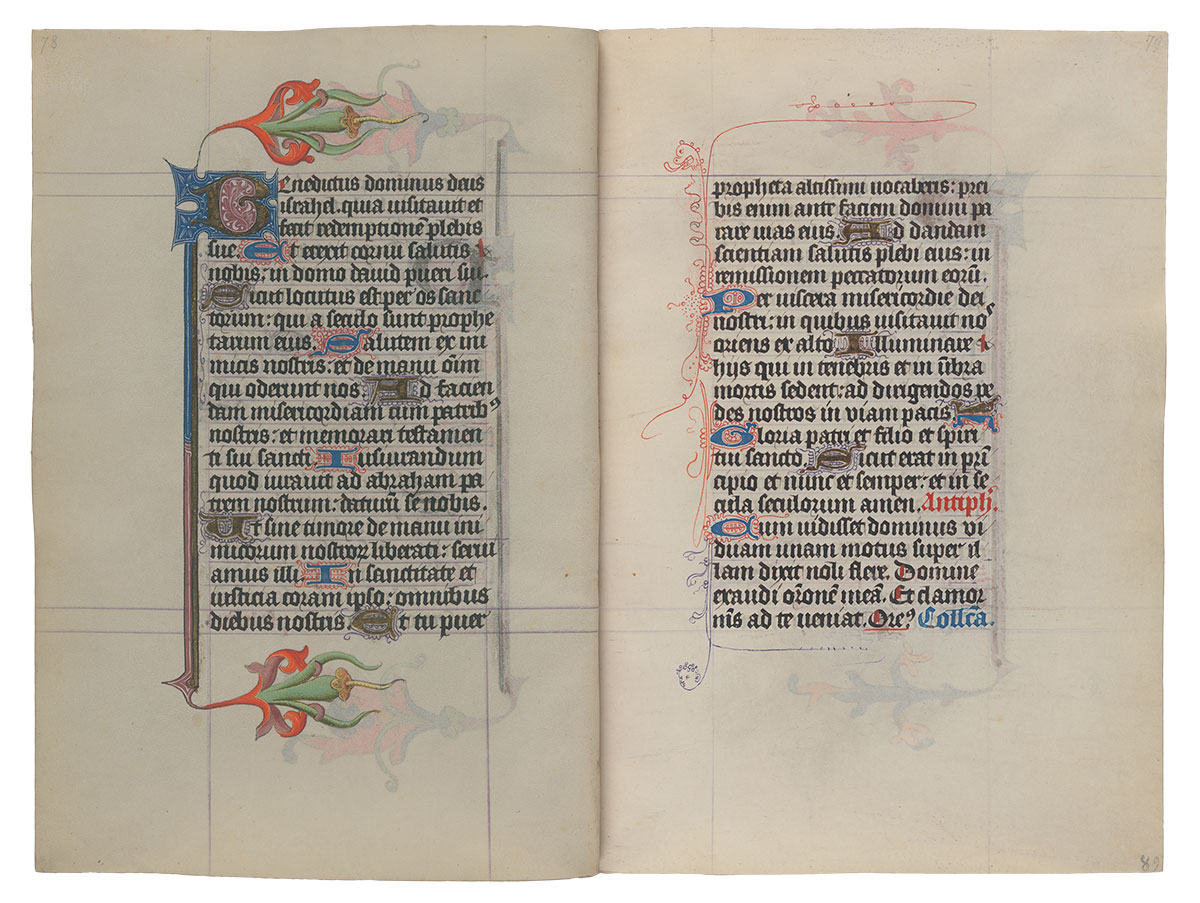
Purchased on the Belle da Costa Greene Fund with the assistance of the Fellows, 1963
Image courtesy of Faksimile Verlag Luzern
MS M.917/945, pp. 90–91
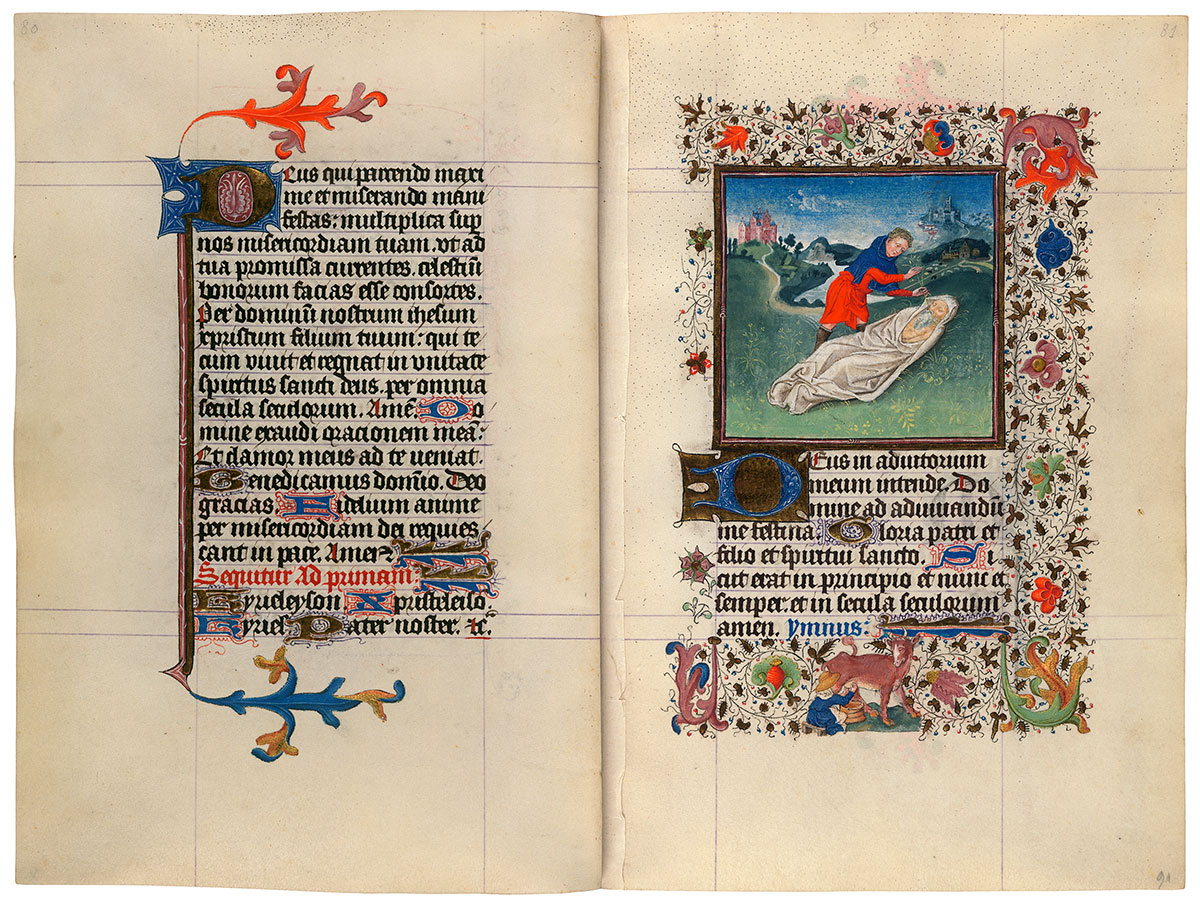
Seth Planting the Branch in the Mouth of the Dead Adam
Purchased on the Belle da Costa Greene Fund with the assistance of the Fellows, 1963
Seth arrives home too late to give his father the consolation he so desired. Adam died in his son's absence (the deep landscape suggests a long return journey). Seth plants the branch from the Tree of Mercy in his father's mouth.
Hours and Masses for the Seven Days of the Week
The most unusual texts in Catherine's manuscript are the series of Hours and Masses for every day of the week. Medieval Christian tradition associated certain figures or themes with different days. Thus Sunday, the day of the Resurrection, was the Lord's Day; Thursday was connected with the Eucharist since that sacrament was instituted on Holy Thursday; and Monday was the day of the dead, since their torments were suspended on Sunday but recommenced the following day. In Catherine's prayer book, the themes for the Hours and Masses of the seven days of the week are:
| Sunday | the Trinity |
| Monday | the Dead |
| Tuesday | the Holy Spirit |
| Wednesday | All Saints |
| Thursday | the Blessed Sacrament |
| Friday | the Compassion of God |
| Saturday | the Virgin. |
Image courtesy of Faksimile Verlag Luzern
MS M.917/945, pp. 92–93
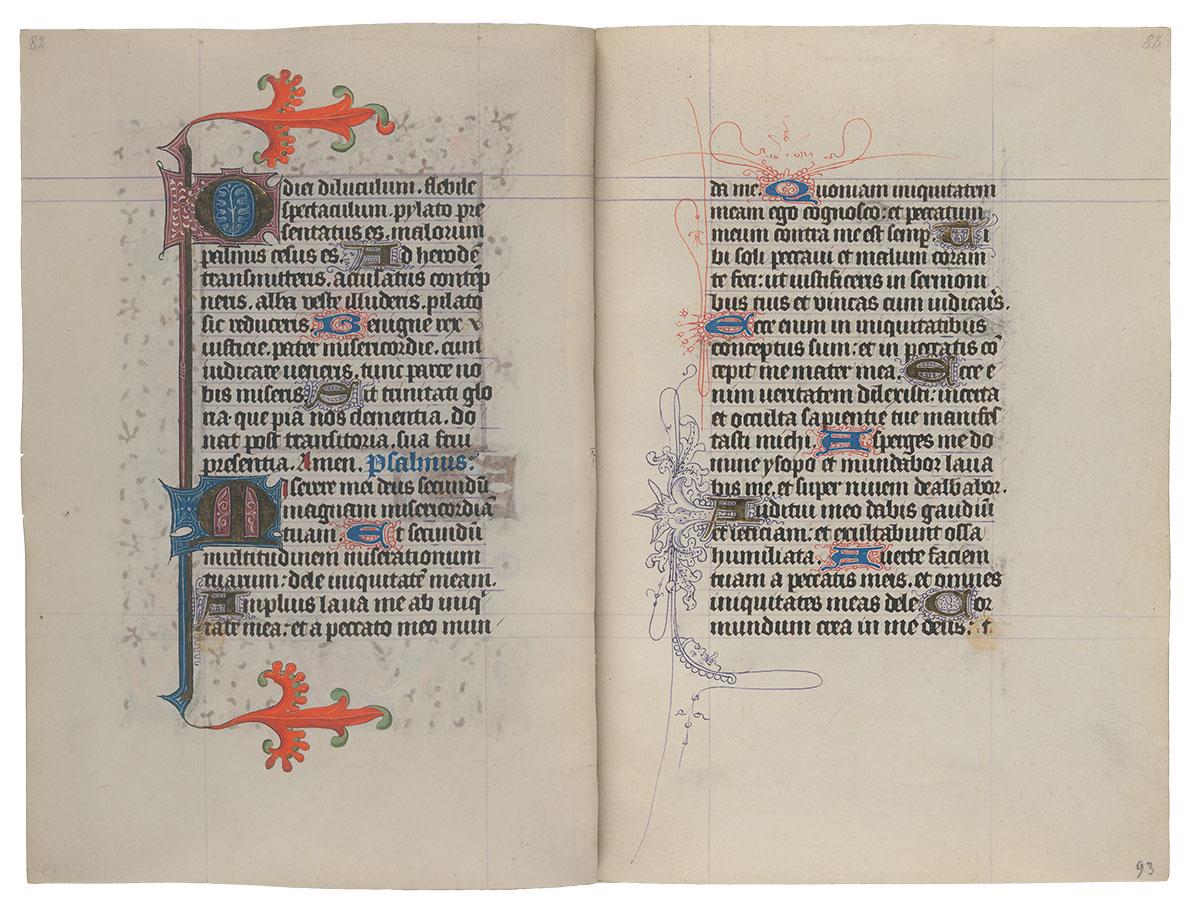
Purchased on the Belle da Costa Greene Fund with the assistance of the Fellows, 1963
Image courtesy of Faksimile Verlag Luzern
MS M.917/945, pp. 94–95
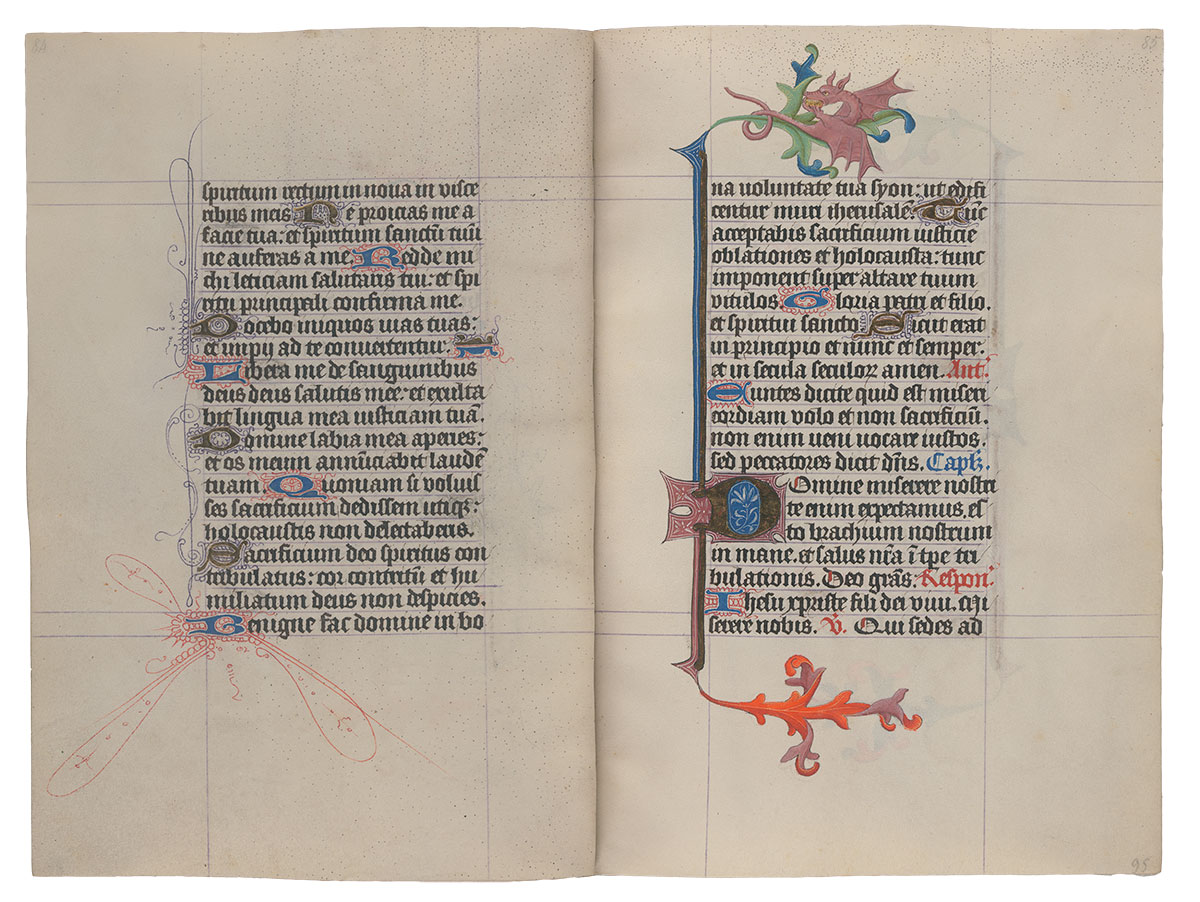
Purchased on the Belle da Costa Greene Fund with the assistance of the Fellows, 1963
Image courtesy of Faksimile Verlag Luzern
MS M.917/945, pp. 96–97
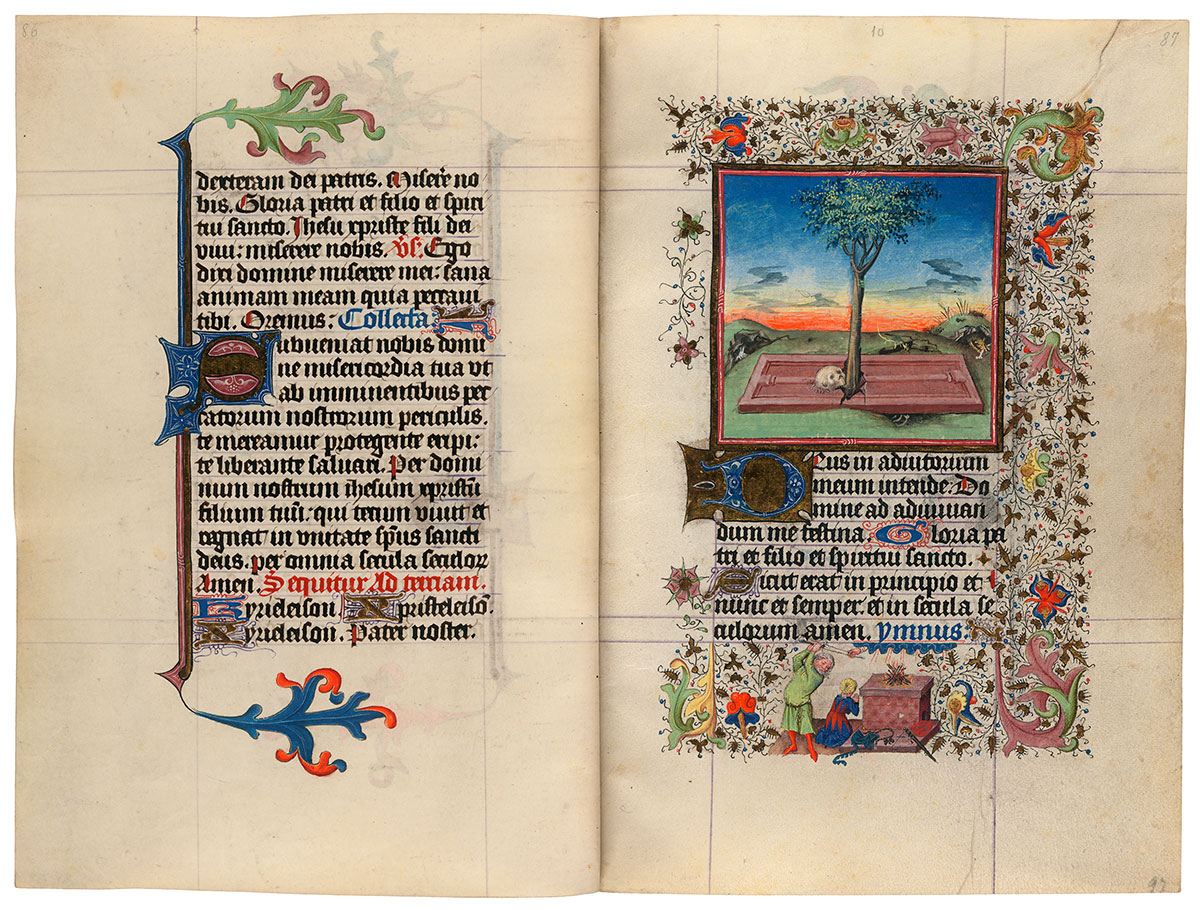
Tree Growing from Adam’s Grave
Purchased on the Belle da Costa Greene Fund with the assistance of the Fellows, 1963
Having taken root, the branch from the Tree of Mercy planted by Seth in his father's mouth grows into a healthy tree. It breaks through the slab covering Adam's grave, raising his skull in the process. The horizon glows orange: symbolically a new day has dawned. In the bottom border is depicted the sacrifice of Abraham. The patriarch's willingness to kill his son Isaac (a sacrifice stopped, as we see here, by the hand of God) symbolizes God's willingness to sacrifice his son, Christ, on the Cross. The vignette thus hints at the future of the tree painted above it in the miniature.
Hours and Masses for the Seven Days of the Week
The most unusual texts in Catherine's manuscript are the series of Hours and Masses for every day of the week. Medieval Christian tradition associated certain figures or themes with different days. Thus Sunday, the day of the Resurrection, was the Lord's Day; Thursday was connected with the Eucharist since that sacrament was instituted on Holy Thursday; and Monday was the day of the dead, since their torments were suspended on Sunday but recommenced the following day. In Catherine's prayer book, the themes for the Hours and Masses of the seven days of the week are:
| Sunday | the Trinity |
| Monday | the Dead |
| Tuesday | the Holy Spirit |
| Wednesday | All Saints |
| Thursday | the Blessed Sacrament |
| Friday | the Compassion of God |
| Saturday | the Virgin. |
Image courtesy of Faksimile Verlag Luzern
MS M.917/945, pp. 98–99
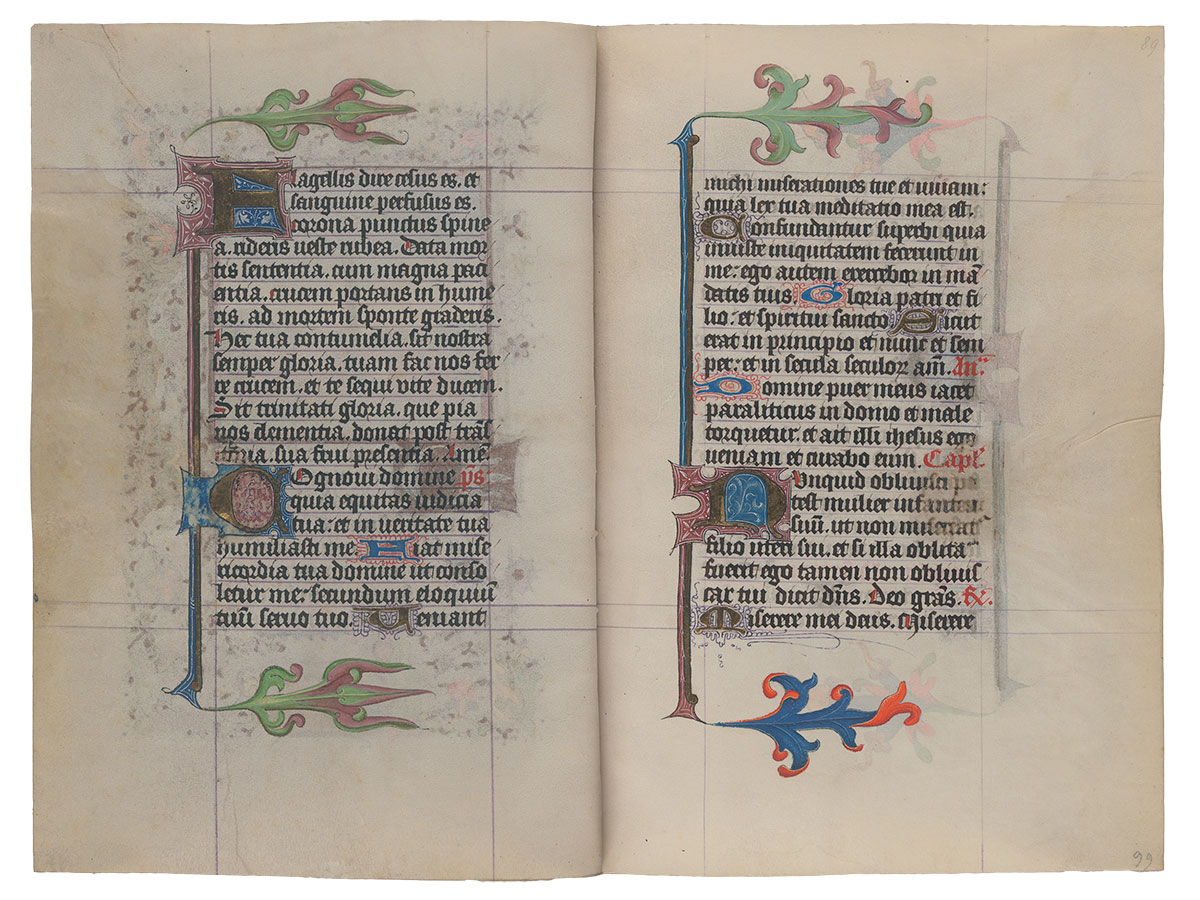
Purchased on the Belle da Costa Greene Fund with the assistance of the Fellows, 1963
Image courtesy of Faksimile Verlag Luzern
MS M.917/945, pp. 100–101
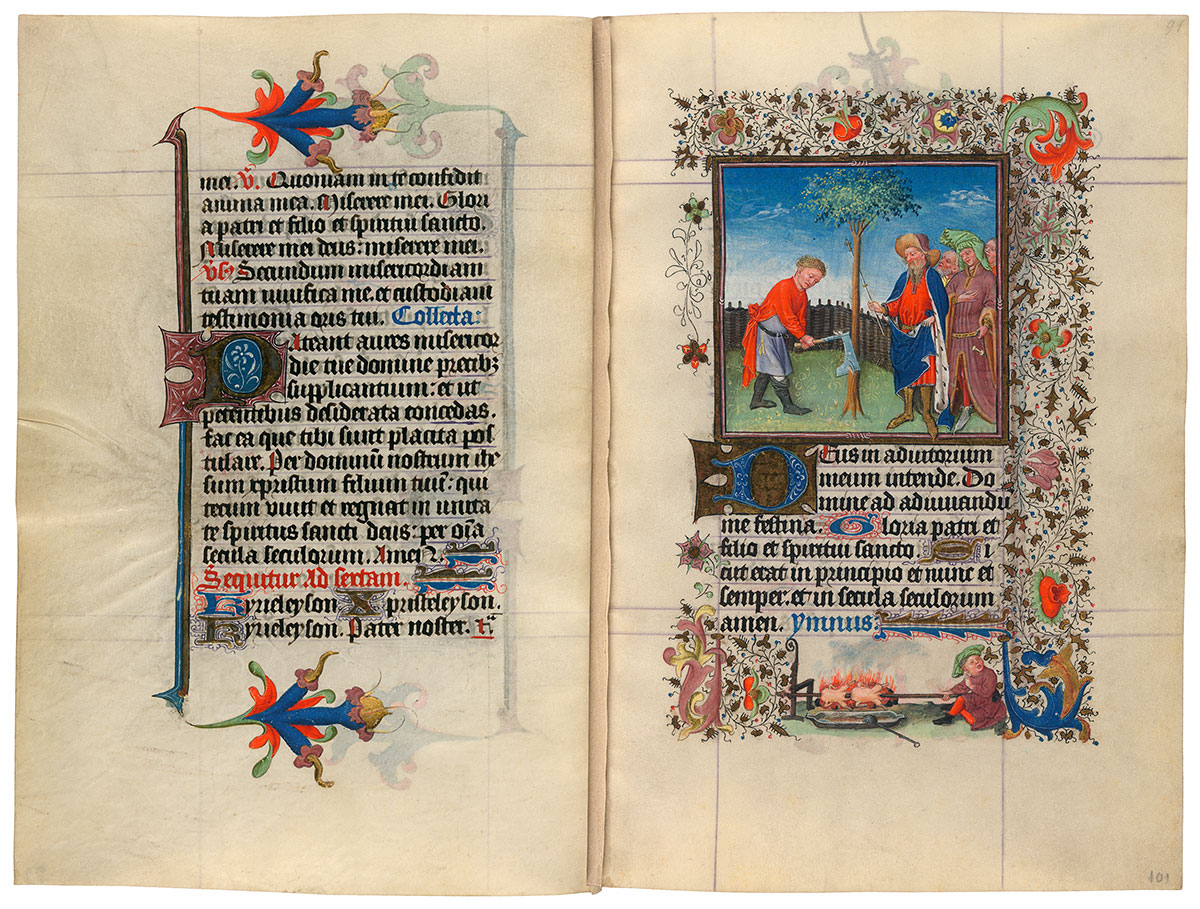
Solomon Ordering the Tree Cut Down
Purchased on the Belle da Costa Greene Fund with the assistance of the Fellows, 1963
With this miniature, the story of the True Cross flashes forward. Solomon, in preparation for building the Temple of Jerusalem, orders the tree chopped down. Dressed in an ermine-lined cloak, the king uses his scepter to supervise the action. In the bottom border, a boy roasts chickens on an open-air spit. The significance of this vignette to the theme of the miniature has eluded explanation.
Hours and Masses for the Seven Days of the Week
The most unusual texts in Catherine's manuscript are the series of Hours and Masses for every day of the week. Medieval Christian tradition associated certain figures or themes with different days. Thus Sunday, the day of the Resurrection, was the Lord's Day; Thursday was connected with the Eucharist since that sacrament was instituted on Holy Thursday; and Monday was the day of the dead, since their torments were suspended on Sunday but recommenced the following day. In Catherine's prayer book, the themes for the Hours and Masses of the seven days of the week are:
| Sunday | the Trinity |
| Monday | the Dead |
| Tuesday | the Holy Spirit |
| Wednesday | All Saints |
| Thursday | the Blessed Sacrament |
| Friday | the Compassion of God |
| Saturday | the Virgin. |
Image courtesy of Faksimile Verlag Luzern
MS M.917/945, pp. 102–103
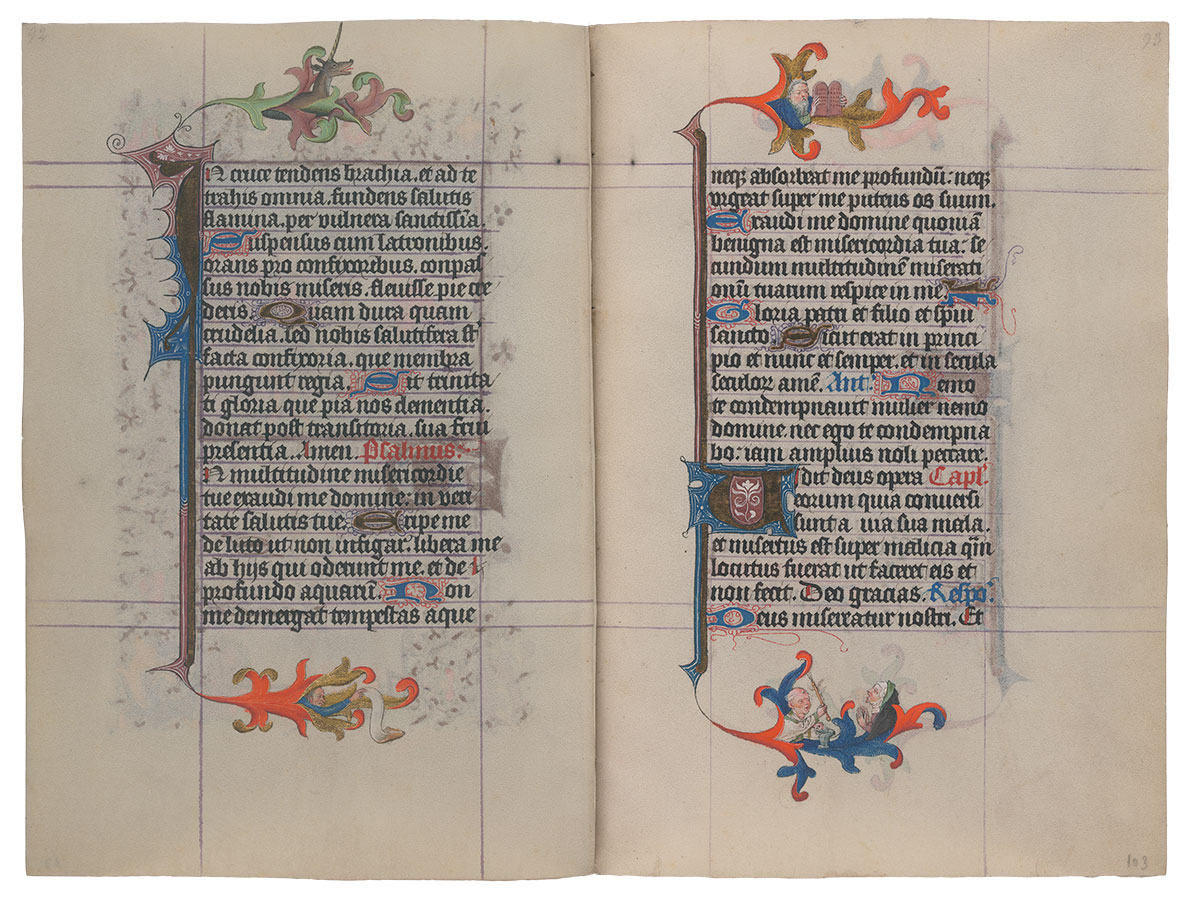
Purchased on the Belle da Costa Greene Fund with the assistance of the Fellows, 1963
Image courtesy of Faksimile Verlag Luzern
MS M.917/945, pp. 104–105
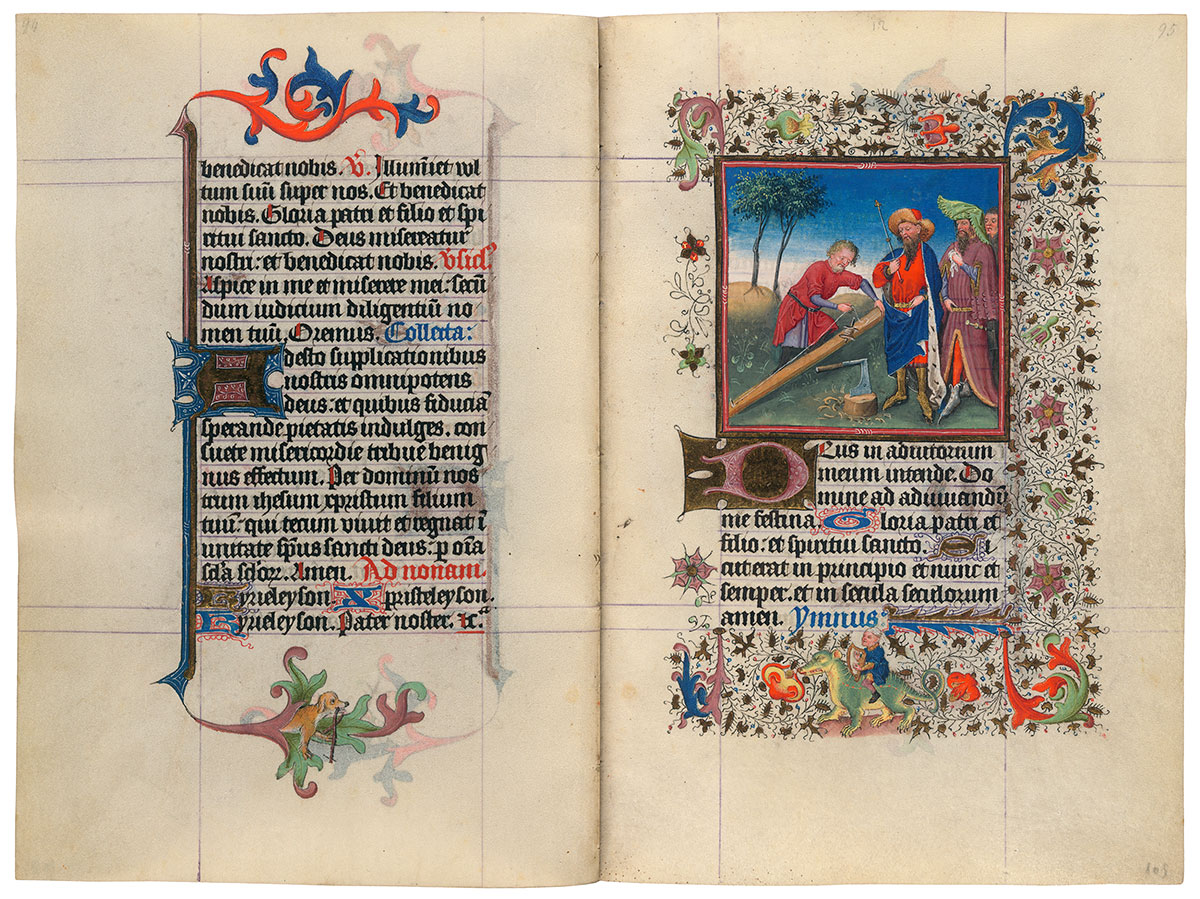
Solomon Observing the Measuring of the Timber
Purchased on the Belle da Costa Greene Fund with the assistance of the Fellows, 1963
Having cut the tree and shaped the timber, the carpenter measures it with string. Solomon, dressed as he was in the previous miniature, again oversees the activity, scepter still in hand. The wood, however, always found to be either too long or too short for use in the temple, is rejected.
Hours and Masses for the Seven Days of the Week
The most unusual texts in Catherine's manuscript are the series of Hours and Masses for every day of the week. Medieval Christian tradition associated certain figures or themes with different days. Thus Sunday, the day of the Resurrection, was the Lord's Day; Thursday was connected with the Eucharist since that sacrament was instituted on Holy Thursday; and Monday was the day of the dead, since their torments were suspended on Sunday but recommenced the following day. In Catherine's prayer book, the themes for the Hours and Masses of the seven days of the week are:
| Sunday | the Trinity |
| Monday | the Dead |
| Tuesday | the Holy Spirit |
| Wednesday | All Saints |
| Thursday | the Blessed Sacrament |
| Friday | the Compassion of God |
| Saturday | the Virgin. |
Image courtesy of Faksimile Verlag Luzern
MS M.917/945, pp. 106–107
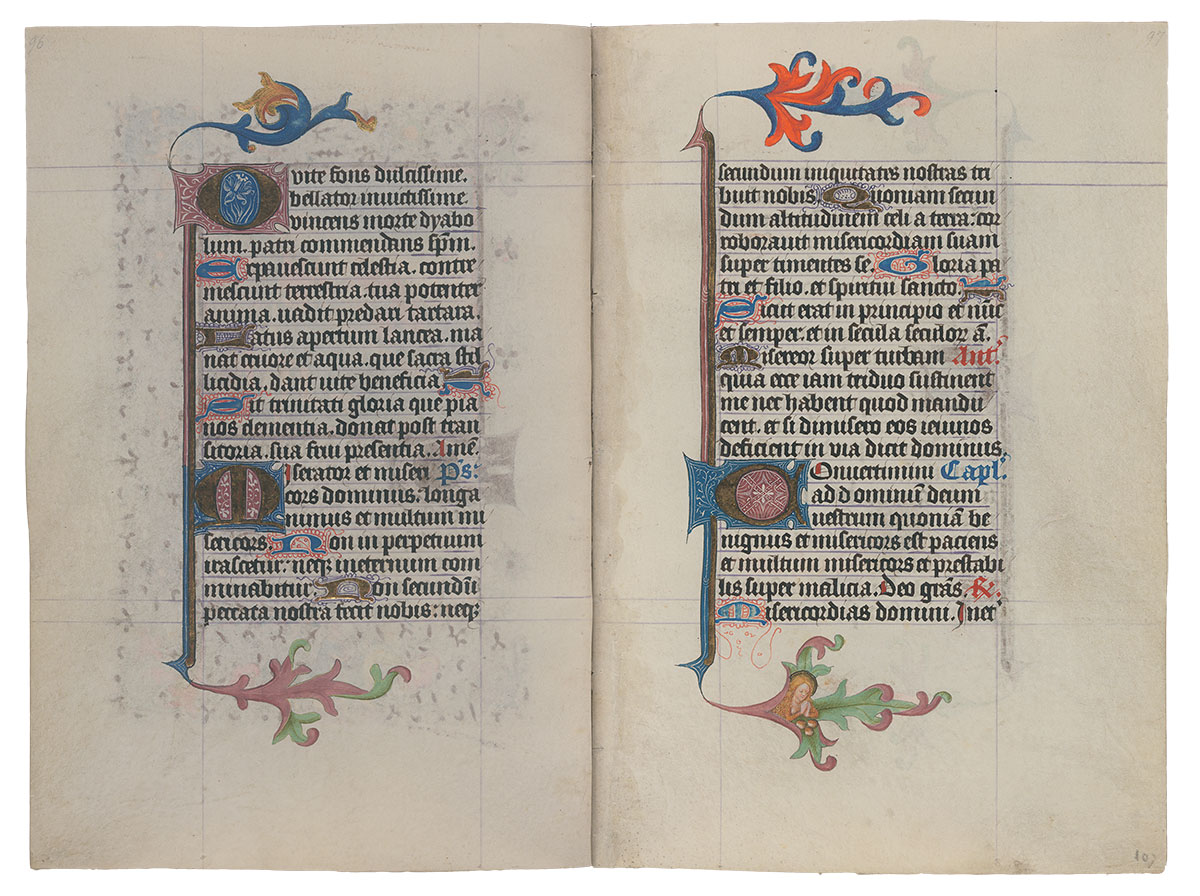
Purchased on the Belle da Costa Greene Fund with the assistance of the Fellows, 1963
Image courtesy of Faksimile Verlag Luzern
MS M.917/945, pp. 108–109
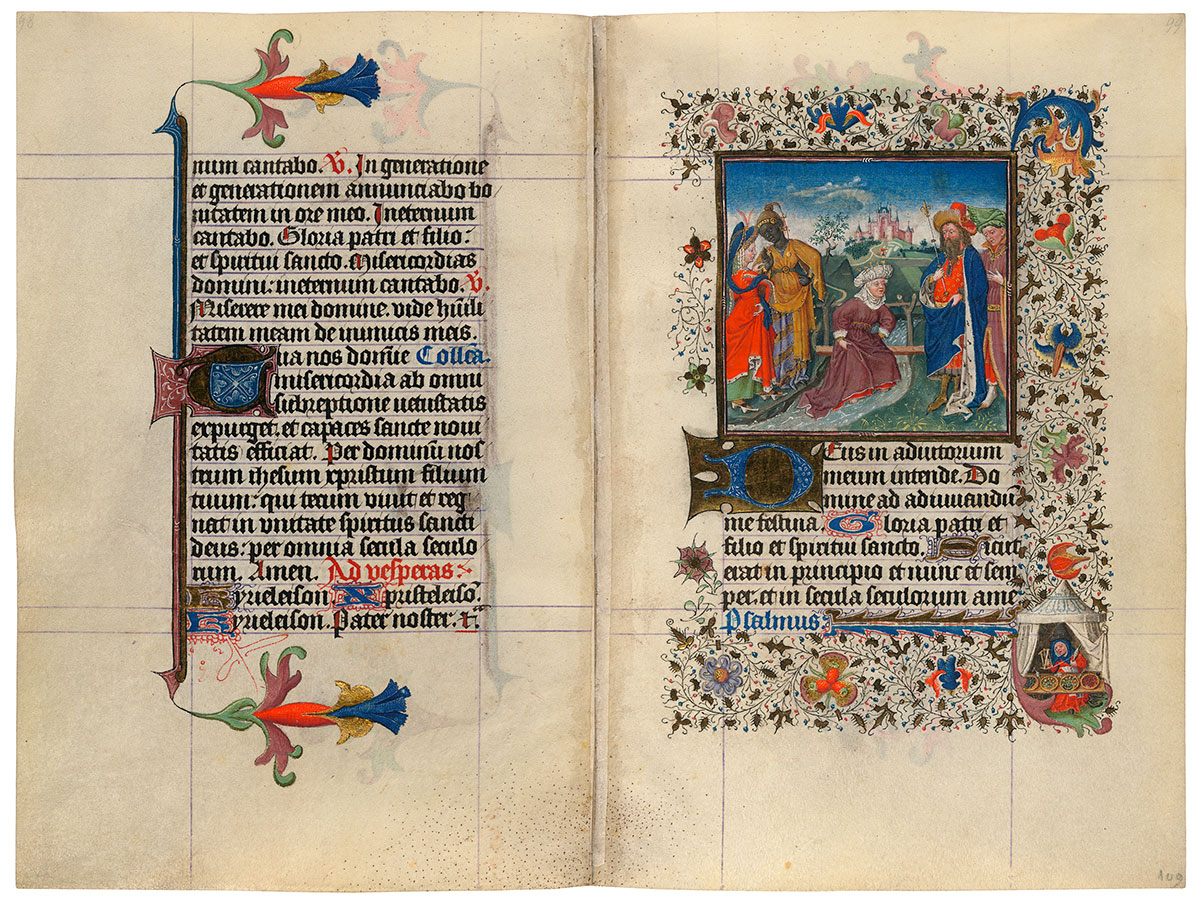
The Queen of Sheba Fording the Stream of Cedron
Purchased on the Belle da Costa Greene Fund with the assistance of the Fellows, 1963
Unsuitable for constructing the temple, the timber is employed as a lowly footbridge over the stream of Cedron. It is this footbridge that the Queen of Sheba must cross in order to pay a visit to Solomon. The queen, however, had a prophetic vision that the bridge would furnish the wood upon which Christ would be crucified. She therefore refuses to tread on the bridge and instead wades, as we see here, across the Cedron to reach the waiting king.
Hours and Masses for the Seven Days of the Week
The most unusual texts in Catherine's manuscript are the series of Hours and Masses for every day of the week. Medieval Christian tradition associated certain figures or themes with different days. Thus Sunday, the day of the Resurrection, was the Lord's Day; Thursday was connected with the Eucharist since that sacrament was instituted on Holy Thursday; and Monday was the day of the dead, since their torments were suspended on Sunday but recommenced the following day. In Catherine's prayer book, the themes for the Hours and Masses of the seven days of the week are:
| Sunday | the Trinity |
| Monday | the Dead |
| Tuesday | the Holy Spirit |
| Wednesday | All Saints |
| Thursday | the Blessed Sacrament |
| Friday | the Compassion of God |
| Saturday | the Virgin. |
Image courtesy of Faksimile Verlag Luzern
MS M.917/945, pp. 110–111
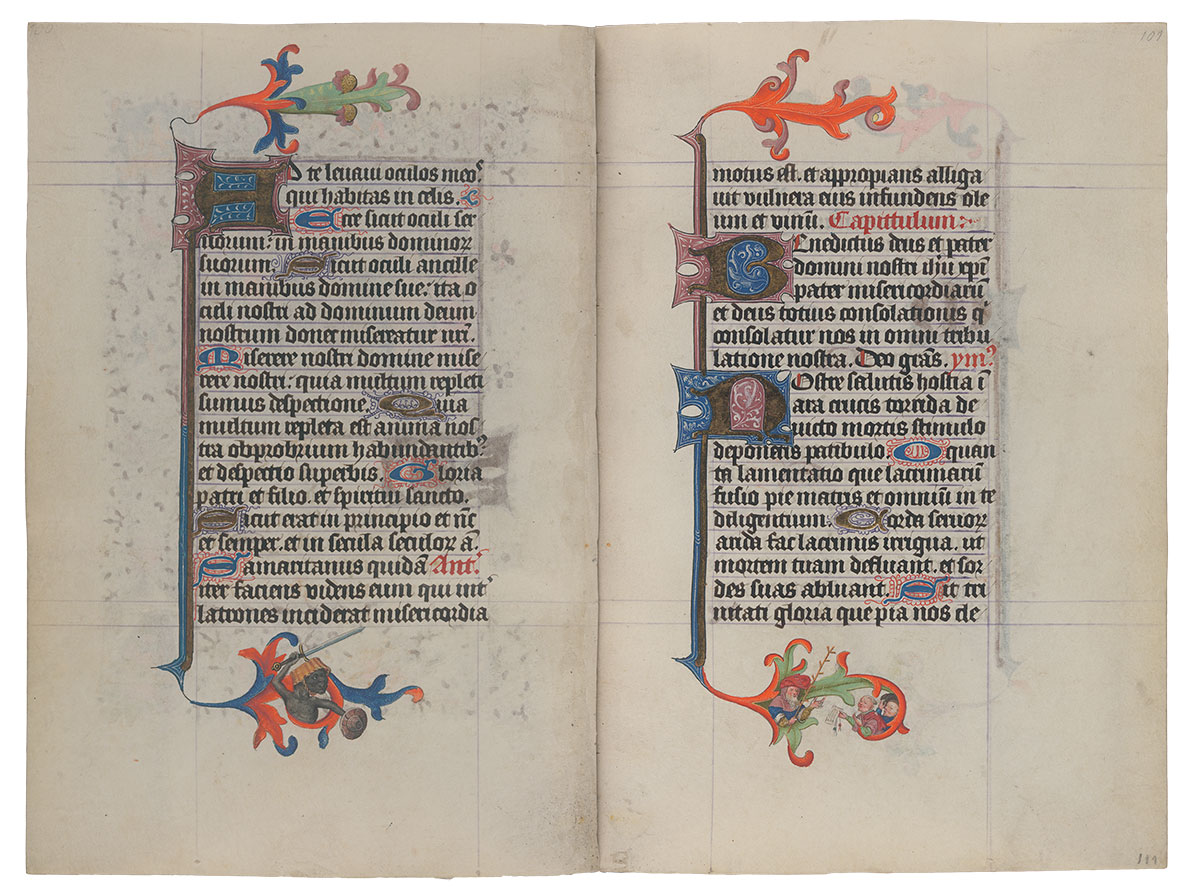
Purchased on the Belle da Costa Greene Fund with the assistance of the Fellows, 1963
Image courtesy of Faksimile Verlag Luzern
MS M.917/945, pp. 112–113
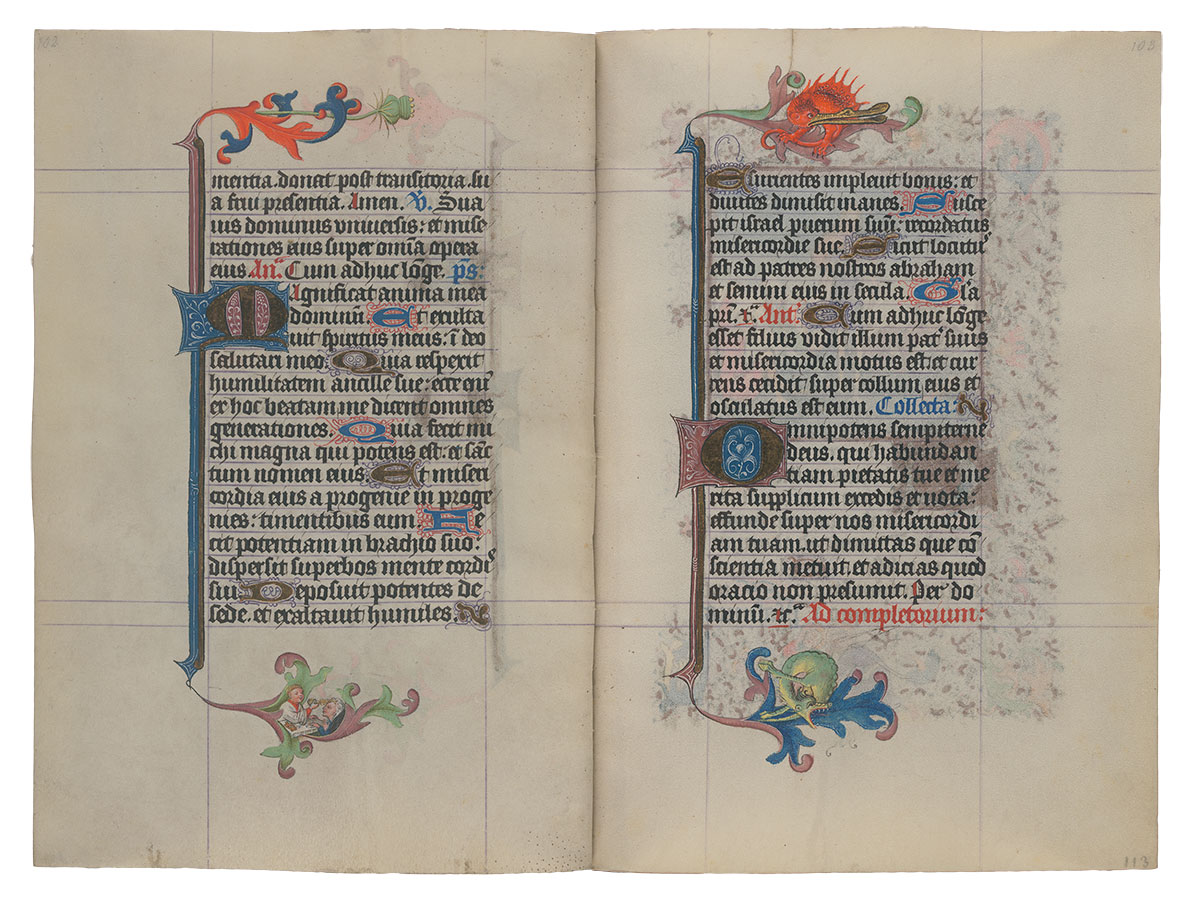
Purchased on the Belle da Costa Greene Fund with the assistance of the Fellows, 1963
Image courtesy of Faksimile Verlag Luzern
MS M.917/945, pp. 114–115
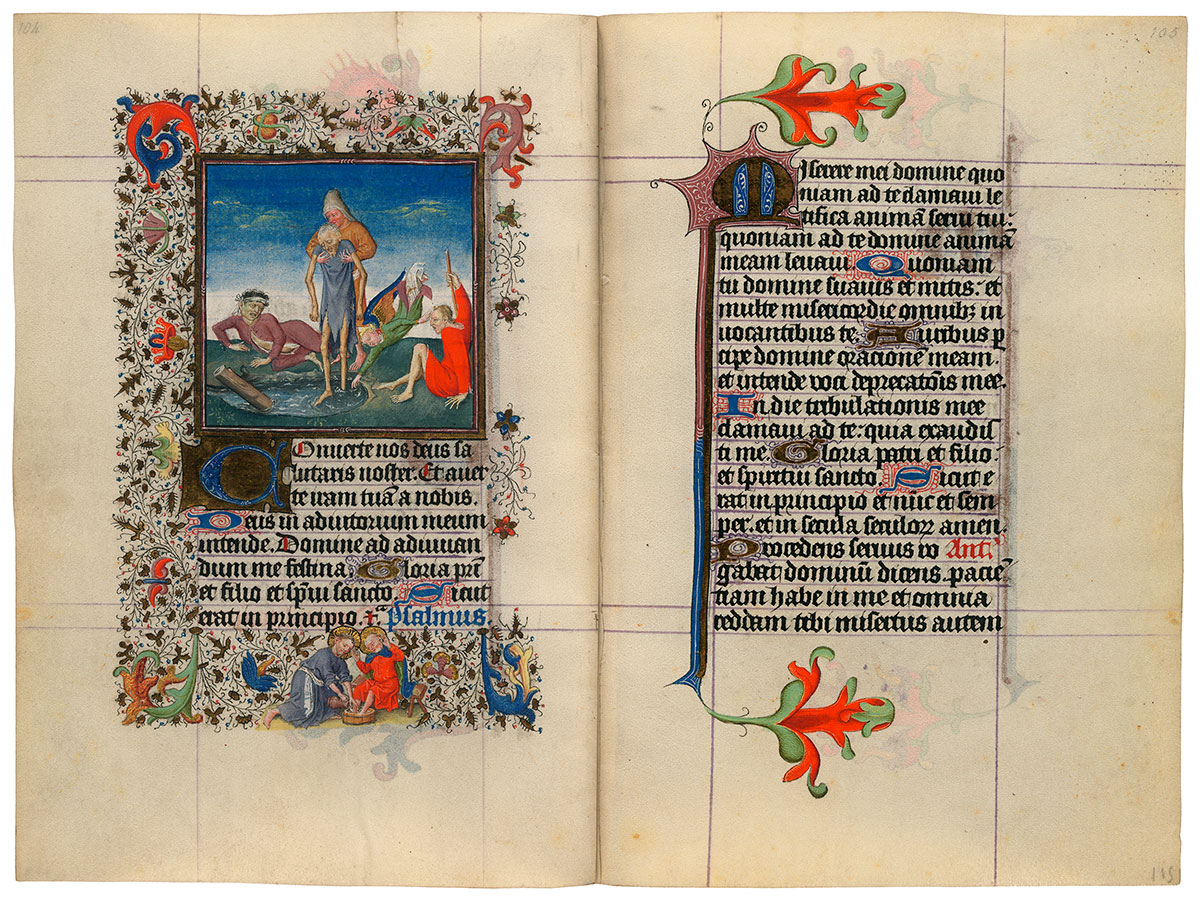
An Angel Stirs the Pool of Bethesda
Purchased on the Belle da Costa Greene Fund with the assistance of the Fellows, 1963
Solomon, aware of an ancient prophecy that the Kingdom of the Jews would come to its end through the wood from the Tree of Mercy, has it buried. Over the burial spot, a pool of miraculous water wells up (there is a floating log in the miniature). When an angel stirred the waters of the Pool of Bethesda, it acquired healing powers. The border vignette of Christ washing the feet of the apostle Peter is a New Testament gloss on the spiritual cleansing powers of water.
Hours and Masses for the Seven Days of the Week
The most unusual texts in Catherine's manuscript are the series of Hours and Masses for every day of the week. Medieval Christian tradition associated certain figures or themes with different days. Thus Sunday, the day of the Resurrection, was the Lord's Day; Thursday was connected with the Eucharist since that sacrament was instituted on Holy Thursday; and Monday was the day of the dead, since their torments were suspended on Sunday but recommenced the following day. In Catherine's prayer book, the themes for the Hours and Masses of the seven days of the week are:
| Sunday | the Trinity |
| Monday | the Dead |
| Tuesday | the Holy Spirit |
| Wednesday | All Saints |
| Thursday | the Blessed Sacrament |
| Friday | the Compassion of God |
| Saturday | the Virgin. |
Image courtesy of Faksimile Verlag Luzern
MS M.917/945, pp. 116–117
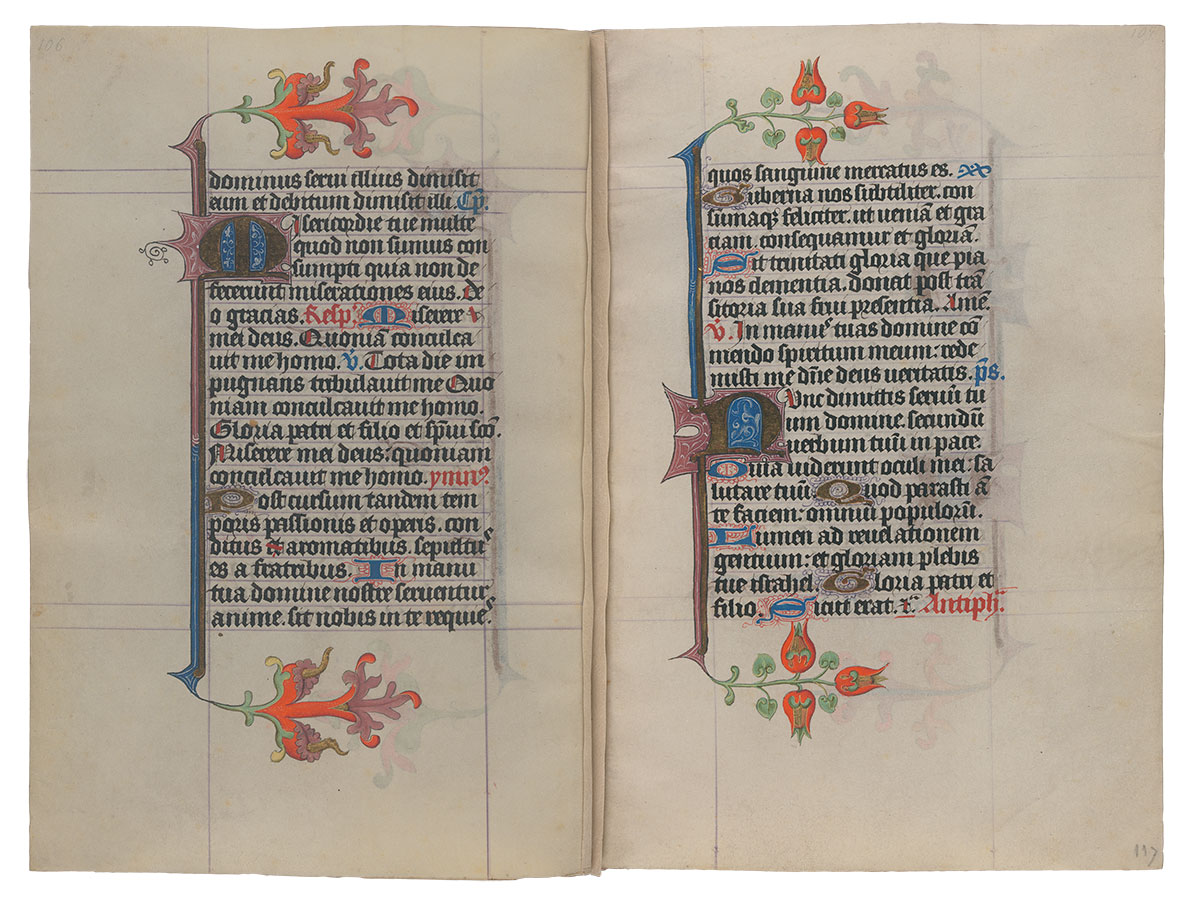
Purchased on the Belle da Costa Greene Fund with the assistance of the Fellows, 1963
Image courtesy of Faksimile Verlag Luzern
MS M.917/945, pp. 118–121
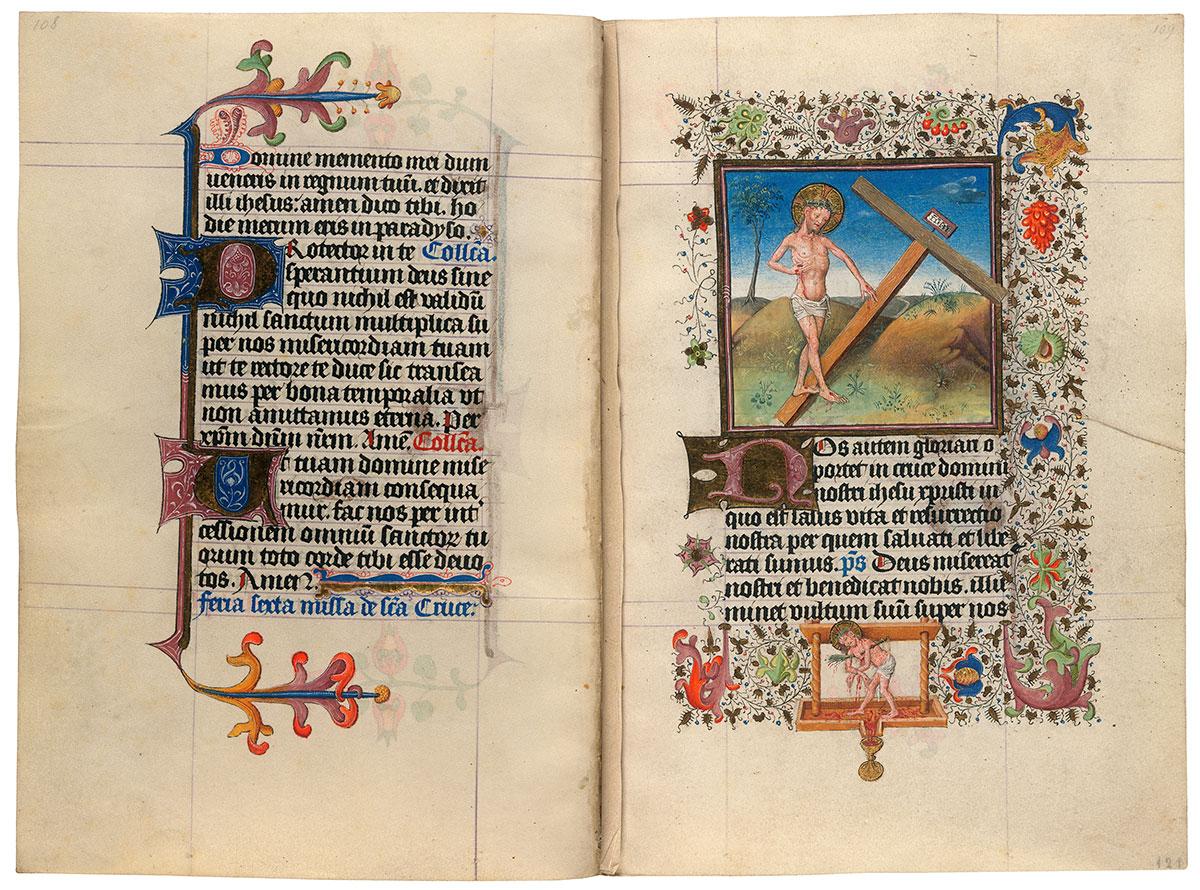
Man of Sorrows and the Cross
Purchased on the Belle da Costa Greene Fund with the assistance of the Fellows, 1963
The Mass of the Holy Cross originally had a large miniature that is now missing. It faced this smaller image showing Christ as the Man of Sorrows standing on his lowered Cross. The scene does not represent a narrative event; rather it is an allegorical image of Christ's triumph over his Cross, his victory over death. The border vignette offers another allegorical image: Christ in the Winepress. Just as grapes are squeezed, Christ is crushed by the winepress; his salvific blood flows into a Eucharistic chalice.
Hours and Masses for the Seven Days of the Week
The most unusual texts in Catherine's manuscript are the series of Hours and Masses for every day of the week. Medieval Christian tradition associated certain figures or themes with different days. Thus Sunday, the day of the Resurrection, was the Lord's Day; Thursday was connected with the Eucharist since that sacrament was instituted on Holy Thursday; and Monday was the day of the dead, since their torments were suspended on Sunday but recommenced the following day. In Catherine's prayer book, the themes for the Hours and Masses of the seven days of the week are:
| Sunday | the Trinity |
| Monday | the Dead |
| Tuesday | the Holy Spirit |
| Wednesday | All Saints |
| Thursday | the Blessed Sacrament |
| Friday | the Compassion of God |
| Saturday | the Virgin. |
Image courtesy of Faksimile Verlag Luzern
MS M.917/945, pp. 122–123
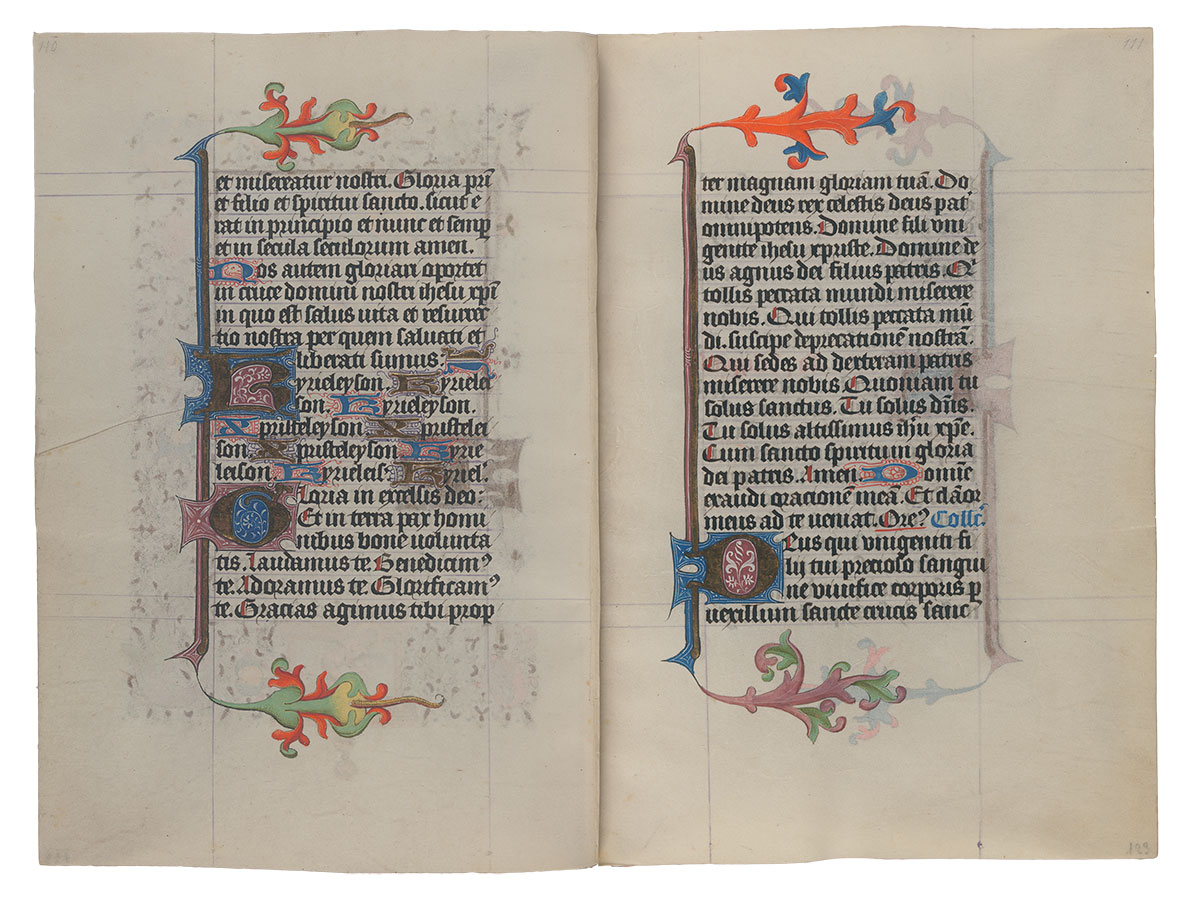
Purchased on the Belle da Costa Greene Fund with the assistance of the Fellows, 1963
Image courtesy of Faksimile Verlag Luzern
MS M.917/945, pp. 124–125
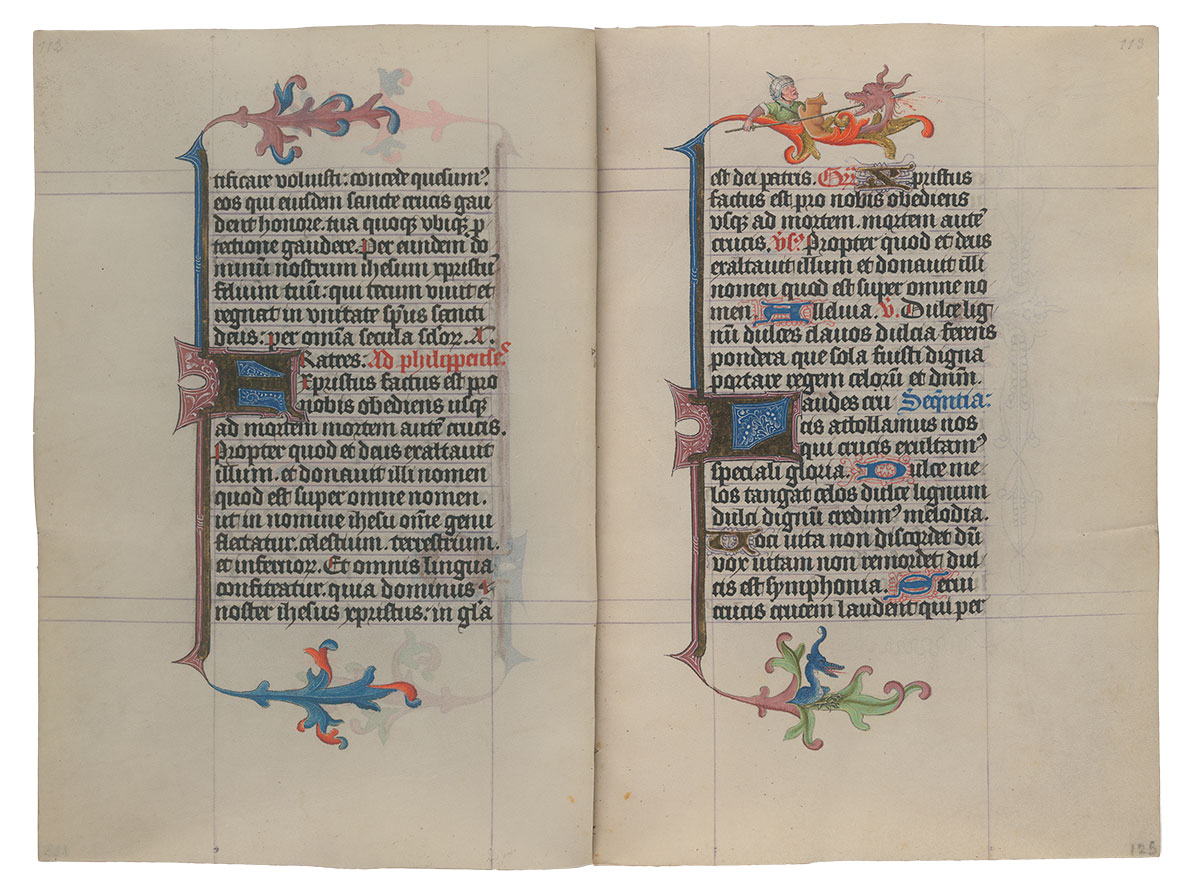
Purchased on the Belle da Costa Greene Fund with the assistance of the Fellows, 1963
Image courtesy of Faksimile Verlag Luzern
MS M.917/945, pp. 126–127
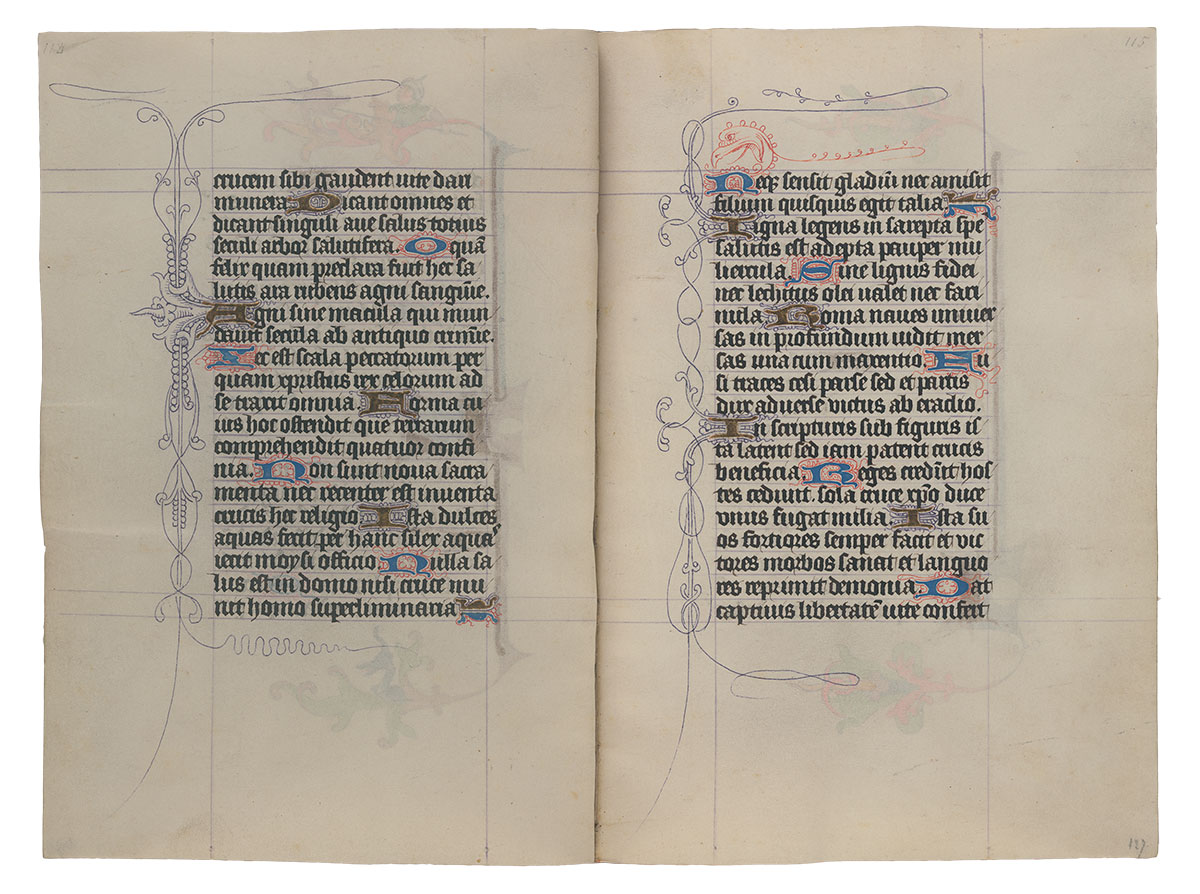
Purchased on the Belle da Costa Greene Fund with the assistance of the Fellows, 1963
Image courtesy of Faksimile Verlag Luzern
MS M.917/945, pp. 128–129
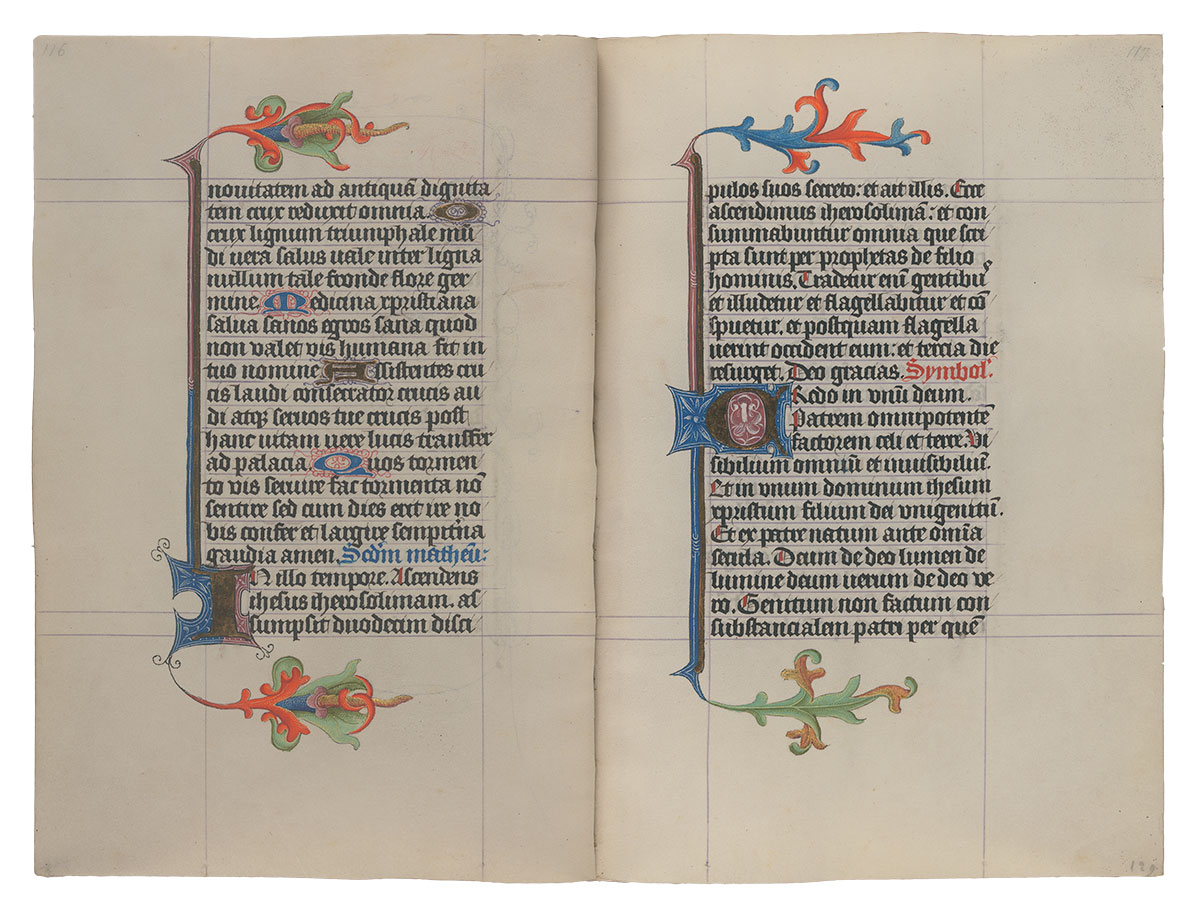
Purchased on the Belle da Costa Greene Fund with the assistance of the Fellows, 1963
Image courtesy of Faksimile Verlag Luzern
MS M.917/945, pp. 130–131
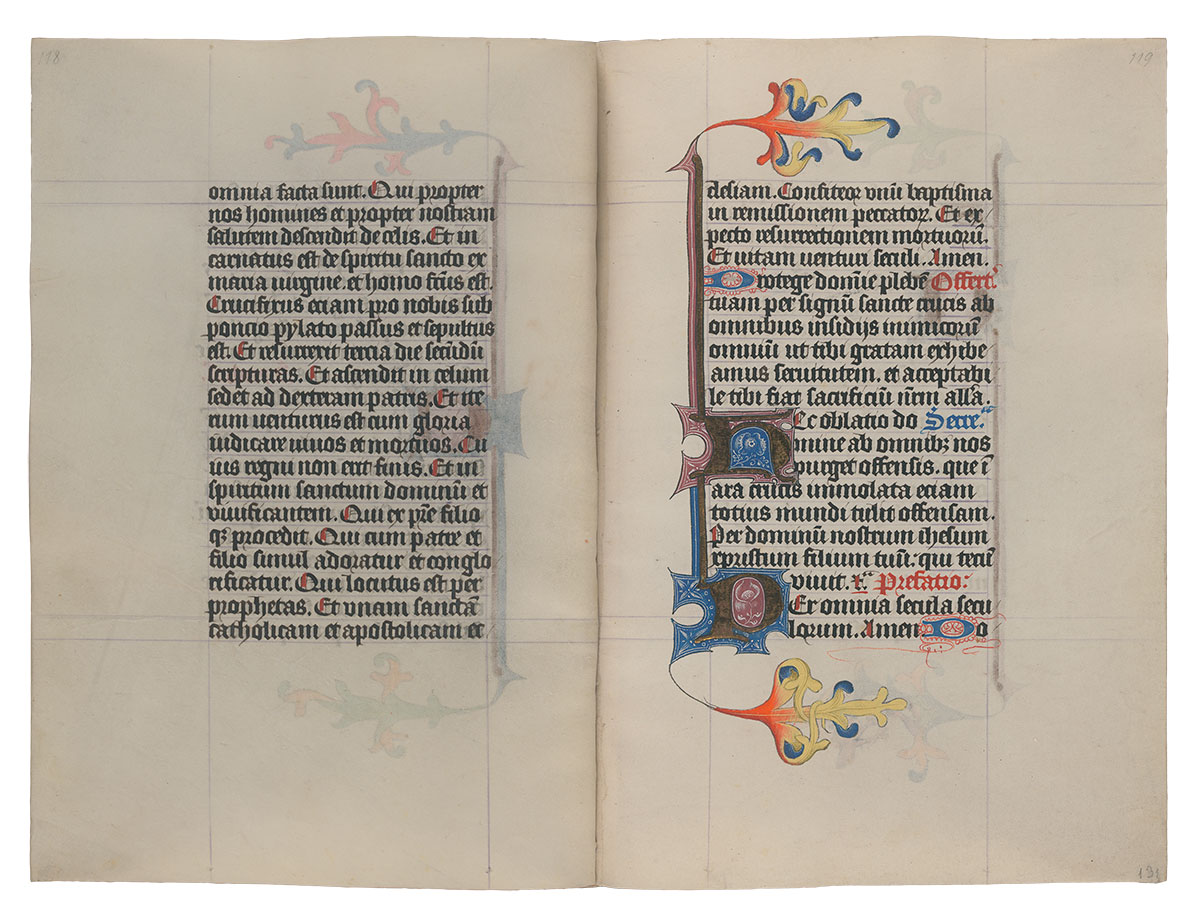
Purchased on the Belle da Costa Greene Fund with the assistance of the Fellows, 1963
Image courtesy of Faksimile Verlag Luzern
MS M.917/945, pp. 132–133
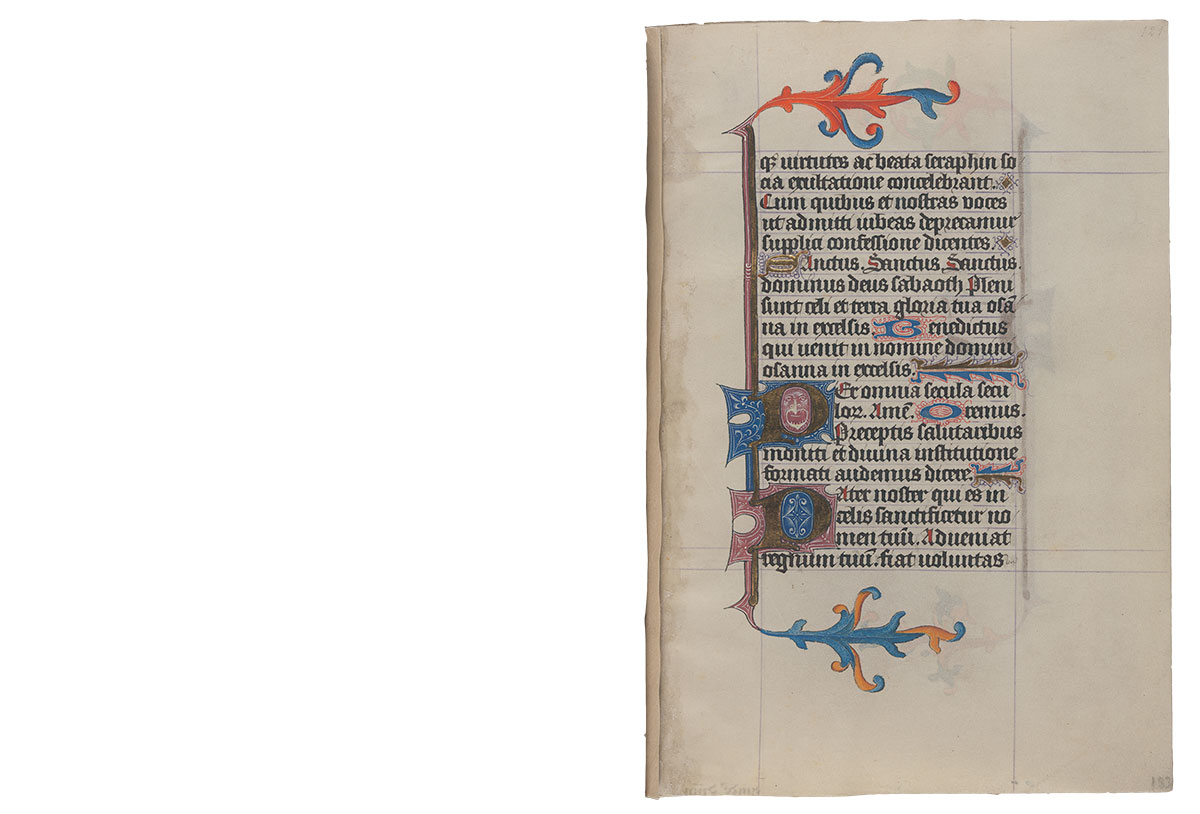
Purchased on the Belle da Costa Greene Fund with the assistance of the Fellows, 1963
Image courtesy of Faksimile Verlag Luzern
MS M.917/945, pp. 134–135
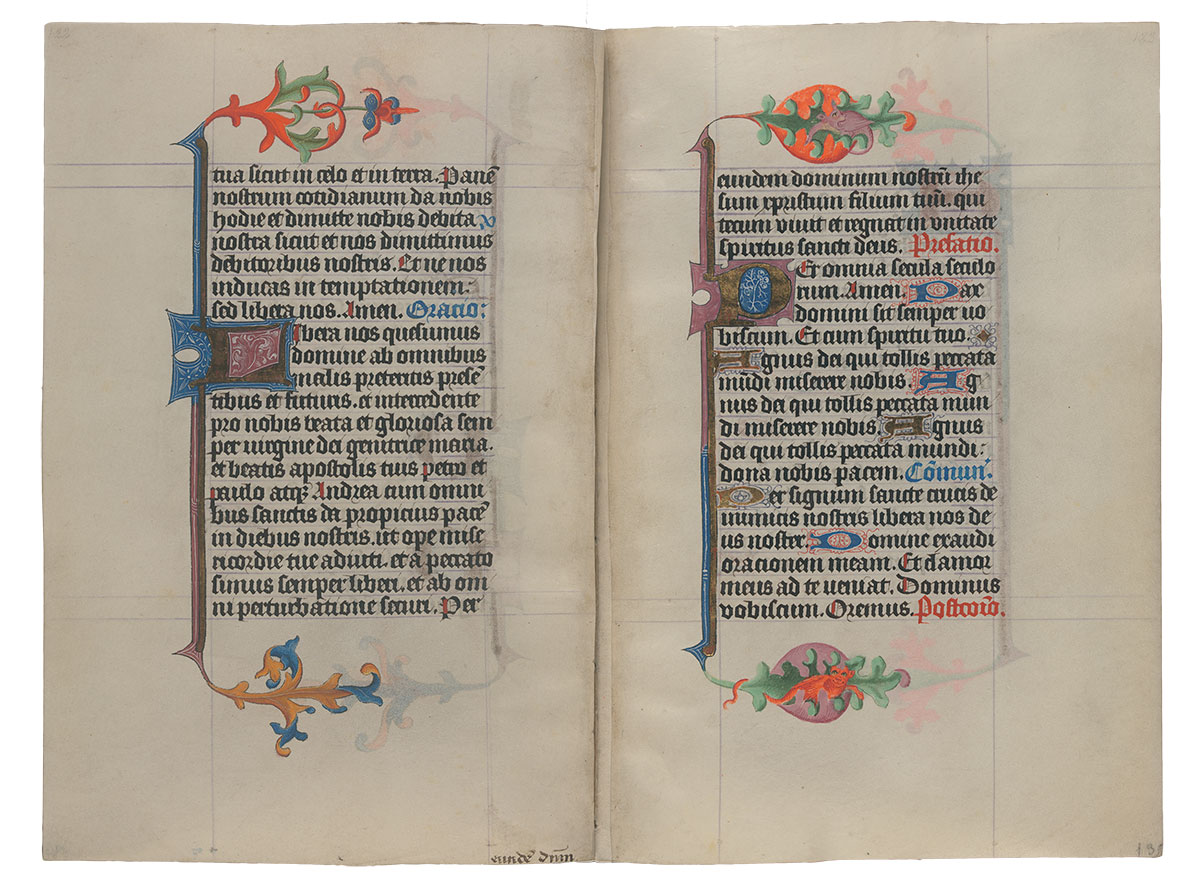
Purchased on the Belle da Costa Greene Fund with the assistance of the Fellows, 1963
Image courtesy of Faksimile Verlag Luzern
MS M.917/945, pp. 136–137
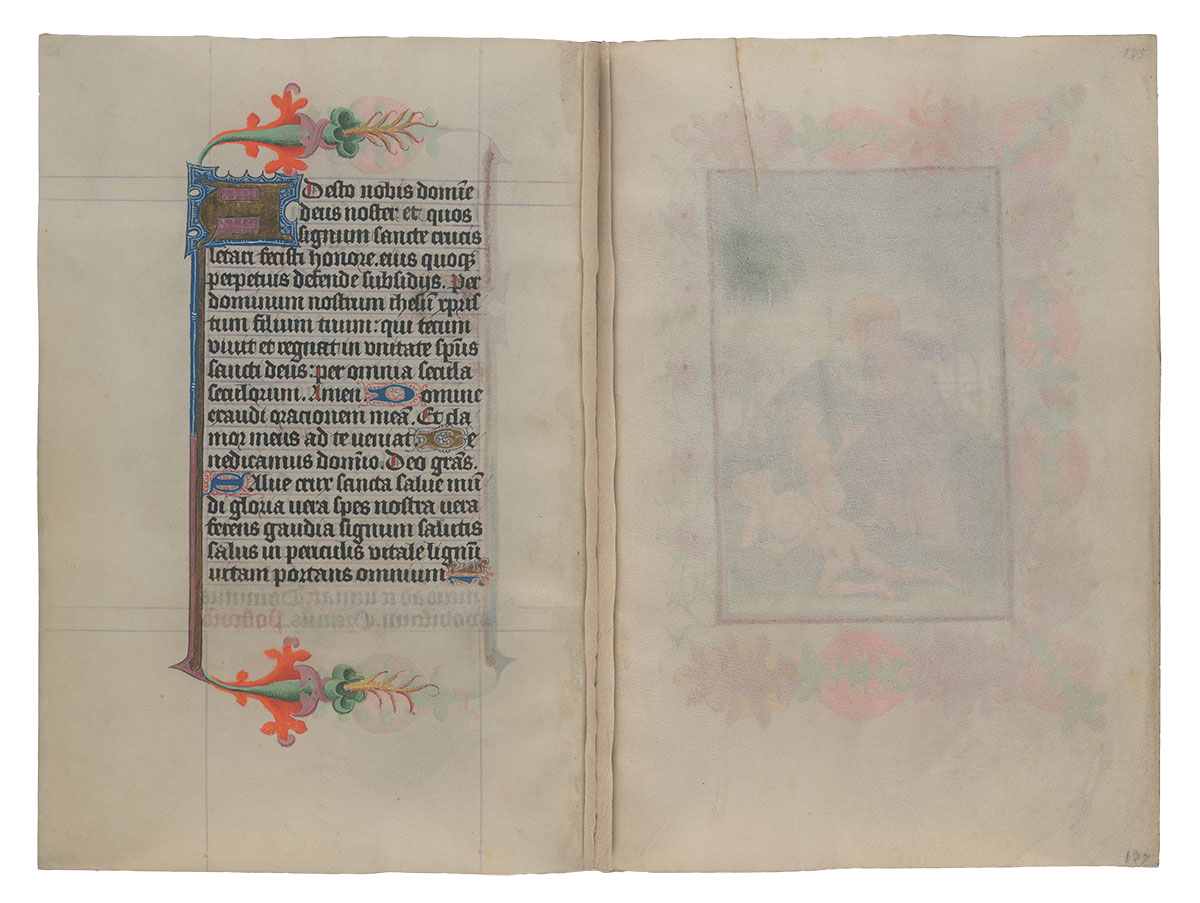
Purchased on the Belle da Costa Greene Fund with the assistance of the Fellows, 1963
Image courtesy of Faksimile Verlag Luzern
MS M.917/945, pp. 138–139
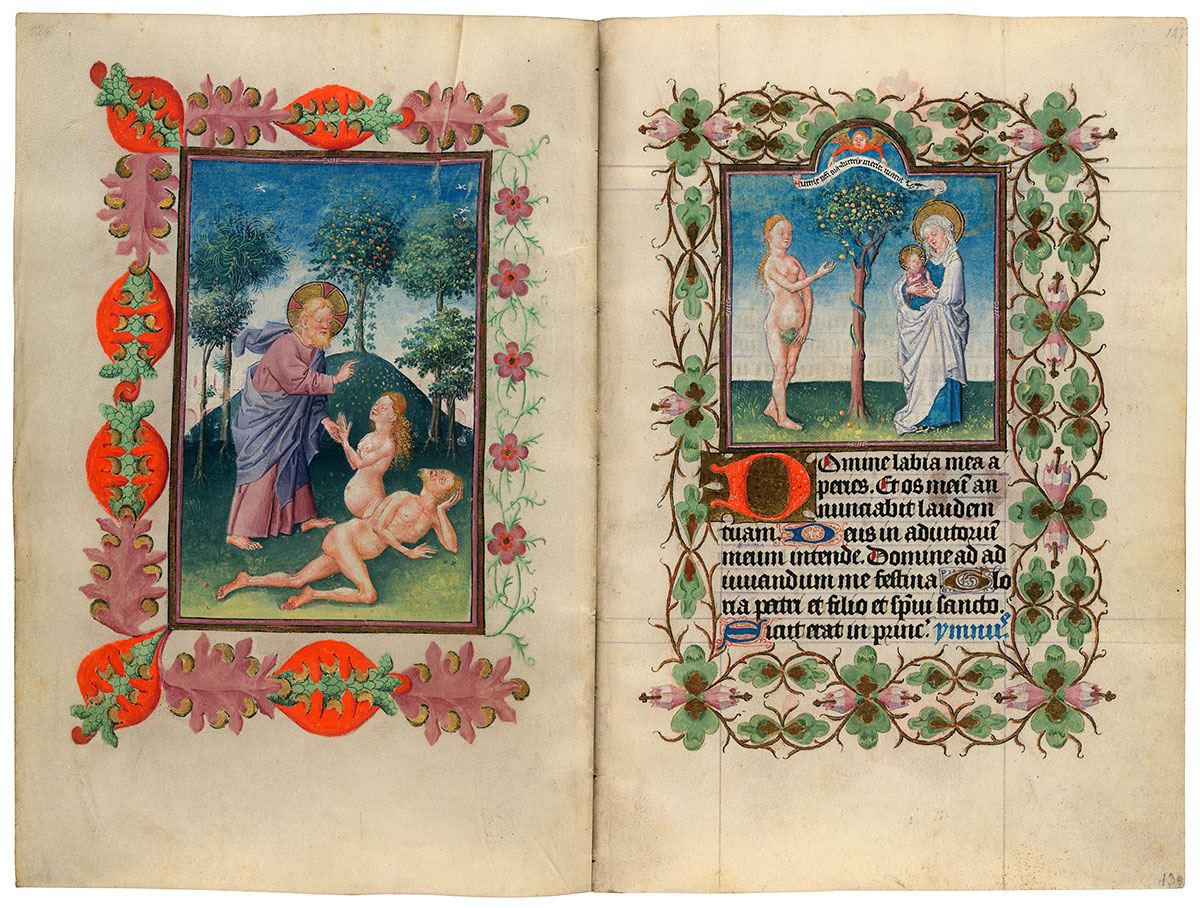
Creation of Eve
Eve and the Virgin
Purchased on the Belle da Costa Greene Fund with the assistance of the Fellows, 1963
The Saturday Hours of the Virgin begin with this full-page miniature of the Creation of Eve. In the verdant Garden of Eden, a blond God pulls an equally blonde Eve from the side of a fair Adam. All is light and bliss. Eve's creation starts the illustrative cycle for the Saturday Hours of the Virgin because she is the mother of sin, and her downfall necessitated the arrival of the "New Eve," that is, the Virgin. Mary will be the mother of Christ, the Savior through whom mankind will be cleansed of the Original Sin of our first forebears.
Hours and Masses for the Seven Days of the Week
The most unusual texts in Catherine's manuscript are the series of Hours and Masses for every day of the week. Medieval Christian tradition associated certain figures or themes with different days. Thus Sunday, the day of the Resurrection, was the Lord's Day; Thursday was connected with the Eucharist since that sacrament was instituted on Holy Thursday; and Monday was the day of the dead, since their torments were suspended on Sunday but recommenced the following day. In Catherine's prayer book, the themes for the Hours and Masses of the seven days of the week are:
| Sunday | the Trinity |
| Monday | the Dead |
| Tuesday | the Holy Spirit |
| Wednesday | All Saints |
| Thursday | the Blessed Sacrament |
| Friday | the Compassion of God |
| Saturday | the Virgin. |
Image courtesy of Faksimile Verlag Luzern
MS M.917/945, pp. 140–147
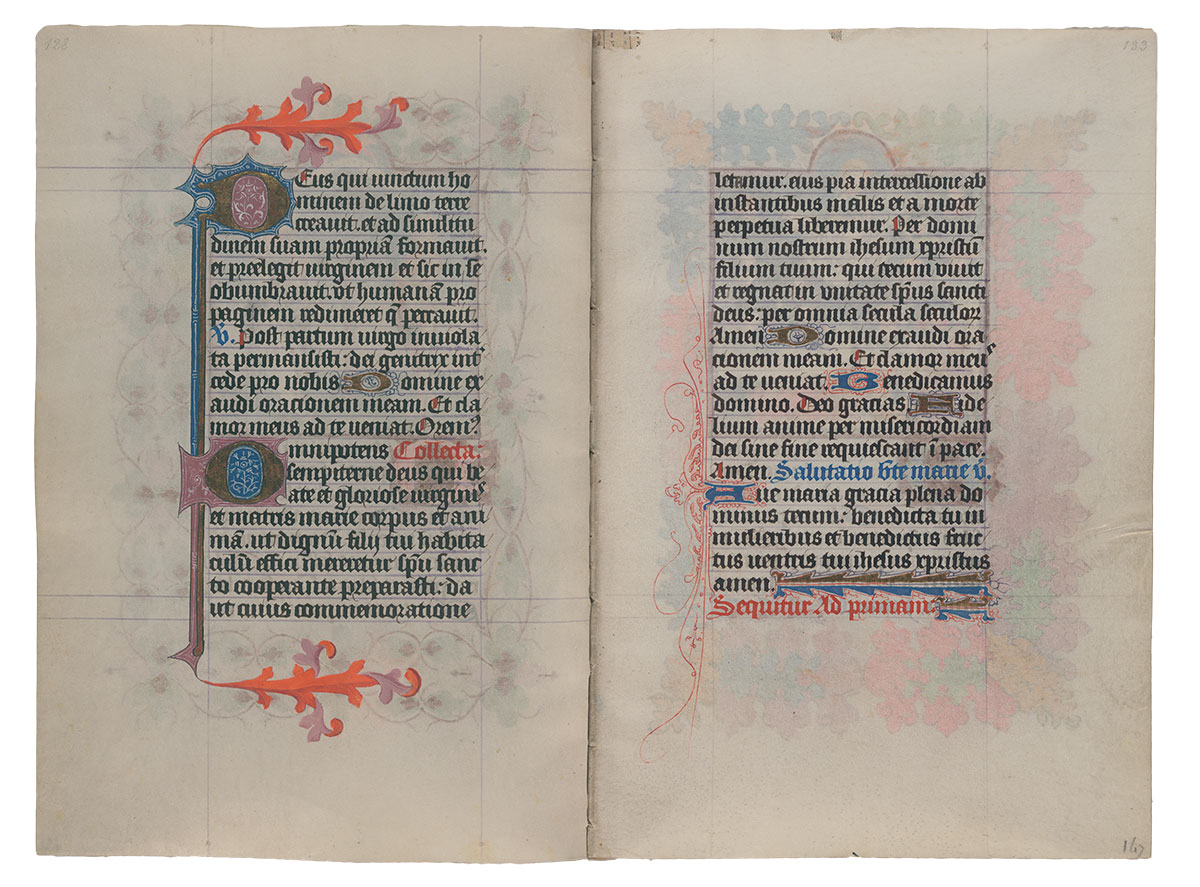
Purchased on the Belle da Costa Greene Fund with the assistance of the Fellows, 1963
Image courtesy of Faksimile Verlag Luzern
MS M.917/945, pp. 148–141
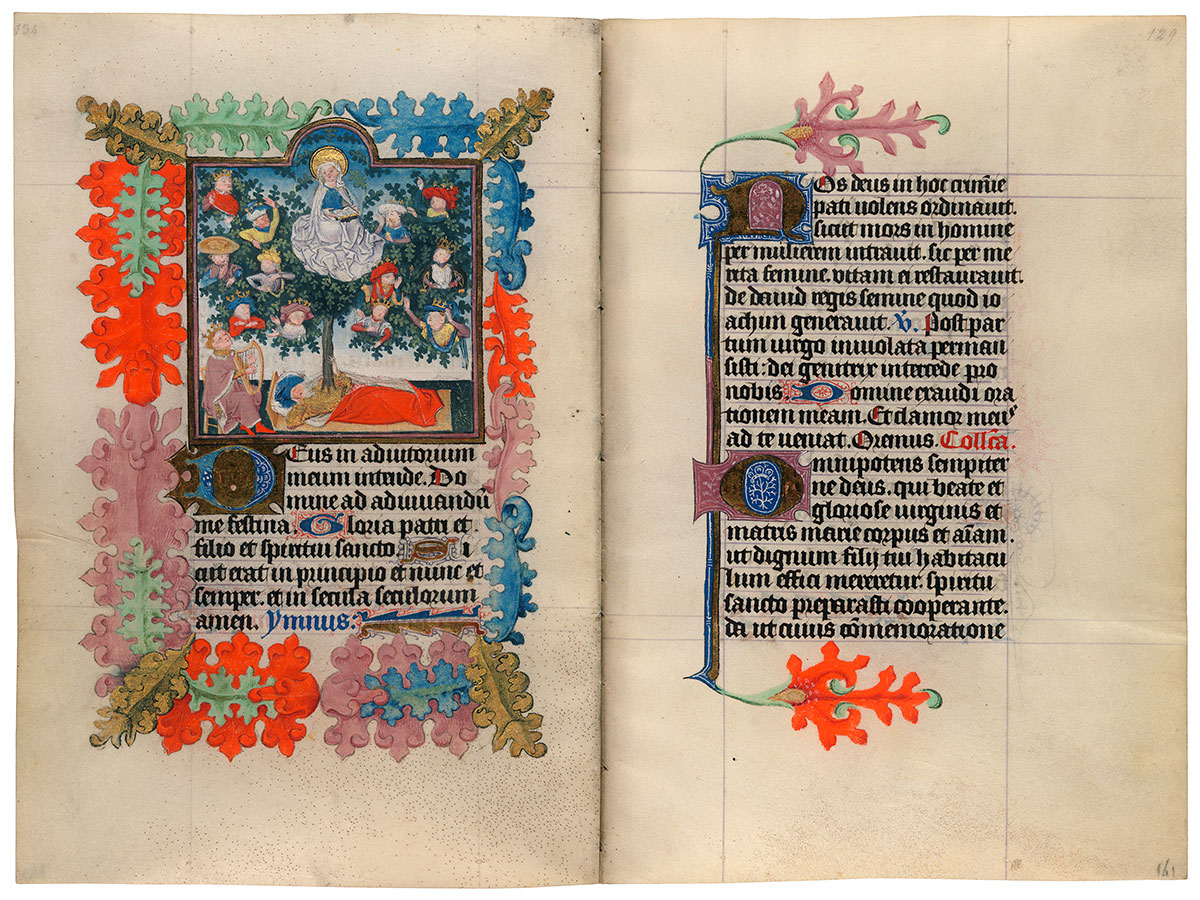
Tree of Jesse
Purchased on the Belle da Costa Greene Fund with the assistance of the Fellows, 1963
Hours and Masses for the Seven Days of the Week
The most unusual texts in Catherine's manuscript are the series of Hours and Masses for every day of the week. Medieval Christian tradition associated certain figures or themes with different days. Thus Sunday, the day of the Resurrection, was the Lord's Day; Thursday was connected with the Eucharist since that sacrament was instituted on Holy Thursday; and Monday was the day of the dead, since their torments were suspended on Sunday but recommenced the following day. In Catherine's prayer book, the themes for the Hours and Masses of the seven days of the week are:
| Sunday | the Trinity |
| Monday | the Dead |
| Tuesday | the Holy Spirit |
| Wednesday | All Saints |
| Thursday | the Blessed Sacrament |
| Friday | the Compassion of God |
| Saturday | the Virgin. |
Image courtesy of Faksimile Verlag Luzern
MS M.917/945, pp. 142–145
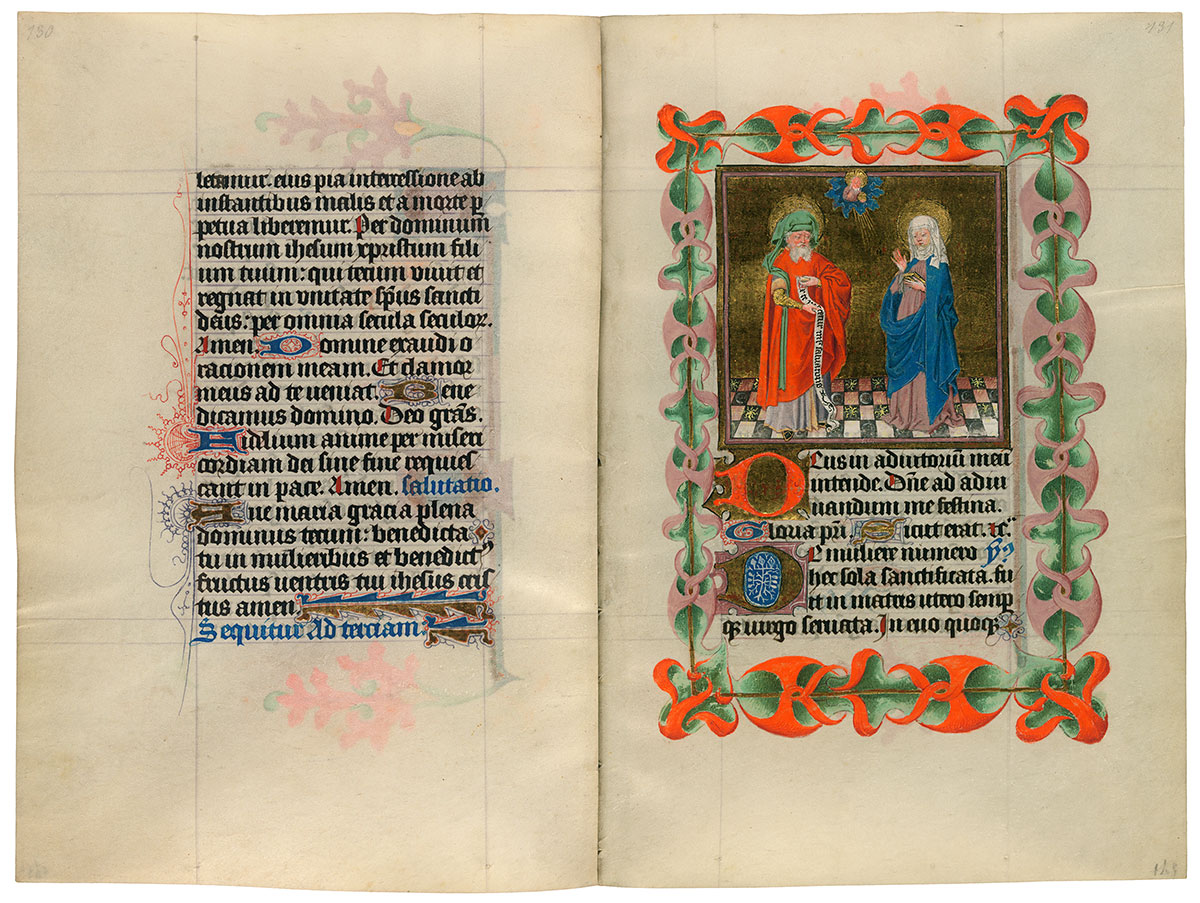
Joachim and Anne
Purchased on the Belle da Costa Greene Fund with the assistance of the Fellows, 1963
Hours and Masses for the Seven Days of the Week
The most unusual texts in Catherine's manuscript are the series of Hours and Masses for every day of the week. Medieval Christian tradition associated certain figures or themes with different days. Thus Sunday, the day of the Resurrection, was the Lord's Day; Thursday was connected with the Eucharist since that sacrament was instituted on Holy Thursday; and Monday was the day of the dead, since their torments were suspended on Sunday but recommenced the following day. In Catherine's prayer book, the themes for the Hours and Masses of the seven days of the week are:
| Sunday | the Trinity |
| Monday | the Dead |
| Tuesday | the Holy Spirit |
| Wednesday | All Saints |
| Thursday | the Blessed Sacrament |
| Friday | the Compassion of God |
| Saturday | the Virgin. |
Image courtesy of Faksimile Verlag Luzern
MS M.917/945, pp. 146–149
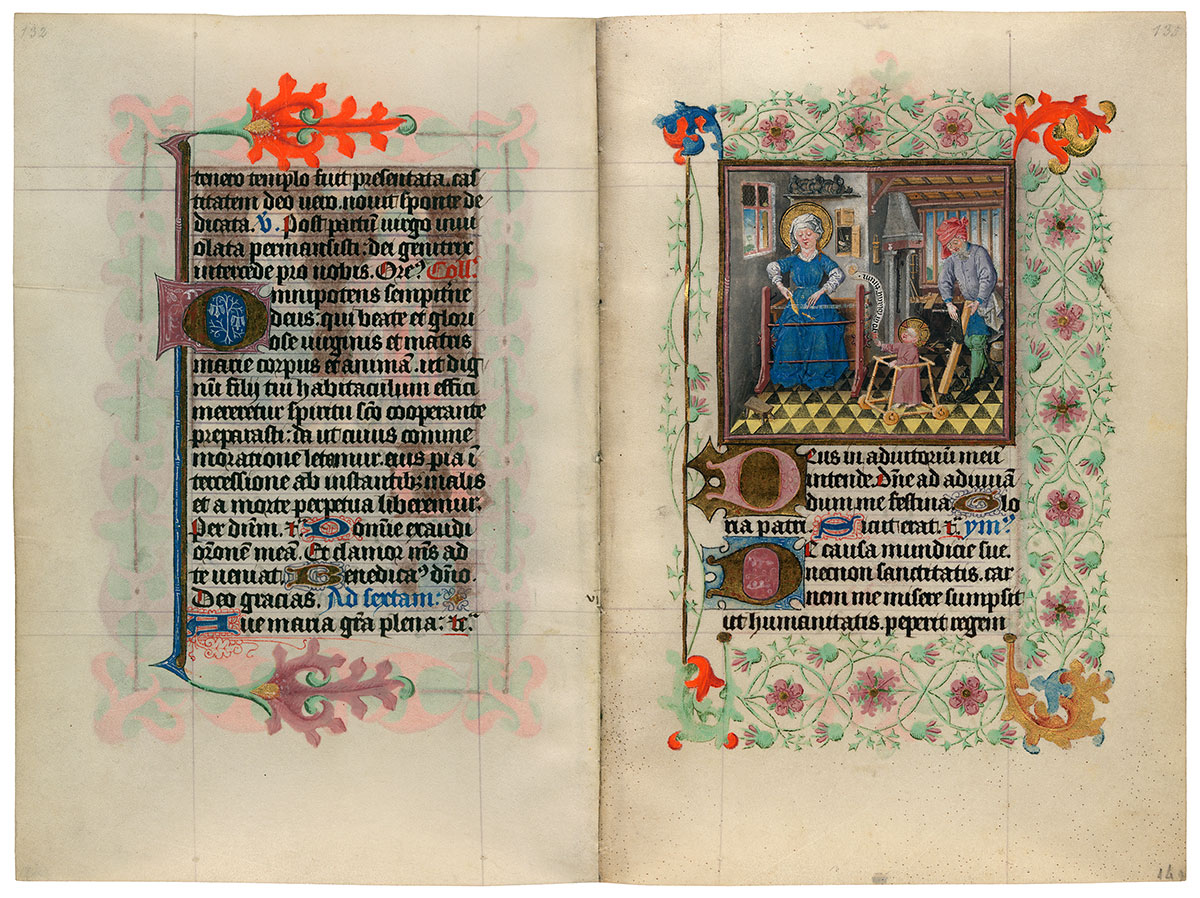
Holy Family at Work
Purchased on the Belle da Costa Greene Fund with the assistance of the Fellows, 1963
This charming scene is easily the most cherished of all the miniatures from Catherine's prayer book. Within a domestic interior scattered with tools and utensils, the Virgin weaves, baby Jesus takes his first steps in a walker, and Joseph planes a board. The wood resembles the beam of a cross and thus alludes to Christ's forthcoming death. But for now the child offers consolation: "I am your solace" is written on the scroll Christ unfurls to his mother.
Hours and Masses for the Seven Days of the Week
The most unusual texts in Catherine's manuscript are the series of Hours and Masses for every day of the week. Medieval Christian tradition associated certain figures or themes with different days. Thus Sunday, the day of the Resurrection, was the Lord's Day; Thursday was connected with the Eucharist since that sacrament was instituted on Holy Thursday; and Monday was the day of the dead, since their torments were suspended on Sunday but recommenced the following day. In Catherine's prayer book, the themes for the Hours and Masses of the seven days of the week are:
| Sunday | the Trinity |
| Monday | the Dead |
| Tuesday | the Holy Spirit |
| Wednesday | All Saints |
| Thursday | the Blessed Sacrament |
| Friday | the Compassion of God |
| Saturday | the Virgin. |
Image courtesy of Faksimile Verlag Luzern
MS M.917/945, pp. 150–151
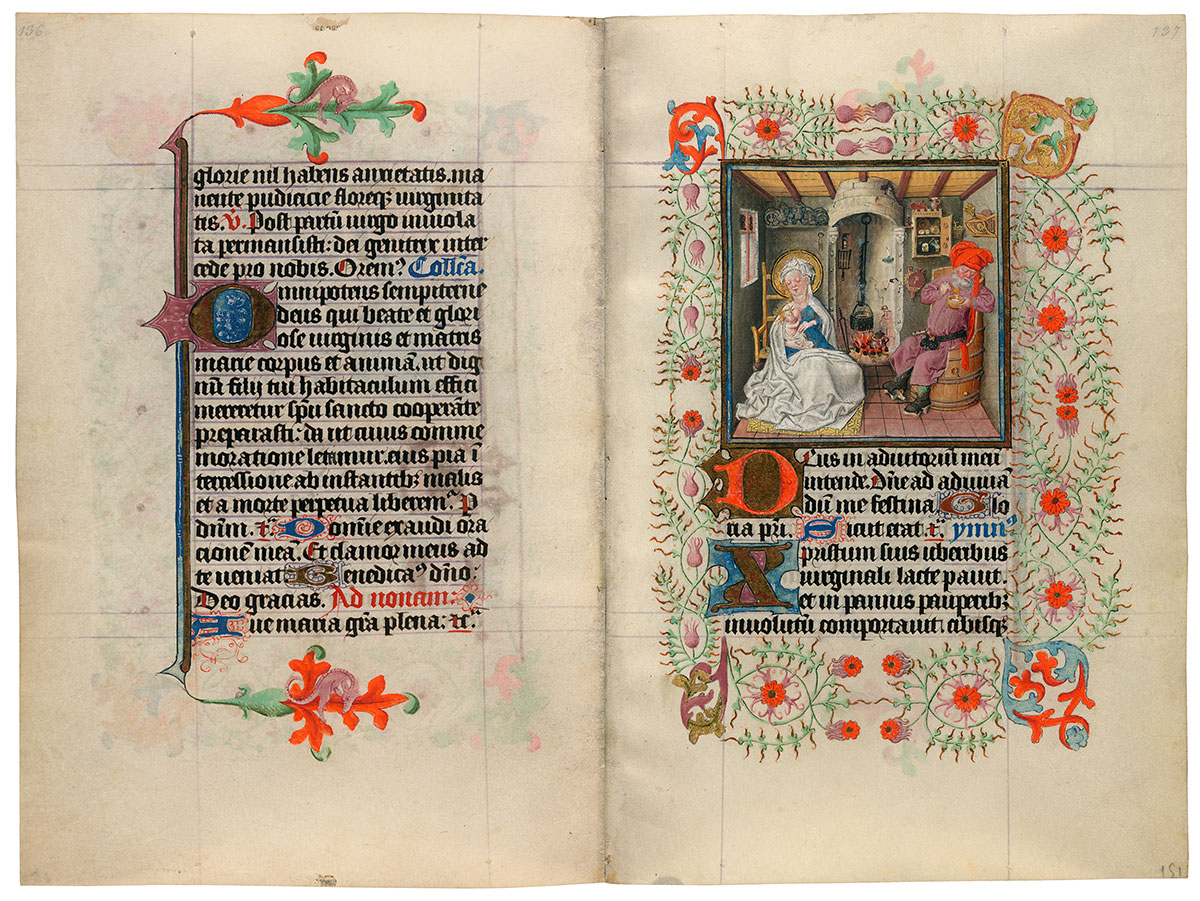
Holy Family at Supper
Purchased on the Belle da Costa Greene Fund with the assistance of the Fellows, 1963
Nearly as delightful as the previous miniature is this one showing the Holy Family taking sustenance. Humbly seated on the floor, Mary, as the Virgo lactans, gives suck to the Christ Child. Joseph spoons his supper while seated in a barrel chair. The background is filled with an abundance of home furnishings: a shelf of pewter plates, a pair of shears, a bellows, a wood cabinet with food and dishes, and a rack of utensils. The cylindrical fireplace contains steaming pots, tongs, and a grill. Note the delicacy with which the Cleves Master rendered the wisps of smoke.
Hours and Masses for the Seven Days of the Week
The most unusual texts in Catherine's manuscript are the series of Hours and Masses for every day of the week. Medieval Christian tradition associated certain figures or themes with different days. Thus Sunday, the day of the Resurrection, was the Lord's Day; Thursday was connected with the Eucharist since that sacrament was instituted on Holy Thursday; and Monday was the day of the dead, since their torments were suspended on Sunday but recommenced the following day. In Catherine's prayer book, the themes for the Hours and Masses of the seven days of the week are:
| Sunday | the Trinity |
| Monday | the Dead |
| Tuesday | the Holy Spirit |
| Wednesday | All Saints |
| Thursday | the Blessed Sacrament |
| Friday | the Compassion of God |
| Saturday | the Virgin. |
Image courtesy of Faksimile Verlag Luzern
MS M.917/945, pp. 152–153
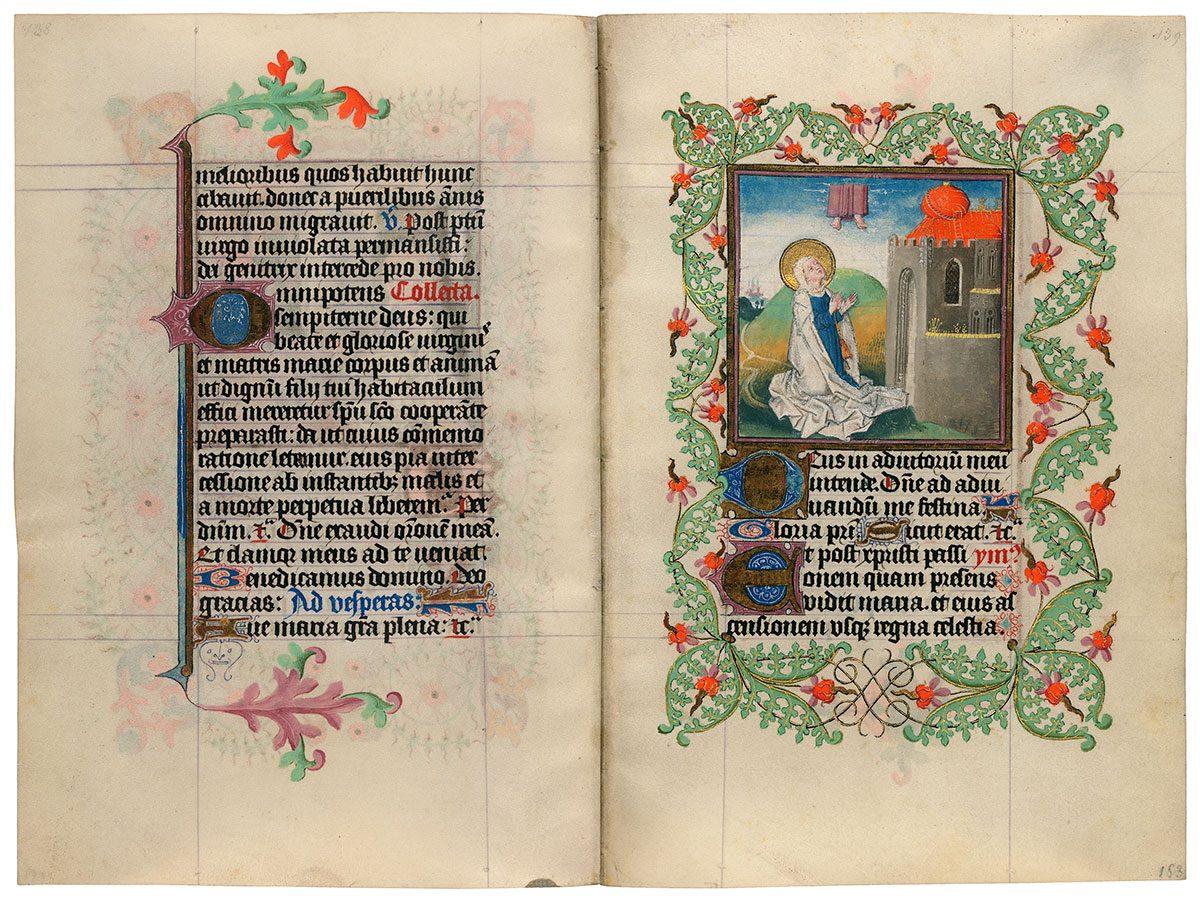
The Virgin Witnessing Christ’s Ascension
Purchased on the Belle da Costa Greene Fund with the assistance of the Fellows, 1963
In general, the Saturday Hours of the Virgin emphasize the joyful or momentous events of Mary's life. After Christ's Crucifixion, the Virgin was consoled when he reappeared to her following the Resurrection. The Ascension marks the end of Christ's time on earth. In the miniature, Mary alone (she is usually joined by the apostles) is witness to her son's disappearance into the clouds, his reentry into heaven.
Hours and Masses for the Seven Days of the Week
The most unusual texts in Catherine's manuscript are the series of Hours and Masses for every day of the week. Medieval Christian tradition associated certain figures or themes with different days. Thus Sunday, the day of the Resurrection, was the Lord's Day; Thursday was connected with the Eucharist since that sacrament was instituted on Holy Thursday; and Monday was the day of the dead, since their torments were suspended on Sunday but recommenced the following day. In Catherine's prayer book, the themes for the Hours and Masses of the seven days of the week are:
| Sunday | the Trinity |
| Monday | the Dead |
| Tuesday | the Holy Spirit |
| Wednesday | All Saints |
| Thursday | the Blessed Sacrament |
| Friday | the Compassion of God |
| Saturday | the Virgin. |
Image courtesy of Faksimile Verlag Luzern
MS M.917/945, pp. 154–157
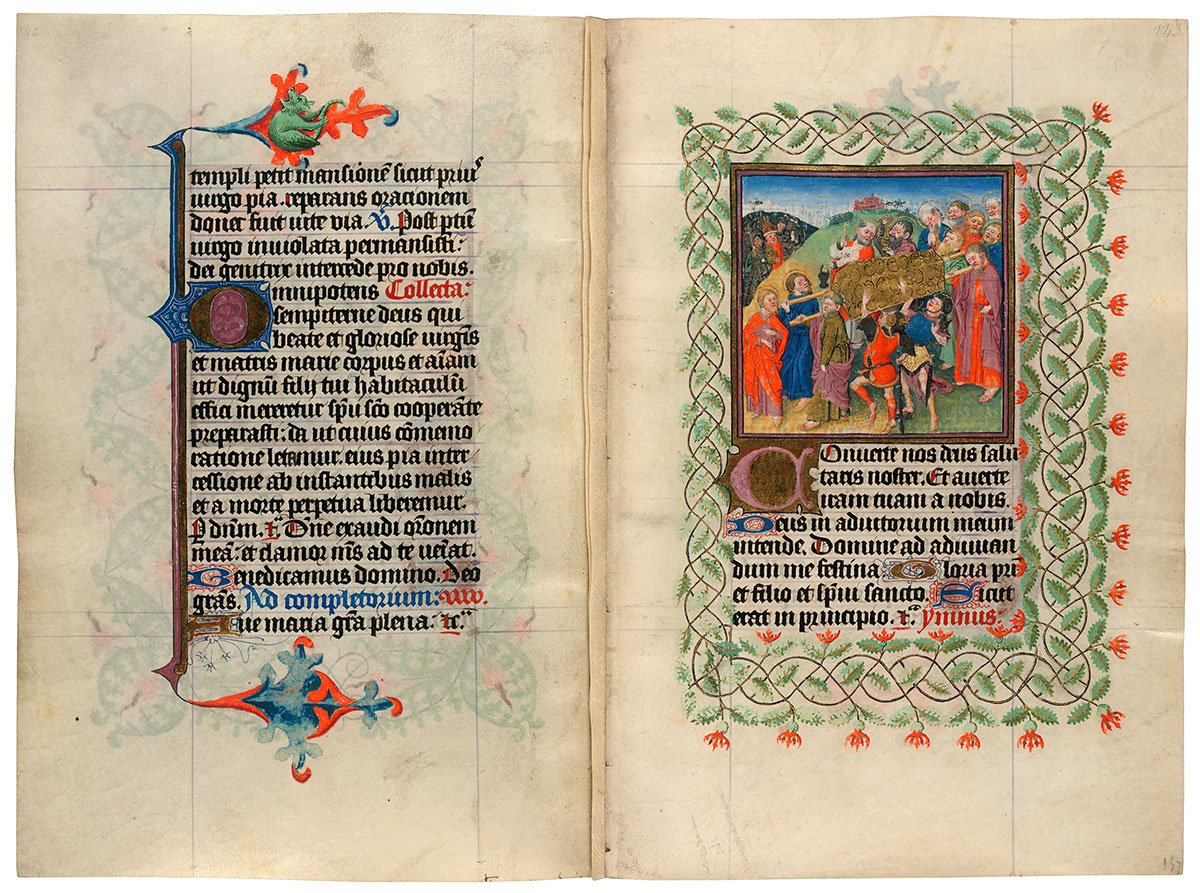
Funeral Procession of the Virgin
Purchased on the Belle da Costa Greene Fund with the assistance of the Fellows, 1963
The Virgin's funeral cortege consists of the twelve apostles. John, with a palm, leads the way; Peter sprinkles the cloth-covered coffin with holy water; and Paul censes it. At the left, the priest Jephonias hides behind a hillock with a group of soldiers. Two other soldiers have tried to stop the procession by toppling the coffin, but their hands miraculously stick to it; indeed, the hand of one soldier is severed from his wrist.
Hours and Masses for the Seven Days of the Week
The most unusual texts in Catherine's manuscript are the series of Hours and Masses for every day of the week. Medieval Christian tradition associated certain figures or themes with different days. Thus Sunday, the day of the Resurrection, was the Lord's Day; Thursday was connected with the Eucharist since that sacrament was instituted on Holy Thursday; and Monday was the day of the dead, since their torments were suspended on Sunday but recommenced the following day. In Catherine's prayer book, the themes for the Hours and Masses of the seven days of the week are:
| Sunday | the Trinity |
| Monday | the Dead |
| Tuesday | the Holy Spirit |
| Wednesday | All Saints |
| Thursday | the Blessed Sacrament |
| Friday | the Compassion of God |
| Saturday | the Virgin. |
Image courtesy of Faksimile Verlag Luzern
MS M.917/945, pp. 158–159
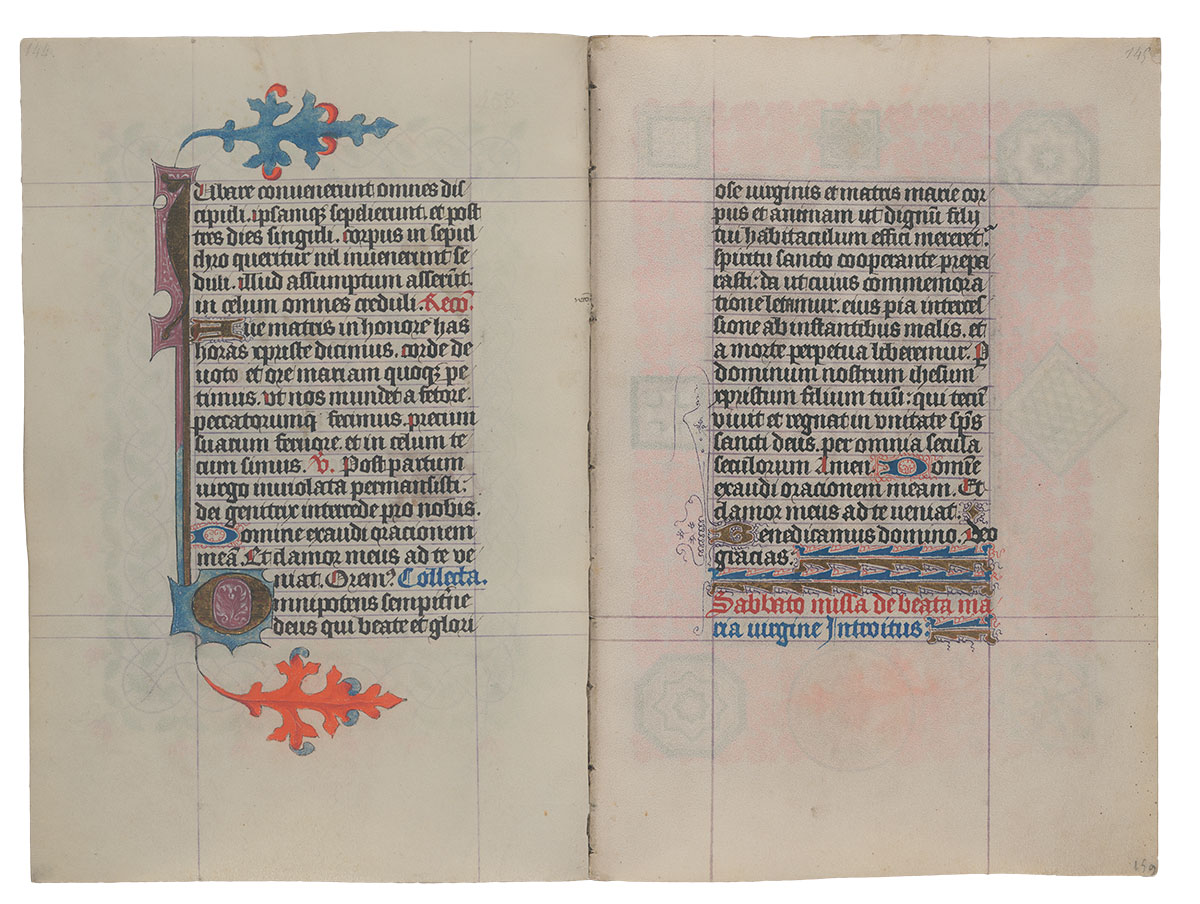
Purchased on the Belle da Costa Greene Fund with the assistance of the Fellows, 1963
Image courtesy of Faksimile Verlag Luzern
MS M.917/945, pp. 160–161
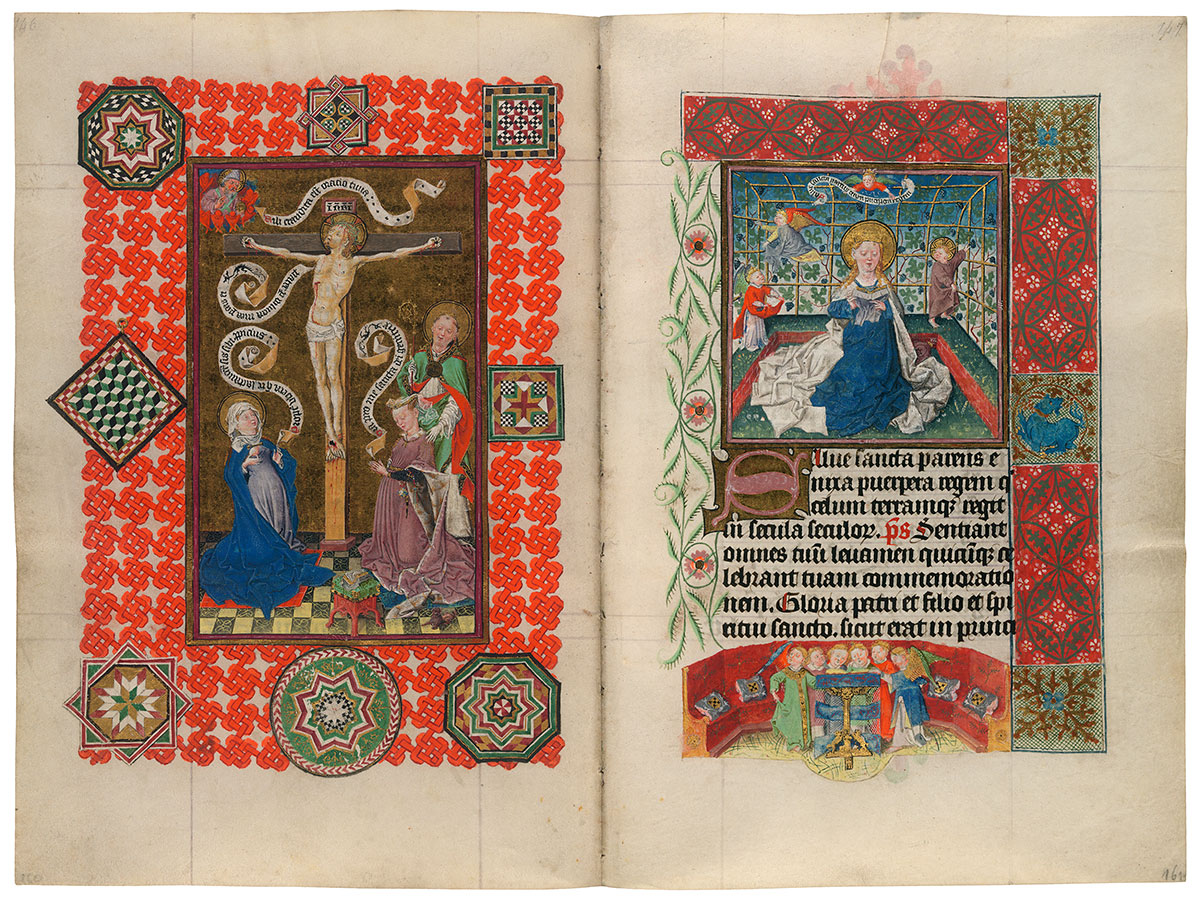
The Virgin and the Crucified Christ Intercede for Catherine of Cleves
Virgin and Child in a Grape Arbor
Purchased on the Belle da Costa Greene Fund with the assistance of the Fellows, 1963
The large miniature that opens the Saturday Mass of the Virgin contains the third portrait of Catherine, kneeling at right. A saint (Leonard?) is behind her, and her humble demeanor contrasts with the intercession she is seeking. Her scroll petitions Mary to pray for her. The Virgin, bearing a breast, entreats her crucified Son to be kind to Catherine for the sake of the mother who nursed him. Christ takes time out from his death and asks, in the name of his wounds, that his Father spare the duchess. God responds, "Your prayer has been answered." The smaller miniature shows Mary quietly reading while angels babysit the Christ Child. More angels chant in the bottom border.
Hours and Masses for the Seven Days of the Week
The most unusual texts in Catherine's manuscript are the series of Hours and Masses for every day of the week. Medieval Christian tradition associated certain figures or themes with different days. Thus Sunday, the day of the Resurrection, was the Lord's Day; Thursday was connected with the Eucharist since that sacrament was instituted on Holy Thursday; and Monday was the day of the dead, since their torments were suspended on Sunday but recommenced the following day. In Catherine's prayer book, the themes for the Hours and Masses of the seven days of the week are:
| Sunday | the Trinity |
| Monday | the Dead |
| Tuesday | the Holy Spirit |
| Wednesday | All Saints |
| Thursday | the Blessed Sacrament |
| Friday | the Compassion of God |
| Saturday | the Virgin. |
Image courtesy of Faksimile Verlag Luzern
MS M.917/945, pp. 162–163
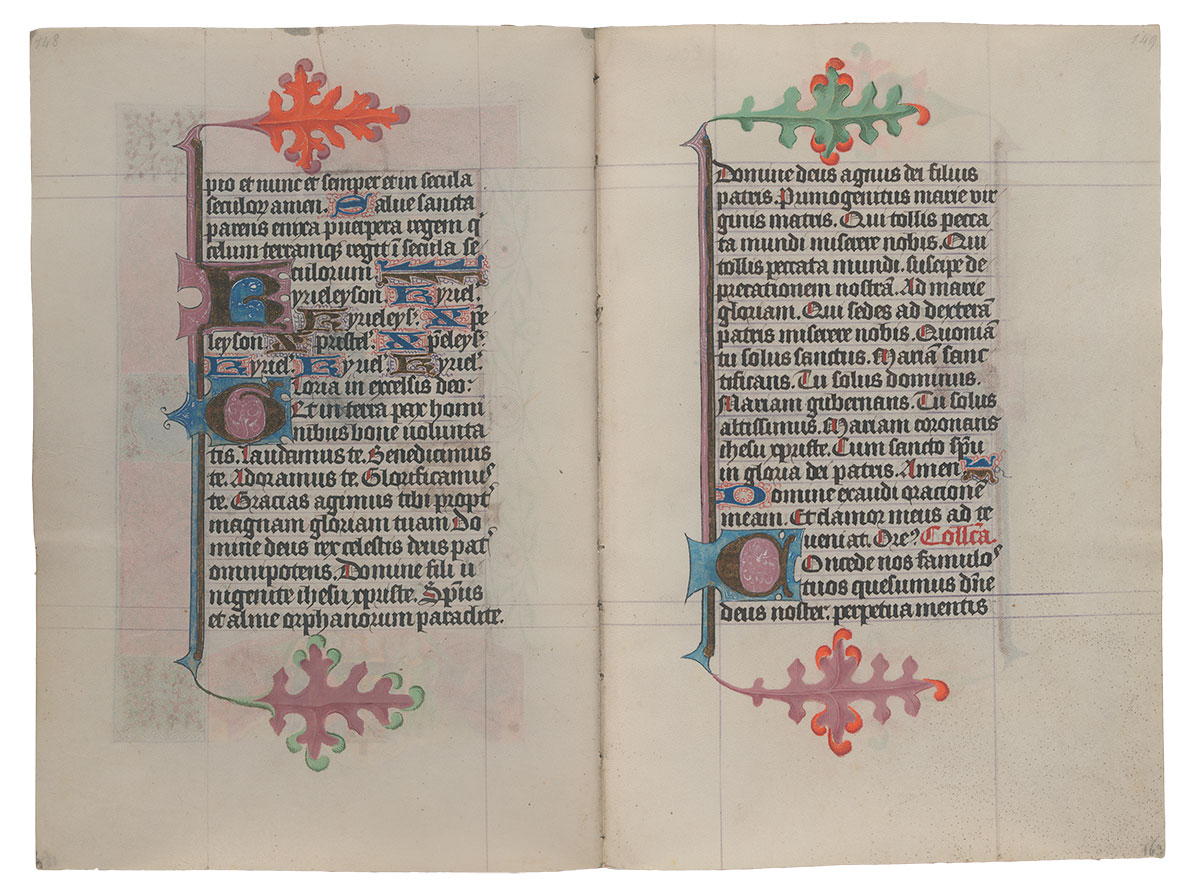
Purchased on the Belle da Costa Greene Fund with the assistance of the Fellows, 1963
Image courtesy of Faksimile Verlag Luzern
MS M.917/945, pp. 164–165
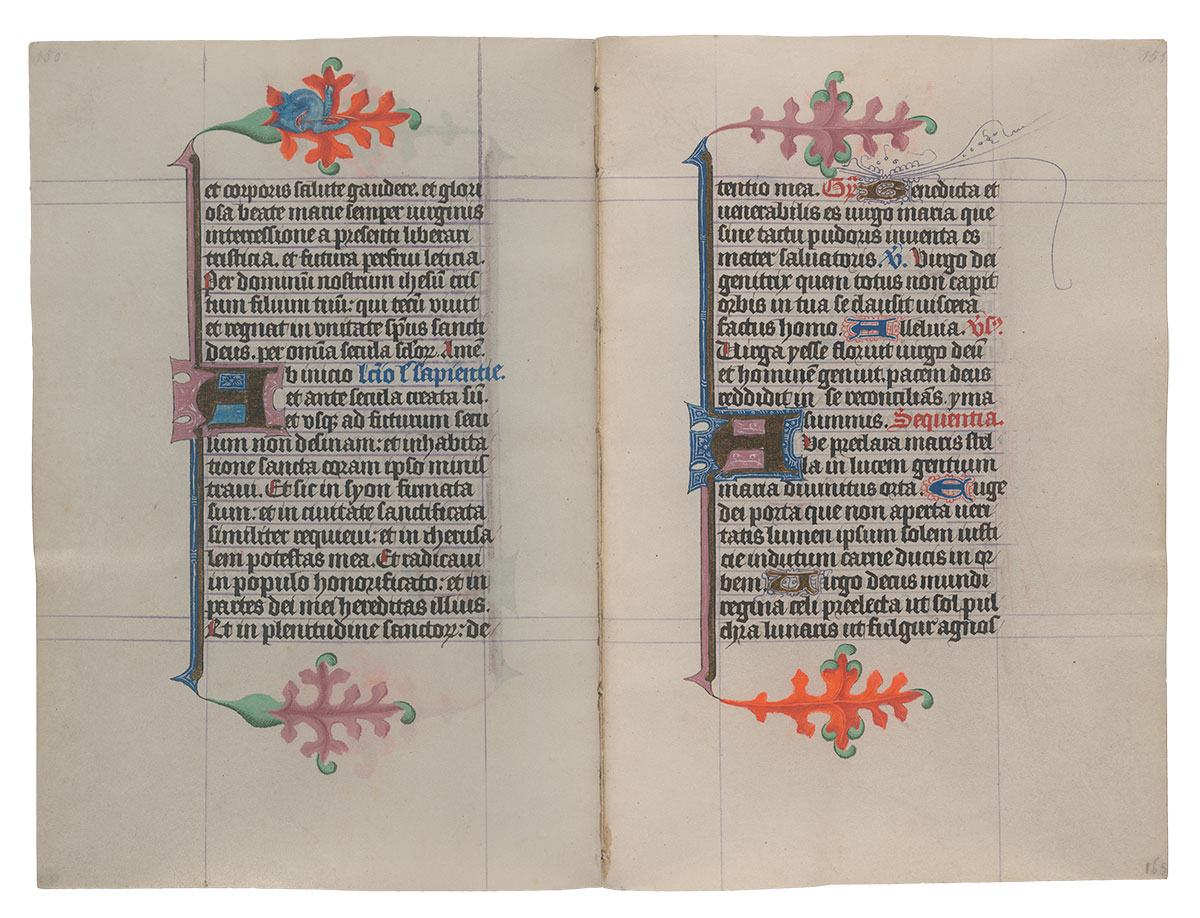
Purchased on the Belle da Costa Greene Fund with the assistance of the Fellows, 1963
Image courtesy of Faksimile Verlag Luzern
MS M.917/945, pp. 166–167
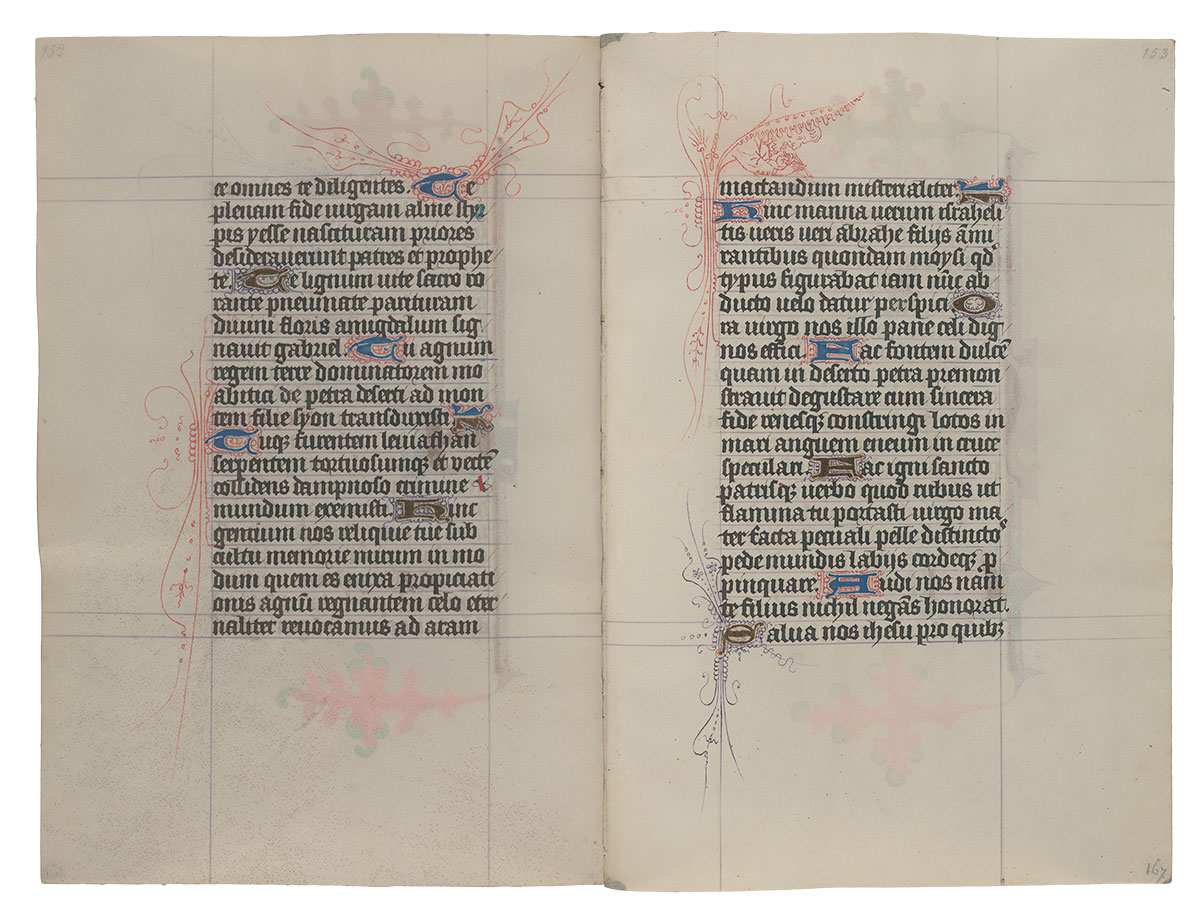
Purchased on the Belle da Costa Greene Fund with the assistance of the Fellows, 1963
Image courtesy of Faksimile Verlag Luzern
MS M.917/945, pp. 168–169
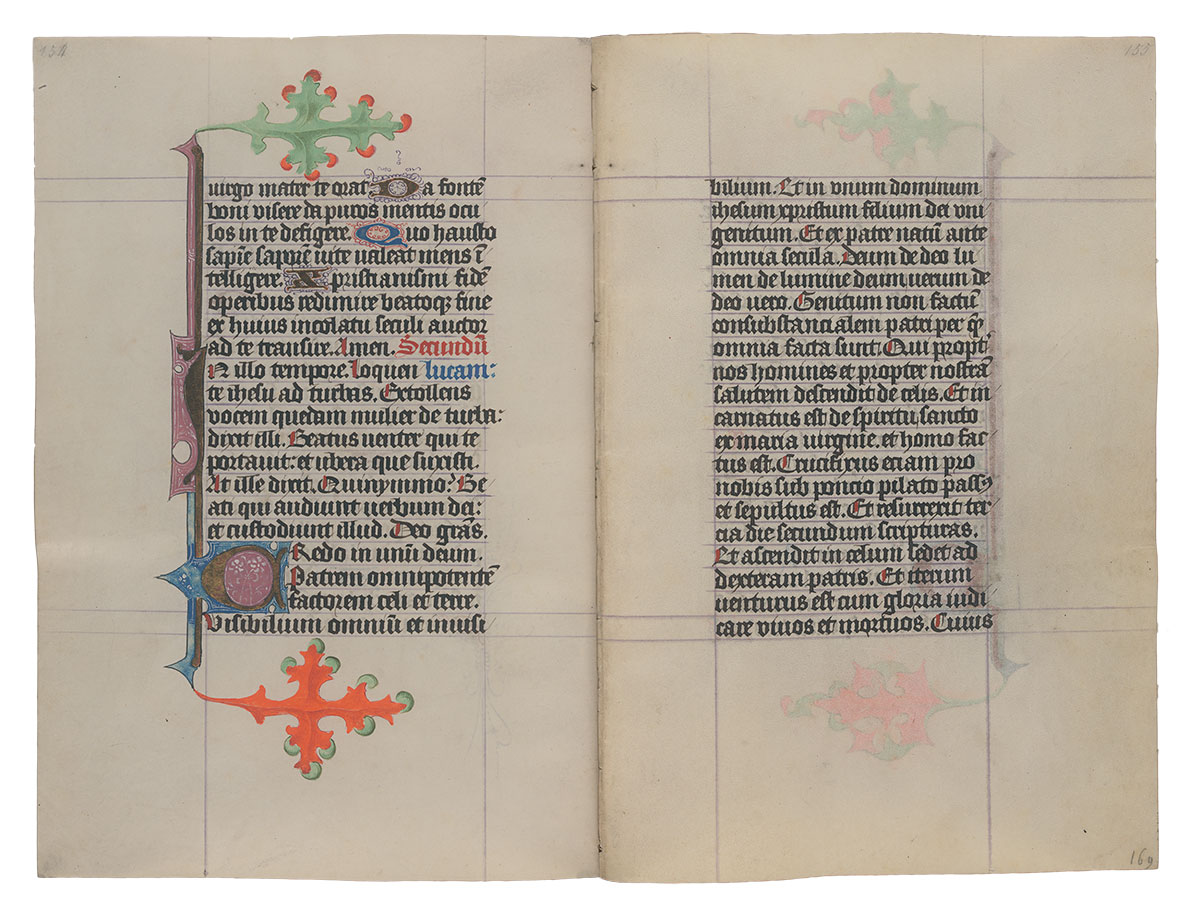
Purchased on the Belle da Costa Greene Fund with the assistance of the Fellows, 1963
Image courtesy of Faksimile Verlag Luzern
MS M.917/945, pp. 170–171
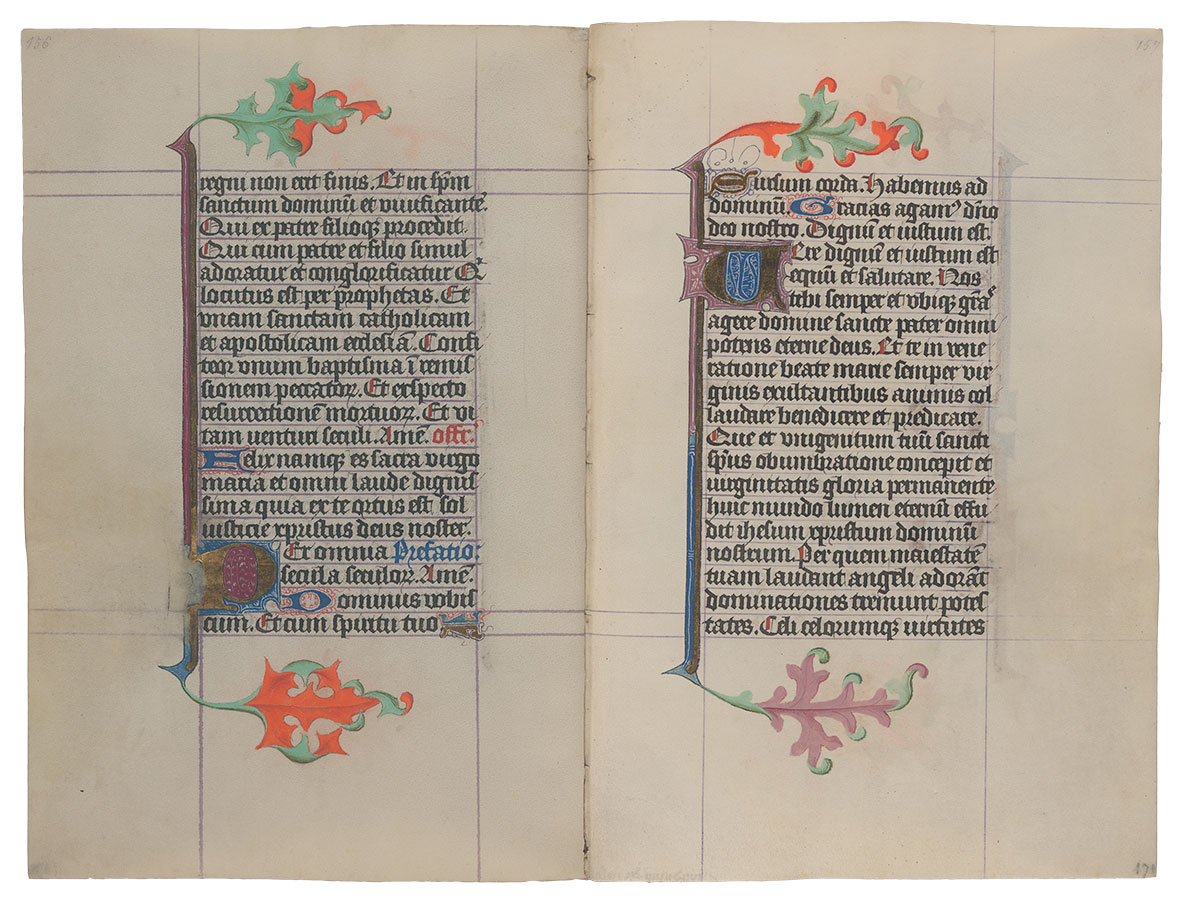
Purchased on the Belle da Costa Greene Fund with the assistance of the Fellows, 1963
Image courtesy of Faksimile Verlag Luzern
MS M.917/945, pp. 172–173
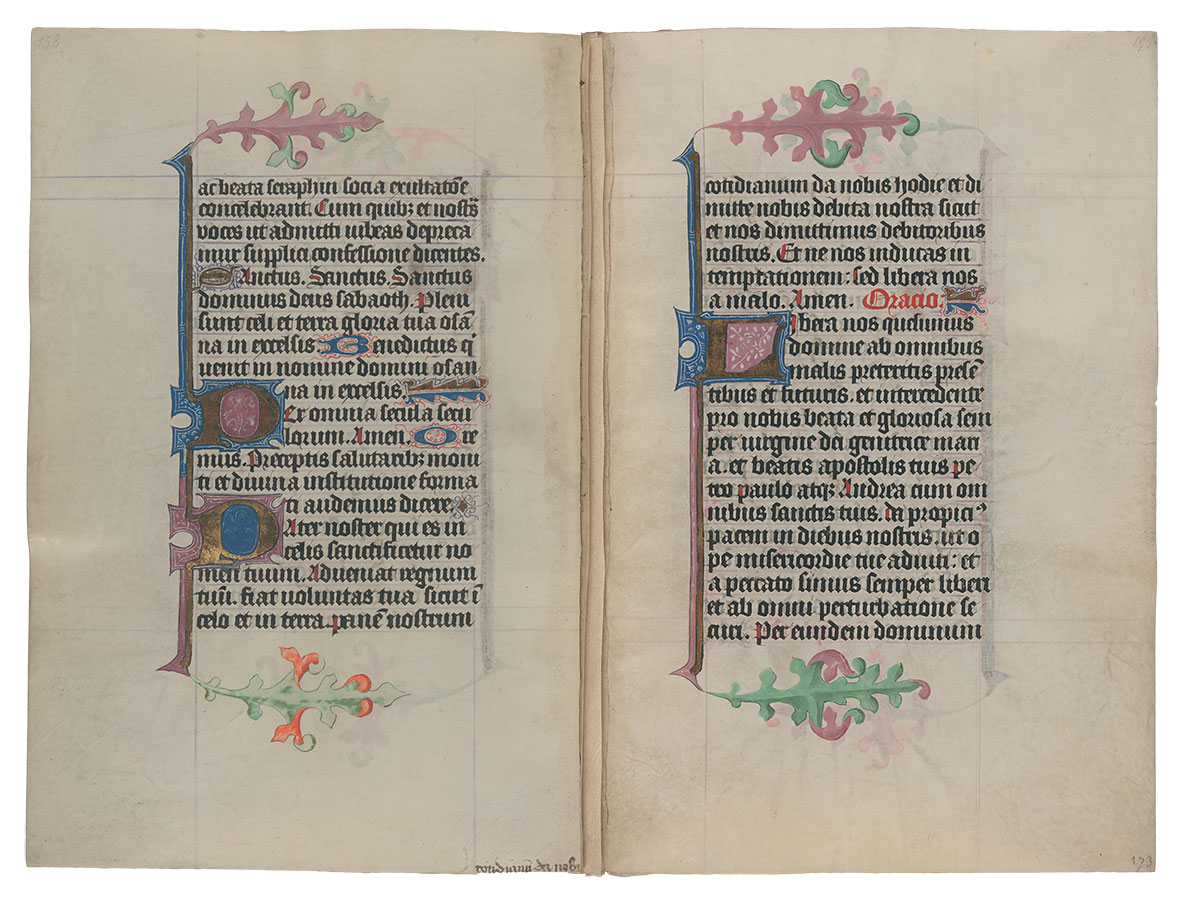
Purchased on the Belle da Costa Greene Fund with the assistance of the Fellows, 1963
Image courtesy of Faksimile Verlag Luzern
MS M.917/945, pp. 174–175
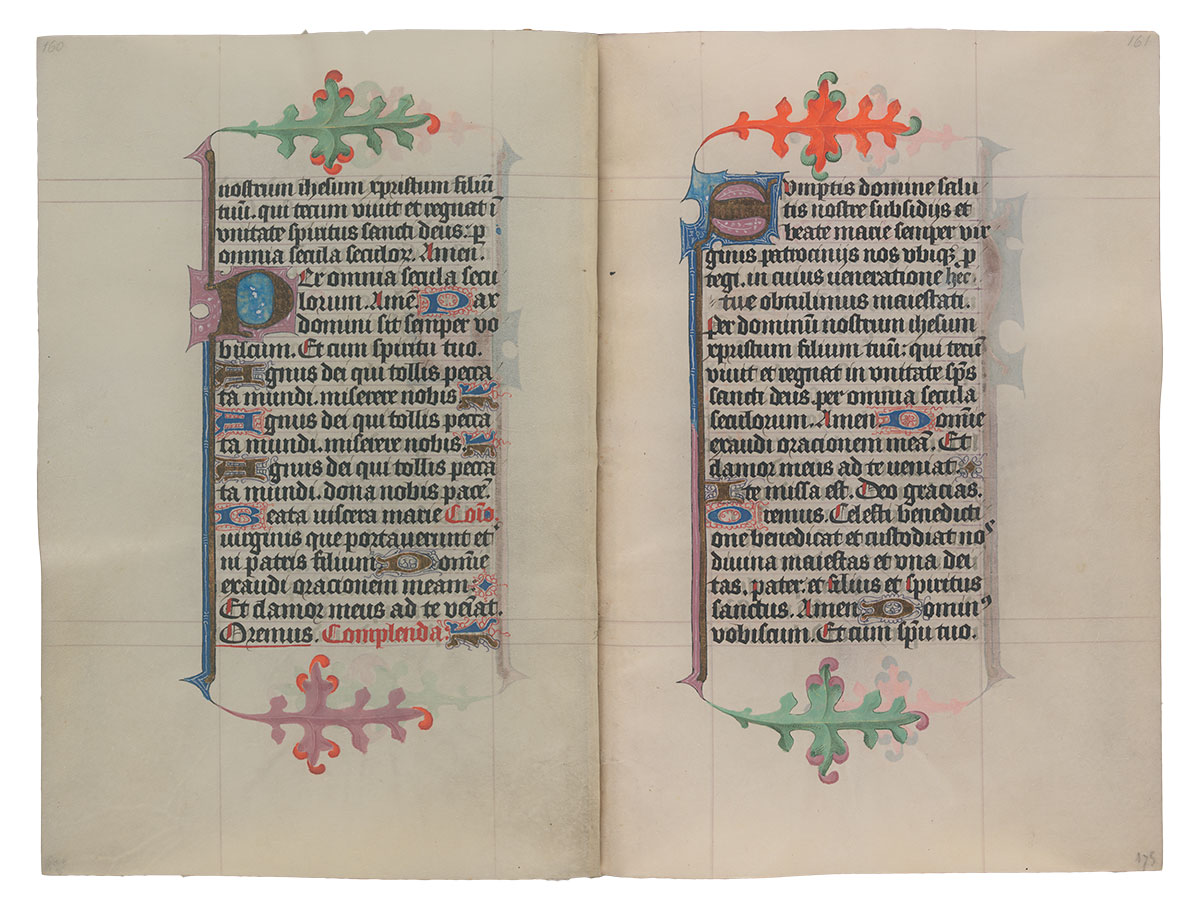
Purchased on the Belle da Costa Greene Fund with the assistance of the Fellows, 1963
Image courtesy of Faksimile Verlag Luzern
MS M.917/945, pp. 176–177
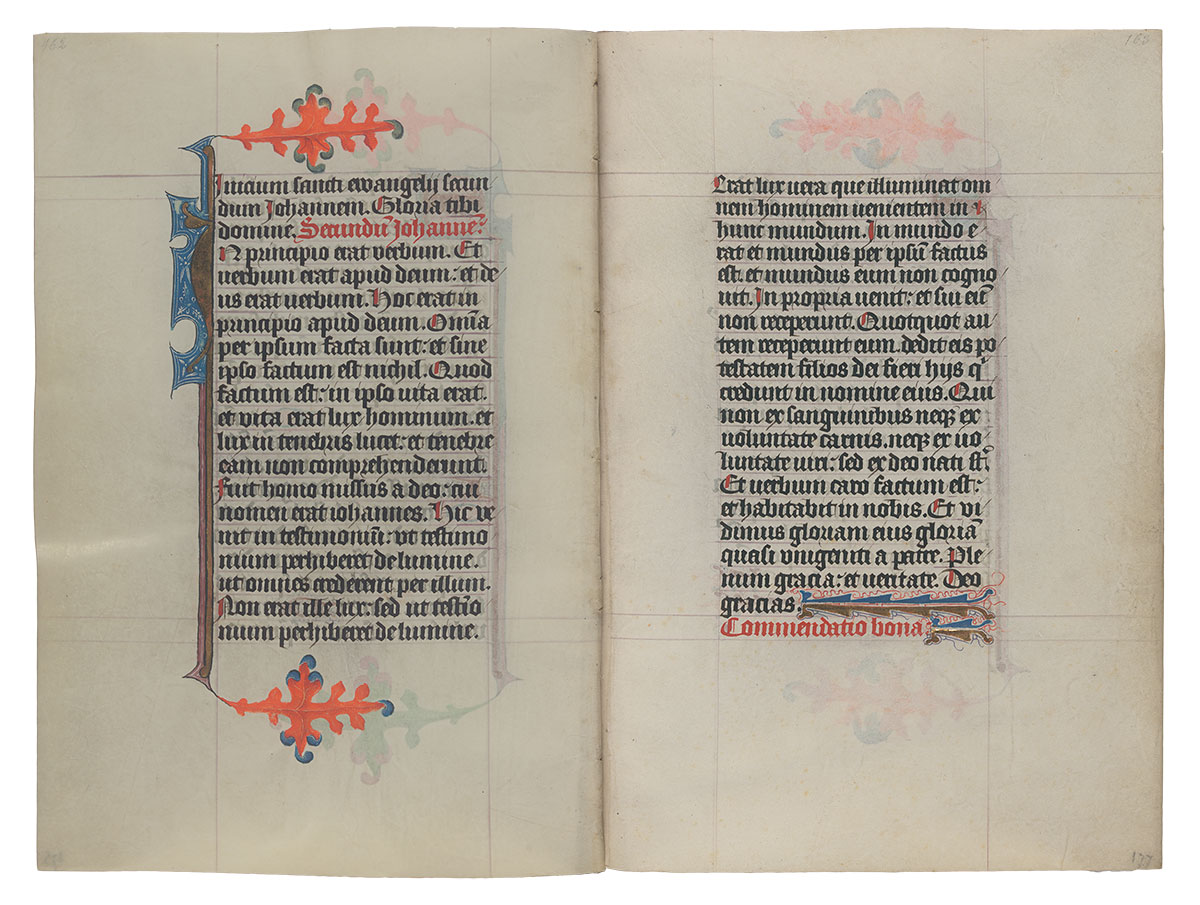
Purchased on the Belle da Costa Greene Fund with the assistance of the Fellows, 1963
Image courtesy of Faksimile Verlag Luzern
MS M.917/945, pp. 178–27
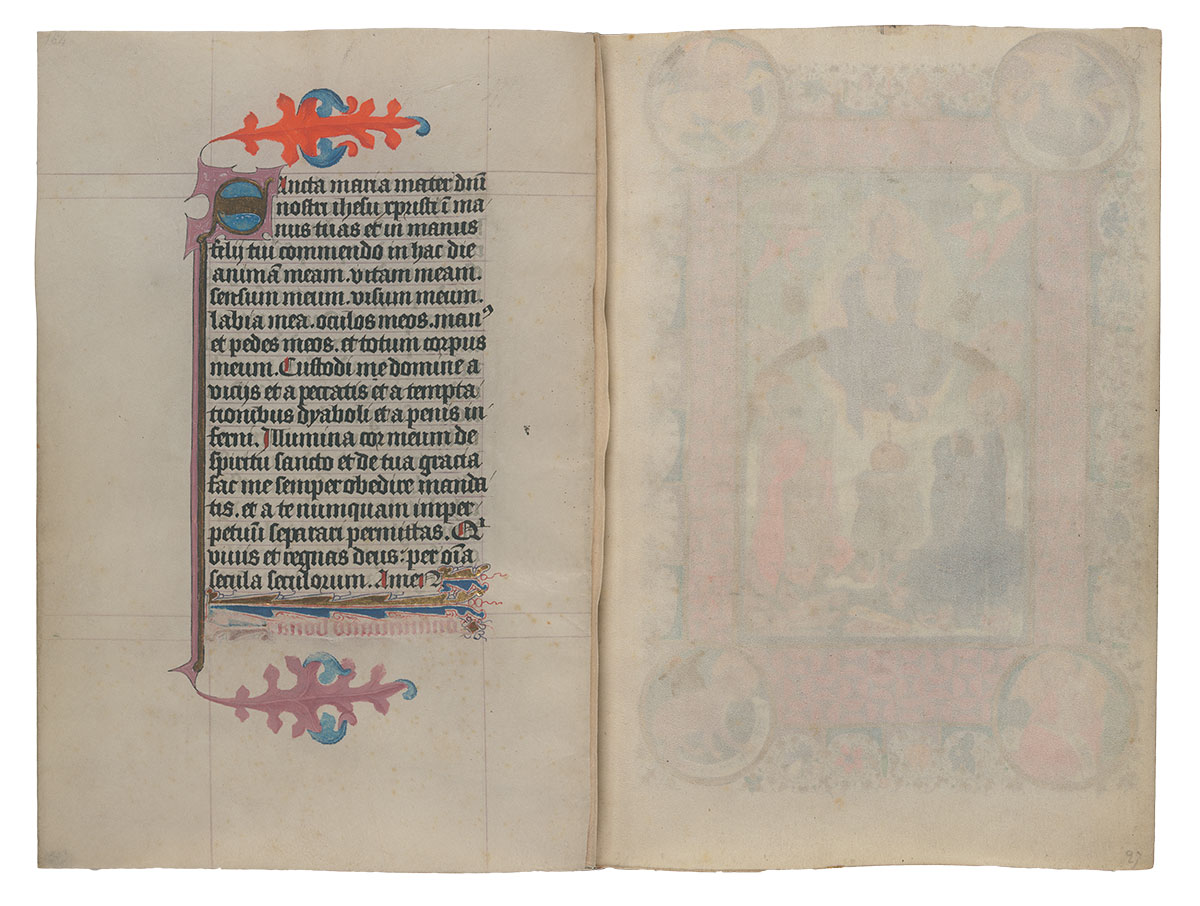
Purchased on the Belle da Costa Greene Fund with the assistance of the Fellows, 1963
Image courtesy of Faksimile Verlag Luzern
Penitential Psalms and Litany
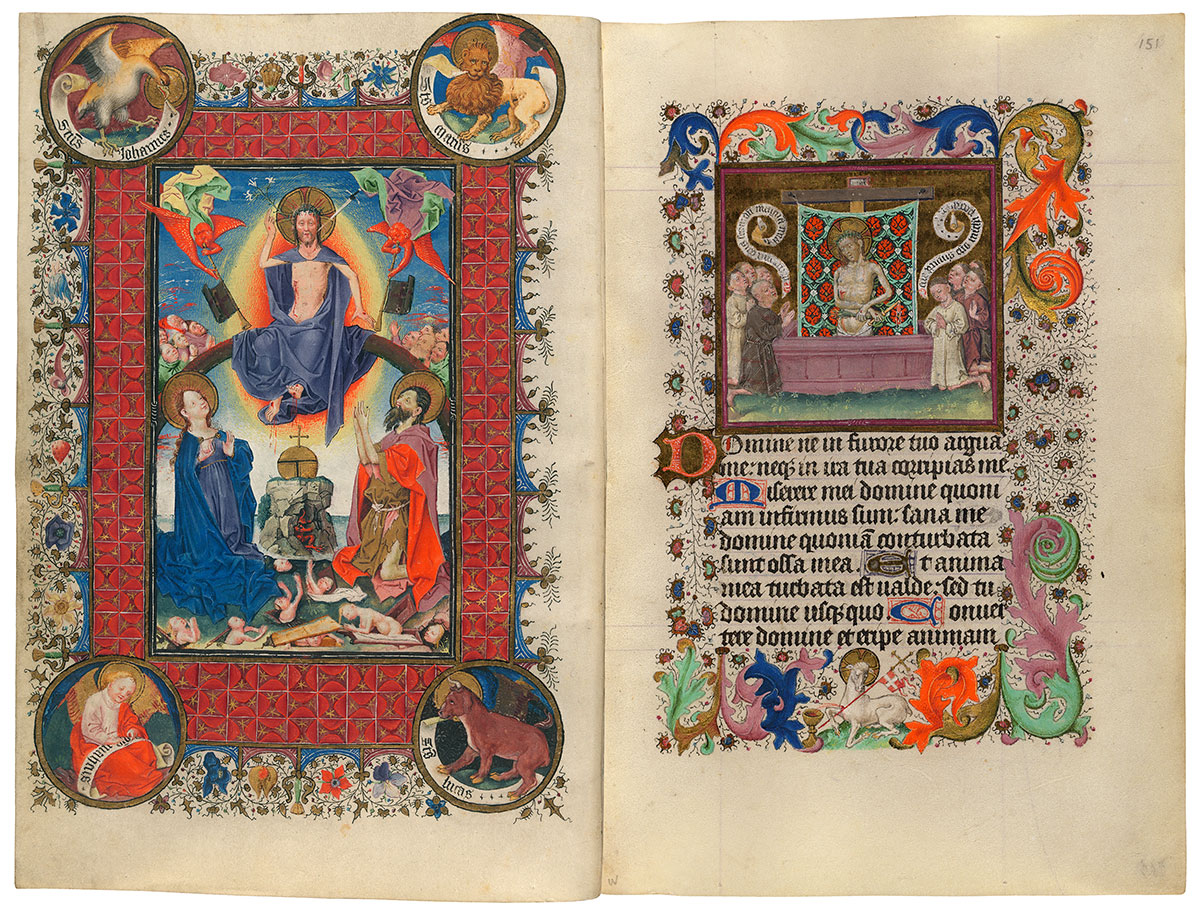
Last Judgment
Man of Sorrows Petitioned by Penitents
Purchased on the Belle da Costa Greene Fund with the assistance of the Fellows, 1963; purchased on the Belle da Costa Greene Fund with the assistance of the Fellows and with special assistance of Mrs. Frederick B. Adams, Sr., Mrs. Robert Charles, Mr. Laurens M. Hamilton, The Heineman Foundation, Mrs. Donald F. Hyde, Mrs. Jacob M. Kaplan, Mrs. John Kean, Mr. Paul Mellon, Mr. and Mrs. Charles F. Morgan, Mr. Lessing J. Rosenwald, Mr. and Mrs. August H. Schilling, Mrs. Herbert N. Straus, Mrs. Landon K. Thorne, Mrs. Alan Valentine, Mr. and Mrs. Arnold Whitridge, and Miss Julia P. Wightman, 1970
Codicological evidence—sewing holes and faint offset stains—confirms that this large Last Judgment occurred at the beginning of the Penitential Psalms. Trumpeting angels awaken the dead. Their intercessors are John the Baptist and Mary (who again bares her breast to her son). Their judge is Christ, who displays his dripping wounds. At his feet is the world, which rests on a rocky island; within a fissure in the rocks lurks a red demon. The smaller miniature is a bit more comforting: penitents approach Christ as the forgiving Man of Sorrows. In the bottom border, the Lamb of God pours his forgiving blood into a Eucharistic chalice.
Penitential Psalms
Medieval tradition ascribed the authorship of the Seven Penitential Psalms to King David, who composed them as penance for his grievous sins. These transgressions included adultery with Bathsheba and the murder of her husband, Uriah. In another commission of sin, a prideful David offended God by ordering a census of Israel and Judah.
These particular psalms (reckoned 6, 31, 37, 50, 101, 129, and 142 by medieval Catholics) have a long association with atonement. It is thought that by at least the third century they formed a part of Jewish liturgy. In the Christian tradition, they were known by the sixth century, when the Roman monk Cassiodorus referred to them as a sevenfold means of obtaining forgiveness. These seven psalms became linked to the Seven Deadly Sins; the former were prayed to avoid the latter.
Image courtesy of Faksimile Verlag Luzern
MS M.917/945, ff. 151v–152r
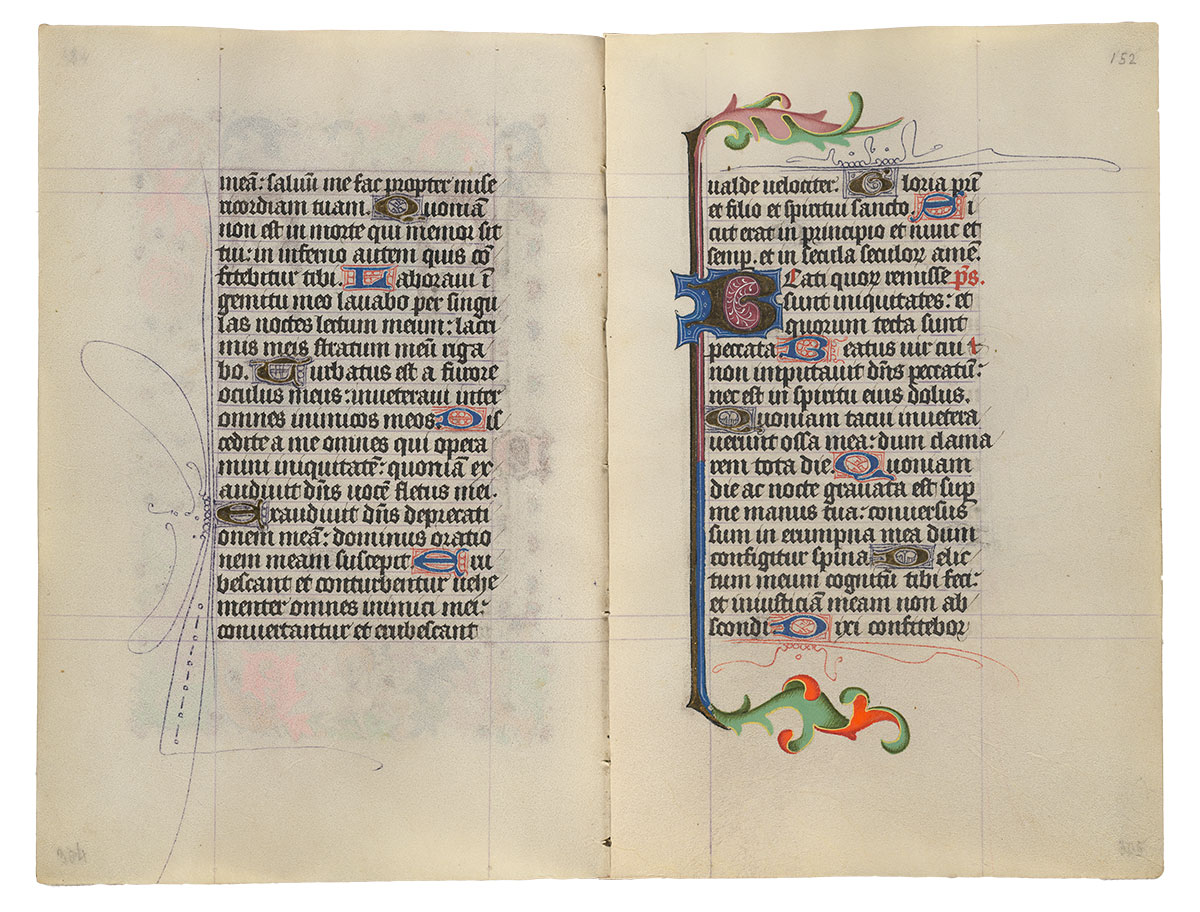
Purchased on the Belle da Costa Greene Fund with the assistance of the Fellows, 1963; purchased on the Belle da Costa Greene Fund with the assistance of the Fellows and with special assistance of Mrs. Frederick B. Adams, Sr., Mrs. Robert Charles, Mr. Laurens M. Hamilton, The Heineman Foundation, Mrs. Donald F. Hyde, Mrs. Jacob M. Kaplan, Mrs. John Kean, Mr. Paul Mellon, Mr. and Mrs. Charles F. Morgan, Mr. Lessing J. Rosenwald, Mr. and Mrs. August H. Schilling, Mrs. Herbert N. Straus, Mrs. Landon K. Thorne, Mrs. Alan Valentine, Mr. and Mrs. Arnold Whitridge, and Miss Julia P. Wightman, 1970
Image courtesy of Faksimile Verlag Luzern
MS M.917/945, ff. 152v–153r
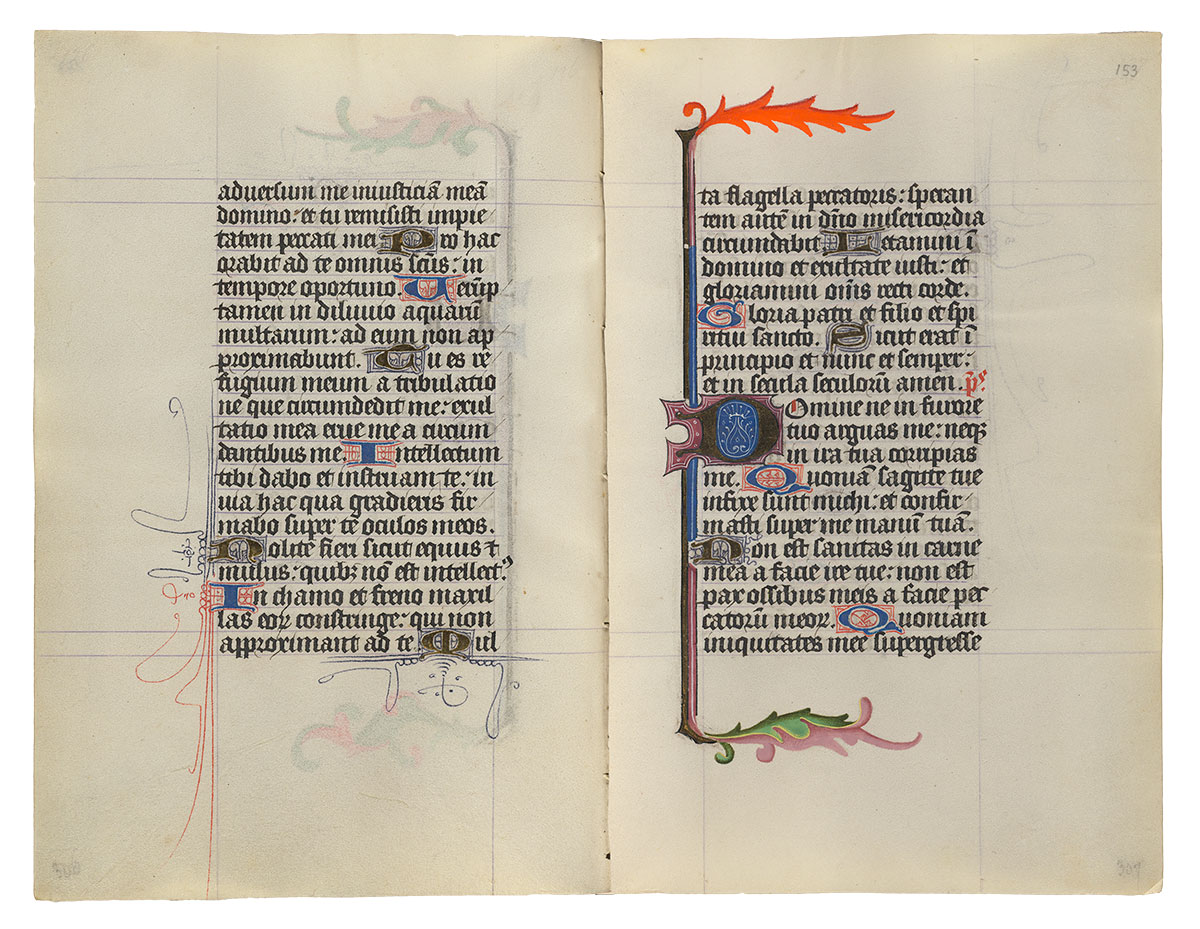
Purchased on the Belle da Costa Greene Fund with the assistance of the Fellows, 1963; purchased on the Belle da Costa Greene Fund with the assistance of the Fellows and with special assistance of Mrs. Frederick B. Adams, Sr., Mrs. Robert Charles, Mr. Laurens M. Hamilton, The Heineman Foundation, Mrs. Donald F. Hyde, Mrs. Jacob M. Kaplan, Mrs. John Kean, Mr. Paul Mellon, Mr. and Mrs. Charles F. Morgan, Mr. Lessing J. Rosenwald, Mr. and Mrs. August H. Schilling, Mrs. Herbert N. Straus, Mrs. Landon K. Thorne, Mrs. Alan Valentine, Mr. and Mrs. Arnold Whitridge, and Miss Julia P. Wightman, 1970
Image courtesy of Faksimile Verlag Luzern
MS M.917/945, ff. 153v–154r
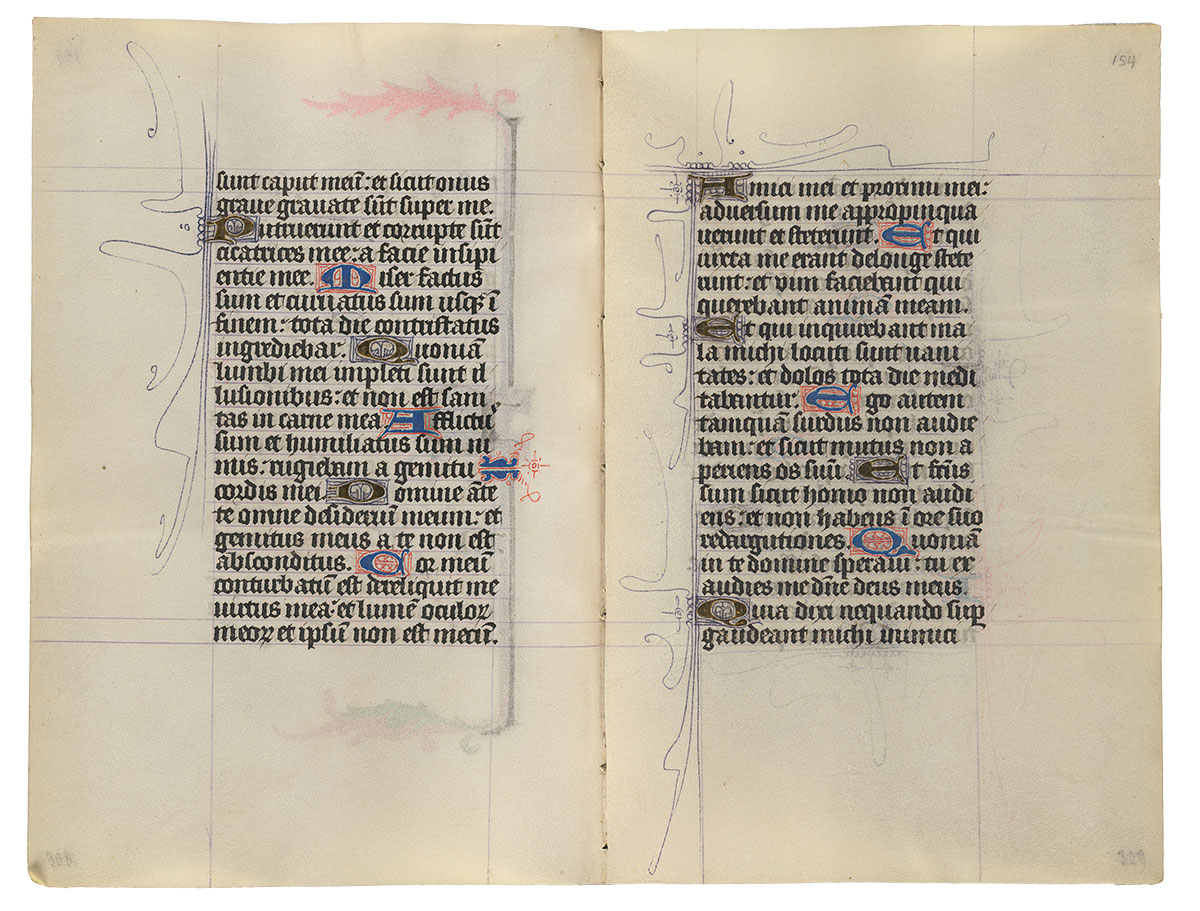
Purchased on the Belle da Costa Greene Fund with the assistance of the Fellows, 1963; purchased on the Belle da Costa Greene Fund with the assistance of the Fellows and with special assistance of Mrs. Frederick B. Adams, Sr., Mrs. Robert Charles, Mr. Laurens M. Hamilton, The Heineman Foundation, Mrs. Donald F. Hyde, Mrs. Jacob M. Kaplan, Mrs. John Kean, Mr. Paul Mellon, Mr. and Mrs. Charles F. Morgan, Mr. Lessing J. Rosenwald, Mr. and Mrs. August H. Schilling, Mrs. Herbert N. Straus, Mrs. Landon K. Thorne, Mrs. Alan Valentine, Mr. and Mrs. Arnold Whitridge, and Miss Julia P. Wightman, 1970
Image courtesy of Faksimile Verlag Luzern
MS M.917/945, ff. 154v–155r
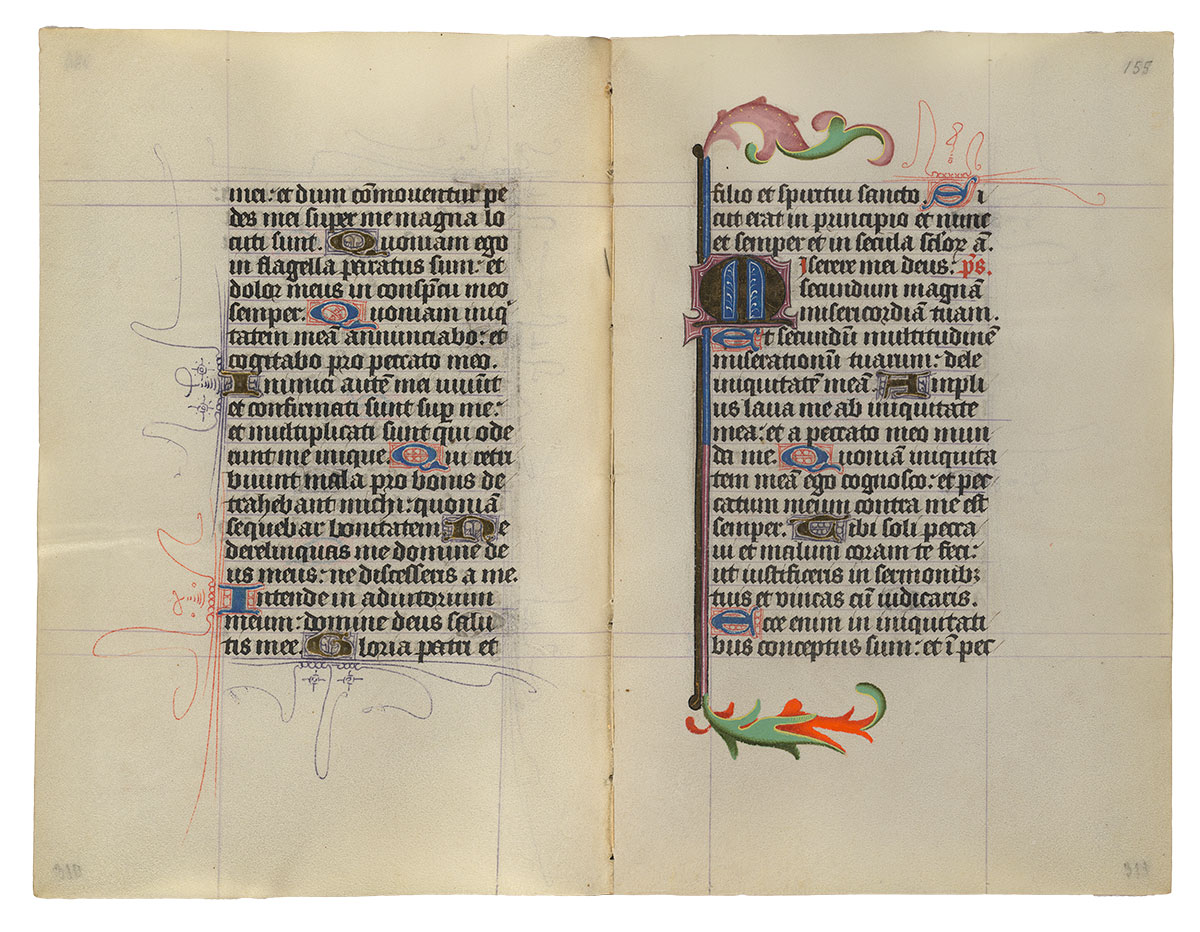
Purchased on the Belle da Costa Greene Fund with the assistance of the Fellows, 1963; purchased on the Belle da Costa Greene Fund with the assistance of the Fellows and with special assistance of Mrs. Frederick B. Adams, Sr., Mrs. Robert Charles, Mr. Laurens M. Hamilton, The Heineman Foundation, Mrs. Donald F. Hyde, Mrs. Jacob M. Kaplan, Mrs. John Kean, Mr. Paul Mellon, Mr. and Mrs. Charles F. Morgan, Mr. Lessing J. Rosenwald, Mr. and Mrs. August H. Schilling, Mrs. Herbert N. Straus, Mrs. Landon K. Thorne, Mrs. Alan Valentine, Mr. and Mrs. Arnold Whitridge, and Miss Julia P. Wightman, 1970
Image courtesy of Faksimile Verlag Luzern
MS M.917/945, ff. 155v–156r
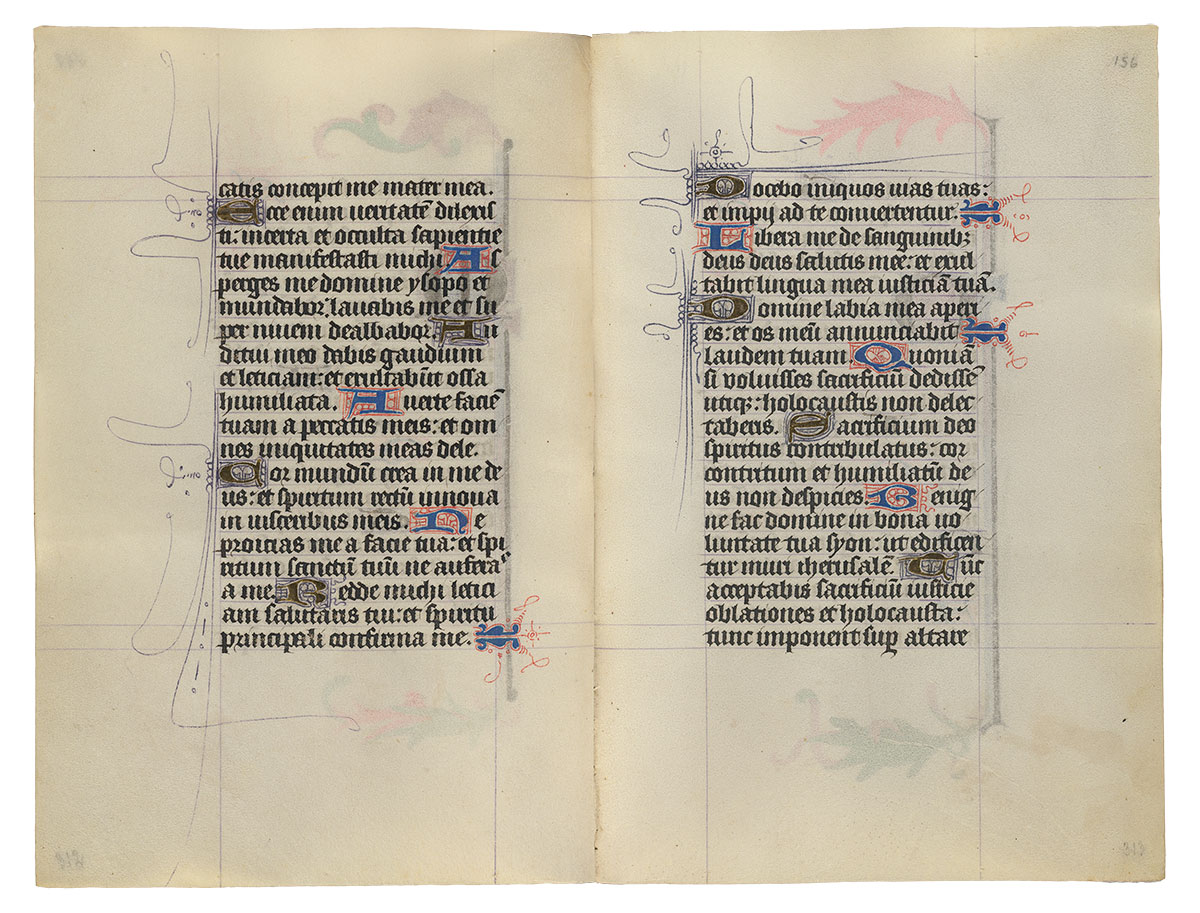
Purchased on the Belle da Costa Greene Fund with the assistance of the Fellows, 1963; purchased on the Belle da Costa Greene Fund with the assistance of the Fellows and with special assistance of Mrs. Frederick B. Adams, Sr., Mrs. Robert Charles, Mr. Laurens M. Hamilton, The Heineman Foundation, Mrs. Donald F. Hyde, Mrs. Jacob M. Kaplan, Mrs. John Kean, Mr. Paul Mellon, Mr. and Mrs. Charles F. Morgan, Mr. Lessing J. Rosenwald, Mr. and Mrs. August H. Schilling, Mrs. Herbert N. Straus, Mrs. Landon K. Thorne, Mrs. Alan Valentine, Mr. and Mrs. Arnold Whitridge, and Miss Julia P. Wightman, 1970
Image courtesy of Faksimile Verlag Luzern
MS M.917/945, ff. 156v–157r
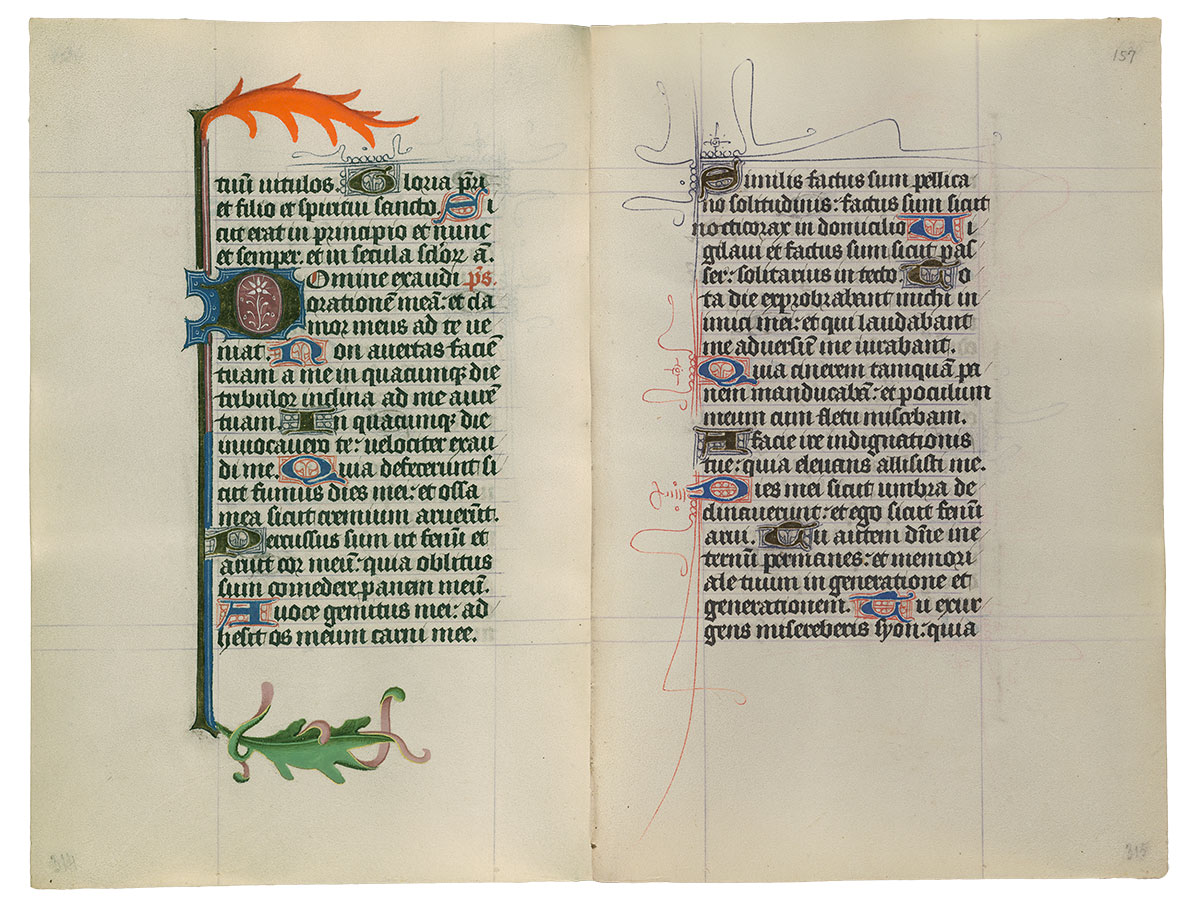
Purchased on the Belle da Costa Greene Fund with the assistance of the Fellows, 1963; purchased on the Belle da Costa Greene Fund with the assistance of the Fellows and with special assistance of Mrs. Frederick B. Adams, Sr., Mrs. Robert Charles, Mr. Laurens M. Hamilton, The Heineman Foundation, Mrs. Donald F. Hyde, Mrs. Jacob M. Kaplan, Mrs. John Kean, Mr. Paul Mellon, Mr. and Mrs. Charles F. Morgan, Mr. Lessing J. Rosenwald, Mr. and Mrs. August H. Schilling, Mrs. Herbert N. Straus, Mrs. Landon K. Thorne, Mrs. Alan Valentine, Mr. and Mrs. Arnold Whitridge, and Miss Julia P. Wightman, 1970
Image courtesy of Faksimile Verlag Luzern
MS M.917/945, ff. 157v–158r
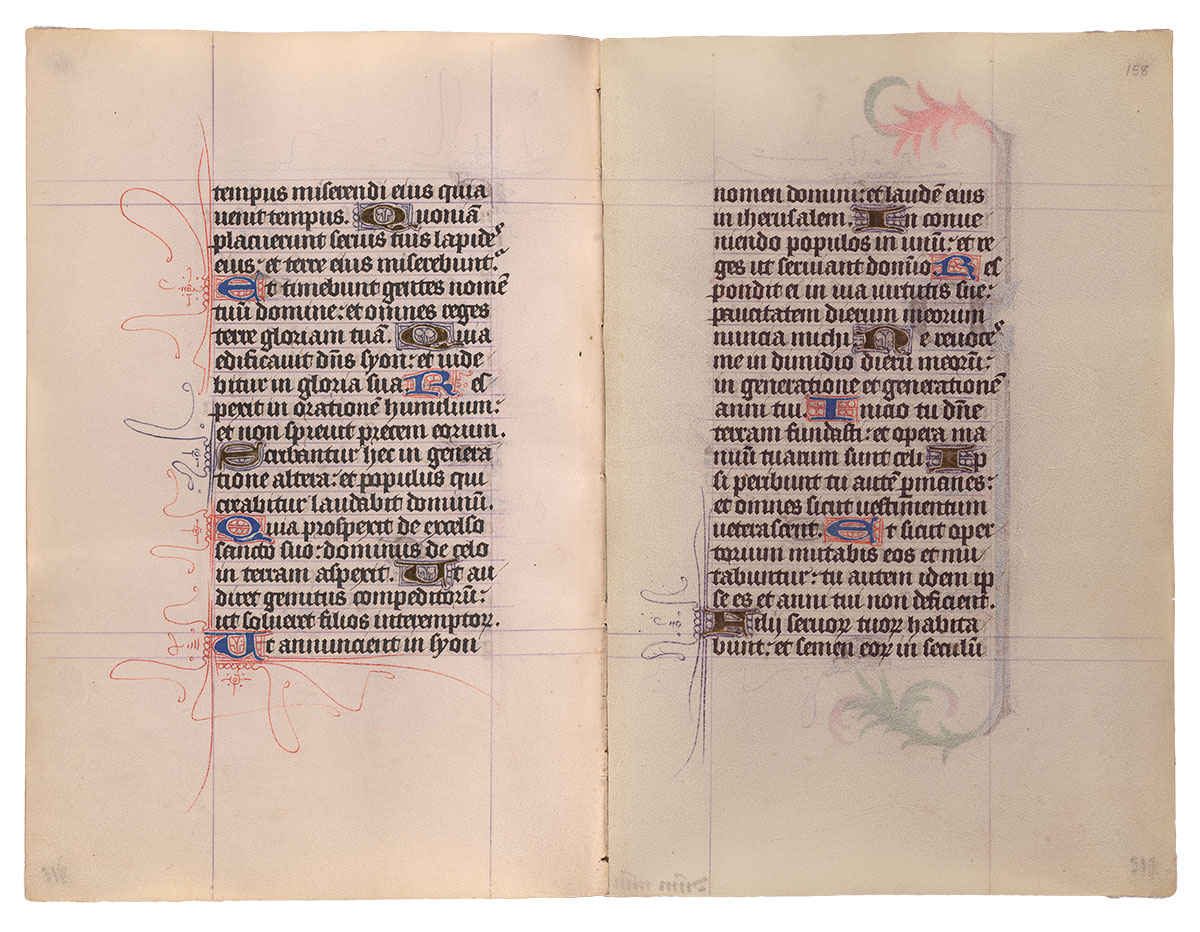
Purchased on the Belle da Costa Greene Fund with the assistance of the Fellows, 1963; purchased on the Belle da Costa Greene Fund with the assistance of the Fellows and with special assistance of Mrs. Frederick B. Adams, Sr., Mrs. Robert Charles, Mr. Laurens M. Hamilton, The Heineman Foundation, Mrs. Donald F. Hyde, Mrs. Jacob M. Kaplan, Mrs. John Kean, Mr. Paul Mellon, Mr. and Mrs. Charles F. Morgan, Mr. Lessing J. Rosenwald, Mr. and Mrs. August H. Schilling, Mrs. Herbert N. Straus, Mrs. Landon K. Thorne, Mrs. Alan Valentine, Mr. and Mrs. Arnold Whitridge, and Miss Julia P. Wightman, 1970
Image courtesy of Faksimile Verlag Luzern
MS M.917/945, ff. 158v–159r
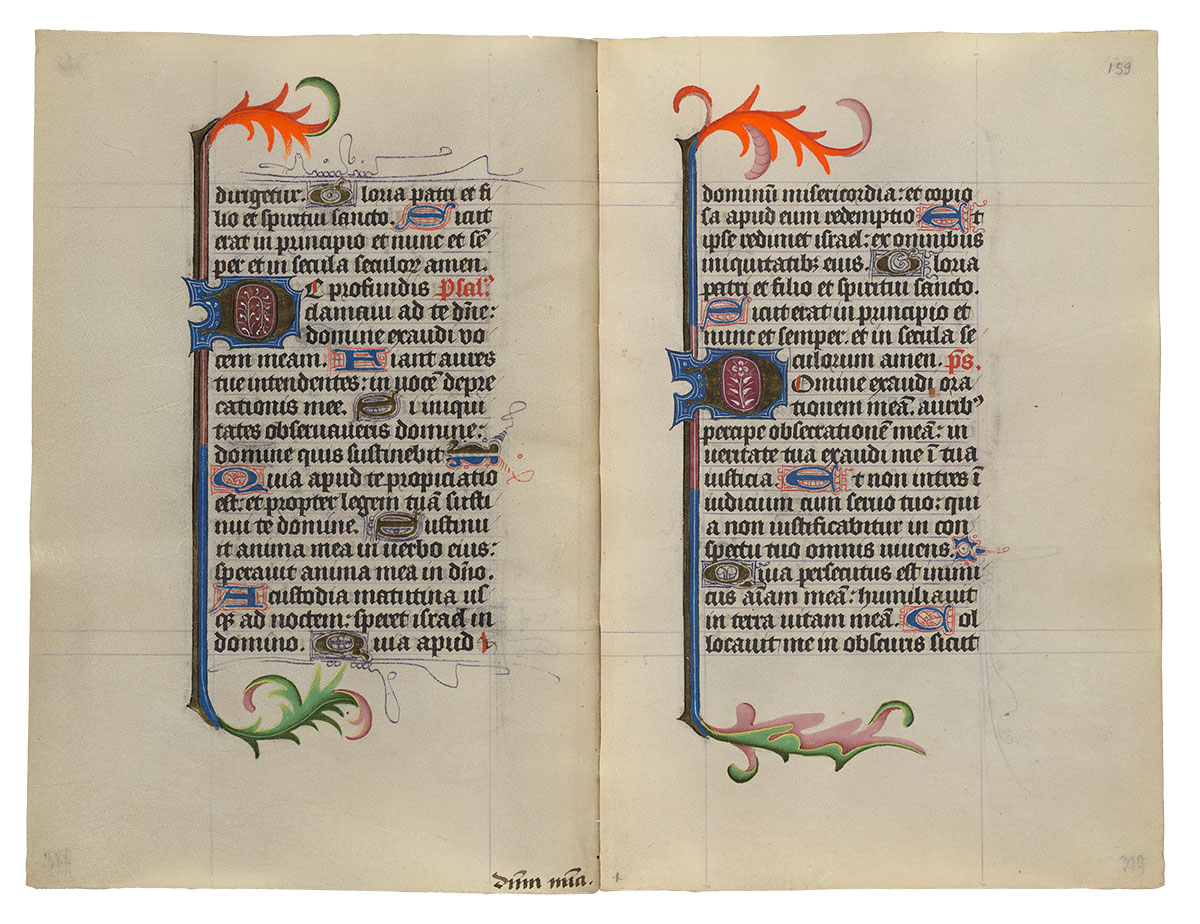
Purchased on the Belle da Costa Greene Fund with the assistance of the Fellows, 1963; purchased on the Belle da Costa Greene Fund with the assistance of the Fellows and with special assistance of Mrs. Frederick B. Adams, Sr., Mrs. Robert Charles, Mr. Laurens M. Hamilton, The Heineman Foundation, Mrs. Donald F. Hyde, Mrs. Jacob M. Kaplan, Mrs. John Kean, Mr. Paul Mellon, Mr. and Mrs. Charles F. Morgan, Mr. Lessing J. Rosenwald, Mr. and Mrs. August H. Schilling, Mrs. Herbert N. Straus, Mrs. Landon K. Thorne, Mrs. Alan Valentine, Mr. and Mrs. Arnold Whitridge, and Miss Julia P. Wightman, 1970
Image courtesy of Faksimile Verlag Luzern
MS M.917/945, ff. 159v–160r
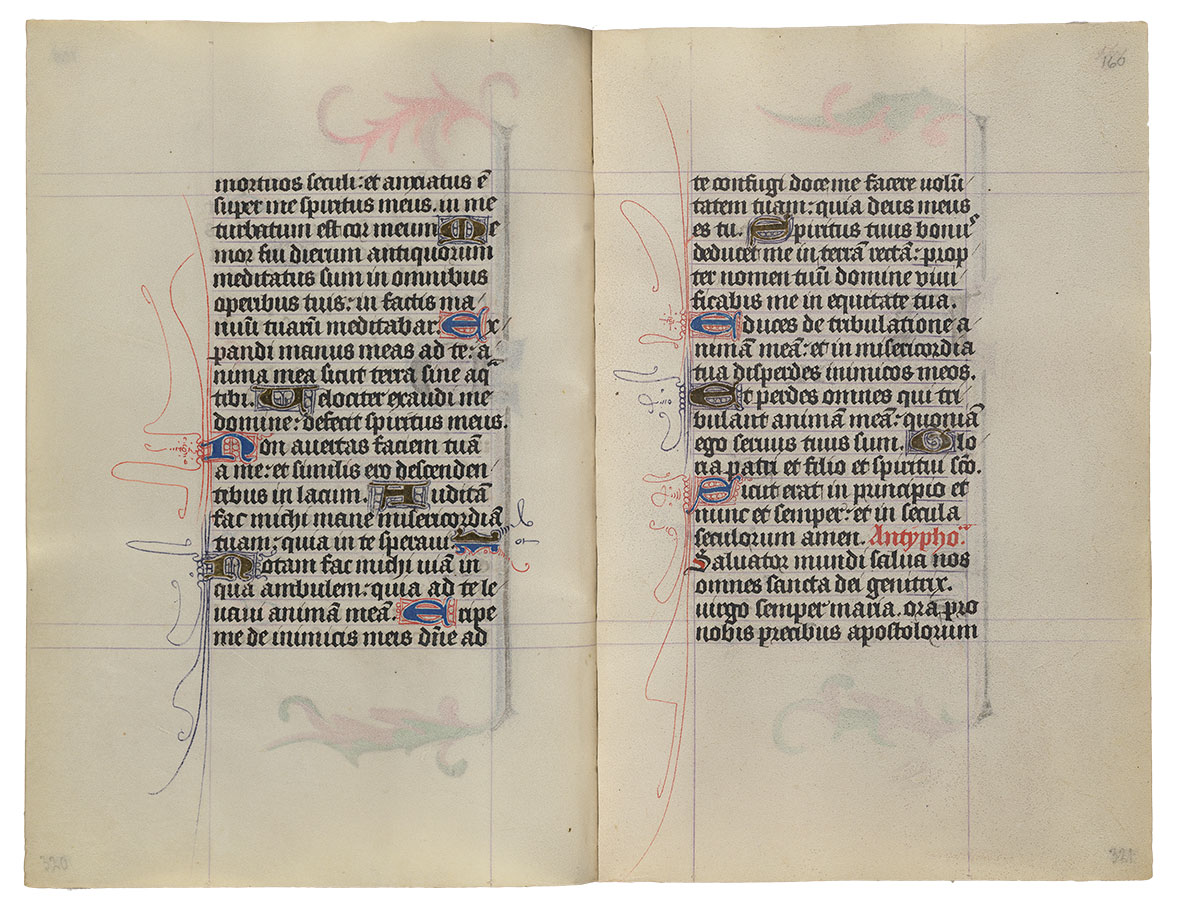
Purchased on the Belle da Costa Greene Fund with the assistance of the Fellows, 1963; purchased on the Belle da Costa Greene Fund with the assistance of the Fellows and with special assistance of Mrs. Frederick B. Adams, Sr., Mrs. Robert Charles, Mr. Laurens M. Hamilton, The Heineman Foundation, Mrs. Donald F. Hyde, Mrs. Jacob M. Kaplan, Mrs. John Kean, Mr. Paul Mellon, Mr. and Mrs. Charles F. Morgan, Mr. Lessing J. Rosenwald, Mr. and Mrs. August H. Schilling, Mrs. Herbert N. Straus, Mrs. Landon K. Thorne, Mrs. Alan Valentine, Mr. and Mrs. Arnold Whitridge, and Miss Julia P. Wightman, 1970
Image courtesy of Faksimile Verlag Luzern
MS M.917/945, ff. 160v–161r
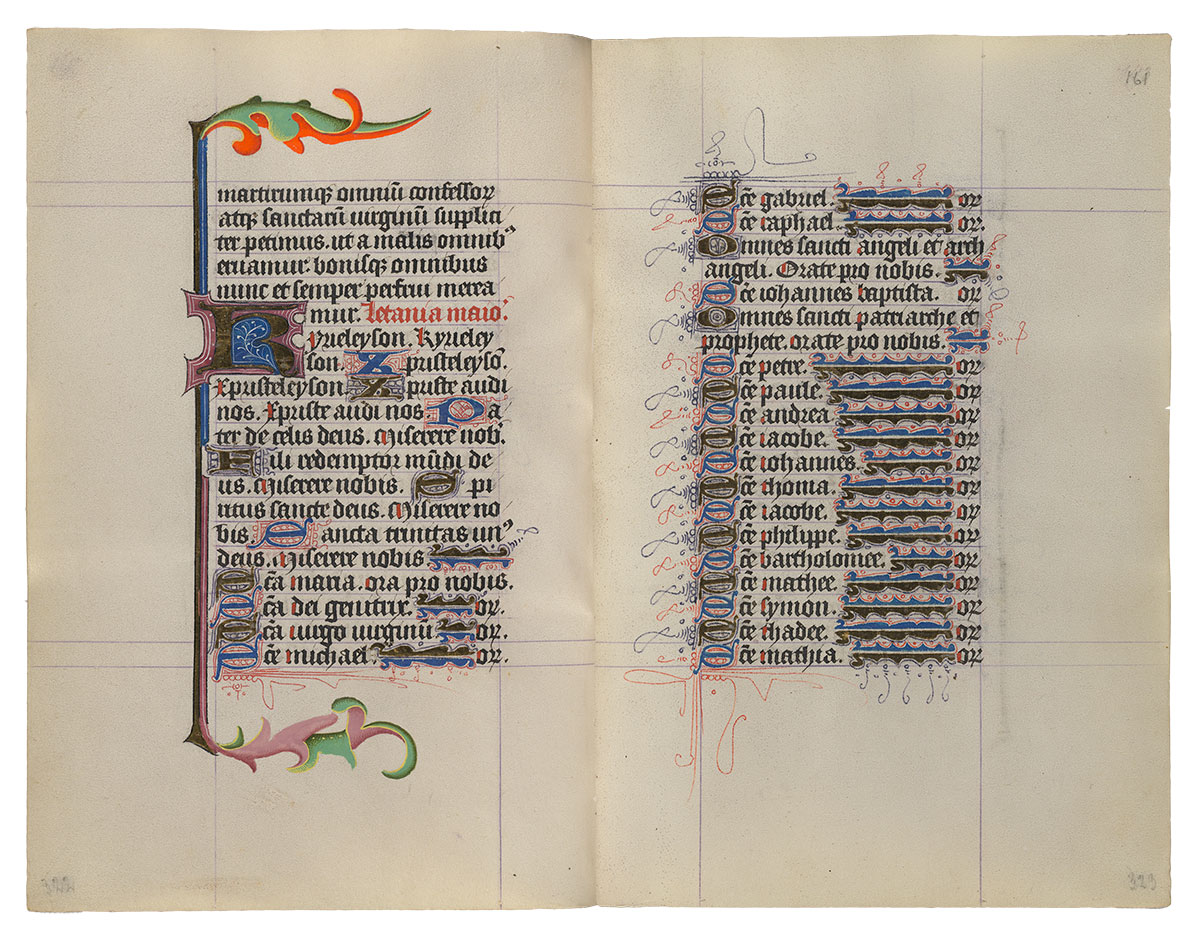
Purchased on the Belle da Costa Greene Fund with the assistance of the Fellows, 1963; purchased on the Belle da Costa Greene Fund with the assistance of the Fellows and with special assistance of Mrs. Frederick B. Adams, Sr., Mrs. Robert Charles, Mr. Laurens M. Hamilton, The Heineman Foundation, Mrs. Donald F. Hyde, Mrs. Jacob M. Kaplan, Mrs. John Kean, Mr. Paul Mellon, Mr. and Mrs. Charles F. Morgan, Mr. Lessing J. Rosenwald, Mr. and Mrs. August H. Schilling, Mrs. Herbert N. Straus, Mrs. Landon K. Thorne, Mrs. Alan Valentine, Mr. and Mrs. Arnold Whitridge, and Miss Julia P. Wightman, 1970
Image courtesy of Faksimile Verlag Luzern
MS M.917/945, ff. 161v–162r
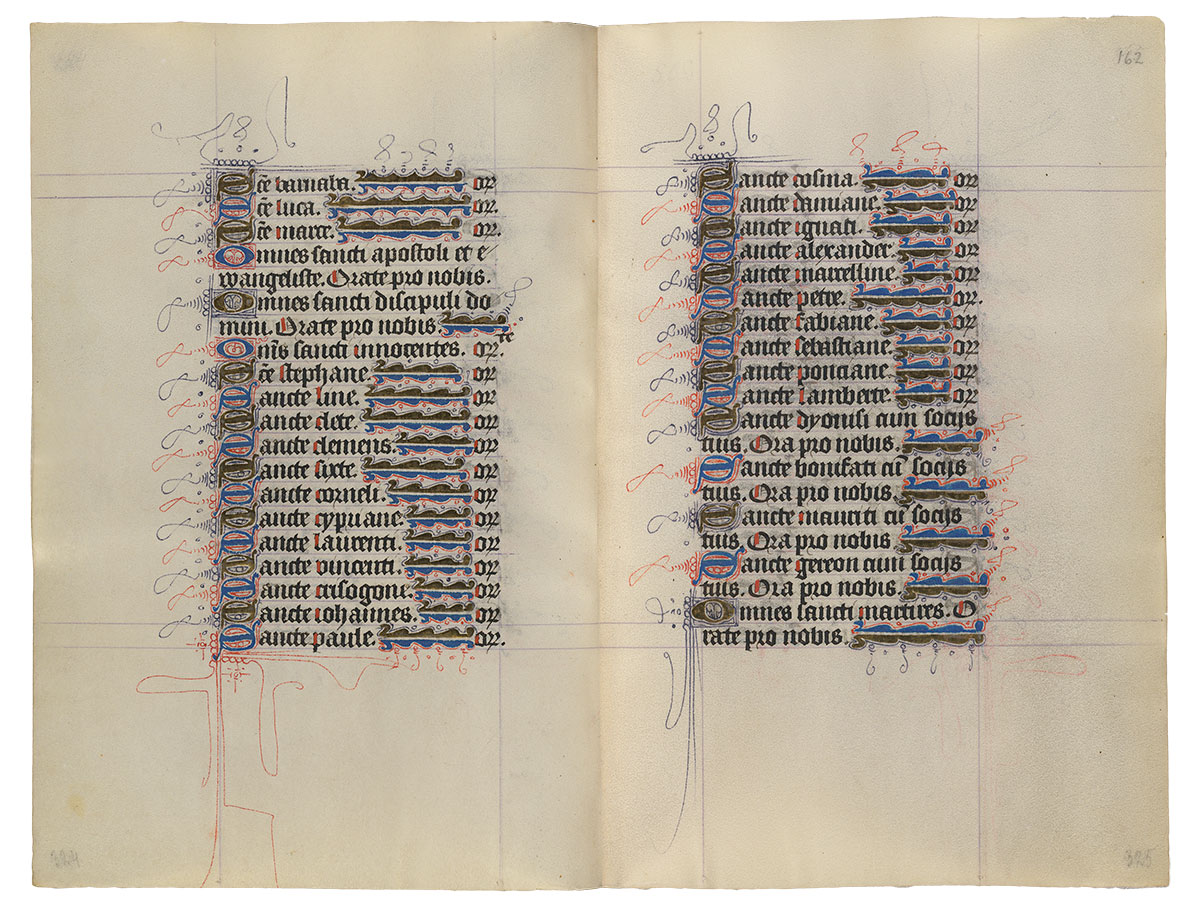
Purchased on the Belle da Costa Greene Fund with the assistance of the Fellows, 1963; purchased on the Belle da Costa Greene Fund with the assistance of the Fellows and with special assistance of Mrs. Frederick B. Adams, Sr., Mrs. Robert Charles, Mr. Laurens M. Hamilton, The Heineman Foundation, Mrs. Donald F. Hyde, Mrs. Jacob M. Kaplan, Mrs. John Kean, Mr. Paul Mellon, Mr. and Mrs. Charles F. Morgan, Mr. Lessing J. Rosenwald, Mr. and Mrs. August H. Schilling, Mrs. Herbert N. Straus, Mrs. Landon K. Thorne, Mrs. Alan Valentine, Mr. and Mrs. Arnold Whitridge, and Miss Julia P. Wightman, 1970
Image courtesy of Faksimile Verlag Luzern
MS M.917/945, ff. 162v–163r
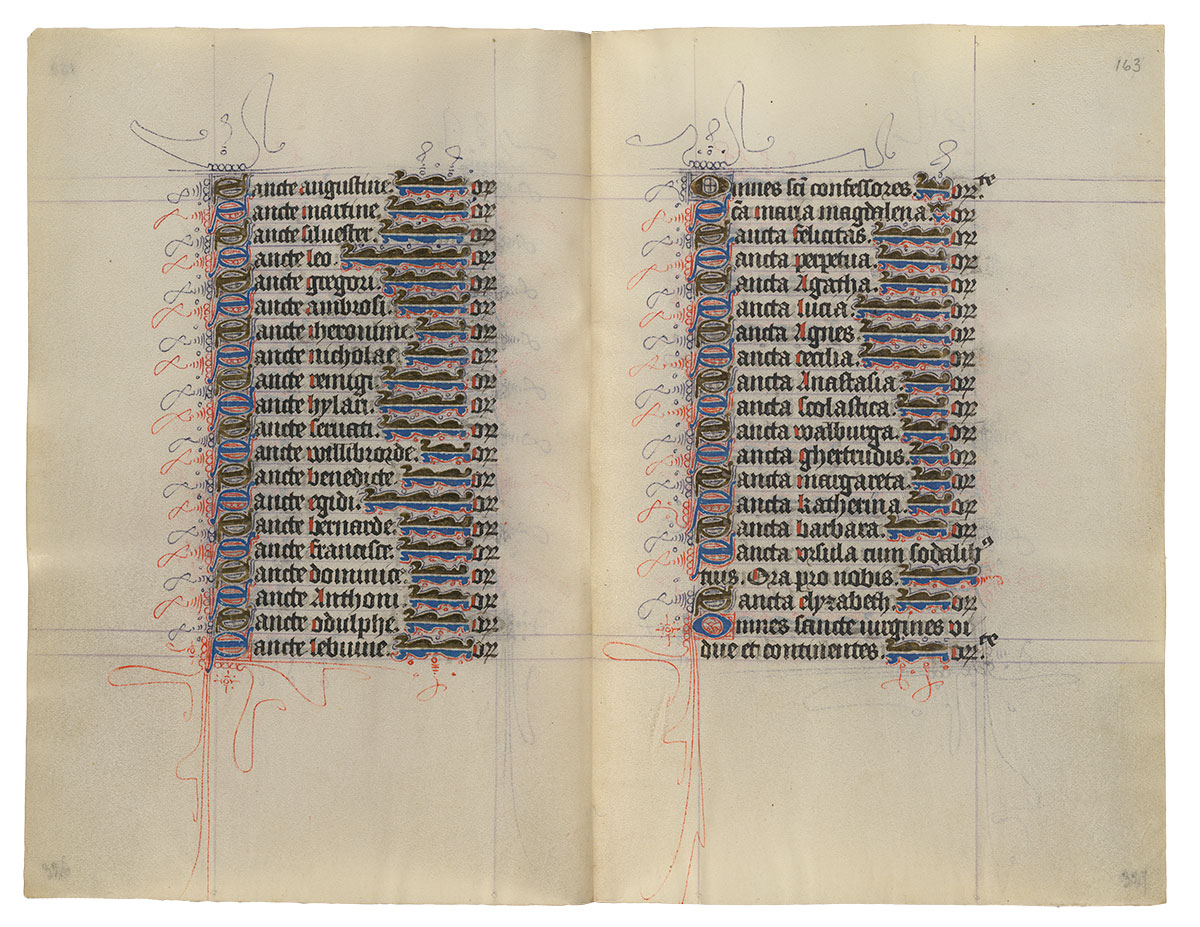
Purchased on the Belle da Costa Greene Fund with the assistance of the Fellows, 1963; purchased on the Belle da Costa Greene Fund with the assistance of the Fellows and with special assistance of Mrs. Frederick B. Adams, Sr., Mrs. Robert Charles, Mr. Laurens M. Hamilton, The Heineman Foundation, Mrs. Donald F. Hyde, Mrs. Jacob M. Kaplan, Mrs. John Kean, Mr. Paul Mellon, Mr. and Mrs. Charles F. Morgan, Mr. Lessing J. Rosenwald, Mr. and Mrs. August H. Schilling, Mrs. Herbert N. Straus, Mrs. Landon K. Thorne, Mrs. Alan Valentine, Mr. and Mrs. Arnold Whitridge, and Miss Julia P. Wightman, 1970
Image courtesy of Faksimile Verlag Luzern
MS M.917/945, ff. 163v–164r
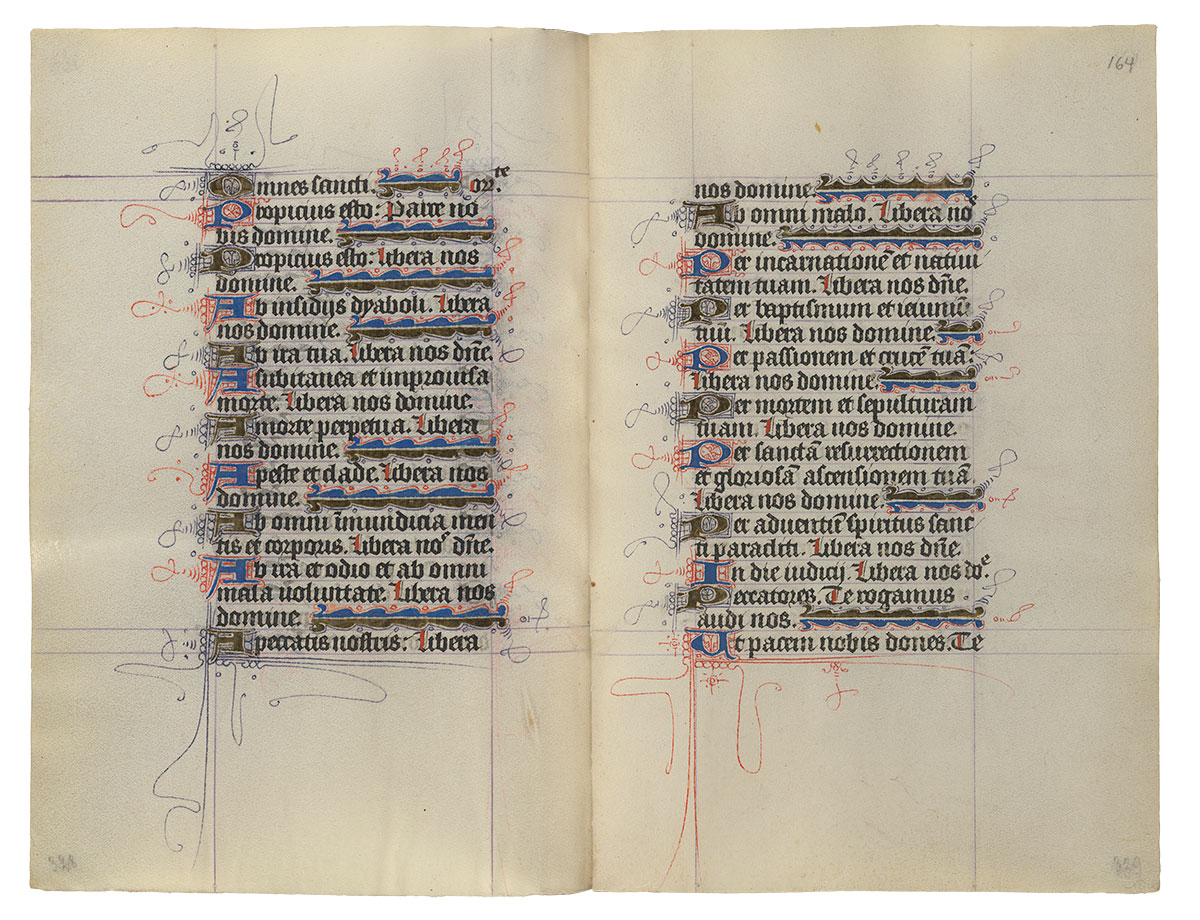
Purchased on the Belle da Costa Greene Fund with the assistance of the Fellows, 1963; purchased on the Belle da Costa Greene Fund with the assistance of the Fellows and with special assistance of Mrs. Frederick B. Adams, Sr., Mrs. Robert Charles, Mr. Laurens M. Hamilton, The Heineman Foundation, Mrs. Donald F. Hyde, Mrs. Jacob M. Kaplan, Mrs. John Kean, Mr. Paul Mellon, Mr. and Mrs. Charles F. Morgan, Mr. Lessing J. Rosenwald, Mr. and Mrs. August H. Schilling, Mrs. Herbert N. Straus, Mrs. Landon K. Thorne, Mrs. Alan Valentine, Mr. and Mrs. Arnold Whitridge, and Miss Julia P. Wightman, 1970
Image courtesy of Faksimile Verlag Luzern
MS M.917/945, ff. 164v–165r
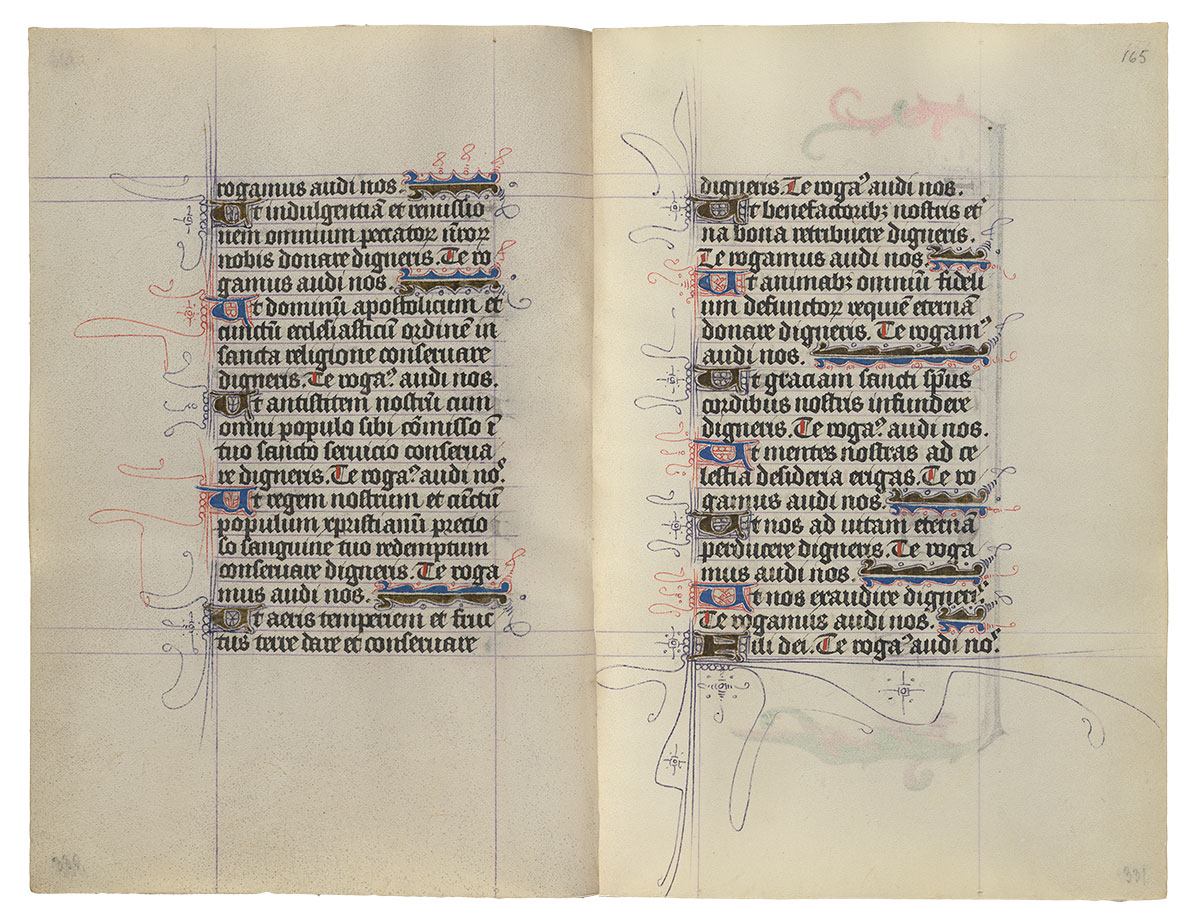
Purchased on the Belle da Costa Greene Fund with the assistance of the Fellows, 1963; purchased on the Belle da Costa Greene Fund with the assistance of the Fellows and with special assistance of Mrs. Frederick B. Adams, Sr., Mrs. Robert Charles, Mr. Laurens M. Hamilton, The Heineman Foundation, Mrs. Donald F. Hyde, Mrs. Jacob M. Kaplan, Mrs. John Kean, Mr. Paul Mellon, Mr. and Mrs. Charles F. Morgan, Mr. Lessing J. Rosenwald, Mr. and Mrs. August H. Schilling, Mrs. Herbert N. Straus, Mrs. Landon K. Thorne, Mrs. Alan Valentine, Mr. and Mrs. Arnold Whitridge, and Miss Julia P. Wightman, 1970
Image courtesy of Faksimile Verlag Luzern
MS M.917/945, ff. 165v–166r
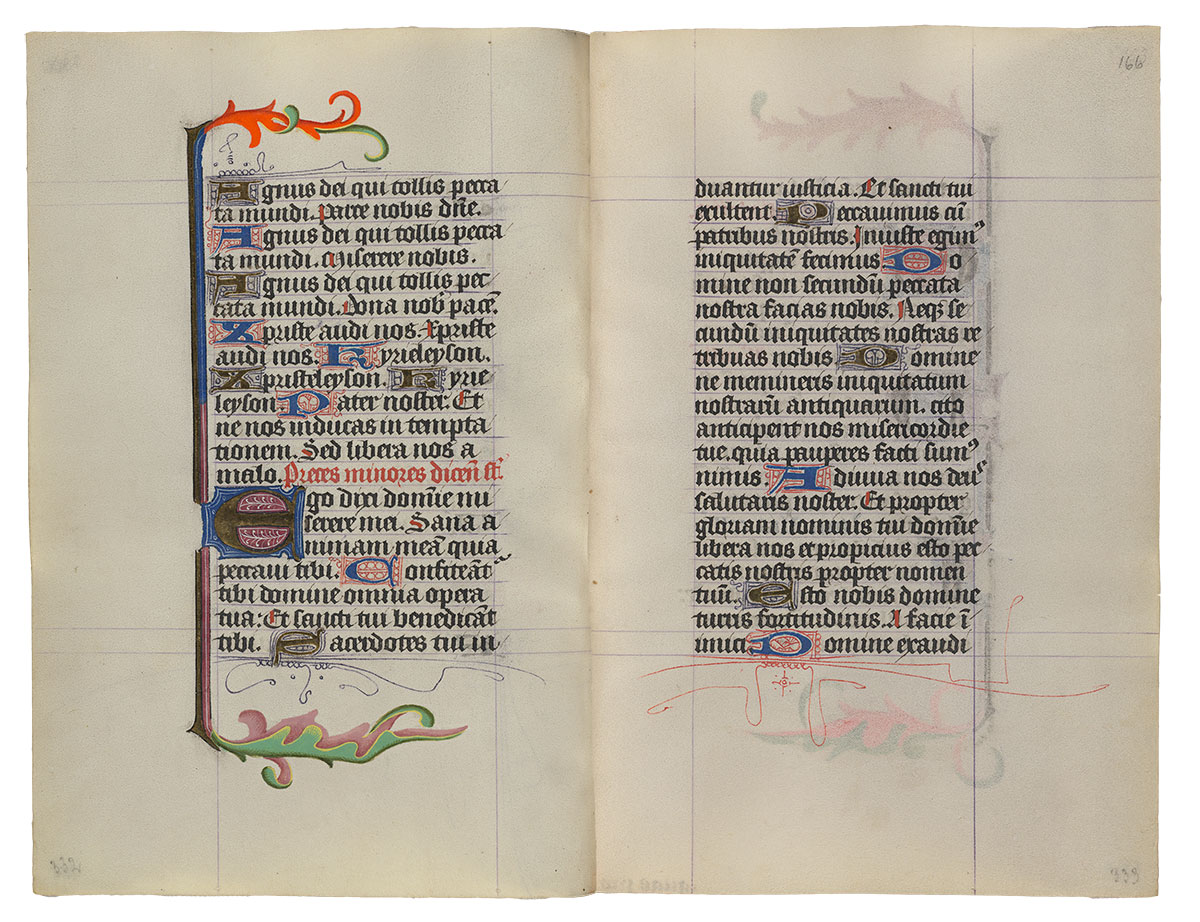
Purchased on the Belle da Costa Greene Fund with the assistance of the Fellows, 1963; purchased on the Belle da Costa Greene Fund with the assistance of the Fellows and with special assistance of Mrs. Frederick B. Adams, Sr., Mrs. Robert Charles, Mr. Laurens M. Hamilton, The Heineman Foundation, Mrs. Donald F. Hyde, Mrs. Jacob M. Kaplan, Mrs. John Kean, Mr. Paul Mellon, Mr. and Mrs. Charles F. Morgan, Mr. Lessing J. Rosenwald, Mr. and Mrs. August H. Schilling, Mrs. Herbert N. Straus, Mrs. Landon K. Thorne, Mrs. Alan Valentine, Mr. and Mrs. Arnold Whitridge, and Miss Julia P. Wightman, 1970
Image courtesy of Faksimile Verlag Luzern
MS M.917/945, ff. 166v–167r
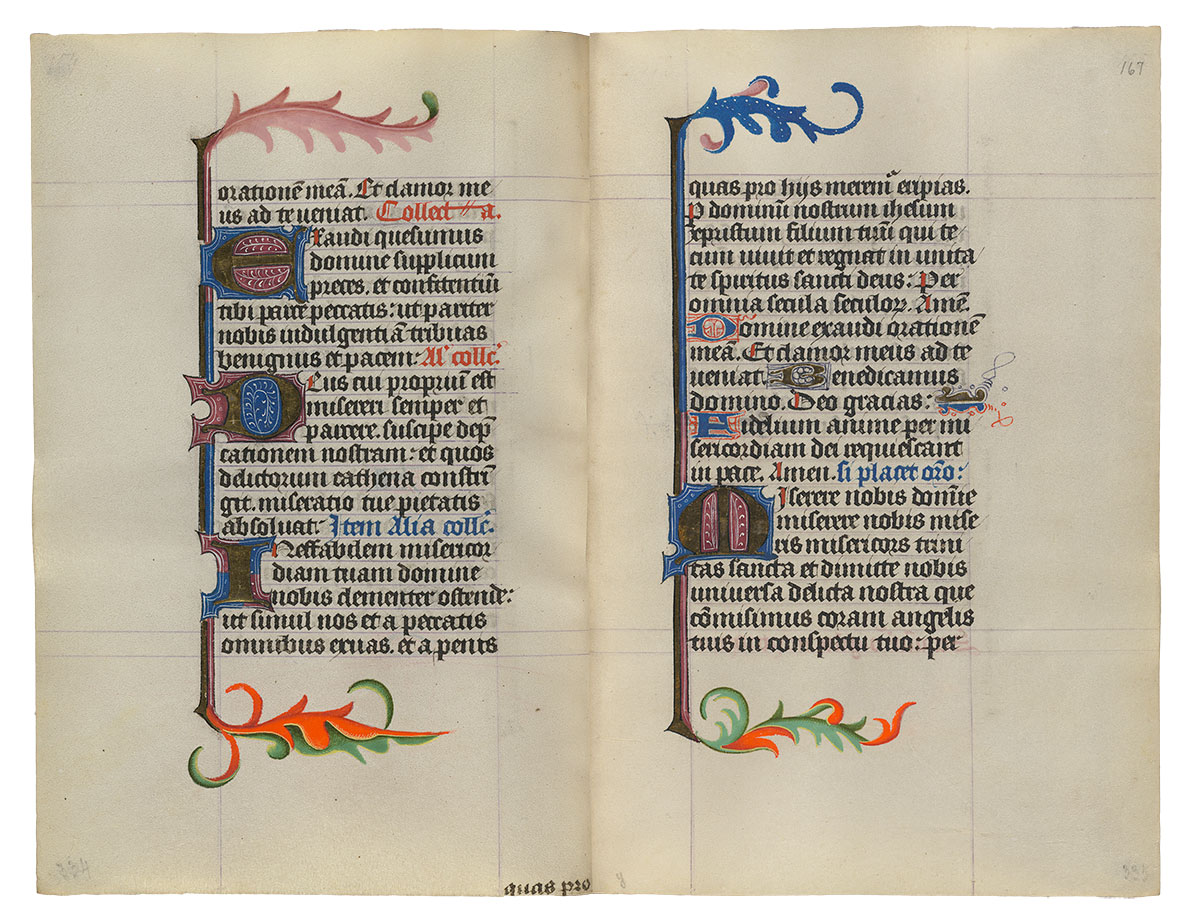
Purchased on the Belle da Costa Greene Fund with the assistance of the Fellows, 1963; purchased on the Belle da Costa Greene Fund with the assistance of the Fellows and with special assistance of Mrs. Frederick B. Adams, Sr., Mrs. Robert Charles, Mr. Laurens M. Hamilton, The Heineman Foundation, Mrs. Donald F. Hyde, Mrs. Jacob M. Kaplan, Mrs. John Kean, Mr. Paul Mellon, Mr. and Mrs. Charles F. Morgan, Mr. Lessing J. Rosenwald, Mr. and Mrs. August H. Schilling, Mrs. Herbert N. Straus, Mrs. Landon K. Thorne, Mrs. Alan Valentine, Mr. and Mrs. Arnold Whitridge, and Miss Julia P. Wightman, 1970
Image courtesy of Faksimile Verlag Luzern
MS M.917/945, ff. 167v–168r
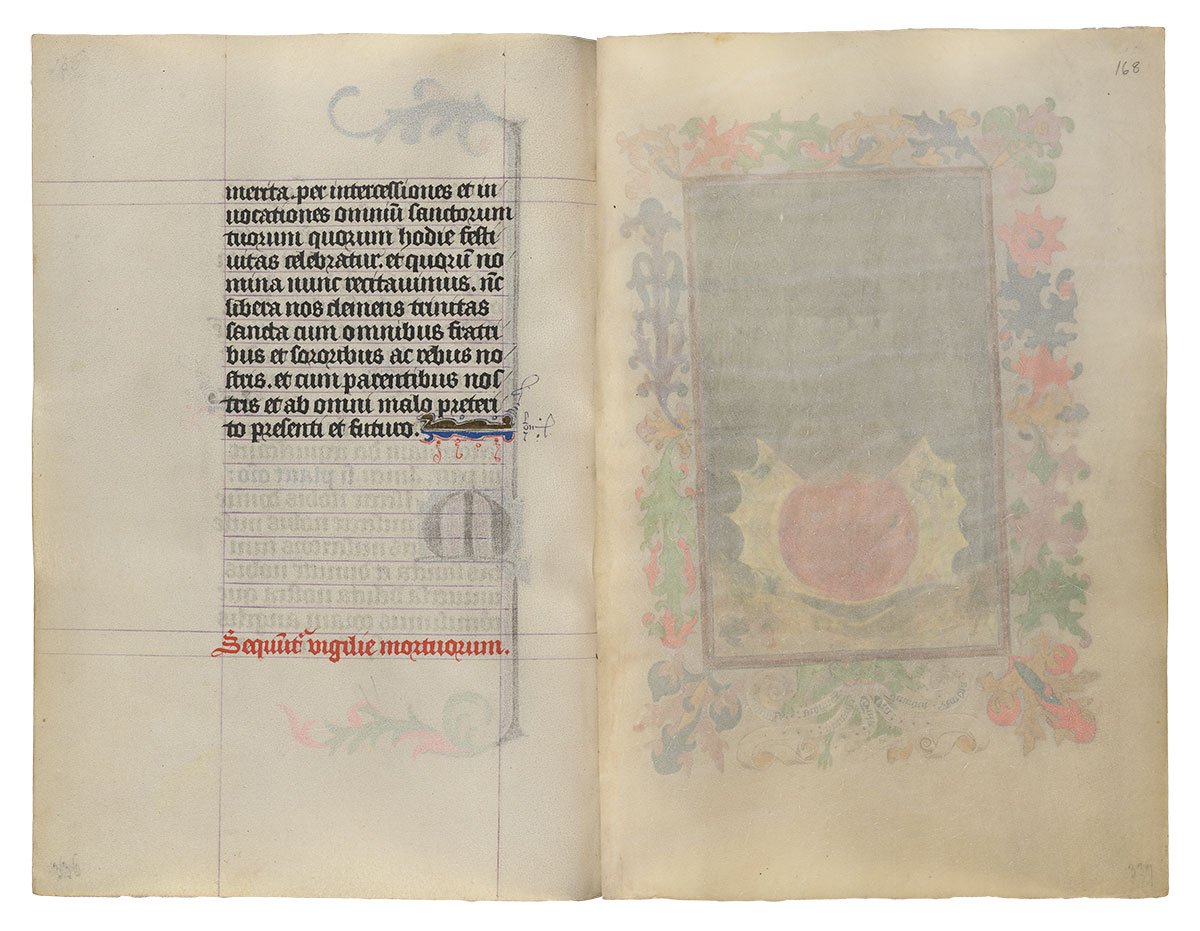
Purchased on the Belle da Costa Greene Fund with the assistance of the Fellows, 1963; purchased on the Belle da Costa Greene Fund with the assistance of the Fellows and with special assistance of Mrs. Frederick B. Adams, Sr., Mrs. Robert Charles, Mr. Laurens M. Hamilton, The Heineman Foundation, Mrs. Donald F. Hyde, Mrs. Jacob M. Kaplan, Mrs. John Kean, Mr. Paul Mellon, Mr. and Mrs. Charles F. Morgan, Mr. Lessing J. Rosenwald, Mr. and Mrs. August H. Schilling, Mrs. Herbert N. Straus, Mrs. Landon K. Thorne, Mrs. Alan Valentine, Mr. and Mrs. Arnold Whitridge, and Miss Julia P. Wightman, 1970
Image courtesy of Faksimile Verlag Luzern
Office of the Dead
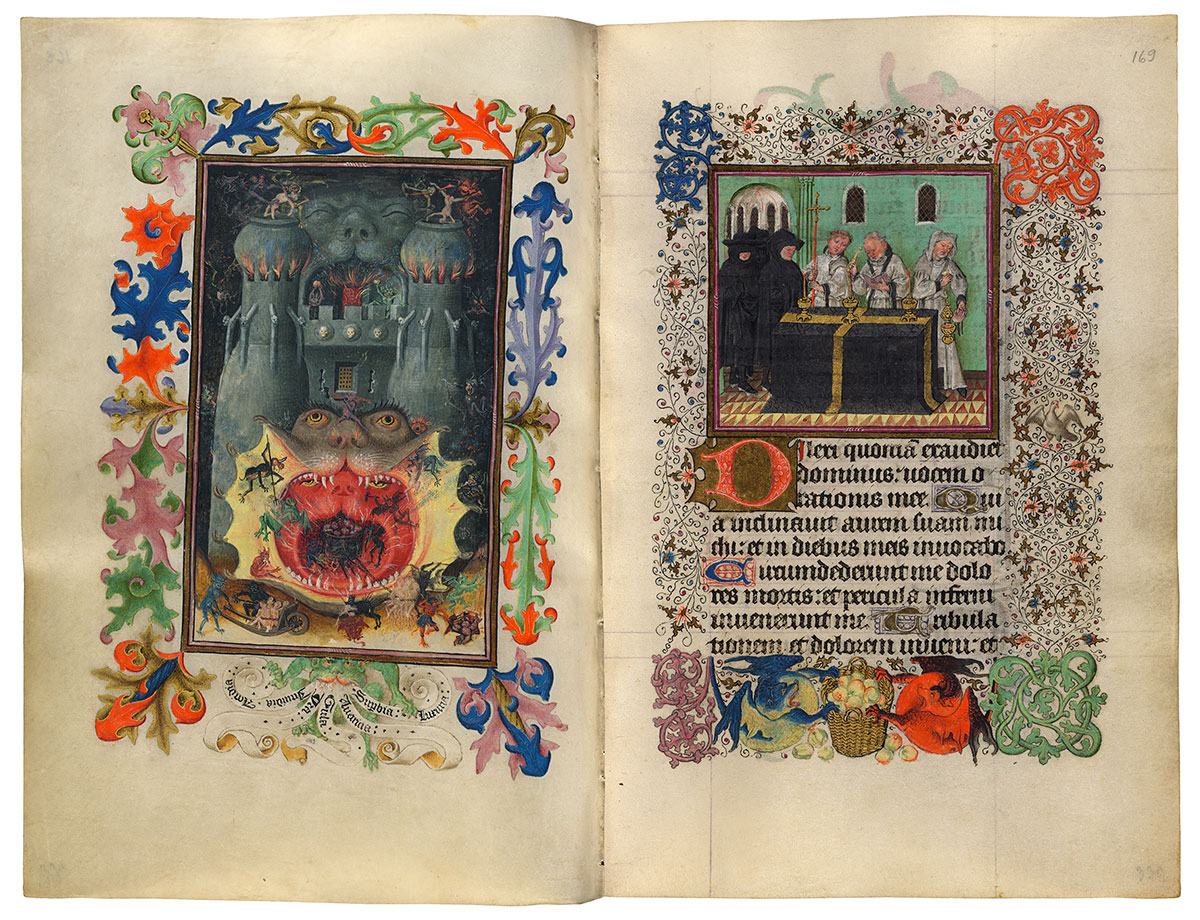
Mouth of Hell
Final Absolution
Purchased on the Belle da Costa Greene Fund with the assistance of the Fellows and with special assistance of Mrs. Frederick B. Adams, Sr., Mrs. Robert Charles, Mr. Laurens M. Hamilton, The Heineman Foundation, Mrs. Donald F. Hyde, Mrs. Jacob M. Kaplan, Mrs. John Kean, Mr. Paul Mellon, Mr. and Mrs. Charles F. Morgan, Mr. Lessing J. Rosenwald, Mr. and Mrs. August H. Schilling, Mrs. Herbert N. Straus, Mrs. Landon K. Thorne, Mrs. Alan Valentine, Mr. and Mrs. Arnold Whitridge, and Miss Julia P. Wightman, 1970
There is no more inventive—or scary—miniature in Catherine's prayer book than this full-page depiction of hell. A gaping lion's mouth opens its batlike lips tipped with talons; inside is another, red-hot maw. Demons cast damned souls into this terrifying entrance to the furnace of hell, above which rises the castle of death decorated with skulls. Burning towers heat caldrons into which mutilated souls are pitched. A third mouth forms the domed roof. At the bottom crouches a green demon whose mouth sprouts scrolls inscribed with the Seven Deadly Sins. In the smaller miniature, the holy water and incense offered by the priest to a corpse seem like scant protection for the potential horrors depicted in the facing image.
Office of the Dead
The Office of the Dead was in the back of every Book of Hours the way death itself was always at the back of the medieval mind. While the other prayers in a Book of Hours are quasi-liturgical (reflecting but not equaling official Church practice), the Office of the Dead is identical to that found in the service books used by the Church's ordained.
It was assumed that most people's entry into heaven would be delayed by a detour (lasting, potentially, thousands of years) in purgatory, the fires of which cleansed the soul of unforgiven sin. Praying the Office of the Dead for one's deceased friends or relatives—who could not pray for themselves—was one of the more efficacious means of reducing for them the fiery price of paradise. Recited at funerals, the Office of the Dead was also ideally prayed every day.
The three Hours of the Office (Vespers, Matins, and Lauds) consist of psalms plus a series of moving readings from the Old Testament Book of Job. The trials endured by Job become an allegory for one's time on earth—and in purgatory. The voice of Job, crying for pity and mercy, becomes the voice of the dead.
Image courtesy of Faksimile Verlag Luzern
MS M.917/945, ff. 169v–170r
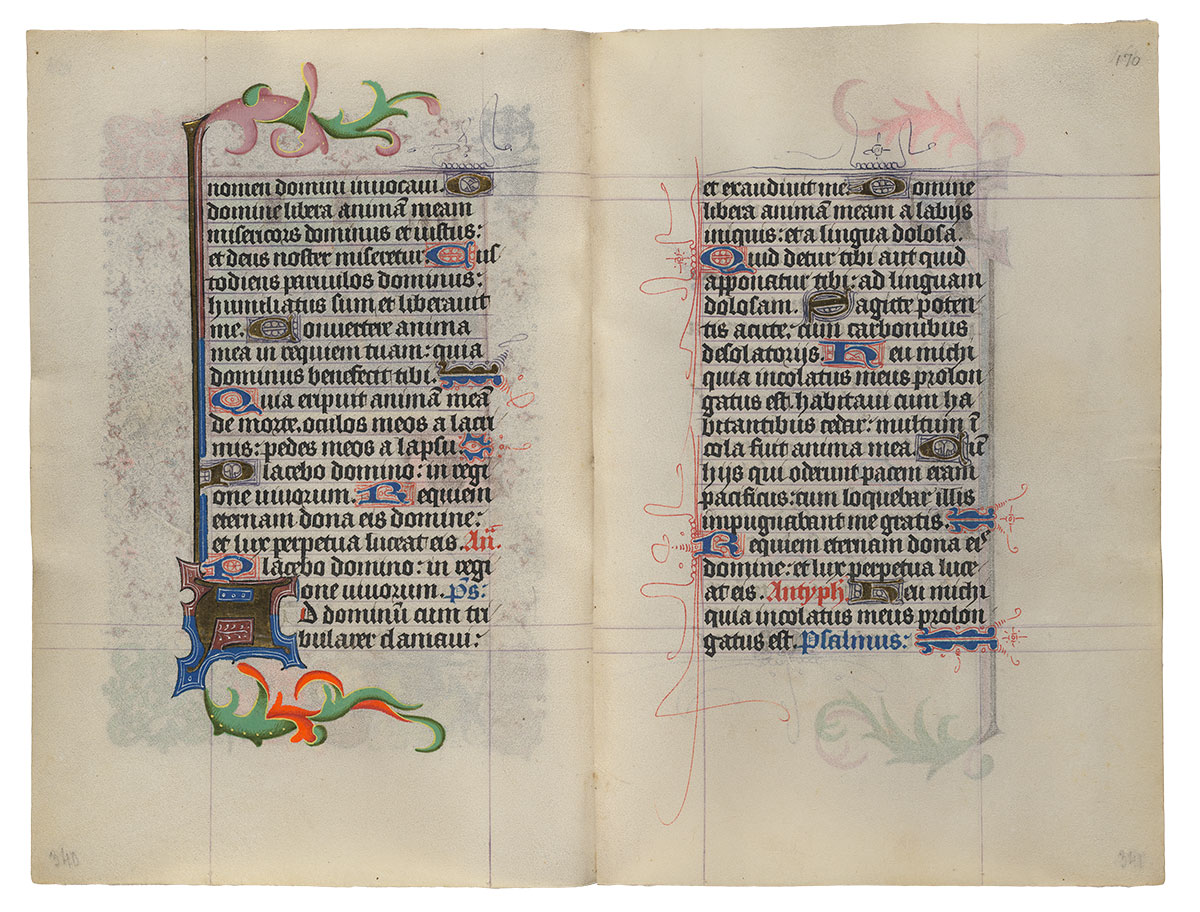
Purchased on the Belle da Costa Greene Fund with the assistance of the Fellows and with special assistance of Mrs. Frederick B. Adams, Sr., Mrs. Robert Charles, Mr. Laurens M. Hamilton, The Heineman Foundation, Mrs. Donald F. Hyde, Mrs. Jacob M. Kaplan, Mrs. John Kean, Mr. Paul Mellon, Mr. and Mrs. Charles F. Morgan, Mr. Lessing J. Rosenwald, Mr. and Mrs. August H. Schilling, Mrs. Herbert N. Straus, Mrs. Landon K. Thorne, Mrs. Alan Valentine, Mr. and Mrs. Arnold Whitridge, and Miss Julia P. Wightman, 1970
Image courtesy of Faksimile Verlag Luzern
MS M.917/945, ff. 170v–171r
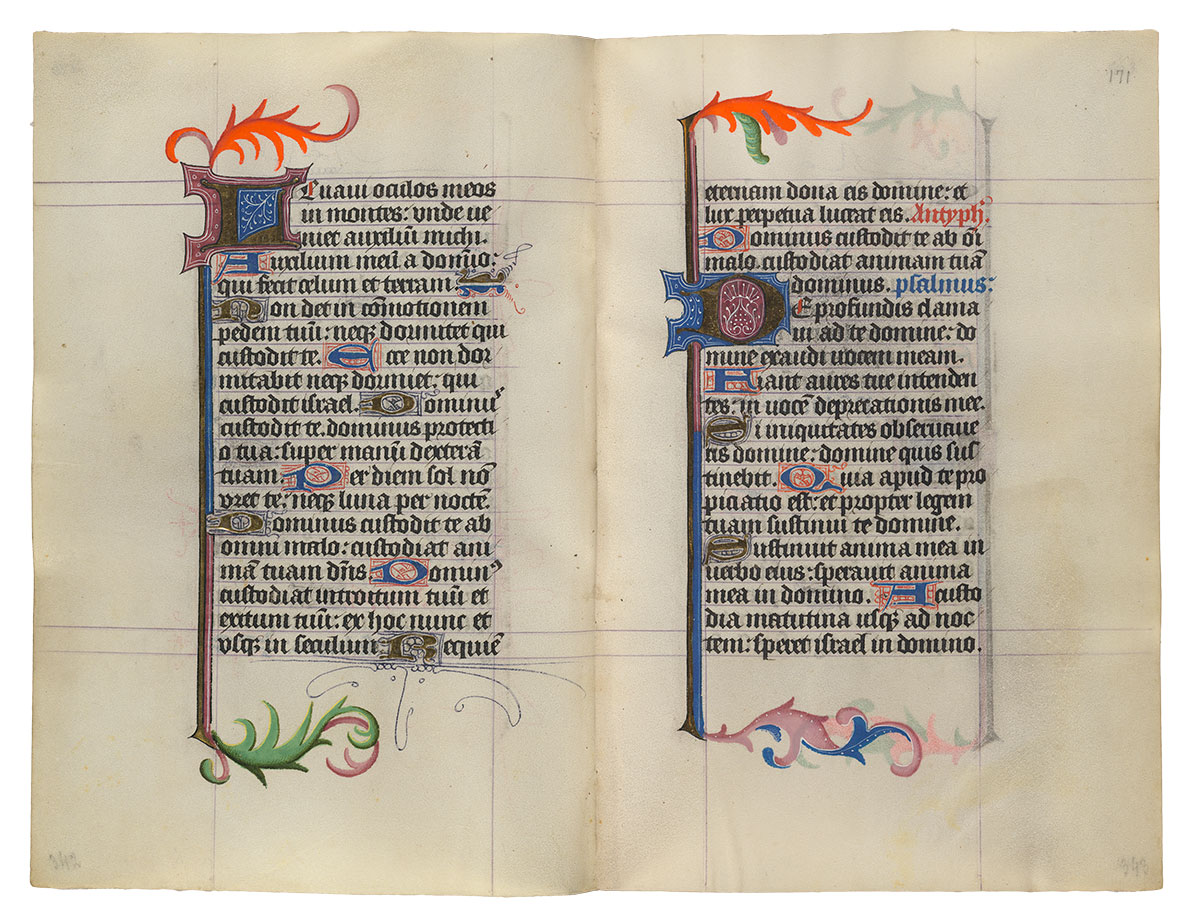
Purchased on the Belle da Costa Greene Fund with the assistance of the Fellows and with special assistance of Mrs. Frederick B. Adams, Sr., Mrs. Robert Charles, Mr. Laurens M. Hamilton, The Heineman Foundation, Mrs. Donald F. Hyde, Mrs. Jacob M. Kaplan, Mrs. John Kean, Mr. Paul Mellon, Mr. and Mrs. Charles F. Morgan, Mr. Lessing J. Rosenwald, Mr. and Mrs. August H. Schilling, Mrs. Herbert N. Straus, Mrs. Landon K. Thorne, Mrs. Alan Valentine, Mr. and Mrs. Arnold Whitridge, and Miss Julia P. Wightman, 1970
Image courtesy of Faksimile Verlag Luzern
MS M.917/945, ff. 171v–172r
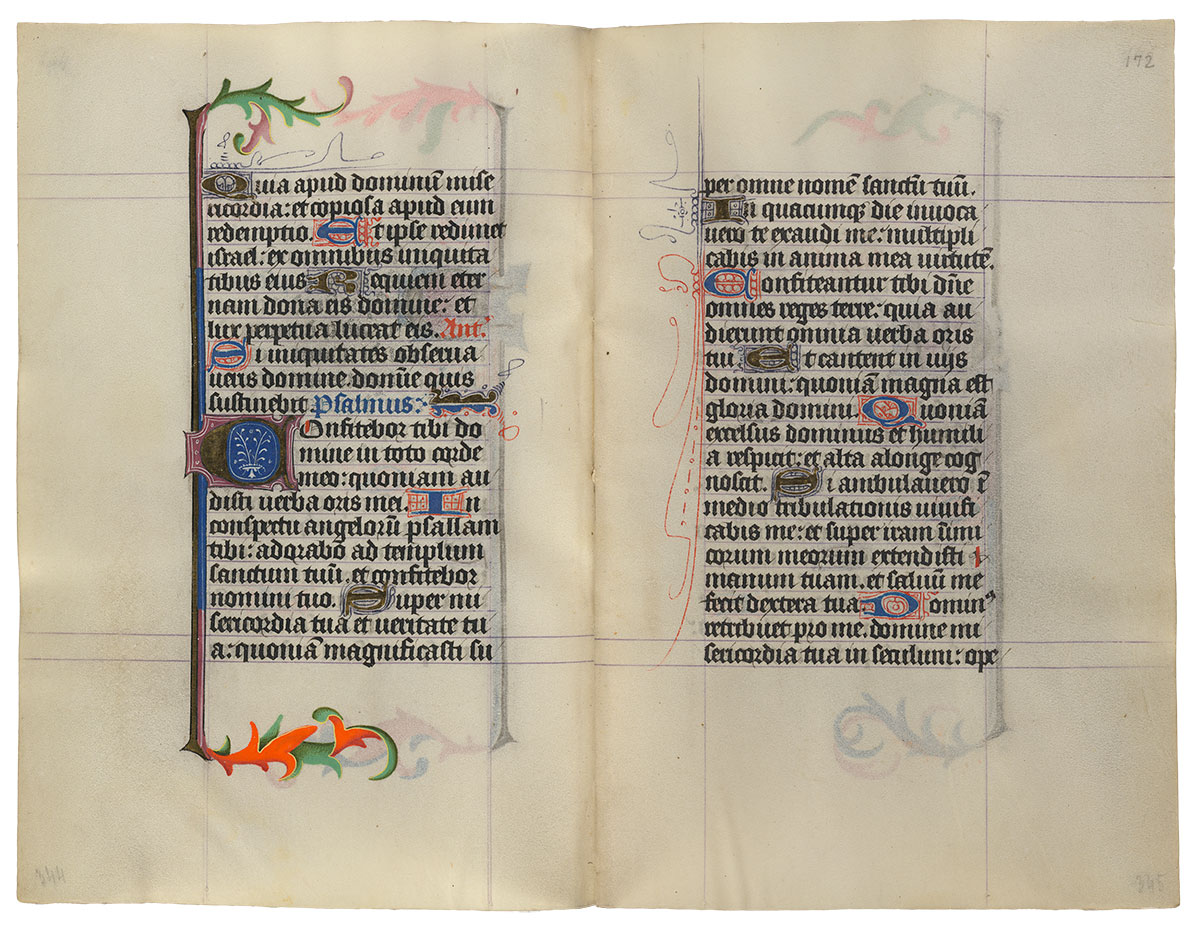
Purchased on the Belle da Costa Greene Fund with the assistance of the Fellows and with special assistance of Mrs. Frederick B. Adams, Sr., Mrs. Robert Charles, Mr. Laurens M. Hamilton, The Heineman Foundation, Mrs. Donald F. Hyde, Mrs. Jacob M. Kaplan, Mrs. John Kean, Mr. Paul Mellon, Mr. and Mrs. Charles F. Morgan, Mr. Lessing J. Rosenwald, Mr. and Mrs. August H. Schilling, Mrs. Herbert N. Straus, Mrs. Landon K. Thorne, Mrs. Alan Valentine, Mr. and Mrs. Arnold Whitridge, and Miss Julia P. Wightman, 1970
Image courtesy of Faksimile Verlag Luzern
MS M.917/945, ff. 172v–173r
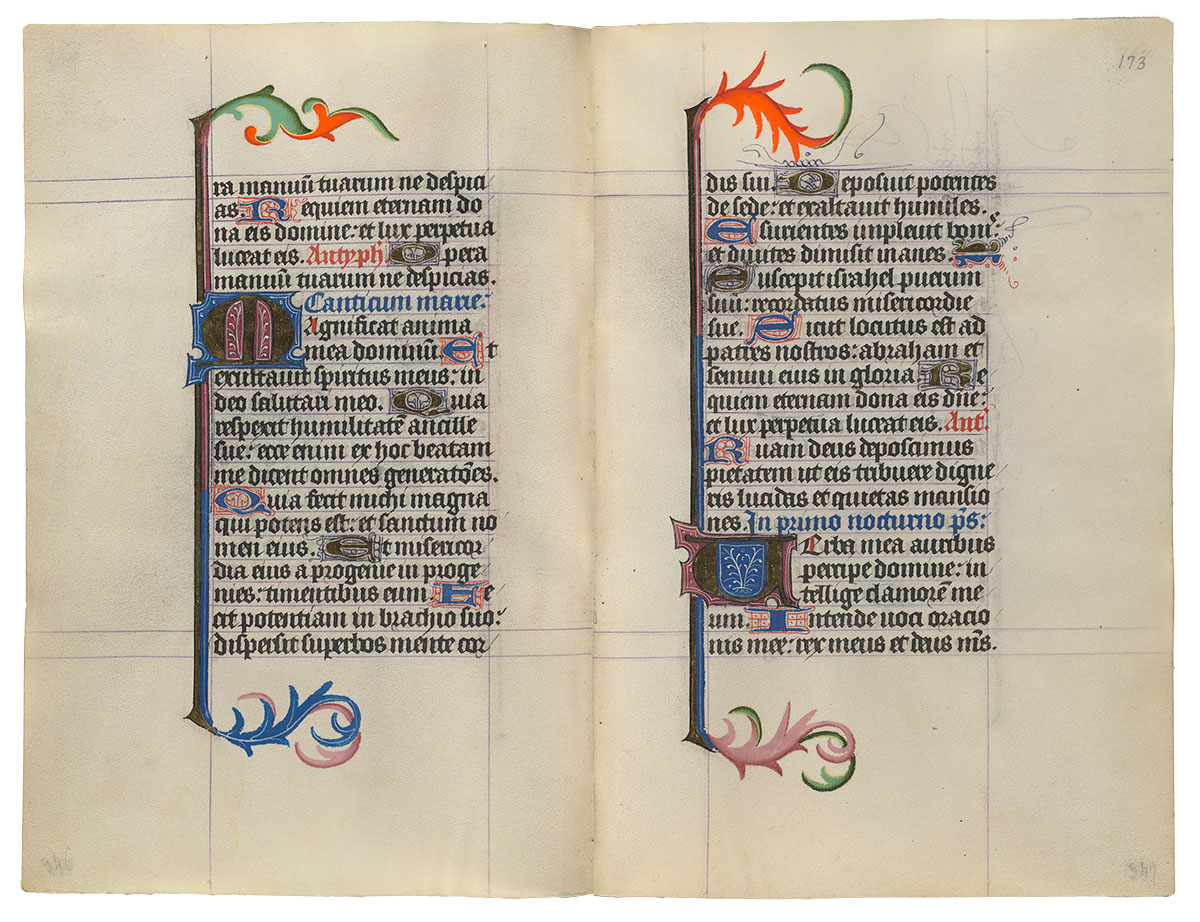
Purchased on the Belle da Costa Greene Fund with the assistance of the Fellows and with special assistance of Mrs. Frederick B. Adams, Sr., Mrs. Robert Charles, Mr. Laurens M. Hamilton, The Heineman Foundation, Mrs. Donald F. Hyde, Mrs. Jacob M. Kaplan, Mrs. John Kean, Mr. Paul Mellon, Mr. and Mrs. Charles F. Morgan, Mr. Lessing J. Rosenwald, Mr. and Mrs. August H. Schilling, Mrs. Herbert N. Straus, Mrs. Landon K. Thorne, Mrs. Alan Valentine, Mr. and Mrs. Arnold Whitridge, and Miss Julia P. Wightman, 1970
Image courtesy of Faksimile Verlag Luzern
MS M.917/945, ff. 173v–174r
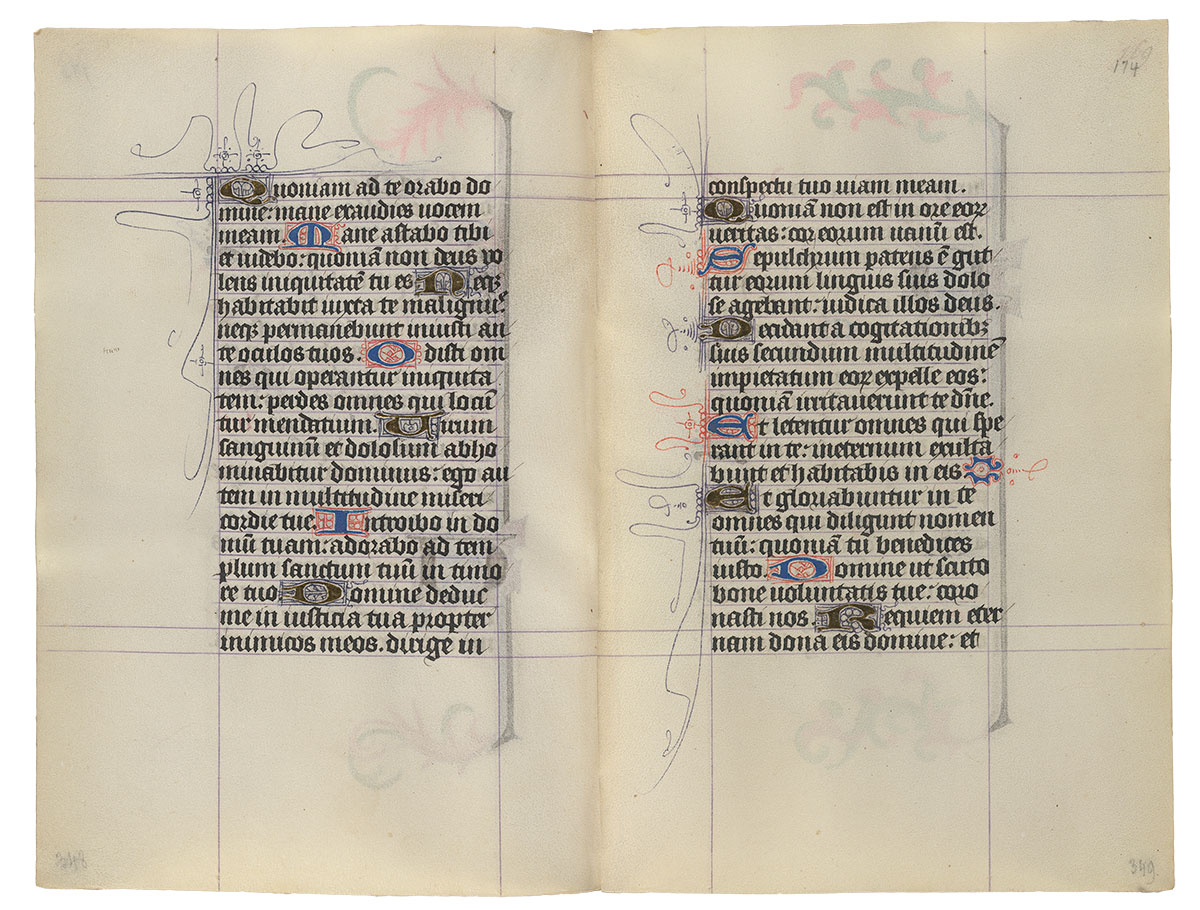
Purchased on the Belle da Costa Greene Fund with the assistance of the Fellows and with special assistance of Mrs. Frederick B. Adams, Sr., Mrs. Robert Charles, Mr. Laurens M. Hamilton, The Heineman Foundation, Mrs. Donald F. Hyde, Mrs. Jacob M. Kaplan, Mrs. John Kean, Mr. Paul Mellon, Mr. and Mrs. Charles F. Morgan, Mr. Lessing J. Rosenwald, Mr. and Mrs. August H. Schilling, Mrs. Herbert N. Straus, Mrs. Landon K. Thorne, Mrs. Alan Valentine, Mr. and Mrs. Arnold Whitridge, and Miss Julia P. Wightman, 1970
Image courtesy of Faksimile Verlag Luzern
MS M.917/945, ff. 174v–175r
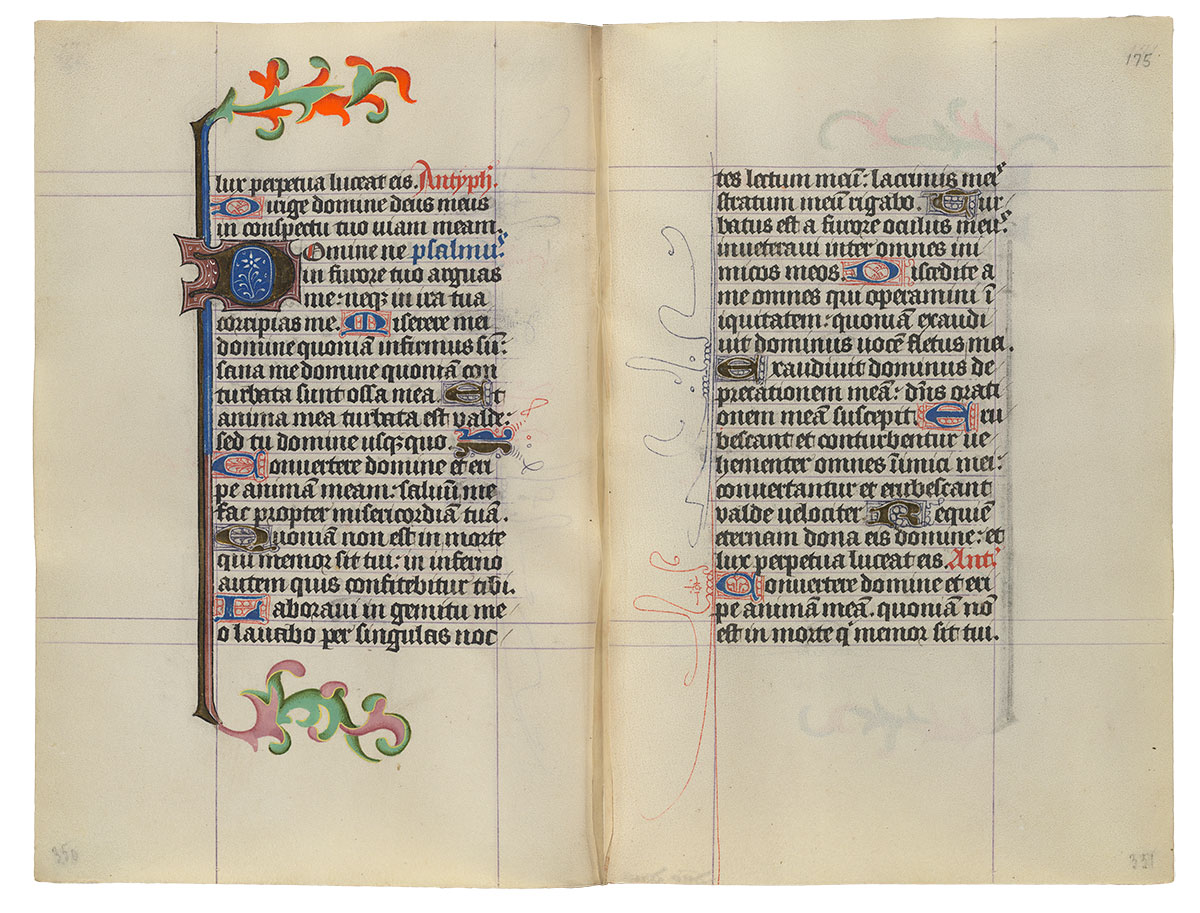
Purchased on the Belle da Costa Greene Fund with the assistance of the Fellows and with special assistance of Mrs. Frederick B. Adams, Sr., Mrs. Robert Charles, Mr. Laurens M. Hamilton, The Heineman Foundation, Mrs. Donald F. Hyde, Mrs. Jacob M. Kaplan, Mrs. John Kean, Mr. Paul Mellon, Mr. and Mrs. Charles F. Morgan, Mr. Lessing J. Rosenwald, Mr. and Mrs. August H. Schilling, Mrs. Herbert N. Straus, Mrs. Landon K. Thorne, Mrs. Alan Valentine, Mr. and Mrs. Arnold Whitridge, and Miss Julia P. Wightman, 1970
Image courtesy of Faksimile Verlag Luzern
MS M.917/945, ff. 175v–176r
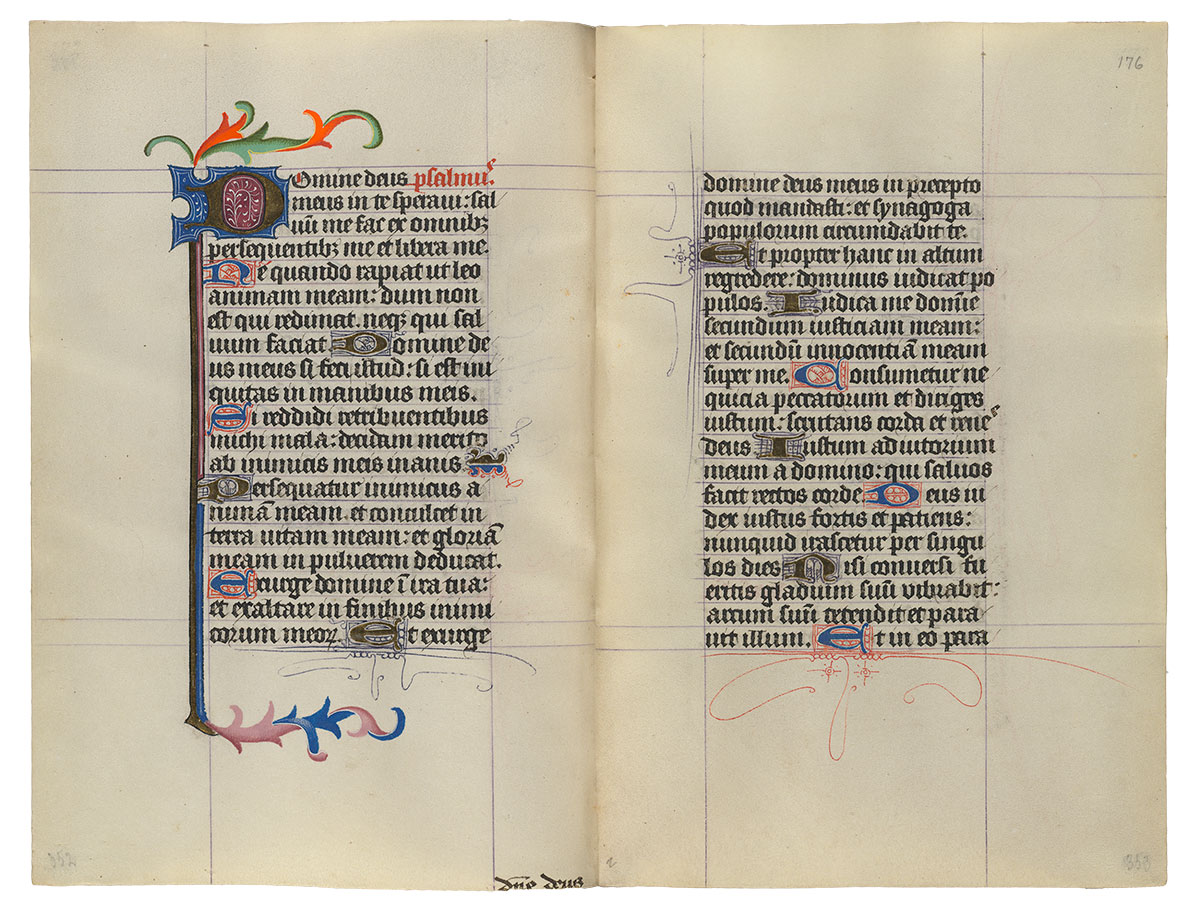
Purchased on the Belle da Costa Greene Fund with the assistance of the Fellows and with special assistance of Mrs. Frederick B. Adams, Sr., Mrs. Robert Charles, Mr. Laurens M. Hamilton, The Heineman Foundation, Mrs. Donald F. Hyde, Mrs. Jacob M. Kaplan, Mrs. John Kean, Mr. Paul Mellon, Mr. and Mrs. Charles F. Morgan, Mr. Lessing J. Rosenwald, Mr. and Mrs. August H. Schilling, Mrs. Herbert N. Straus, Mrs. Landon K. Thorne, Mrs. Alan Valentine, Mr. and Mrs. Arnold Whitridge, and Miss Julia P. Wightman, 1970
Image courtesy of Faksimile Verlag Luzern
MS M.917/945, ff. 176v–177r
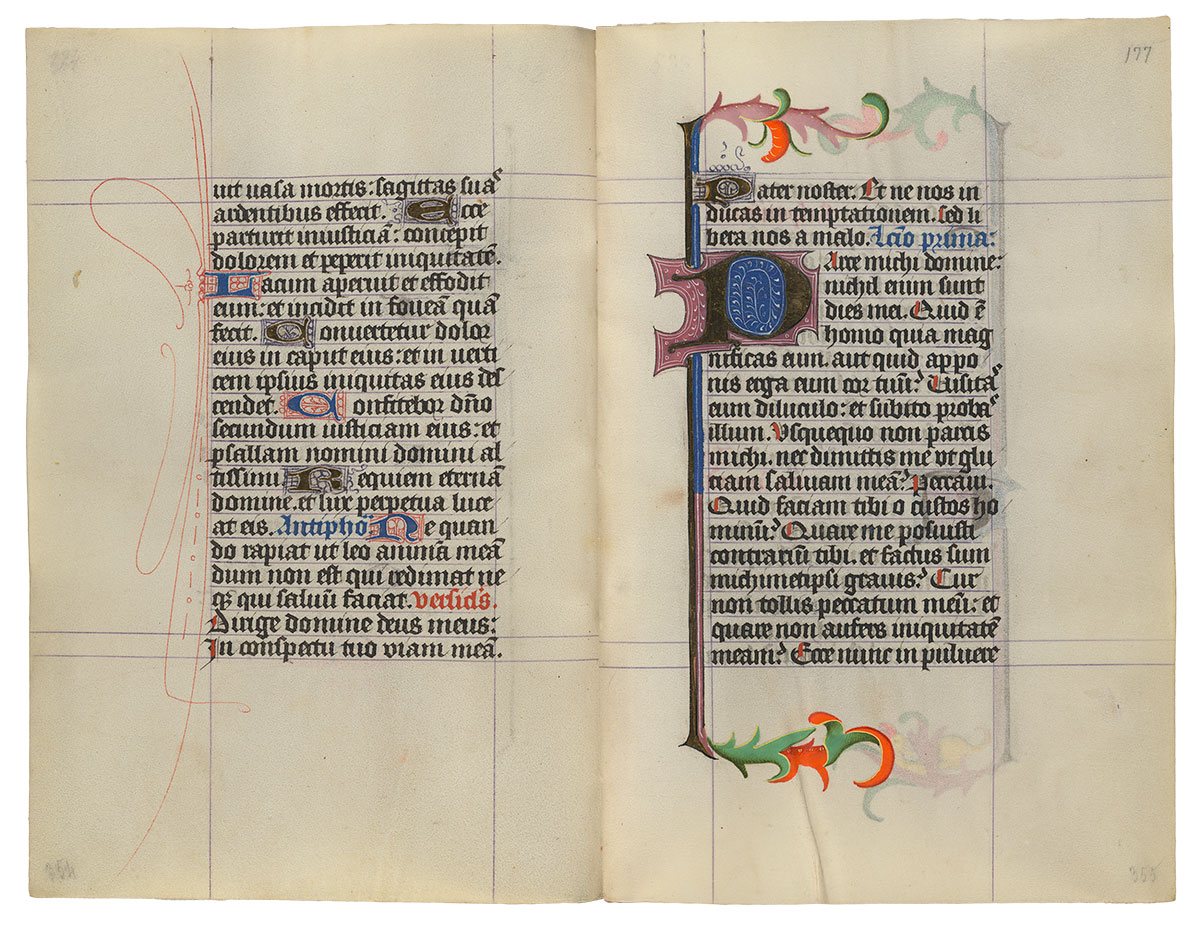
Purchased on the Belle da Costa Greene Fund with the assistance of the Fellows and with special assistance of Mrs. Frederick B. Adams, Sr., Mrs. Robert Charles, Mr. Laurens M. Hamilton, The Heineman Foundation, Mrs. Donald F. Hyde, Mrs. Jacob M. Kaplan, Mrs. John Kean, Mr. Paul Mellon, Mr. and Mrs. Charles F. Morgan, Mr. Lessing J. Rosenwald, Mr. and Mrs. August H. Schilling, Mrs. Herbert N. Straus, Mrs. Landon K. Thorne, Mrs. Alan Valentine, Mr. and Mrs. Arnold Whitridge, and Miss Julia P. Wightman, 1970
Image courtesy of Faksimile Verlag Luzern
MS M.917/945, ff. 177v–178r
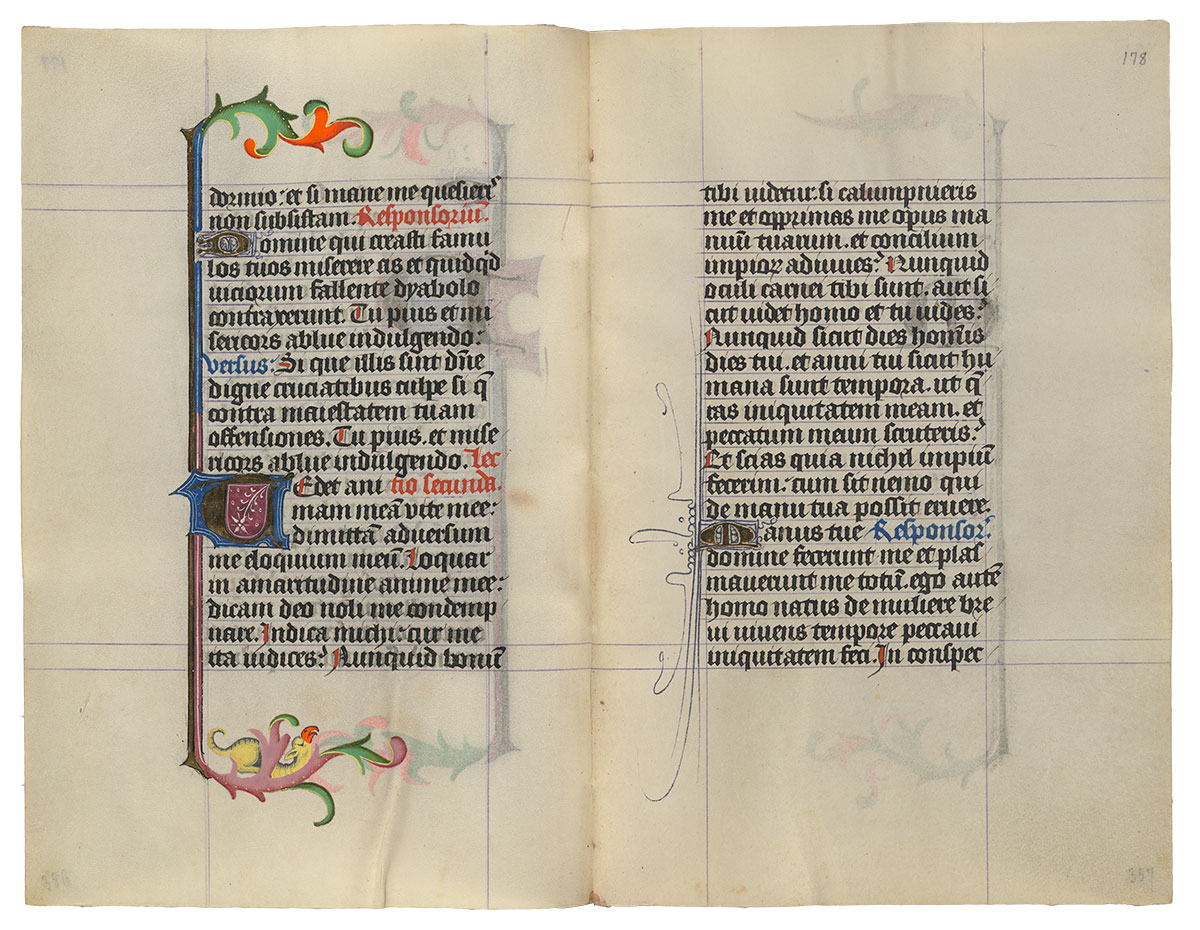
Purchased on the Belle da Costa Greene Fund with the assistance of the Fellows and with special assistance of Mrs. Frederick B. Adams, Sr., Mrs. Robert Charles, Mr. Laurens M. Hamilton, The Heineman Foundation, Mrs. Donald F. Hyde, Mrs. Jacob M. Kaplan, Mrs. John Kean, Mr. Paul Mellon, Mr. and Mrs. Charles F. Morgan, Mr. Lessing J. Rosenwald, Mr. and Mrs. August H. Schilling, Mrs. Herbert N. Straus, Mrs. Landon K. Thorne, Mrs. Alan Valentine, Mr. and Mrs. Arnold Whitridge, and Miss Julia P. Wightman, 1970
Image courtesy of Faksimile Verlag Luzern
MS M.917/945, ff. 178v–179r

Purchased on the Belle da Costa Greene Fund with the assistance of the Fellows and with special assistance of Mrs. Frederick B. Adams, Sr., Mrs. Robert Charles, Mr. Laurens M. Hamilton, The Heineman Foundation, Mrs. Donald F. Hyde, Mrs. Jacob M. Kaplan, Mrs. John Kean, Mr. Paul Mellon, Mr. and Mrs. Charles F. Morgan, Mr. Lessing J. Rosenwald, Mr. and Mrs. August H. Schilling, Mrs. Herbert N. Straus, Mrs. Landon K. Thorne, Mrs. Alan Valentine, Mr. and Mrs. Arnold Whitridge, and Miss Julia P. Wightman, 1970
Image courtesy of Faksimile Verlag Luzern
MS M.917/945, ff. 179v–180r
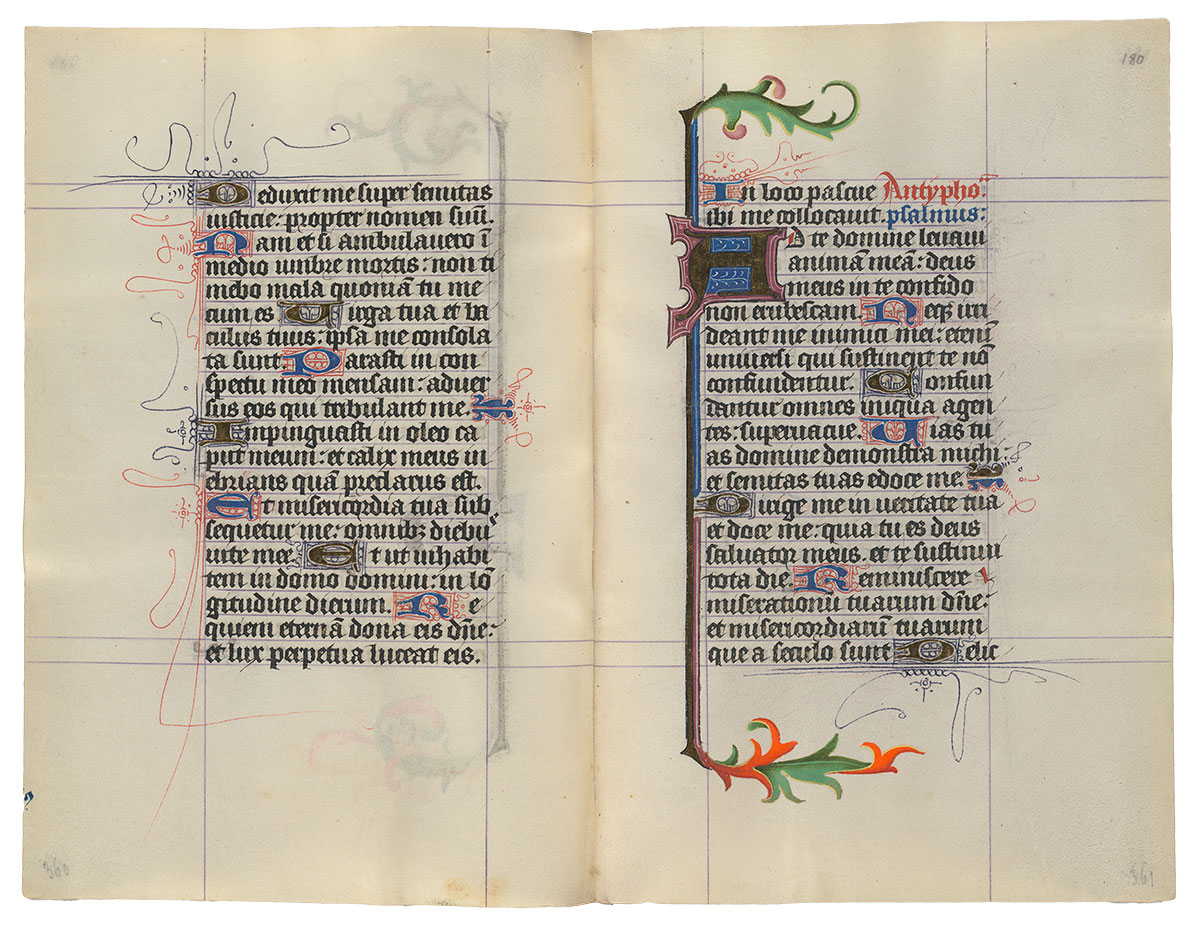
Purchased on the Belle da Costa Greene Fund with the assistance of the Fellows and with special assistance of Mrs. Frederick B. Adams, Sr., Mrs. Robert Charles, Mr. Laurens M. Hamilton, The Heineman Foundation, Mrs. Donald F. Hyde, Mrs. Jacob M. Kaplan, Mrs. John Kean, Mr. Paul Mellon, Mr. and Mrs. Charles F. Morgan, Mr. Lessing J. Rosenwald, Mr. and Mrs. August H. Schilling, Mrs. Herbert N. Straus, Mrs. Landon K. Thorne, Mrs. Alan Valentine, Mr. and Mrs. Arnold Whitridge, and Miss Julia P. Wightman, 1970
Image courtesy of Faksimile Verlag Luzern
MS M.917/945, ff. 180v–181r
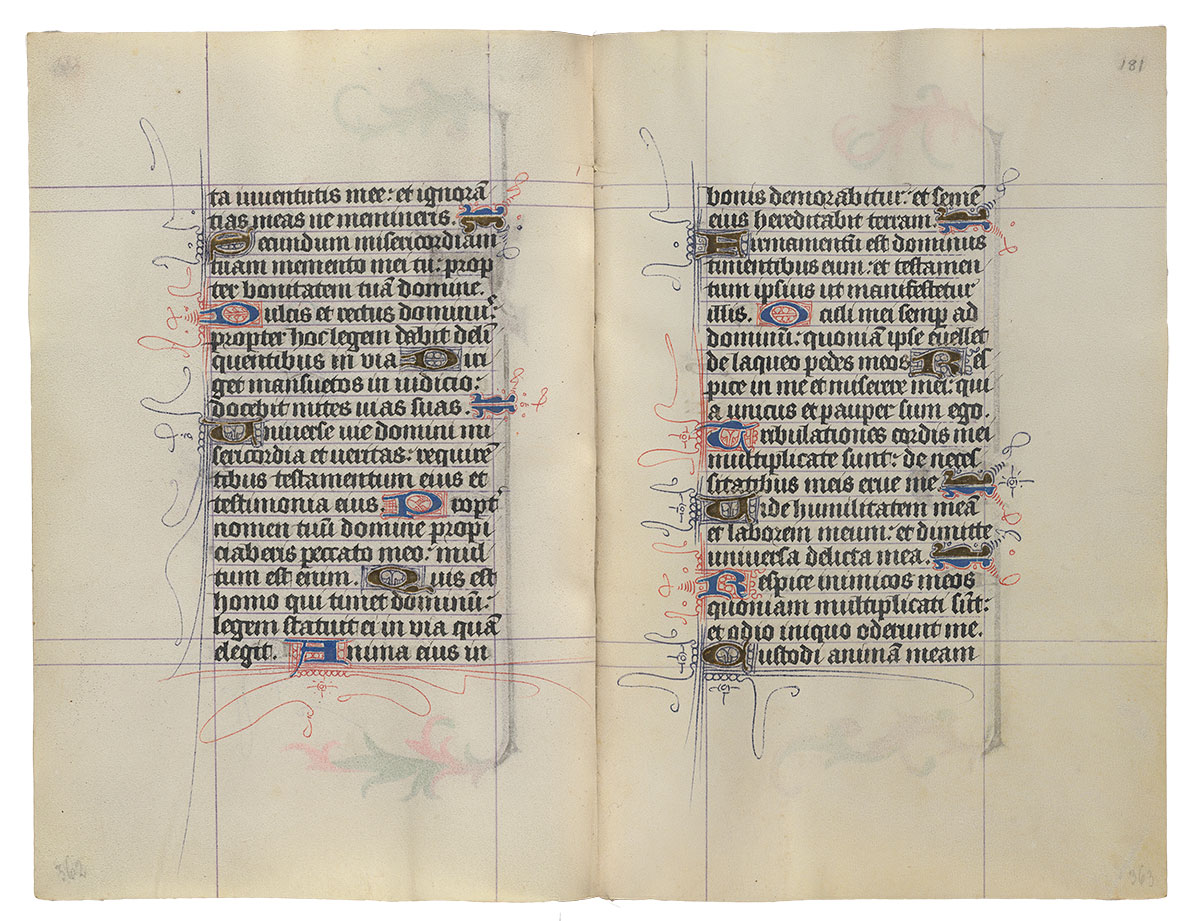
Purchased on the Belle da Costa Greene Fund with the assistance of the Fellows and with special assistance of Mrs. Frederick B. Adams, Sr., Mrs. Robert Charles, Mr. Laurens M. Hamilton, The Heineman Foundation, Mrs. Donald F. Hyde, Mrs. Jacob M. Kaplan, Mrs. John Kean, Mr. Paul Mellon, Mr. and Mrs. Charles F. Morgan, Mr. Lessing J. Rosenwald, Mr. and Mrs. August H. Schilling, Mrs. Herbert N. Straus, Mrs. Landon K. Thorne, Mrs. Alan Valentine, Mr. and Mrs. Arnold Whitridge, and Miss Julia P. Wightman, 1970
Image courtesy of Faksimile Verlag Luzern
MS M.917/945, ff. 181v–182r
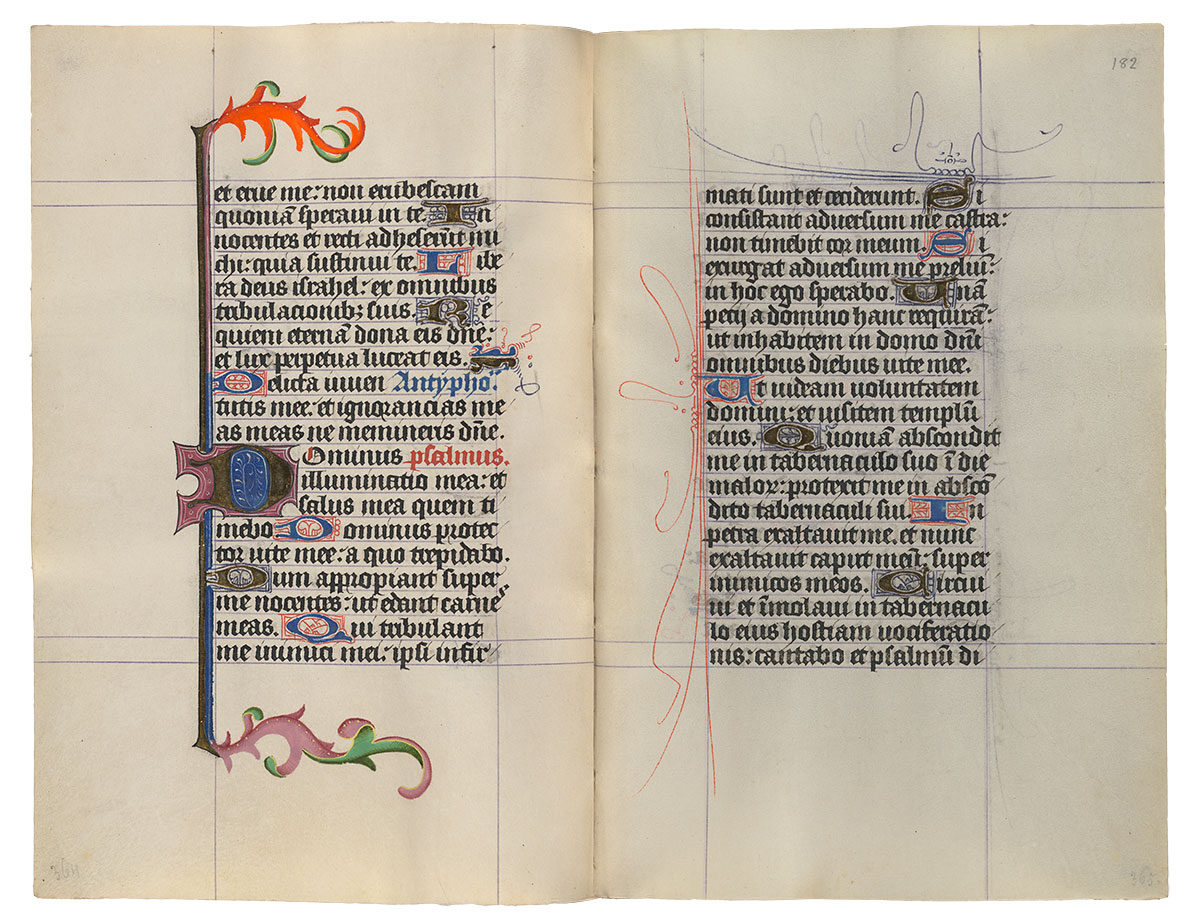
Purchased on the Belle da Costa Greene Fund with the assistance of the Fellows and with special assistance of Mrs. Frederick B. Adams, Sr., Mrs. Robert Charles, Mr. Laurens M. Hamilton, The Heineman Foundation, Mrs. Donald F. Hyde, Mrs. Jacob M. Kaplan, Mrs. John Kean, Mr. Paul Mellon, Mr. and Mrs. Charles F. Morgan, Mr. Lessing J. Rosenwald, Mr. and Mrs. August H. Schilling, Mrs. Herbert N. Straus, Mrs. Landon K. Thorne, Mrs. Alan Valentine, Mr. and Mrs. Arnold Whitridge, and Miss Julia P. Wightman, 1970
Image courtesy of Faksimile Verlag Luzern
MS M.917/945, ff. 182v–183r
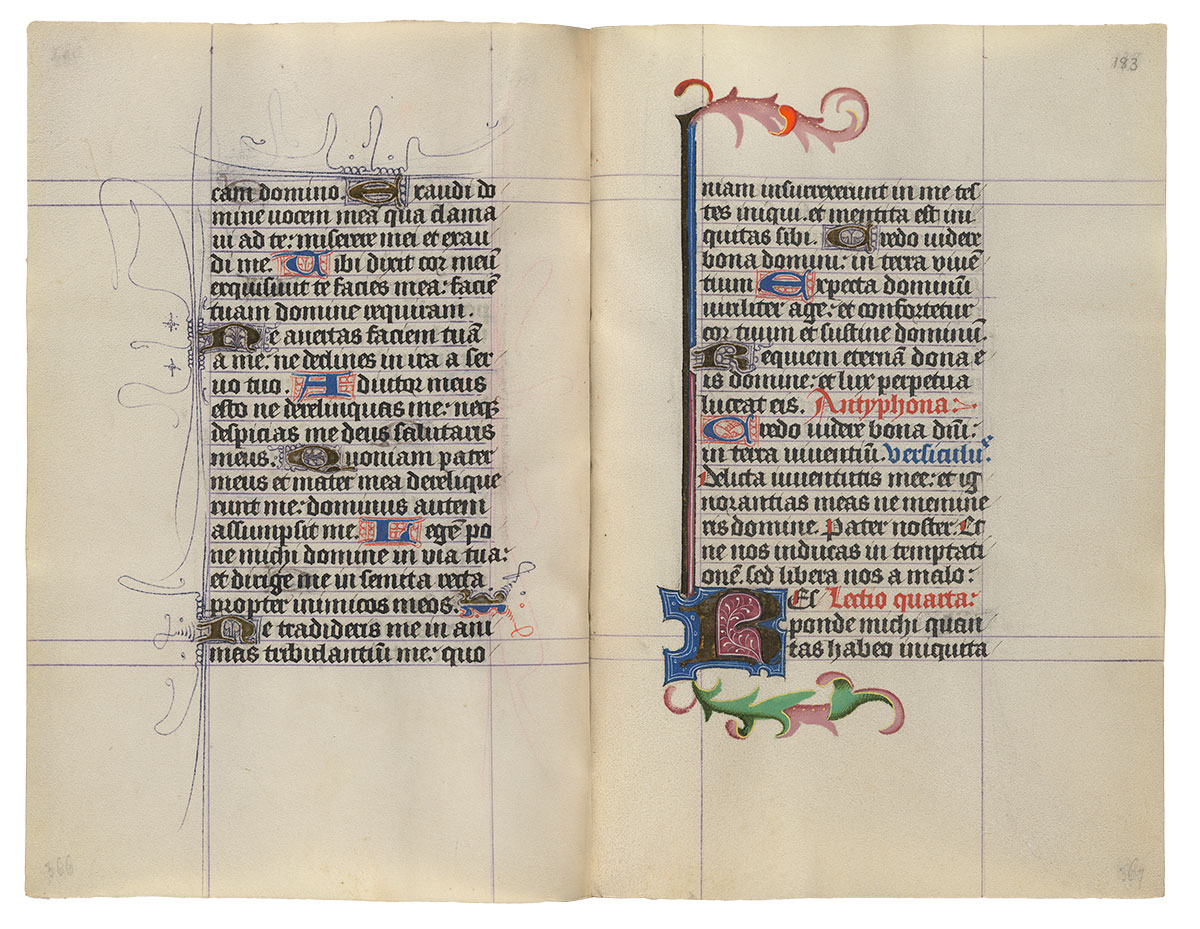
Purchased on the Belle da Costa Greene Fund with the assistance of the Fellows and with special assistance of Mrs. Frederick B. Adams, Sr., Mrs. Robert Charles, Mr. Laurens M. Hamilton, The Heineman Foundation, Mrs. Donald F. Hyde, Mrs. Jacob M. Kaplan, Mrs. John Kean, Mr. Paul Mellon, Mr. and Mrs. Charles F. Morgan, Mr. Lessing J. Rosenwald, Mr. and Mrs. August H. Schilling, Mrs. Herbert N. Straus, Mrs. Landon K. Thorne, Mrs. Alan Valentine, Mr. and Mrs. Arnold Whitridge, and Miss Julia P. Wightman, 1970
Image courtesy of Faksimile Verlag Luzern
MS M.917/945, ff. 183v–184r
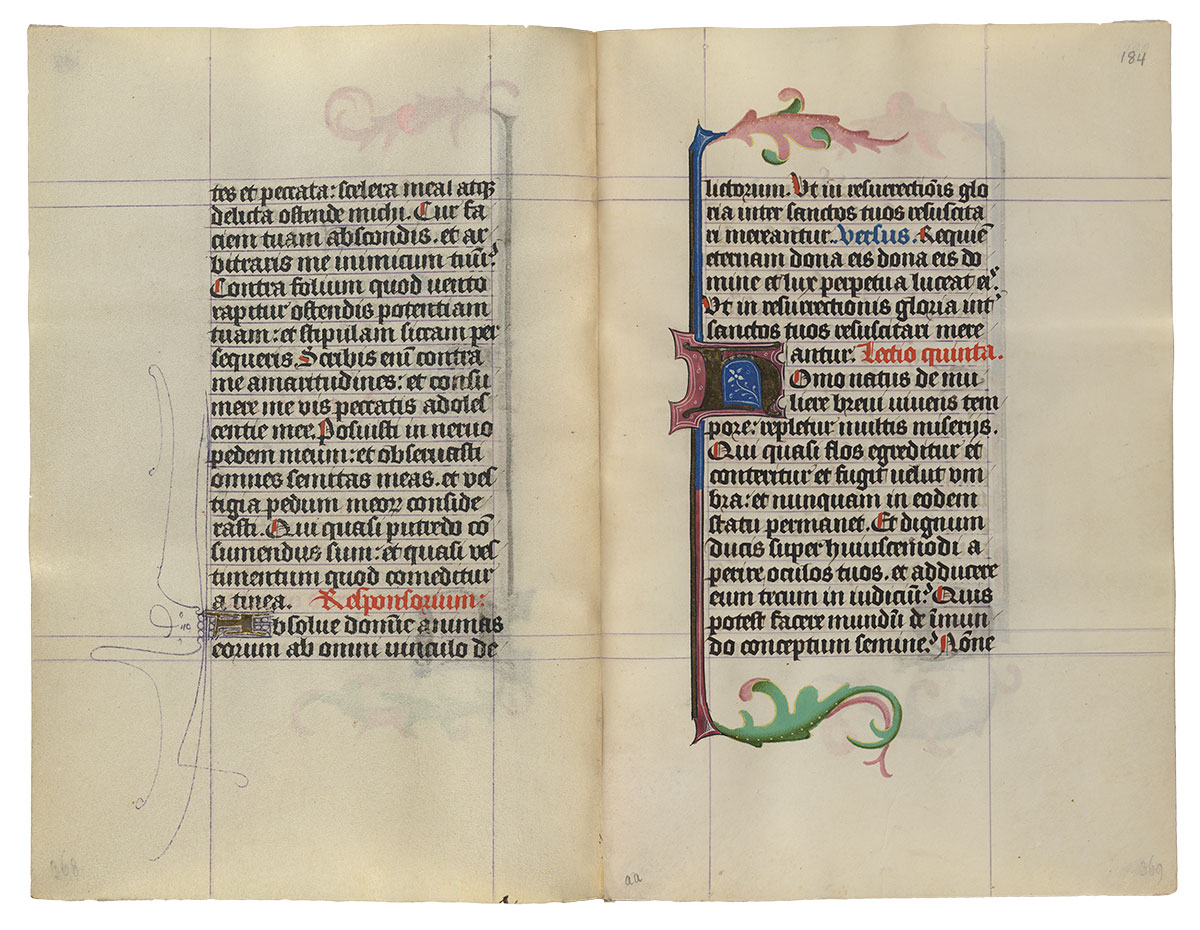
Purchased on the Belle da Costa Greene Fund with the assistance of the Fellows and with special assistance of Mrs. Frederick B. Adams, Sr., Mrs. Robert Charles, Mr. Laurens M. Hamilton, The Heineman Foundation, Mrs. Donald F. Hyde, Mrs. Jacob M. Kaplan, Mrs. John Kean, Mr. Paul Mellon, Mr. and Mrs. Charles F. Morgan, Mr. Lessing J. Rosenwald, Mr. and Mrs. August H. Schilling, Mrs. Herbert N. Straus, Mrs. Landon K. Thorne, Mrs. Alan Valentine, Mr. and Mrs. Arnold Whitridge, and Miss Julia P. Wightman, 1970
Image courtesy of Faksimile Verlag Luzern
MS M.917/945, ff. 184v–185r
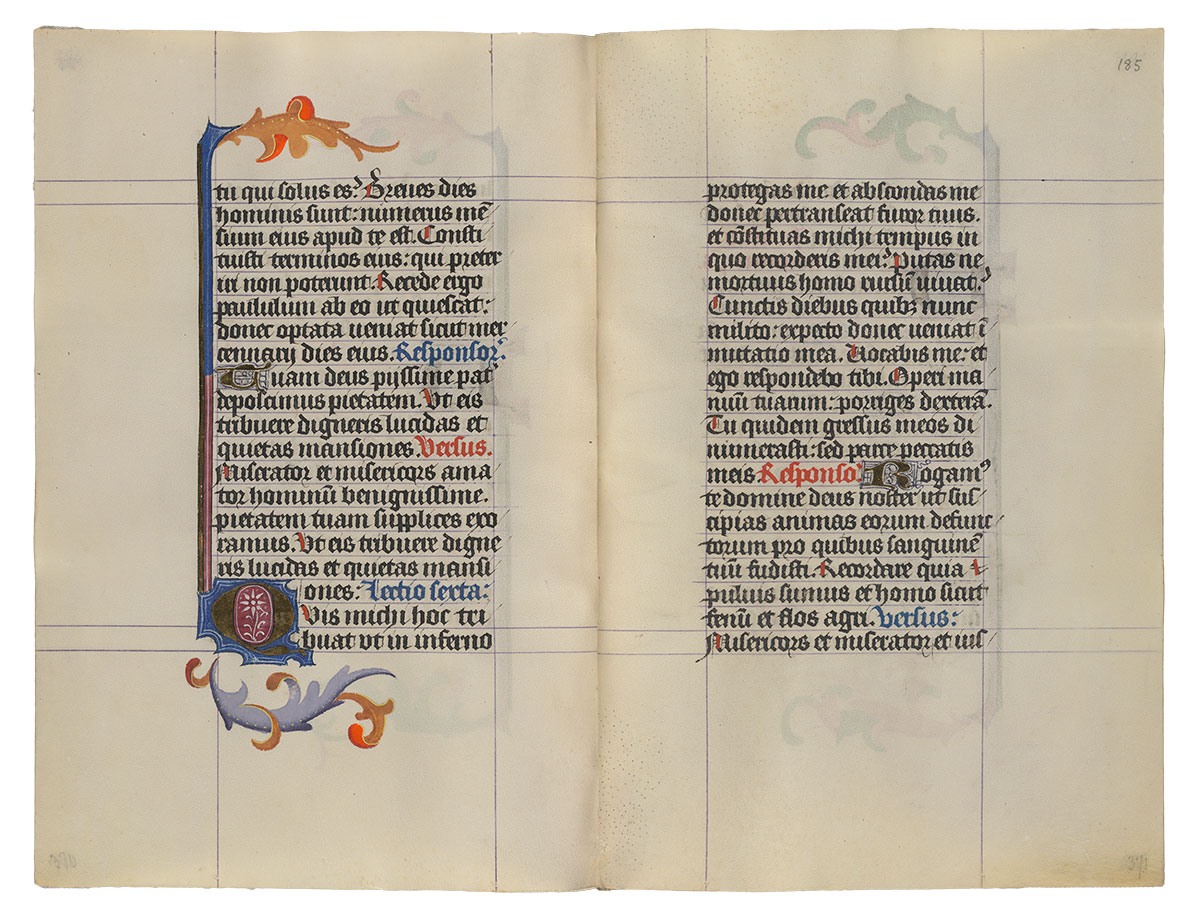
Purchased on the Belle da Costa Greene Fund with the assistance of the Fellows and with special assistance of Mrs. Frederick B. Adams, Sr., Mrs. Robert Charles, Mr. Laurens M. Hamilton, The Heineman Foundation, Mrs. Donald F. Hyde, Mrs. Jacob M. Kaplan, Mrs. John Kean, Mr. Paul Mellon, Mr. and Mrs. Charles F. Morgan, Mr. Lessing J. Rosenwald, Mr. and Mrs. August H. Schilling, Mrs. Herbert N. Straus, Mrs. Landon K. Thorne, Mrs. Alan Valentine, Mr. and Mrs. Arnold Whitridge, and Miss Julia P. Wightman, 1970
Image courtesy of Faksimile Verlag Luzern
MS M.917/945, ff. 185v–186r
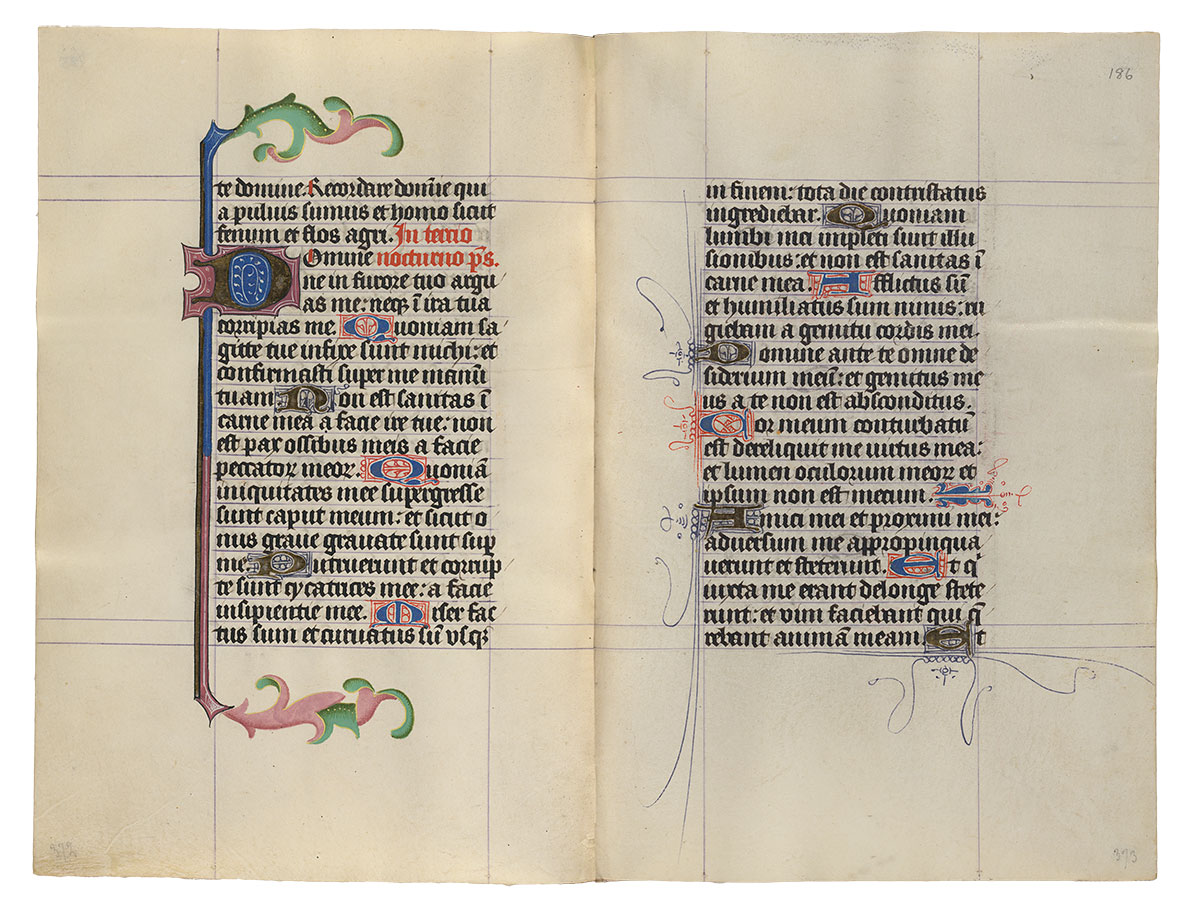
Purchased on the Belle da Costa Greene Fund with the assistance of the Fellows and with special assistance of Mrs. Frederick B. Adams, Sr., Mrs. Robert Charles, Mr. Laurens M. Hamilton, The Heineman Foundation, Mrs. Donald F. Hyde, Mrs. Jacob M. Kaplan, Mrs. John Kean, Mr. Paul Mellon, Mr. and Mrs. Charles F. Morgan, Mr. Lessing J. Rosenwald, Mr. and Mrs. August H. Schilling, Mrs. Herbert N. Straus, Mrs. Landon K. Thorne, Mrs. Alan Valentine, Mr. and Mrs. Arnold Whitridge, and Miss Julia P. Wightman, 1970
Image courtesy of Faksimile Verlag Luzern
MS M.917/945, ff. 186v–187r
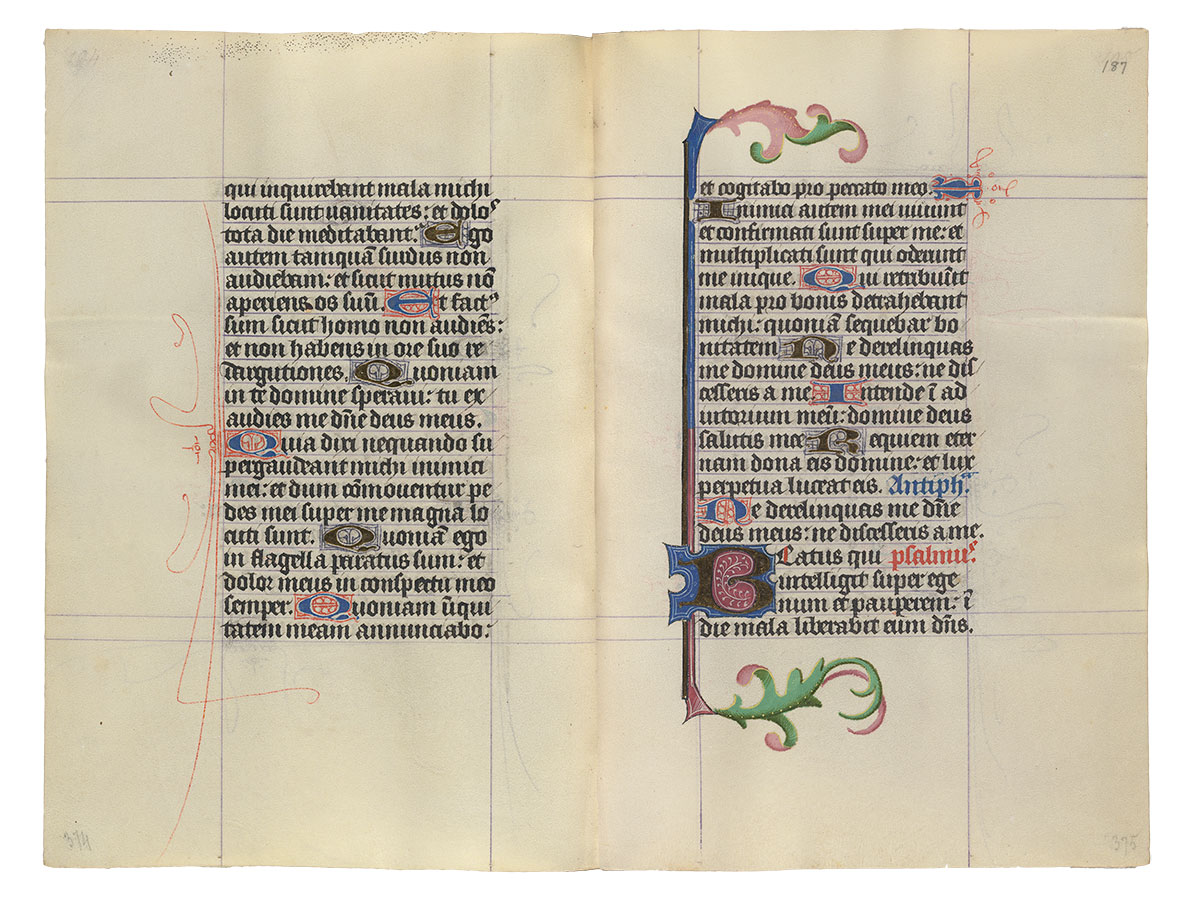
Purchased on the Belle da Costa Greene Fund with the assistance of the Fellows and with special assistance of Mrs. Frederick B. Adams, Sr., Mrs. Robert Charles, Mr. Laurens M. Hamilton, The Heineman Foundation, Mrs. Donald F. Hyde, Mrs. Jacob M. Kaplan, Mrs. John Kean, Mr. Paul Mellon, Mr. and Mrs. Charles F. Morgan, Mr. Lessing J. Rosenwald, Mr. and Mrs. August H. Schilling, Mrs. Herbert N. Straus, Mrs. Landon K. Thorne, Mrs. Alan Valentine, Mr. and Mrs. Arnold Whitridge, and Miss Julia P. Wightman, 1970
Image courtesy of Faksimile Verlag Luzern
MS M.917/945, ff. 187v–188r
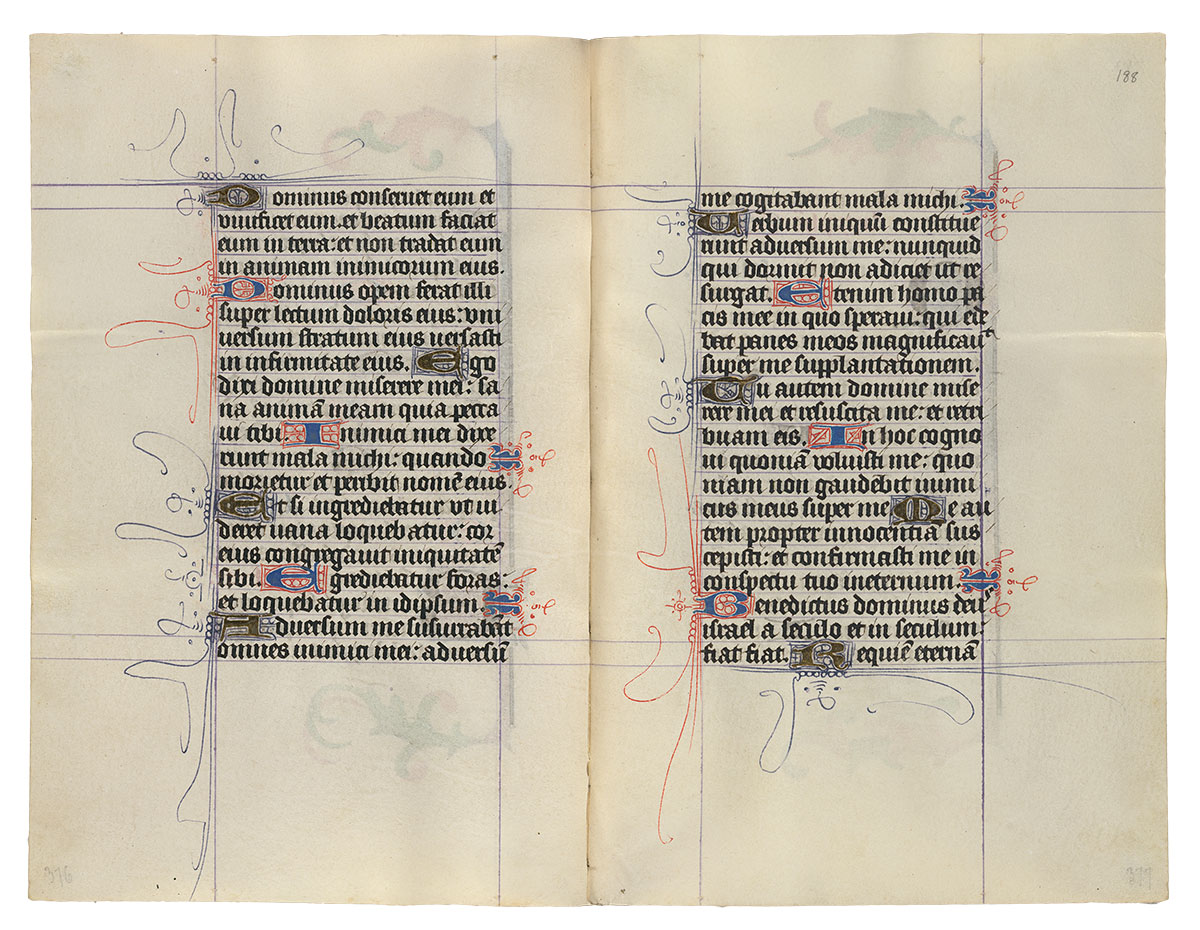
Purchased on the Belle da Costa Greene Fund with the assistance of the Fellows and with special assistance of Mrs. Frederick B. Adams, Sr., Mrs. Robert Charles, Mr. Laurens M. Hamilton, The Heineman Foundation, Mrs. Donald F. Hyde, Mrs. Jacob M. Kaplan, Mrs. John Kean, Mr. Paul Mellon, Mr. and Mrs. Charles F. Morgan, Mr. Lessing J. Rosenwald, Mr. and Mrs. August H. Schilling, Mrs. Herbert N. Straus, Mrs. Landon K. Thorne, Mrs. Alan Valentine, Mr. and Mrs. Arnold Whitridge, and Miss Julia P. Wightman, 1970
Image courtesy of Faksimile Verlag Luzern
MS M.917/945, ff. 188v–189r
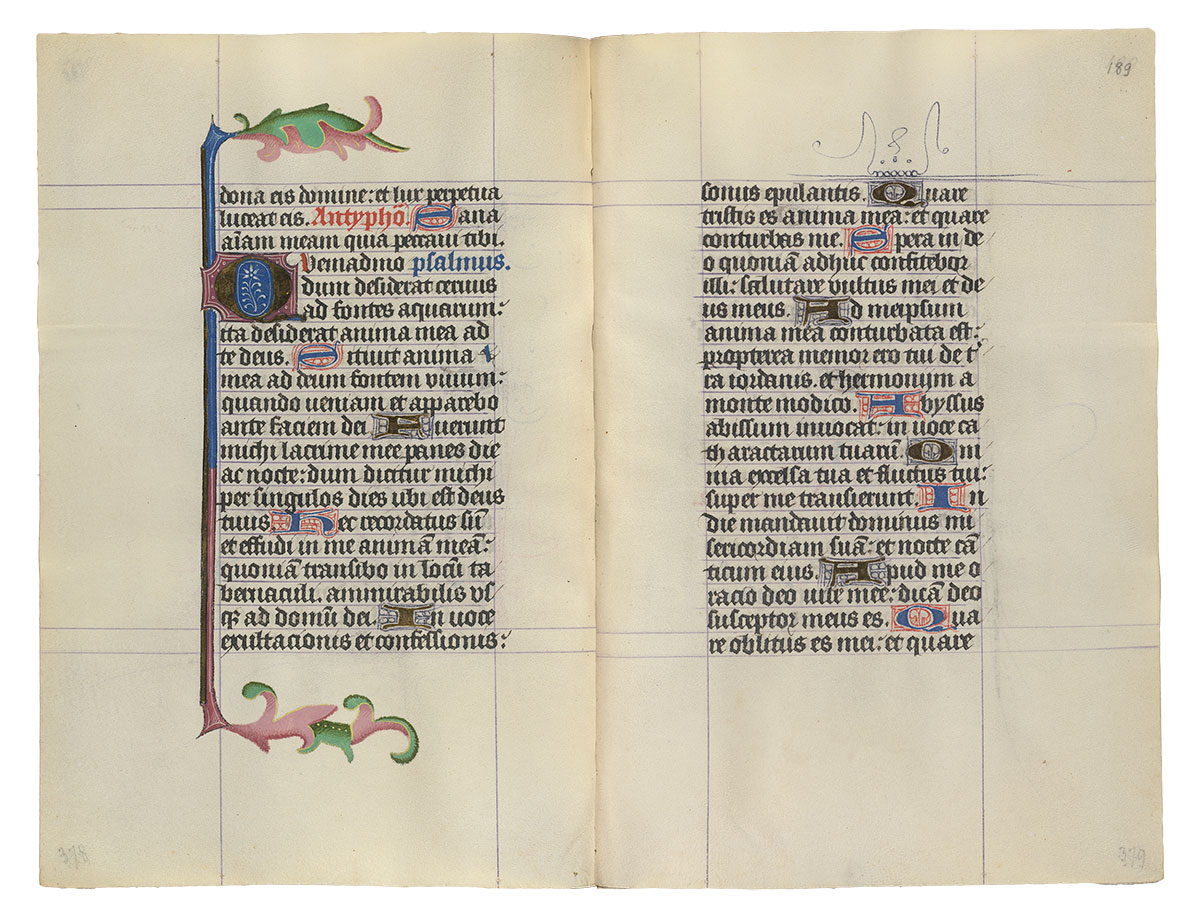
Purchased on the Belle da Costa Greene Fund with the assistance of the Fellows and with special assistance of Mrs. Frederick B. Adams, Sr., Mrs. Robert Charles, Mr. Laurens M. Hamilton, The Heineman Foundation, Mrs. Donald F. Hyde, Mrs. Jacob M. Kaplan, Mrs. John Kean, Mr. Paul Mellon, Mr. and Mrs. Charles F. Morgan, Mr. Lessing J. Rosenwald, Mr. and Mrs. August H. Schilling, Mrs. Herbert N. Straus, Mrs. Landon K. Thorne, Mrs. Alan Valentine, Mr. and Mrs. Arnold Whitridge, and Miss Julia P. Wightman, 1970
Image courtesy of Faksimile Verlag Luzern
MS M.917/945, ff. 189v–190r
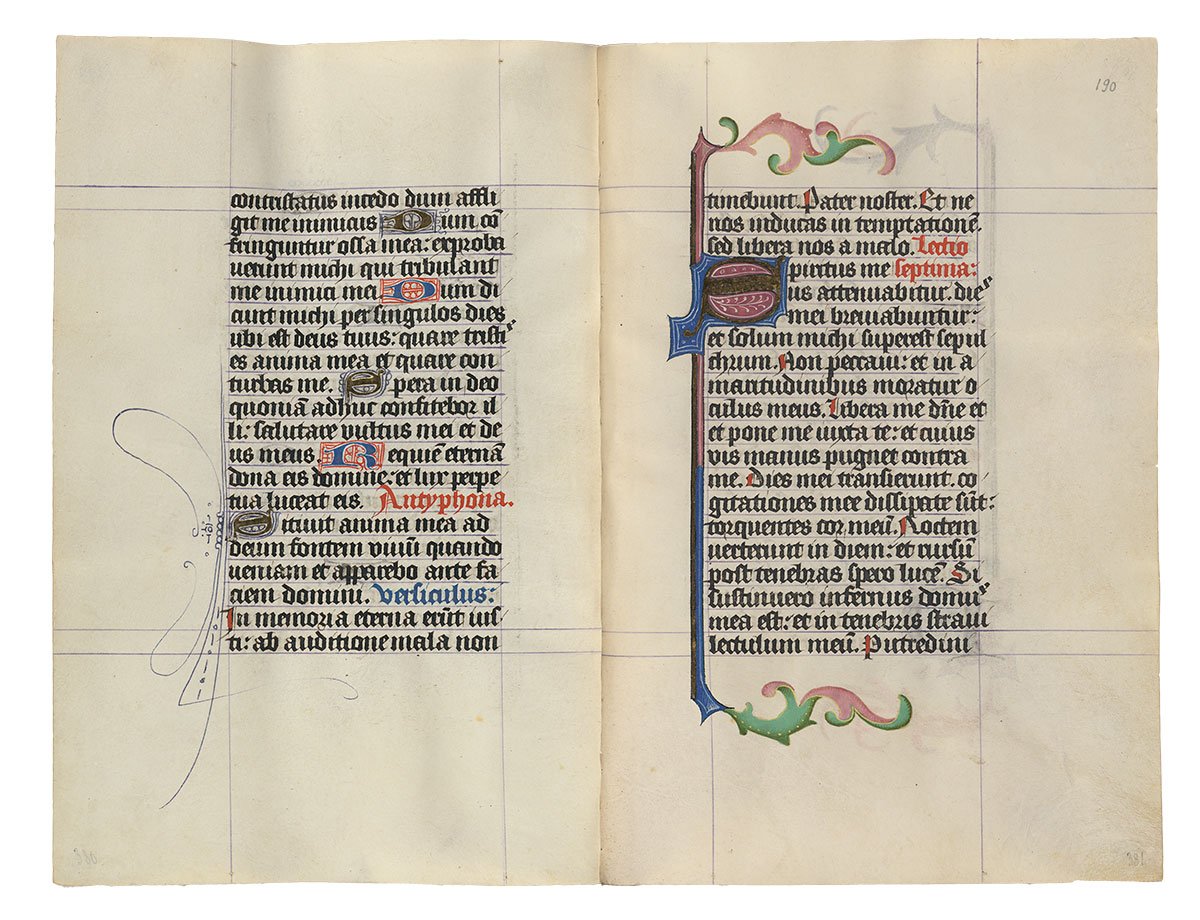
Purchased on the Belle da Costa Greene Fund with the assistance of the Fellows and with special assistance of Mrs. Frederick B. Adams, Sr., Mrs. Robert Charles, Mr. Laurens M. Hamilton, The Heineman Foundation, Mrs. Donald F. Hyde, Mrs. Jacob M. Kaplan, Mrs. John Kean, Mr. Paul Mellon, Mr. and Mrs. Charles F. Morgan, Mr. Lessing J. Rosenwald, Mr. and Mrs. August H. Schilling, Mrs. Herbert N. Straus, Mrs. Landon K. Thorne, Mrs. Alan Valentine, Mr. and Mrs. Arnold Whitridge, and Miss Julia P. Wightman, 1970
Image courtesy of Faksimile Verlag Luzern
MS M.917/945, ff. 190v–191r
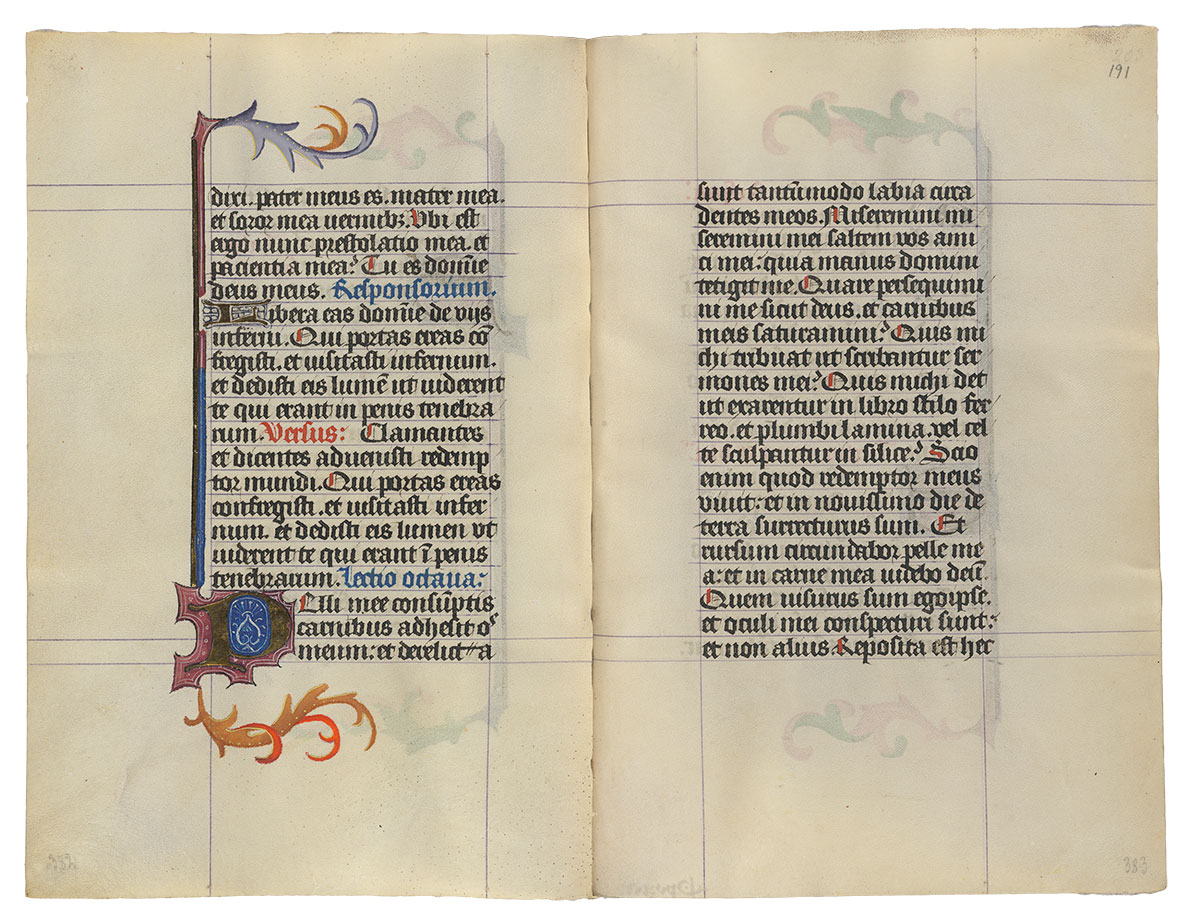
Purchased on the Belle da Costa Greene Fund with the assistance of the Fellows and with special assistance of Mrs. Frederick B. Adams, Sr., Mrs. Robert Charles, Mr. Laurens M. Hamilton, The Heineman Foundation, Mrs. Donald F. Hyde, Mrs. Jacob M. Kaplan, Mrs. John Kean, Mr. Paul Mellon, Mr. and Mrs. Charles F. Morgan, Mr. Lessing J. Rosenwald, Mr. and Mrs. August H. Schilling, Mrs. Herbert N. Straus, Mrs. Landon K. Thorne, Mrs. Alan Valentine, Mr. and Mrs. Arnold Whitridge, and Miss Julia P. Wightman, 1970
Image courtesy of Faksimile Verlag Luzern
MS M.917/945, ff. 191v–192r
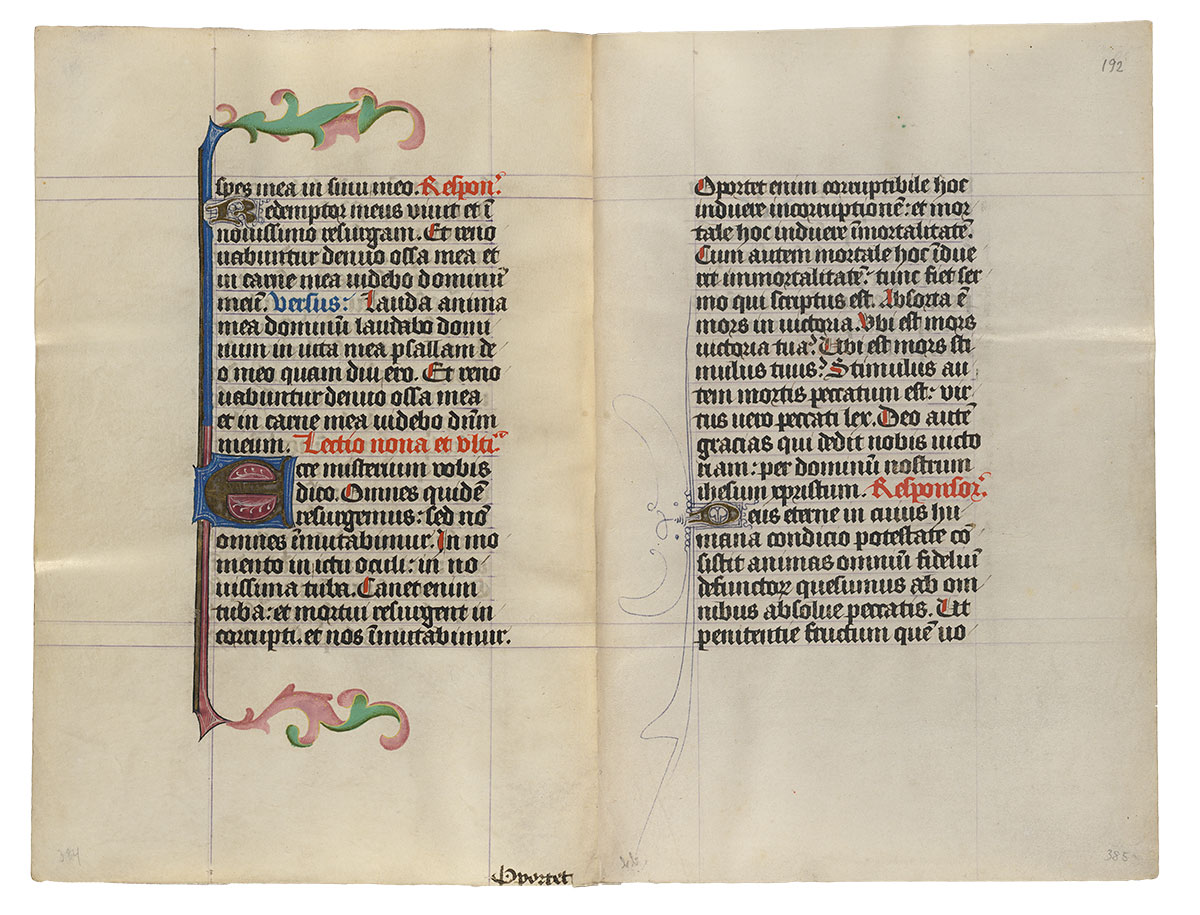
Purchased on the Belle da Costa Greene Fund with the assistance of the Fellows and with special assistance of Mrs. Frederick B. Adams, Sr., Mrs. Robert Charles, Mr. Laurens M. Hamilton, The Heineman Foundation, Mrs. Donald F. Hyde, Mrs. Jacob M. Kaplan, Mrs. John Kean, Mr. Paul Mellon, Mr. and Mrs. Charles F. Morgan, Mr. Lessing J. Rosenwald, Mr. and Mrs. August H. Schilling, Mrs. Herbert N. Straus, Mrs. Landon K. Thorne, Mrs. Alan Valentine, Mr. and Mrs. Arnold Whitridge, and Miss Julia P. Wightman, 1970
Image courtesy of Faksimile Verlag Luzern
MS M.917/945, f. 192v–p. 181
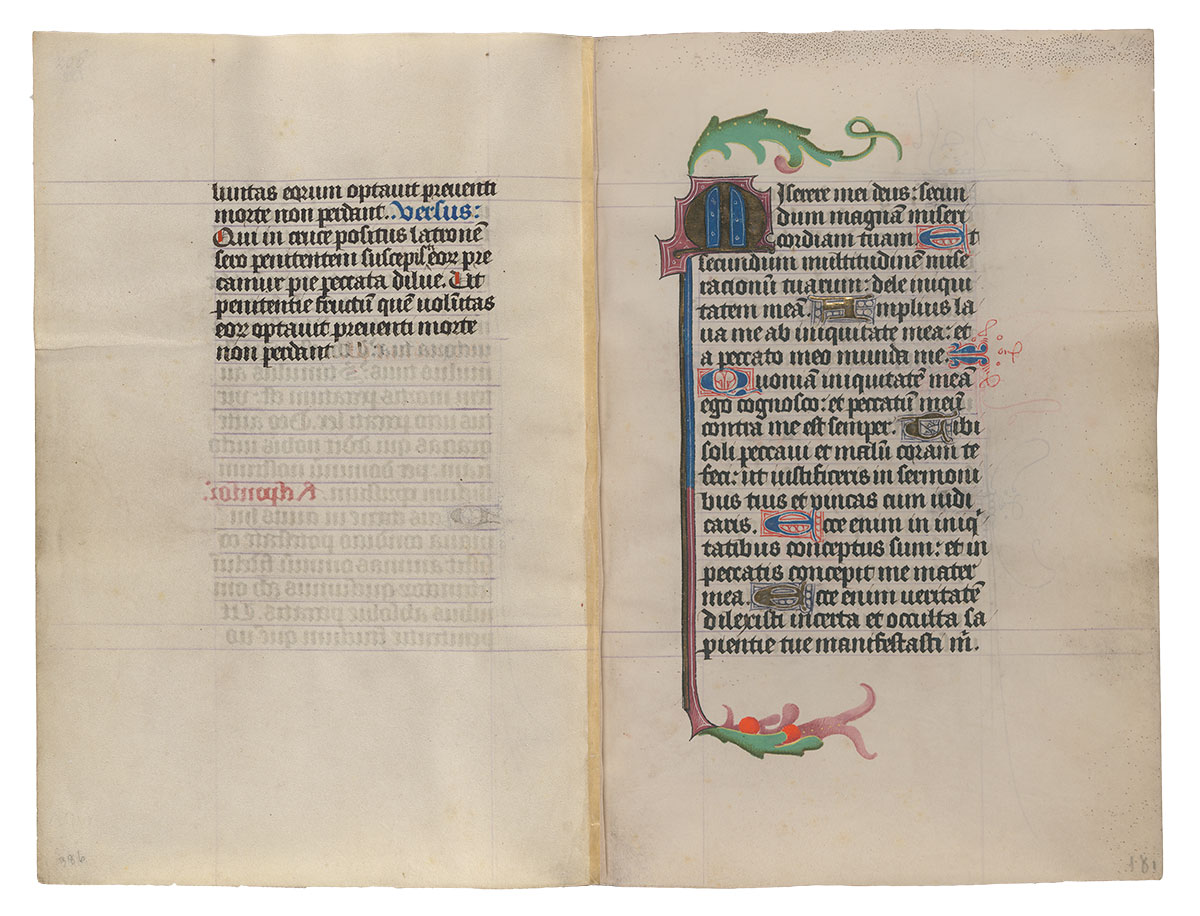
Purchased on the Belle da Costa Greene Fund with the assistance of the Fellows and with special assistance of Mrs. Frederick B. Adams, Sr., Mrs. Robert Charles, Mr. Laurens M. Hamilton, The Heineman Foundation, Mrs. Donald F. Hyde, Mrs. Jacob M. Kaplan, Mrs. John Kean, Mr. Paul Mellon, Mr. and Mrs. Charles F. Morgan, Mr. Lessing J. Rosenwald, Mr. and Mrs. August H. Schilling, Mrs. Herbert N. Straus, Mrs. Landon K. Thorne, Mrs. Alan Valentine, Mr. and Mrs. Arnold Whitridge, and Miss Julia P. Wightman, 1970
Image courtesy of Faksimile Verlag Luzern
MS M.917/945, pp. 182–183
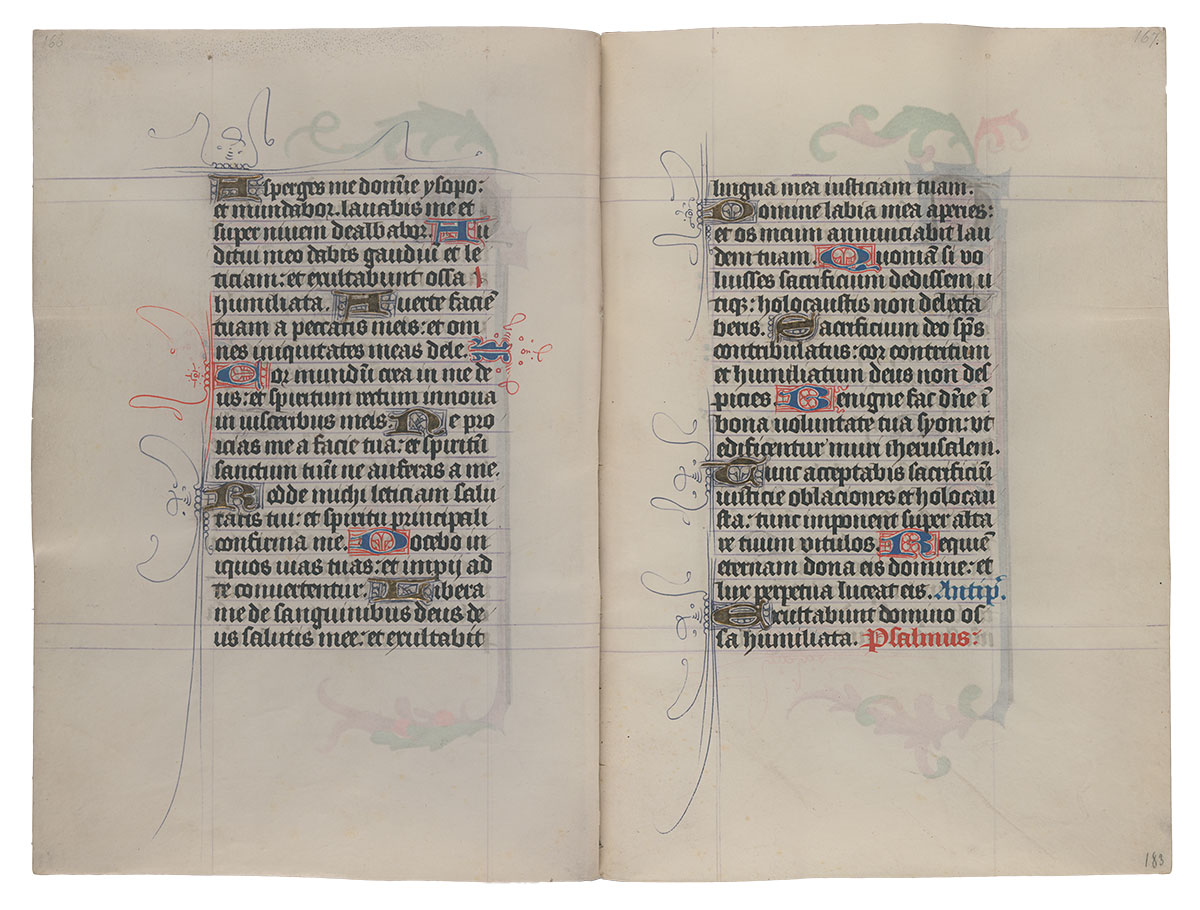
Purchased on the Belle da Costa Greene Fund with the assistance of the Fellows, 1963
Image courtesy of Faksimile Verlag Luzern
MS M.917/945, pp. 184–185
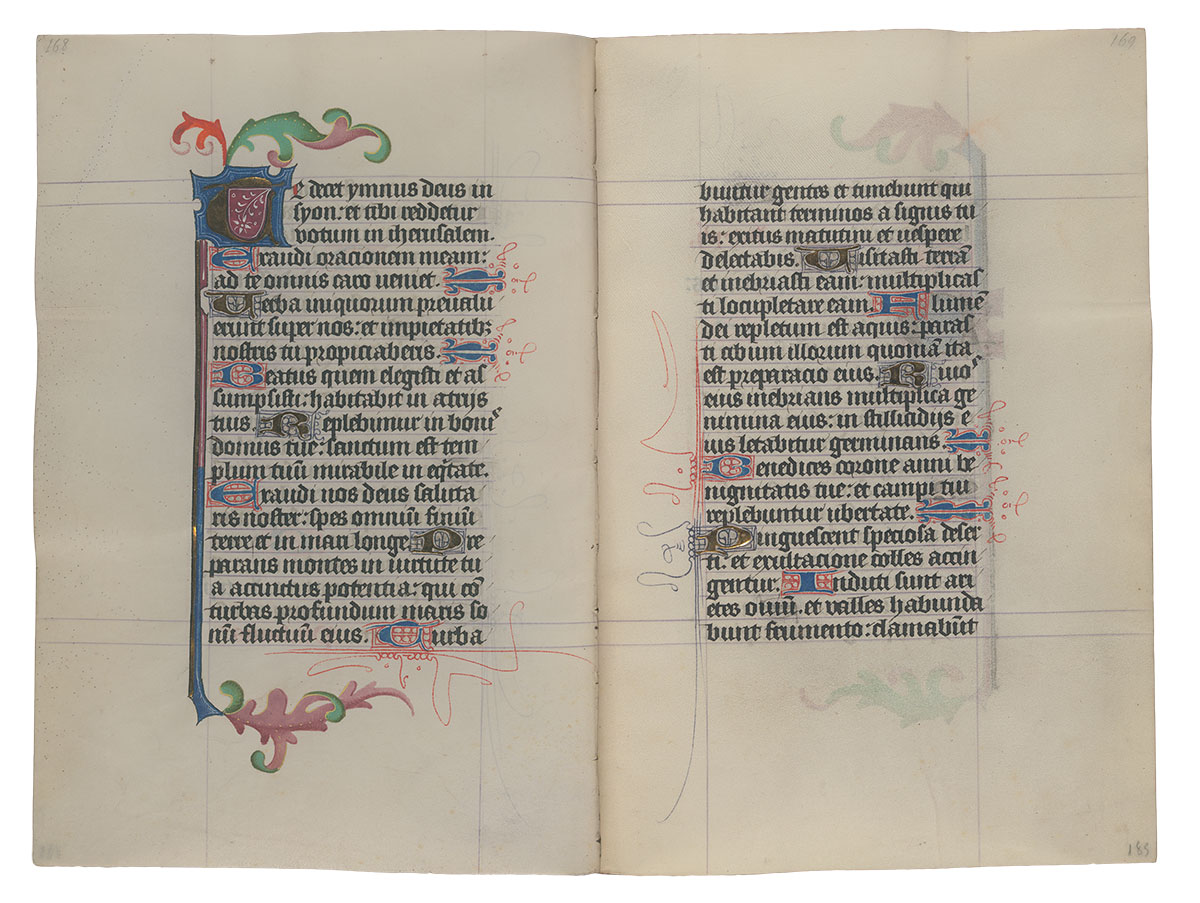
Purchased on the Belle da Costa Greene Fund with the assistance of the Fellows, 1963
Image courtesy of Faksimile Verlag Luzern
MS M.917/945, pp. 186–187
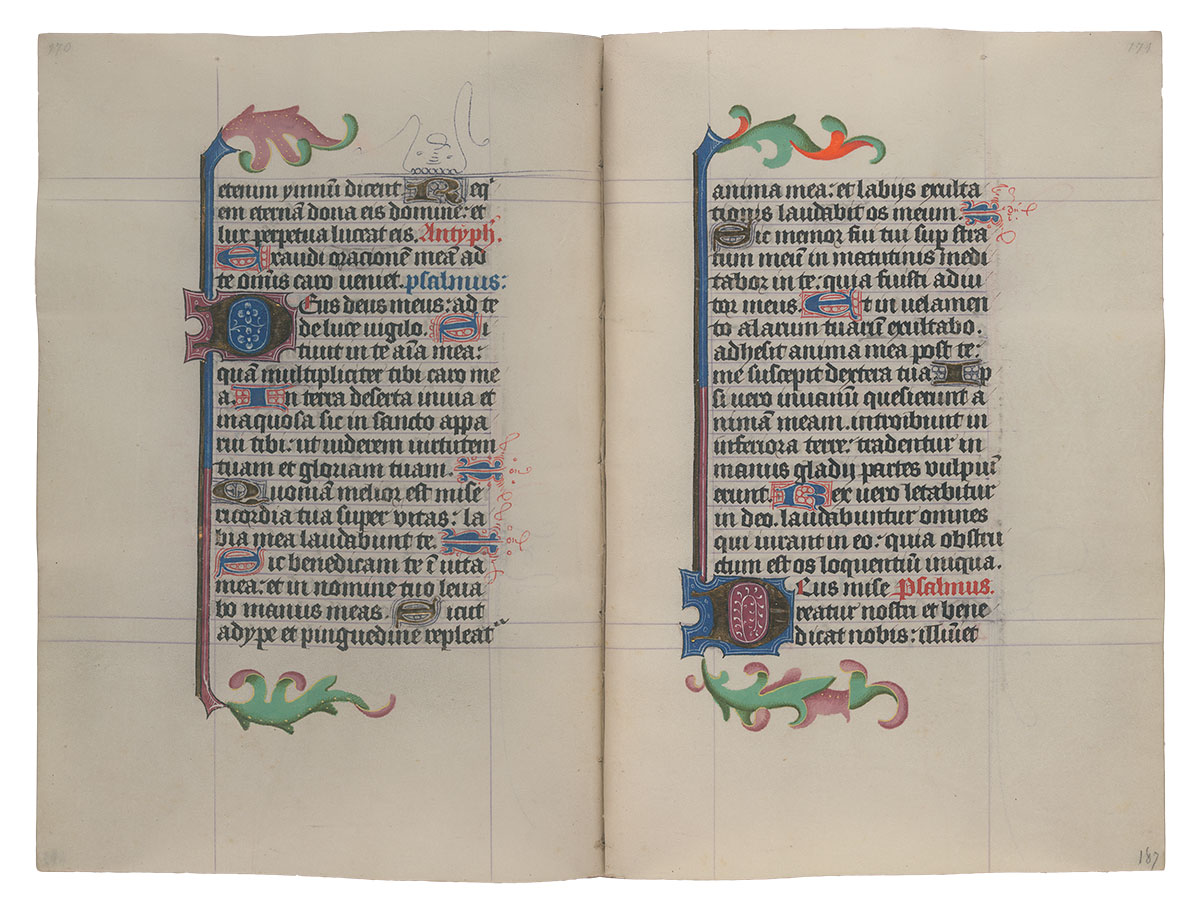
Purchased on the Belle da Costa Greene Fund with the assistance of the Fellows, 1963
Image courtesy of Faksimile Verlag Luzern
MS M.917/945, pp. 188–189
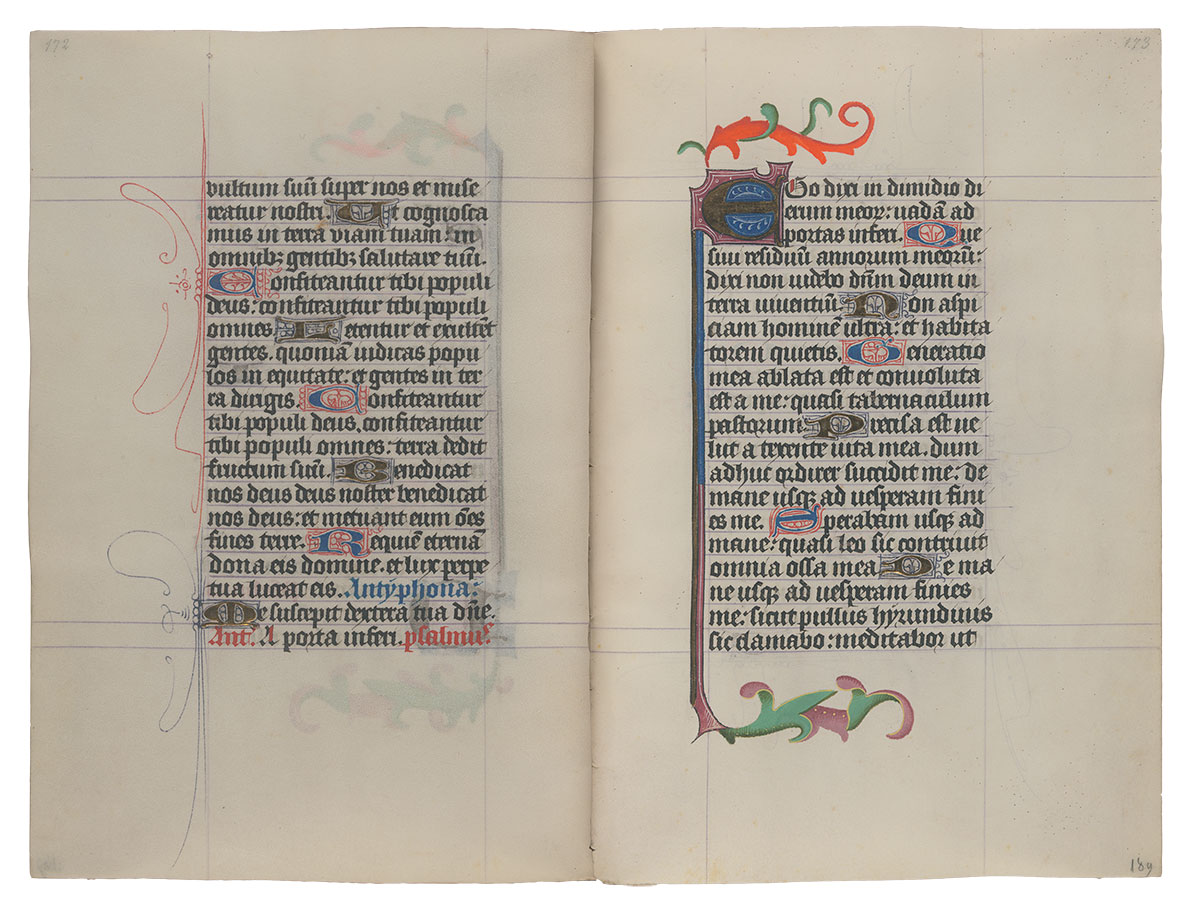
Purchased on the Belle da Costa Greene Fund with the assistance of the Fellows, 1963
Image courtesy of Faksimile Verlag Luzern
MS M.917/945, pp. 190–191
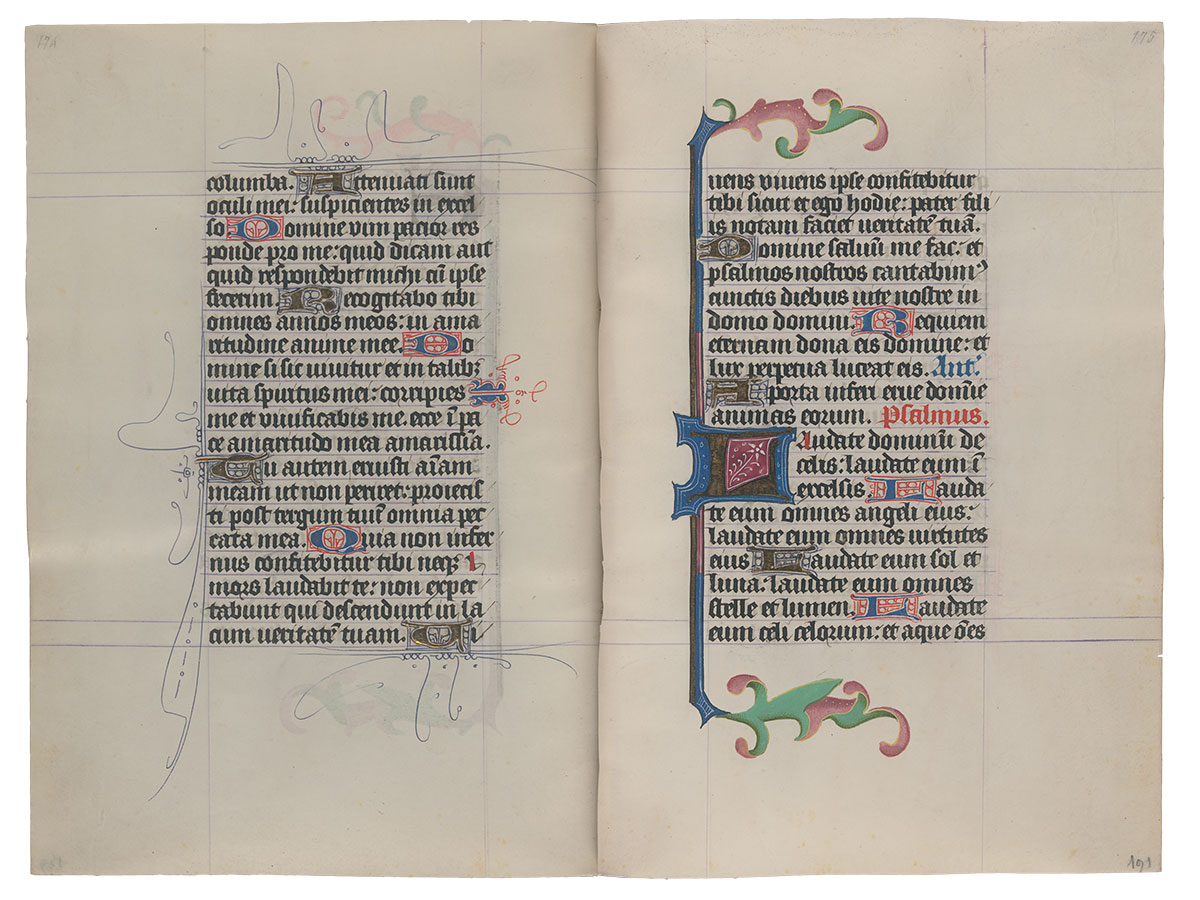
Purchased on the Belle da Costa Greene Fund with the assistance of the Fellows, 1963
Image courtesy of Faksimile Verlag Luzern
MS M.917/945, pp. 192–193
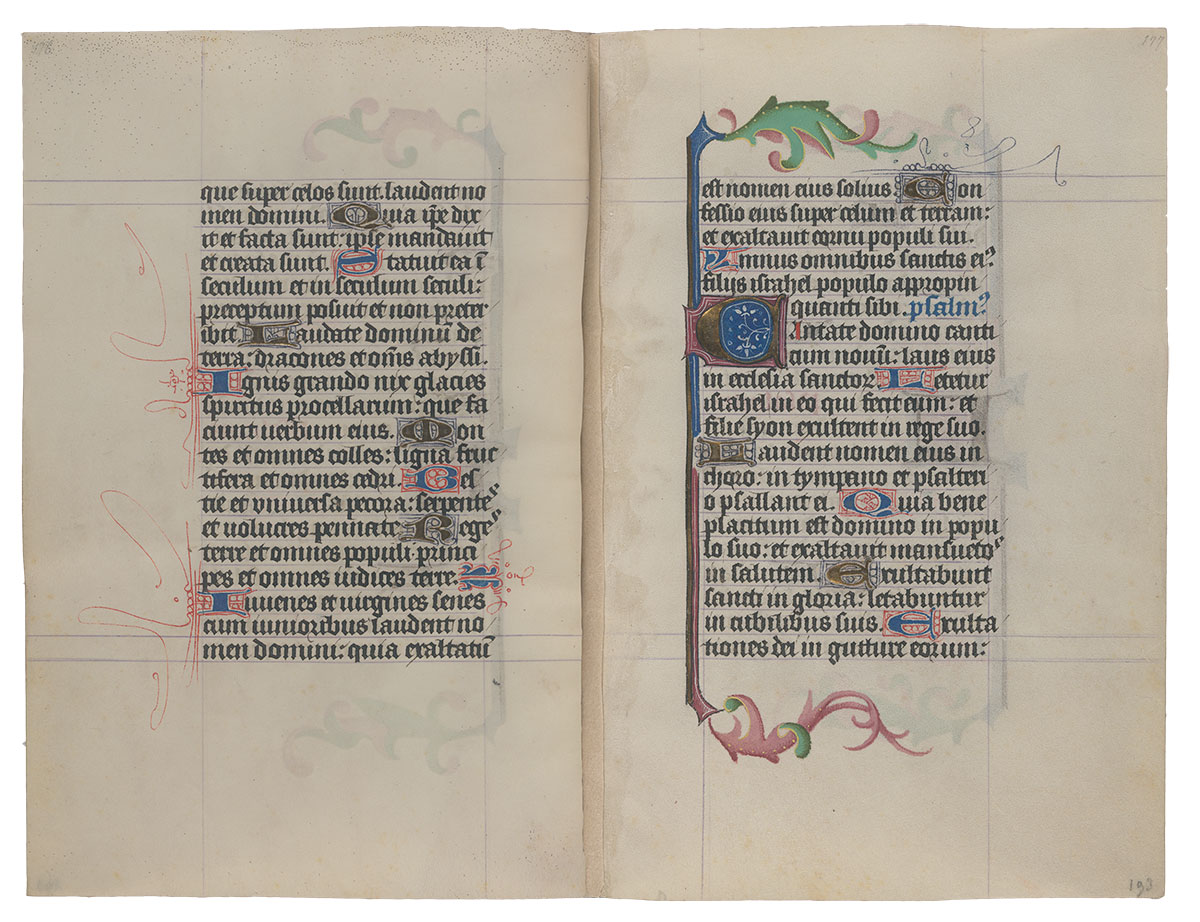
Purchased on the Belle da Costa Greene Fund with the assistance of the Fellows, 1963
Image courtesy of Faksimile Verlag Luzern
MS M.917/945, pp. 194–195
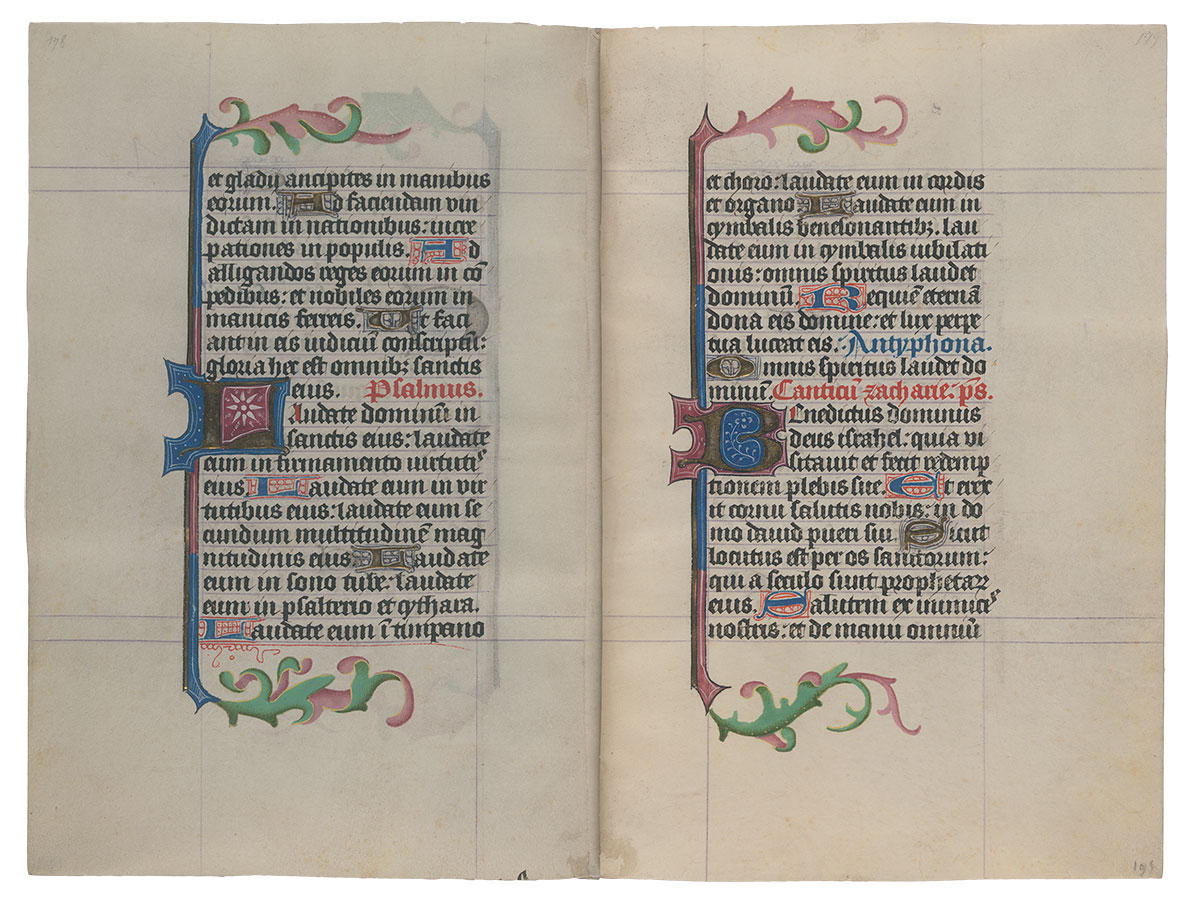
Purchased on the Belle da Costa Greene Fund with the assistance of the Fellows, 1963
Image courtesy of Faksimile Verlag Luzern
MS M.917/945, pp. 196–197
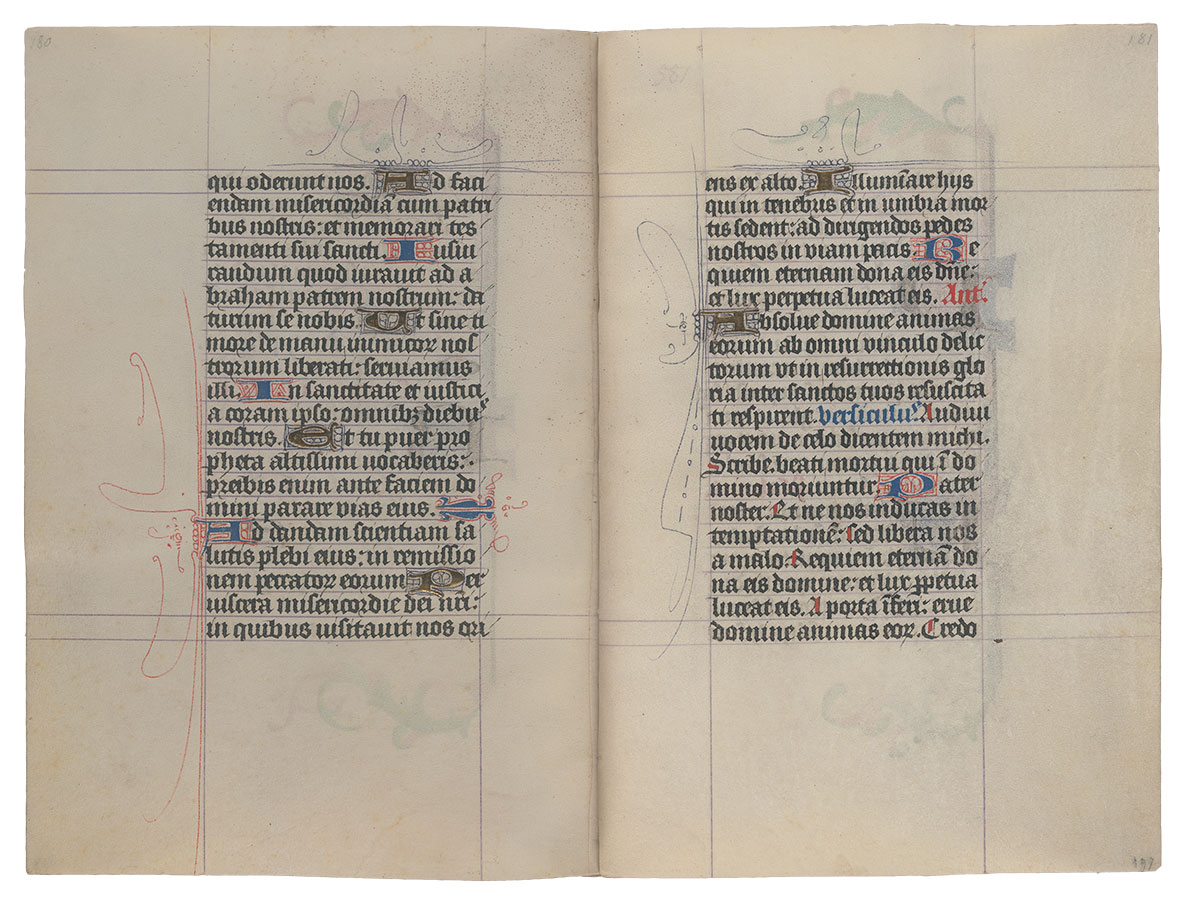
Purchased on the Belle da Costa Greene Fund with the assistance of the Fellows, 1963
Image courtesy of Faksimile Verlag Luzern
MS M.917/945, pp. 198–199
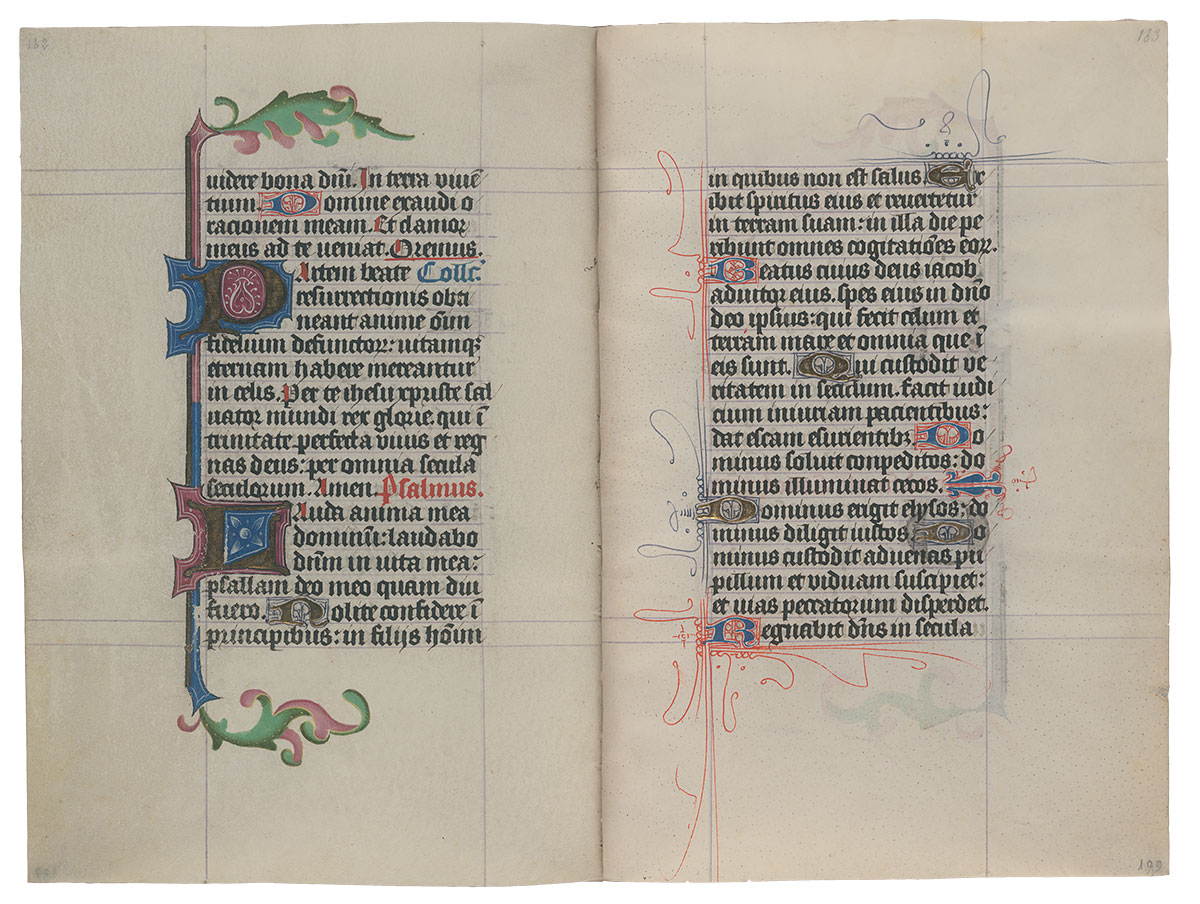
Purchased on the Belle da Costa Greene Fund with the assistance of the Fellows, 1963
Image courtesy of Faksimile Verlag Luzern
MS M.917/945, pp. 200–201
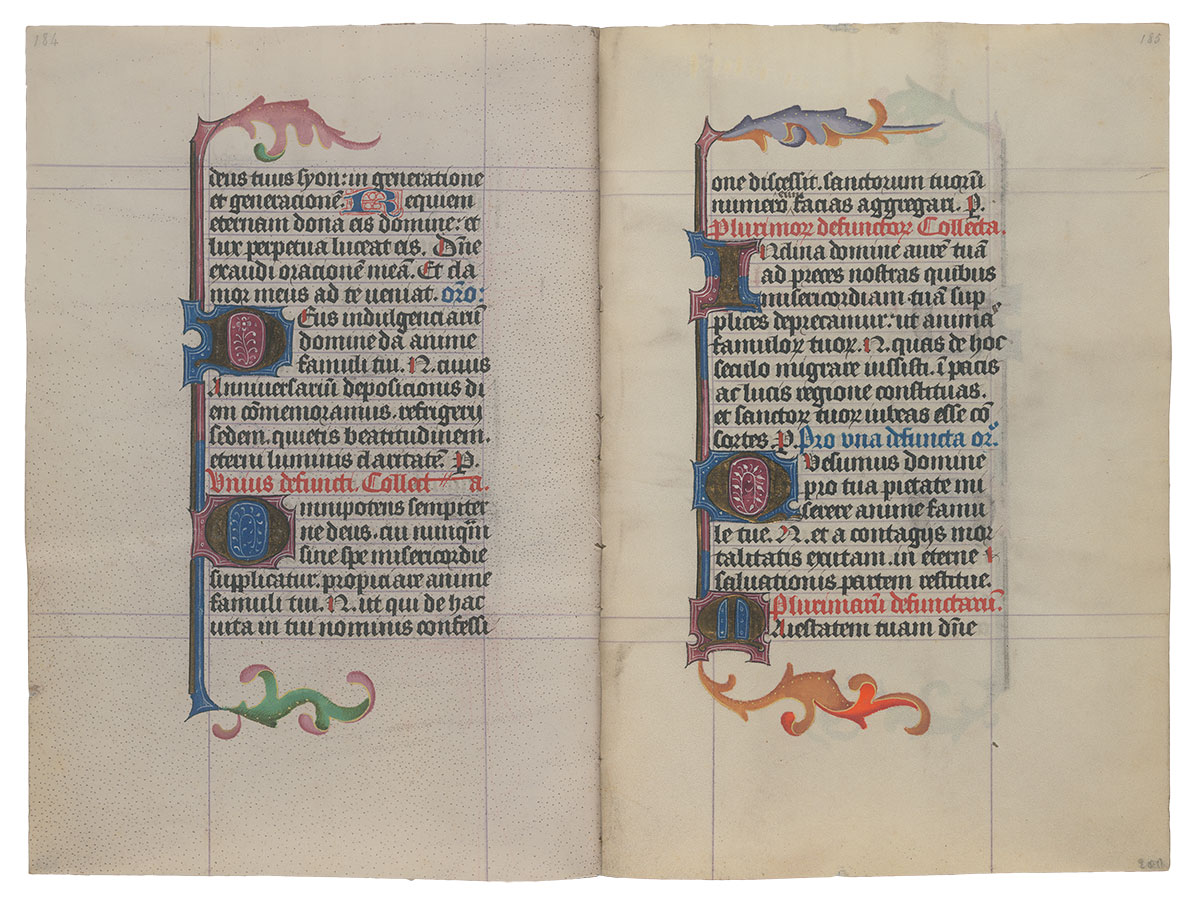
Purchased on the Belle da Costa Greene Fund with the assistance of the Fellows, 1963
Image courtesy of Faksimile Verlag Luzern
MS M.917/945, pp. 202–203
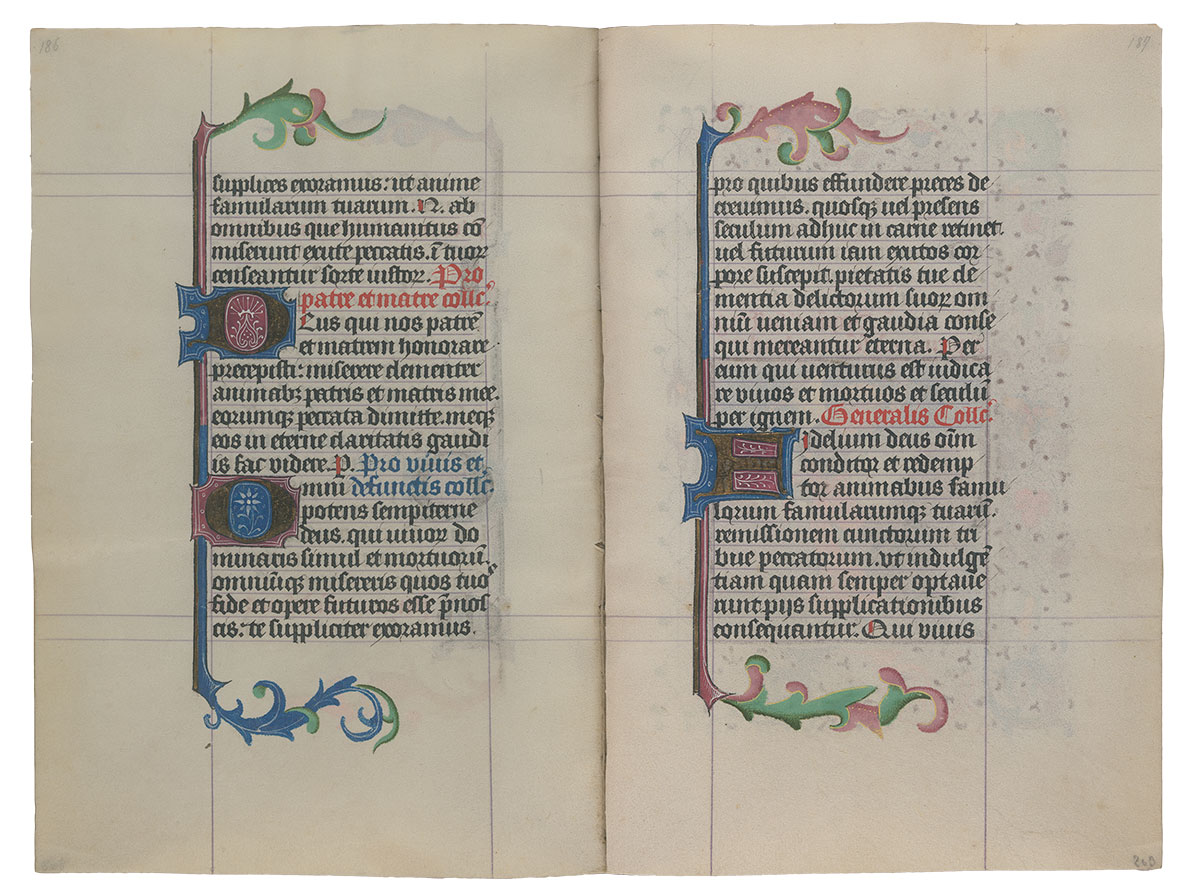
Purchased on the Belle da Costa Greene Fund with the assistance of the Fellows, 1963
Image courtesy of Faksimile Verlag Luzern
Suffrages
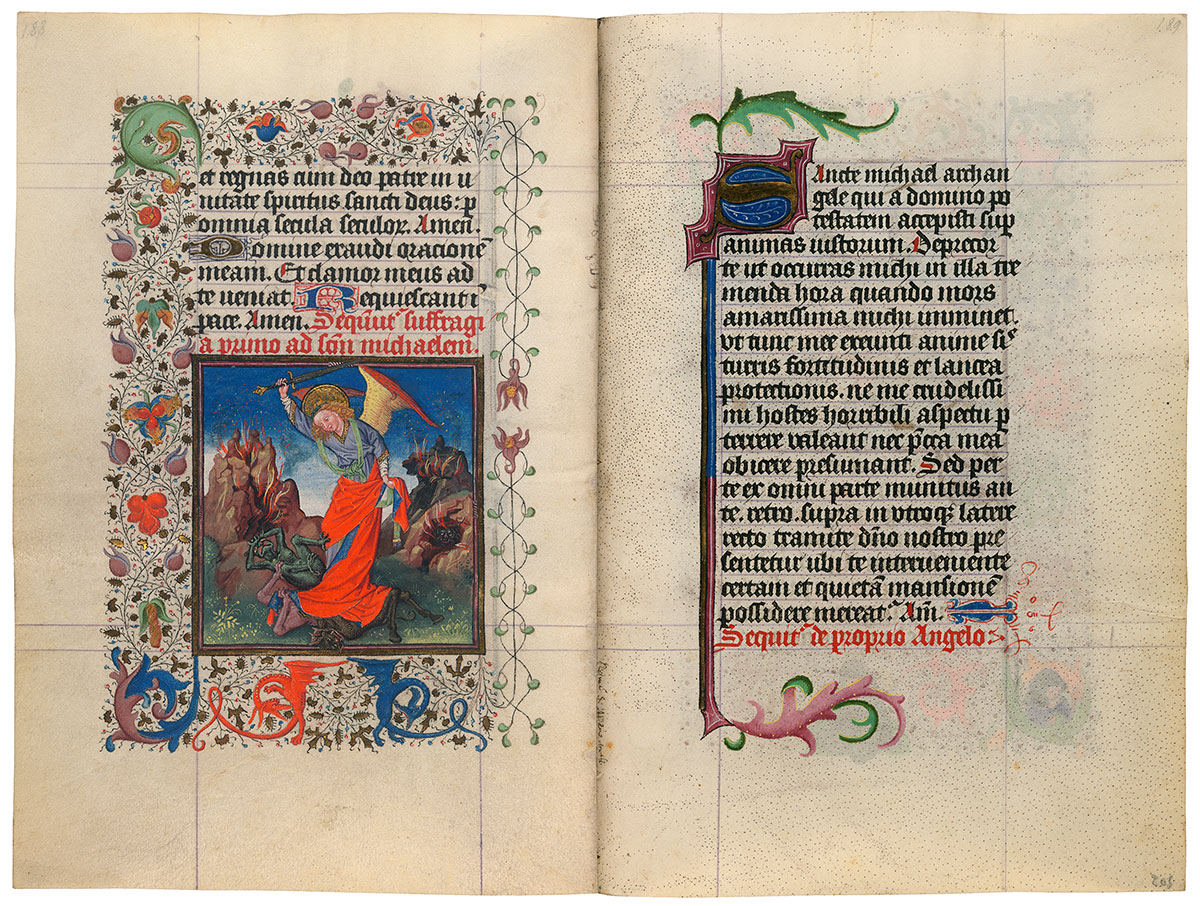
St. Michael Battling Demons
Purchased on the Belle da Costa Greene Fund with the assistance of the Fellows, 1963
Suffrages
Suffrages are short prayers to individual saints. As protectors of medieval people, saints were their doctor in plague, their midwife at childbirth, their guardian when traveling, and their nurse during toothache. If the Virgin was the figure to whom one addressed the all-important petition for eternal salvation, it was from saints that one sought more basic or temporal kinds of help. While the Virgin became, as the Mother of God, almost a goddess herself, saints retained more of their humanity and thus their approachability.
Image courtesy of Faksimile Verlag Luzern
MS M.917/945, pp. 206–207
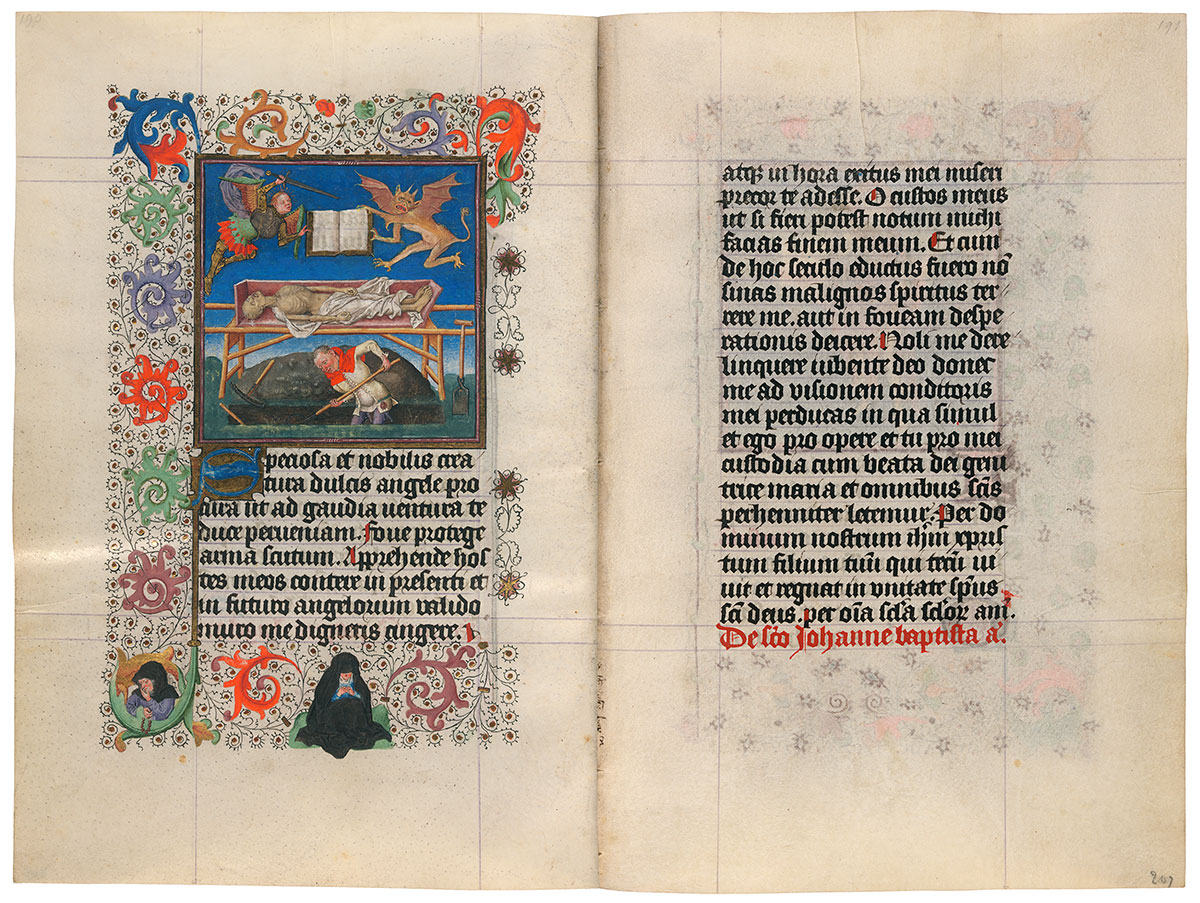
Guardian Angel and Demon Fighting over the Book of Life
Purchased on the Belle da Costa Greene Fund with the assistance of the Fellows, 1963
In this miniature, which illustrates a prayer to a guardian angel, that angel is shown in combat with a demon for the fate of the corpse's soul. They fight over the contents of the Book of Life, in which the dead man's good—and bad—deeds are recorded. The image (unlike that in the Monday Hours of the Dead) depicts burial according to common practice—with a shroud instead of a coffin.
Suffrages
Suffrages are short prayers to individual saints. As protectors of medieval people, saints were their doctor in plague, their midwife at childbirth, their guardian when traveling, and their nurse during toothache. If the Virgin was the figure to whom one addressed the all-important petition for eternal salvation, it was from saints that one sought more basic or temporal kinds of help. While the Virgin became, as the Mother of God, almost a goddess herself, saints retained more of their humanity and thus their approachability.
Image courtesy of Faksimile Verlag Luzern
MS M.917/945, pp. 208–209
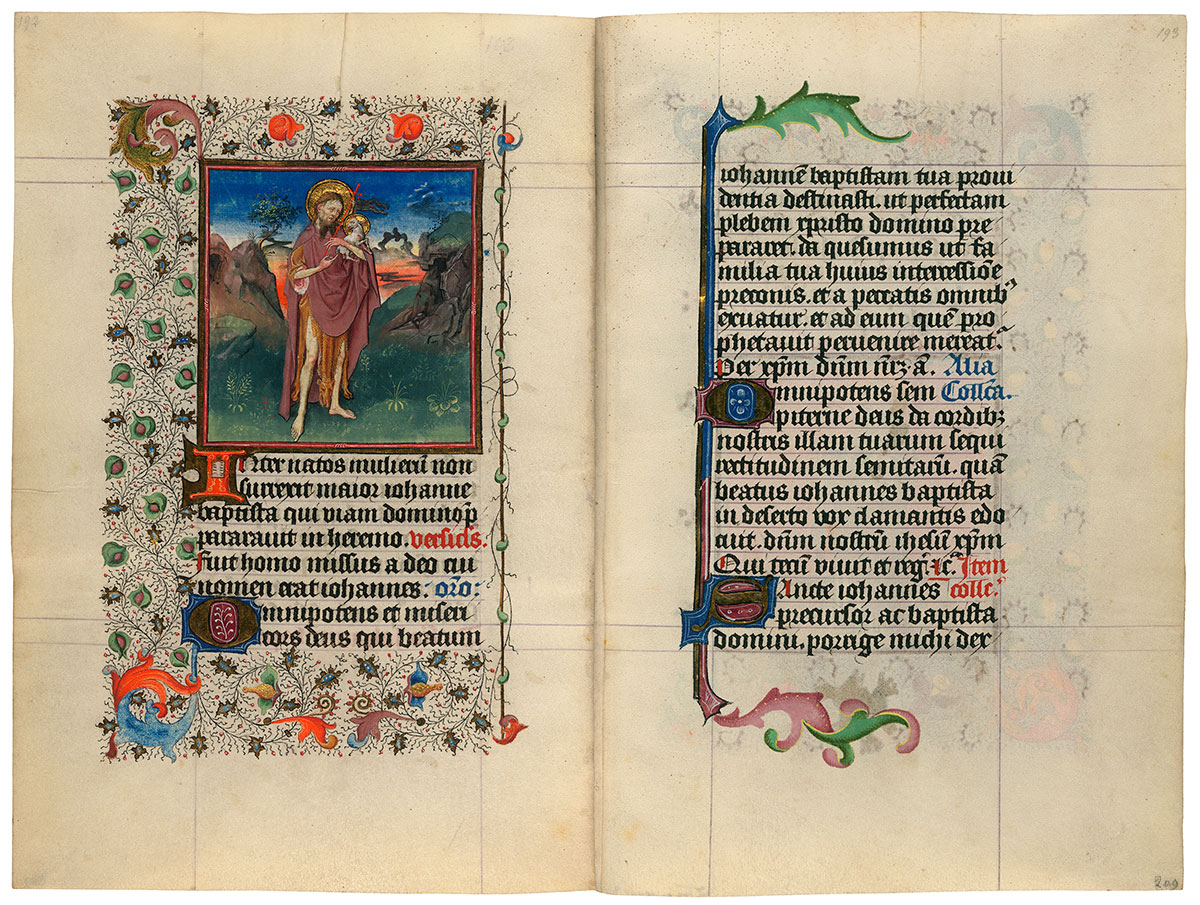
St. John the Baptist
Purchased on the Belle da Costa Greene Fund with the assistance of the Fellows, 1963
The gaunt figure of John the Baptist stands in the midst of a wild and craggy landscape at sunset, dressed in a light brown camel skin and covered by a cloak. The artist, with delicate shading, has given John hollow cheeks and sunken eyes that bespeak of his ascetic lifestyle in the pictured desert. He cradles a small bleeding lamb in his left arm while gesturing toward it with his right, reminding us that John pointed the way toward Jesus, whom he called the Lamb of God (Agnus Dei). He holds the lamb's bannered staff of Resurrection, its cross-decorated flag once silver but now sadly oxidized.
Suffrages
Suffrages are short prayers to individual saints. As protectors of medieval people, saints were their doctor in plague, their midwife at childbirth, their guardian when traveling, and their nurse during toothache. If the Virgin was the figure to whom one addressed the all-important petition for eternal salvation, it was from saints that one sought more basic or temporal kinds of help. While the Virgin became, as the Mother of God, almost a goddess herself, saints retained more of their humanity and thus their approachability.
Image courtesy of Faksimile Verlag Luzern
MS M.917/945, pp. 210–211
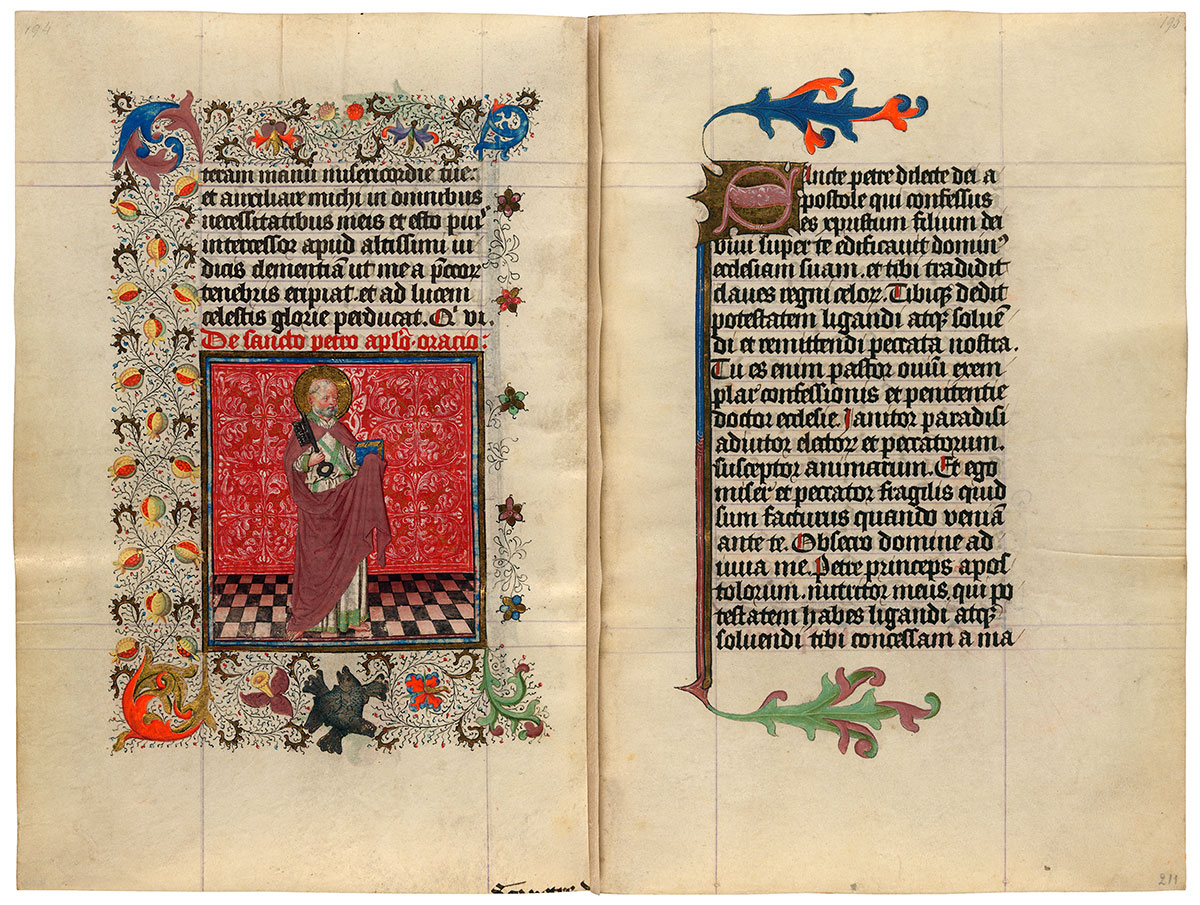
St. Peter
Purchased on the Belle da Costa Greene Fund with the assistance of the Fellows, 1963
Three silver fish are entwined in the border below Peter, a fisherman before heeding the call of Christ and a fisher of men thereafter. In the miniature, the bearded apostle stands on a tiled floor before a textile background, a common setting for the images of saints in the Suffrages of Catherine's Book of Hours. The first pope, Peter, is clothed in priestly garb and carries a book and a large key . The key to the kingdom of heaven was promised to him by Christ in Matthew 16:19.
Suffrages
Suffrages are short prayers to individual saints. As protectors of medieval people, saints were their doctor in plague, their midwife at childbirth, their guardian when traveling, and their nurse during toothache. If the Virgin was the figure to whom one addressed the all-important petition for eternal salvation, it was from saints that one sought more basic or temporal kinds of help. While the Virgin became, as the Mother of God, almost a goddess herself, saints retained more of their humanity and thus their approachability.
Image courtesy of Faksimile Verlag Luzern
MS M.917/945, pp. 212–213
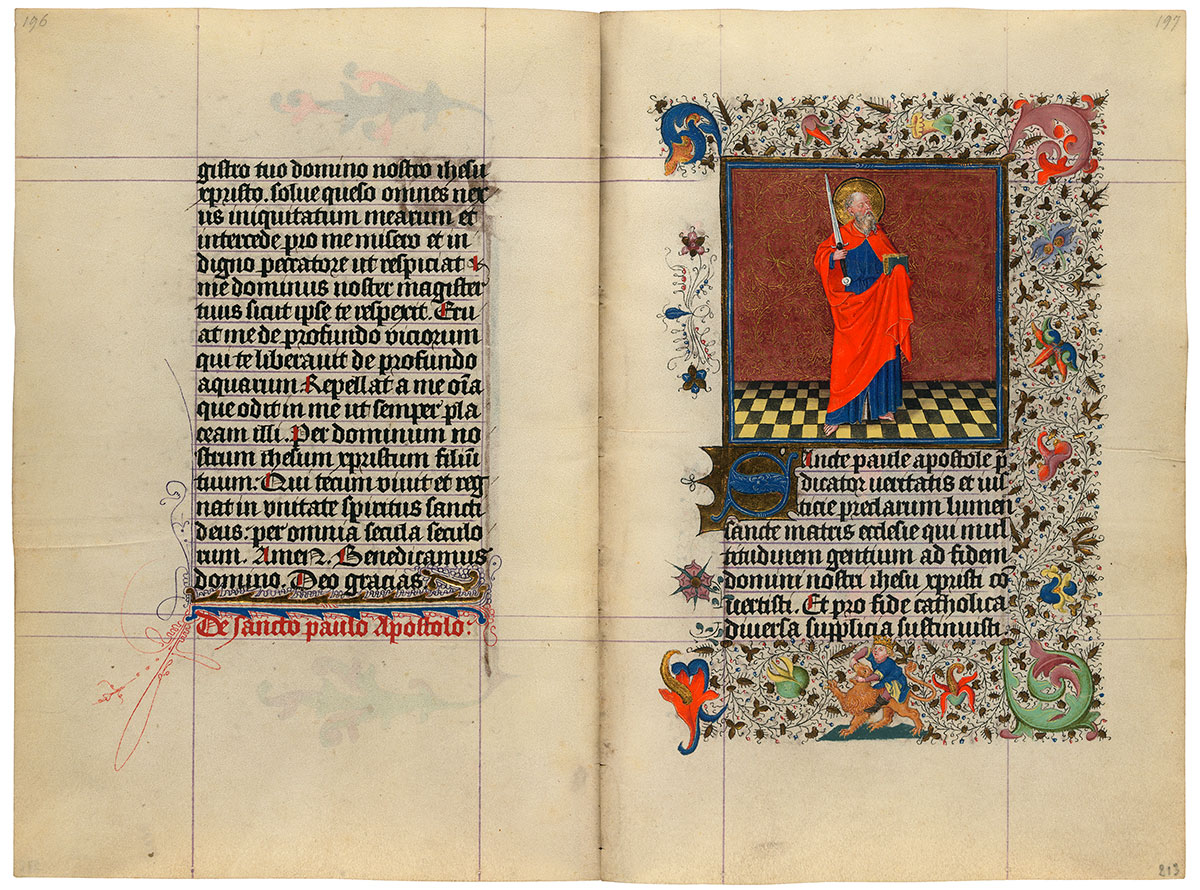
St. Paul
Purchased on the Belle da Costa Greene Fund with the assistance of the Fellows, 1963
Paul, balding and with a long forked beard, stands in the ubiquitous setting of the tiled floor and textiled background. Dressed in a long blue robe and orange cloak, the apostle holds a sword, instrument of his martyrdom, and a book, the Gospels. In the border a child-like king, possibly David, wrestles with a lion. The meaning of this charming image and its connection to St. Paul are unclear.
Suffrages
Suffrages are short prayers to individual saints. As protectors of medieval people, saints were their doctor in plague, their midwife at childbirth, their guardian when traveling, and their nurse during toothache. If the Virgin was the figure to whom one addressed the all-important petition for eternal salvation, it was from saints that one sought more basic or temporal kinds of help. While the Virgin became, as the Mother of God, almost a goddess herself, saints retained more of their humanity and thus their approachability.
Image courtesy of Faksimile Verlag Luzern
MS M.917/945, pp. 214–215
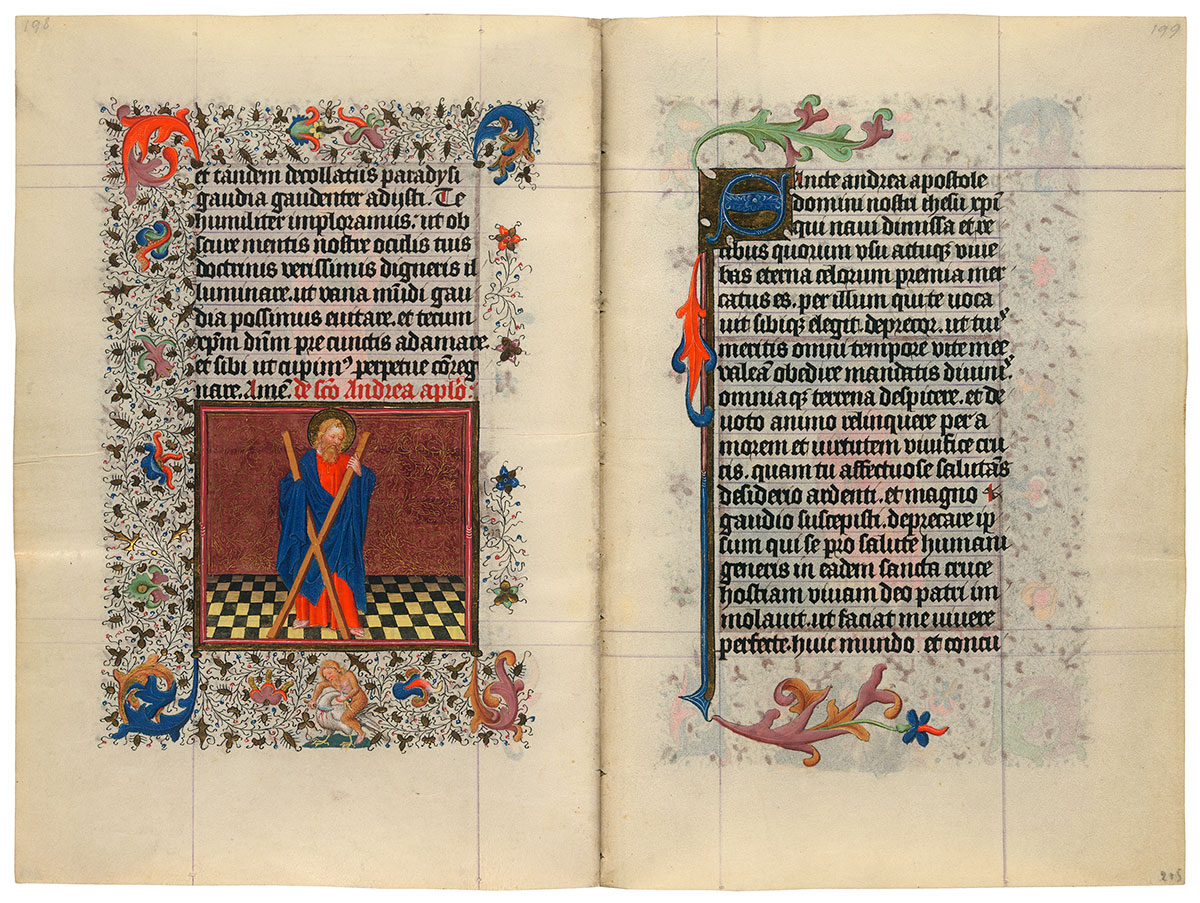
St. Andrew
Purchased on the Belle da Costa Greene Fund with the assistance of the Fellows, 1963
Andrew, in the familiar tiled and textiled setting, holds the eponymous X-shaped cross to which he was tied for crucifixion and from which, according to tradition, he preached for two days before succumbing. He has long blond hair and curly beard and wears a bright blue cloak over a crimson robe. In the border below is a bizarre scene of a hairy wildman astride a white goose or swan, drawing a knife across its throat. How this scene might be connected with St. Andrew is unknown.
Suffrages
Suffrages are short prayers to individual saints. As protectors of medieval people, saints were their doctor in plague, their midwife at childbirth, their guardian when traveling, and their nurse during toothache. If the Virgin was the figure to whom one addressed the all-important petition for eternal salvation, it was from saints that one sought more basic or temporal kinds of help. While the Virgin became, as the Mother of God, almost a goddess herself, saints retained more of their humanity and thus their approachability.
Image courtesy of Faksimile Verlag Luzern
MS M.917/945, pp. 216–217
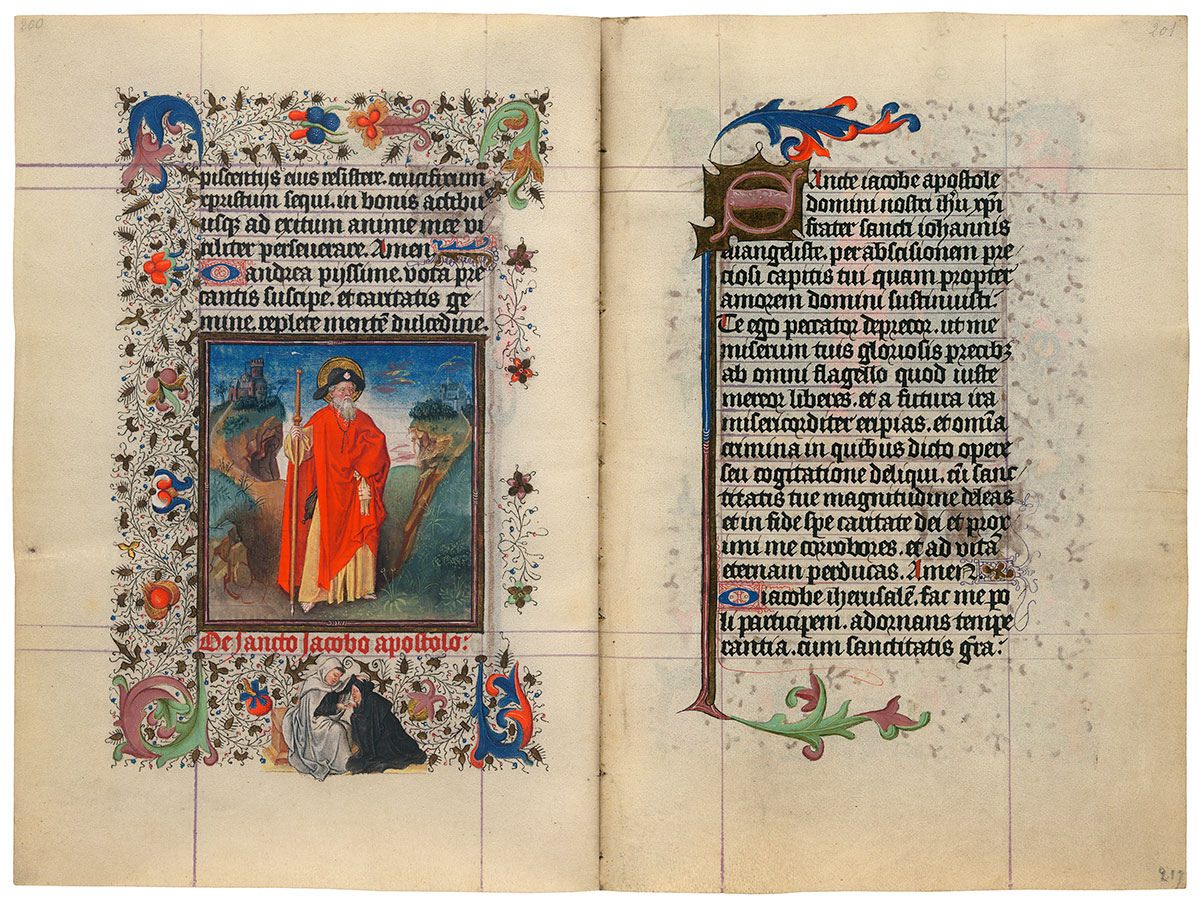
St. James the Major
Purchased on the Belle da Costa Greene Fund with the assistance of the Fellows, 1963
The relics of St. James lie in Santiago de Compostela in Spain, a major site for Christian pilgrims of the middle ages and today. Standing in a landscape, the depth of which suggests a long journey, the apostle is dressed for pilgrimage. The wide brimmed hat with mounted shell, the walking staff, and the pouch at his side are all attributes of medieval pilgrimage; even the girdle book he carries is bound for travel in an enveloping binding. Puzzling are the two small figures in the border: a kneeling woman in black who gives something to a seated man in white cloak. The woman may be a pilgrim receiving a blessing before setting out on her journey. A similar figure appears in the borders of pages 206 and 221. The pair resembles the two figures praying in the Deathbed scene (p. 180).
Suffrages
Suffrages are short prayers to individual saints. As protectors of medieval people, saints were their doctor in plague, their midwife at childbirth, their guardian when traveling, and their nurse during toothache. If the Virgin was the figure to whom one addressed the all-important petition for eternal salvation, it was from saints that one sought more basic or temporal kinds of help. While the Virgin became, as the Mother of God, almost a goddess herself, saints retained more of their humanity and thus their approachability.
Image courtesy of Faksimile Verlag Luzern
MS M.917/945, pp. 218–219
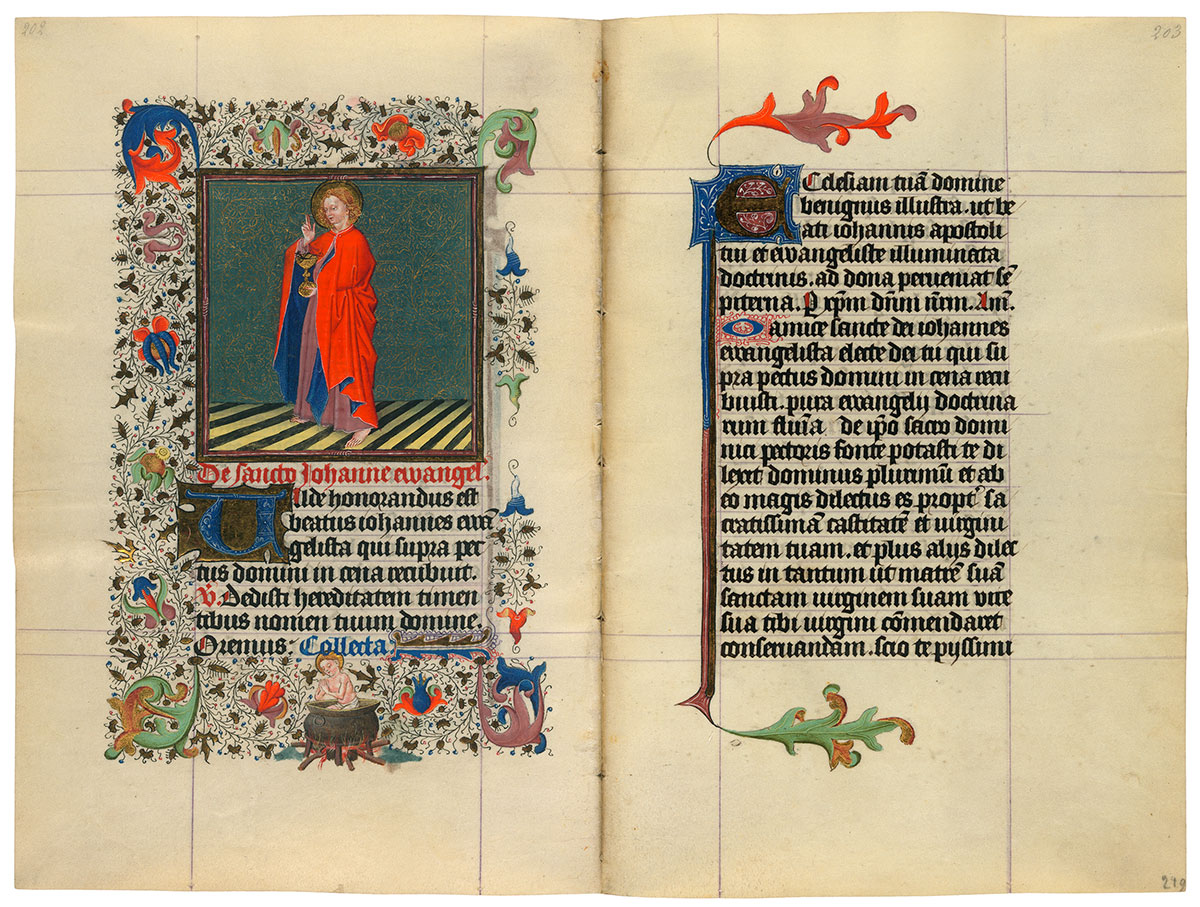
St. John the Evangelist
Purchased on the Belle da Costa Greene Fund with the assistance of the Fellows, 1963
John was an extraordinarily resilient saint. According to tradition, he is the only one of Christ's apostles to live a full life and die of old age. As we see here, however, it was not for lack of trying on the part of his persecutors. In the large miniature, the youthful John, standing on a black-and-white striped floor in front of a richly decorated green and gold background, holds a golden chalice that he blesses with his right hand. A tiny black dragon crawls up from the dregs, thus ridding the cup of the poison that constituted this particular attempt on his life. Below, with hands clasped, John prays inside a cauldron of boiling oil into which he has been thrown by the Emperor Dometian, an attack that he also survived.
Suffrages
Suffrages are short prayers to individual saints. As protectors of medieval people, saints were their doctor in plague, their midwife at childbirth, their guardian when traveling, and their nurse during toothache. If the Virgin was the figure to whom one addressed the all-important petition for eternal salvation, it was from saints that one sought more basic or temporal kinds of help. While the Virgin became, as the Mother of God, almost a goddess herself, saints retained more of their humanity and thus their approachability.
Image courtesy of Faksimile Verlag Luzern
MS M.917/945, pp. 220–221
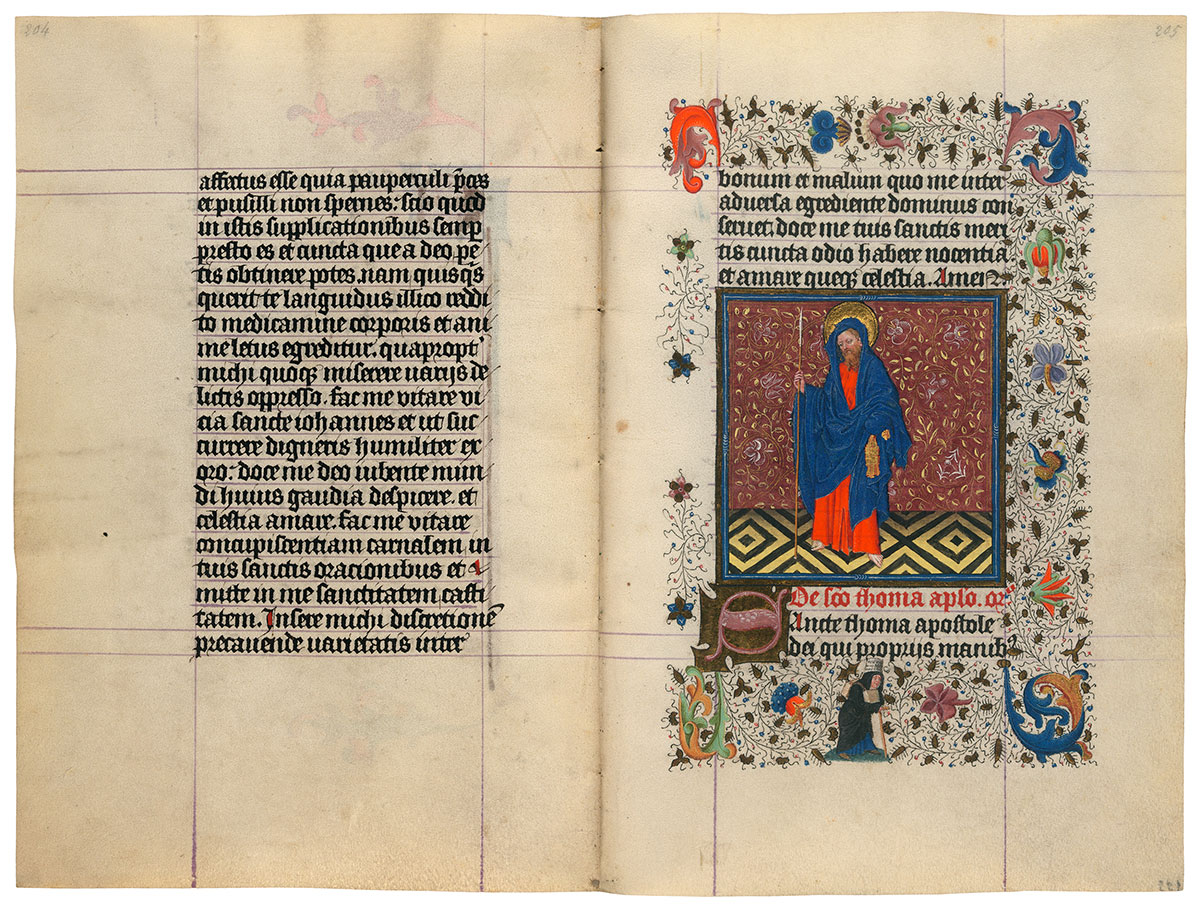
St. Thomas
Purchased on the Belle da Costa Greene Fund with the assistance of the Fellows, 1963
Thomas clasps the lance by which he met his demise and a girdle book is at his waist. His hood is up, which, along with the book and the female pilgrim in the lower border, suggests his far-flung travels. As the only apostle to go beyond the bounds of the Roman Empire, Thomas died at the sharp end of a spear in India, near modern-day Chennai. The woman in the lower border totes two rectangular packs fastened over her shoulders and wears a cylindrical cap, covered in writing, that may list her sins.
Suffrages
Suffrages are short prayers to individual saints. As protectors of medieval people, saints were their doctor in plague, their midwife at childbirth, their guardian when traveling, and their nurse during toothache. If the Virgin was the figure to whom one addressed the all-important petition for eternal salvation, it was from saints that one sought more basic or temporal kinds of help. While the Virgin became, as the Mother of God, almost a goddess herself, saints retained more of their humanity and thus their approachability.
Image courtesy of Faksimile Verlag Luzern
MS M.917/945, pp. 222–223
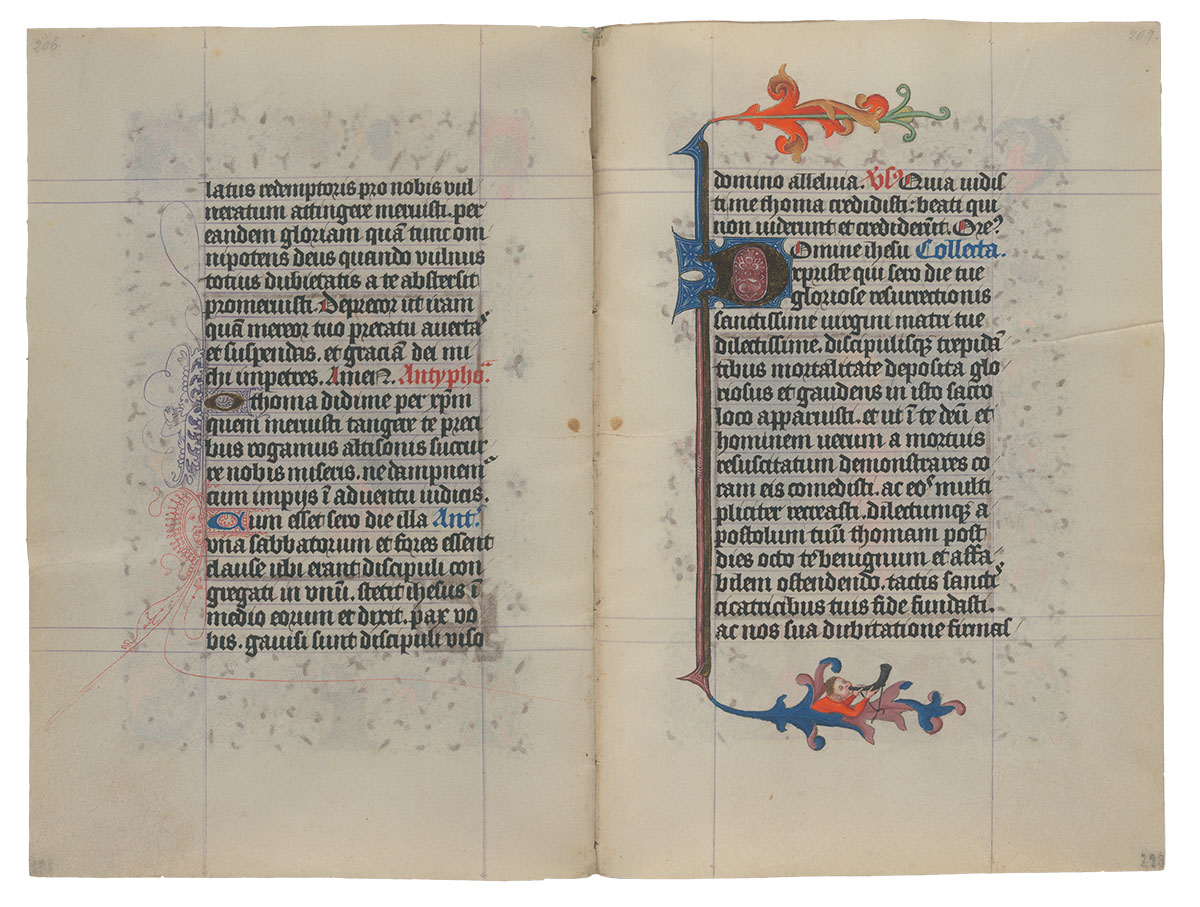
Purchased on the Belle da Costa Greene Fund with the assistance of the Fellows, 1963
Image courtesy of Faksimile Verlag Luzern
MS M.917/945, pp. 224–225
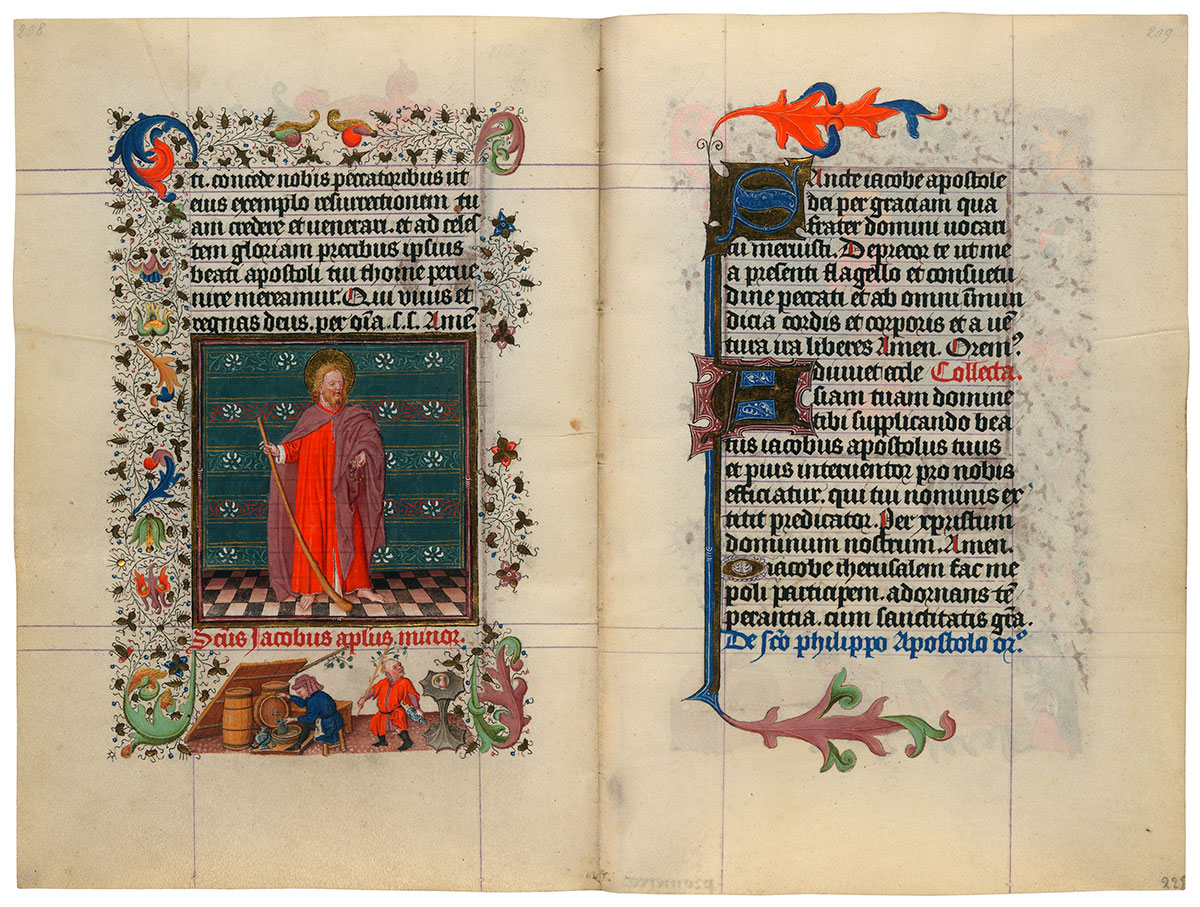
St. James the Minor
Purchased on the Belle da Costa Greene Fund with the assistance of the Fellows, 1963
James the Minor (so-called because there were two apostles named James) holds a rosary and the cudgel with which he was martyred. The drinking scene in the margin provides an antithesis to James, who was famous for his abstinence.
Suffrages
Suffrages are short prayers to individual saints. As protectors of medieval people, saints were their doctor in plague, their midwife at childbirth, their guardian when traveling, and their nurse during toothache. If the Virgin was the figure to whom one addressed the all-important petition for eternal salvation, it was from saints that one sought more basic or temporal kinds of help. While the Virgin became, as the Mother of God, almost a goddess herself, saints retained more of their humanity and thus their approachability.
Image courtesy of Faksimile Verlag Luzern
MS M.917/945, pp. 226–227
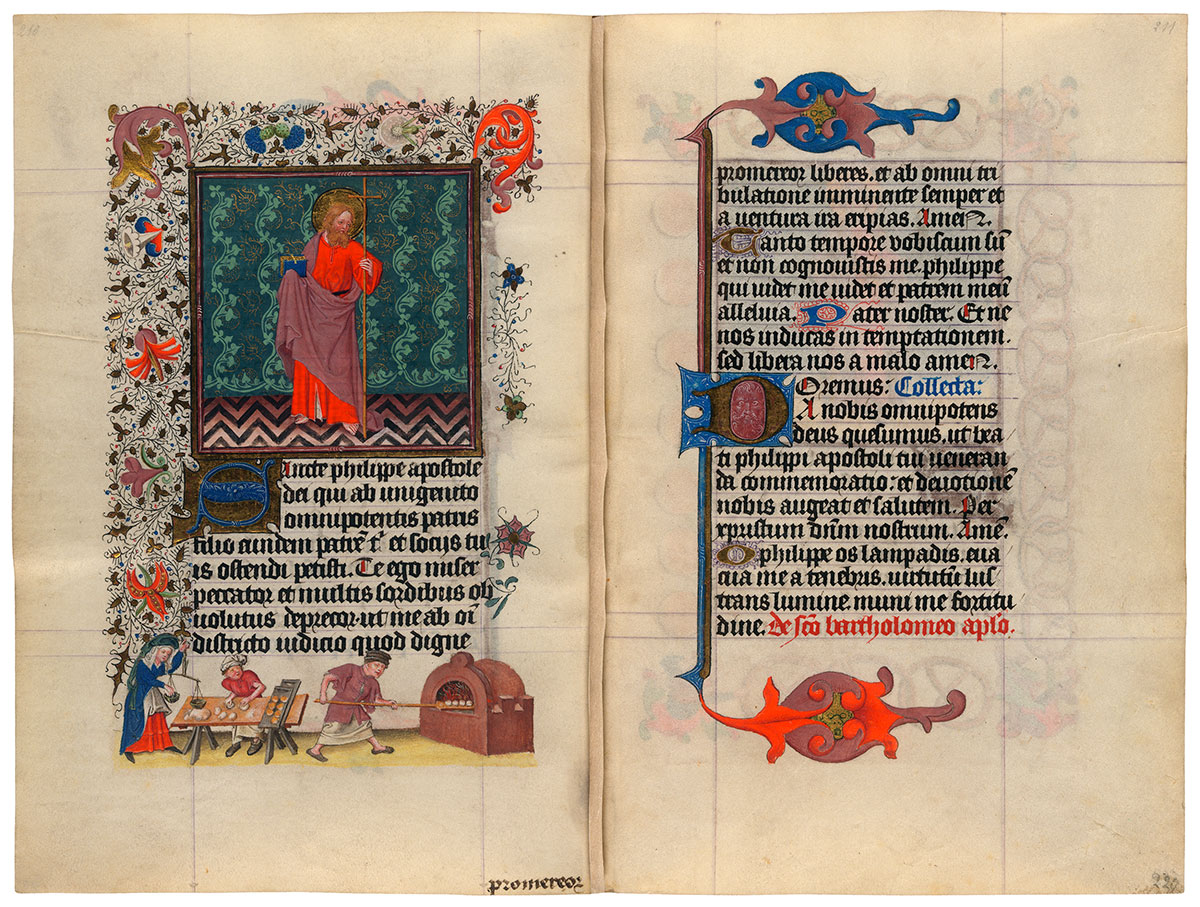
St. Philip
Purchased on the Belle da Costa Greene Fund with the assistance of the Fellows, 1963
The apostle Philip holds a book and a cross-staff. The baking scene in the border alludes to him as patron of pastry cooks. The food depicted in the two bottom margins was part of the celebration of 1 May, the joint feast of Philip and James.
Suffrages
Suffrages are short prayers to individual saints. As protectors of medieval people, saints were their doctor in plague, their midwife at childbirth, their guardian when traveling, and their nurse during toothache. If the Virgin was the figure to whom one addressed the all-important petition for eternal salvation, it was from saints that one sought more basic or temporal kinds of help. While the Virgin became, as the Mother of God, almost a goddess herself, saints retained more of their humanity and thus their approachability.
Image courtesy of Faksimile Verlag Luzern
MS M.917/945, pp. 230–231
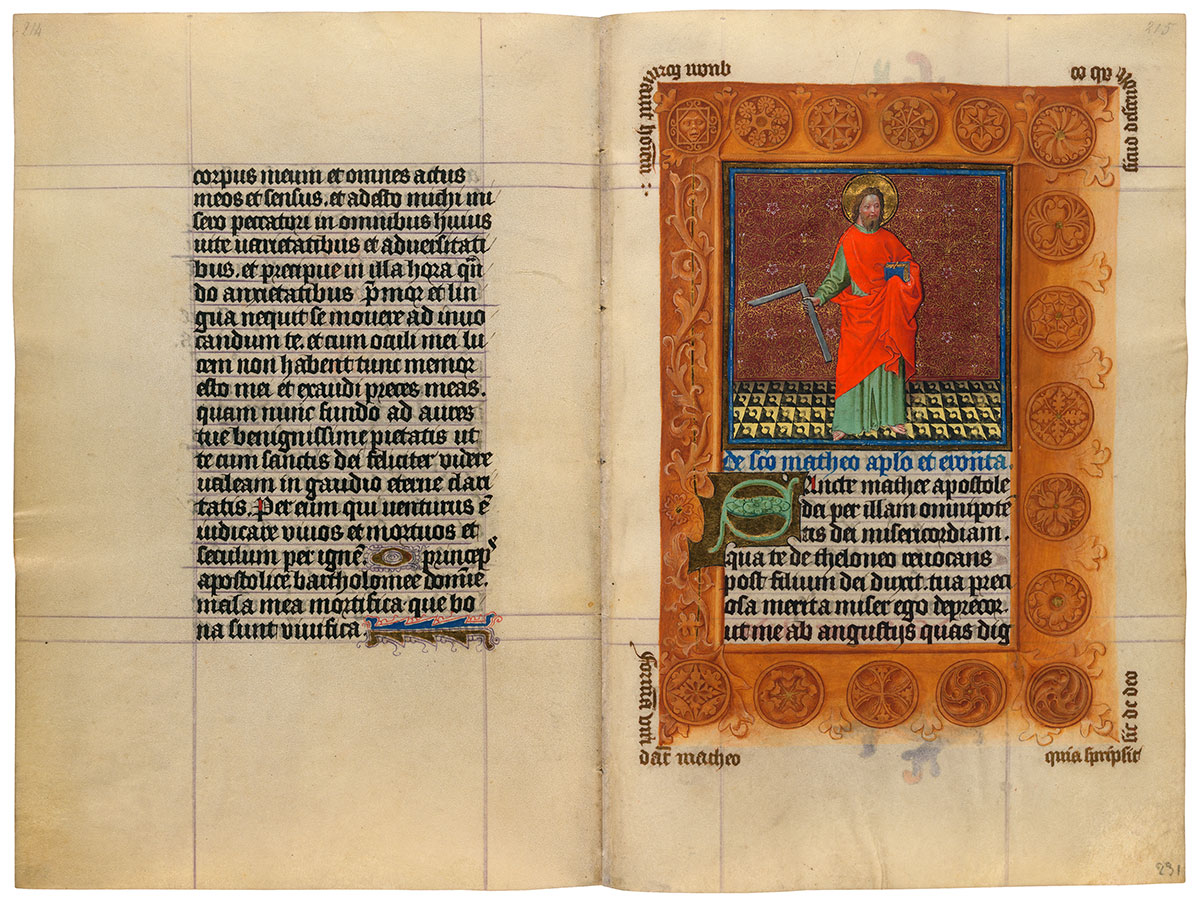
St. Matthew
Purchased on the Belle da Costa Greene Fund with the assistance of the Fellows, 1963
Here Matthew holds a Gospel Book, referencing his role as evangelist, and a carpenter's square (which he also holds in the bottom border of p. 262). The connection of Matthew with woodworking is unusual but receives reinforcement here from the border that simulates an elaborately carved wood frame. Starting at the lower left, an inscription enclosing the frame at each corner describes why Matthew was assigned the symbol of a man:
Forma[m] viri da[n]t Matheo/ quia spripsit [sic: for scripsit] sic de Deo/ sicud [sic: for sicut] descendit ab eo/ quem formavit ho[m]i[n]em.
Suffrages
Suffrages are short prayers to individual saints. As protectors of medieval people, saints were their doctor in plague, their midwife at childbirth, their guardian when traveling, and their nurse during toothache. If the Virgin was the figure to whom one addressed the all-important petition for eternal salvation, it was from saints that one sought more basic or temporal kinds of help. While the Virgin became, as the Mother of God, almost a goddess herself, saints retained more of their humanity and thus their approachability.
Image courtesy of Faksimile Verlag Luzern
MS M.917/945, pp. 232–233
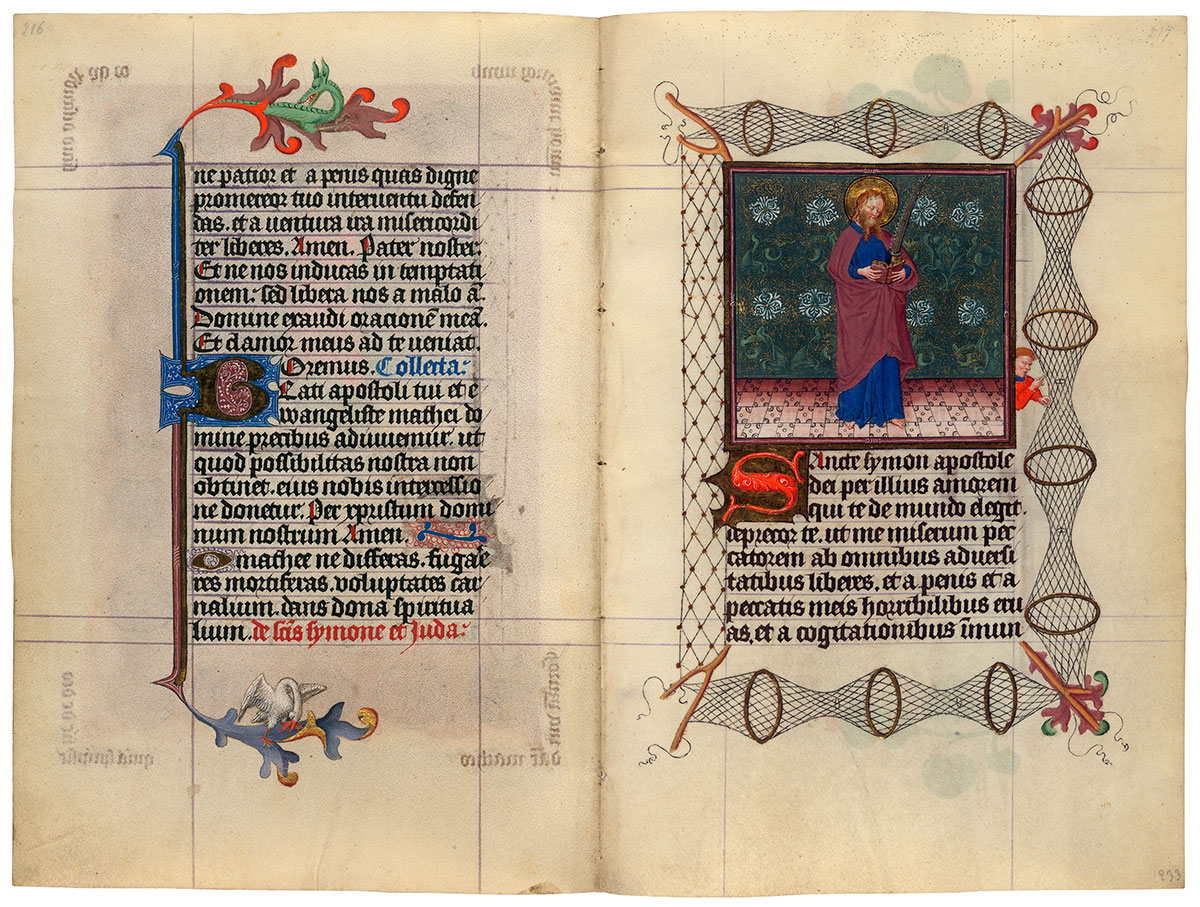
St. Simon
Purchased on the Belle da Costa Greene Fund with the assistance of the Fellows, 1963
Simon's setting – with its delicately ornamented pink tiles and exquisite floral green backdrop – is more elaborate than many in the book. The apostle reads from a book while cradling the instrument of his martyrdom in his left arm: a long-bladed saw. The border is made up of two varieties of fishing nets. A small man in red leans out from behind the frame of the miniature to repair one of the nets. The association with fishing may have resulted from confusion between this Simon (known often as "the Zealot") and Simon Peter, the great fisherman who became the fisher of men.
Suffrages
Suffrages are short prayers to individual saints. As protectors of medieval people, saints were their doctor in plague, their midwife at childbirth, their guardian when traveling, and their nurse during toothache. If the Virgin was the figure to whom one addressed the all-important petition for eternal salvation, it was from saints that one sought more basic or temporal kinds of help. While the Virgin became, as the Mother of God, almost a goddess herself, saints retained more of their humanity and thus their approachability.
Image courtesy of Faksimile Verlag Luzern
MS M.917/945, pp. 234–235
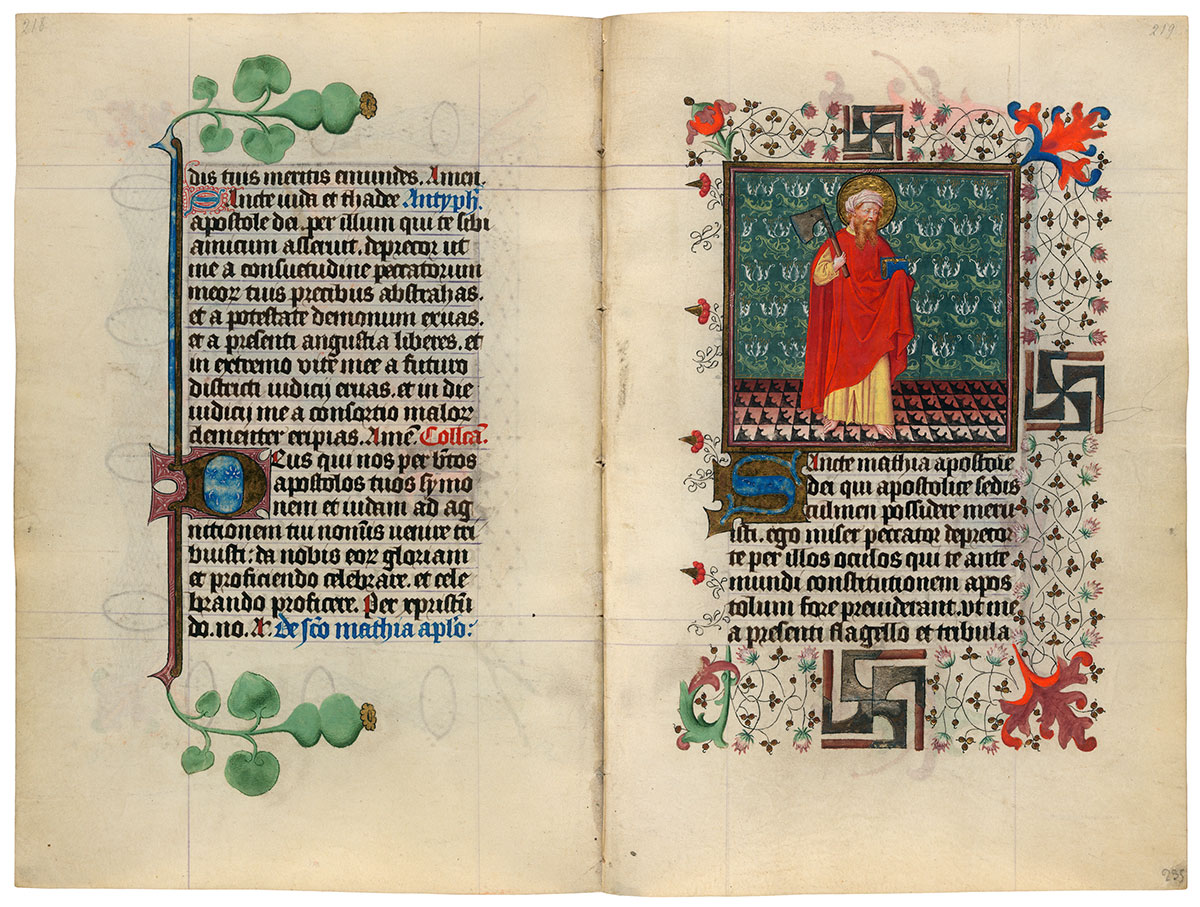
St. Matthias
Purchased on the Belle da Costa Greene Fund with the assistance of the Fellows, 1963
Matthias was chosen by the other apostles to fill the spot left vacant by Judas Iscariot, following his betrayal and subsequent suicide. The apostle stands on scalloped tiles in front of a green backdrop rich with floral decoration. The white turban may reflect his role as a preacher of the Gospel in Ethiopia. The axe is the instrument of his martyrdom: after surviving a stoning in Jerusalem, he was beheaded with an axe. The weapon is seen again in the borders, where three swastikas are comprised of four axes each.
Suffrages
Suffrages are short prayers to individual saints. As protectors of medieval people, saints were their doctor in plague, their midwife at childbirth, their guardian when traveling, and their nurse during toothache. If the Virgin was the figure to whom one addressed the all-important petition for eternal salvation, it was from saints that one sought more basic or temporal kinds of help. While the Virgin became, as the Mother of God, almost a goddess herself, saints retained more of their humanity and thus their approachability.
Image courtesy of Faksimile Verlag Luzern
MS M.917/945, pp. 236–237
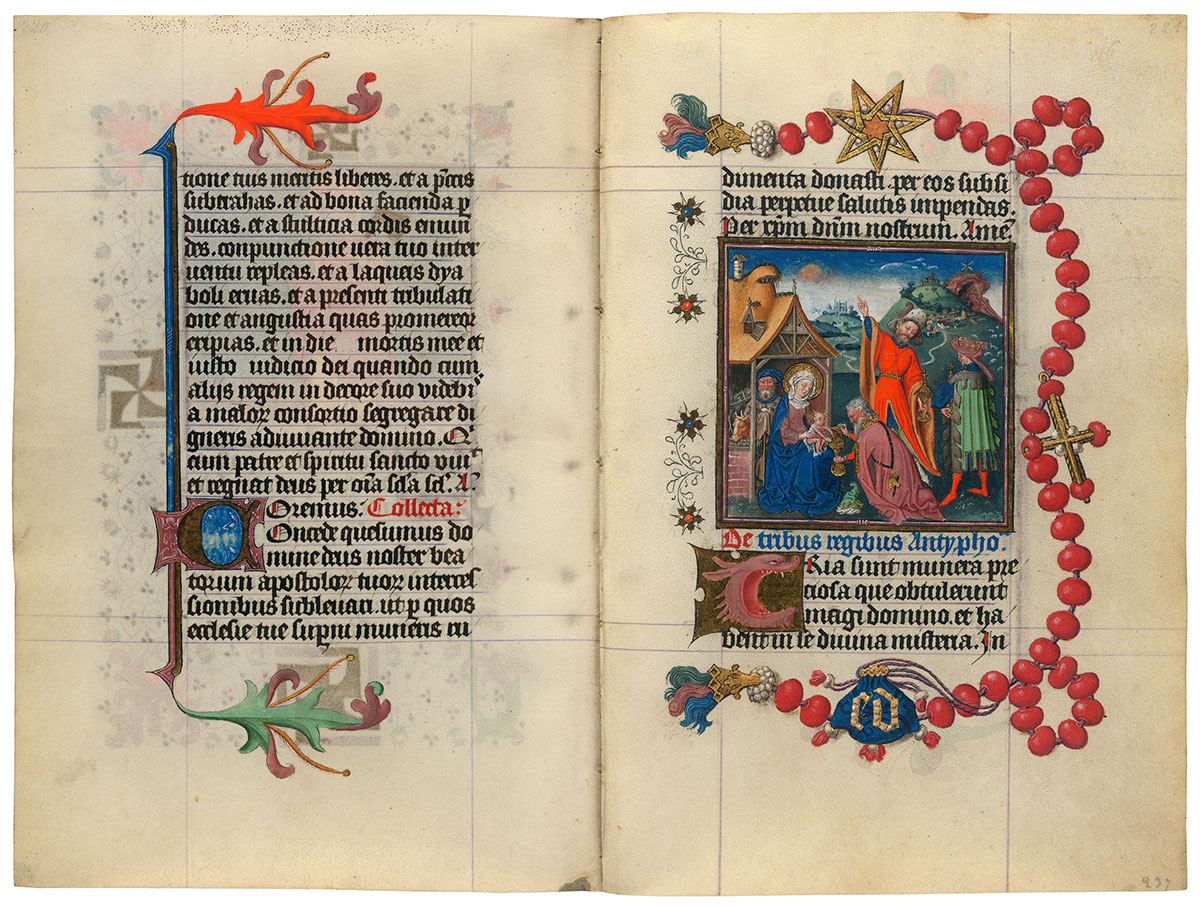
Adoration of the Magi
Purchased on the Belle da Costa Greene Fund with the assistance of the Fellows, 1963
The Three Magi rarely appear in Suffrages. Their prominent position in Catherine's book probably derived from the proximity of Cologne, whose cathedral proudly preserved their relics in a glorious shrine. The eldest magus kneels before baby Jesus offering gold, toward which the child lunges. The second king points to the star that guided them. Waiting his turn is the third magus, who as the youngest is the most fashionably dressed. The deep landscape alludes to their long journey. In the border is Catherine's rosary composed of luxurious coral beads, gold ornaments, and pearls. The letters embroidered on the little purse have been interpreted as CD for Catherina Duxissa (Catherine the Duchess).
Suffrages
Suffrages are short prayers to individual saints. As protectors of medieval people, saints were their doctor in plague, their midwife at childbirth, their guardian when traveling, and their nurse during toothache. If the Virgin was the figure to whom one addressed the all-important petition for eternal salvation, it was from saints that one sought more basic or temporal kinds of help. While the Virgin became, as the Mother of God, almost a goddess herself, saints retained more of their humanity and thus their approachability.
Image courtesy of Faksimile Verlag Luzern
MS M.917/945, pp. 238–239
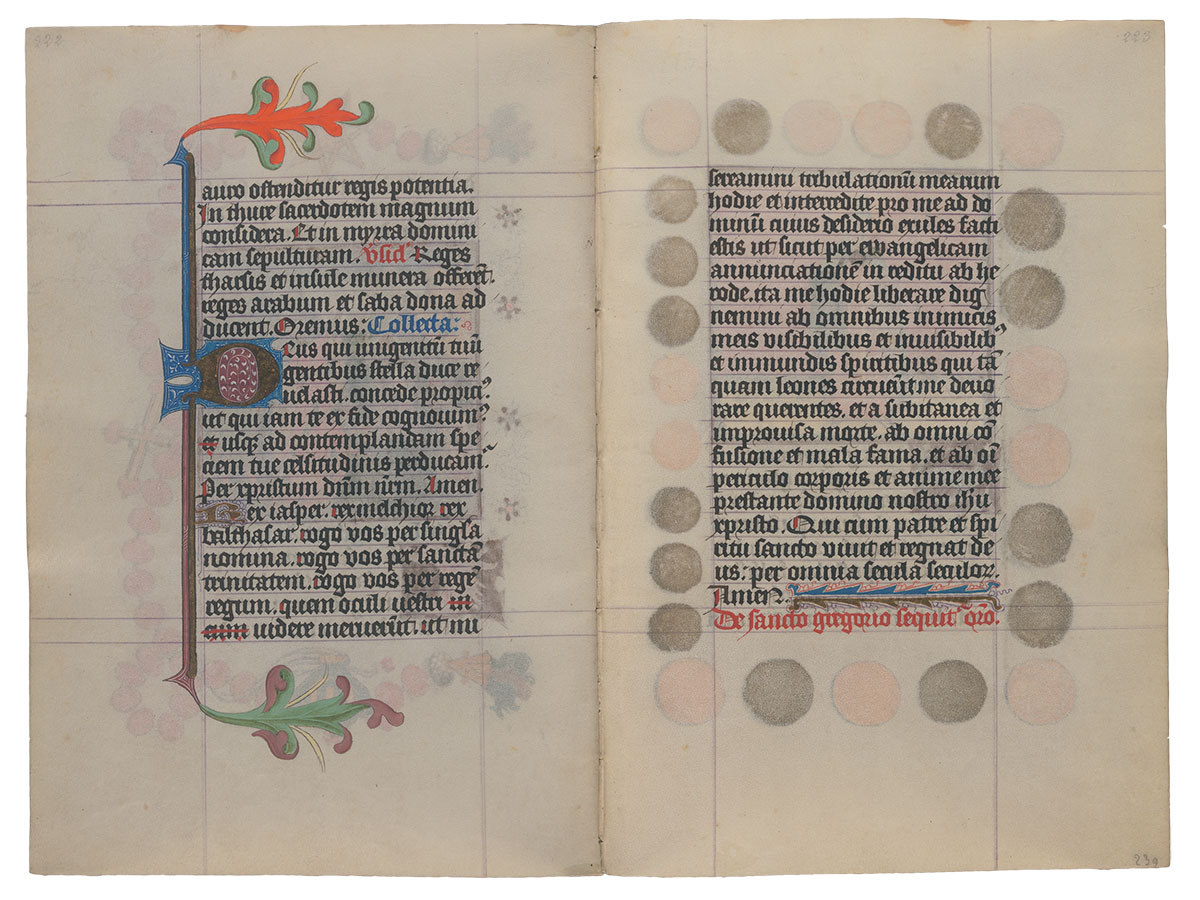
Purchased on the Belle da Costa Greene Fund with the assistance of the Fellows, 1963
Image courtesy of Faksimile Verlag Luzern
MS M.917/945, pp. 242–243
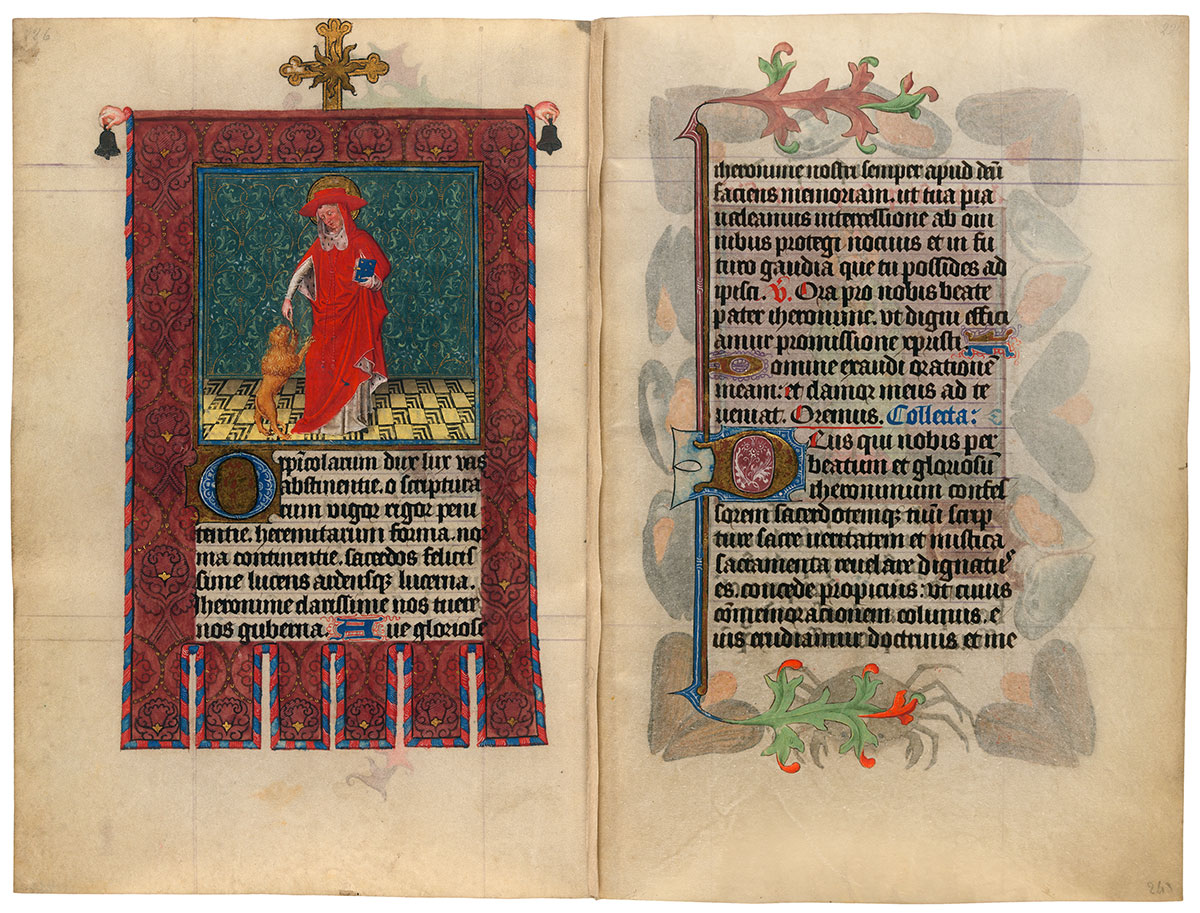
St. Jerome
Purchased on the Belle da Costa Greene Fund with the assistance of the Fellows, 1963
Wearing the brimmed crimson hat and ermine-lined robes of a cardinal, Jerome holds a book while reaching down to pluck a thorn from the paw of a small lion. The book symbolizes, among abundant other writings, his translation of the Bible into Latin (known as the Vulgate). The story of Jerome's healing the lion was well known in medieval Europe and appears in the Golden Legend. The border takes the form of a trompe-l'oeil processional banner of purple fabric edged with red-and-blue striped cord. The rod holding the banner at the top has two small hands that dangle silver bells. It is also surmounted by a large gold cross, unfortunately trimmed, that may have been the head of a supporting staff.
Suffrages
Suffrages are short prayers to individual saints. As protectors of medieval people, saints were their doctor in plague, their midwife at childbirth, their guardian when traveling, and their nurse during toothache. If the Virgin was the figure to whom one addressed the all-important petition for eternal salvation, it was from saints that one sought more basic or temporal kinds of help. While the Virgin became, as the Mother of God, almost a goddess herself, saints retained more of their humanity and thus their approachability.
Image courtesy of Faksimile Verlag Luzern
MS M.917/945, pp. 244–245
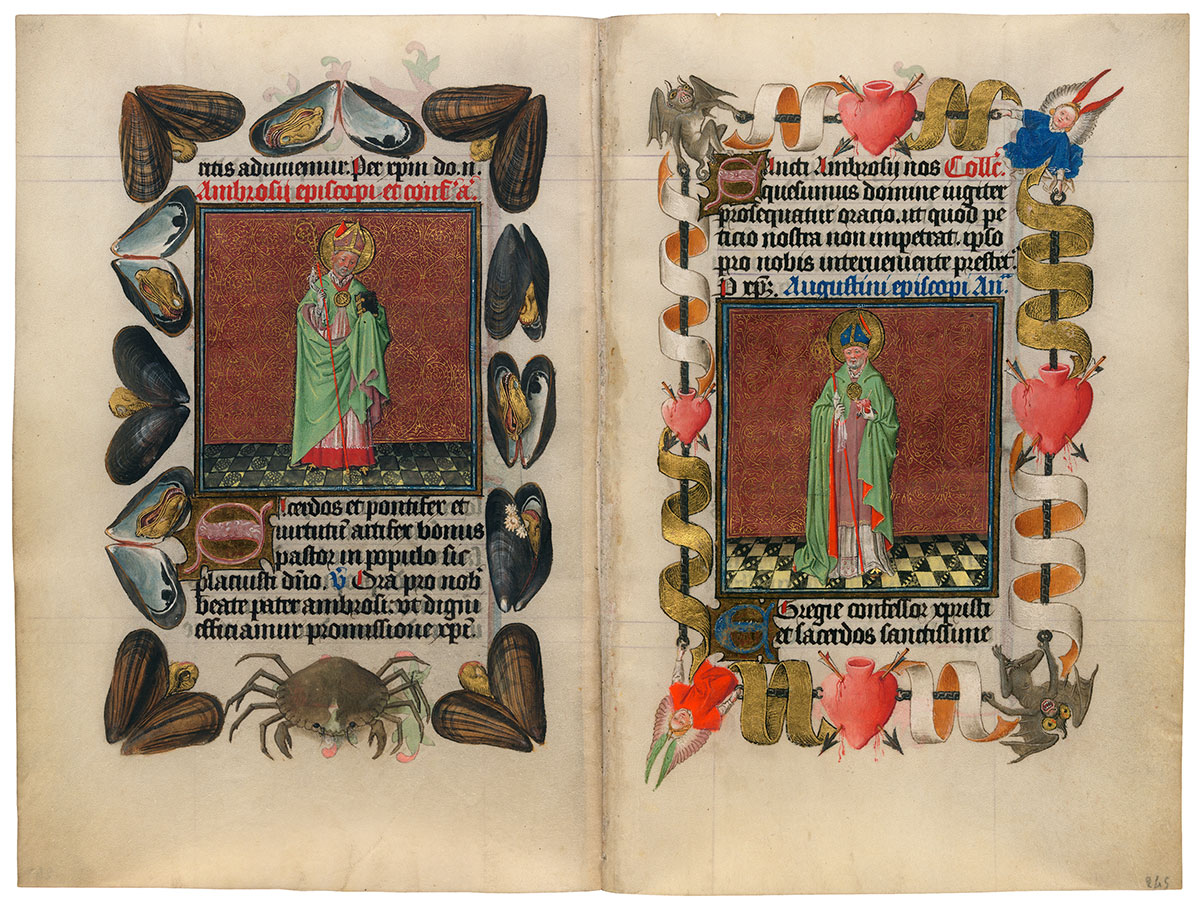
St. Ambrose
St. Augustine
Purchased on the Belle da Costa Greene Fund with the assistance of the Fellows, 1963
Archbishop Ambrose wears a miter and holds a book and crozier. He was famous for preaching sermons that could reconcile the bitterest of enemies, and in the border, natural enemies—mussels and the crab, which likes to feast on mussels' flesh—cohabit in harmony. Bishop Augustine also wears a miter and holds a crozier. He holds his attribute, a heart pierced by two arrows, a sign of his remorse over the sins of dissipation he committed in his youth. Larger pierced hearts, suspended on chains held by demons and angels, form the border.
Suffrages
Suffrages are short prayers to individual saints. As protectors of medieval people, saints were their doctor in plague, their midwife at childbirth, their guardian when traveling, and their nurse during toothache. If the Virgin was the figure to whom one addressed the all-important petition for eternal salvation, it was from saints that one sought more basic or temporal kinds of help. While the Virgin became, as the Mother of God, almost a goddess herself, saints retained more of their humanity and thus their approachability.
Image courtesy of Faksimile Verlag Luzern
MS M.917/945, pp. 246–247
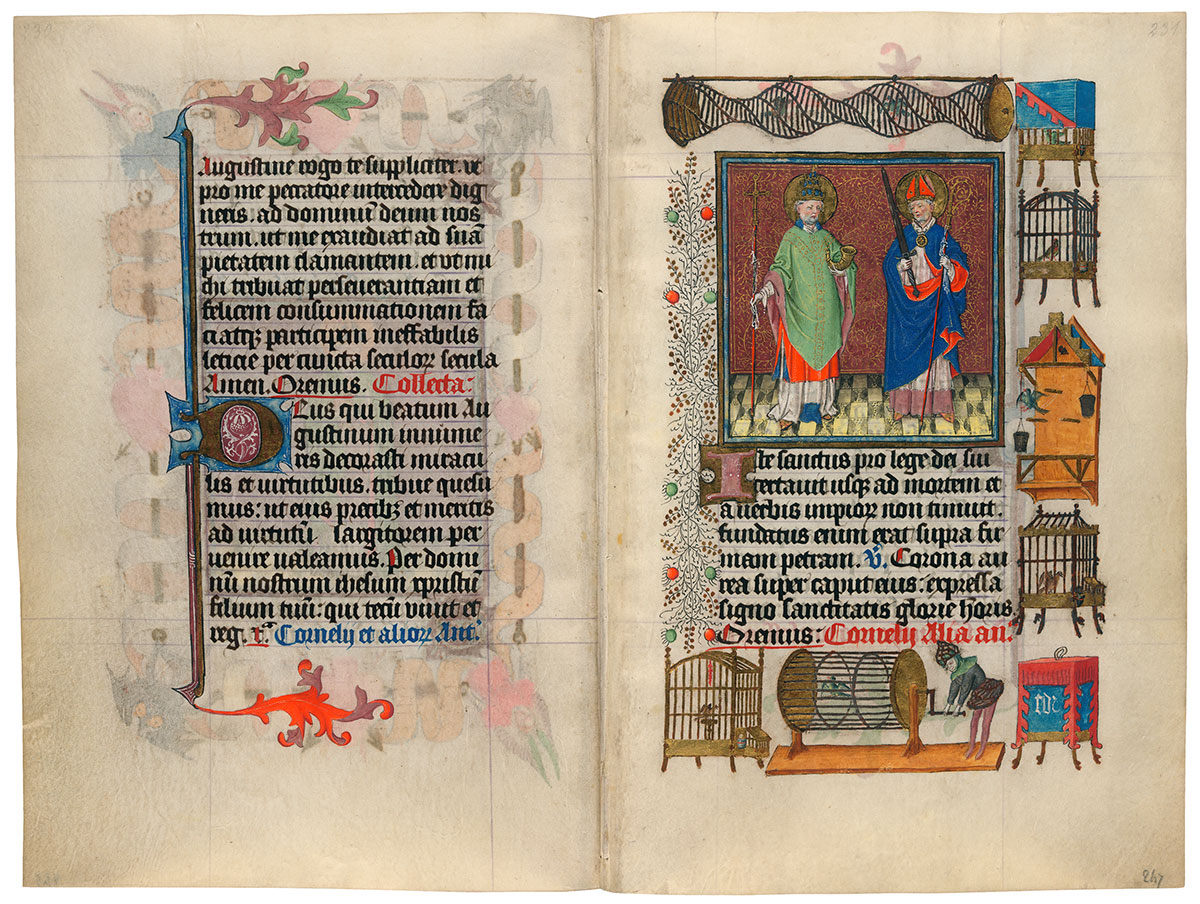
SS. Cornelius and Cyprian
Purchased on the Belle da Costa Greene Fund with the assistance of the Fellows, 1963
Cornelius, holding a horn (cornus in Latin—a pun on his name), and Cyprian, with the sword of his martyrdom, share a feast. Birdcages, executed in silver and gold, comprise the delightful border. They may allude to Cornelius as patron saint of pets or to an interest of Catherine.
Suffrages
Suffrages are short prayers to individual saints. As protectors of medieval people, saints were their doctor in plague, their midwife at childbirth, their guardian when traveling, and their nurse during toothache. If the Virgin was the figure to whom one addressed the all-important petition for eternal salvation, it was from saints that one sought more basic or temporal kinds of help. While the Virgin became, as the Mother of God, almost a goddess herself, saints retained more of their humanity and thus their approachability.
Image courtesy of Faksimile Verlag Luzern
MS M.917/945, pp. 248–249
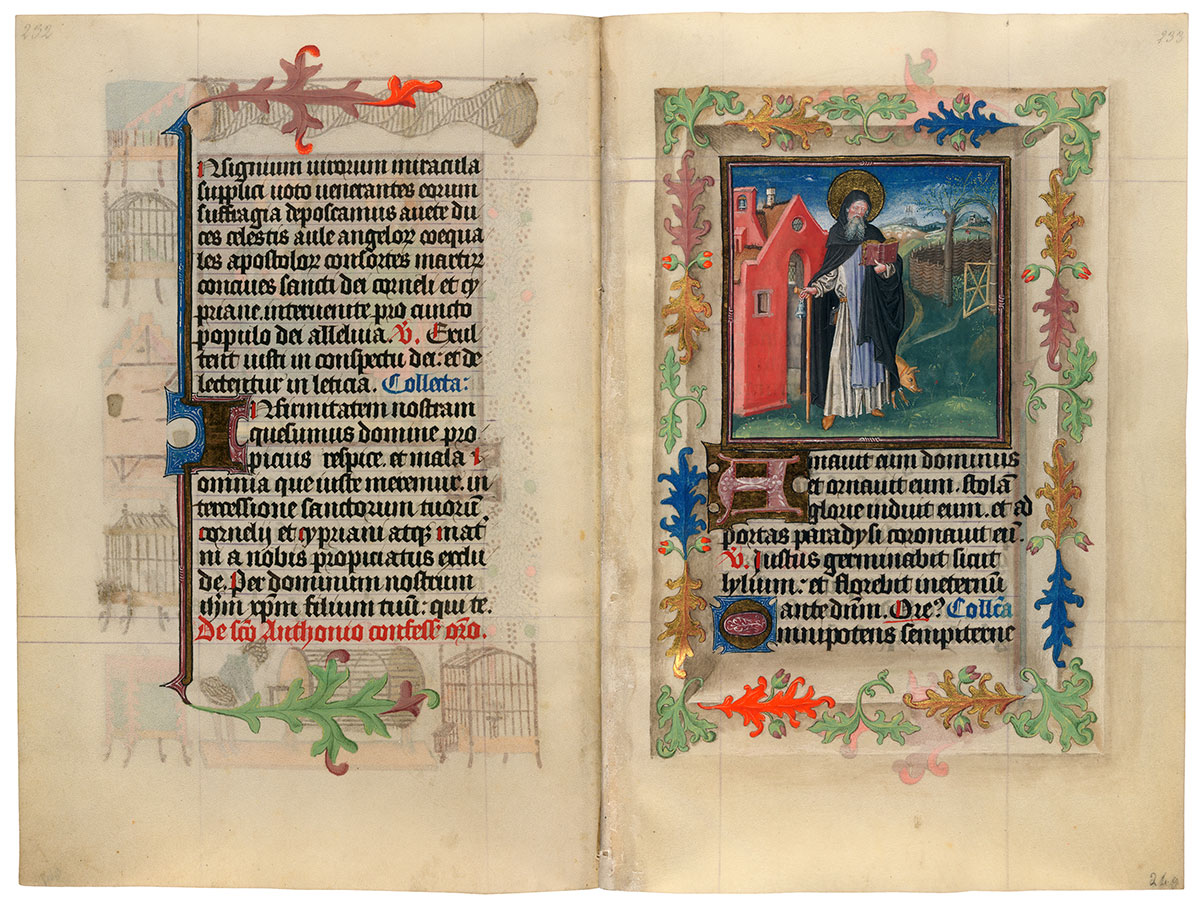
St. Anthony
Purchased on the Belle da Costa Greene Fund with the assistance of the Fellows, 1963
Anthony reads from an open book while leaning on a cane. The cane has a bell hanging from its handle additional bells hang from the neck of the pig and in the belfry of the pink building to his right. That building and the enclosure surrounded by a woven fence might allude to twenty years the saint spent at Fort Pispir where he spurned the company, or even the sight, of other men. Because of both his asceticism and the community of disciples that grew up around him during his self-imposed isolation, Anthony represents the founding of Christian monastic practice. The artist shows his virtuosity by minutely capturing the atmospheric effects of the swirling haze that obscures the castle in the far background.
Suffrages
Suffrages are short prayers to individual saints. As protectors of medieval people, saints were their doctor in plague, their midwife at childbirth, their guardian when traveling, and their nurse during toothache. If the Virgin was the figure to whom one addressed the all-important petition for eternal salvation, it was from saints that one sought more basic or temporal kinds of help. While the Virgin became, as the Mother of God, almost a goddess herself, saints retained more of their humanity and thus their approachability.
Image courtesy of Faksimile Verlag Luzern
MS M.917/945, pp. 250–251
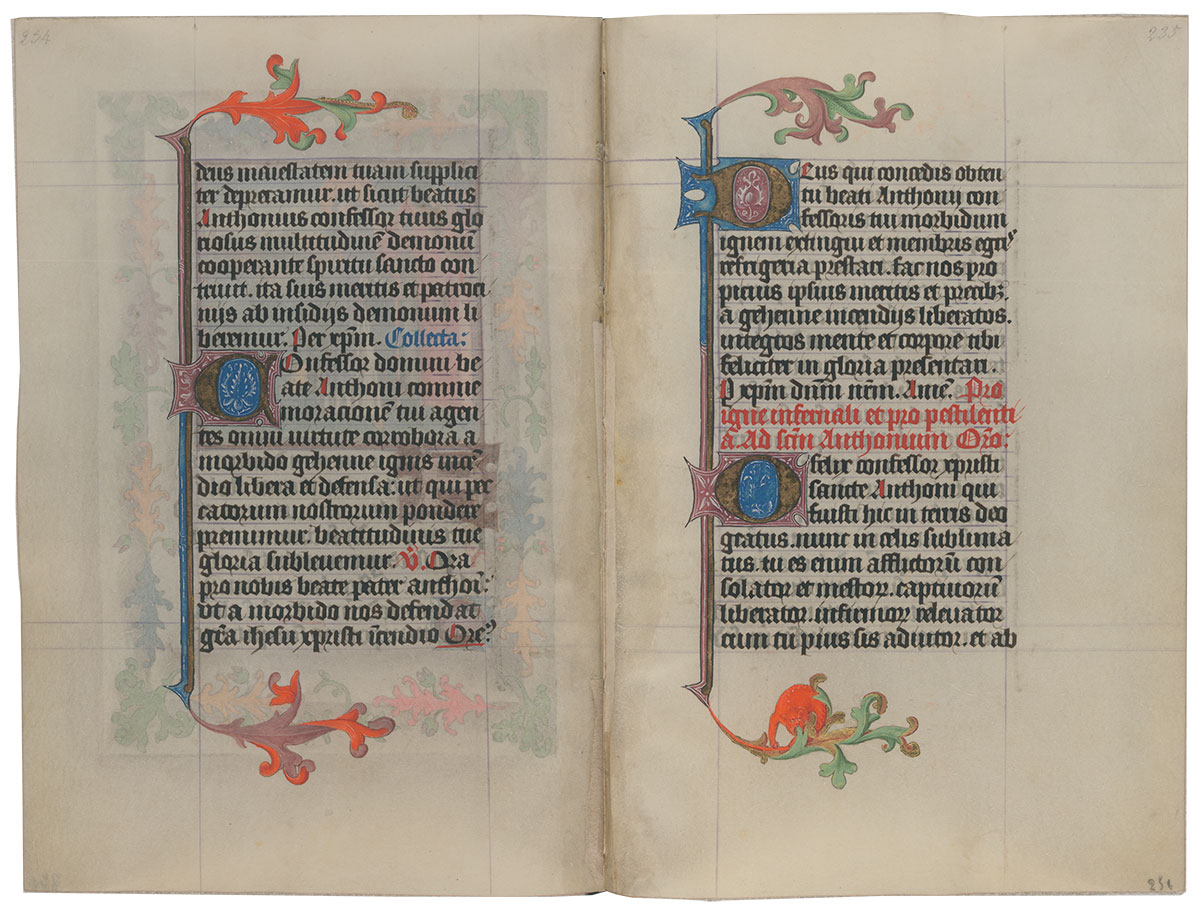
Purchased on the Belle da Costa Greene Fund with the assistance of the Fellows, 1963
Image courtesy of Faksimile Verlag Luzern
MS M.917/945, pp. 252–253
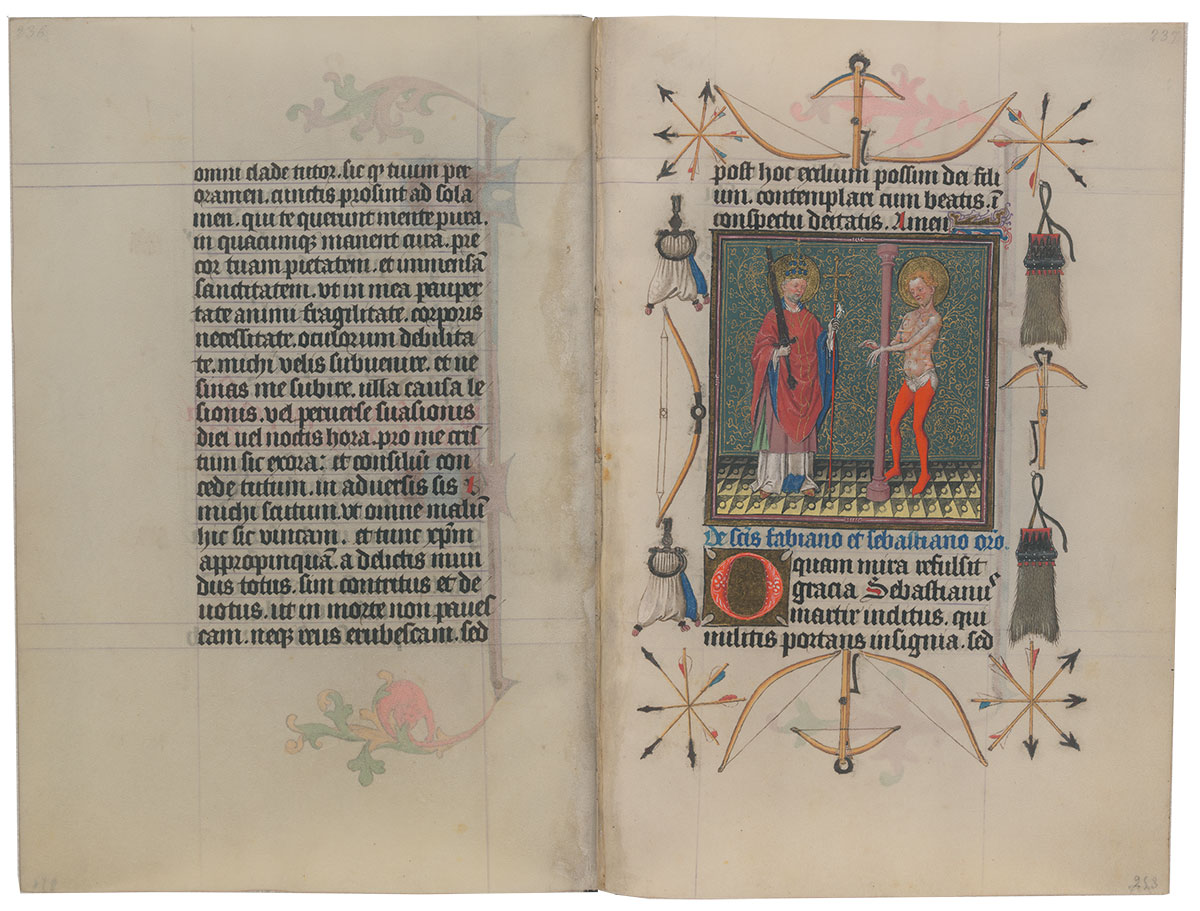
Purchased on the Belle da Costa Greene Fund with the assistance of the Fellows, 1963
Image courtesy of Faksimile Verlag Luzern
MS M.917/945, pp. 254–255
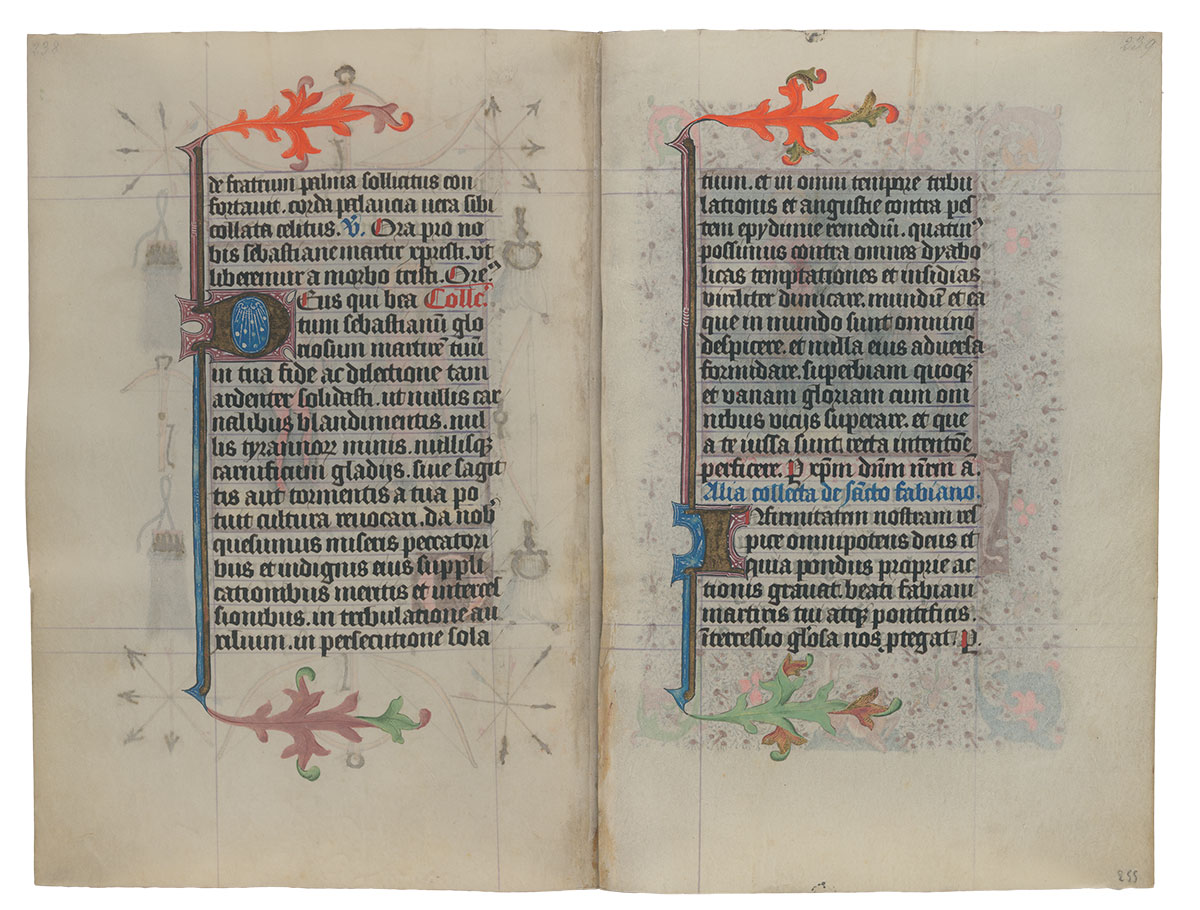
Purchased on the Belle da Costa Greene Fund with the assistance of the Fellows, 1963
Image courtesy of Faksimile Verlag Luzern
MS M.917/945, pp. 256–257
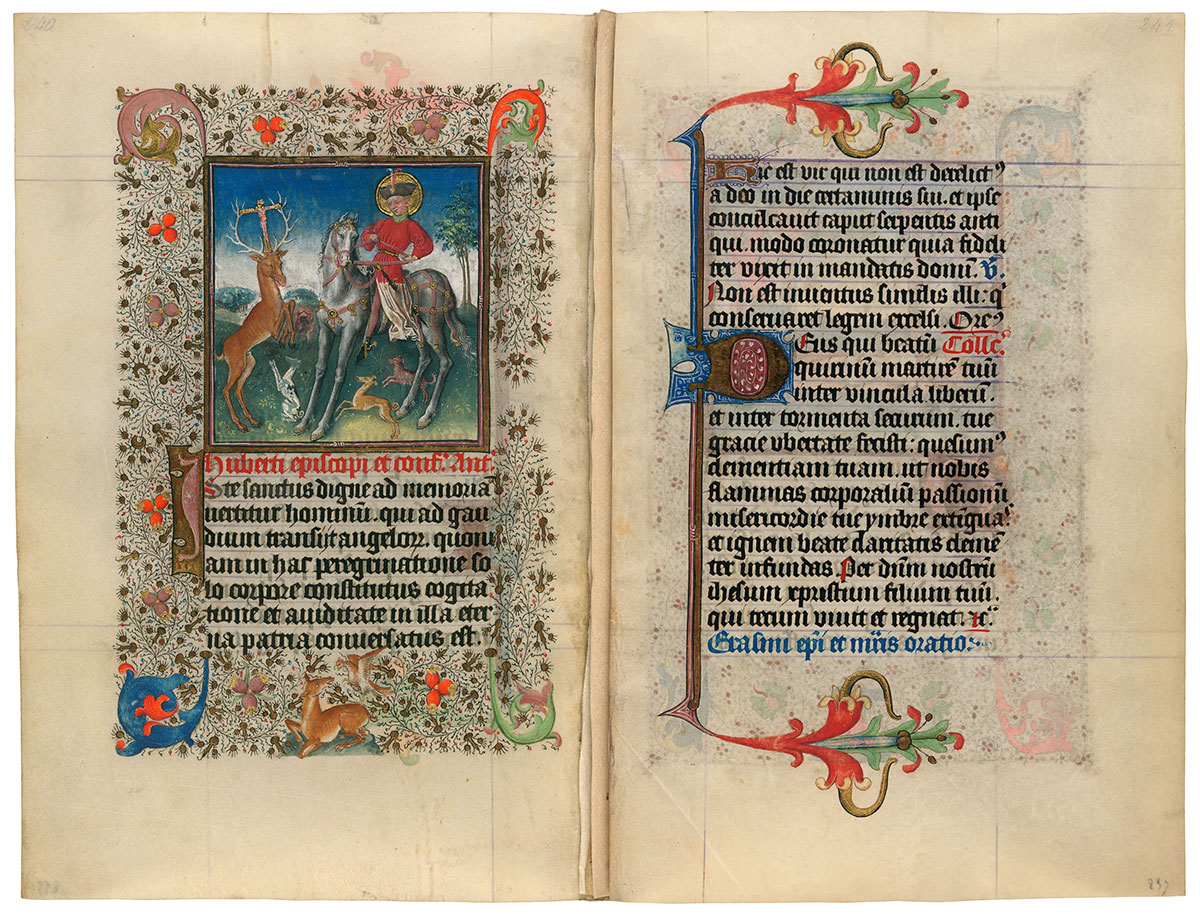
Conversion of St. Hubert
Purchased on the Belle da Costa Greene Fund with the assistance of the Fellows, 1963
Hubert, patron of the hunt, is pictured on the ride that changed his life. While in pursuit of a deer, a vision of the Crucifixion appeared to him between the antlers of a stag, and he heard a voice telling him to exchange his life of frivolity for one dedicated to God. In the miniature Hubert sports a fancy hat with two long feathers and a turned-up brim and wears a white and crimson gown split for riding. He pulls hard on the reins of his long-legged steed as the stag rears up in front of him. Three hunting dogs cavort at the feet of the horse, the foremost of them back on its haunches with paws upraised as if in prayer. The border also contains a hunting scene: a small fawn is attacked by an eagle.
Suffrages
Suffrages are short prayers to individual saints. As protectors of medieval people, saints were their doctor in plague, their midwife at childbirth, their guardian when traveling, and their nurse during toothache. If the Virgin was the figure to whom one addressed the all-important petition for eternal salvation, it was from saints that one sought more basic or temporal kinds of help. While the Virgin became, as the Mother of God, almost a goddess herself, saints retained more of their humanity and thus their approachability.
Image courtesy of Faksimile Verlag Luzern
MS M.917/945, pp. 258–259
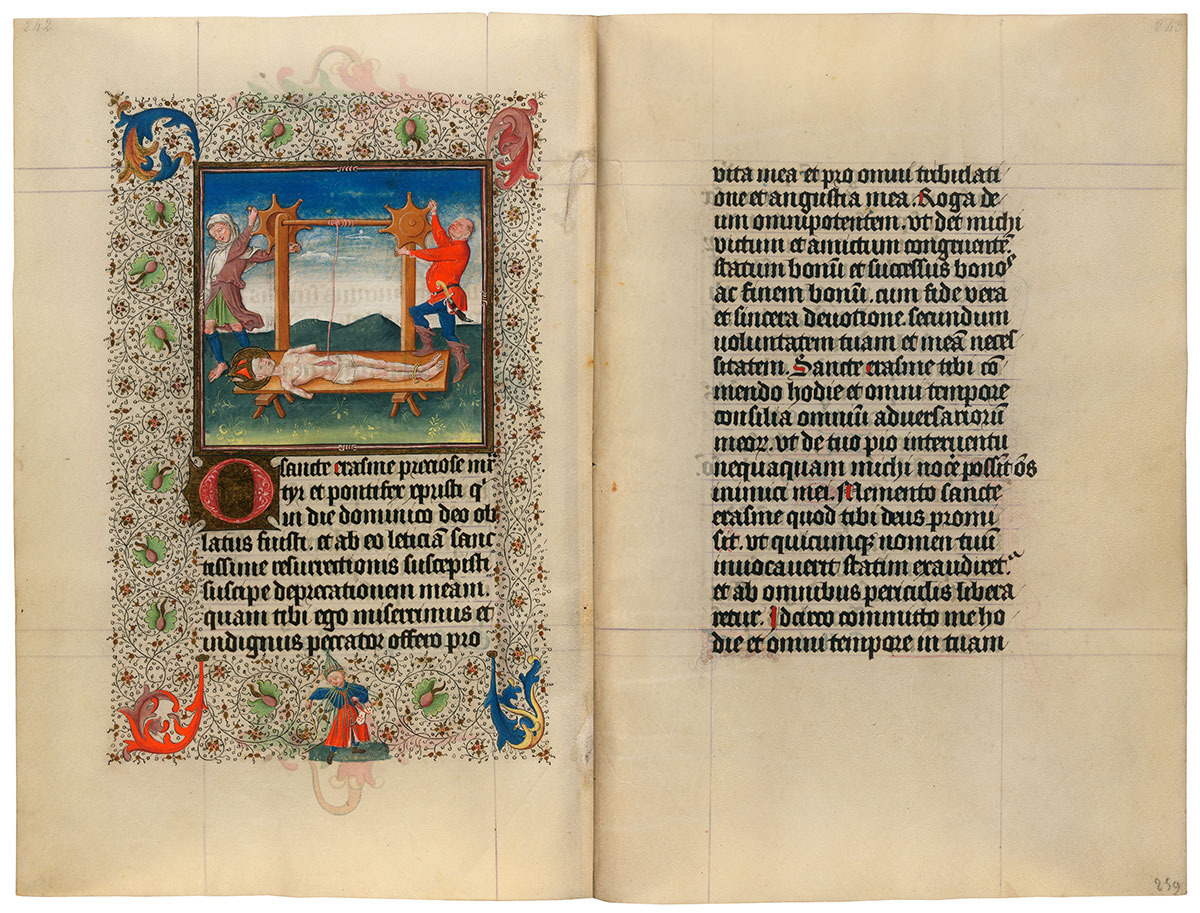
Evisceration of St. Erasmus
Purchased on the Belle da Costa Greene Fund with the assistance of the Fellows, 1963
Erasmus (also known as St. Elmo) was an Italian bishop during Diocletian's persecution of the Christians around the turn of the fouth century. He lies on a raised board, clothed only in his miter and a loincloth. His arms are bound painfully beneath the board while two executioners wind his intestines around a spool turned by spoked wheels. At right, the bald executioner in crimson has a long curved knife at his belt – probably the blade used to slit the belly of the saint. In the border, and of unknown significance, is a boy riding a hobbyhorse and wearing a conical hat made of tied green sticks and a collar of similar material made into long spikes.
Suffrages
Suffrages are short prayers to individual saints. As protectors of medieval people, saints were their doctor in plague, their midwife at childbirth, their guardian when traveling, and their nurse during toothache. If the Virgin was the figure to whom one addressed the all-important petition for eternal salvation, it was from saints that one sought more basic or temporal kinds of help. While the Virgin became, as the Mother of God, almost a goddess herself, saints retained more of their humanity and thus their approachability.
Image courtesy of Faksimile Verlag Luzern
MS M.917/945, pp. 260–261
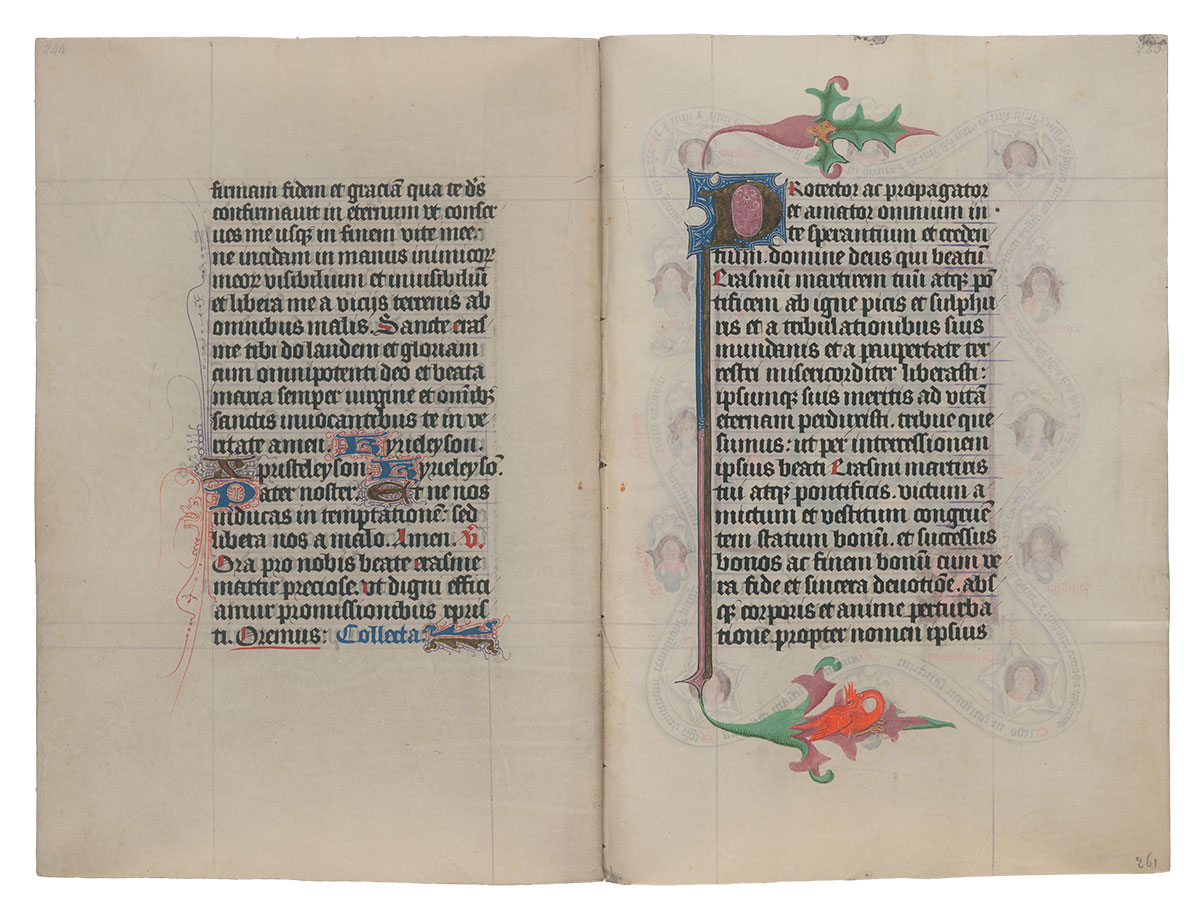
Purchased on the Belle da Costa Greene Fund with the assistance of the Fellows, 1963
Image courtesy of Faksimile Verlag Luzern
MS M.917/945, pp. 262–263
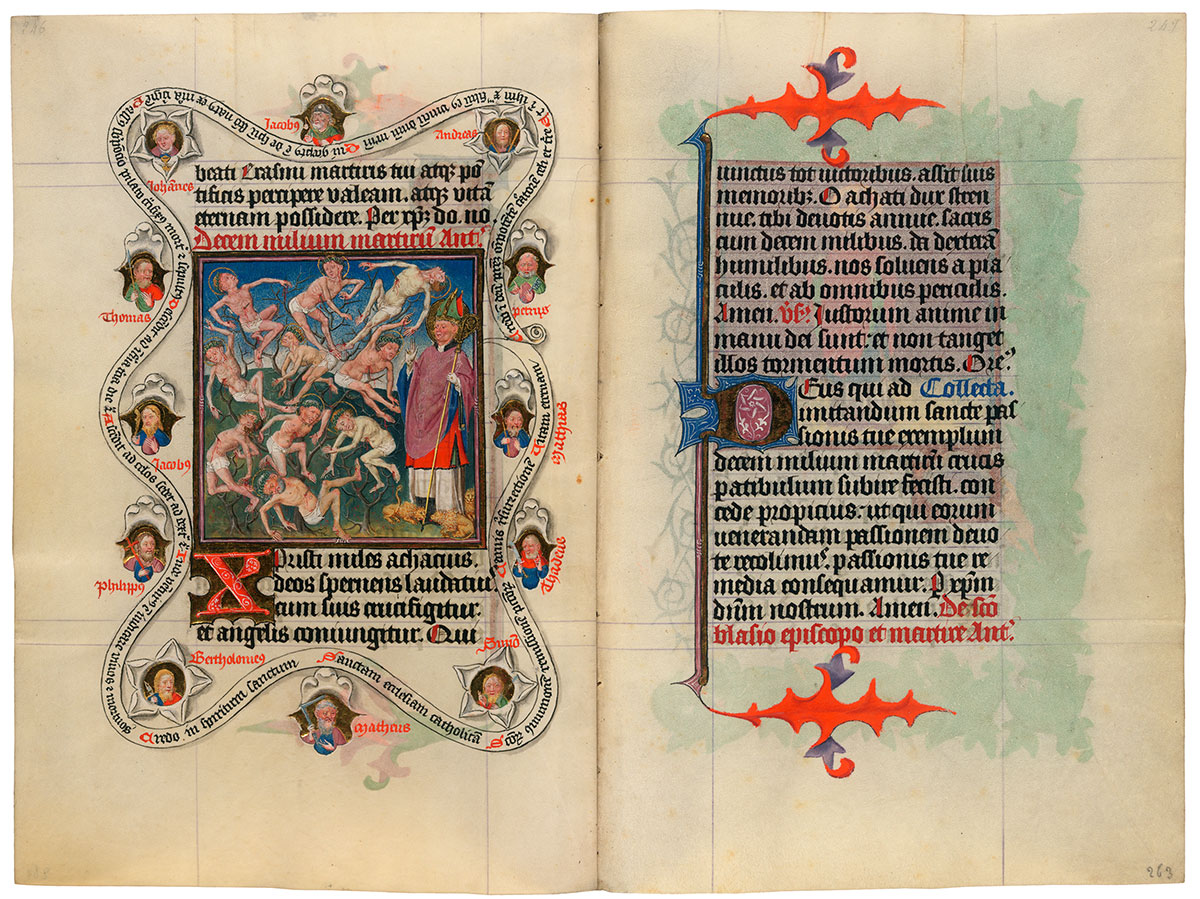
Ten Thousand Martyrs and St. Acacius
Purchased on the Belle da Costa Greene Fund with the assistance of the Fellows, 1963
In this grisly miniature ten men represent ten thousand soldiers martyred at Mt. Ararat for their mass conversion to the Christian faith before a battle. They are in a variety of pained poses, impaled on the spreading branches of an acacia tree and wearing only loincloths and crowns of thorns on their heads. Legend holds that they were crucified, and this depiction of impalement may stem from a misreading of, or a play on, the name of their leader, Acacius. The saint himself stands at the right of the miniature incongruously wearing bishop's vestments despite his occupation of soldier (probably due to confusion with a different St. Acacius who was a bishop). A long scroll curling around the border bears the Apostles' Creed; it winds through portraits of the twelve apostles, who, in a trompe-l'oeil effect, peek from holes in the vellum cut into the shapes of white flowers. The Creed starts toward the upper right with Petrus (Peter) who is credited with writing the First Article, "Credo i[n] deu[m] p[at]rem o[mn]ipote[n]te[m] c[re]atore[m] celi et t[er]se" (I believe in Got the Father, Creator Almighty, creator of heaven and earth).
Suffrages
Suffrages are short prayers to individual saints. As protectors of medieval people, saints were their doctor in plague, their midwife at childbirth, their guardian when traveling, and their nurse during toothache. If the Virgin was the figure to whom one addressed the all-important petition for eternal salvation, it was from saints that one sought more basic or temporal kinds of help. While the Virgin became, as the Mother of God, almost a goddess herself, saints retained more of their humanity and thus their approachability.
Image courtesy of Faksimile Verlag Luzern
MS M.917/945, pp. 264–265
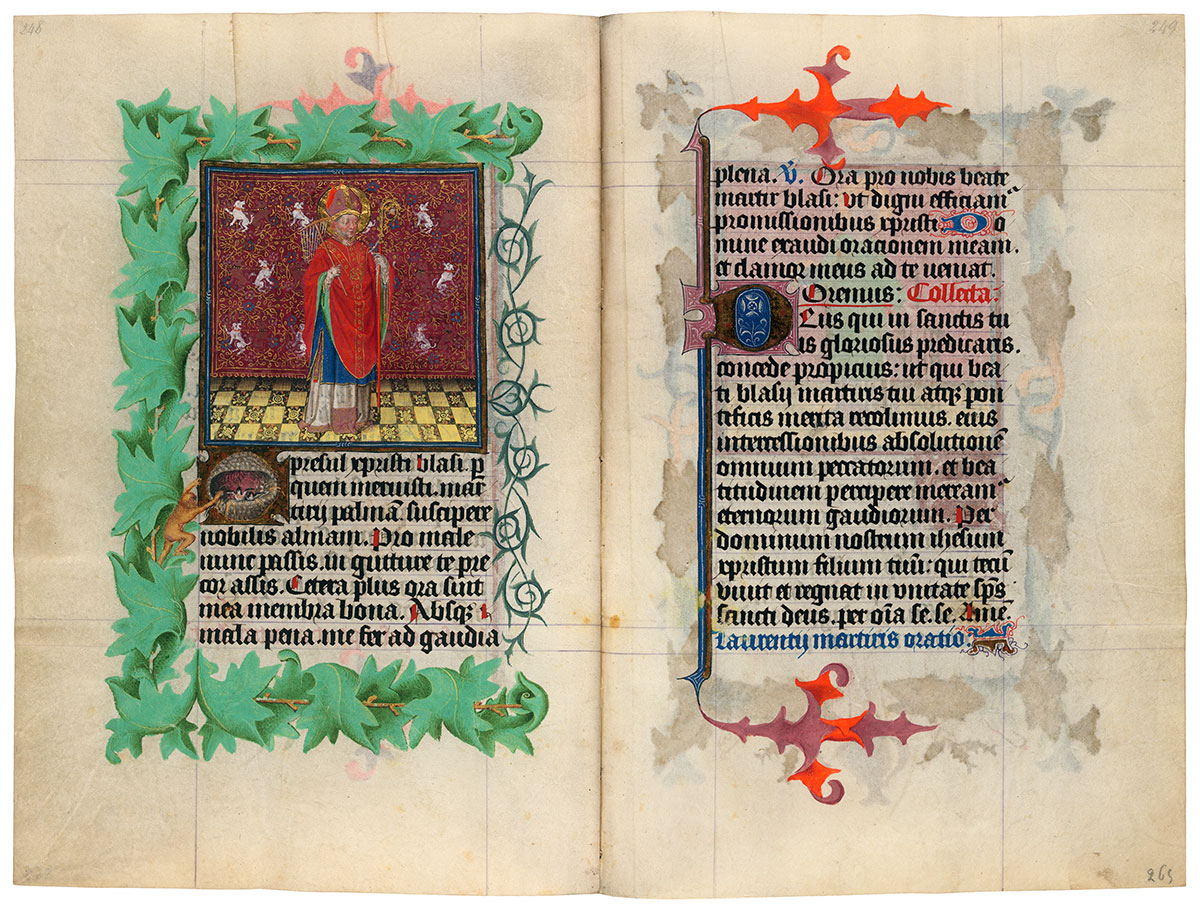
St. Blaise
Purchased on the Belle da Costa Greene Fund with the assistance of the Fellows, 1963
Blaise is dressed in the vestments of a bishop, holding a crozier in his left hand and a wool-comb slung over his right shoulder. The long, sharp tines of this tool are the implements of his martyrdom. The textile background includes several ferocious looking beasts- an allusion to the story that he healed wild animals while a hermit in the desert. In the border, a monkey reaches out from the curling leaves to snatch a bird from the inhabited initial "O" in the text, which takes the form of a bird's nest.
Suffrages
Suffrages are short prayers to individual saints. As protectors of medieval people, saints were their doctor in plague, their midwife at childbirth, their guardian when traveling, and their nurse during toothache. If the Virgin was the figure to whom one addressed the all-important petition for eternal salvation, it was from saints that one sought more basic or temporal kinds of help. While the Virgin became, as the Mother of God, almost a goddess herself, saints retained more of their humanity and thus their approachability.
Image courtesy of Faksimile Verlag Luzern
MS M.917/945, pp. 266–267
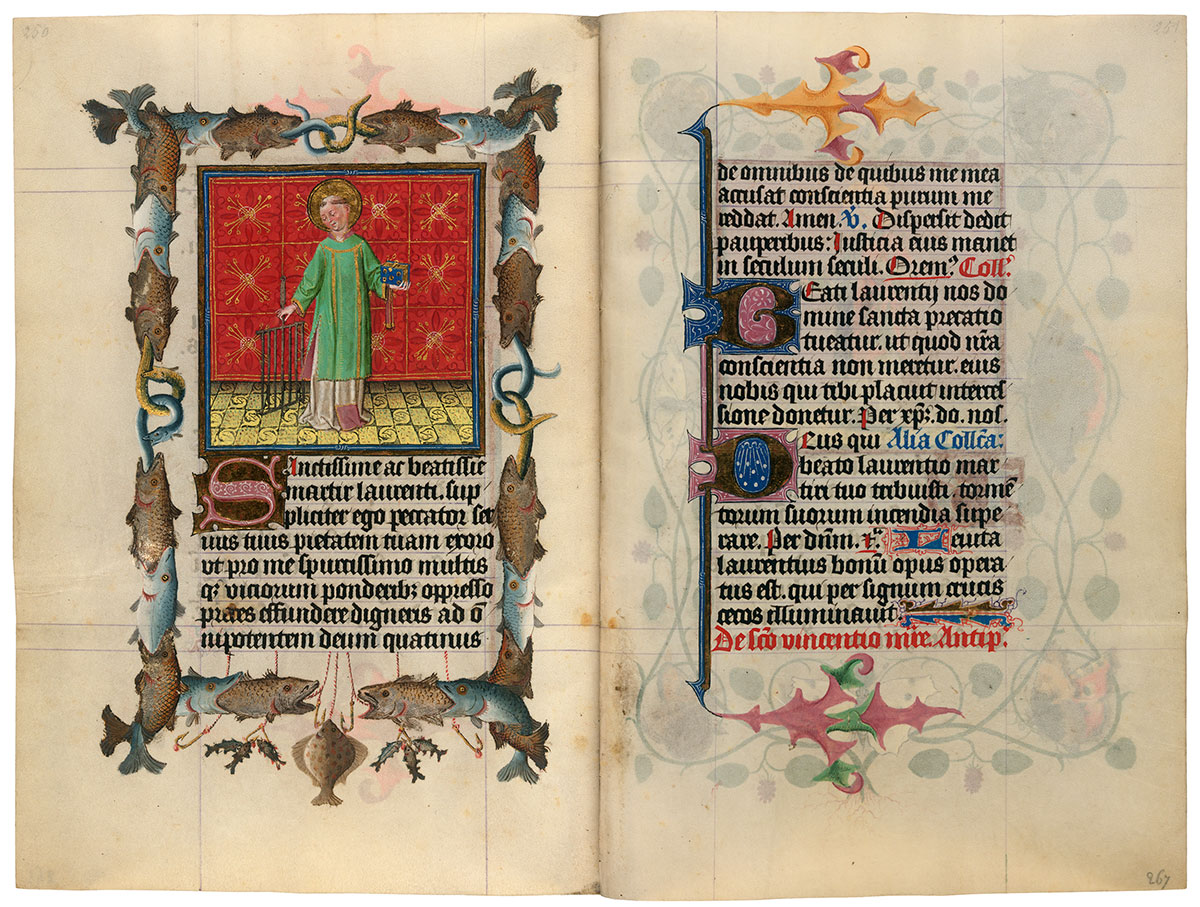
St. Lawrence
Purchased on the Belle da Costa Greene Fund with the assistance of the Fellows, 1963
St. Lawrence is framed by a border of eels and fish, beautifully executed in gold and silver foil. The saint holds his attribute, the gridiron upon which he was fried to death. The artist made a playful parallel between Lawrence's method of martyrdom and the way fish are cooked.
Suffrages
Suffrages are short prayers to individual saints. As protectors of medieval people, saints were their doctor in plague, their midwife at childbirth, their guardian when traveling, and their nurse during toothache. If the Virgin was the figure to whom one addressed the all-important petition for eternal salvation, it was from saints that one sought more basic or temporal kinds of help. While the Virgin became, as the Mother of God, almost a goddess herself, saints retained more of their humanity and thus their approachability.
Image courtesy of Faksimile Verlag Luzern
MS M.917/945, pp. 268–269
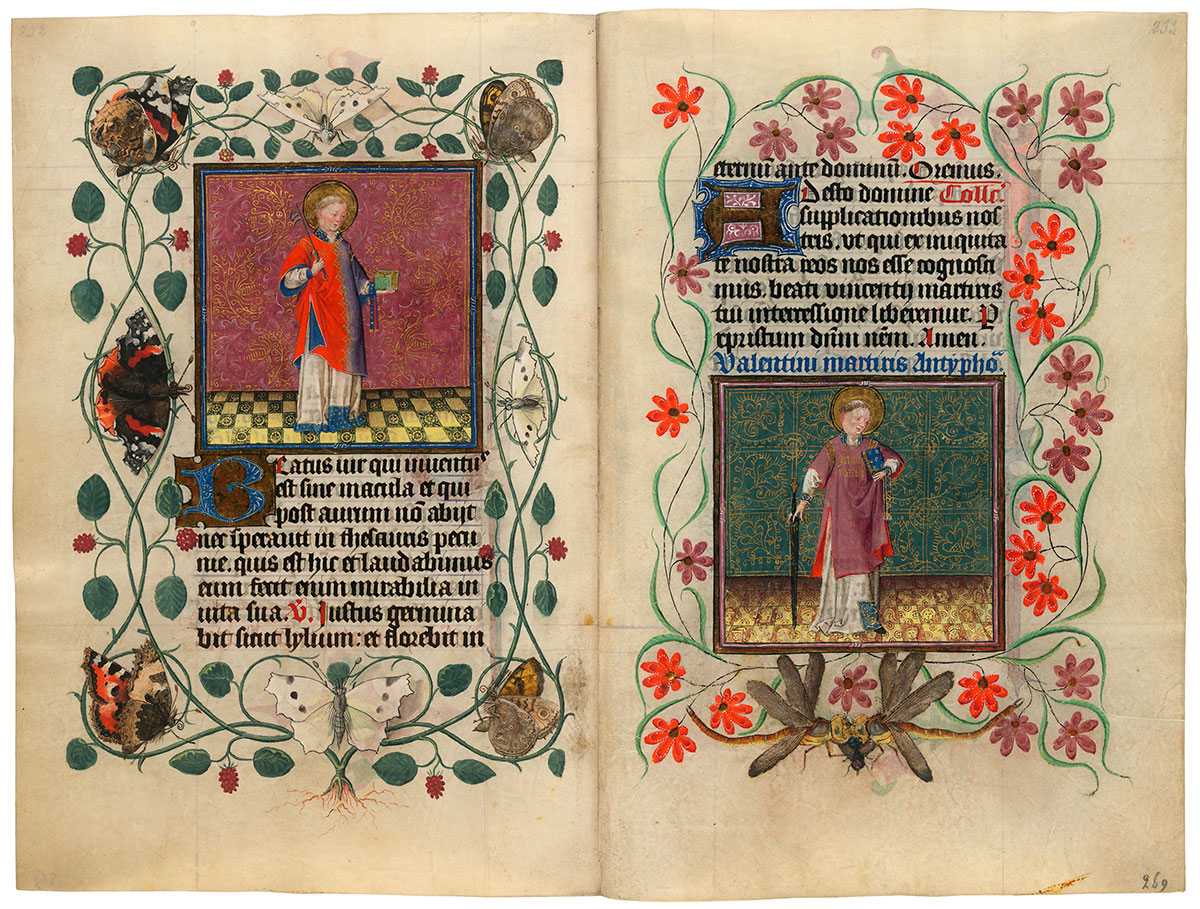
St. Vincent
St. Valentine
Purchased on the Belle da Costa Greene Fund with the assistance of the Fellows, 1963
Dressed as a deacon, Vincent holds a book and a spiked hoe, instrument of his martyrdom. He is framed by intertwined (raspberry?) vines upon which eight butterflies have alighted. At the upper left, the red admiral can be identified by the image of the skull that appears on the underside of its wing. Valentine, also dressed as a deacon, holds the sword of his martyrdom. He is framed by delicate flowers with thin leaves. At the bottom, two dragonflies devour a fly (or bee).
Suffrages
Suffrages are short prayers to individual saints. As protectors of medieval people, saints were their doctor in plague, their midwife at childbirth, their guardian when traveling, and their nurse during toothache. If the Virgin was the figure to whom one addressed the all-important petition for eternal salvation, it was from saints that one sought more basic or temporal kinds of help. While the Virgin became, as the Mother of God, almost a goddess herself, saints retained more of their humanity and thus their approachability.
Image courtesy of Faksimile Verlag Luzern
MS M.917/945, pp. 270–271
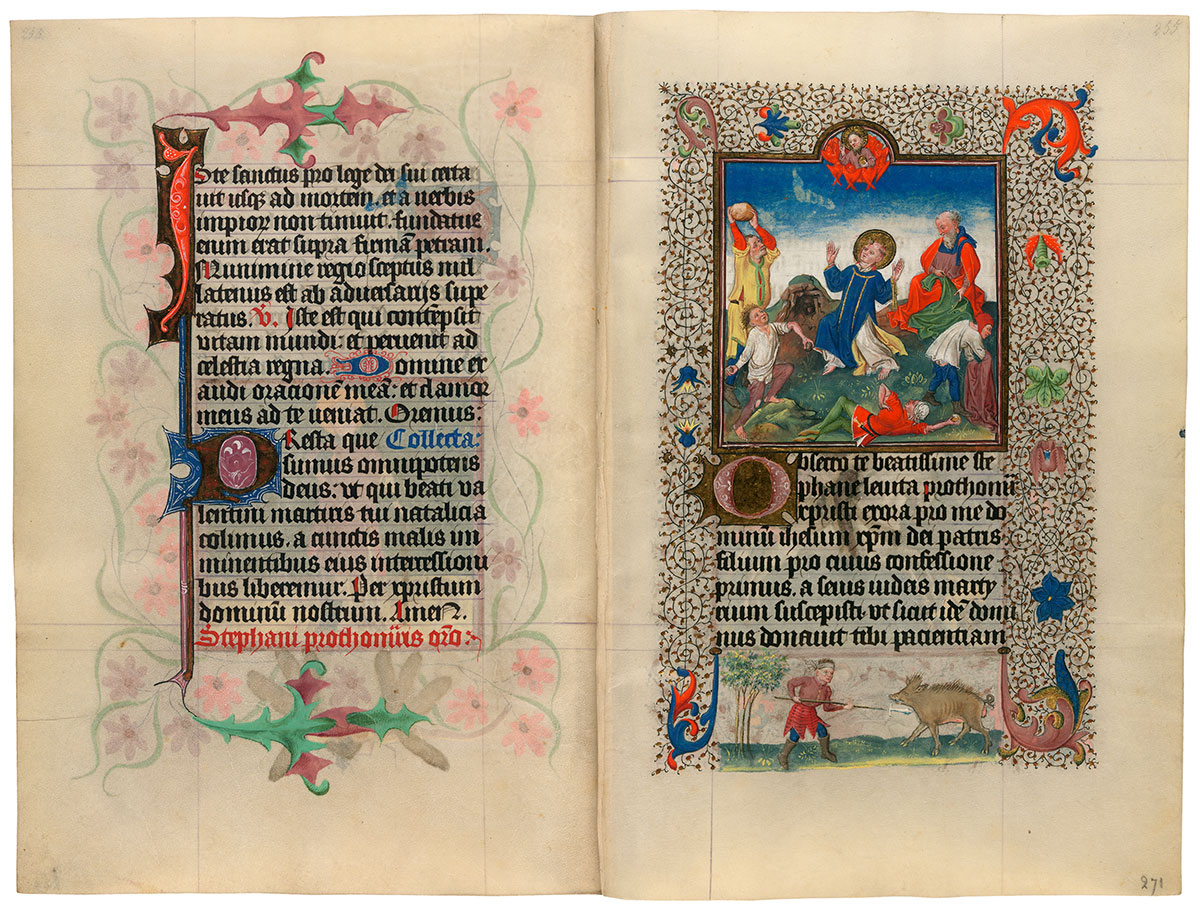
Lapidation of St. Stephen
Purchased on the Belle da Costa Greene Fund with the assistance of the Fellows, 1963
Suffrages
Suffrages are short prayers to individual saints. As protectors of medieval people, saints were their doctor in plague, their midwife at childbirth, their guardian when traveling, and their nurse during toothache. If the Virgin was the figure to whom one addressed the all-important petition for eternal salvation, it was from saints that one sought more basic or temporal kinds of help. While the Virgin became, as the Mother of God, almost a goddess herself, saints retained more of their humanity and thus their approachability.
Image courtesy of Faksimile Verlag Luzern
MS M.917/945, pp. 272–273
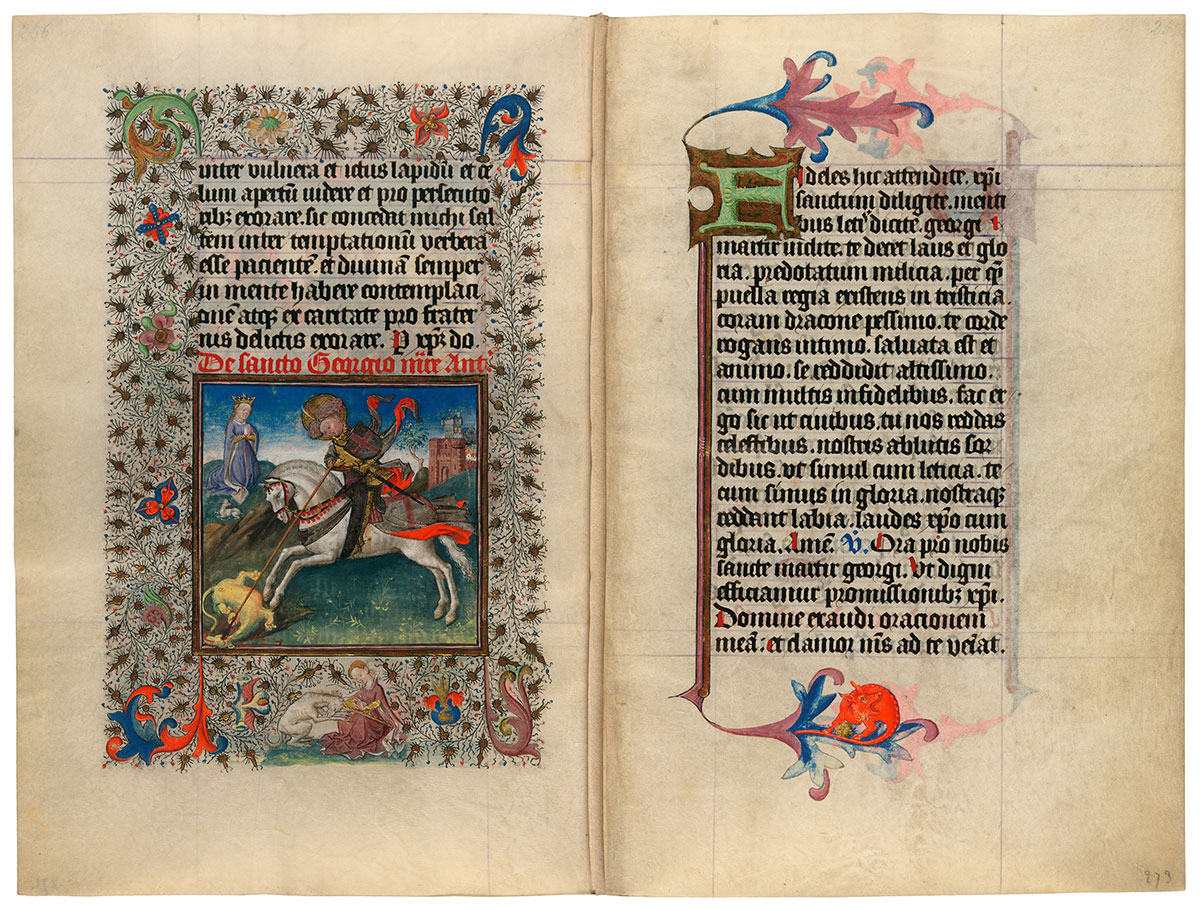
St. George Slaying the Dragon
Purchased on the Belle da Costa Greene Fund with the assistance of the Fellows, 1963
Suffrages
Suffrages are short prayers to individual saints. As protectors of medieval people, saints were their doctor in plague, their midwife at childbirth, their guardian when traveling, and their nurse during toothache. If the Virgin was the figure to whom one addressed the all-important petition for eternal salvation, it was from saints that one sought more basic or temporal kinds of help. While the Virgin became, as the Mother of God, almost a goddess herself, saints retained more of their humanity and thus their approachability.
Image courtesy of Faksimile Verlag Luzern
MS M.917/945, pp. 274–275
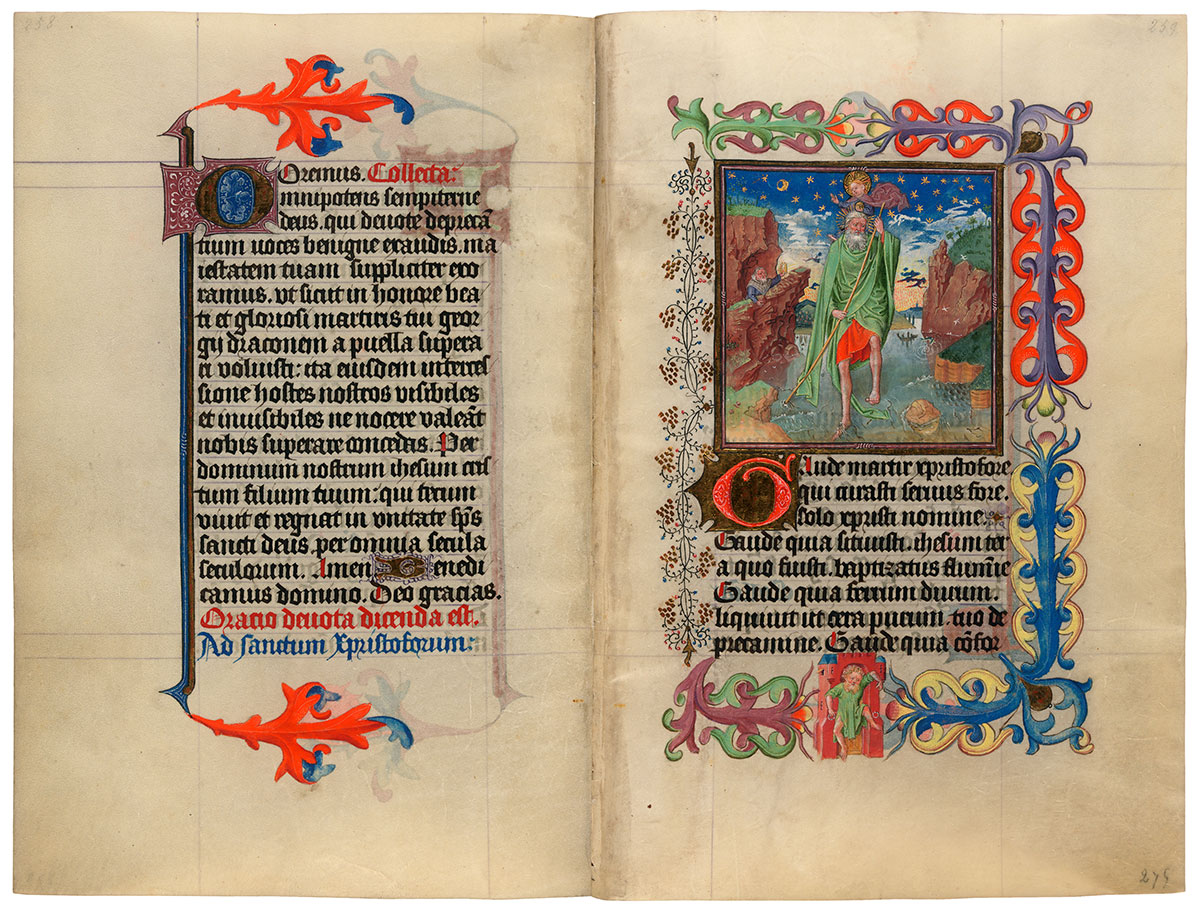
St. Christopher Carrying the Christ Child
Purchased on the Belle da Costa Greene Fund with the assistance of the Fellows, 1963
Christopher carries Christ—and the weight of the world—on his shoulders in a landscape considered the finest in the whole book. The depiction of the water, with its reflections, ducks, and leaping fish is unrivaled in manuscript illumination.
Suffrages
Suffrages are short prayers to individual saints. As protectors of medieval people, saints were their doctor in plague, their midwife at childbirth, their guardian when traveling, and their nurse during toothache. If the Virgin was the figure to whom one addressed the all-important petition for eternal salvation, it was from saints that one sought more basic or temporal kinds of help. While the Virgin became, as the Mother of God, almost a goddess herself, saints retained more of their humanity and thus their approachability.
Image courtesy of Faksimile Verlag Luzern
MS M.917/945, pp. 276–277
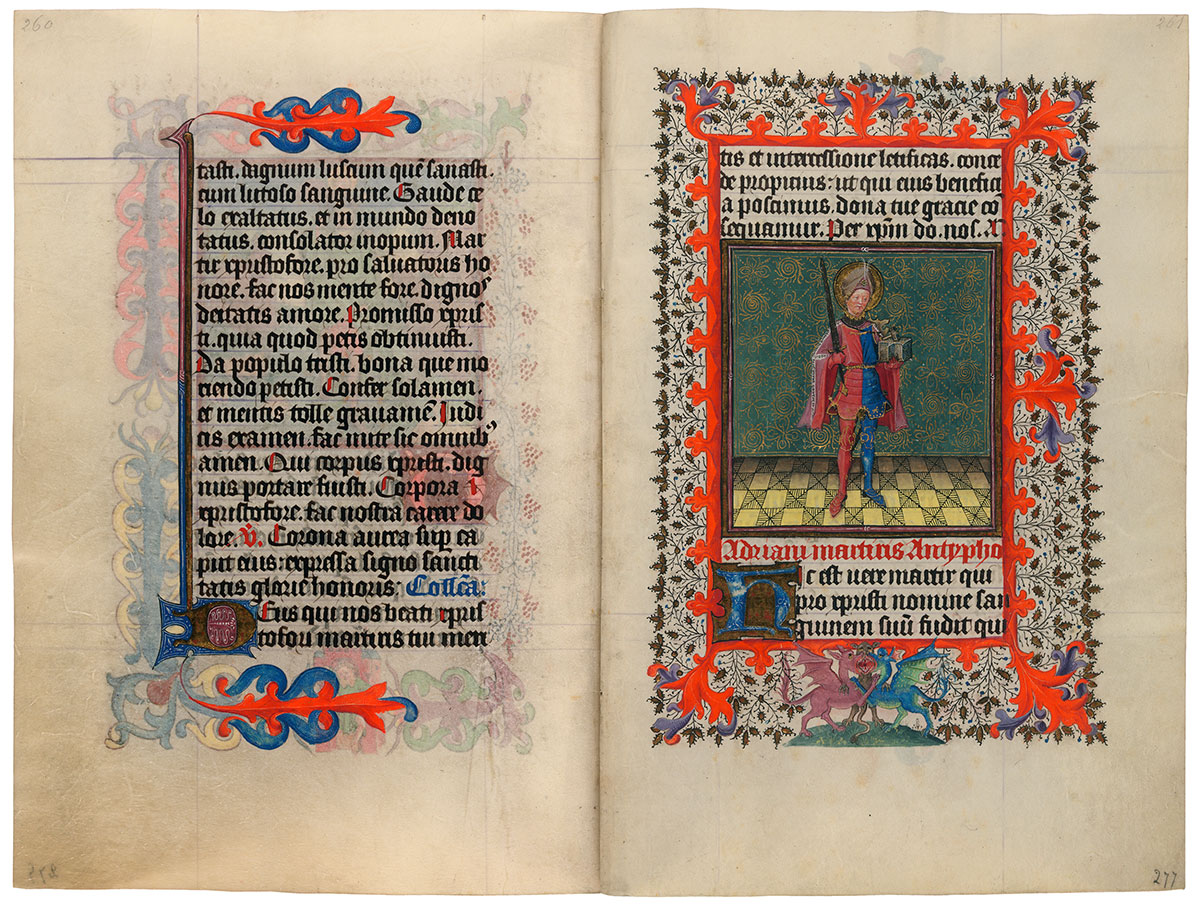
St. Adrian
Purchased on the Belle da Costa Greene Fund with the assistance of the Fellows, 1963
Suffrages
Suffrages are short prayers to individual saints. As protectors of medieval people, saints were their doctor in plague, their midwife at childbirth, their guardian when traveling, and their nurse during toothache. If the Virgin was the figure to whom one addressed the all-important petition for eternal salvation, it was from saints that one sought more basic or temporal kinds of help. While the Virgin became, as the Mother of God, almost a goddess herself, saints retained more of their humanity and thus their approachability.
Image courtesy of Faksimile Verlag Luzern
MS M.917/945, pp. 278–279
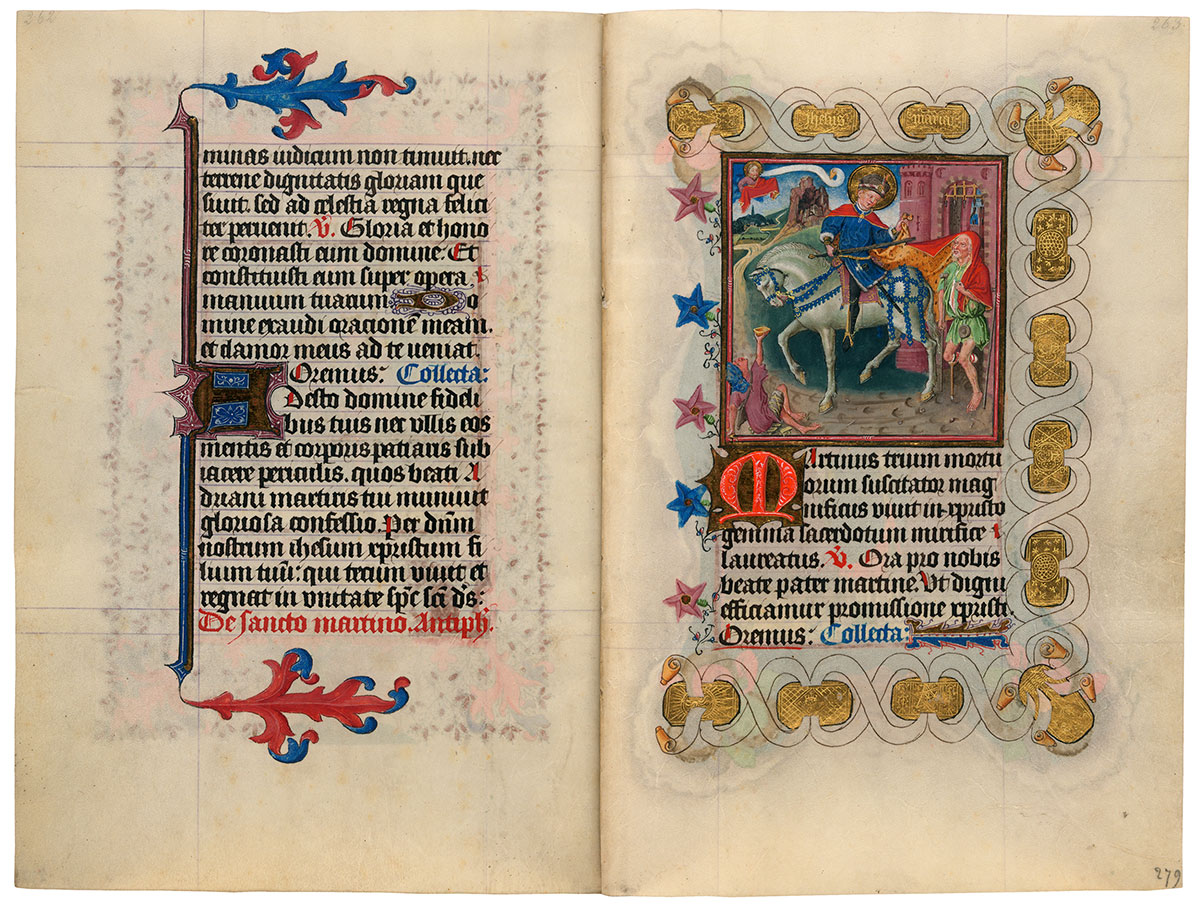
St. Martin Dividing his Cloak with a Beggar
Purchased on the Belle da Costa Greene Fund with the assistance of the Fellows, 1963
Martin shares his cloak with a beggar. Appearing in the sky is Christ, who, holding the cloth, reveals the true recipient of Martin's charity. A necklace of gold bars, two of which are inscribed with the names of Jesus and Mary, is in the borders.
Suffrages
Suffrages are short prayers to individual saints. As protectors of medieval people, saints were their doctor in plague, their midwife at childbirth, their guardian when traveling, and their nurse during toothache. If the Virgin was the figure to whom one addressed the all-important petition for eternal salvation, it was from saints that one sought more basic or temporal kinds of help. While the Virgin became, as the Mother of God, almost a goddess herself, saints retained more of their humanity and thus their approachability.
Image courtesy of Faksimile Verlag Luzern
MS M.917/945, pp. 280–281
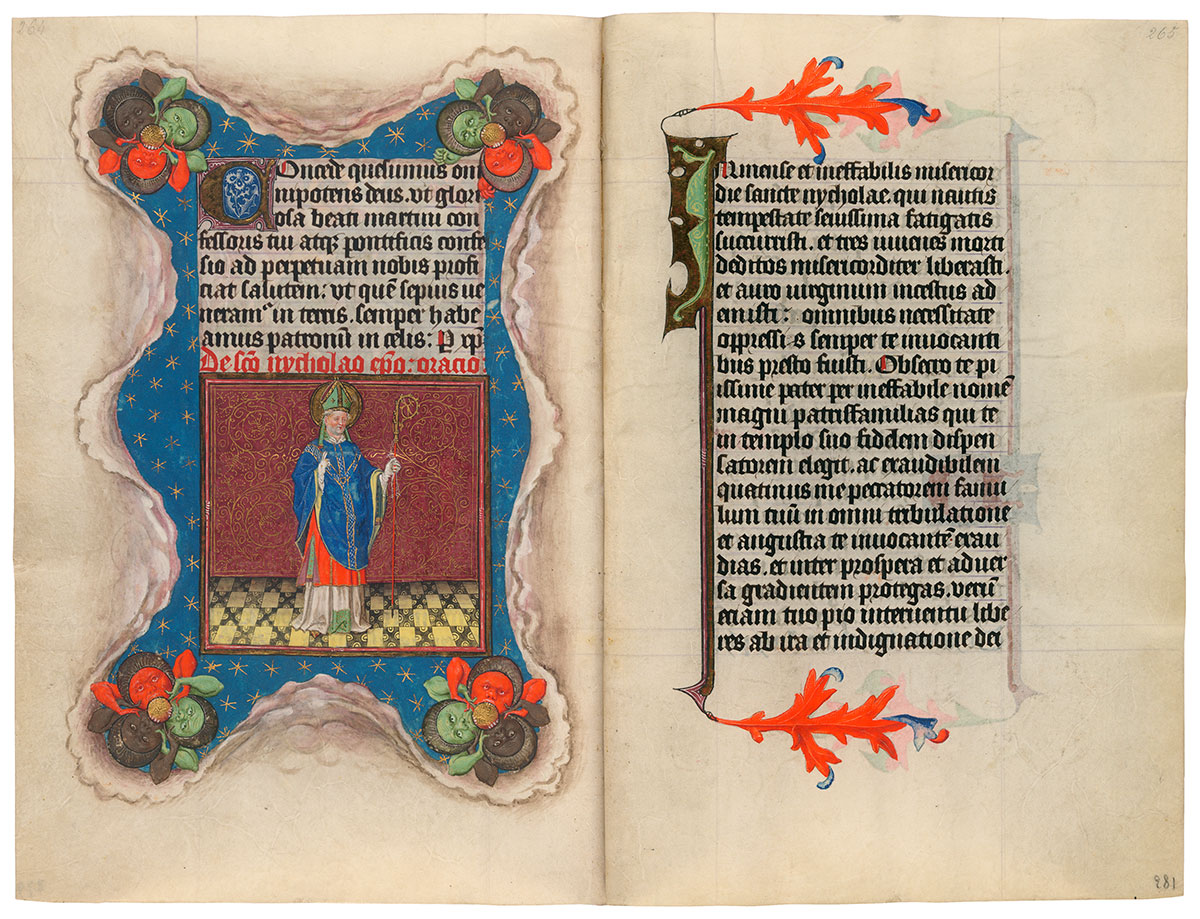
St. Nicholas
Purchased on the Belle da Costa Greene Fund with the assistance of the Fellows, 1963
In rich episcopal garb, but without any of his usual attributes, Nicholas stands in the tiled and textiled background seen so often in these pages. He carries a crozier in his gloved left hand and gives a blessing with his right. "Three" is an important number in many of the legends from Nicholas' life and posthumous miracles. The three small monsters at each corner of the border may refer to a number of different tales. They gnaw on small golder orbs, which may allude to the story of Nicholas' generosity to a man inclined to prostitute his three daughters, as he could not supply them with a dowry. Nicholas provided, anonymously and on three separate occasions, a bag full of gold to ensure that this terrible fate would not befall them. Another possible explanation is that the orbs and silver crescent hats of the monsters represent the sun and moon, attributes of the saint's role as spreader of light to the world. The trompe-l'oeil effect of peeling back cloud-like strips of vellum to reveal a starry sky could be a navigational allusion and representation of the calm skies sought by sailors, of whom Nicholas was patron.
Suffrages
Suffrages are short prayers to individual saints. As protectors of medieval people, saints were their doctor in plague, their midwife at childbirth, their guardian when traveling, and their nurse during toothache. If the Virgin was the figure to whom one addressed the all-important petition for eternal salvation, it was from saints that one sought more basic or temporal kinds of help. While the Virgin became, as the Mother of God, almost a goddess herself, saints retained more of their humanity and thus their approachability.
Image courtesy of Faksimile Verlag Luzern
MS M.917/945, pp. 282–283
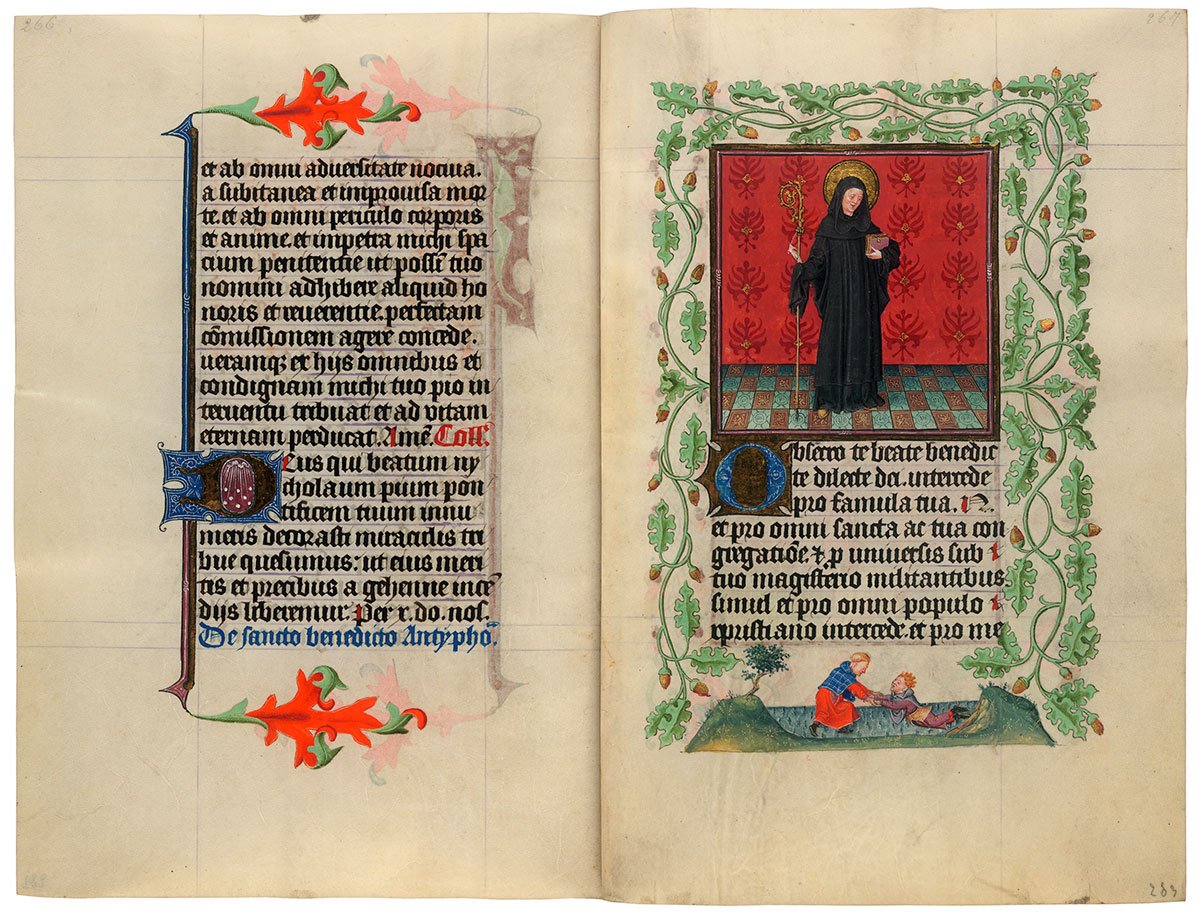
St. Benedict
Purchased on the Belle da Costa Greene Fund with the assistance of the Fellows, 1963
Suffrages
Suffrages are short prayers to individual saints. As protectors of medieval people, saints were their doctor in plague, their midwife at childbirth, their guardian when traveling, and their nurse during toothache. If the Virgin was the figure to whom one addressed the all-important petition for eternal salvation, it was from saints that one sought more basic or temporal kinds of help. While the Virgin became, as the Mother of God, almost a goddess herself, saints retained more of their humanity and thus their approachability.
Image courtesy of Faksimile Verlag Luzern
MS M.917/945, pp. 284–285

St. Servatius
Purchased on the Belle da Costa Greene Fund with the assistance of the Fellows, 1963
Suffrages
Suffrages are short prayers to individual saints. As protectors of medieval people, saints were their doctor in plague, their midwife at childbirth, their guardian when traveling, and their nurse during toothache. If the Virgin was the figure to whom one addressed the all-important petition for eternal salvation, it was from saints that one sought more basic or temporal kinds of help. While the Virgin became, as the Mother of God, almost a goddess herself, saints retained more of their humanity and thus their approachability.
Image courtesy of Faksimile Verlag Luzern
MS M.917/945, pp. 286–287
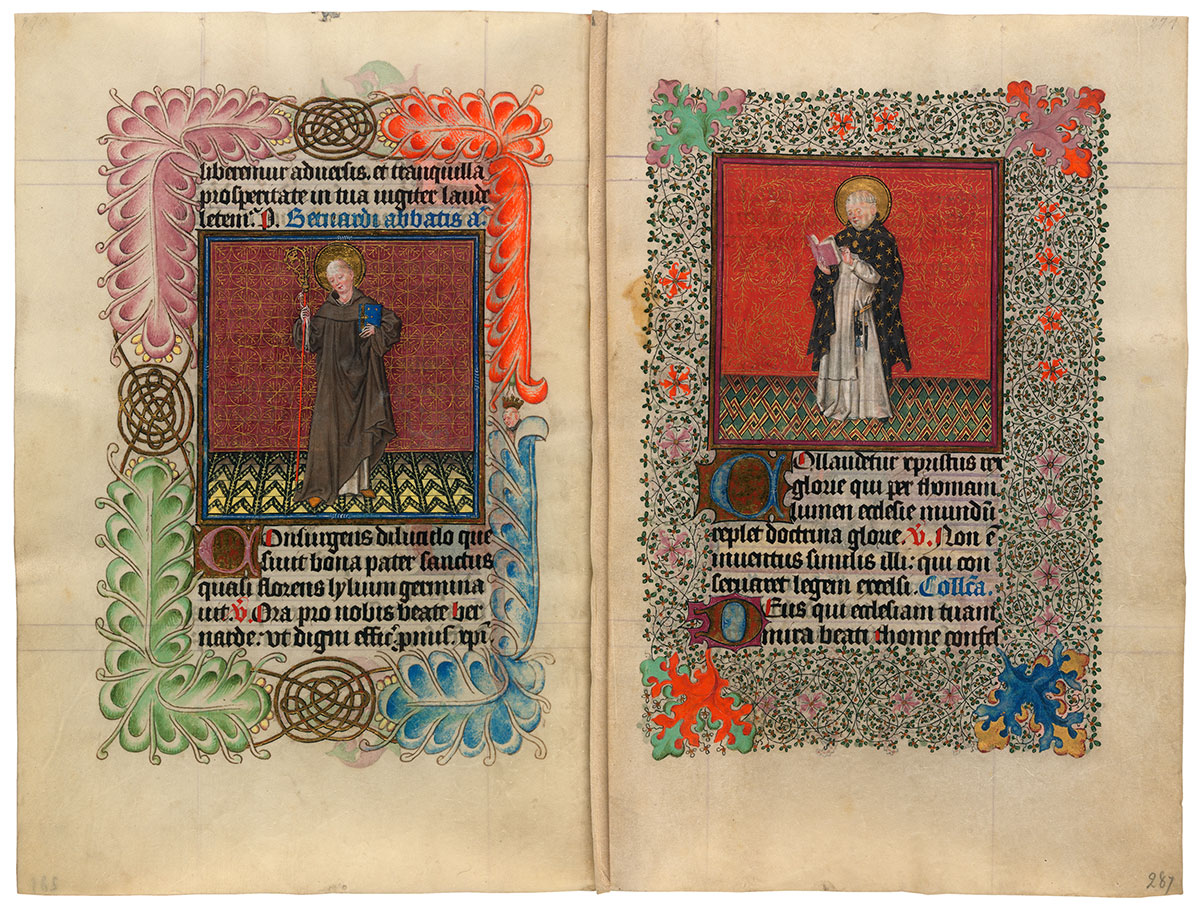
St. Bernard
St. Thomas Aquinas
Purchased on the Belle da Costa Greene Fund with the assistance of the Fellows, 1963
Bernard is clothed in a brown monastic cassock, holding a book and crozier. Strangely, he is not in the white garb of the Cistercians, in whose service he founded the famous monastery in Clairvaux. The border is comprised of colorful plumes connected by gold interlace on three sides and, on the fourth side, a small portrait. This tiny man being crowned by a hand reaching down from the frond above may represent William of Aquitane, saved from excommunication by the actions of Bernard.
The portly Thomas reads from a book representing his status as philosopher and doctor of the church. He wears the white Dominican habit and an interesting star-flecked black cape, perhaps an allusion to his title, doctor angelicus. From his girdle hang a short knife and a small case with keys attached to the bottom. The delicate border combines five-petaled flowers interlaced with a leafy vine.
Suffrages
Suffrages are short prayers to individual saints. As protectors of medieval people, saints were their doctor in plague, their midwife at childbirth, their guardian when traveling, and their nurse during toothache. If the Virgin was the figure to whom one addressed the all-important petition for eternal salvation, it was from saints that one sought more basic or temporal kinds of help. While the Virgin became, as the Mother of God, almost a goddess herself, saints retained more of their humanity and thus their approachability.
Image courtesy of Faksimile Verlag Luzern
MS M.917/945, pp. 288–289
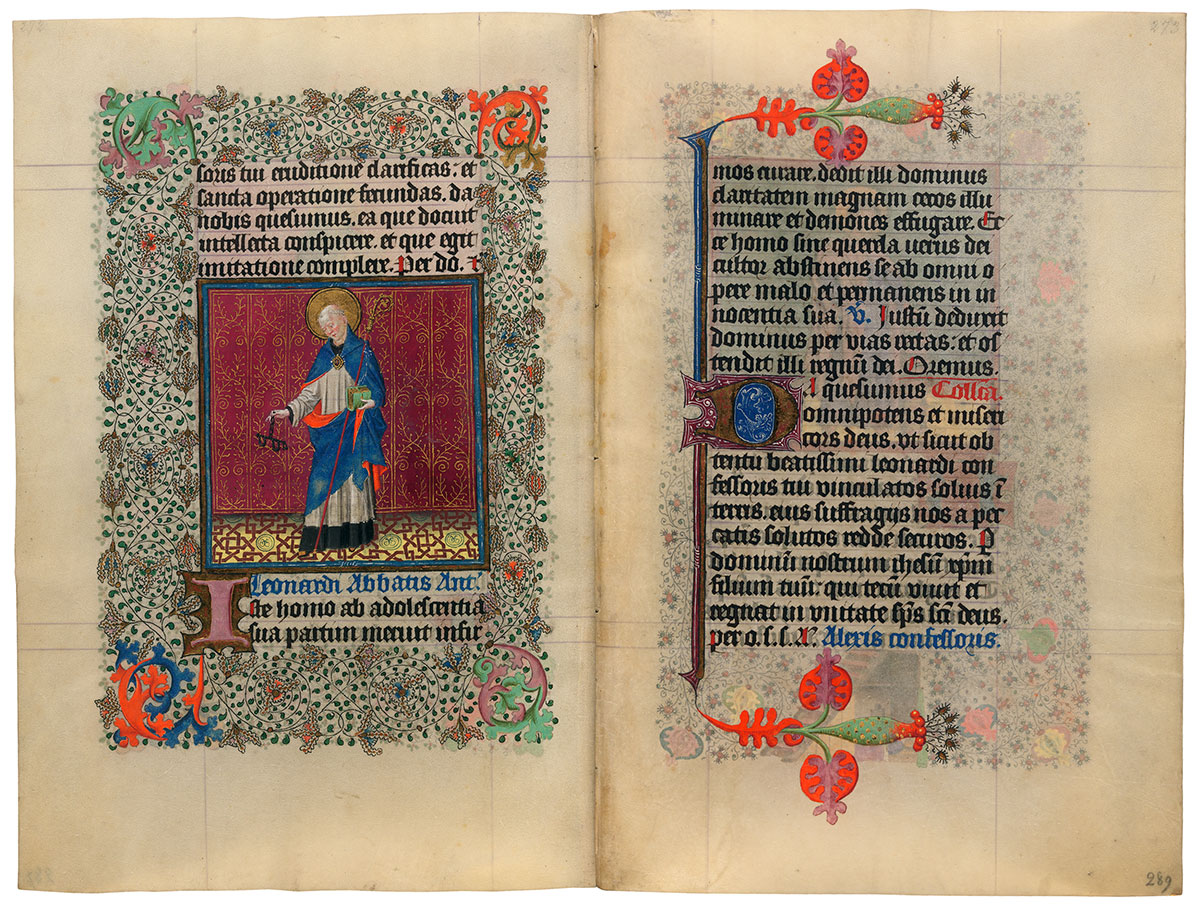
St. Leonard
Purchased on the Belle da Costa Greene Fund with the assistance of the Fellows, 1963
The extraordinary and non-historical legend of St. Leonard tells the story of a pious nobleman who was accomplished in obtaining the release of prisoners by prayer and negotiation. He holds in his right hand his attributes, a set of prisoner's fetters dangling from a chain. Interlaced chain-like links decorate the floor on which Leonard stands. This geometric motif is quite similar to that decorating the border of the miniature of Catherine of Cleves praying to the Virgin and the Crucified Christ (p. 160) and supports an identification of that abbot saint as Leonard.
Suffrages
Suffrages are short prayers to individual saints. As protectors of medieval people, saints were their doctor in plague, their midwife at childbirth, their guardian when traveling, and their nurse during toothache. If the Virgin was the figure to whom one addressed the all-important petition for eternal salvation, it was from saints that one sought more basic or temporal kinds of help. While the Virgin became, as the Mother of God, almost a goddess herself, saints retained more of their humanity and thus their approachability.
Image courtesy of Faksimile Verlag Luzern
MS M.917/945, pp. 290–291
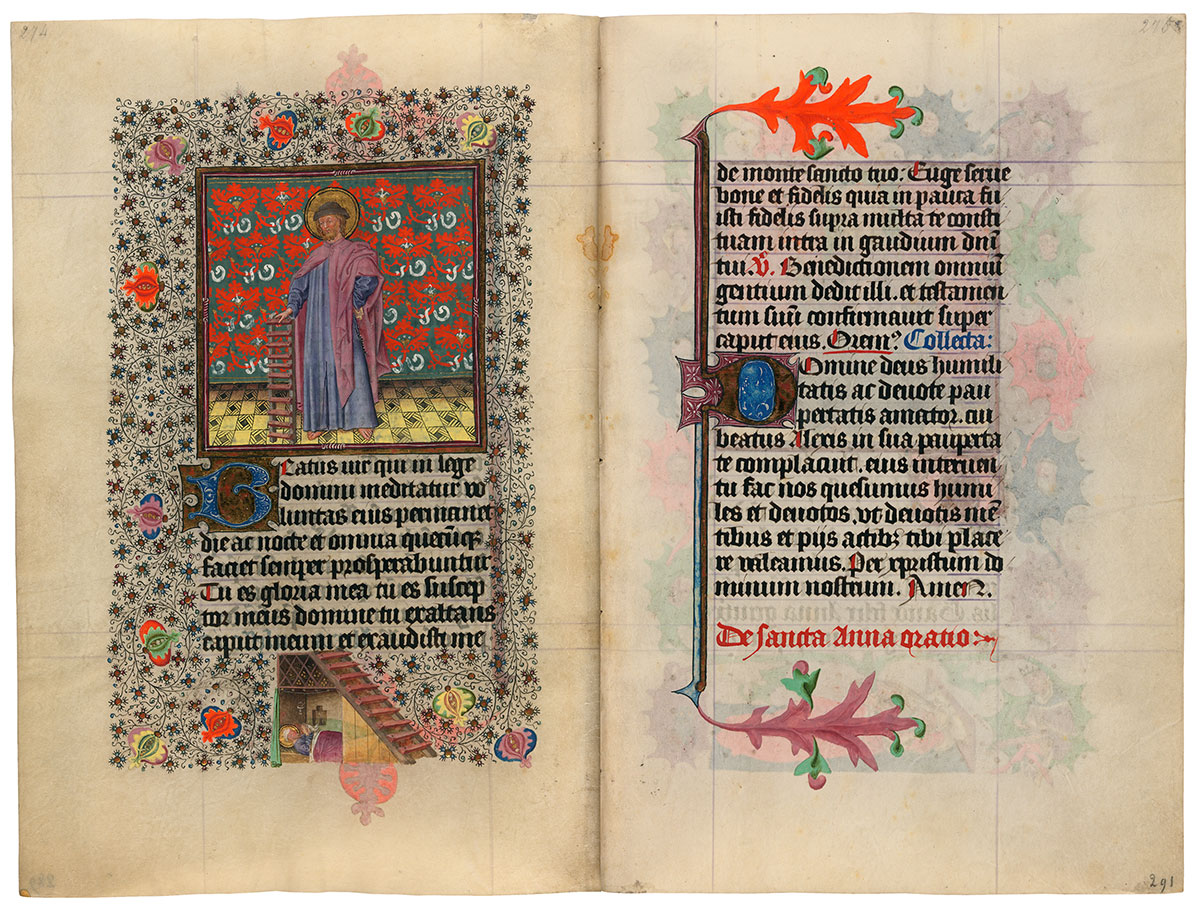
St. Alexis
Purchased on the Belle da Costa Greene Fund with the assistance of the Fellows, 1963
Alexis stands barefoot before a beautiful red and green patterned textile, holding a small ladder, his attribute. Despite his bare feet, he is well dressed, wearing a brown tiered hat and a mauve cape over a blue robe. In the border, Alexis lies dead on his straw-covered pallet beneath the stairs of his father's palace. He lived there as a beggar, unknown until the scroll clutched in his lifeless fingers revealed his identity as the son of the house.
Suffrages
Suffrages are short prayers to individual saints. As protectors of medieval people, saints were their doctor in plague, their midwife at childbirth, their guardian when traveling, and their nurse during toothache. If the Virgin was the figure to whom one addressed the all-important petition for eternal salvation, it was from saints that one sought more basic or temporal kinds of help. While the Virgin became, as the Mother of God, almost a goddess herself, saints retained more of their humanity and thus their approachability.
Image courtesy of Faksimile Verlag Luzern
MS M.917/945, pp. 292–293
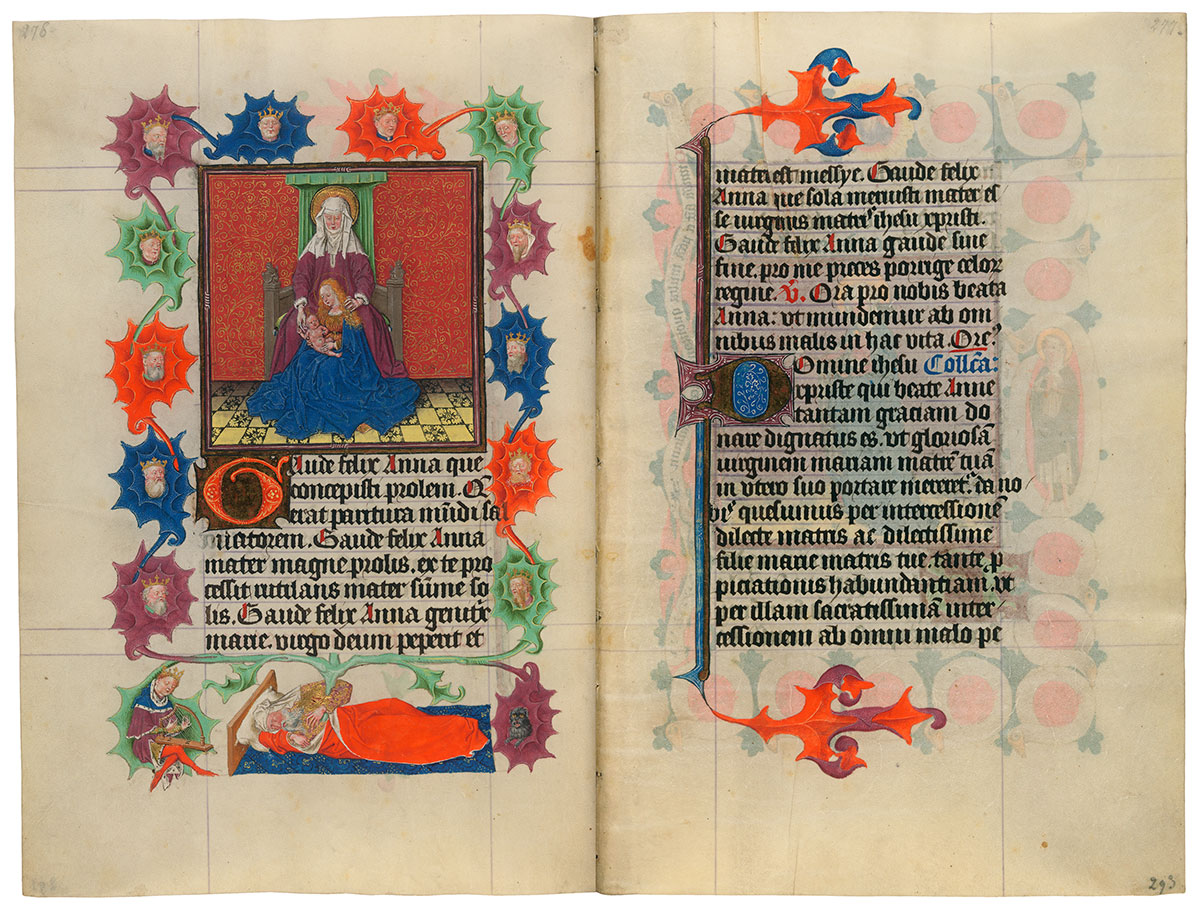
St. Anne with the Virgin and Child
Purchased on the Belle da Costa Greene Fund with the assistance of the Fellows, 1963
Wearing an old-fashioned wimple, the elderly Anne is enthroned with her daughter, Mary, who is seated at her feet holding baby Jesus. The page as a whole emphasizes genealogy: the three figures of the miniature are the ultimate flower of the vinelike Tree of Jesse that grows from that ancestor of the Savior sleeping in the bottom border. King David is shown at the left of Jesse and, at the right, what may be the lion of Judah. Twelve crowned heads represent Christ's subsequent royal ancestors.
Suffrages
Suffrages are short prayers to individual saints. As protectors of medieval people, saints were their doctor in plague, their midwife at childbirth, their guardian when traveling, and their nurse during toothache. If the Virgin was the figure to whom one addressed the all-important petition for eternal salvation, it was from saints that one sought more basic or temporal kinds of help. While the Virgin became, as the Mother of God, almost a goddess herself, saints retained more of their humanity and thus their approachability.
Image courtesy of Faksimile Verlag Luzern
MS M.917/945, pp. 294–295
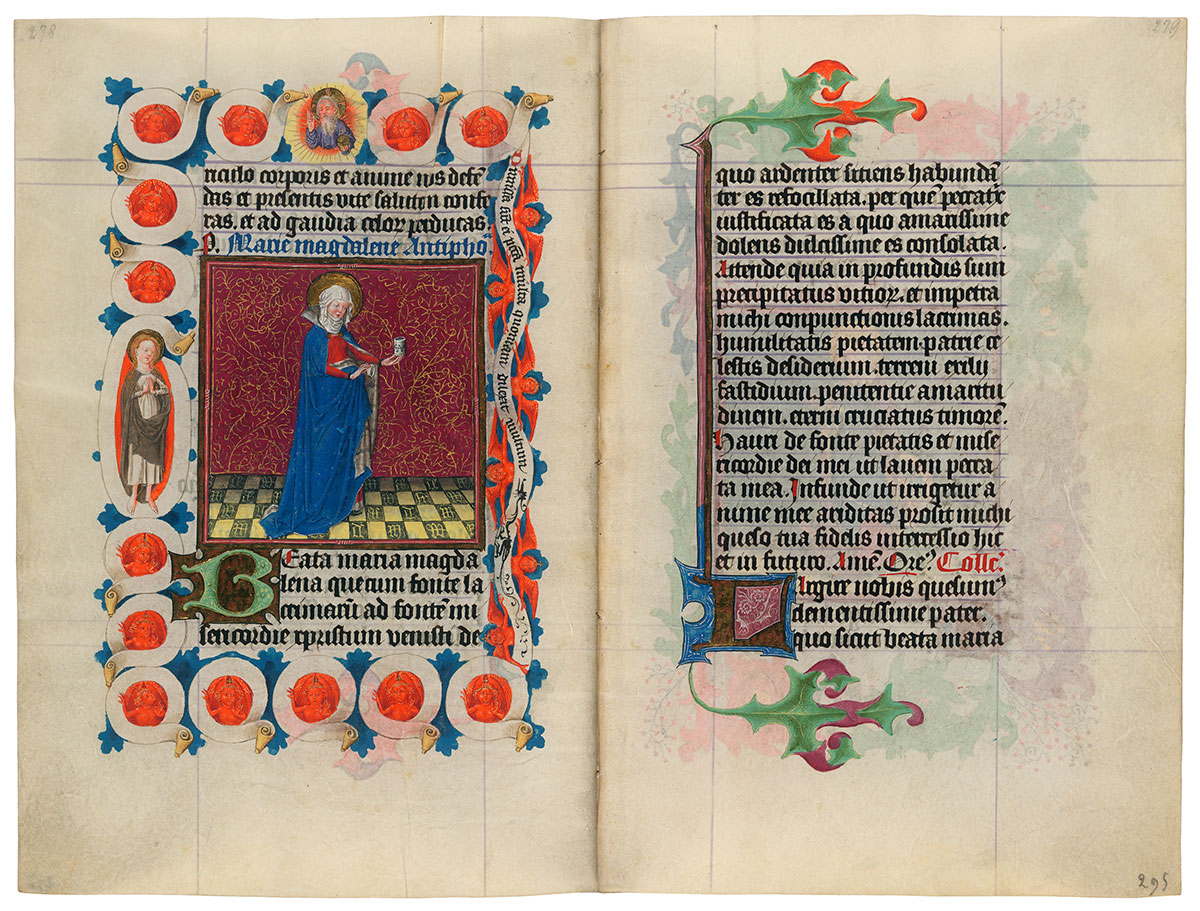
St. Mary Magdalene
Purchased on the Belle da Costa Greene Fund with the assistance of the Fellows, 1963
A resplendent Mary Magdalene, wearing a fur-lined cloak and holding her attribute, a jar of ointment, stands on tiles decorated with letters from her name. A shabbier version of the saint appears in the left margin, accompanied by angels and blue sky and blessed by God in the top margin. The border alludes to ecstasies the Magdalene enjoyed at the end of her life, when, during her meditations, angels lifted her into the sky. The text on the scroll at the right (from Luke 7:47) explains that Christ forgave her many sins because she loved so much.
Suffrages
Suffrages are short prayers to individual saints. As protectors of medieval people, saints were their doctor in plague, their midwife at childbirth, their guardian when traveling, and their nurse during toothache. If the Virgin was the figure to whom one addressed the all-important petition for eternal salvation, it was from saints that one sought more basic or temporal kinds of help. While the Virgin became, as the Mother of God, almost a goddess herself, saints retained more of their humanity and thus their approachability.
Image courtesy of Faksimile Verlag Luzern
MS M.917/945, pp. 296–297
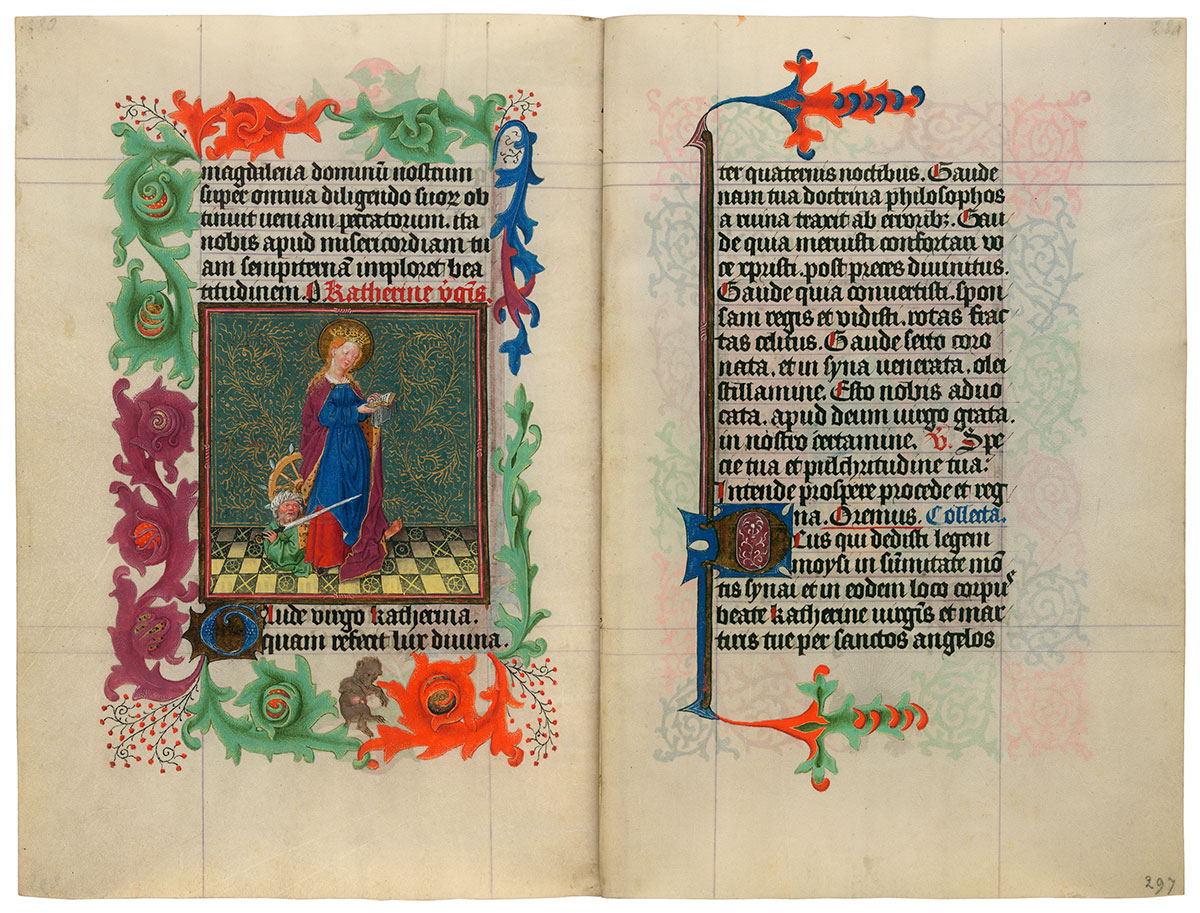
St. Catherine
Purchased on the Belle da Costa Greene Fund with the assistance of the Fellows, 1963
Catherine, nobly dressed in a crown and a luxurious ermine-lined cloak, prays from a small book bound in green cloth. Her attributes, the spiked wheel and sword, sit behind and beneath her. The sword is held by the Syrian Emperor Maximinus who lies vanquished beneath her feet. Maximinus had ordered the torture and execution of the young virgin saint after she refused his hand in marriage. The bear cub (catulus in latin) who toys with a red, gold, and green ball in the border may be a pun on Catherine's name.
Suffrages
Suffrages are short prayers to individual saints. As protectors of medieval people, saints were their doctor in plague, their midwife at childbirth, their guardian when traveling, and their nurse during toothache. If the Virgin was the figure to whom one addressed the all-important petition for eternal salvation, it was from saints that one sought more basic or temporal kinds of help. While the Virgin became, as the Mother of God, almost a goddess herself, saints retained more of their humanity and thus their approachability.
Image courtesy of Faksimile Verlag Luzern
MS M.917/945, pp. 300–301
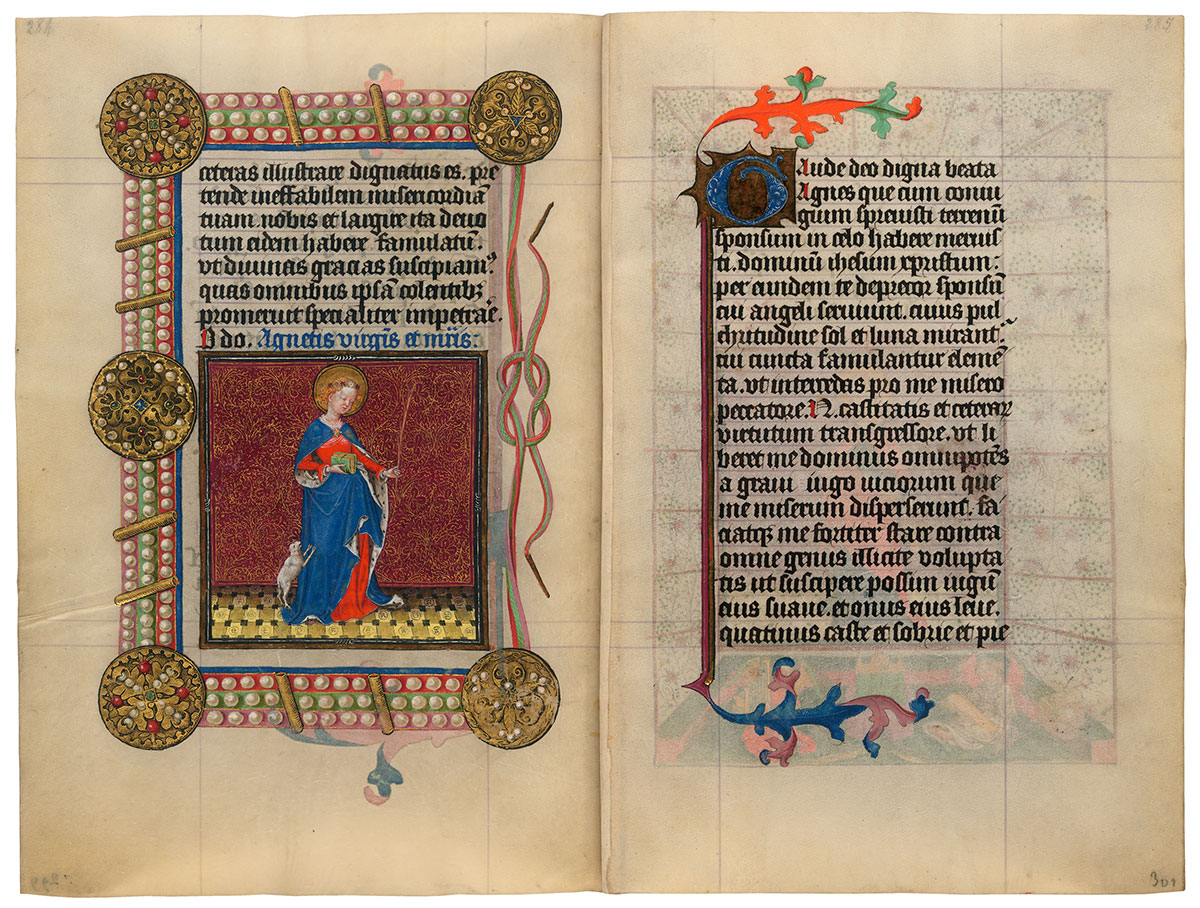
St. Agnes
Purchased on the Belle da Costa Greene Fund with the assistance of the Fellows, 1963
An embodiment of chastity, Agnes is accompanied by a small lamb, symbol of purity and a pun on her name (agnus in Latin). The garland of flowers around her head contrasts with the luxurious necklace that forms the border. Engraved gold medallions, set with rubies and pearls, are joined by multicolored bands richly embellished with numerous pearls. The jewelry alludes to the legend in which Agnes preserved her chastity against a man who sought to tempt her with jewels; she claimed to have a fiancé (referring, of course, to Christ) who had already given her a necklace of precious stones.
Suffrages
Suffrages are short prayers to individual saints. As protectors of medieval people, saints were their doctor in plague, their midwife at childbirth, their guardian when traveling, and their nurse during toothache. If the Virgin was the figure to whom one addressed the all-important petition for eternal salvation, it was from saints that one sought more basic or temporal kinds of help. While the Virgin became, as the Mother of God, almost a goddess herself, saints retained more of their humanity and thus their approachability.
Image courtesy of Faksimile Verlag Luzern
MS M.917/945, pp. 302–303
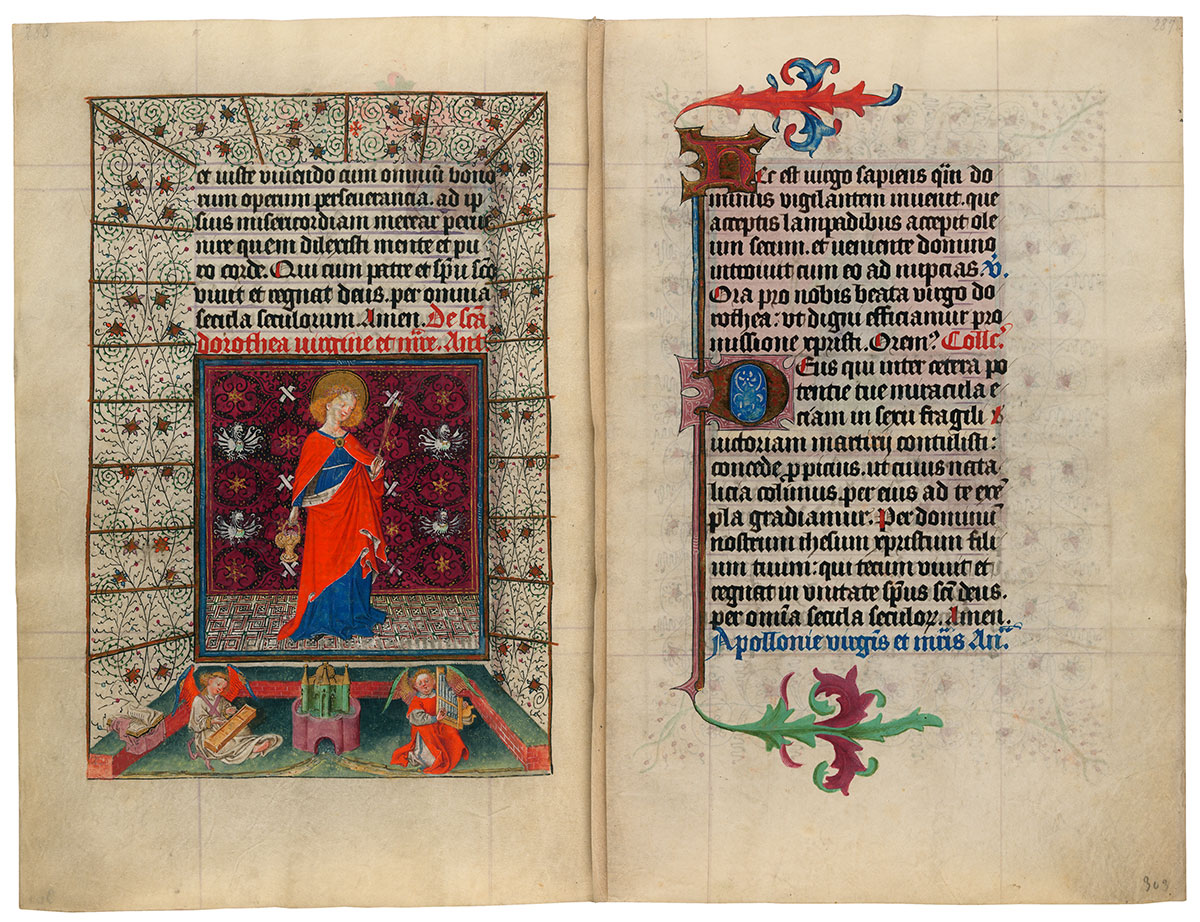
St. Dorothy
Purchased on the Belle da Costa Greene Fund with the assistance of the Fellows, 1963
The patron saint of gardeners, Dorothy wears a rose garland and carries, in addition to her martyr's palm, a basket of roses or fruit. On her way to be executed for her faith, Dorothy was asked by a pagan named Theophilus to send him some flowers and fruit from heaven. An angel brought him a basket with three apples and three roses, at which he converted and was subsequently martyred. The border is a vine-covered gold trellis surrounding the garden of Paradise at the bottom. In the garden, two angels sit playing instruments, a dulcimer and a portative organ. The castle-topped well in the middle is the source of two of paradise's rivers.
Suffrages
Suffrages are short prayers to individual saints. As protectors of medieval people, saints were their doctor in plague, their midwife at childbirth, their guardian when traveling, and their nurse during toothache. If the Virgin was the figure to whom one addressed the all-important petition for eternal salvation, it was from saints that one sought more basic or temporal kinds of help. While the Virgin became, as the Mother of God, almost a goddess herself, saints retained more of their humanity and thus their approachability.
Image courtesy of Faksimile Verlag Luzern
MS M.917/945, pp. 304–305
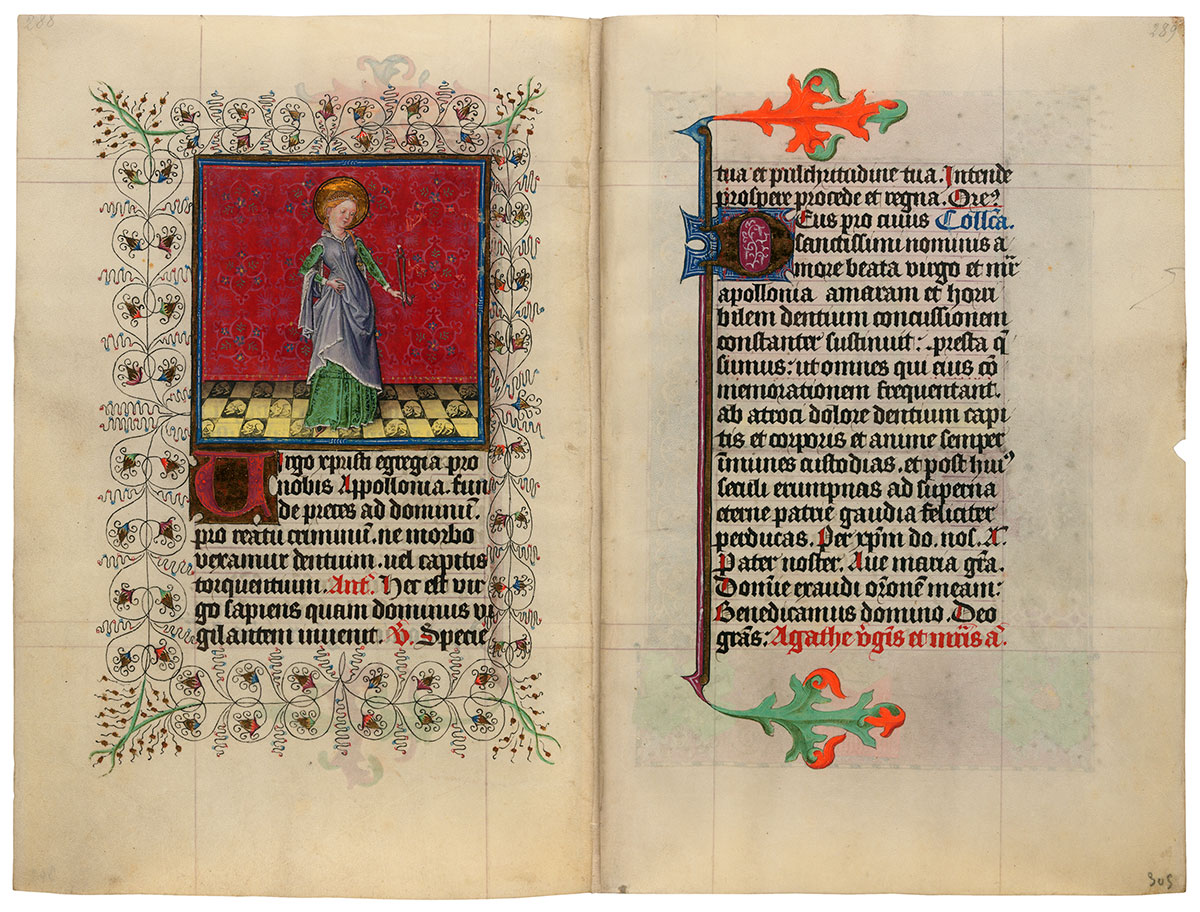
St. Apollonia
Purchased on the Belle da Costa Greene Fund with the assistance of the Fellows, 1963
Appolonia was commonly invoked against toothaches and other dental problems because of the torture she endured before martyrdom: she had her teeth pulled out before leaping onto the pyre her tormenters had prepared for her. Although she was revered as a martyr, her active role in her own martyrdom – essentially suicide – was problematic (it was discussed by Augustine in his City of God). This may explain why the saint does not hold the traditional palm of martyrdom, but simply her attribute, a pair of long pincers with a tooth. Her attire is rich: she wears a hair-net crown and an ermine-trimmed gray robe over a green gown of brocade fabric with lace cuffs. Her long blonde braid drapes over her shoulder, to the end of which are tied decorative beads or bells. The crouching dog in the tiles has no apparent connection to the saint.
Suffrages
Suffrages are short prayers to individual saints. As protectors of medieval people, saints were their doctor in plague, their midwife at childbirth, their guardian when traveling, and their nurse during toothache. If the Virgin was the figure to whom one addressed the all-important petition for eternal salvation, it was from saints that one sought more basic or temporal kinds of help. While the Virgin became, as the Mother of God, almost a goddess herself, saints retained more of their humanity and thus their approachability.
Image courtesy of Faksimile Verlag Luzern
MS M.917/945, pp. 306–307
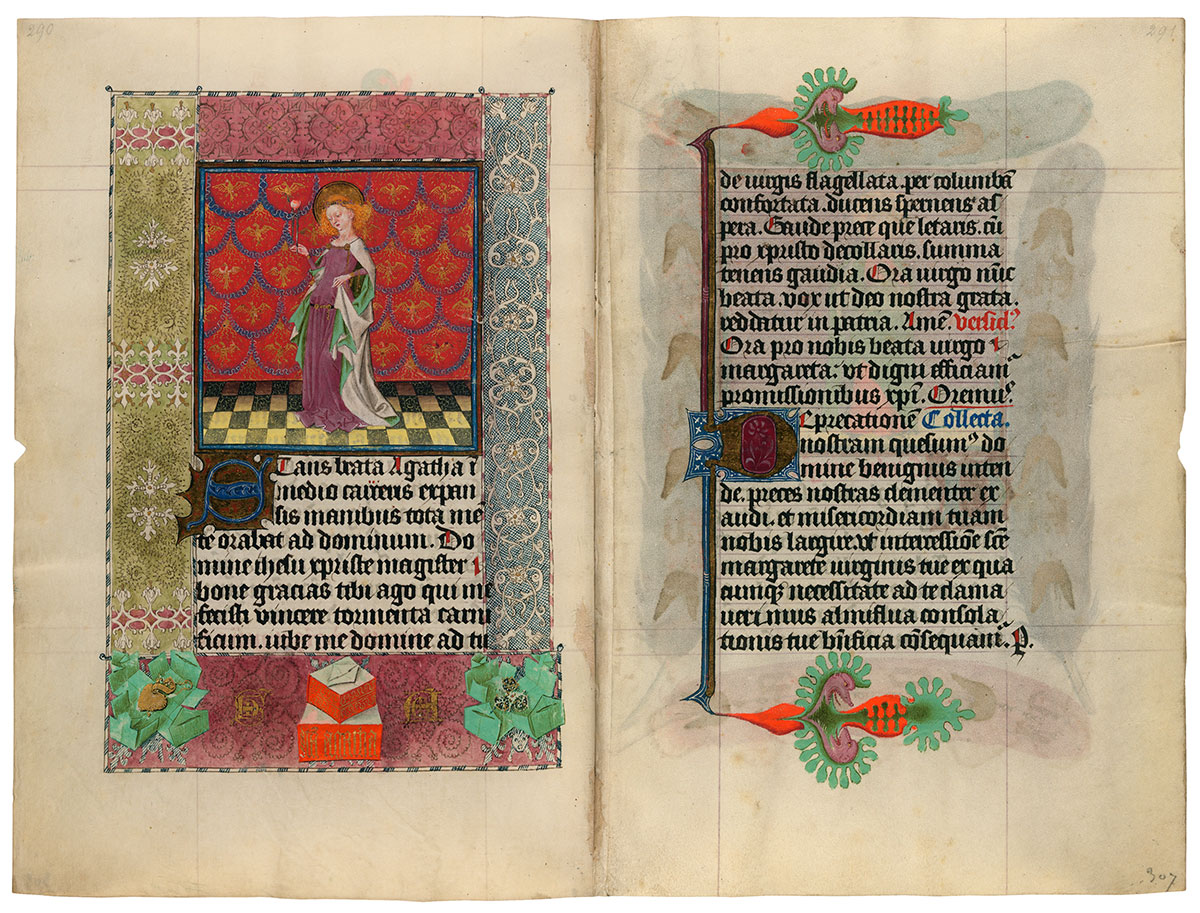
St. Agatha
Purchased on the Belle da Costa Greene Fund with the assistance of the Fellows, 1963
Holding her attribute, a pair of pincers with one of her severed breasts, Agatha stands before a textile embroidered repeatedly in gold with a phoenix rising from flames. The motif is appropriate to Agnes as the patron of forging and casting. The cast jewelry in the bottom border provides further reference to this patronage.
Suffrages
Suffrages are short prayers to individual saints. As protectors of medieval people, saints were their doctor in plague, their midwife at childbirth, their guardian when traveling, and their nurse during toothache. If the Virgin was the figure to whom one addressed the all-important petition for eternal salvation, it was from saints that one sought more basic or temporal kinds of help. While the Virgin became, as the Mother of God, almost a goddess herself, saints retained more of their humanity and thus their approachability.
Image courtesy of Faksimile Verlag Luzern
MS M.917/945, pp. 308–309
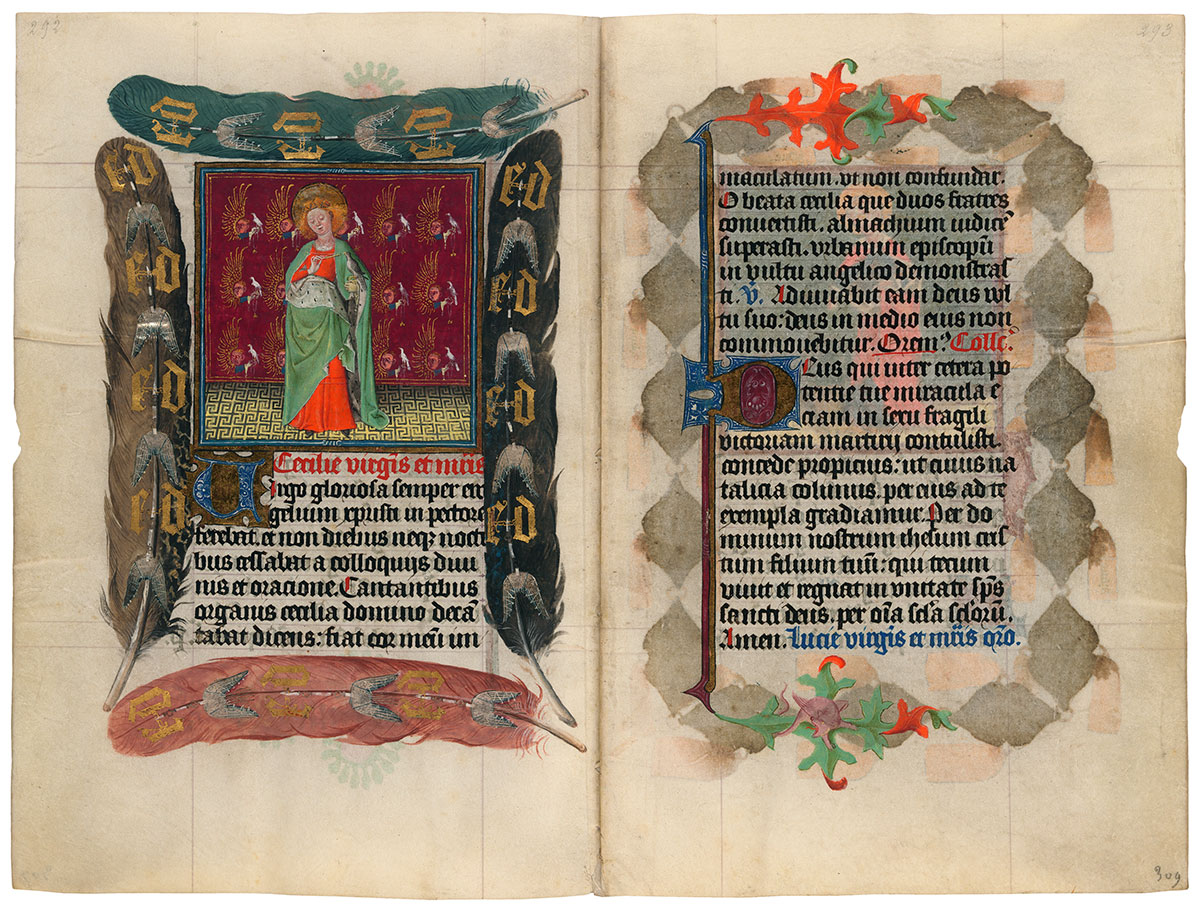
St. Cecilia
Purchased on the Belle da Costa Greene Fund with the assistance of the Fellows, 1963
The noble Cecilia, engaging in the aristocratic sport of falconry, feeds a falcon. The avian theme continues in the textile background, which has the repeated motif of a winged boy holding a white hawk, and in the margins, which contain four large feathers. These feathers are in turn decorated with paired white wings, which are lures used to entice the bird back to the falconer. Also embellishing these large feathers are gold letters that, as elsewhere in the manuscript, have been interpreted as CD for Catherina Duxissa (Catherine the Duchess).
Suffrages
Suffrages are short prayers to individual saints. As protectors of medieval people, saints were their doctor in plague, their midwife at childbirth, their guardian when traveling, and their nurse during toothache. If the Virgin was the figure to whom one addressed the all-important petition for eternal salvation, it was from saints that one sought more basic or temporal kinds of help. While the Virgin became, as the Mother of God, almost a goddess herself, saints retained more of their humanity and thus their approachability.
Image courtesy of Faksimile Verlag Luzern
MS M.917/945, pp. 310–311
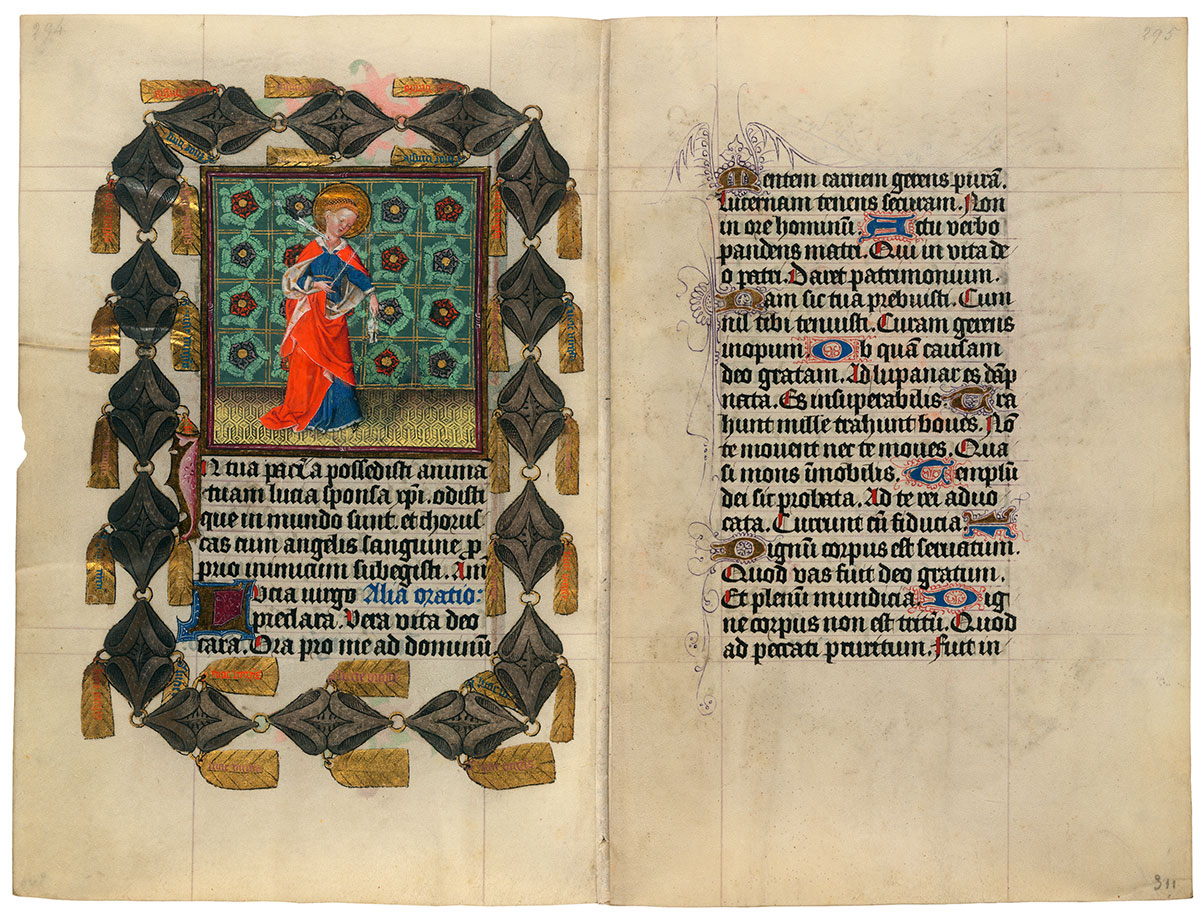
St. Lucy
Purchased on the Belle da Costa Greene Fund with the assistance of the Fellows, 1963
Lucy holds a martyr's palm and a book in chemise binding. Her neck is pierced by a sword, by which she met her death after having been miraculously delivered from two other fates: prostitution and burning. Aptly, she is the patron of those who suffer from sore throats. A chain of silver and gold fills the surrounding border, the flat gold charms of which are inscribed Lucie virginis (Lucy the Virgin). The silver pieces echo the shapes of the petal within the rosettes embroidered on the textile backdrop, but it is unclear how they may relate to the story of Lucy.
Suffrages
Suffrages are short prayers to individual saints. As protectors of medieval people, saints were their doctor in plague, their midwife at childbirth, their guardian when traveling, and their nurse during toothache. If the Virgin was the figure to whom one addressed the all-important petition for eternal salvation, it was from saints that one sought more basic or temporal kinds of help. While the Virgin became, as the Mother of God, almost a goddess herself, saints retained more of their humanity and thus their approachability.
Image courtesy of Faksimile Verlag Luzern
MS M.917/945, pp. 312–313
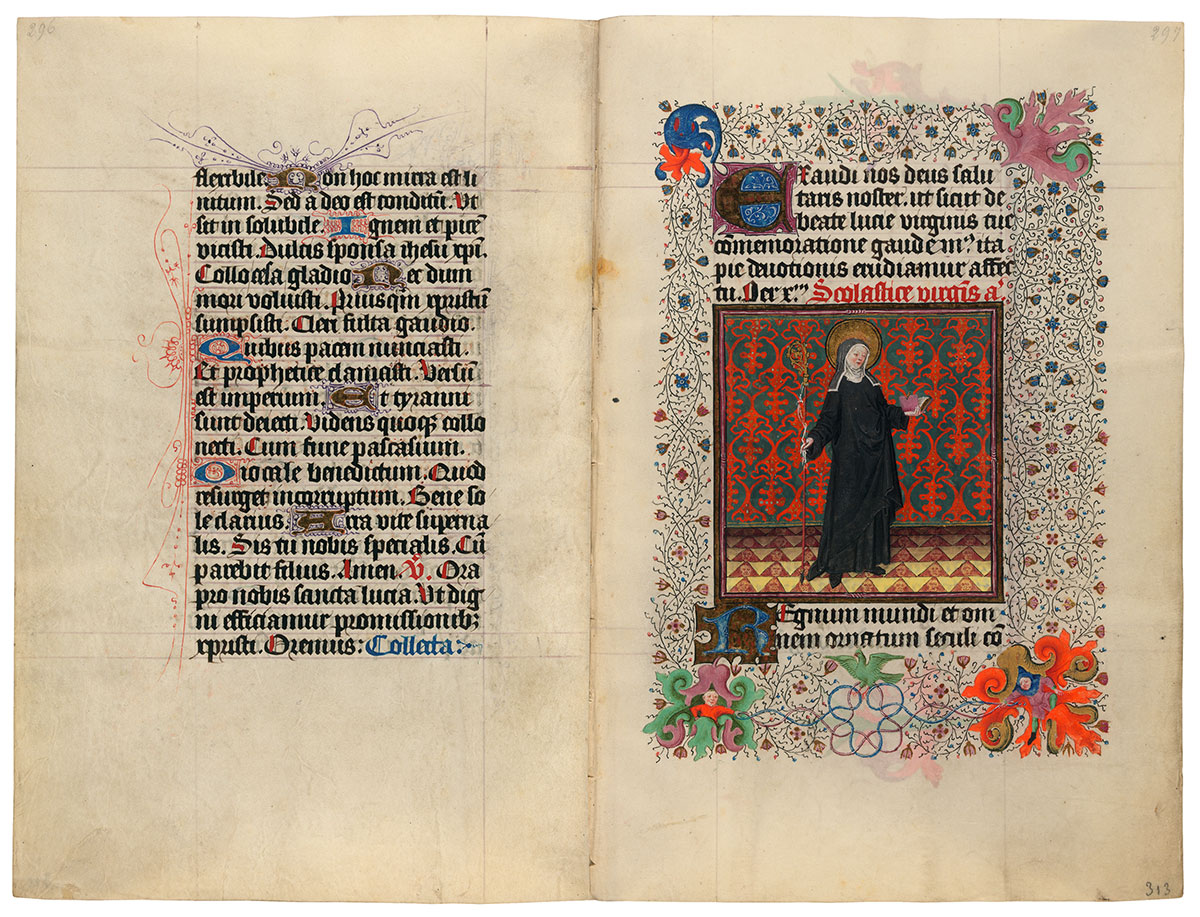
St. Scholastica
Purchased on the Belle da Costa Greene Fund with the assistance of the Fellows, 1963
Scholastica, twin sister to St. Benedict, wears the habit of a Benedictine abbess and holds a book and a crozier. Her usual attribute, a dove, the form in which she ascended to heaven, is lacking here, while the border contains an antithetical scene of two boys hoping to snare a bird.
Suffrages
Suffrages are short prayers to individual saints. As protectors of medieval people, saints were their doctor in plague, their midwife at childbirth, their guardian when traveling, and their nurse during toothache. If the Virgin was the figure to whom one addressed the all-important petition for eternal salvation, it was from saints that one sought more basic or temporal kinds of help. While the Virgin became, as the Mother of God, almost a goddess herself, saints retained more of their humanity and thus their approachability.
Image courtesy of Faksimile Verlag Luzern
MS M.917/945, pp. 314–315

St. Gertrude
Purchased on the Belle da Costa Greene Fund with the assistance of the Fellows, 1963
Suffrages
Suffrages are short prayers to individual saints. As protectors of medieval people, saints were their doctor in plague, their midwife at childbirth, their guardian when traveling, and their nurse during toothache. If the Virgin was the figure to whom one addressed the all-important petition for eternal salvation, it was from saints that one sought more basic or temporal kinds of help. While the Virgin became, as the Mother of God, almost a goddess herself, saints retained more of their humanity and thus their approachability.
Image courtesy of Faksimile Verlag Luzern
MS M.917/945, pp. 316–317
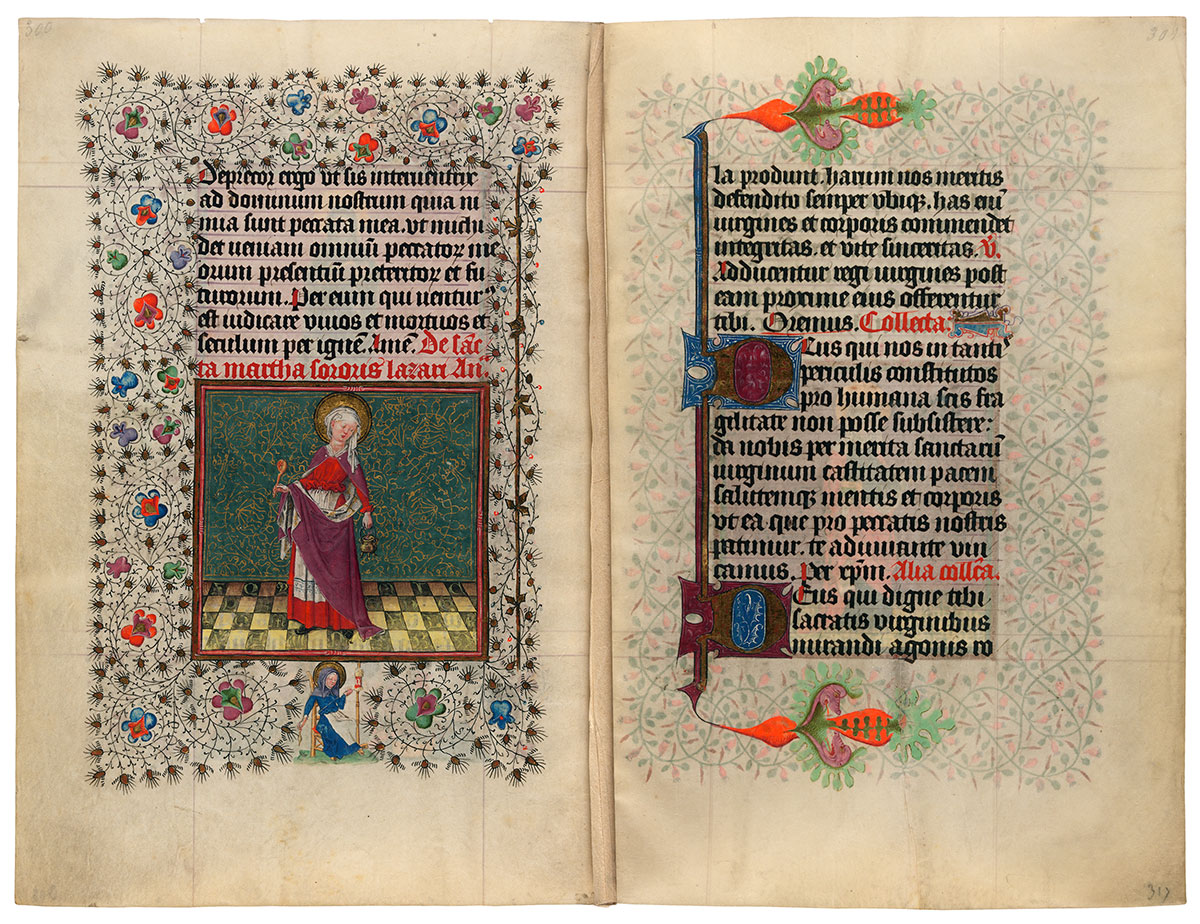
St. Martha
Purchased on the Belle da Costa Greene Fund with the assistance of the Fellows, 1963
Suffrages
Suffrages are short prayers to individual saints. As protectors of medieval people, saints were their doctor in plague, their midwife at childbirth, their guardian when traveling, and their nurse during toothache. If the Virgin was the figure to whom one addressed the all-important petition for eternal salvation, it was from saints that one sought more basic or temporal kinds of help. While the Virgin became, as the Mother of God, almost a goddess herself, saints retained more of their humanity and thus their approachability.
Image courtesy of Faksimile Verlag Luzern
MS M.917/945, pp. 318–319
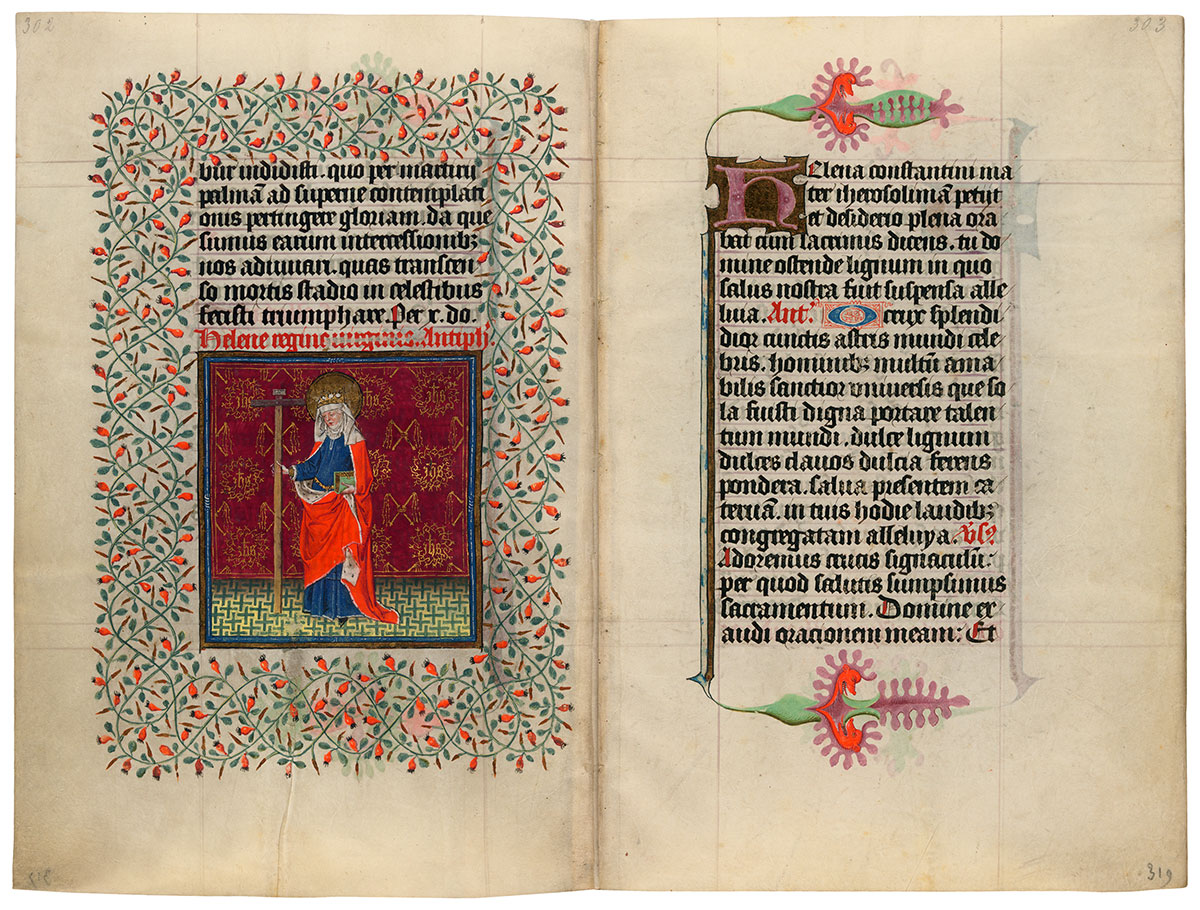
St. Helena
Purchased on the Belle da Costa Greene Fund with the assistance of the Fellows, 1963
Suffrages
Suffrages are short prayers to individual saints. As protectors of medieval people, saints were their doctor in plague, their midwife at childbirth, their guardian when traveling, and their nurse during toothache. If the Virgin was the figure to whom one addressed the all-important petition for eternal salvation, it was from saints that one sought more basic or temporal kinds of help. While the Virgin became, as the Mother of God, almost a goddess herself, saints retained more of their humanity and thus their approachability.
Image courtesy of Faksimile Verlag Luzern
MS M.917/945, pp. 320–321

St. Elizabeth Aiding Beggars
Purchased on the Belle da Costa Greene Fund with the assistance of the Fellows, 1963
Suffrages
Suffrages are short prayers to individual saints. As protectors of medieval people, saints were their doctor in plague, their midwife at childbirth, their guardian when traveling, and their nurse during toothache. If the Virgin was the figure to whom one addressed the all-important petition for eternal salvation, it was from saints that one sought more basic or temporal kinds of help. While the Virgin became, as the Mother of God, almost a goddess herself, saints retained more of their humanity and thus their approachability.
Image courtesy of Faksimile Verlag Luzern
MS M.917/945, pp. 322–323
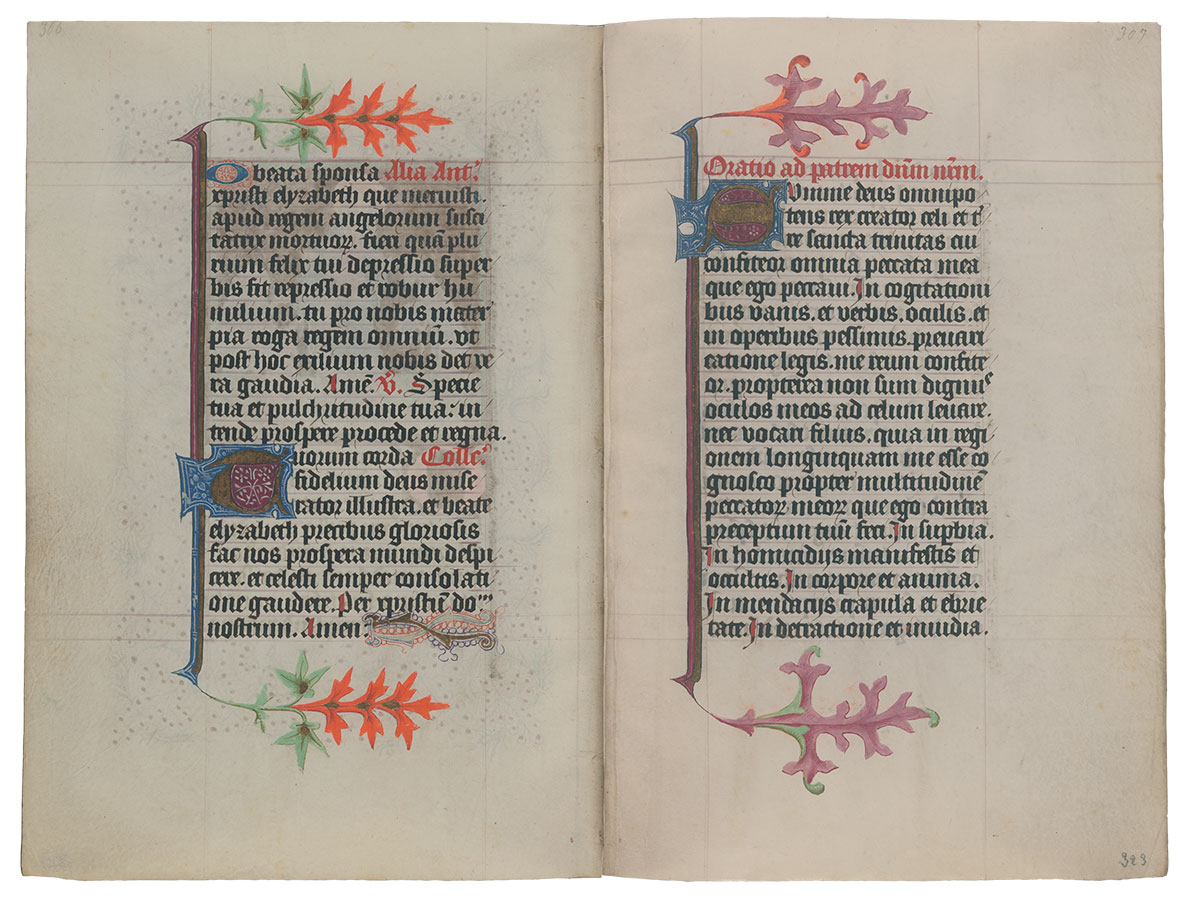
Purchased on the Belle da Costa Greene Fund with the assistance of the Fellows, 1963
Image courtesy of Faksimile Verlag Luzern
MS M.917/945, pp. 324–325
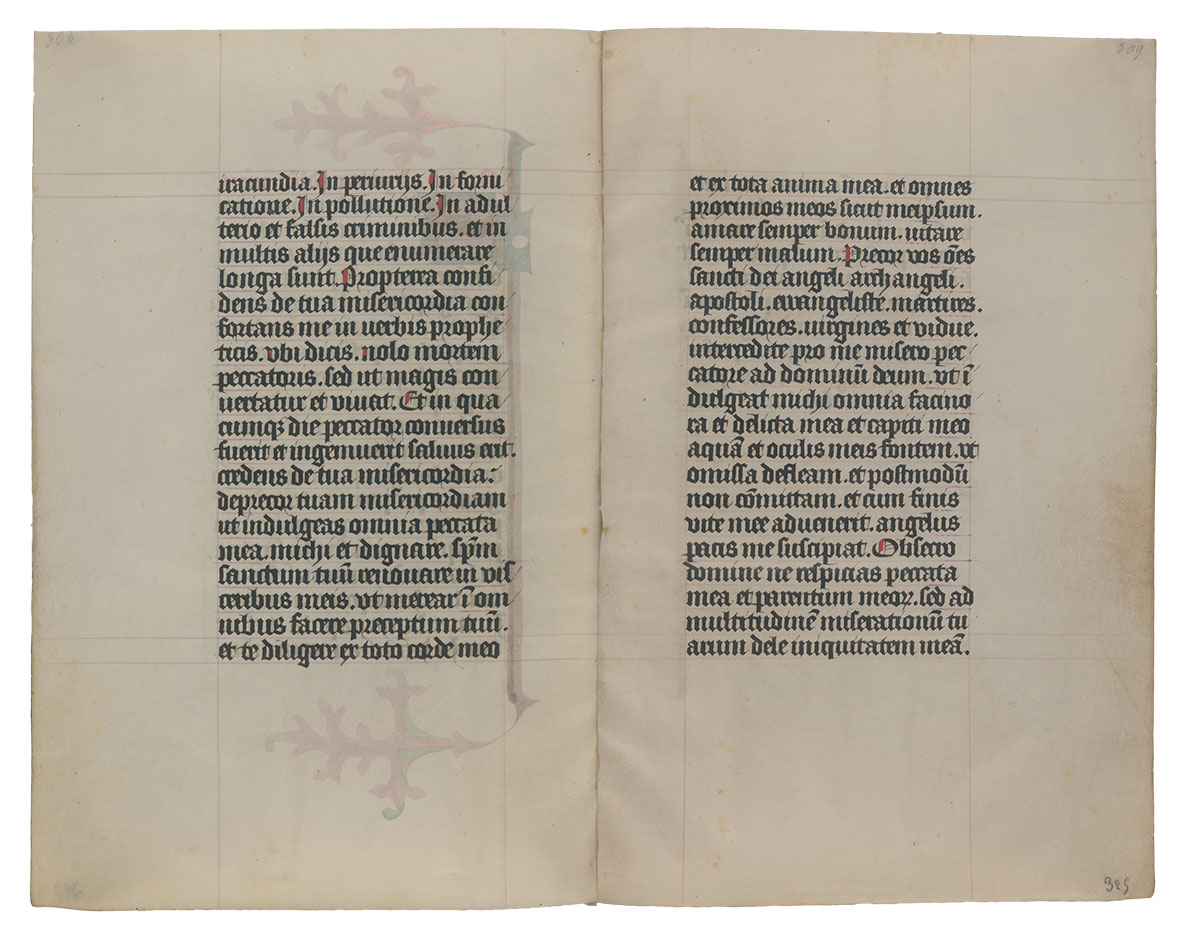
Purchased on the Belle da Costa Greene Fund with the assistance of the Fellows, 1963
Image courtesy of Faksimile Verlag Luzern
MS M.917/945, pp. 326–327
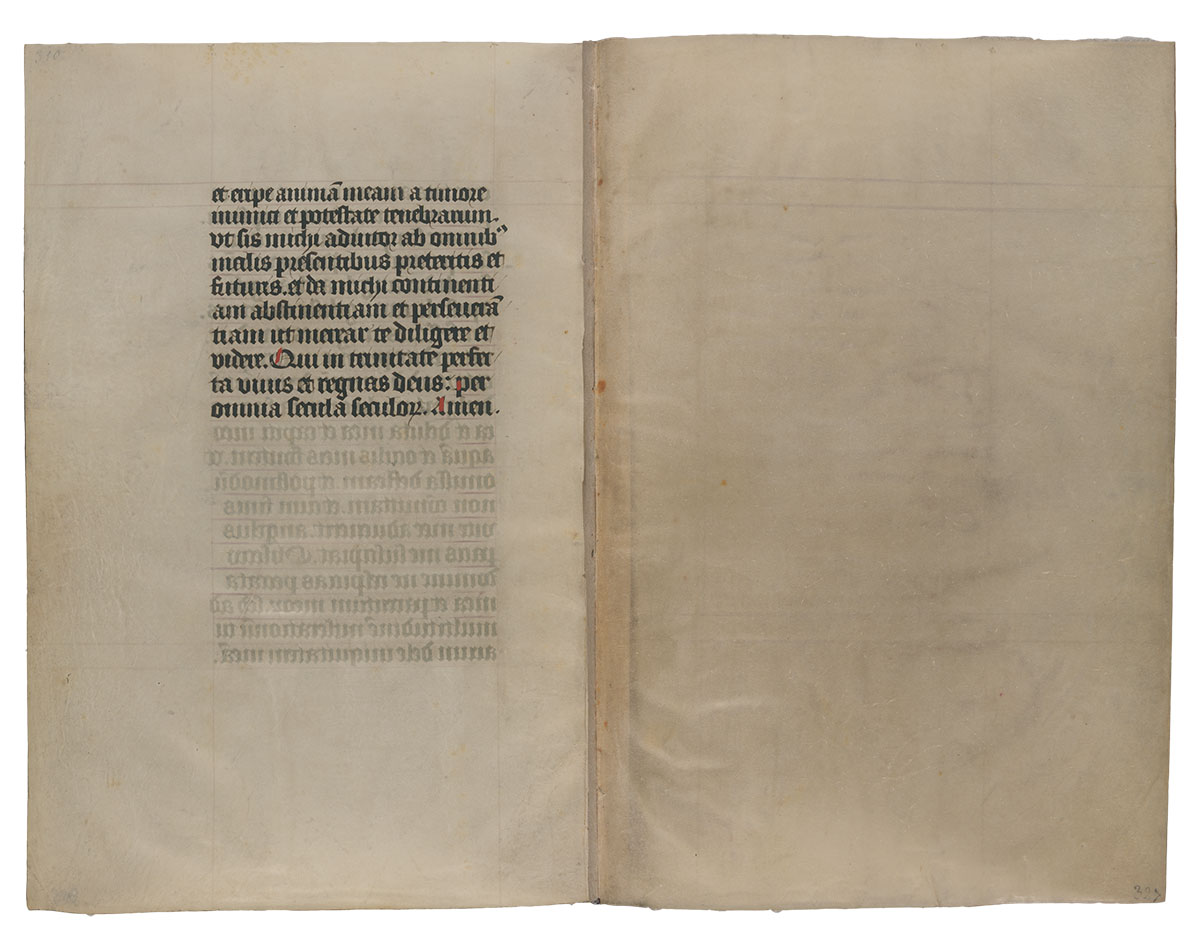
Purchased on the Belle da Costa Greene Fund with the assistance of the Fellows, 1963
Image courtesy of Faksimile Verlag Luzern